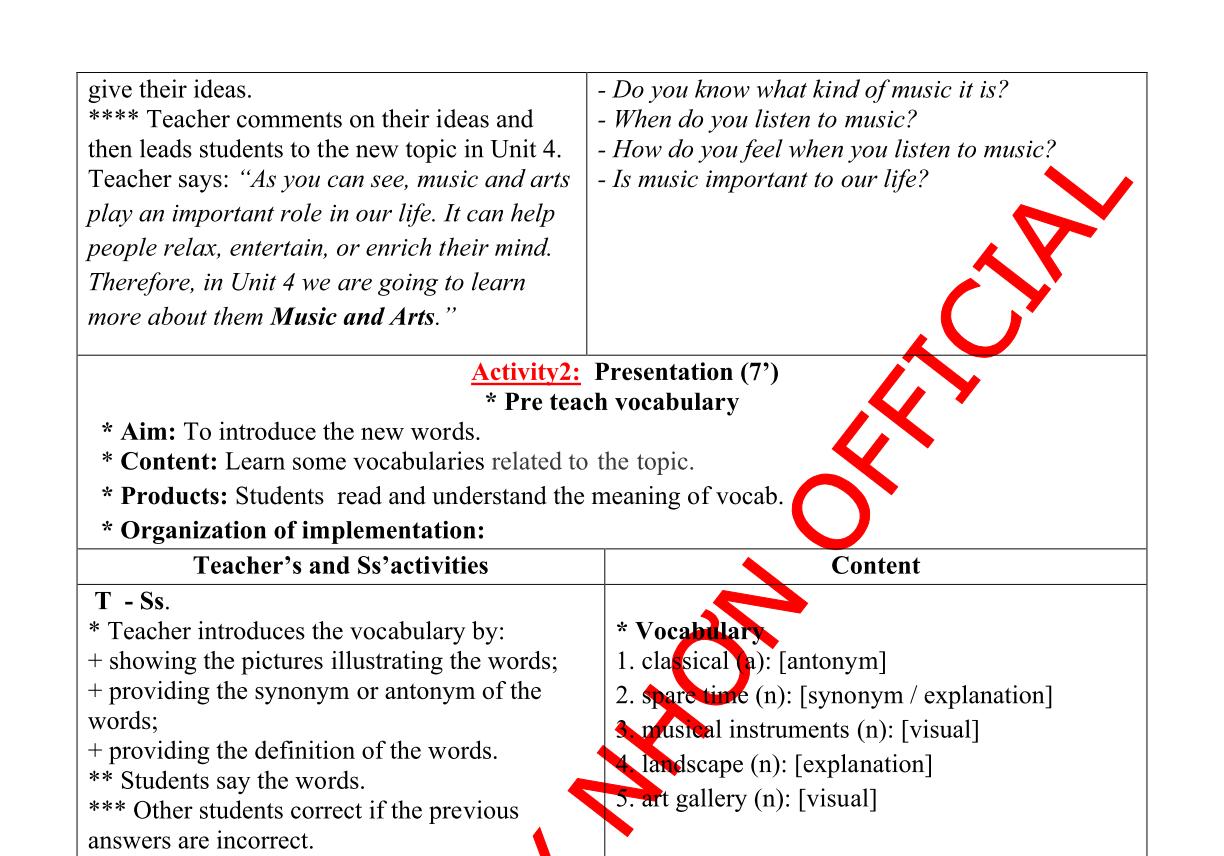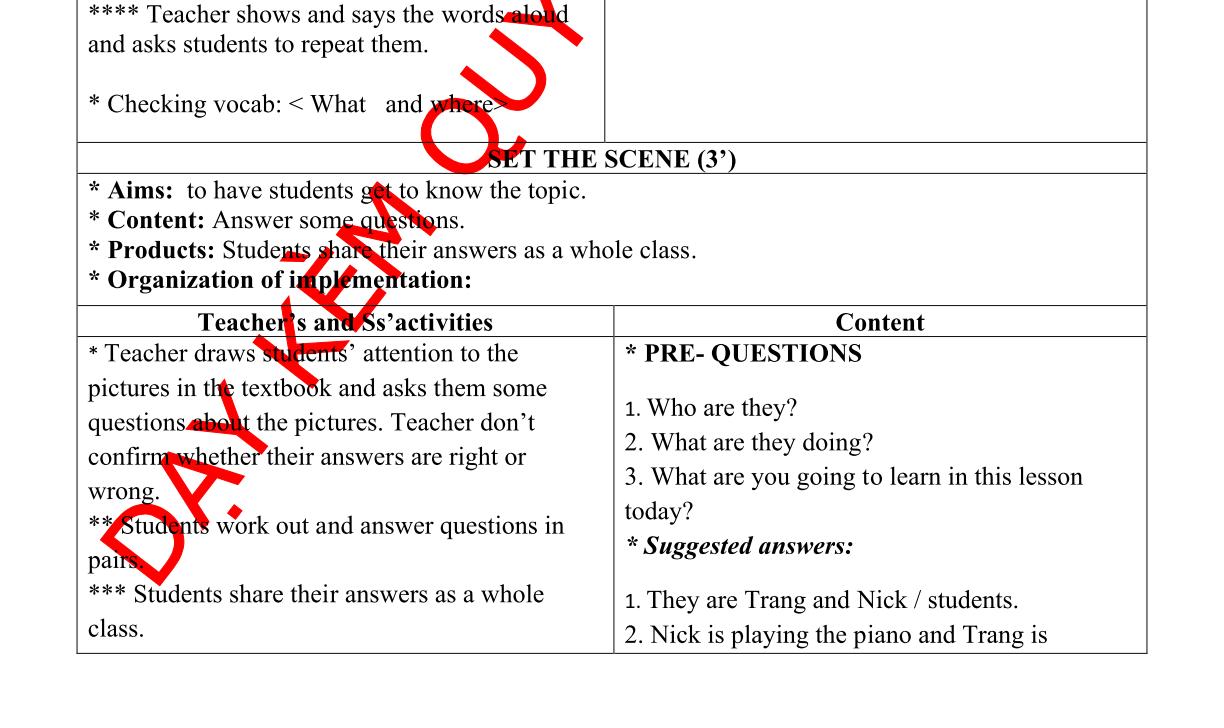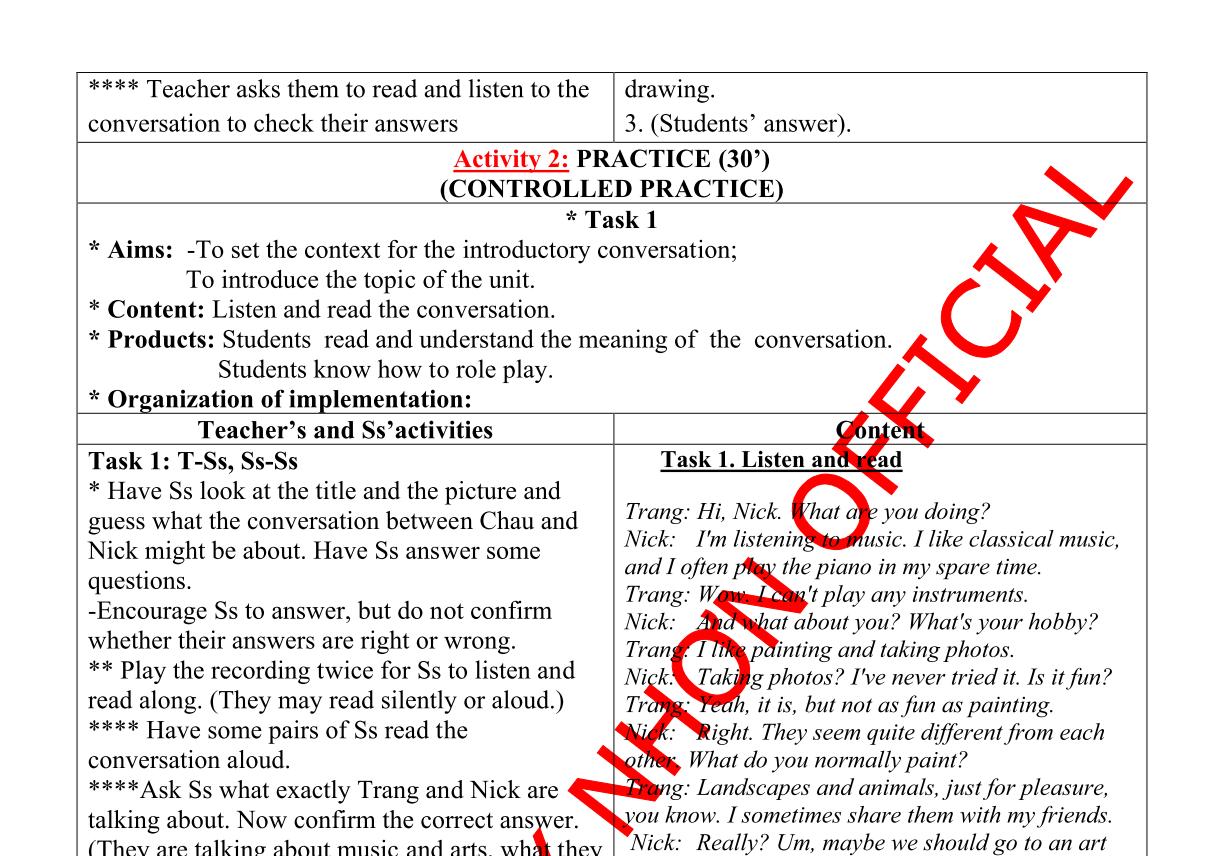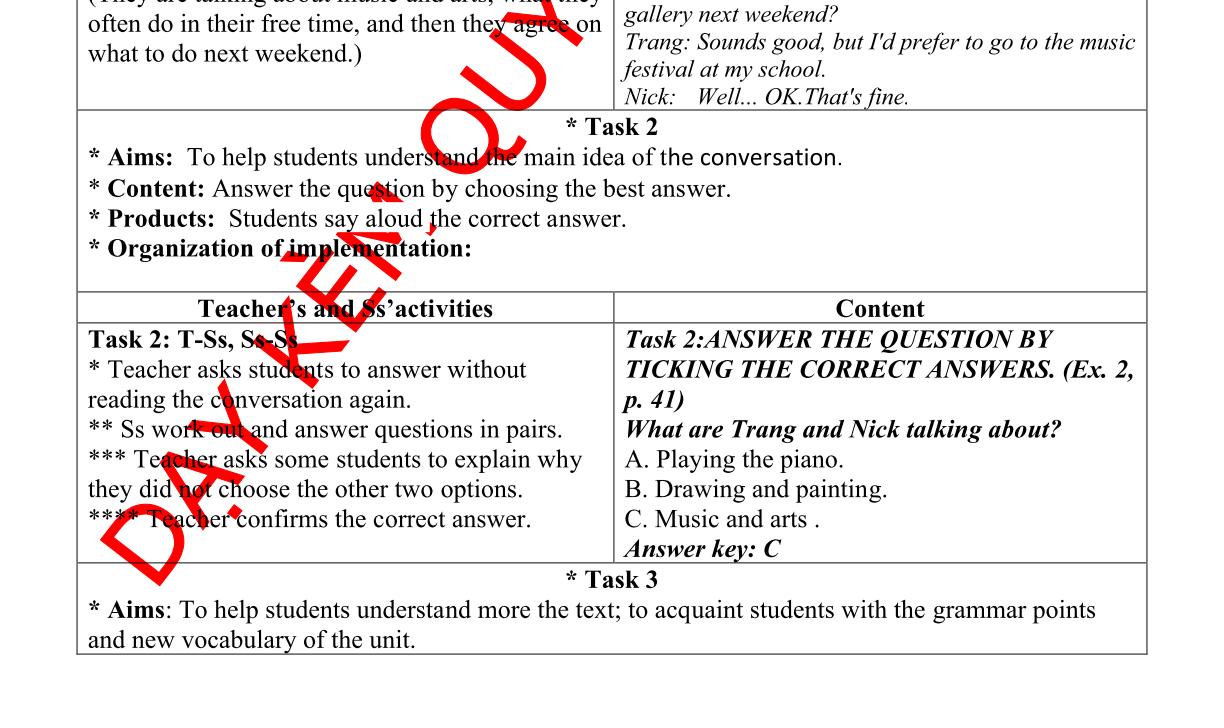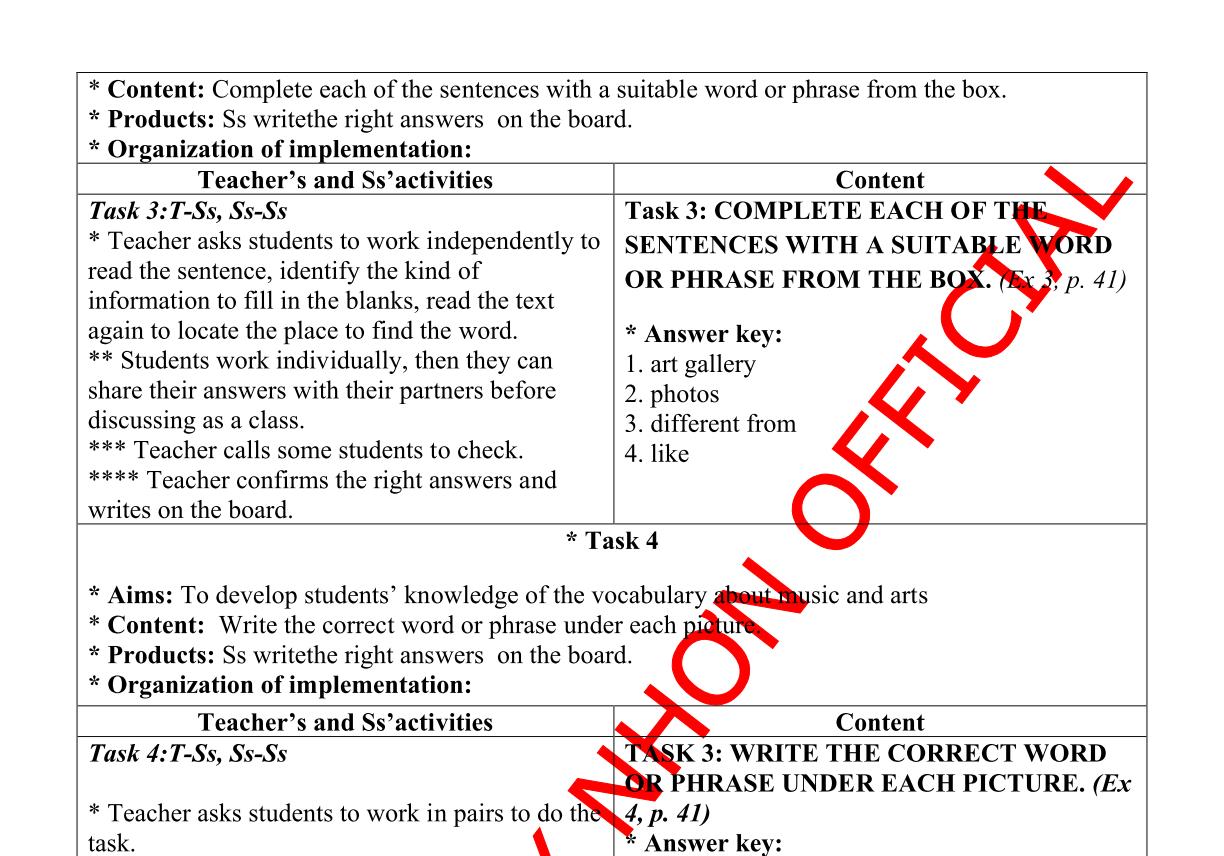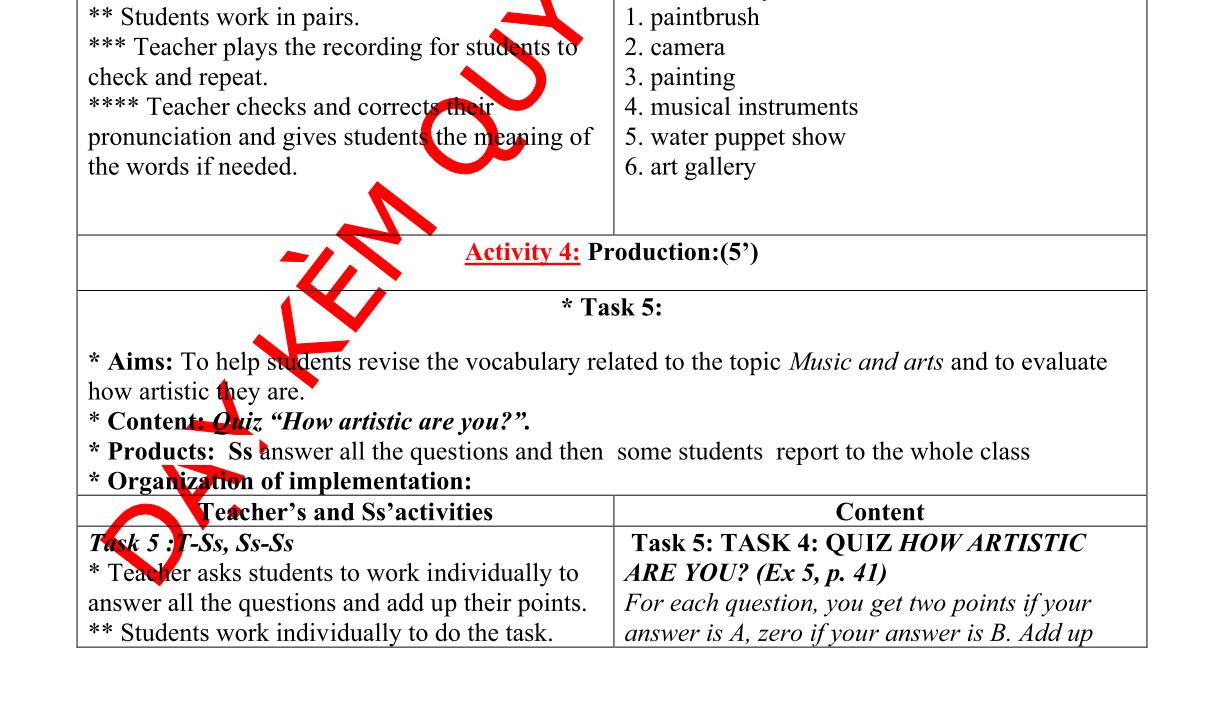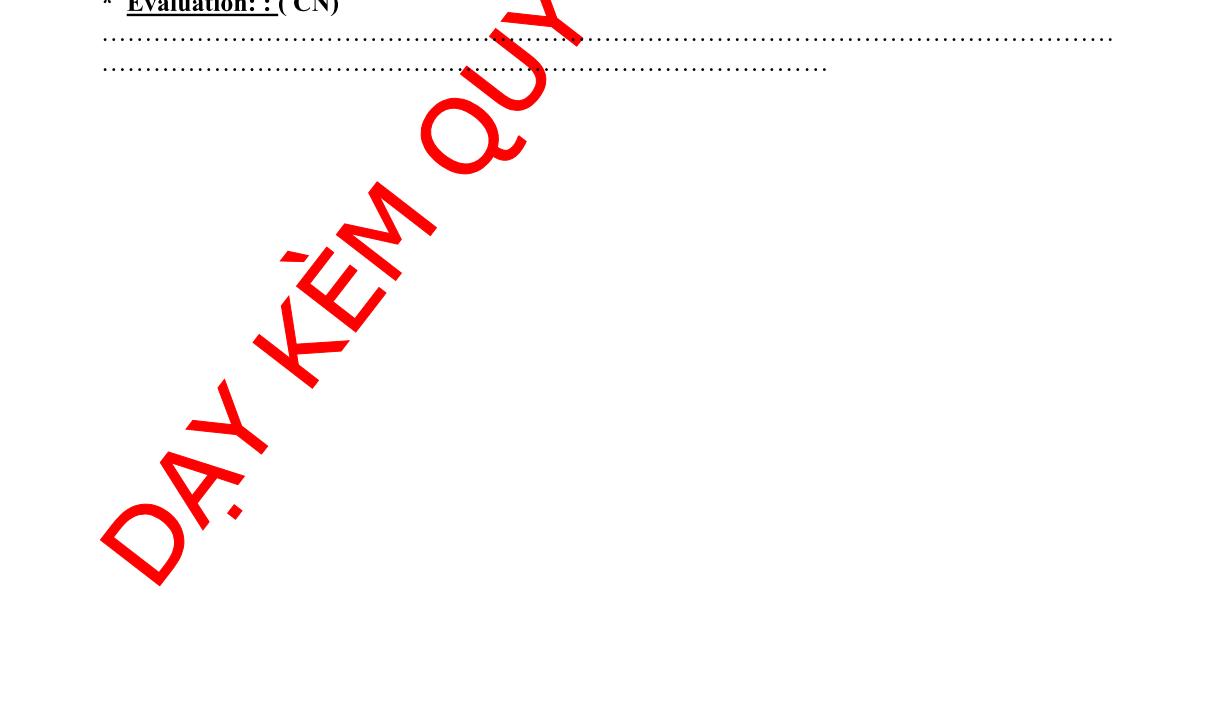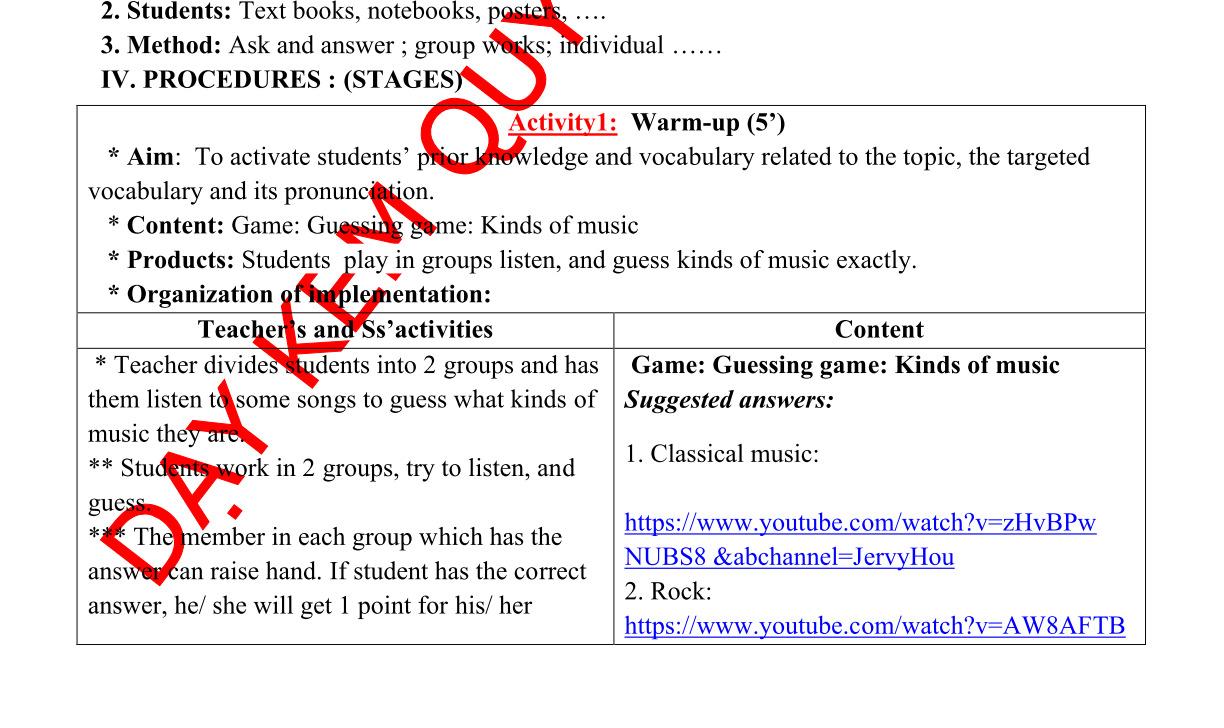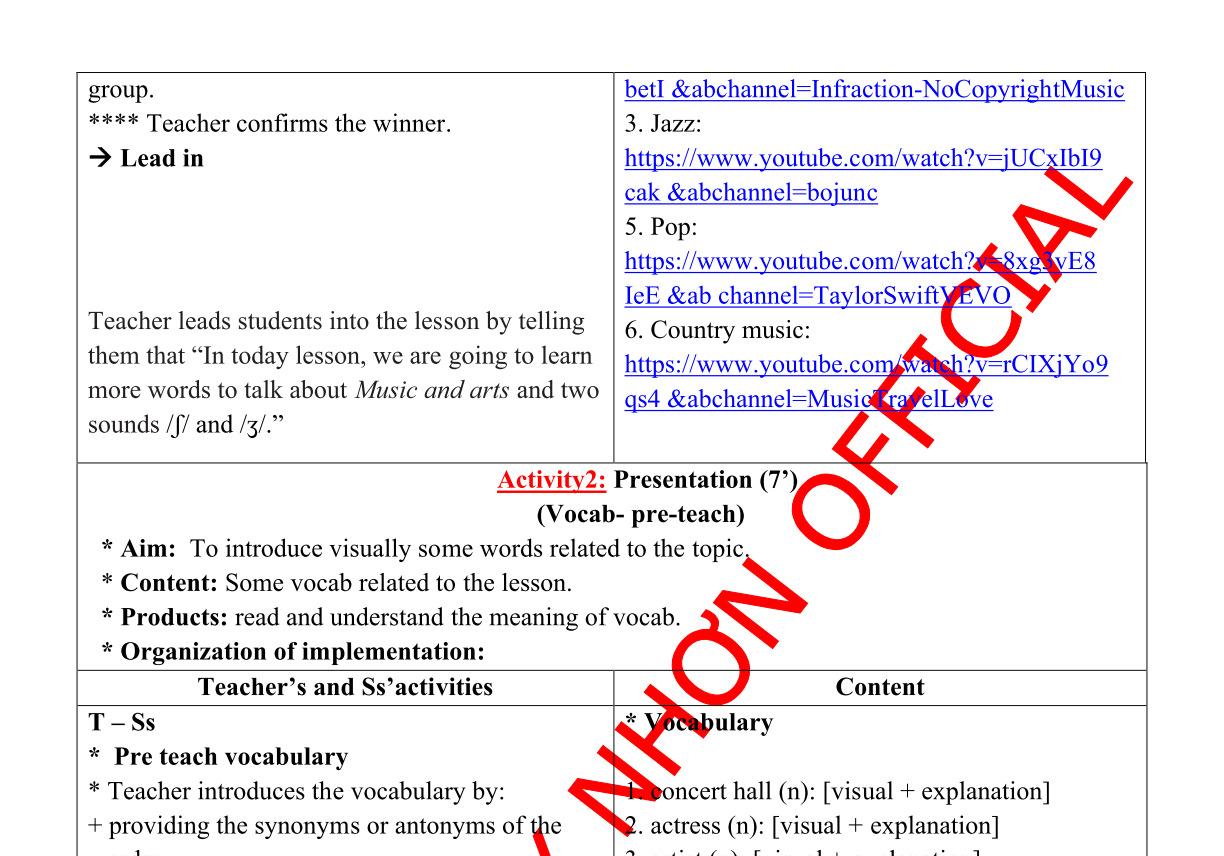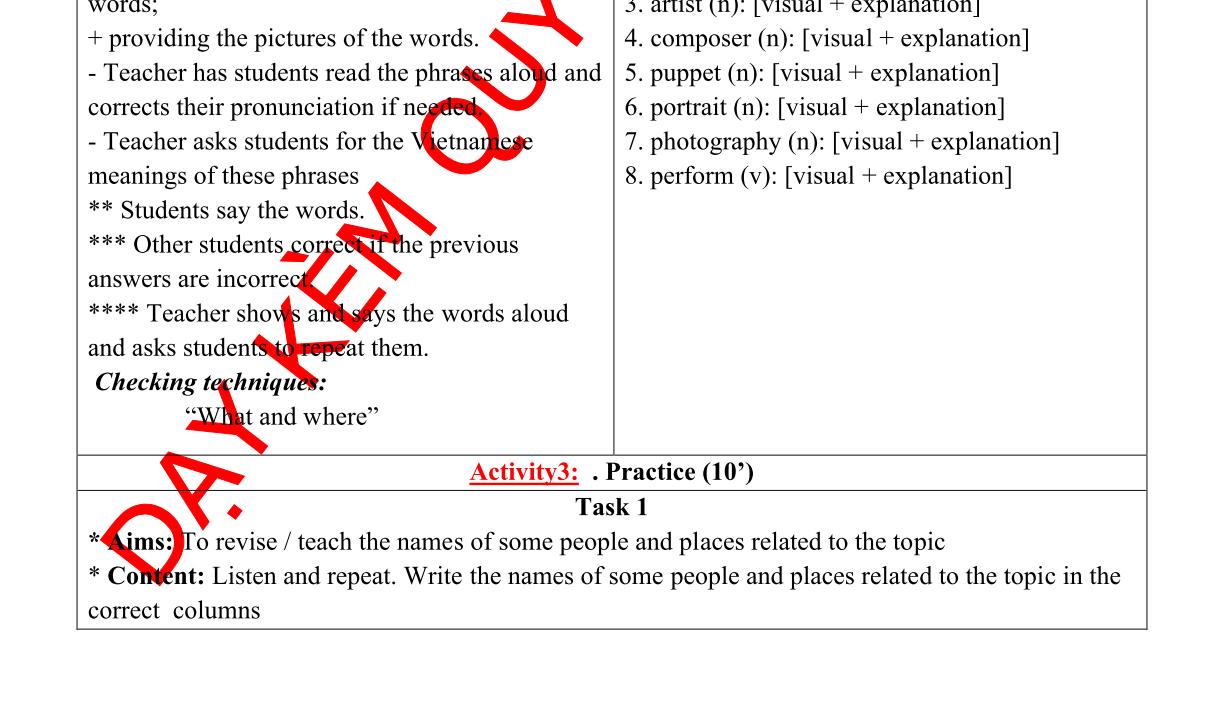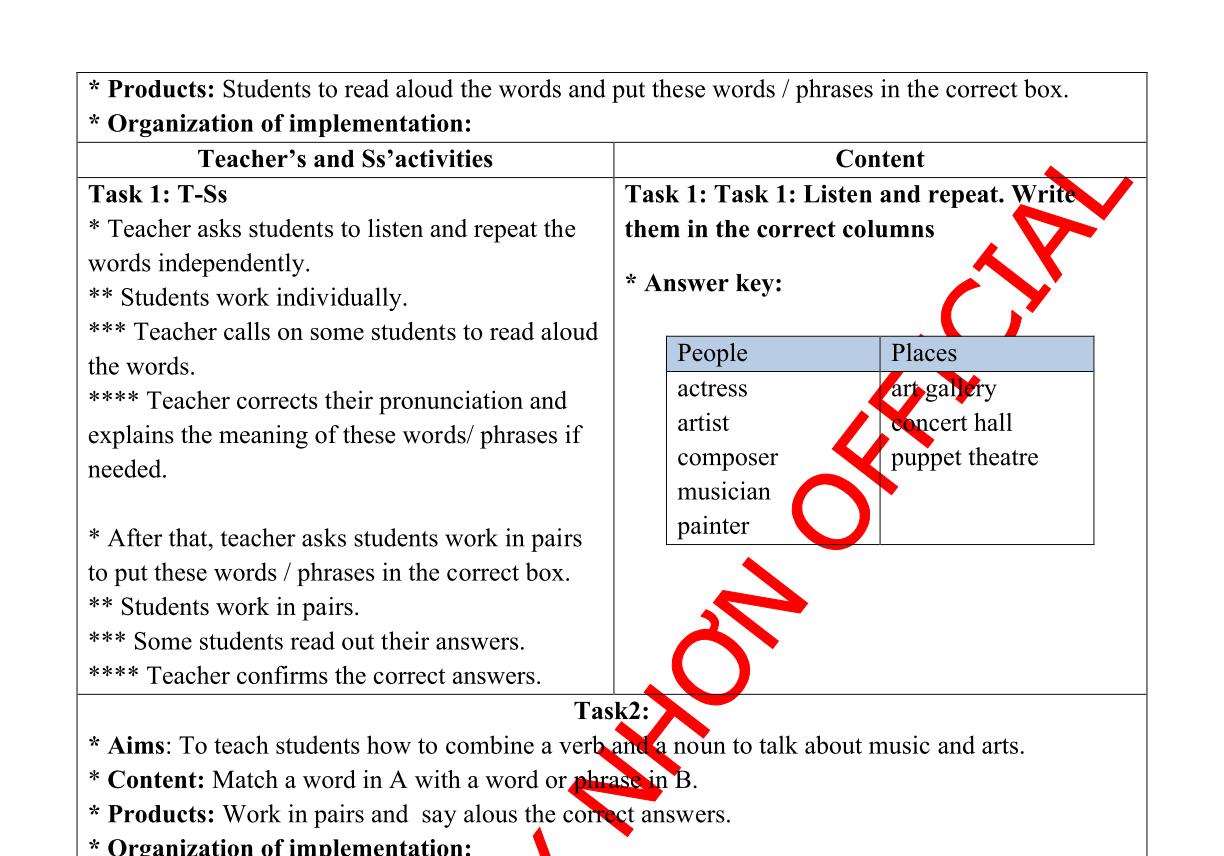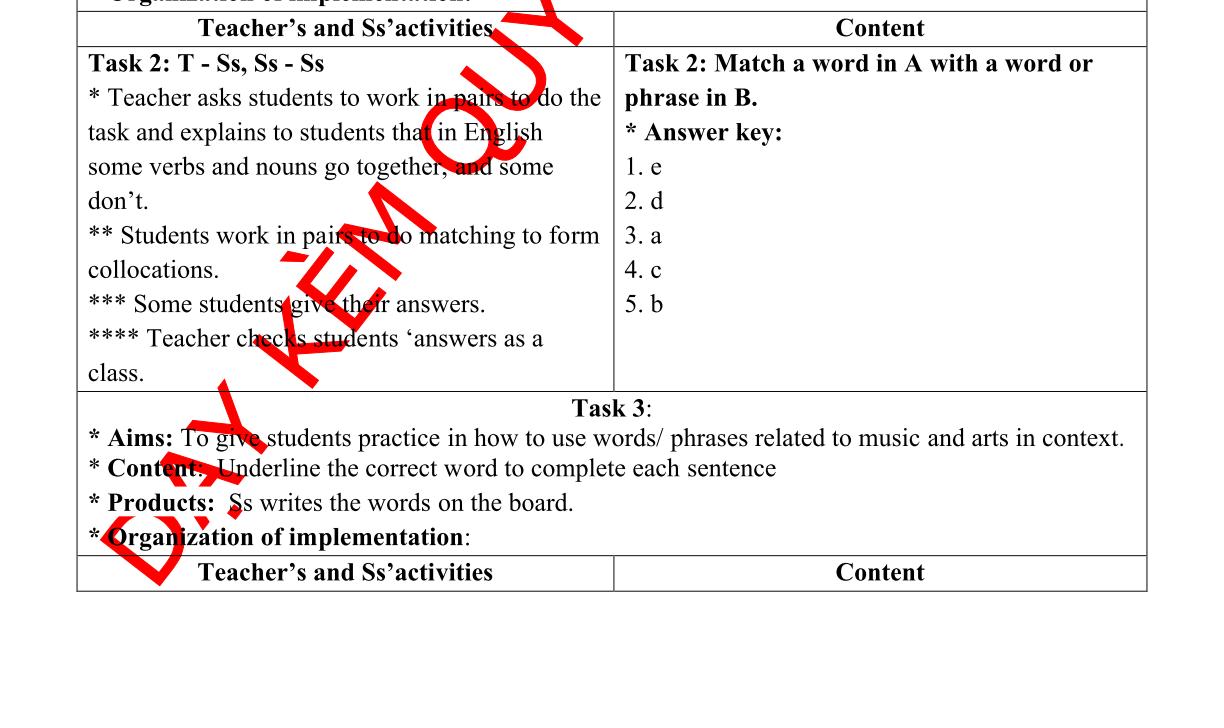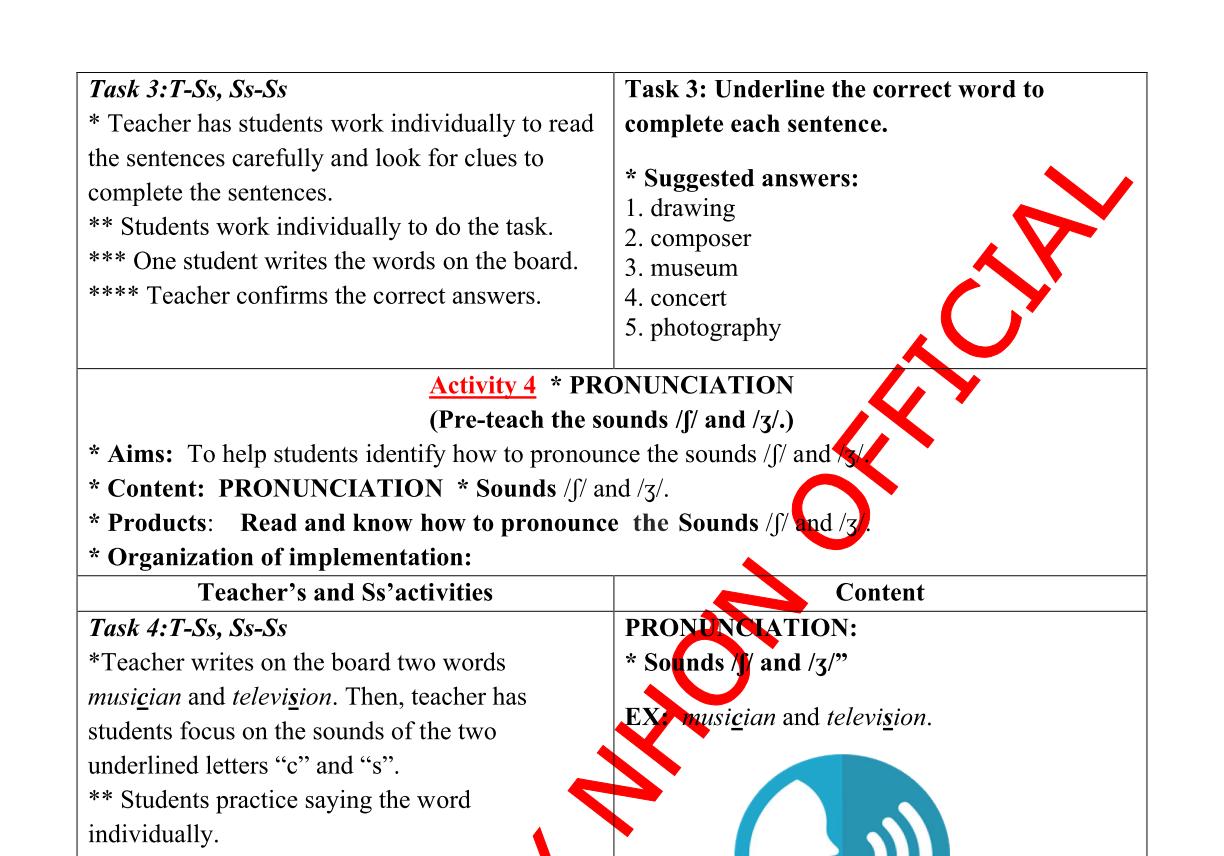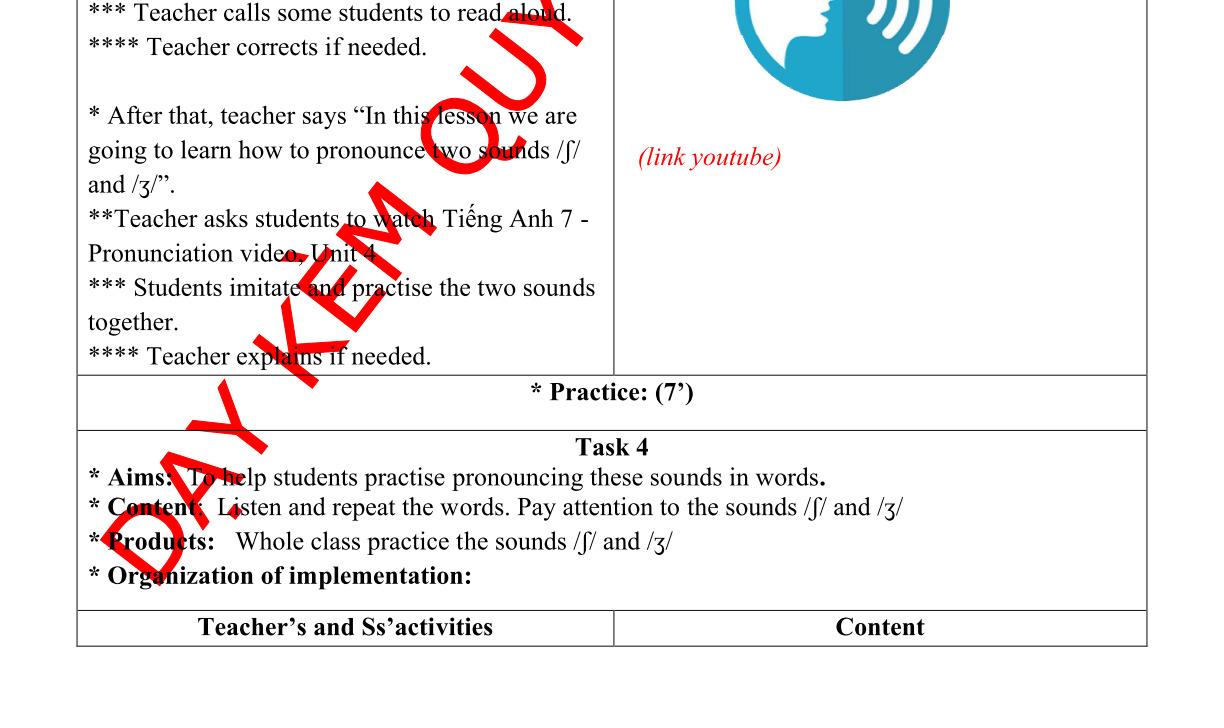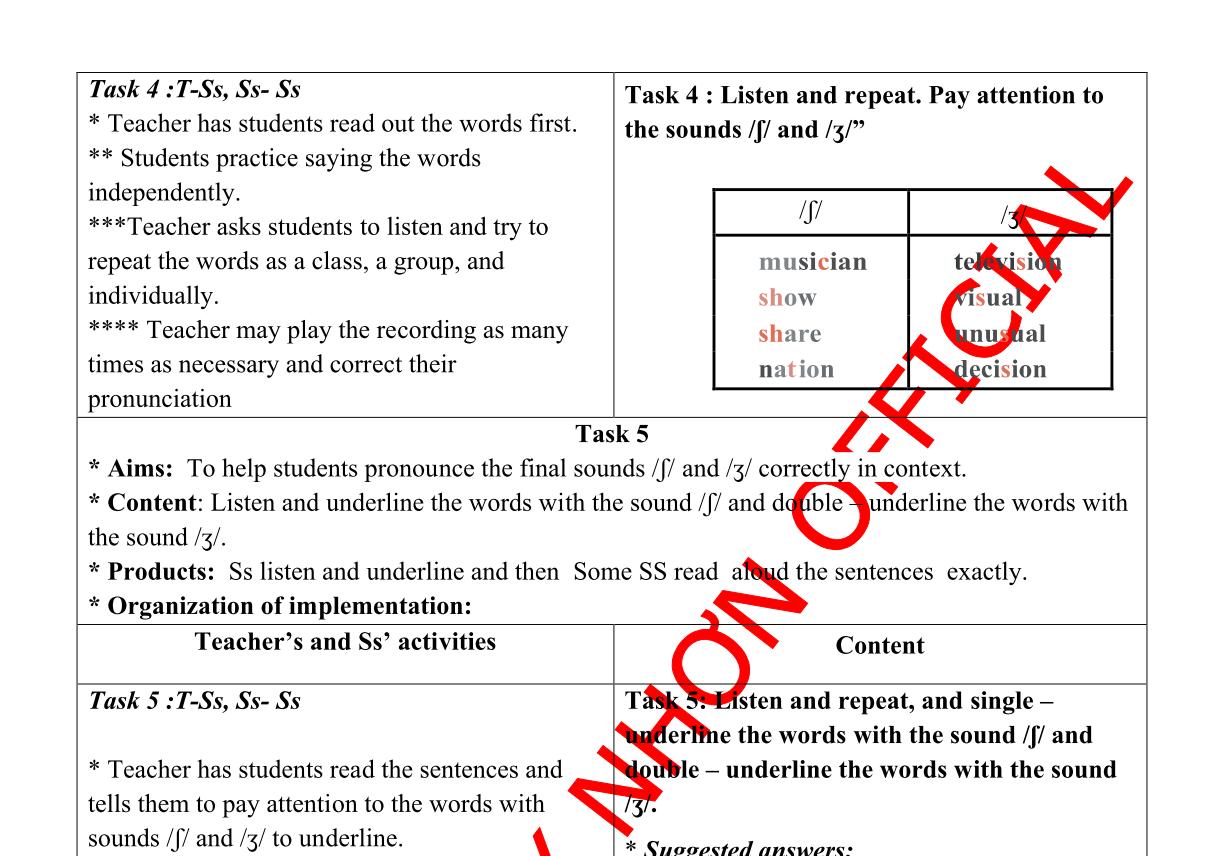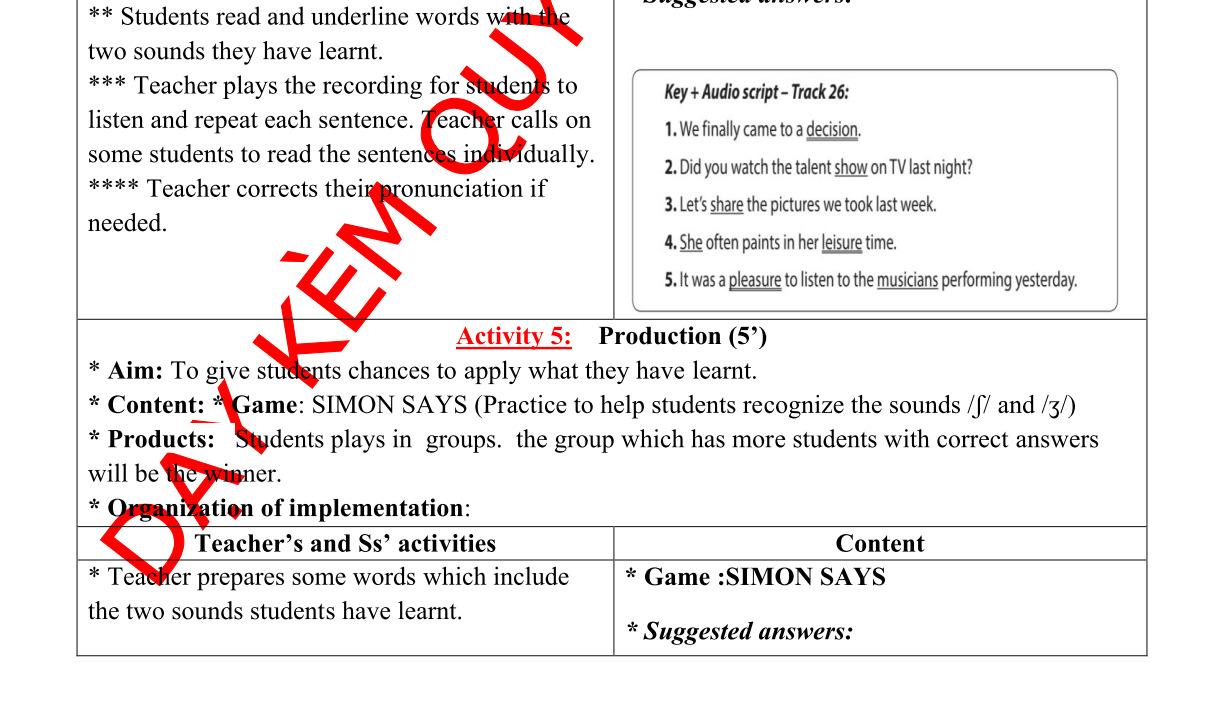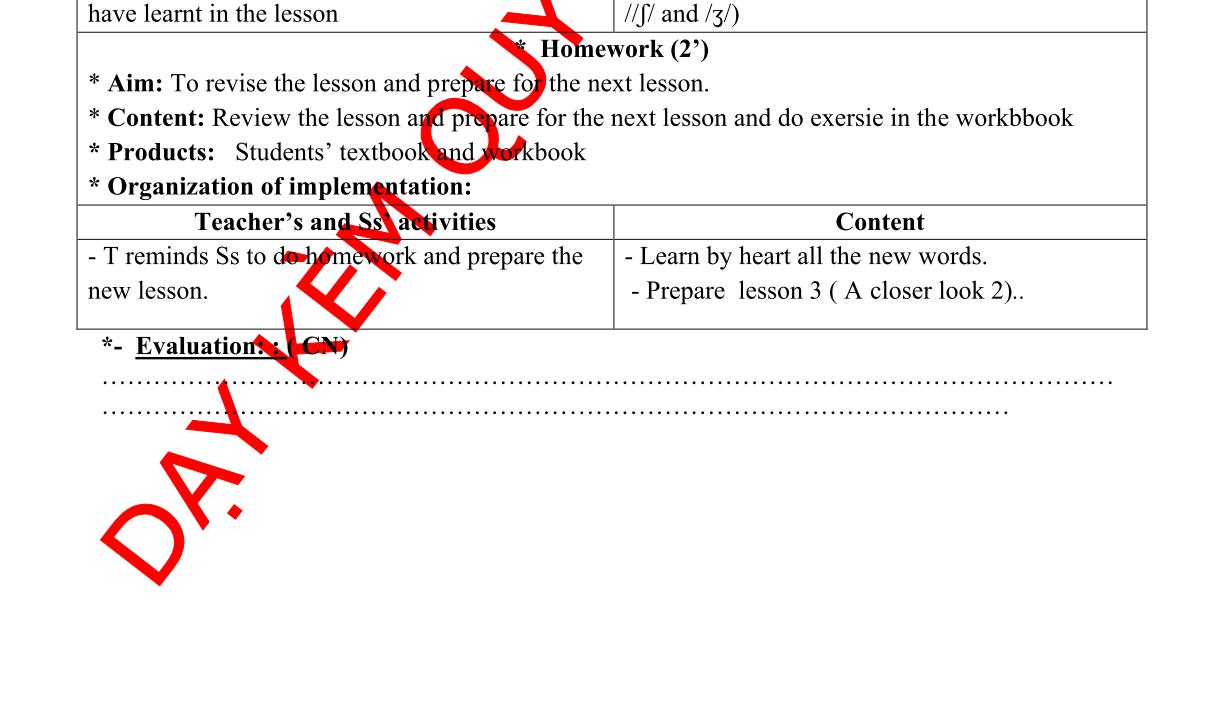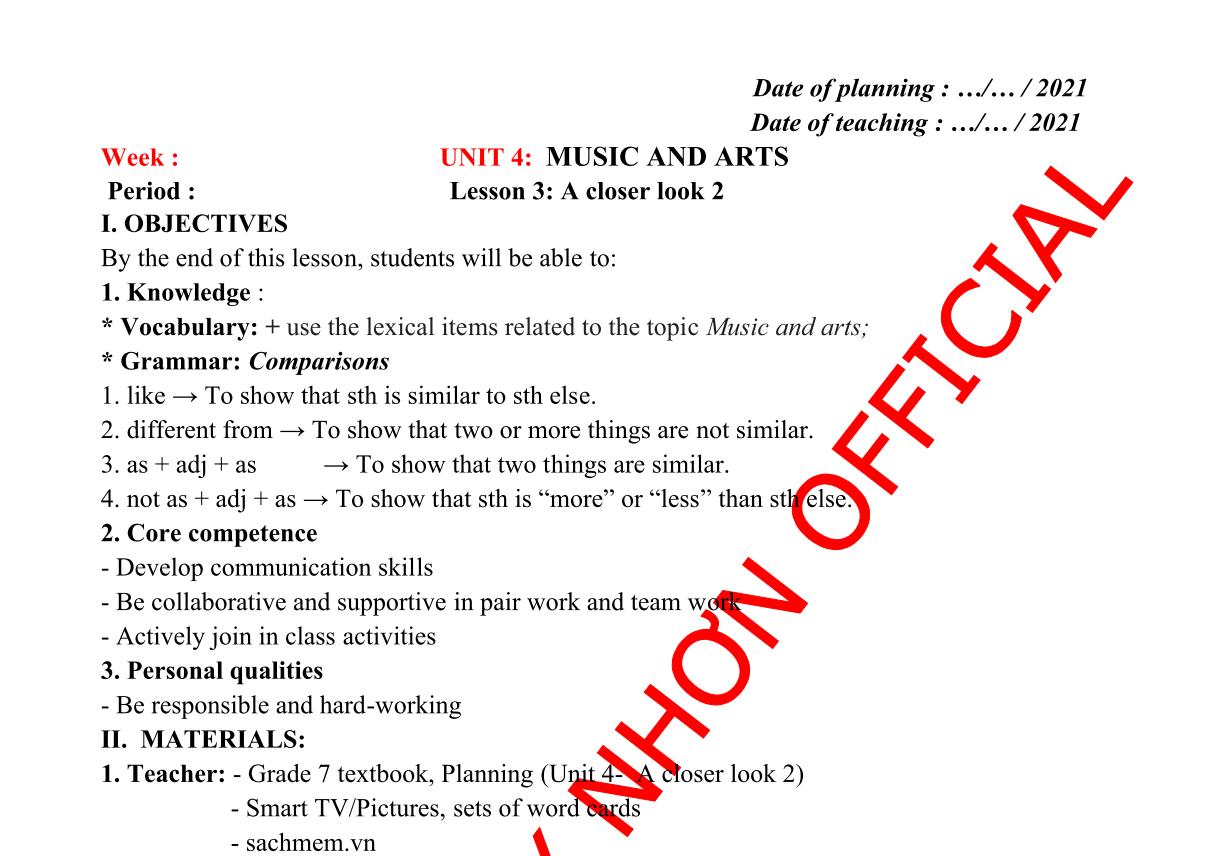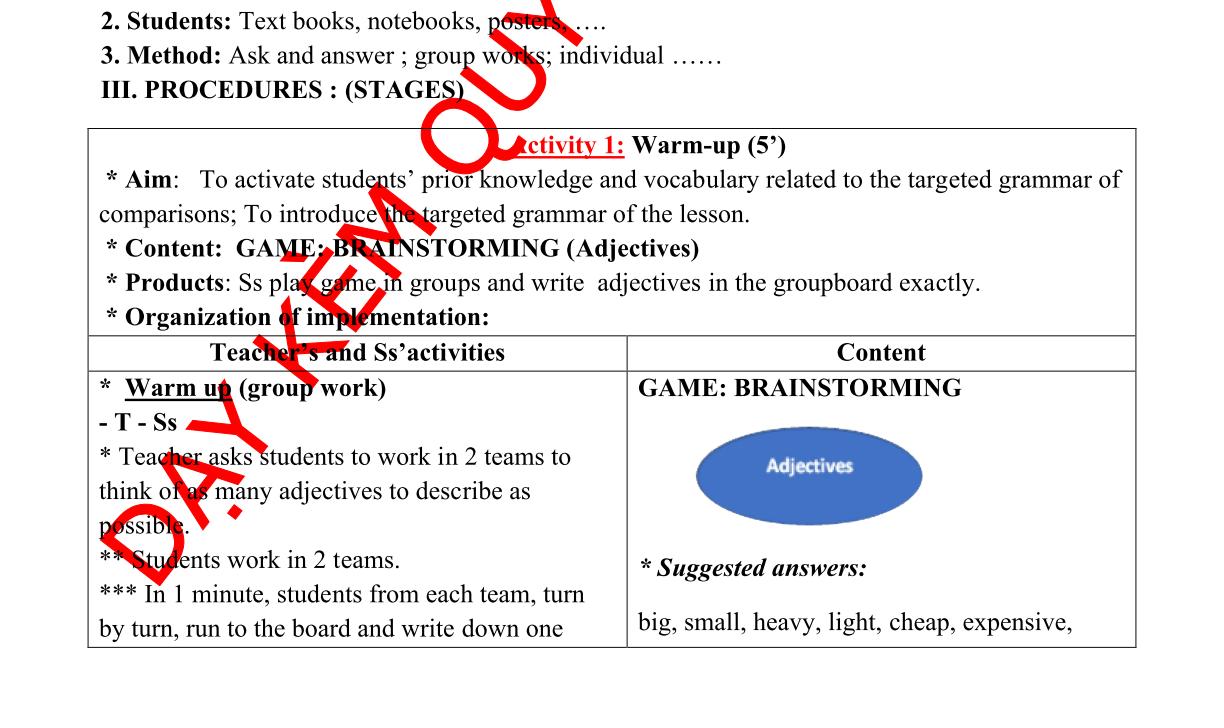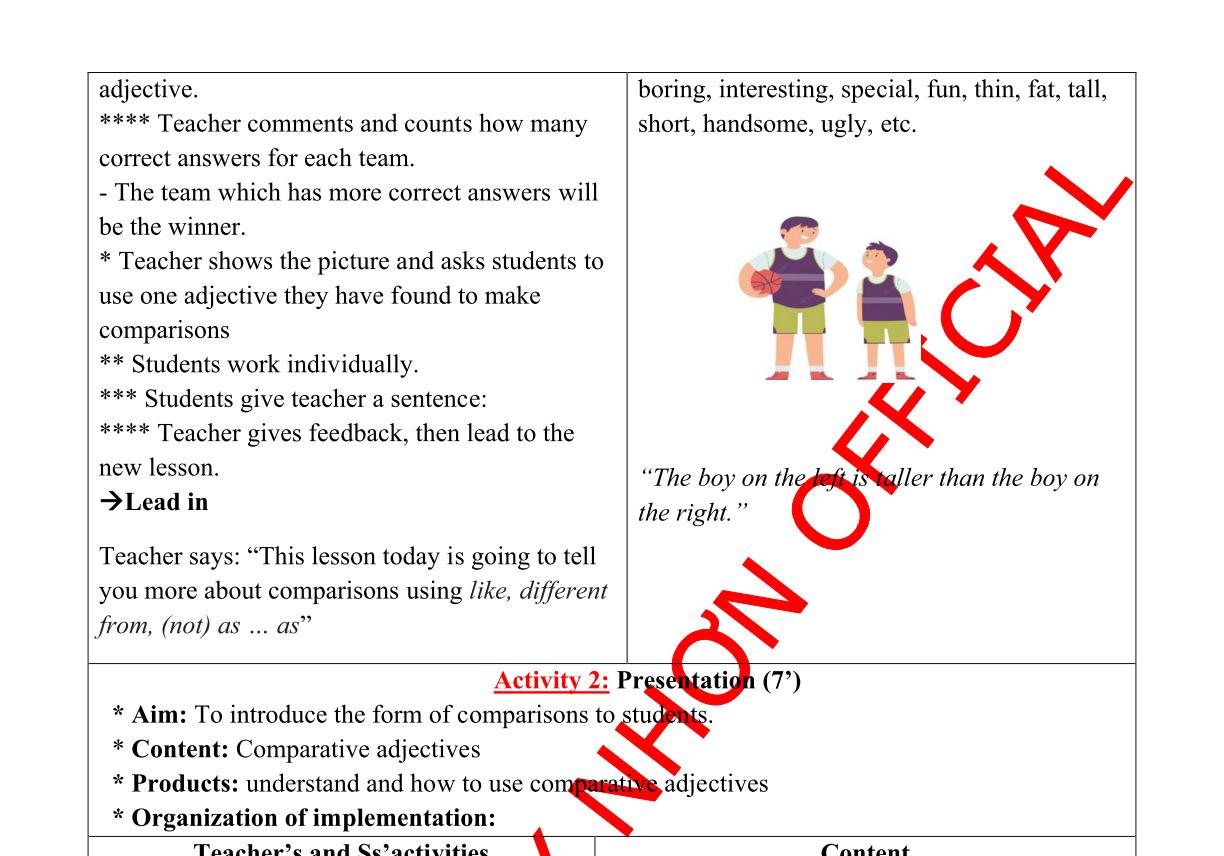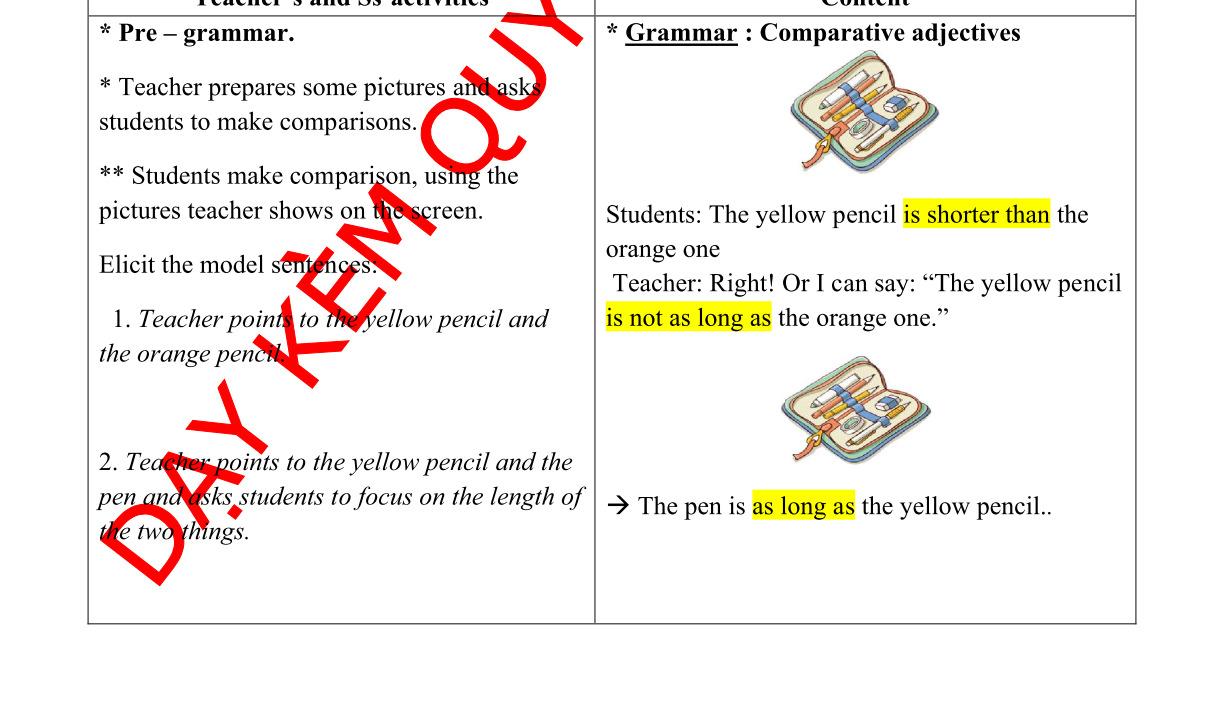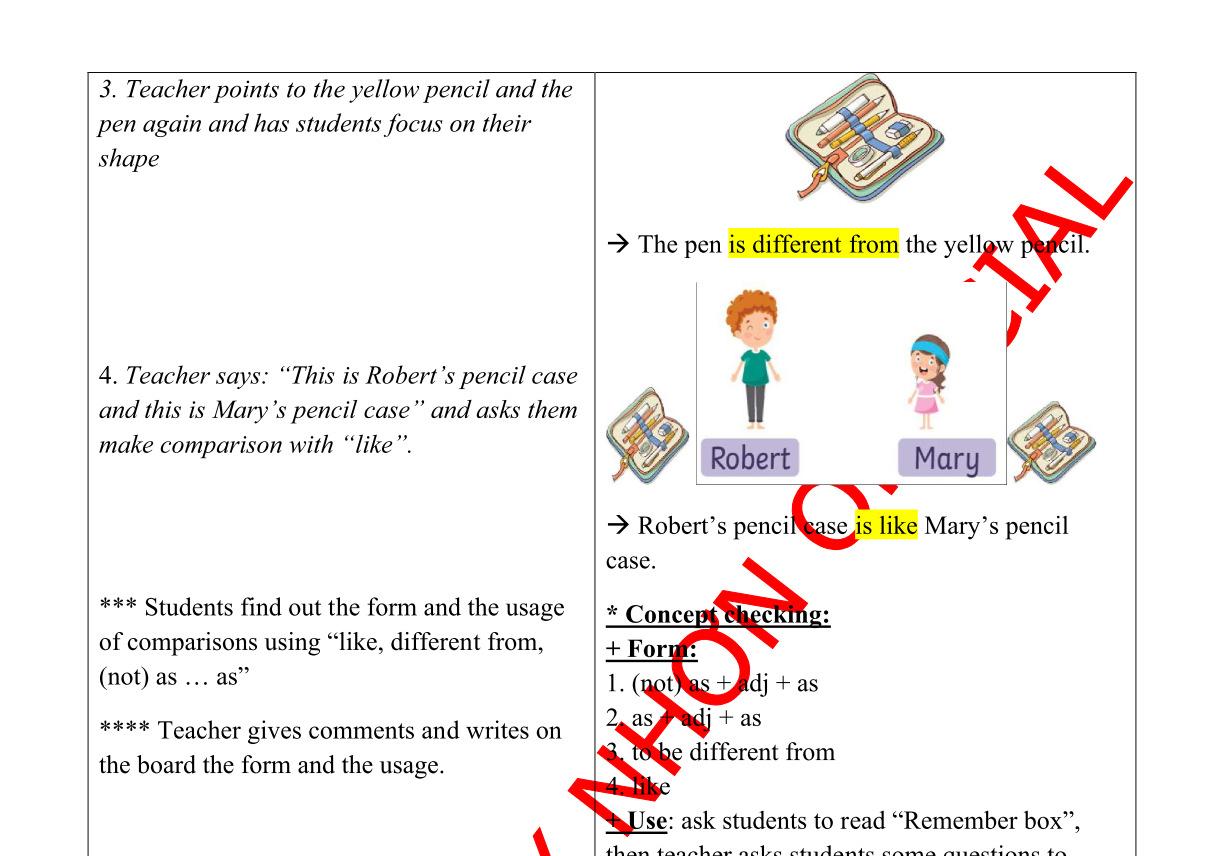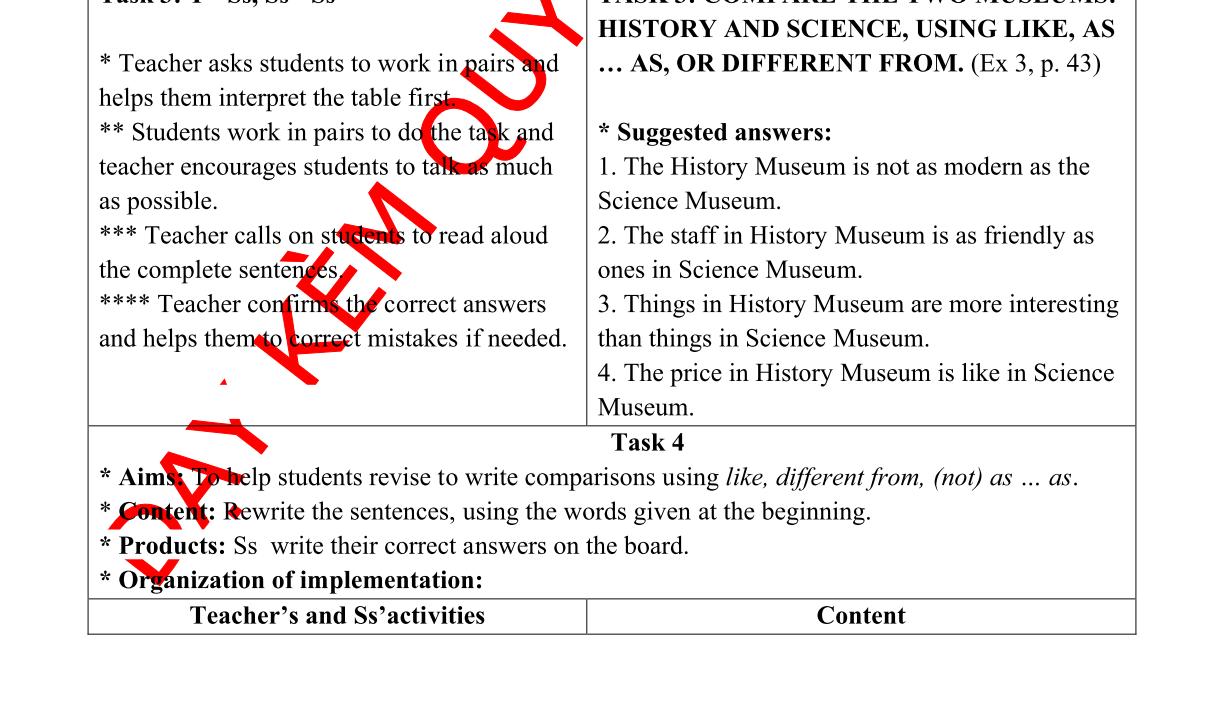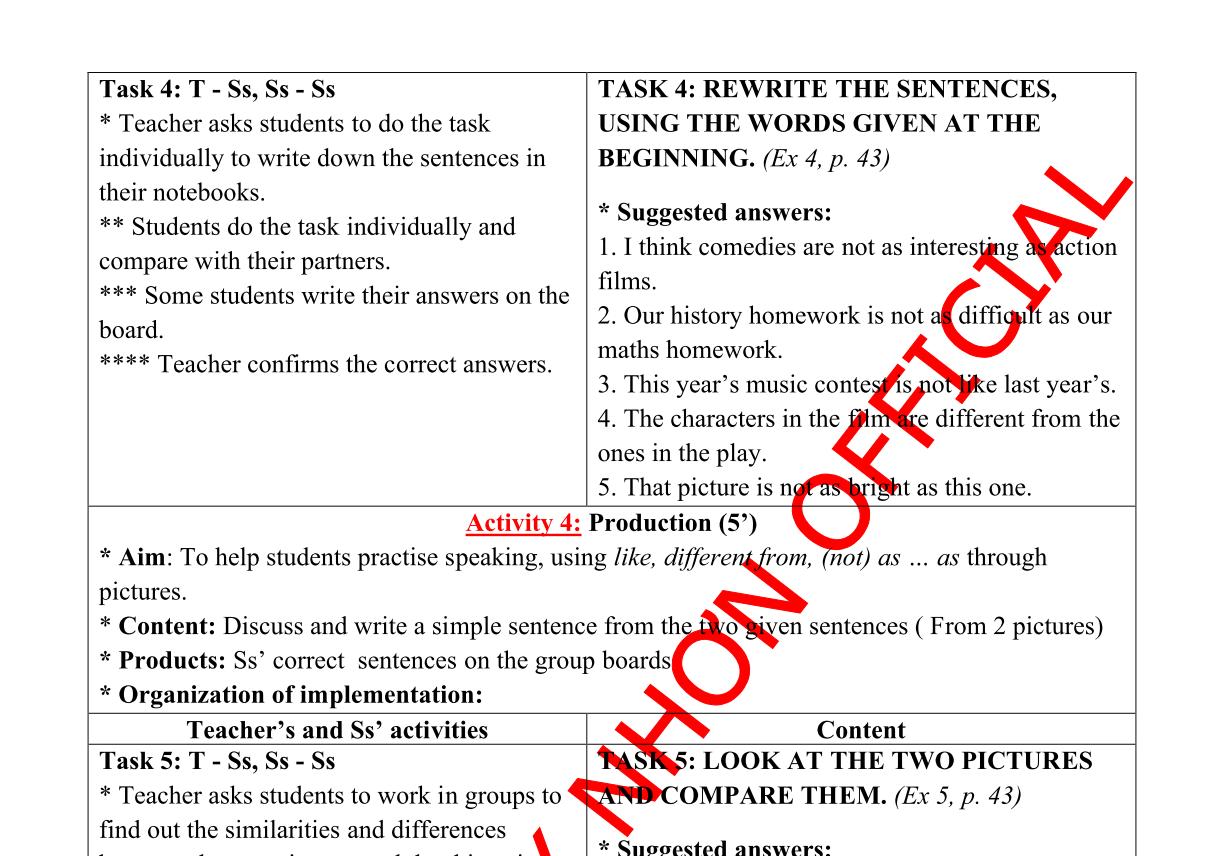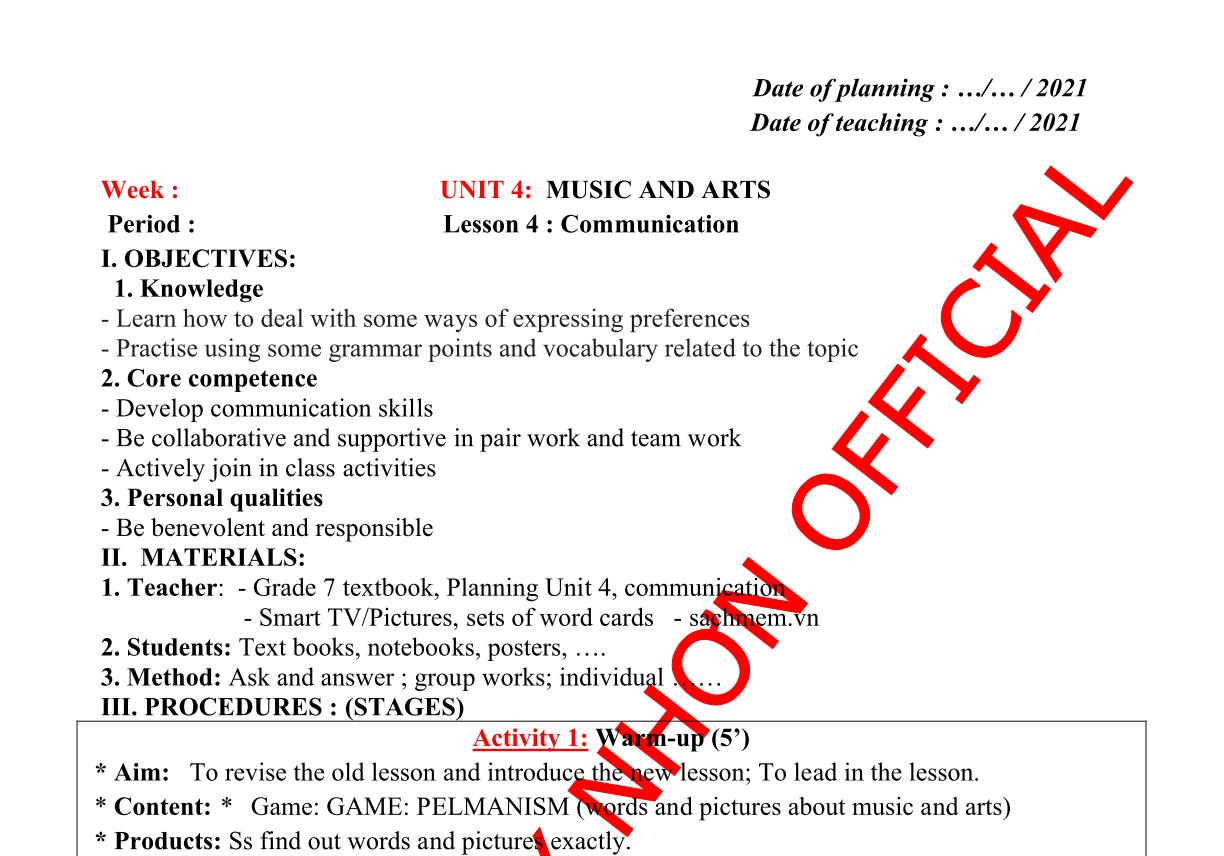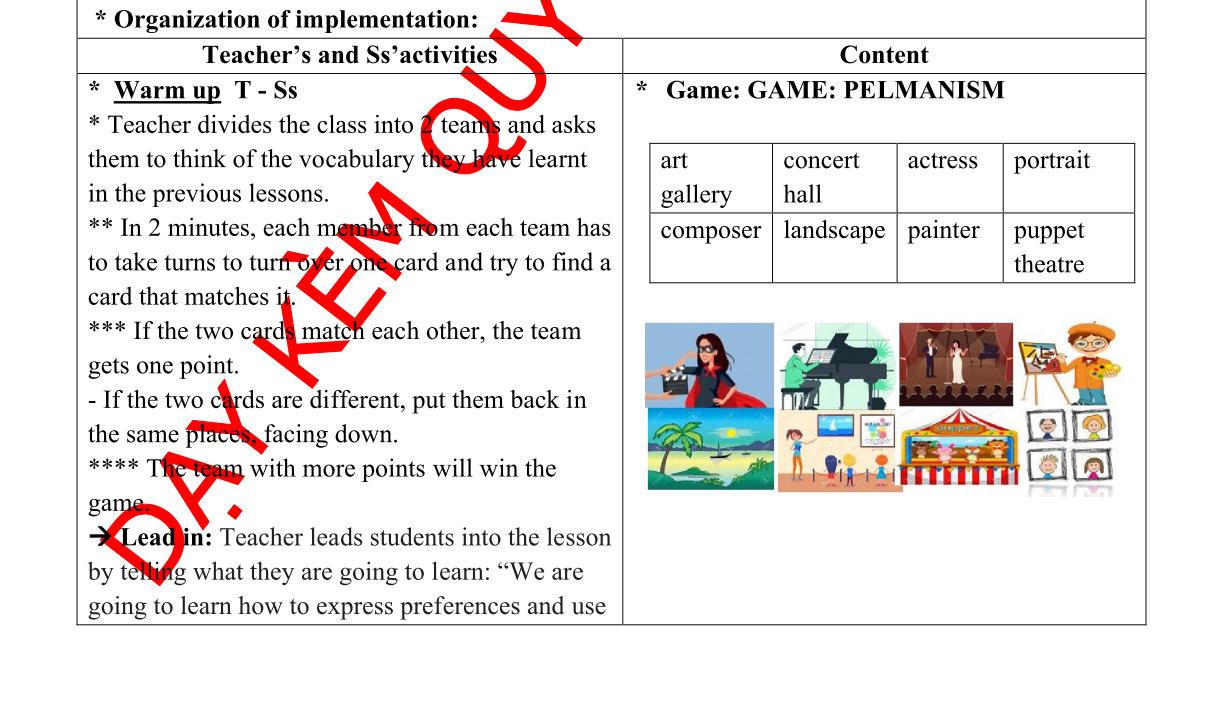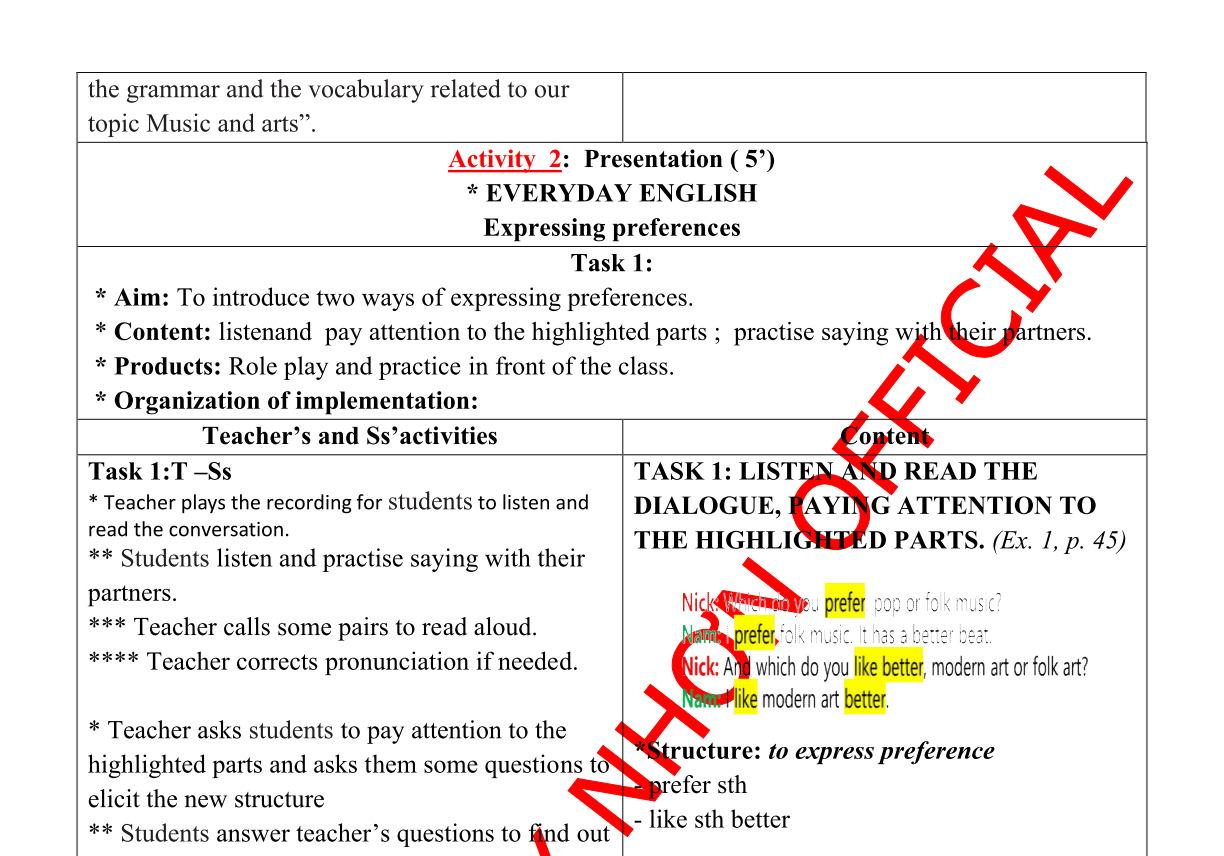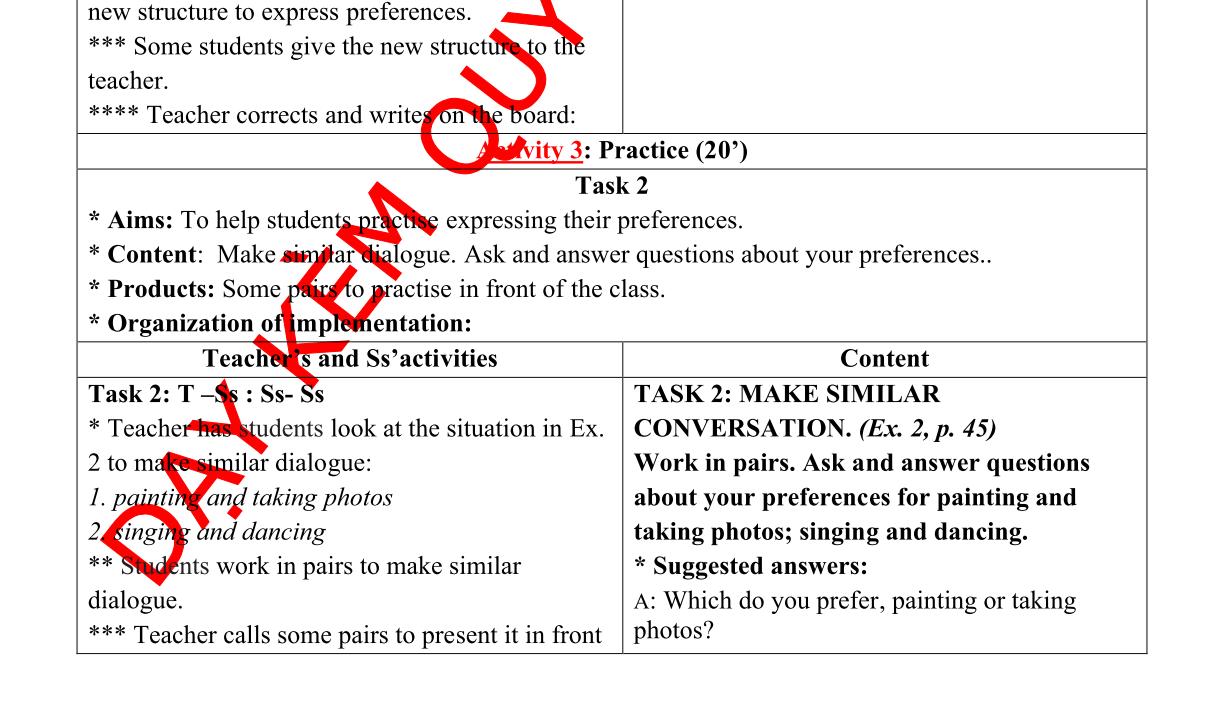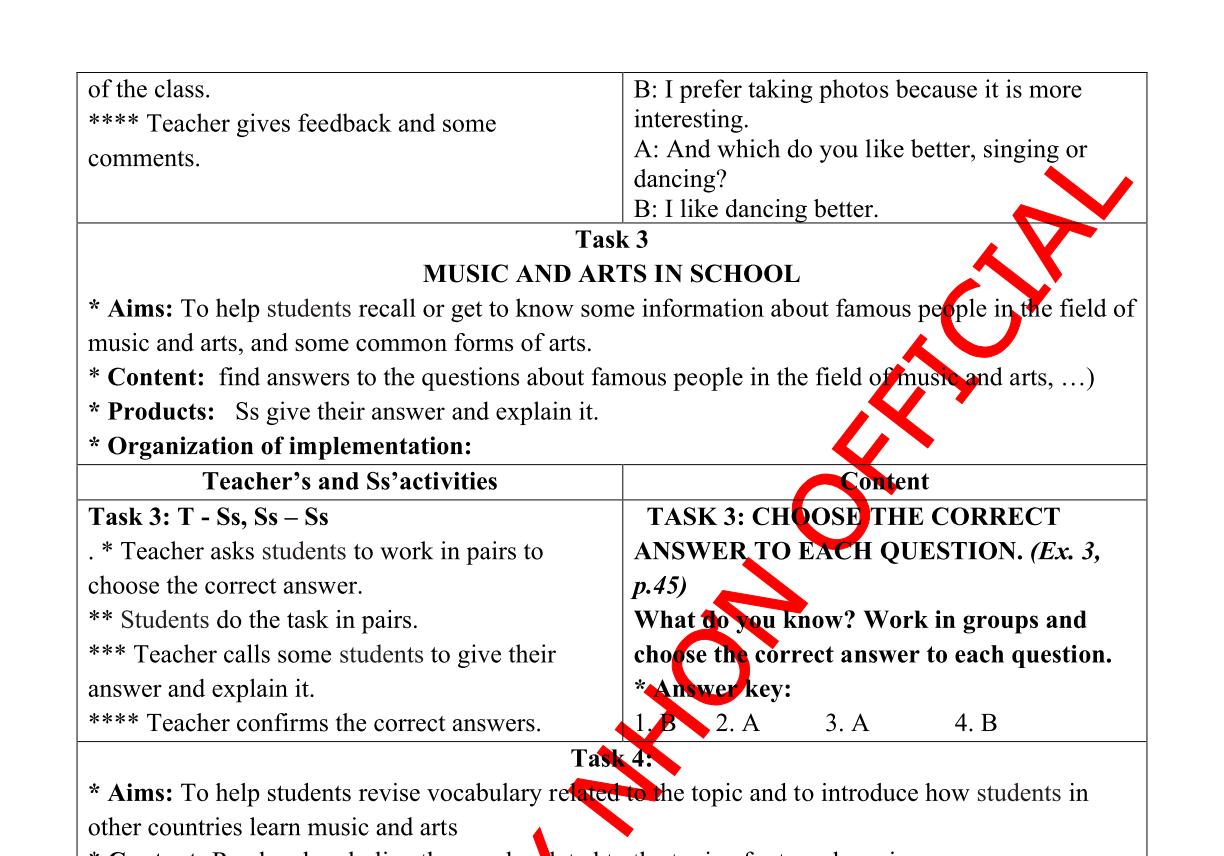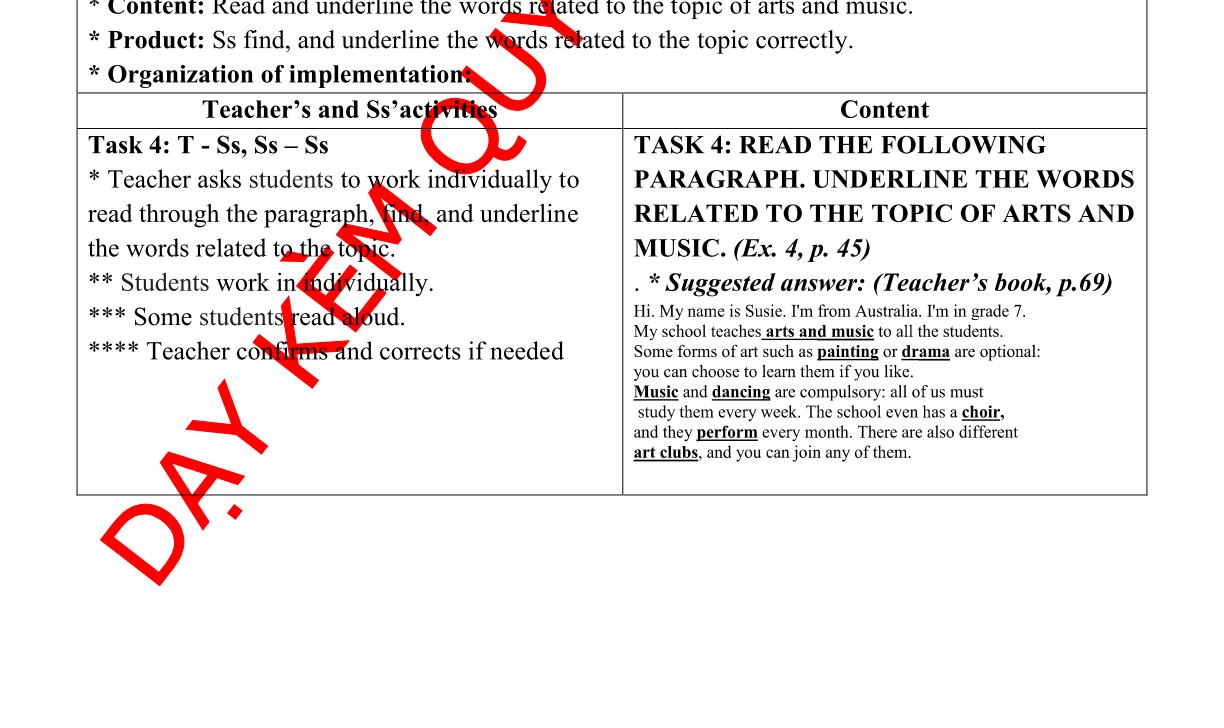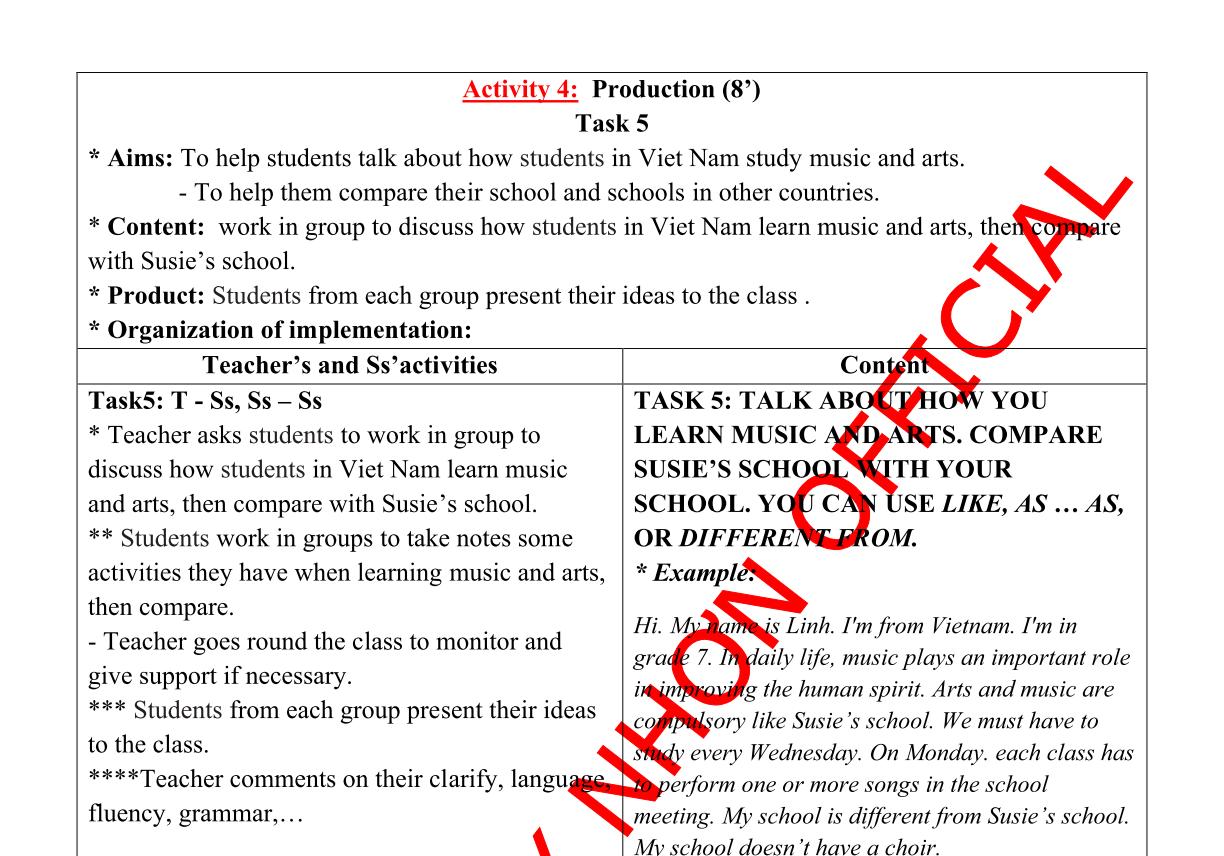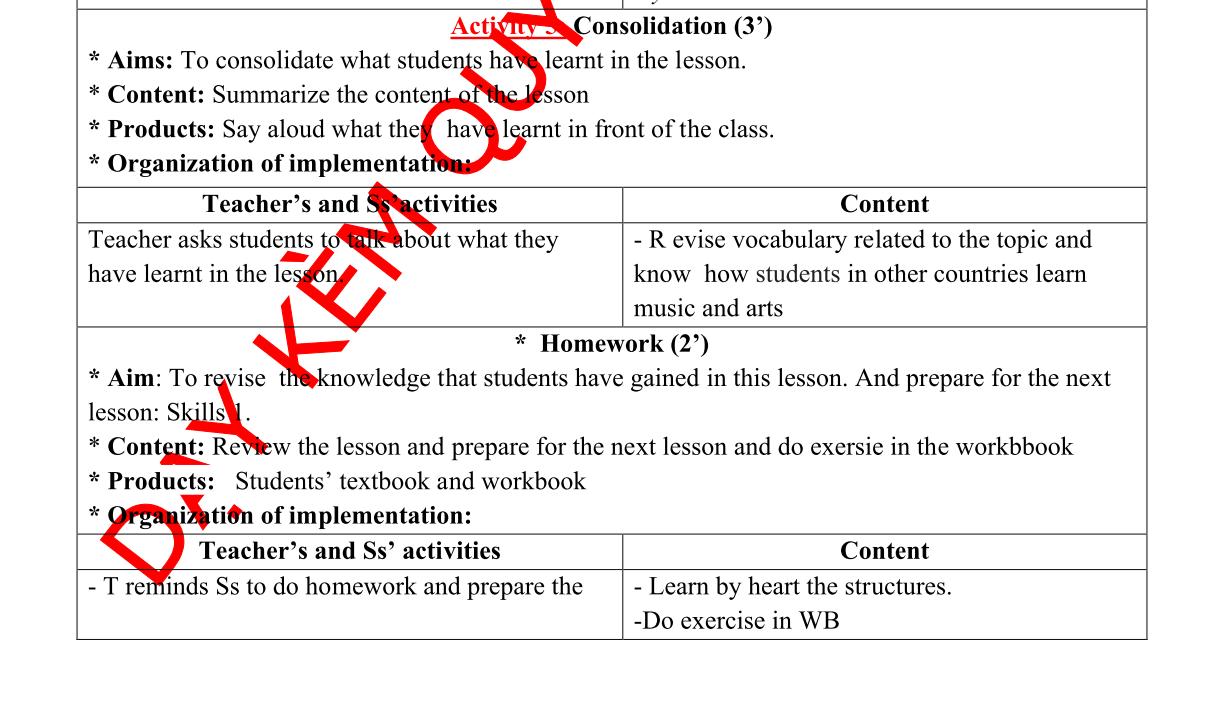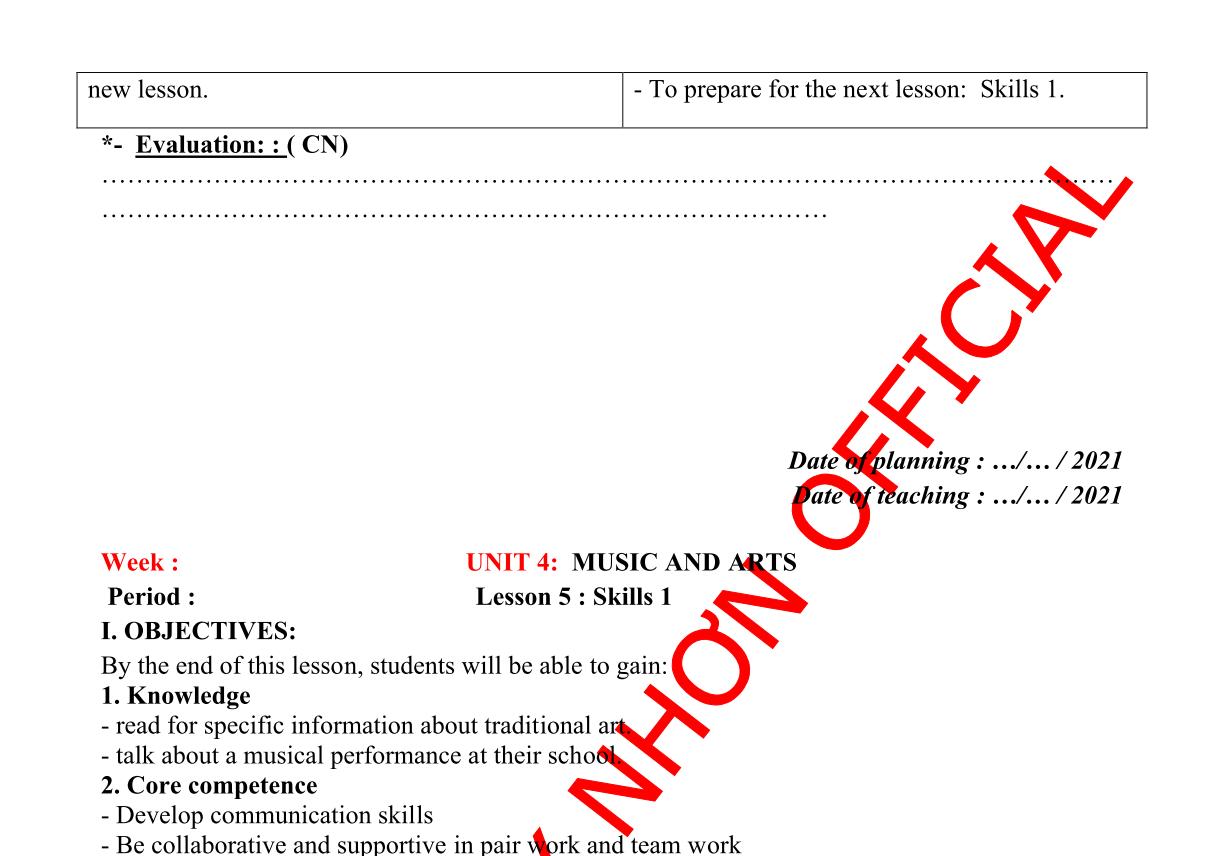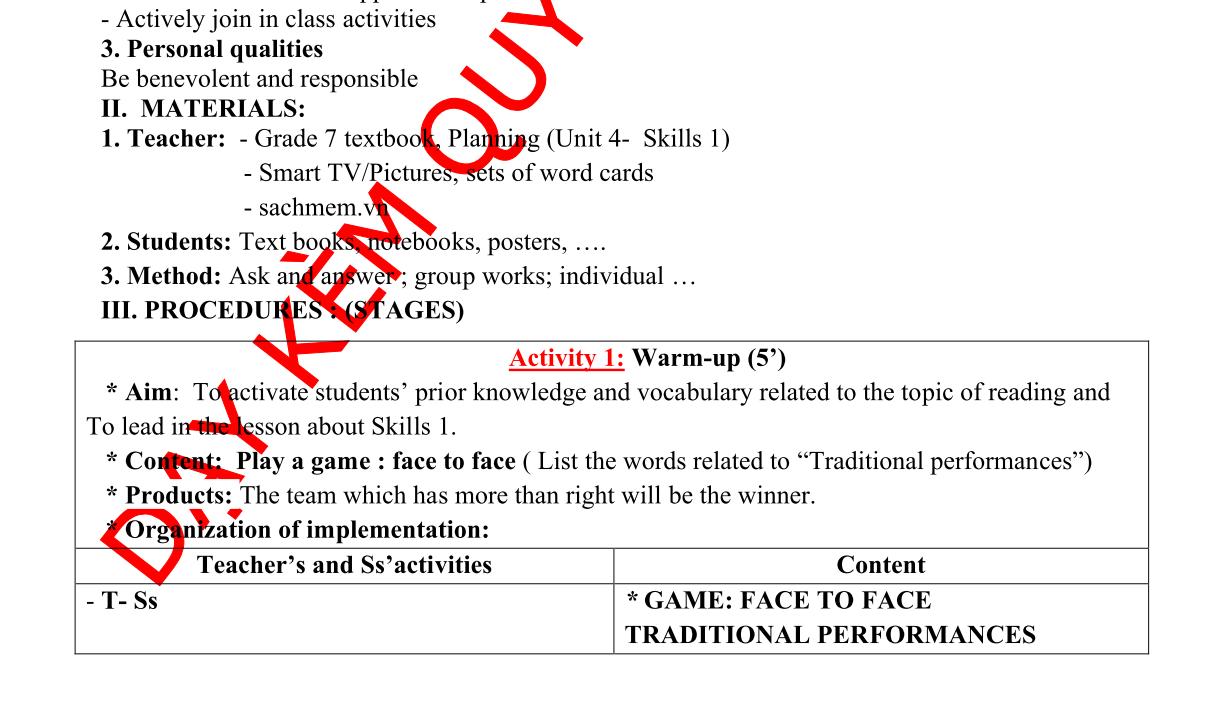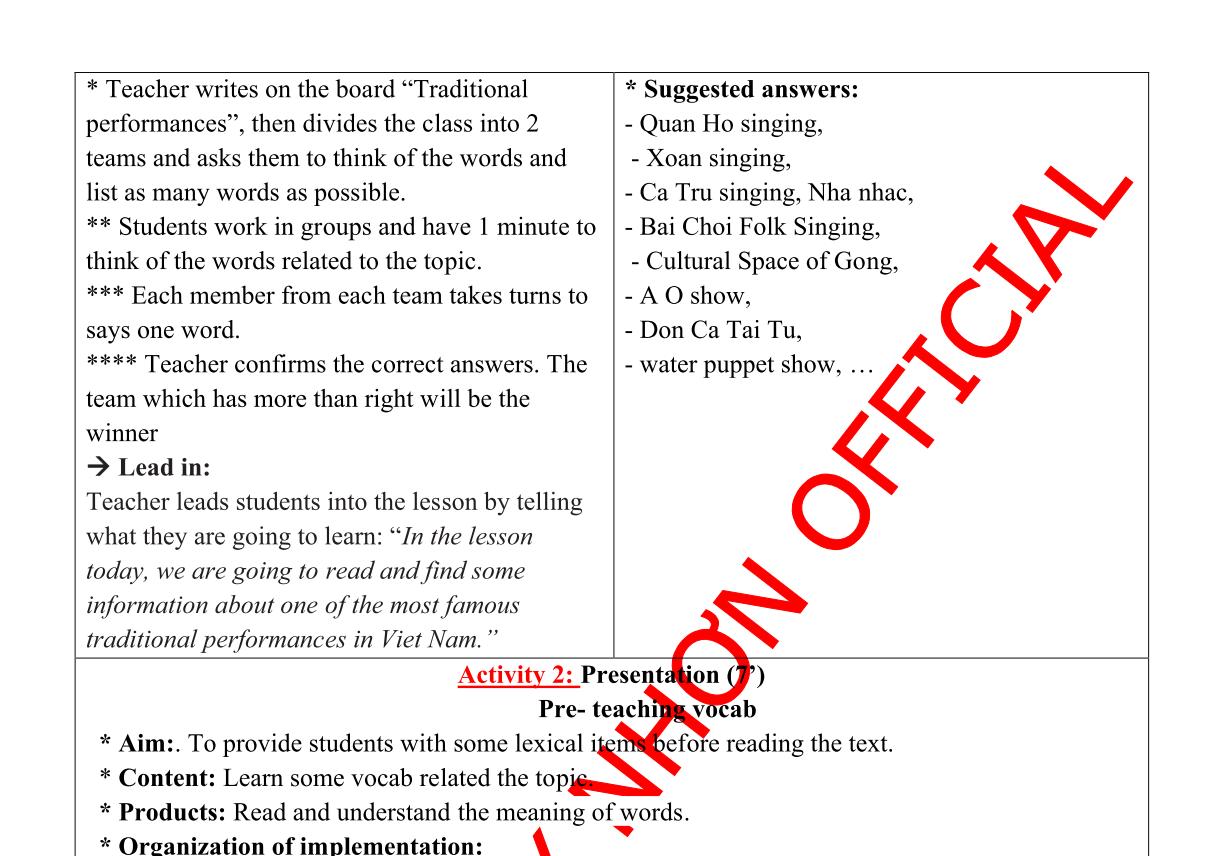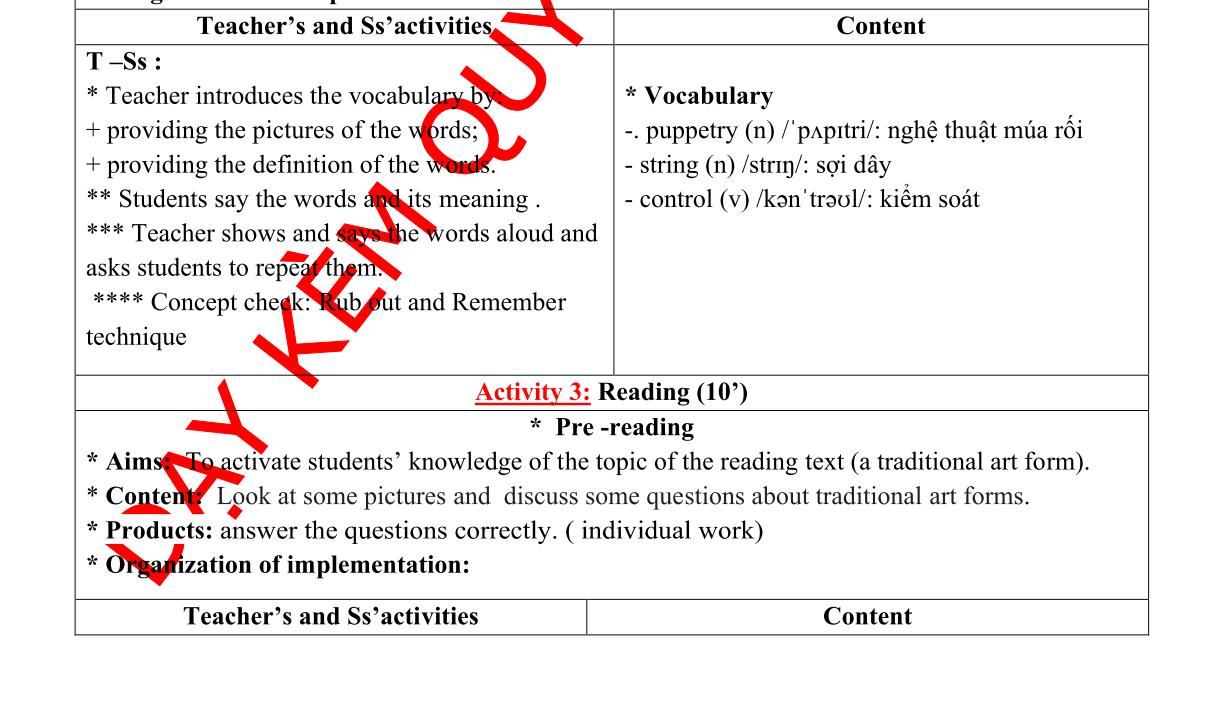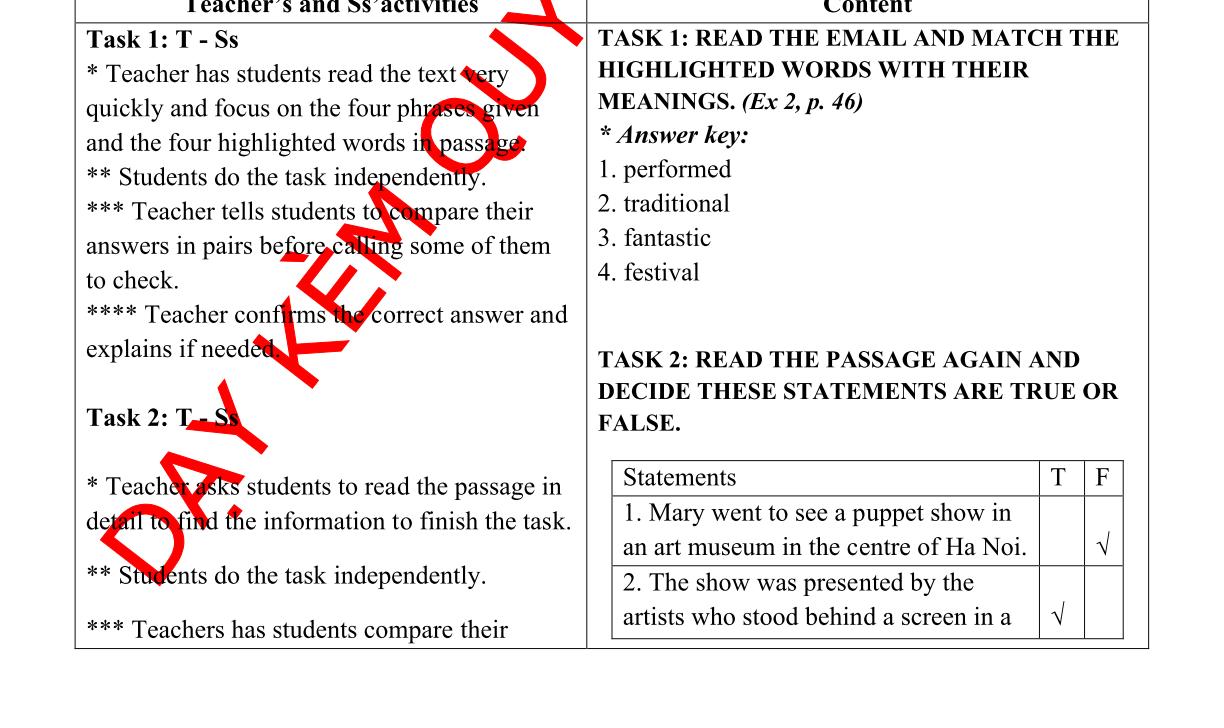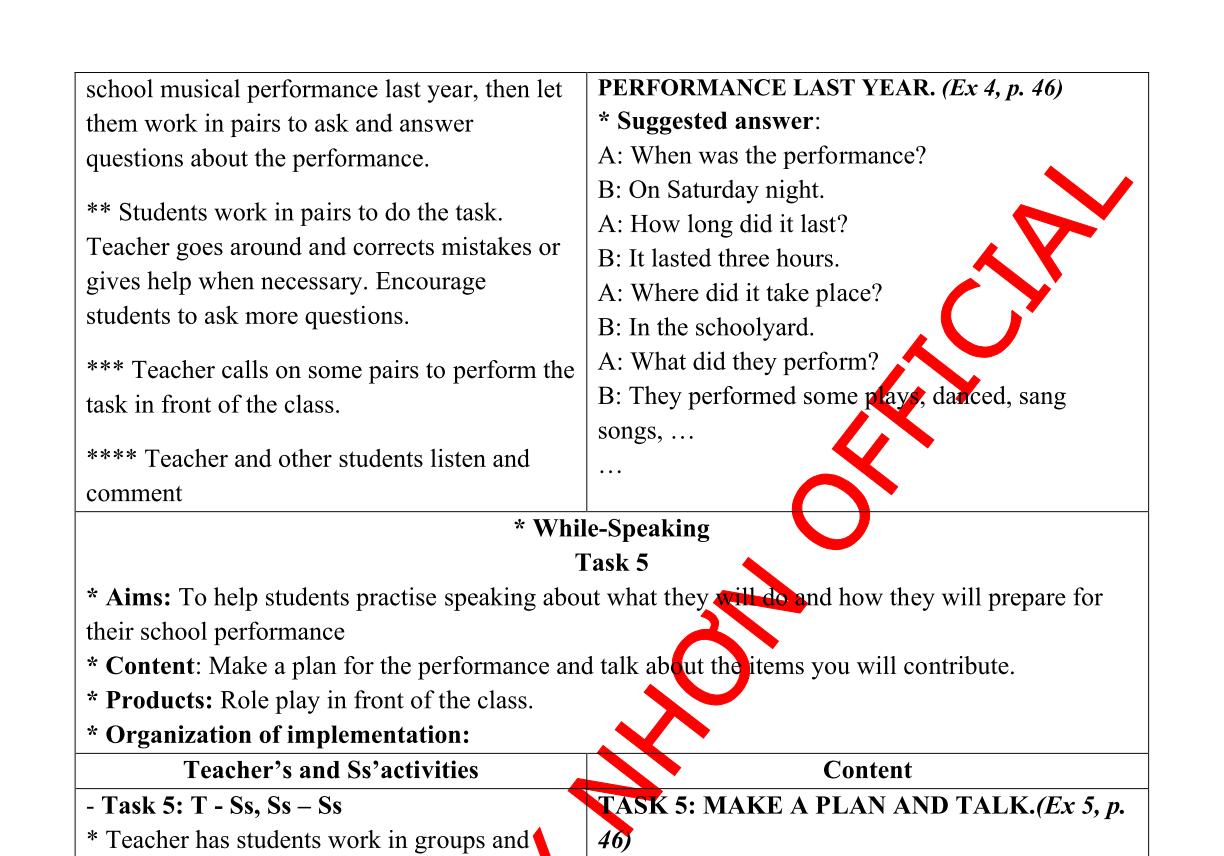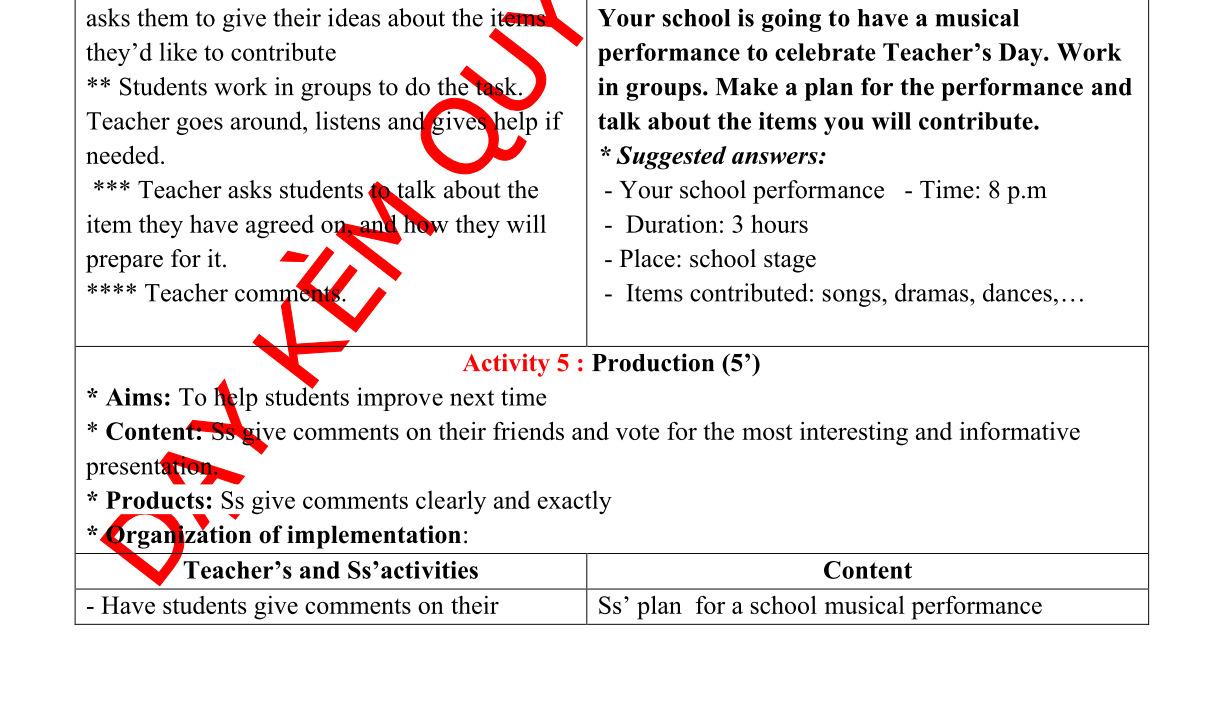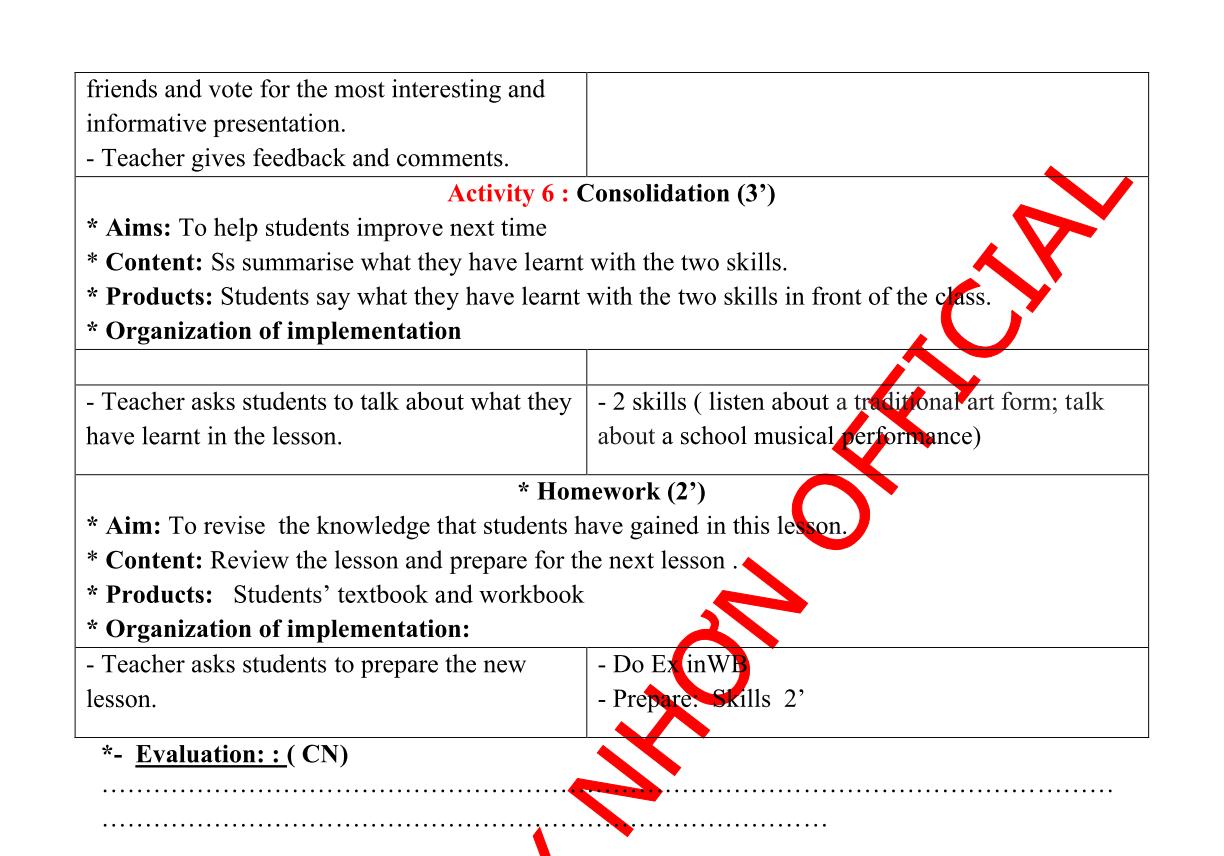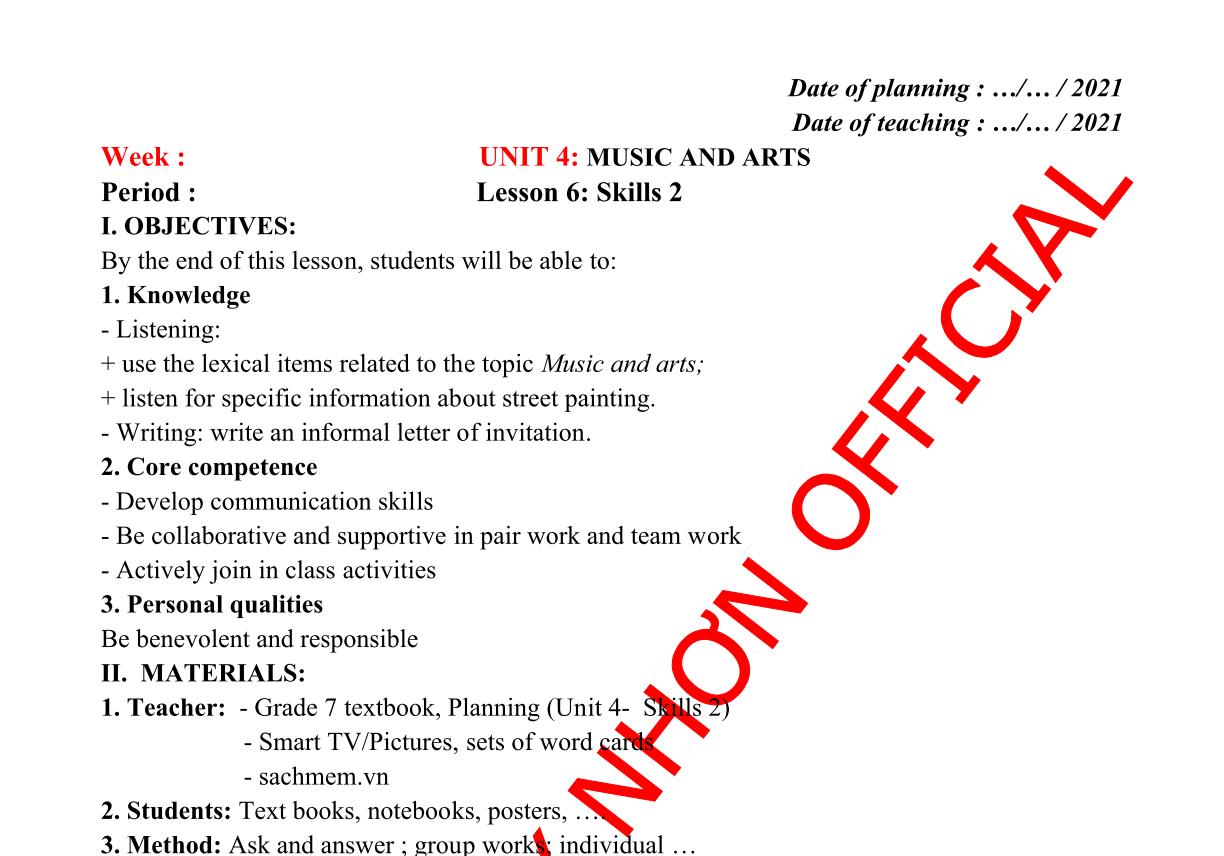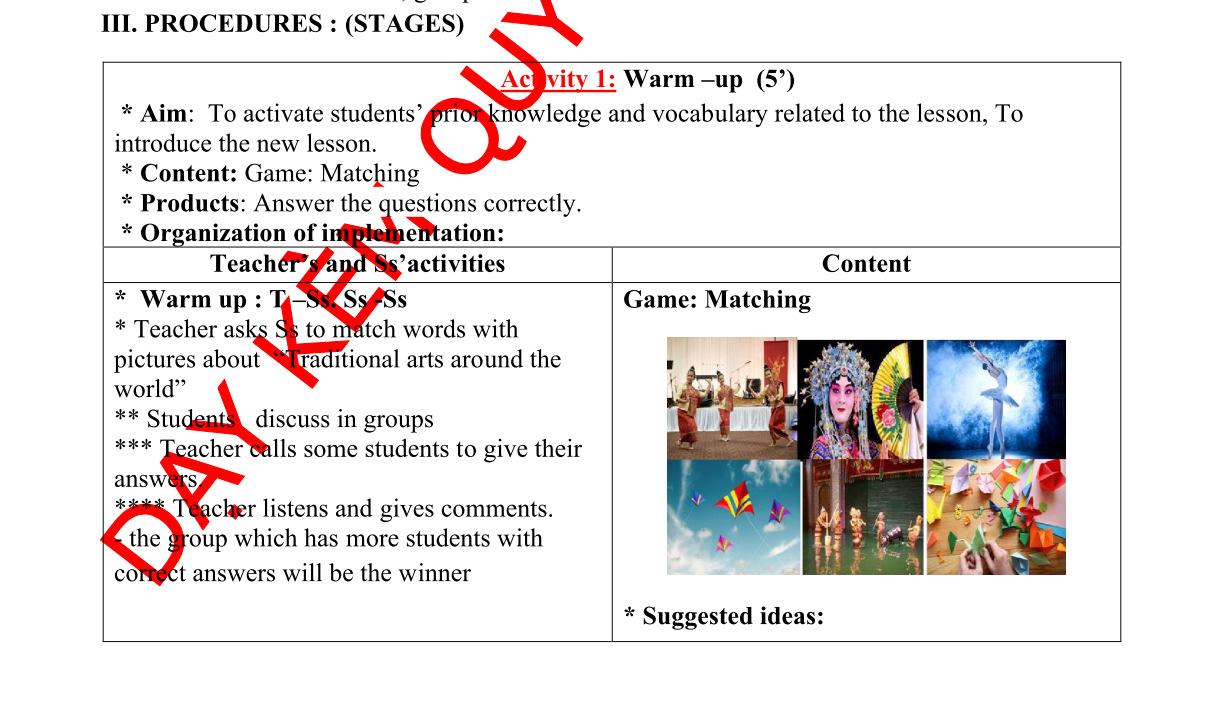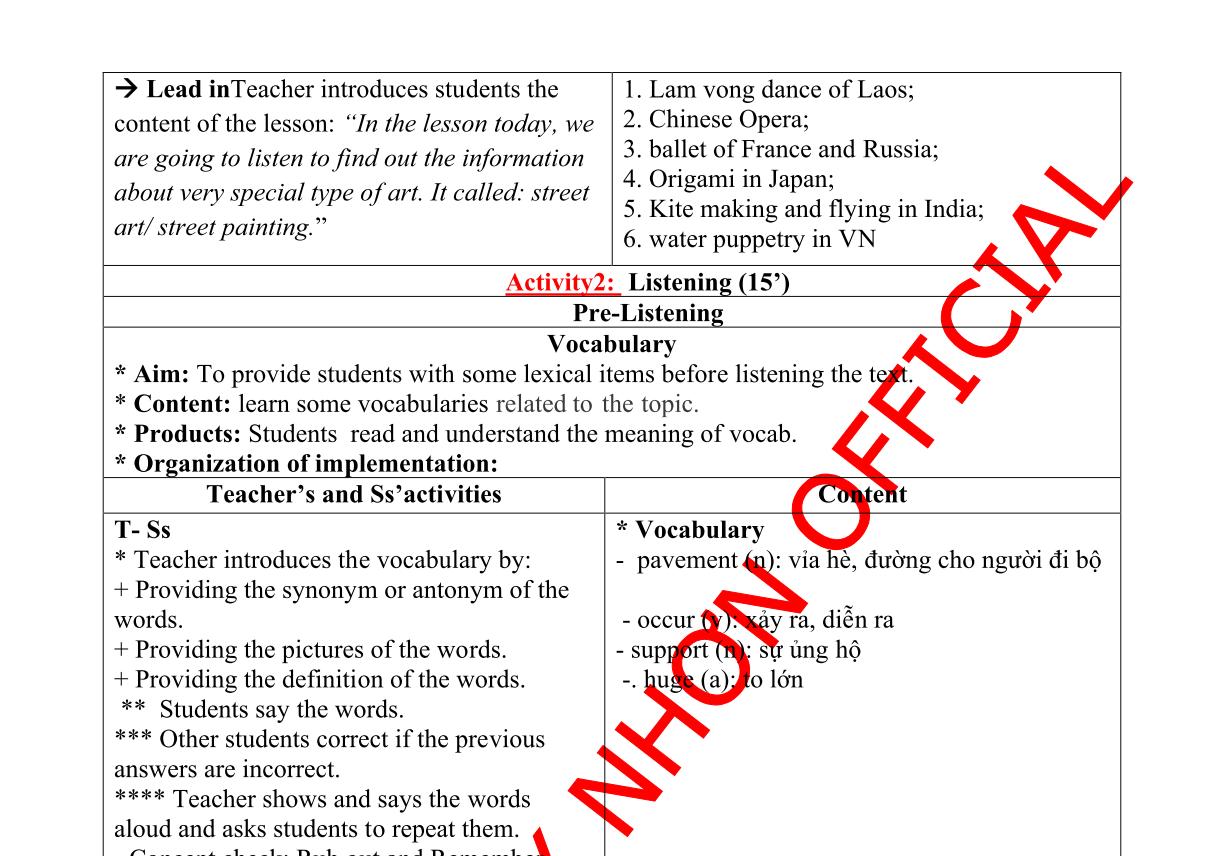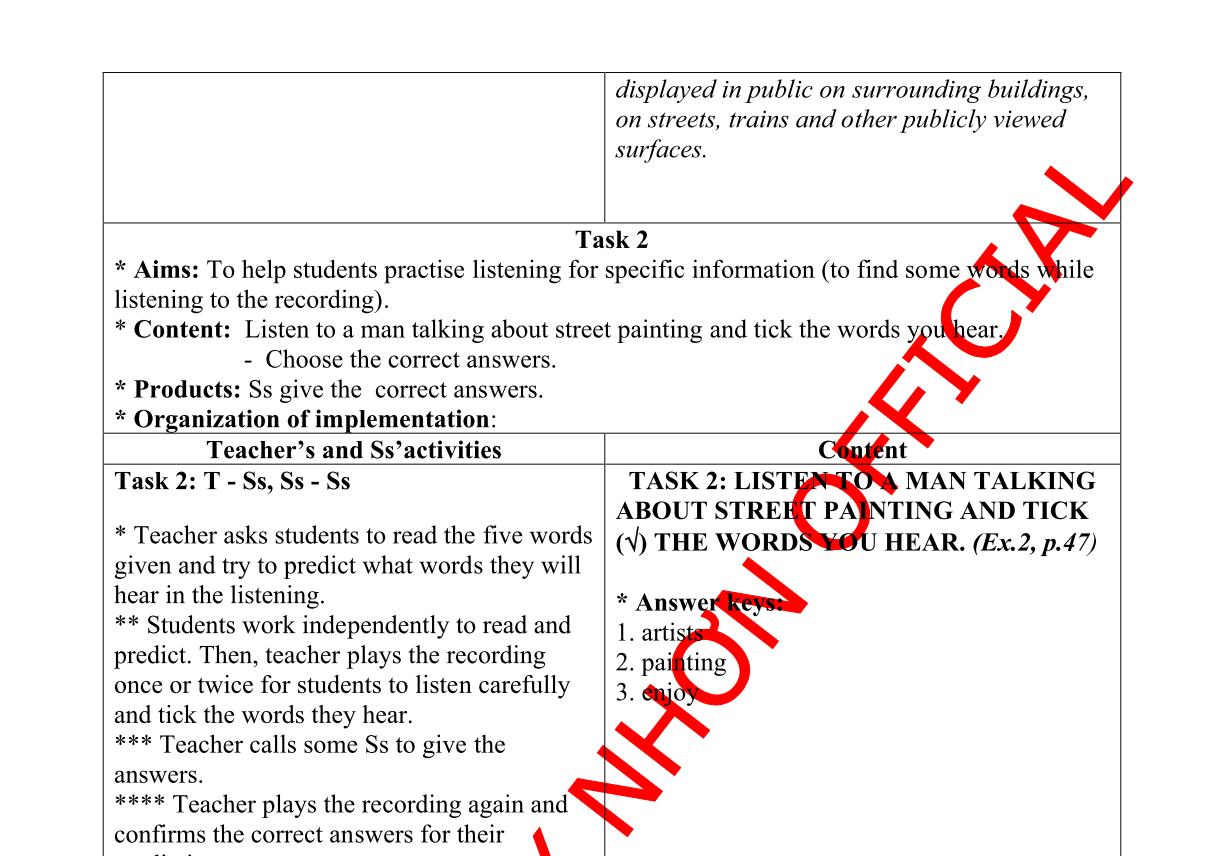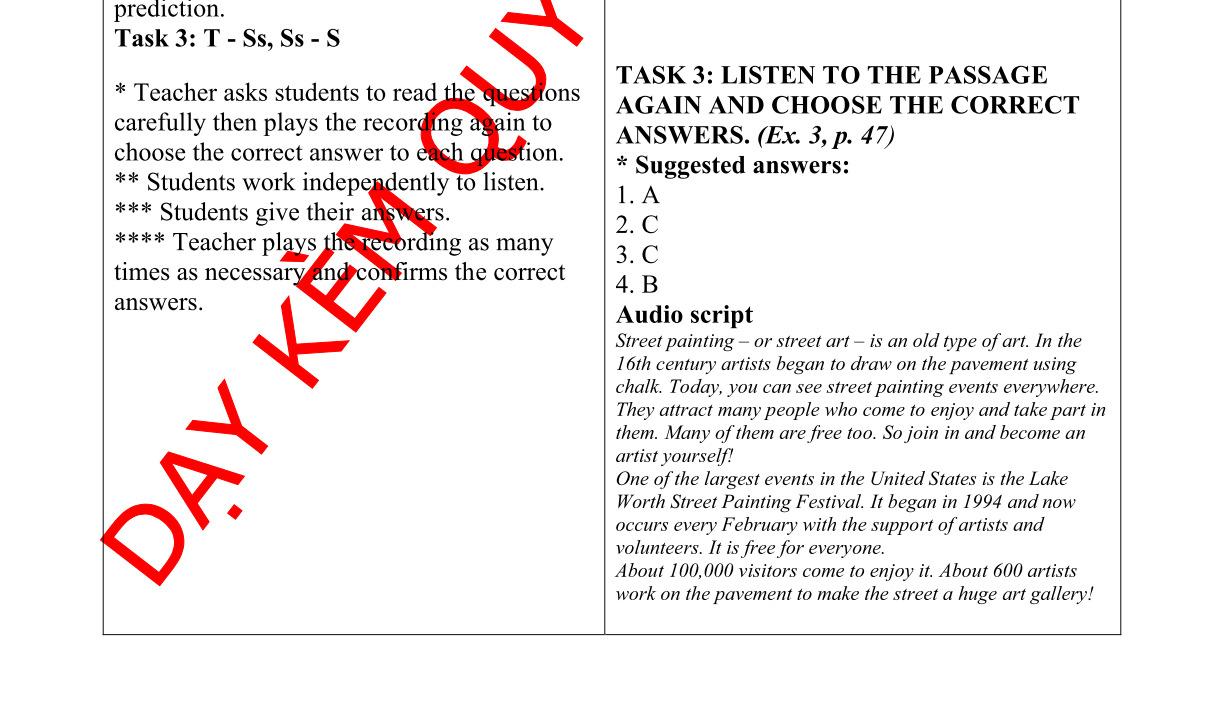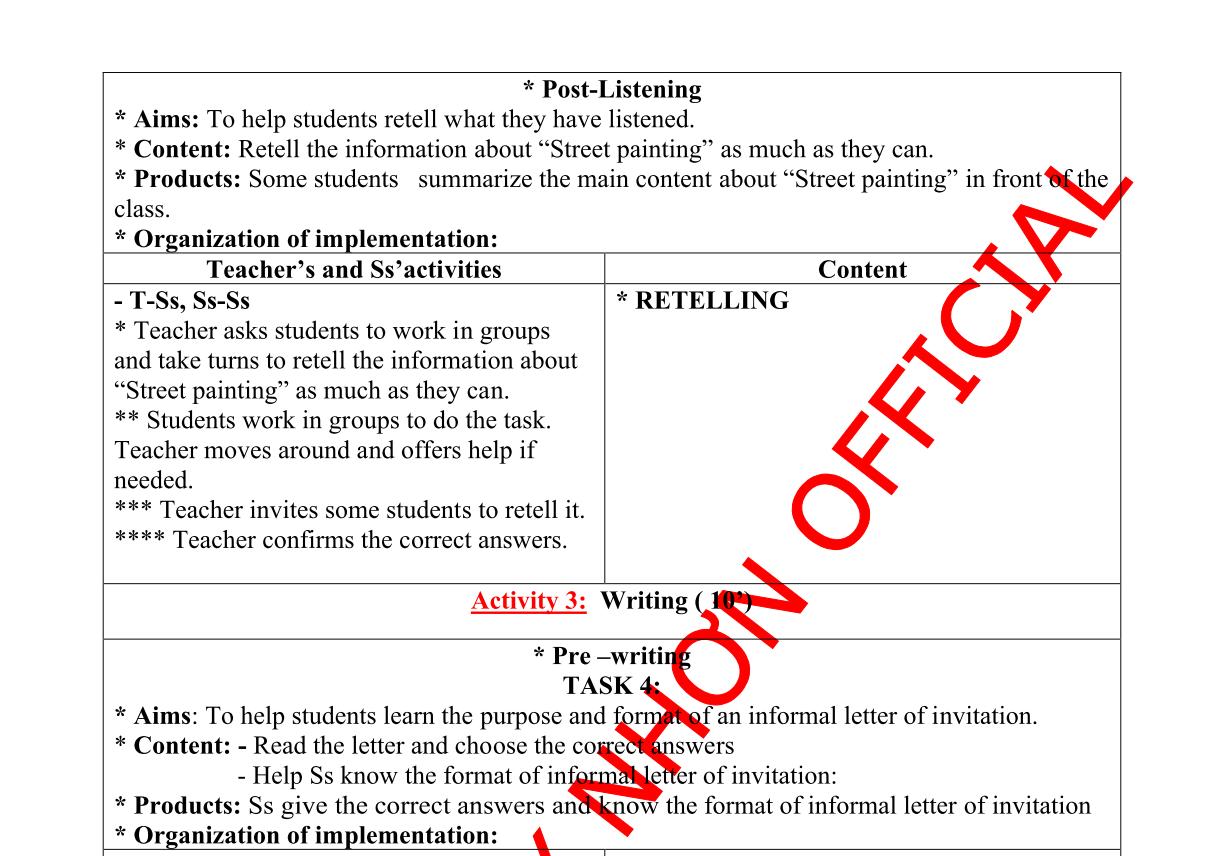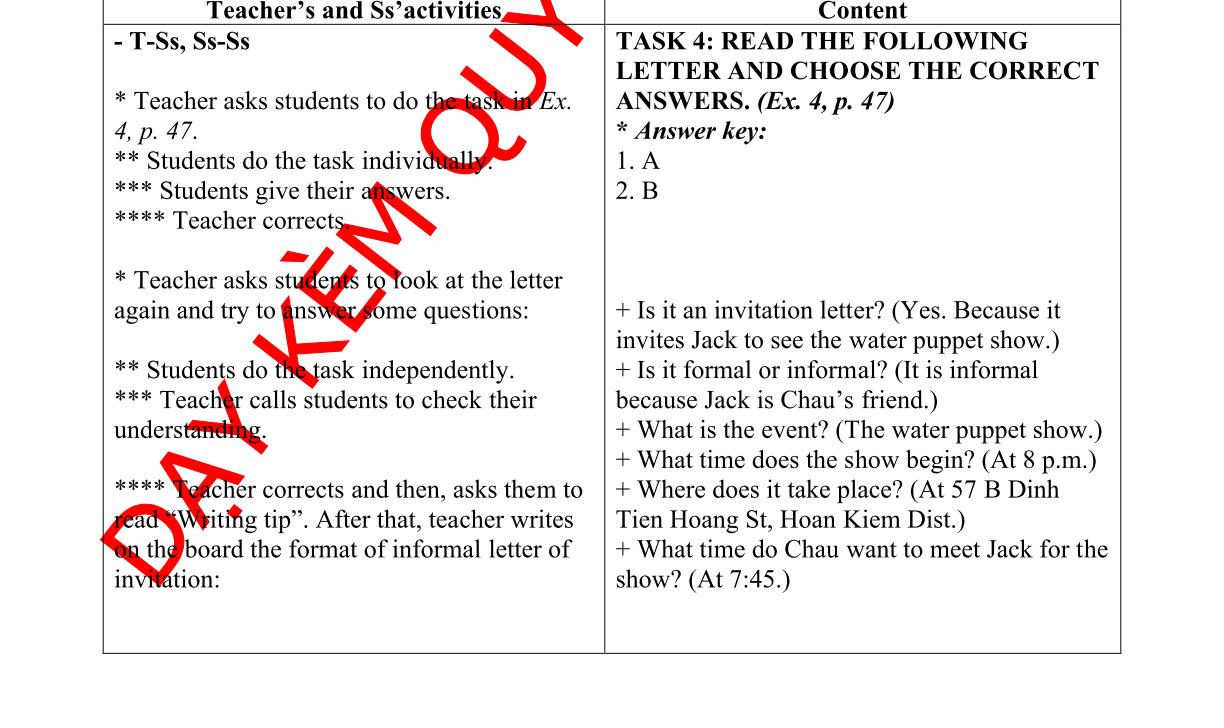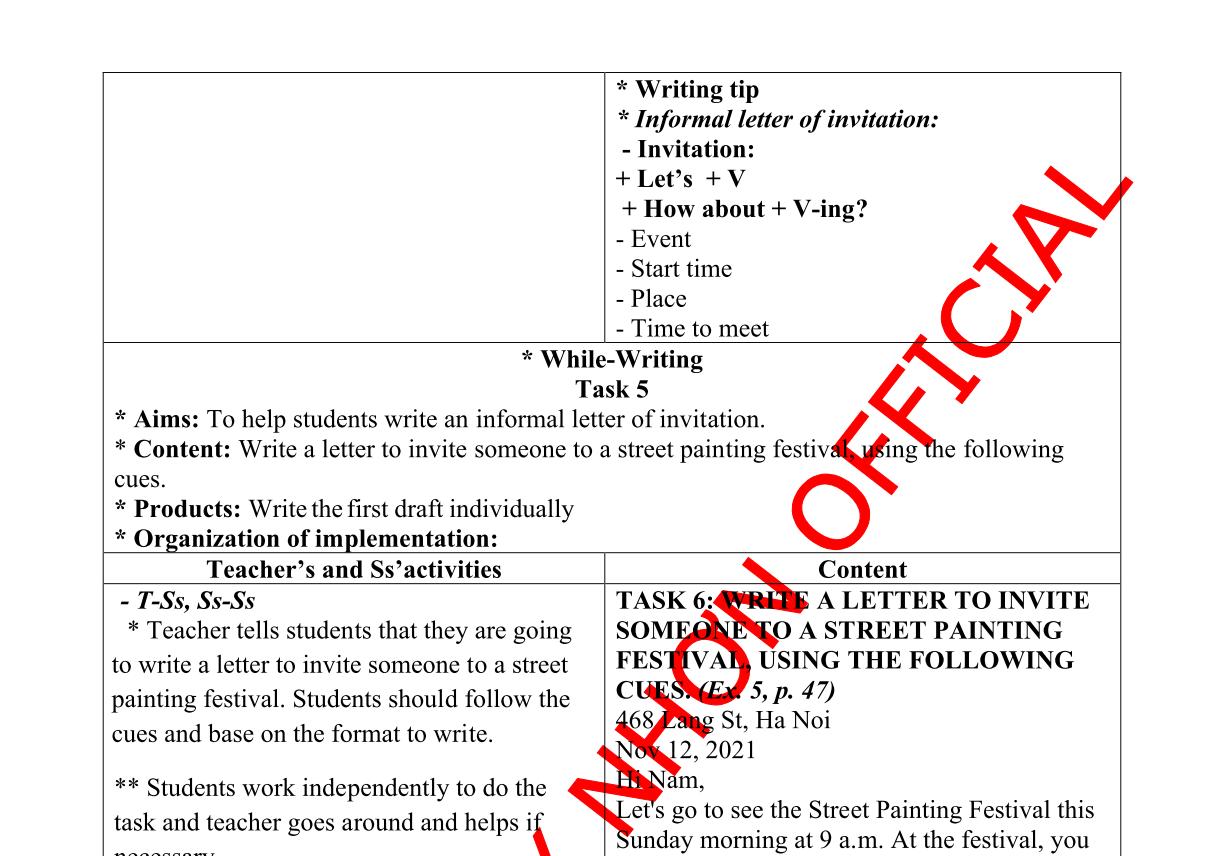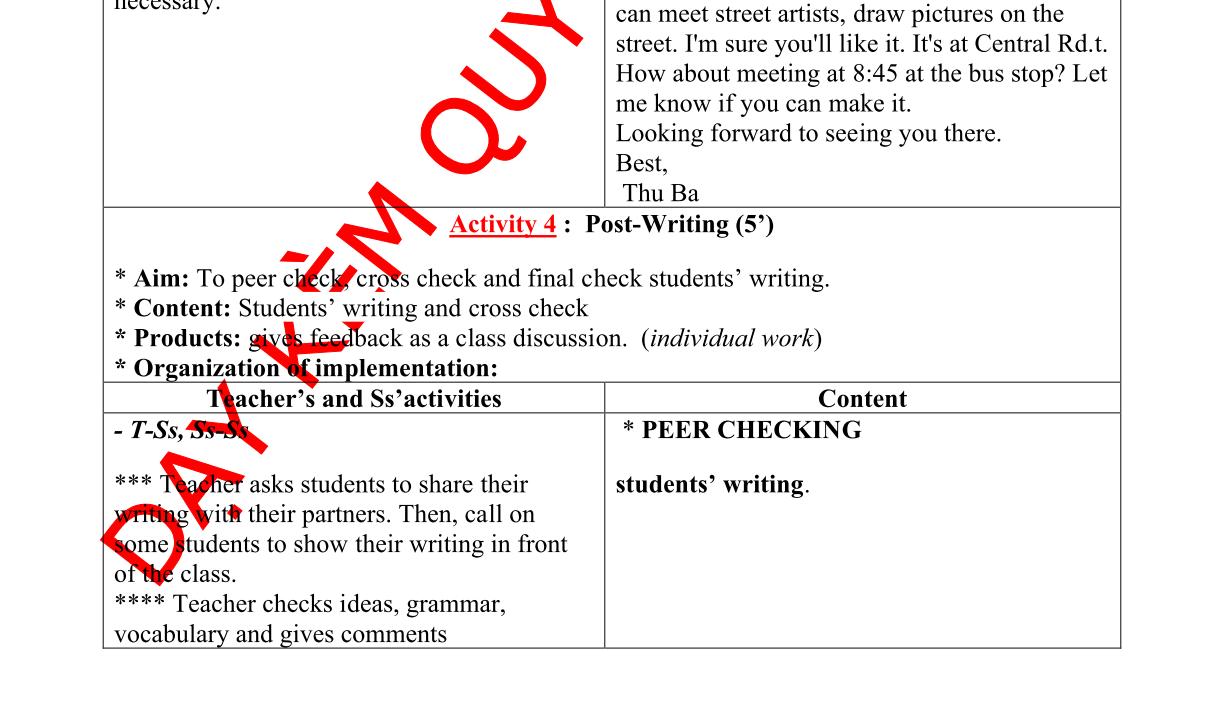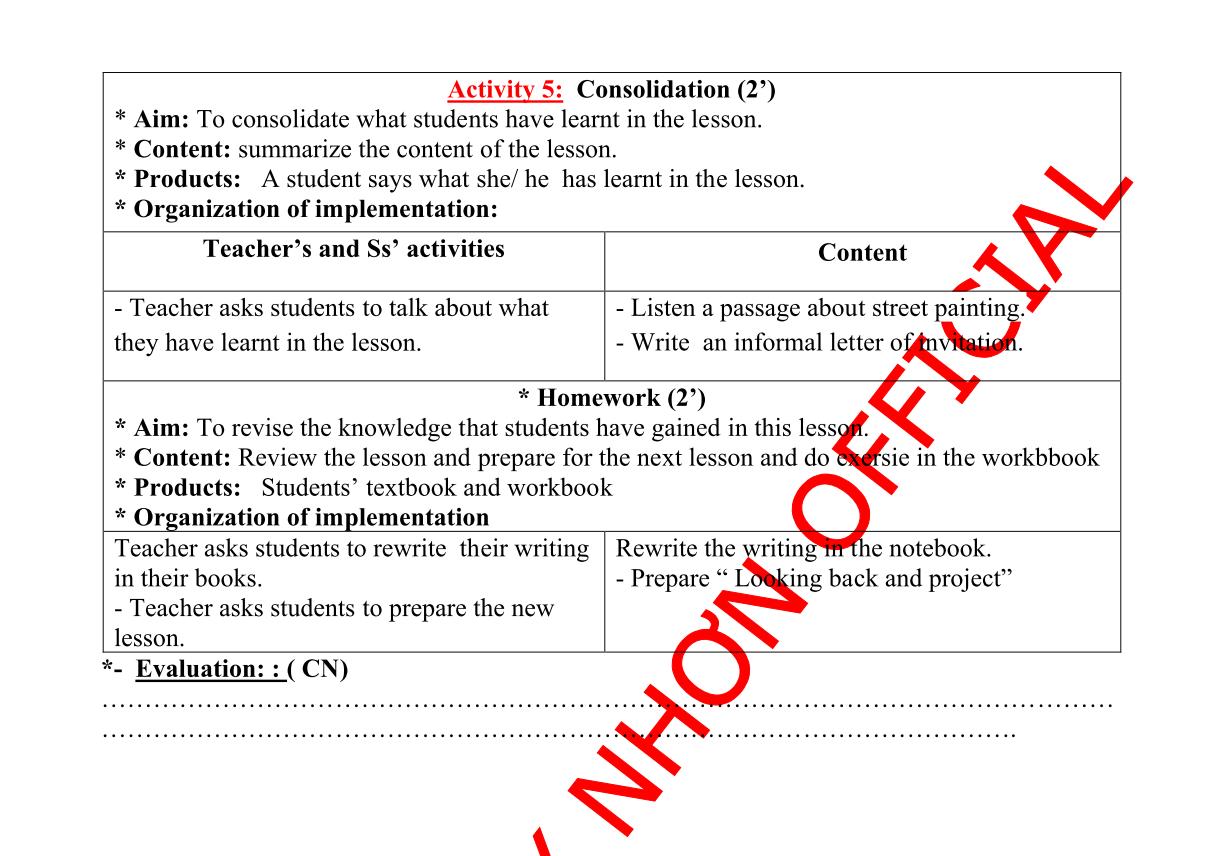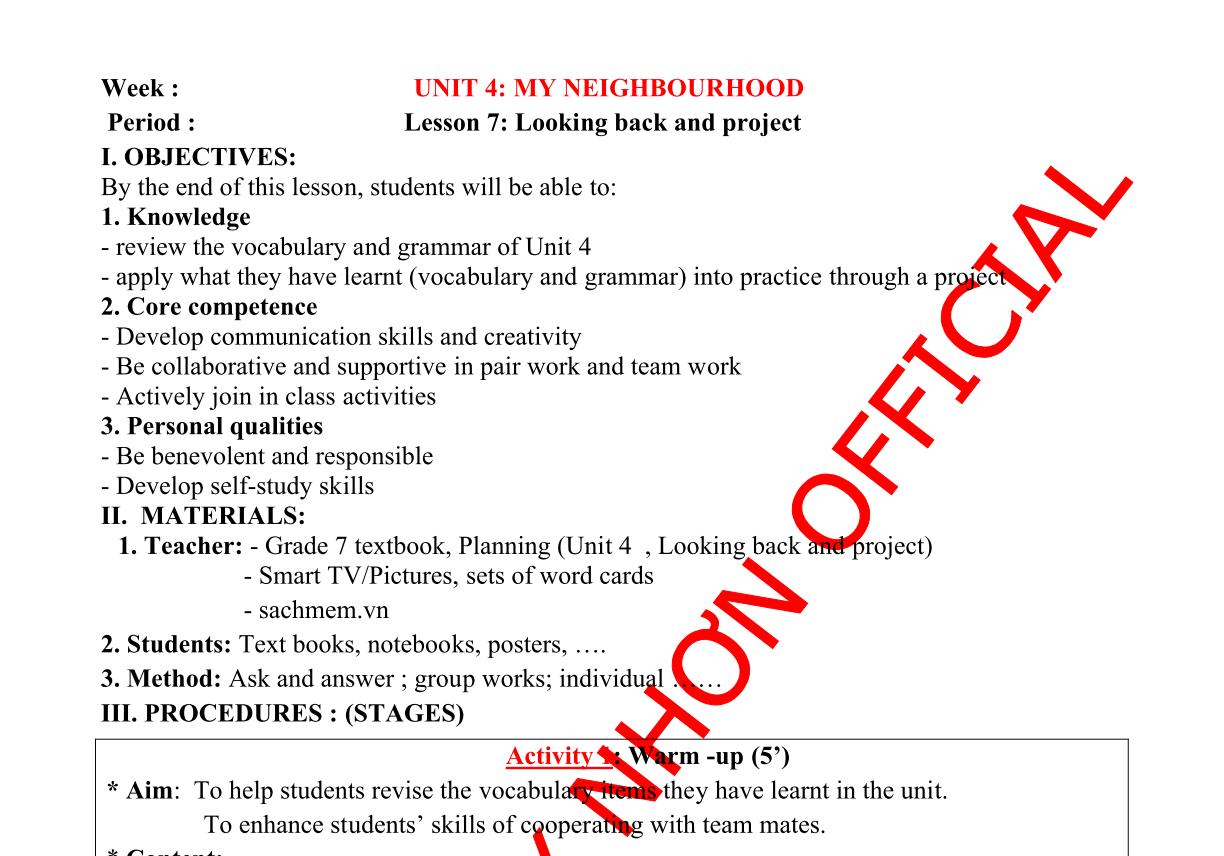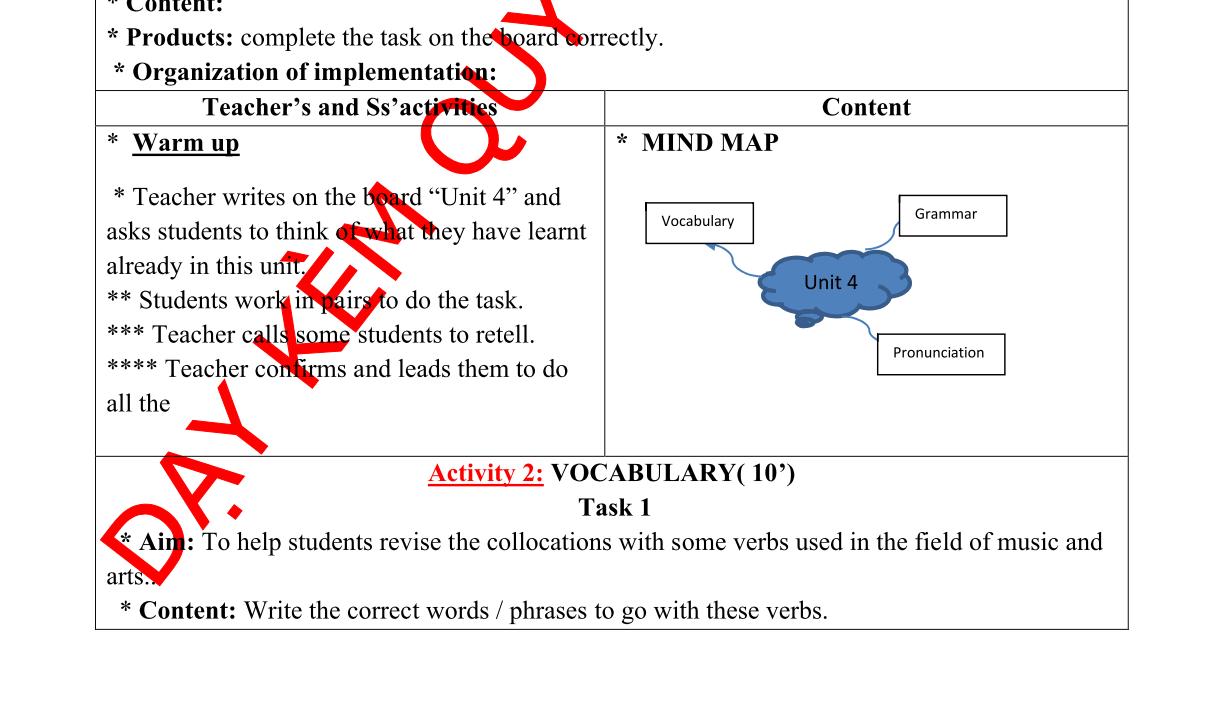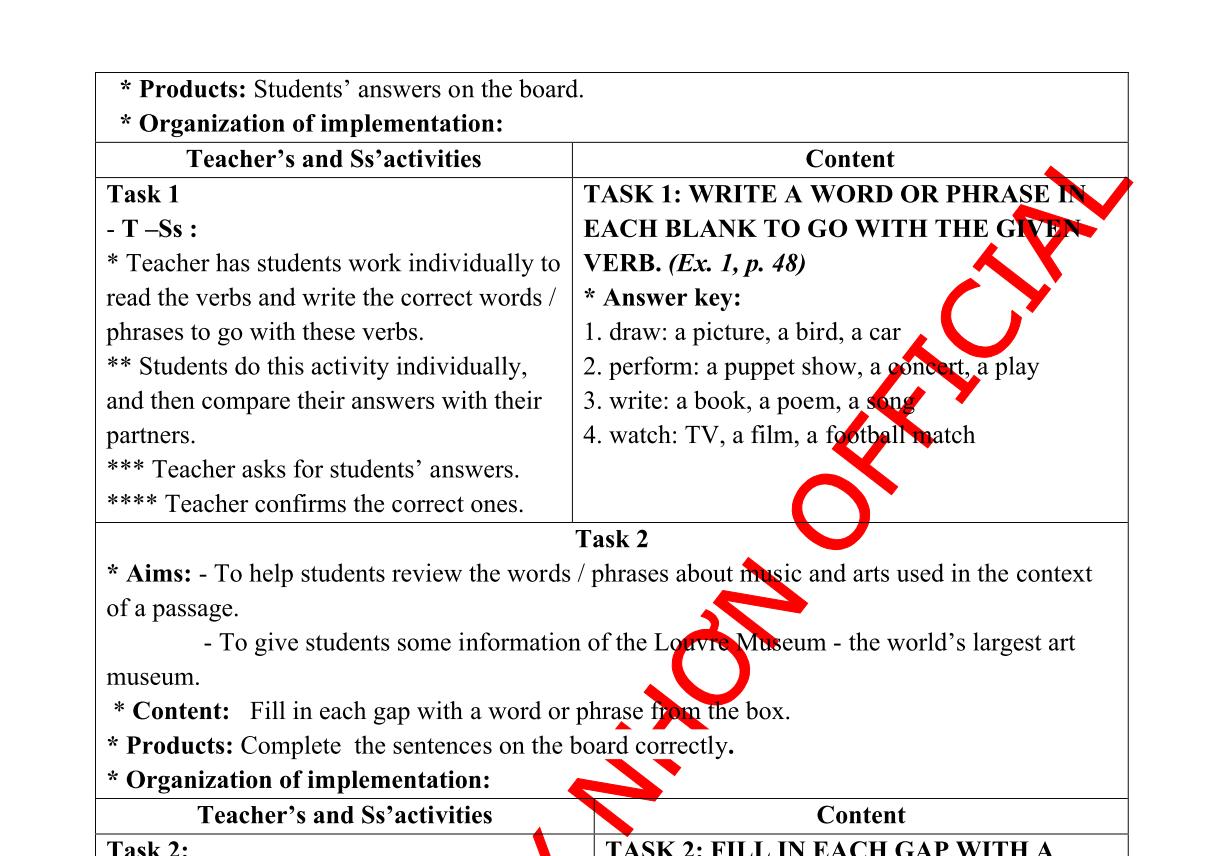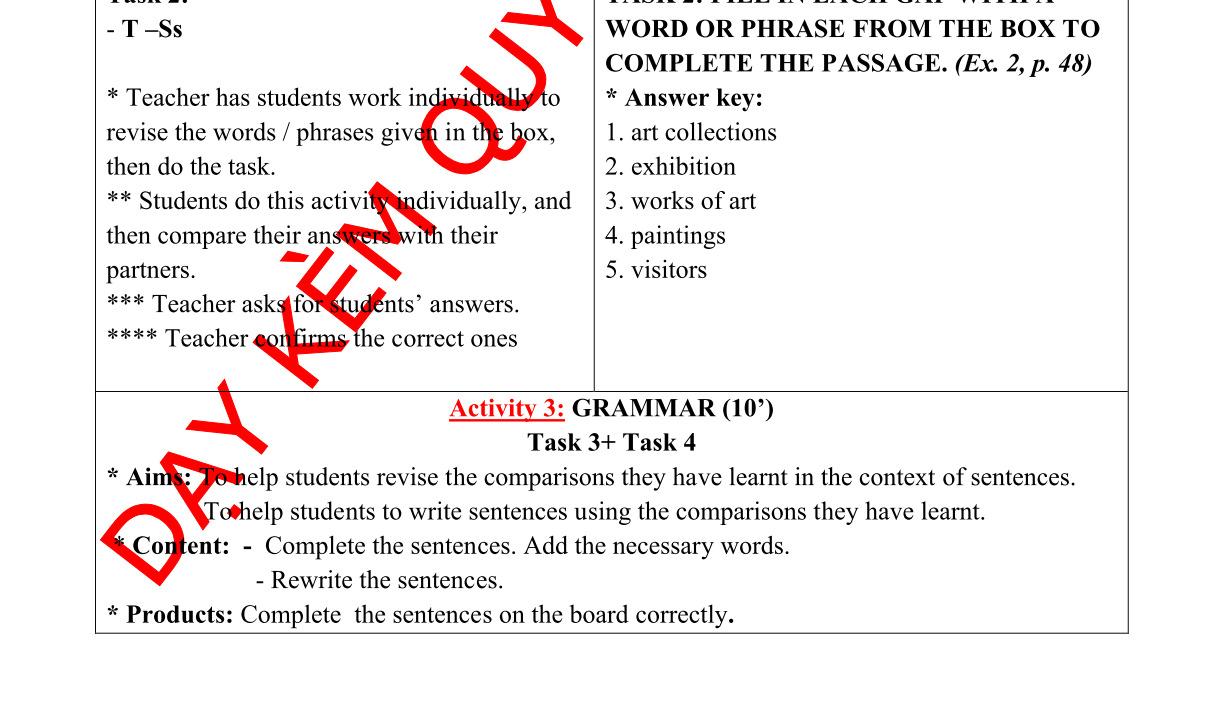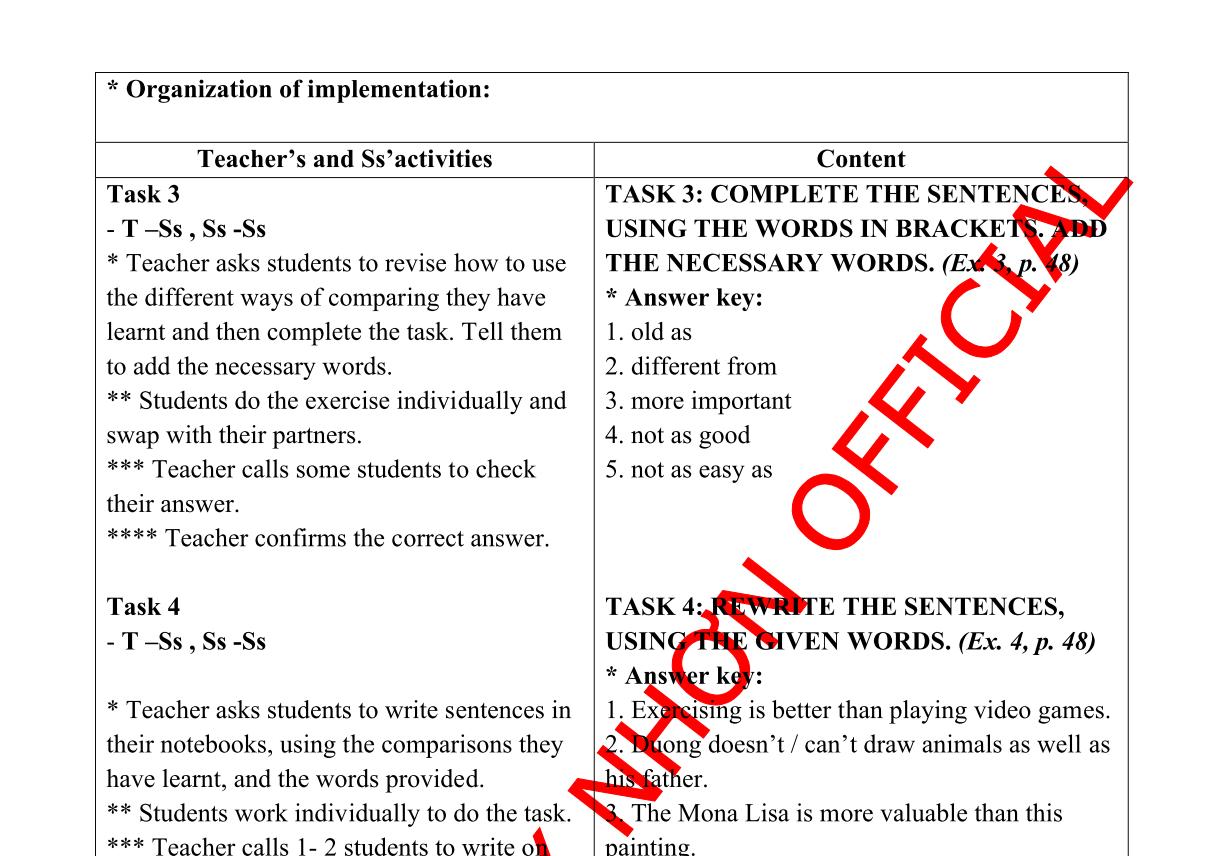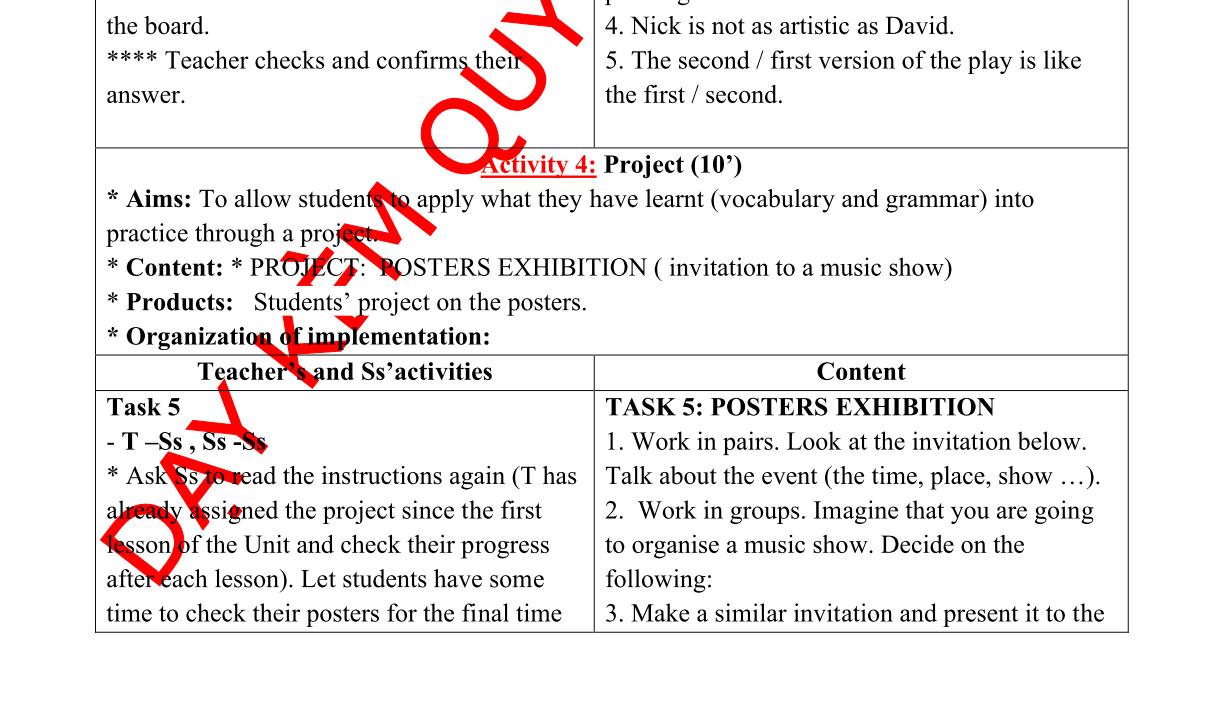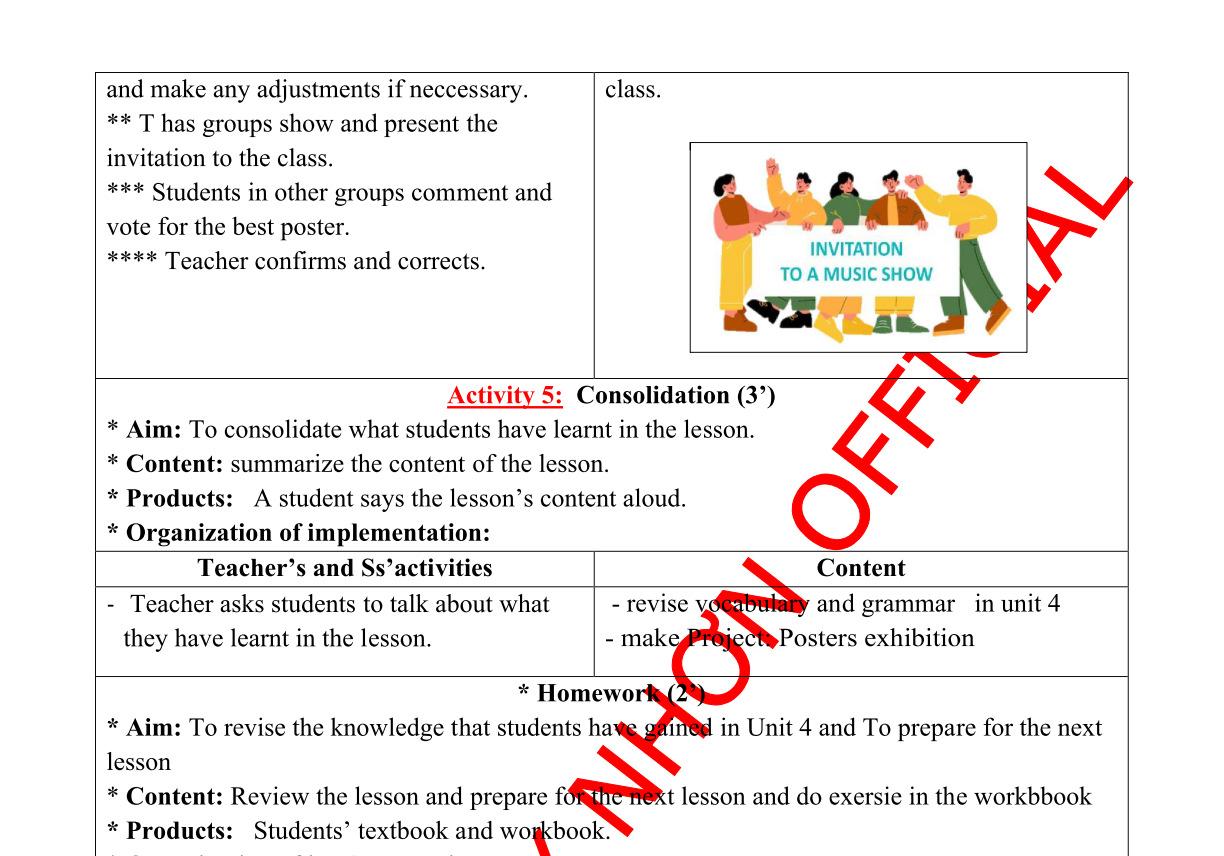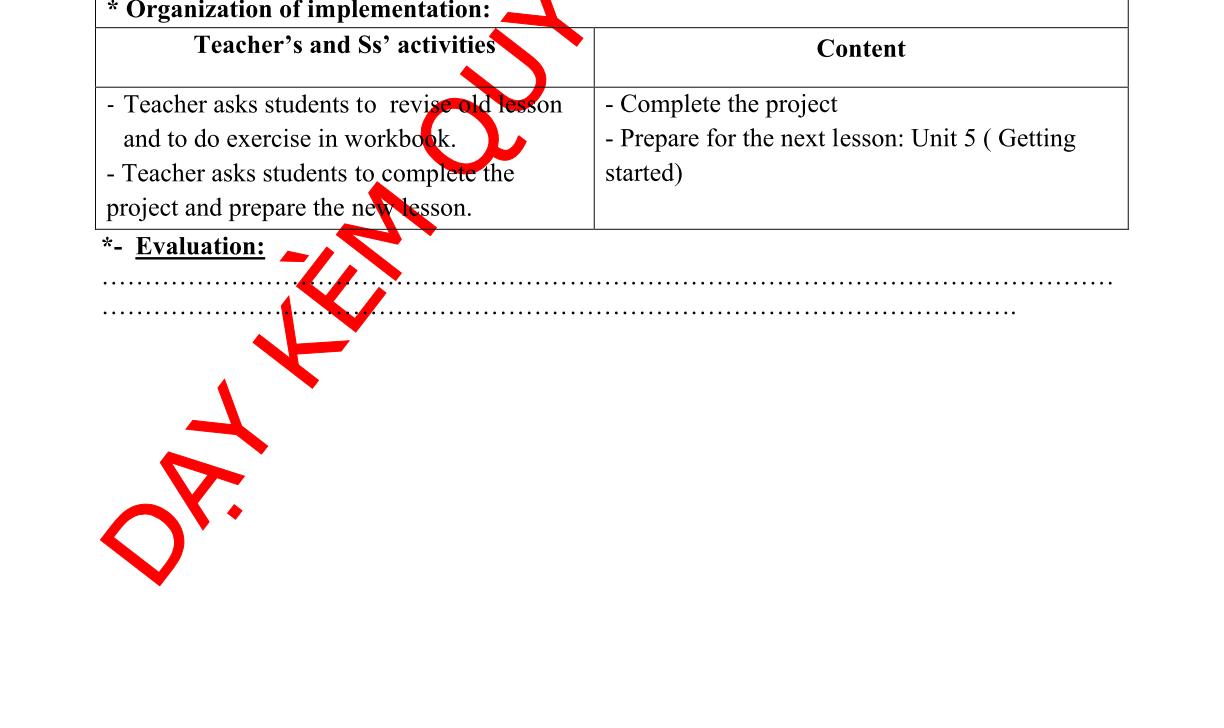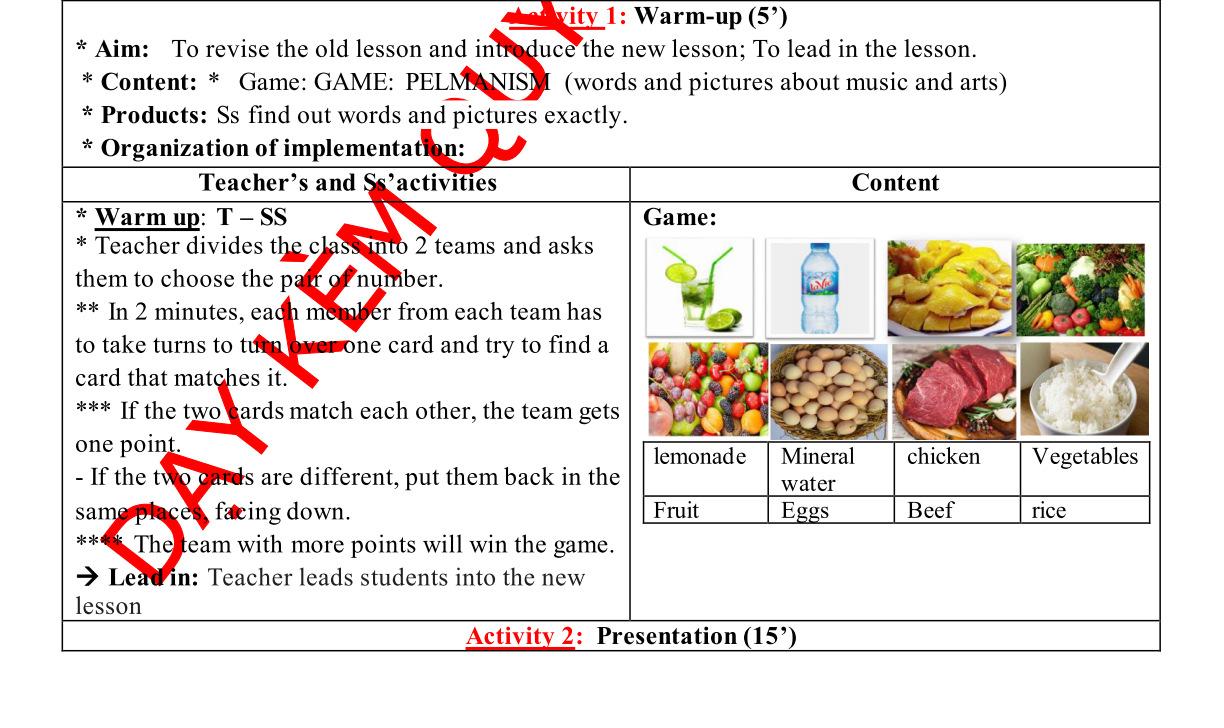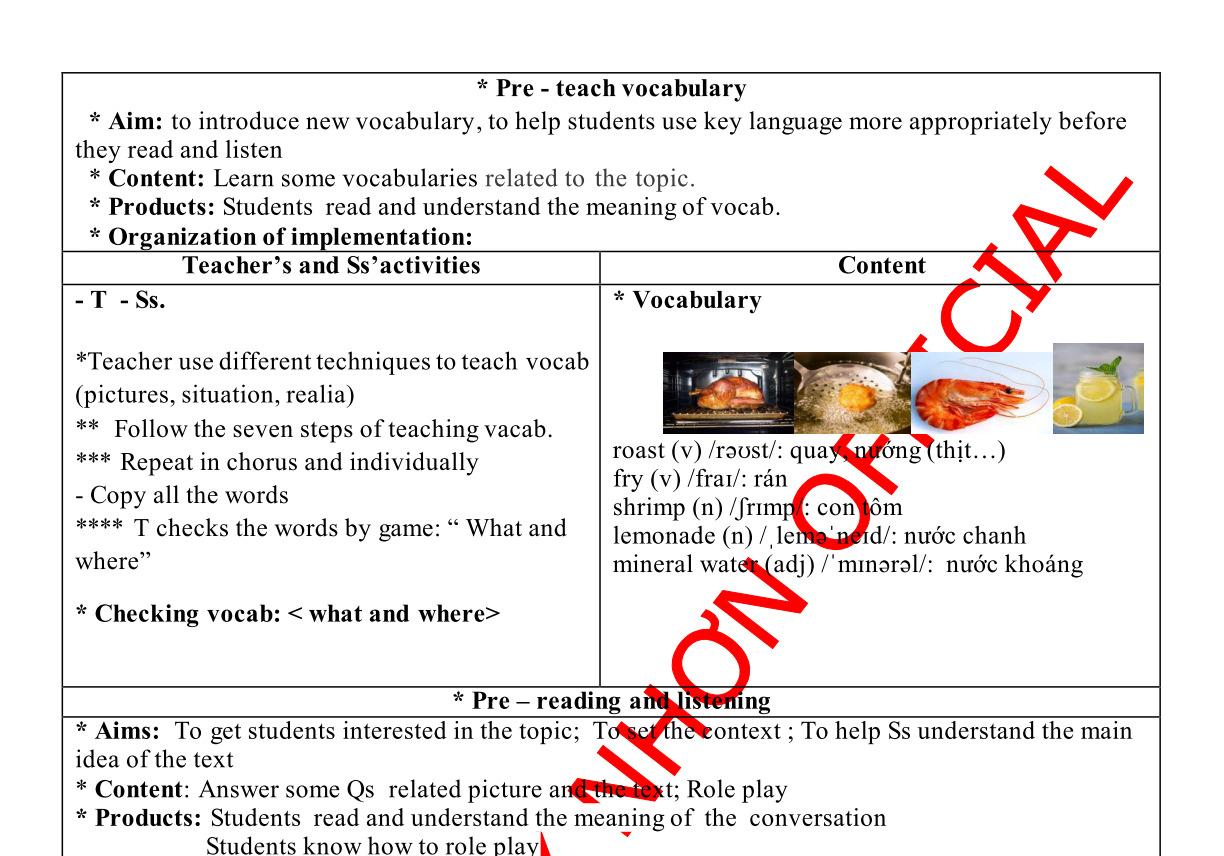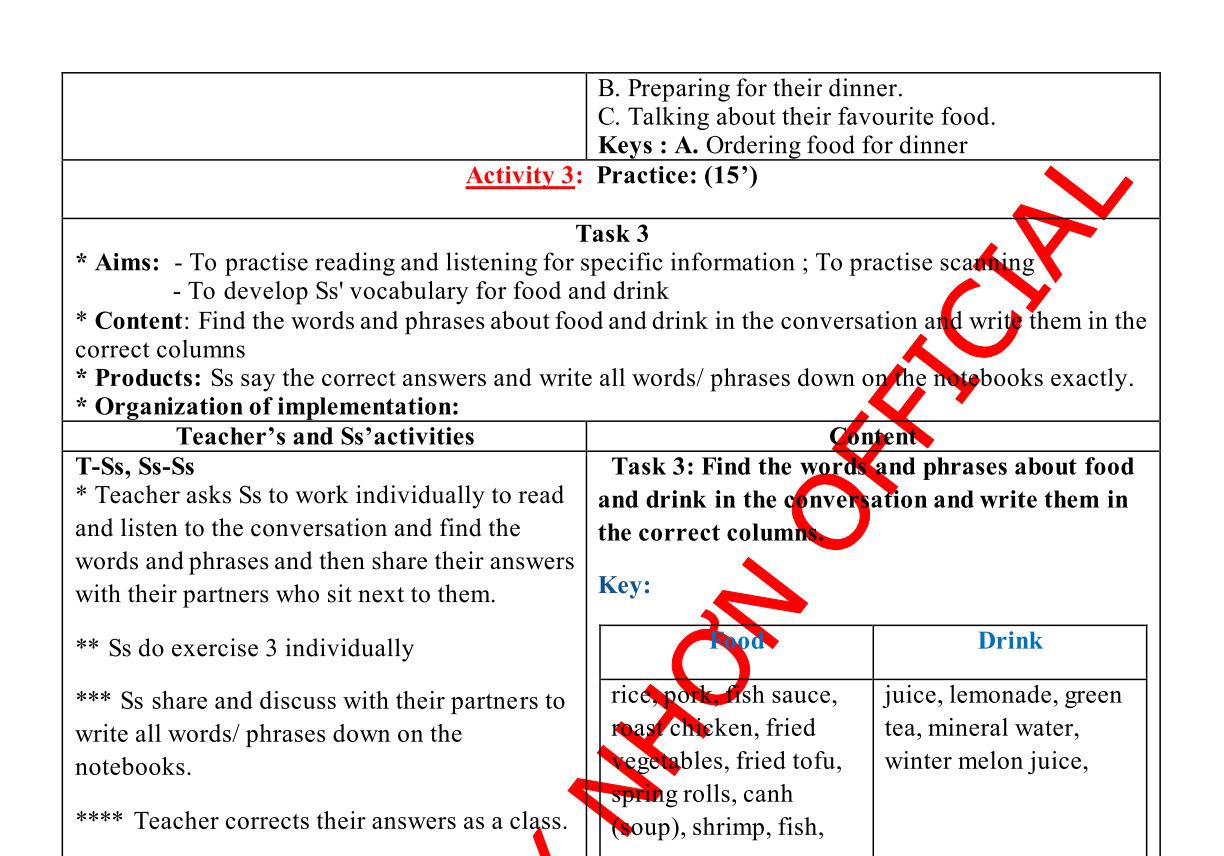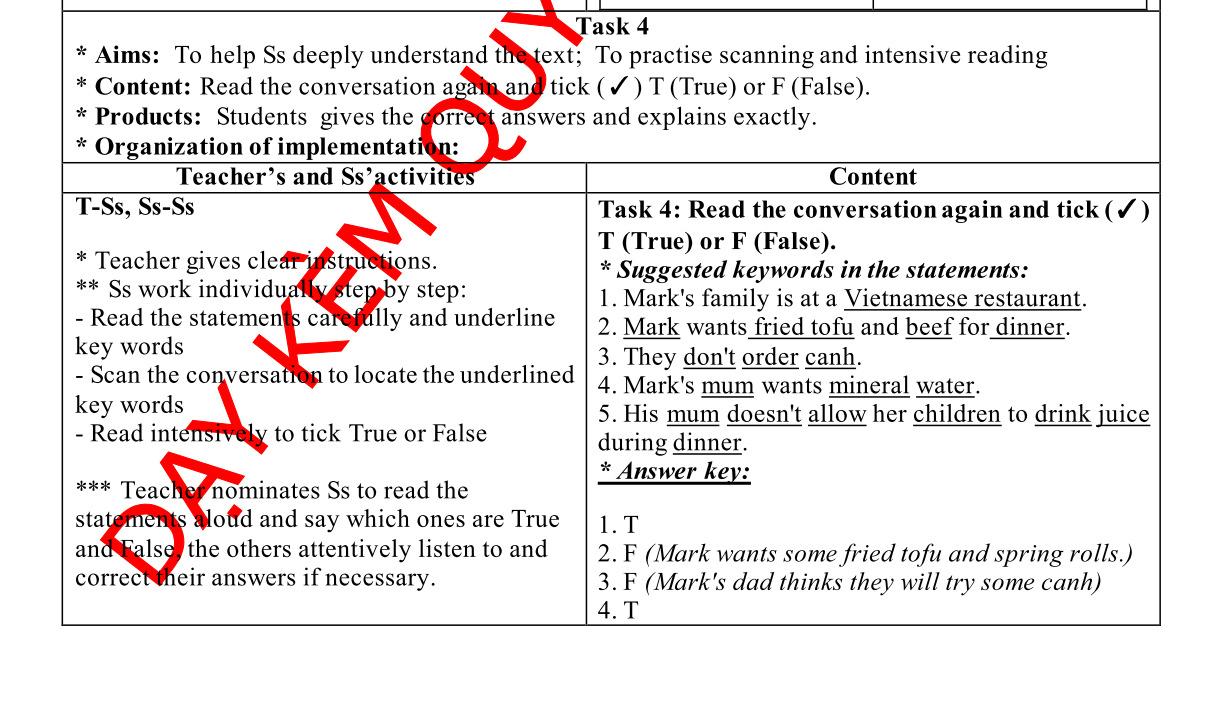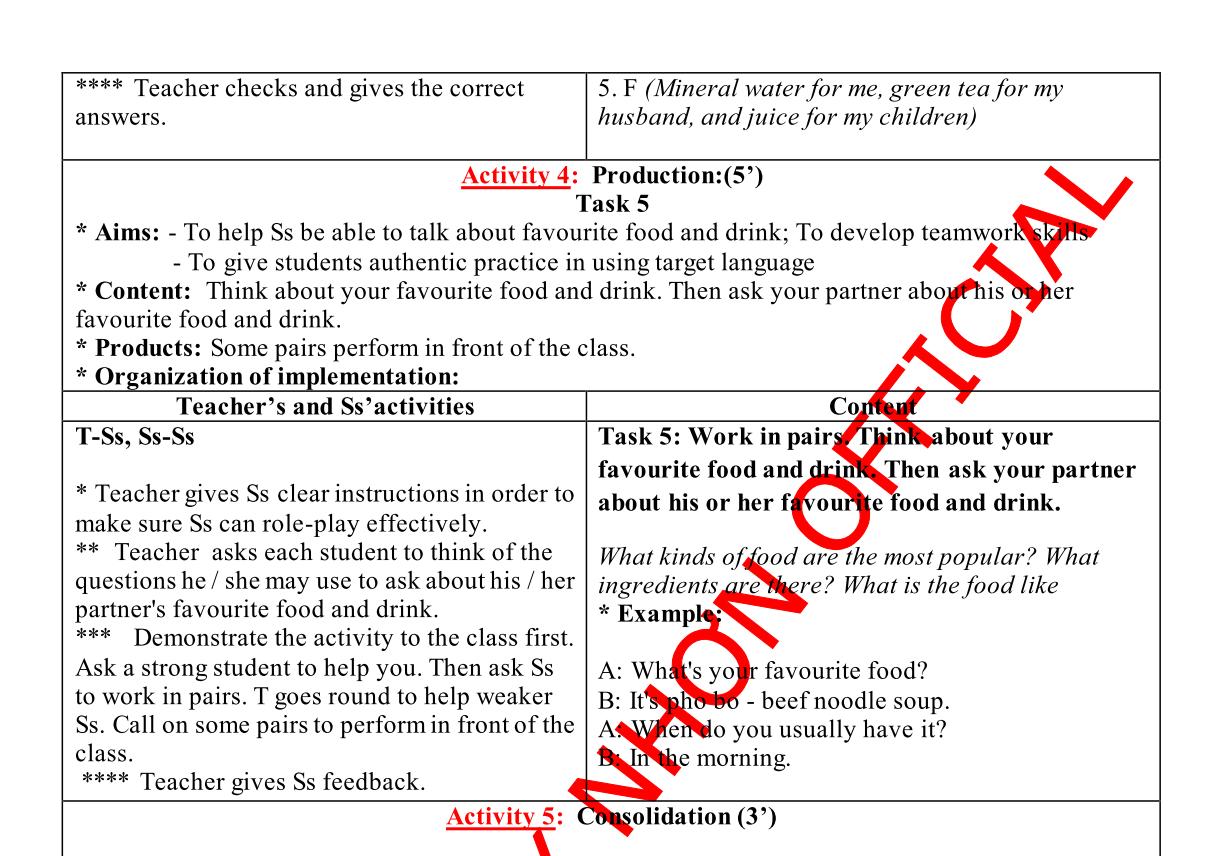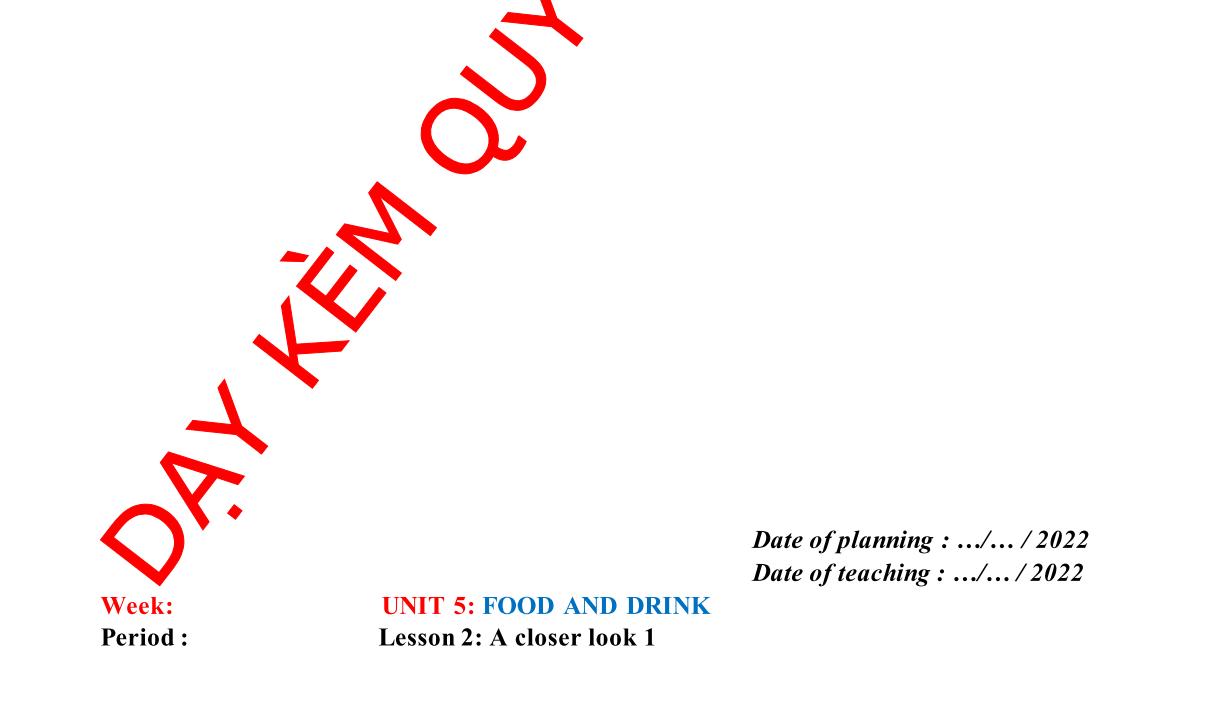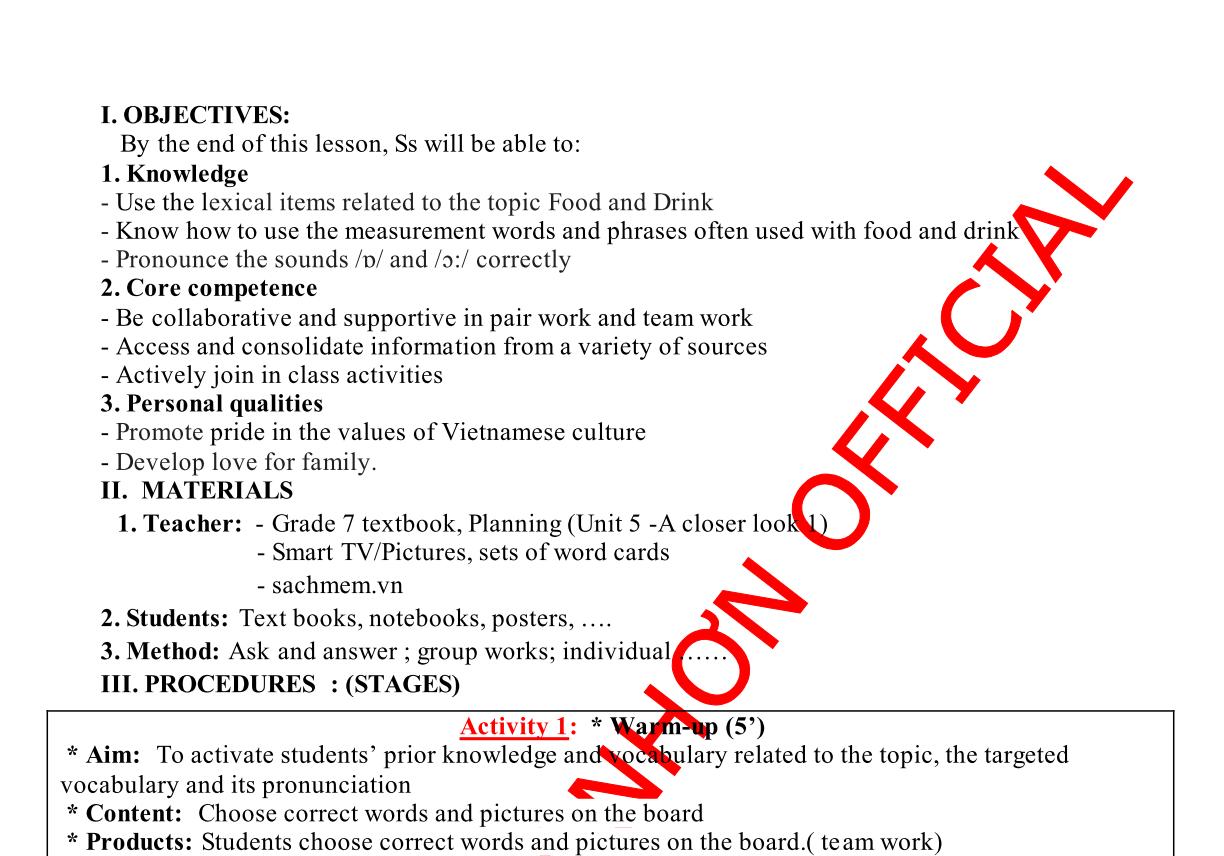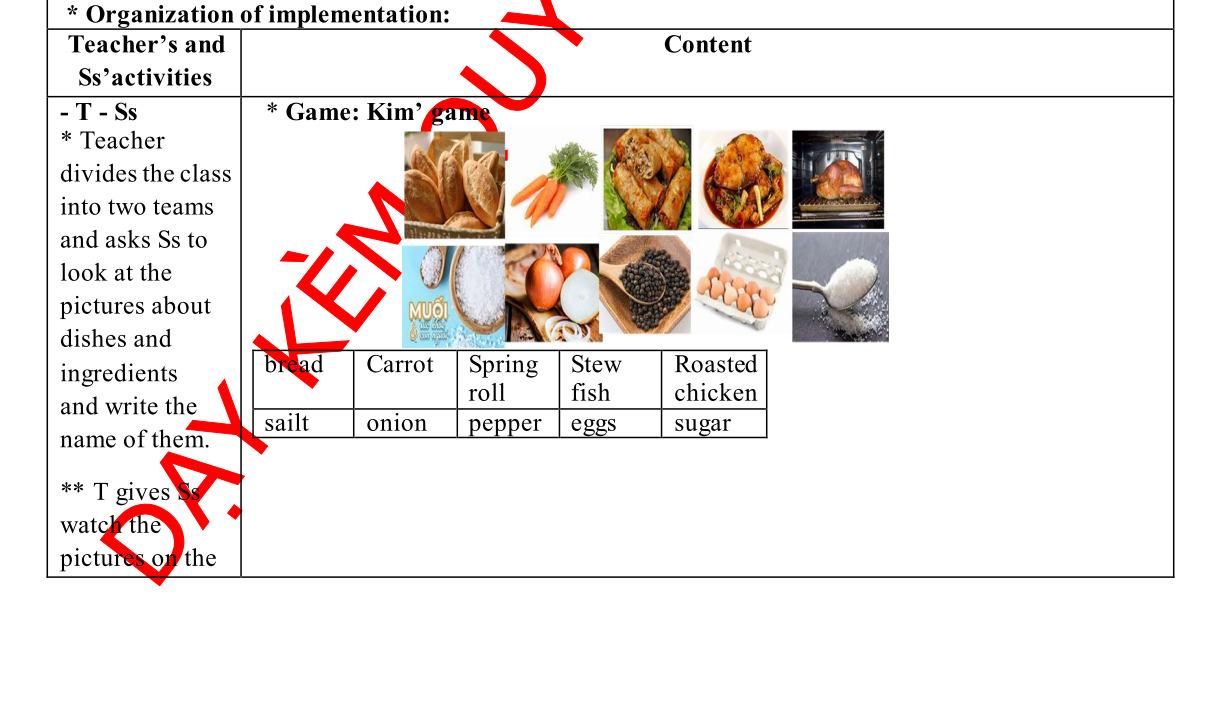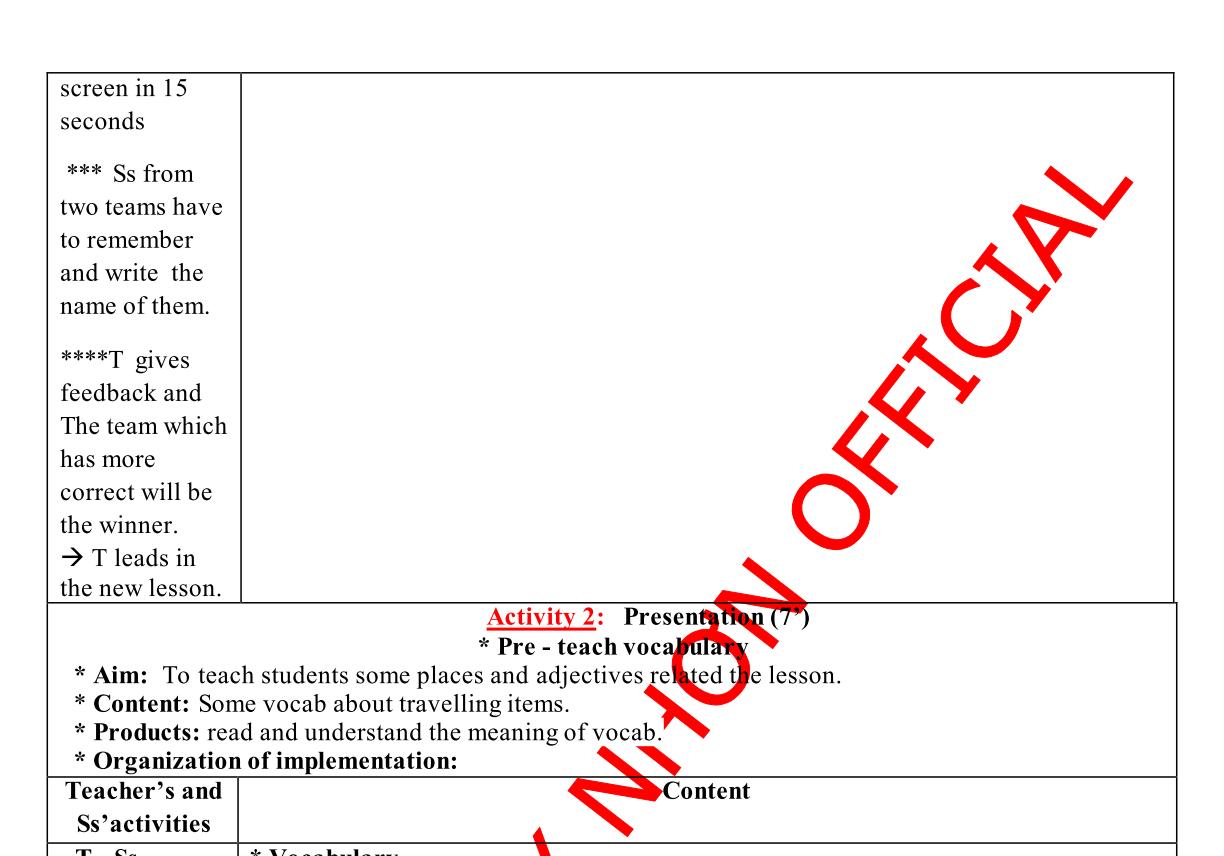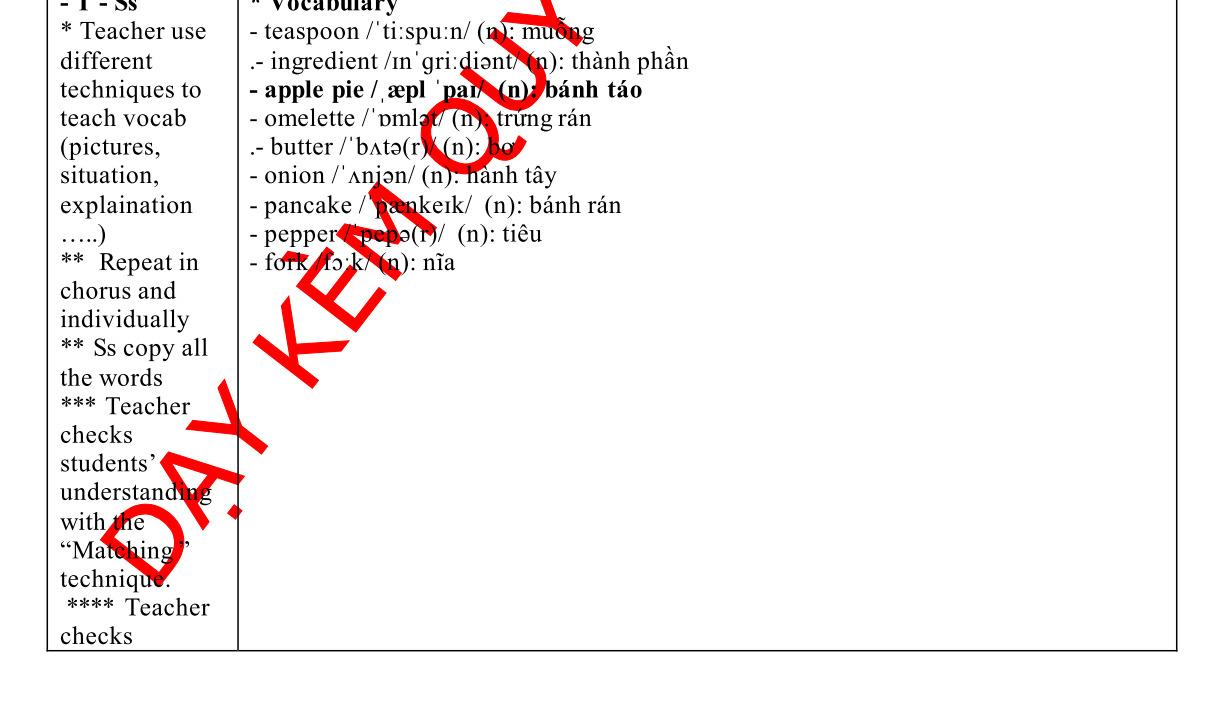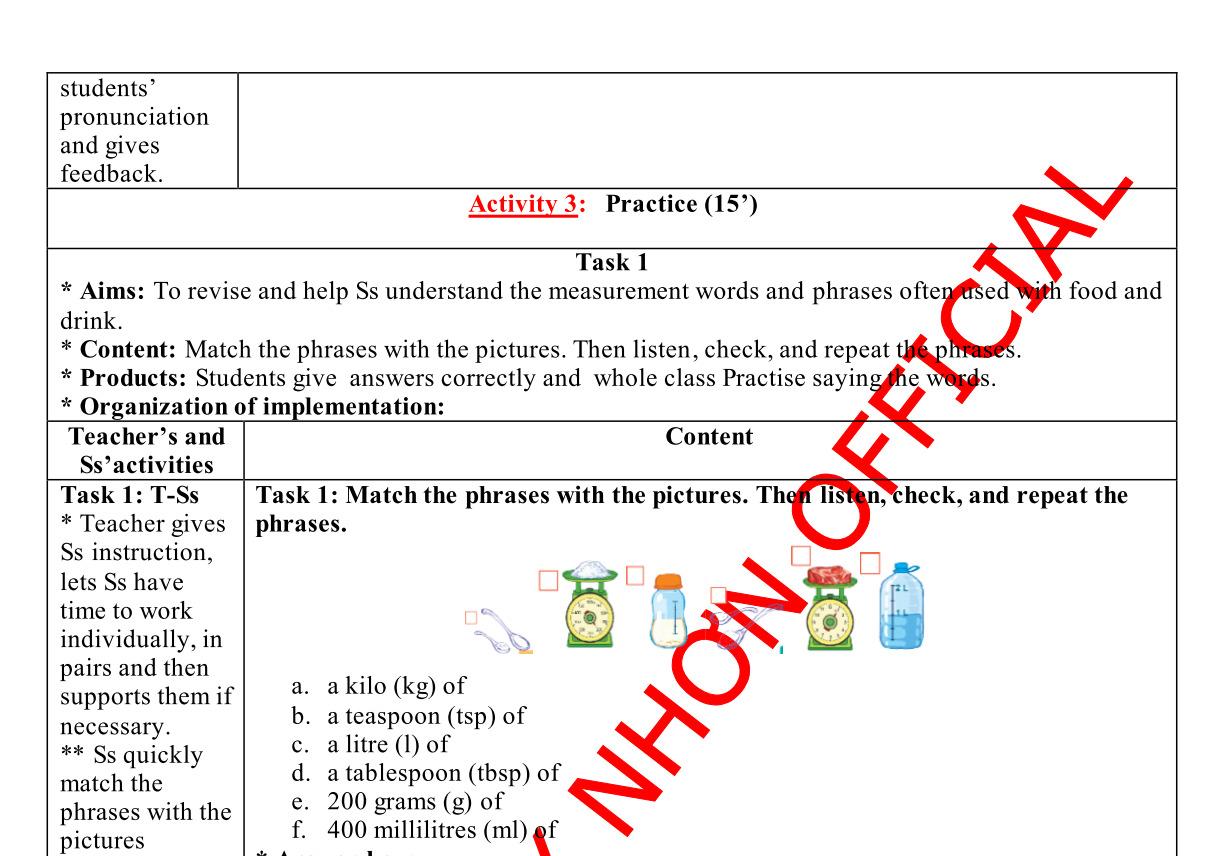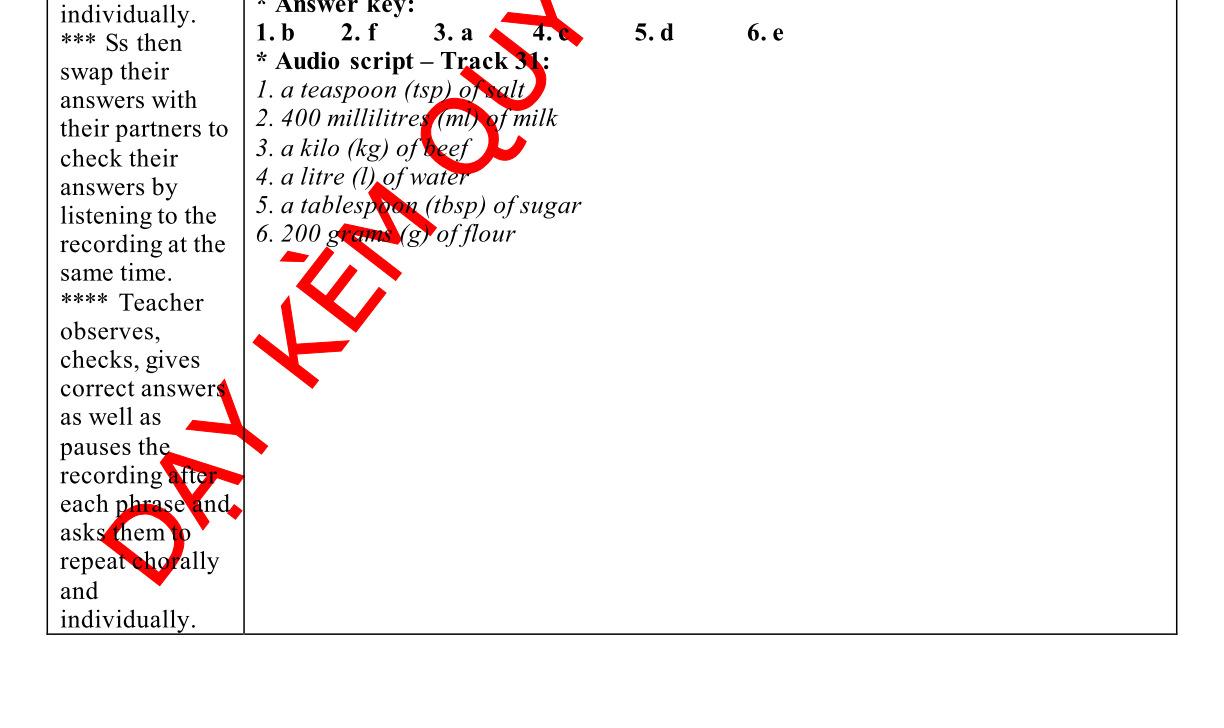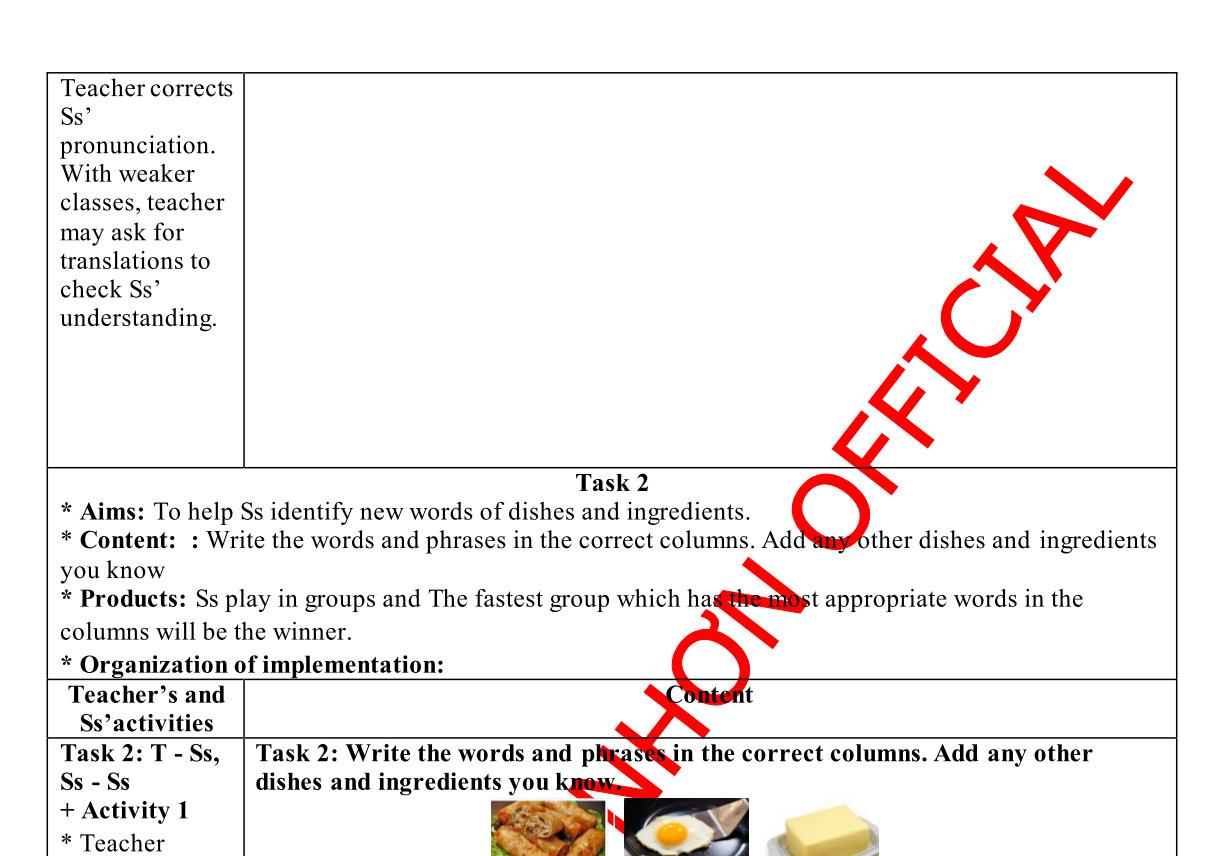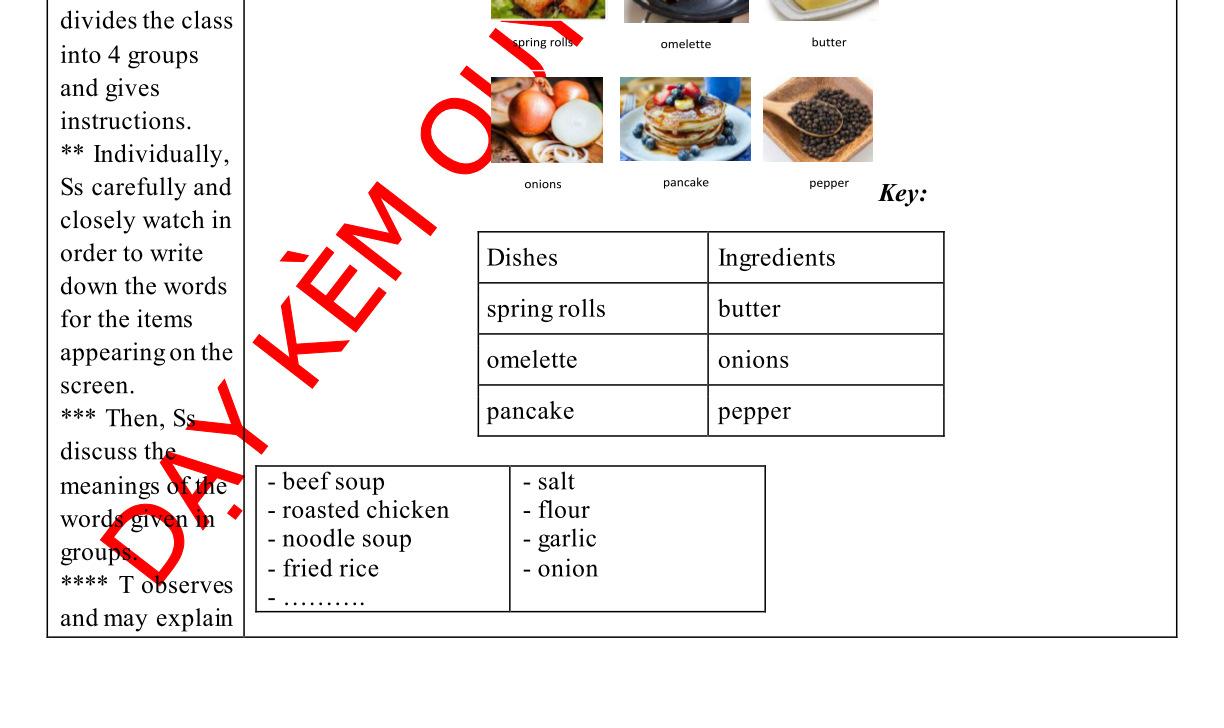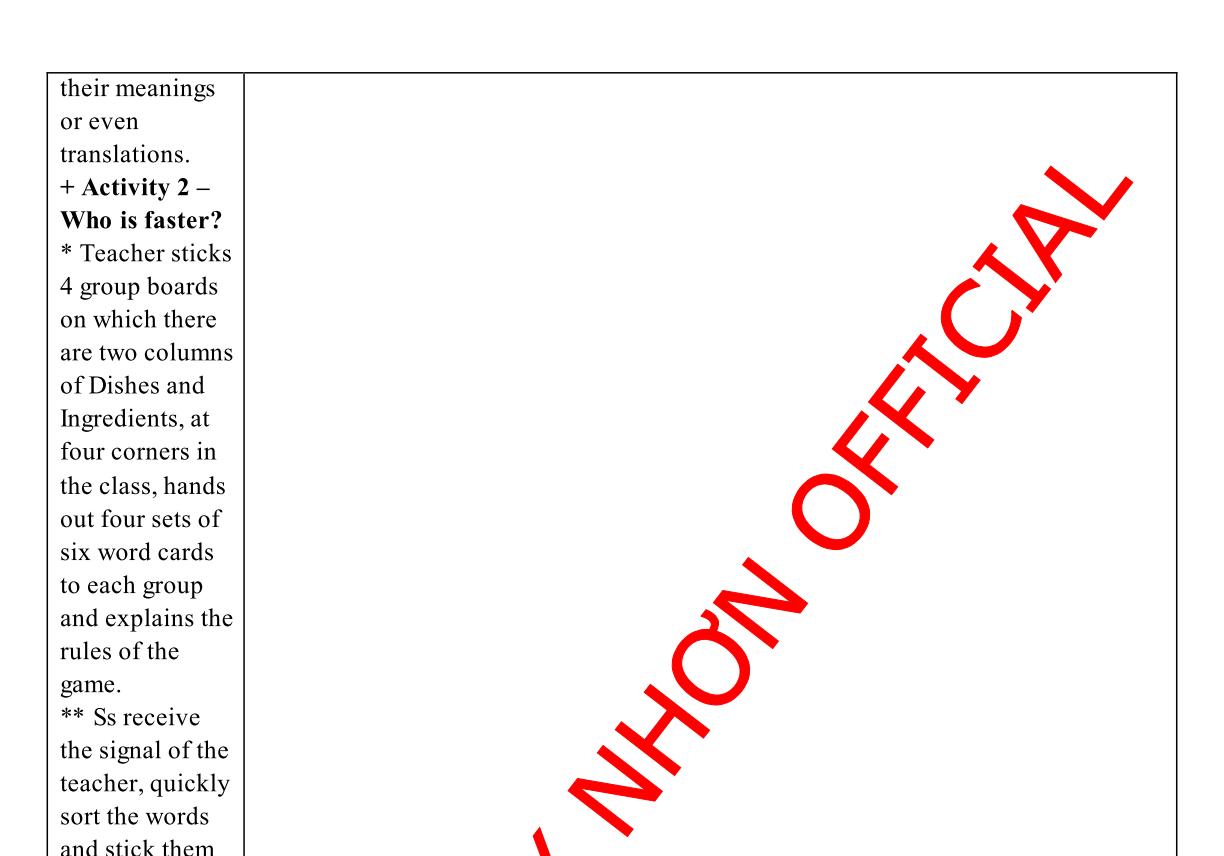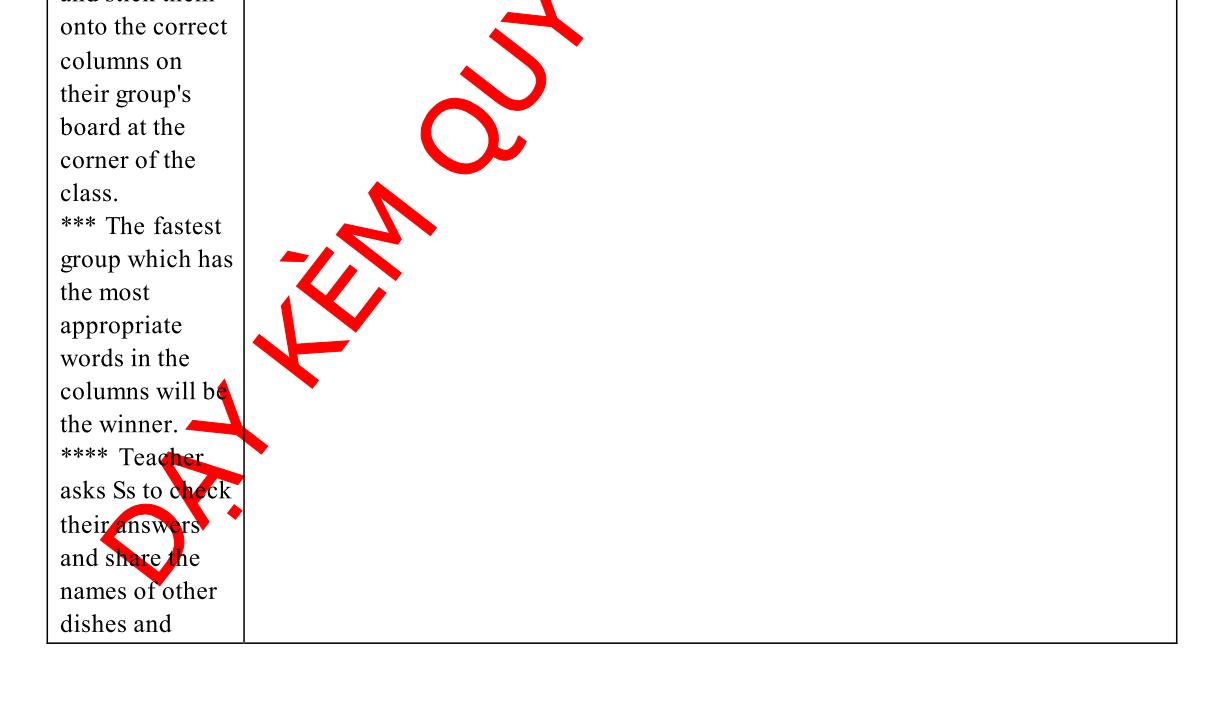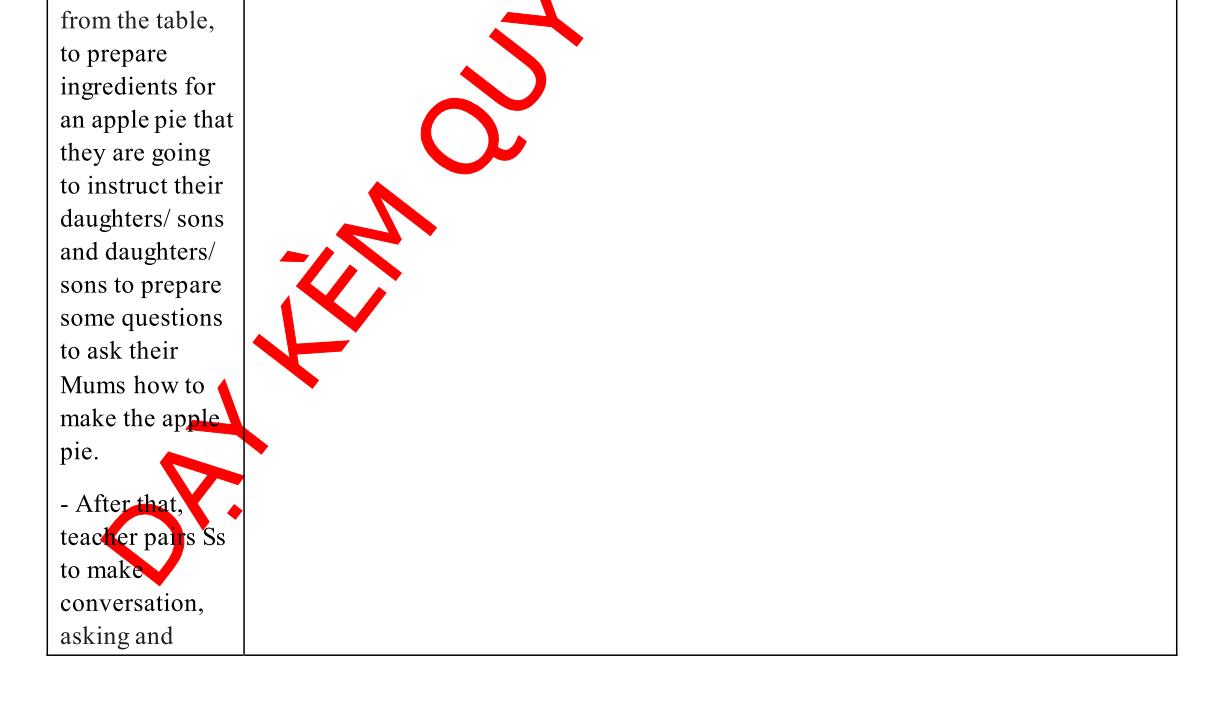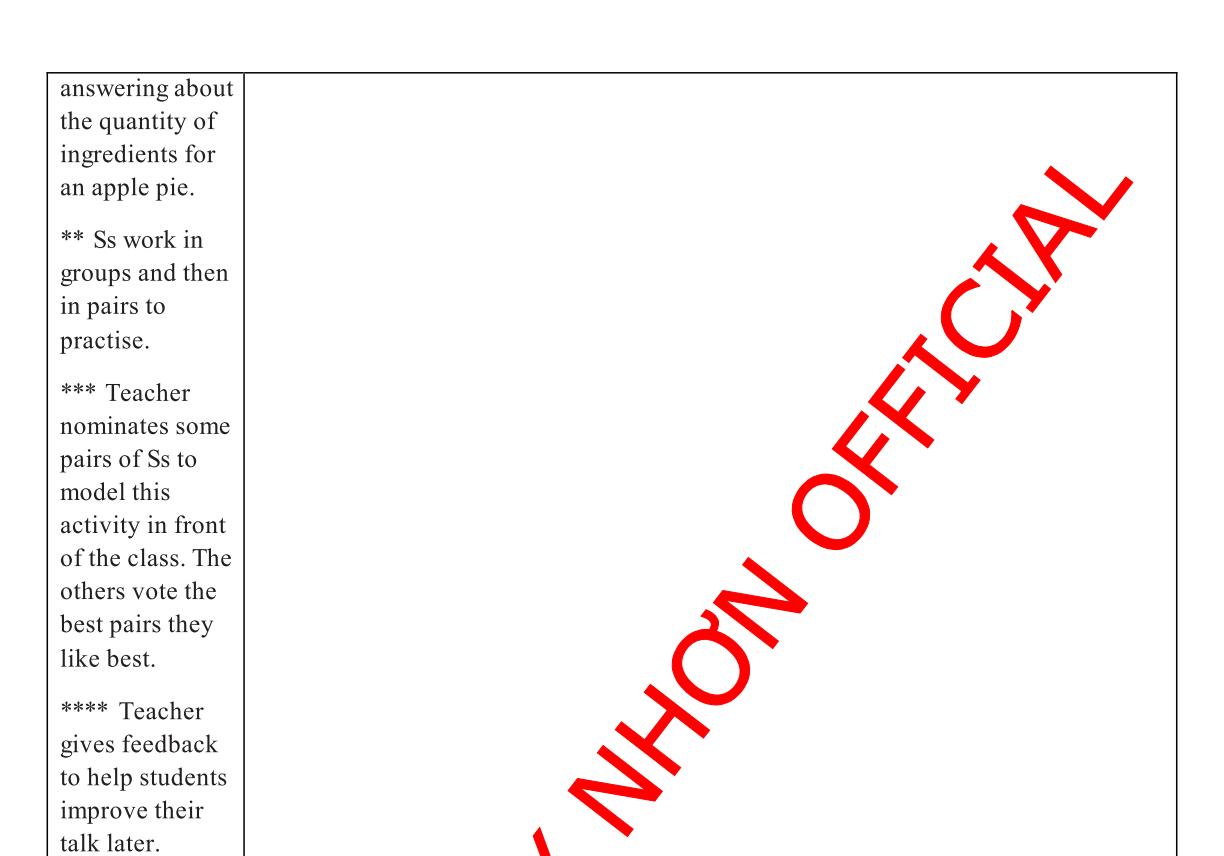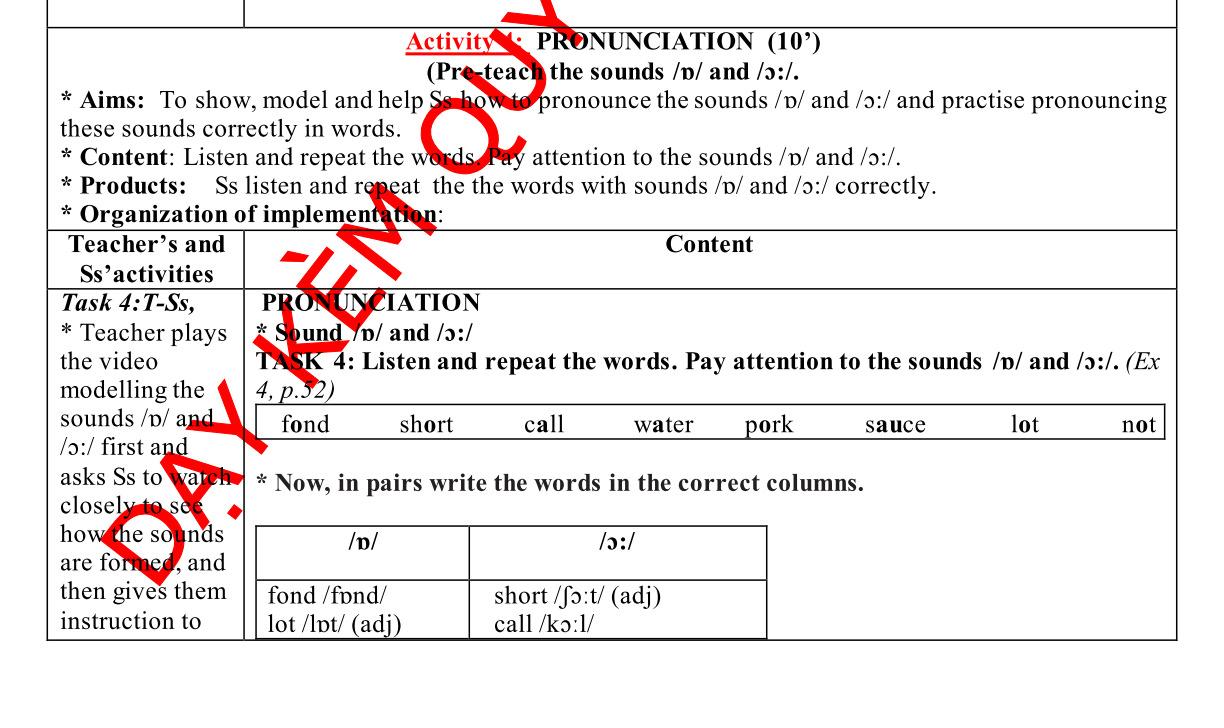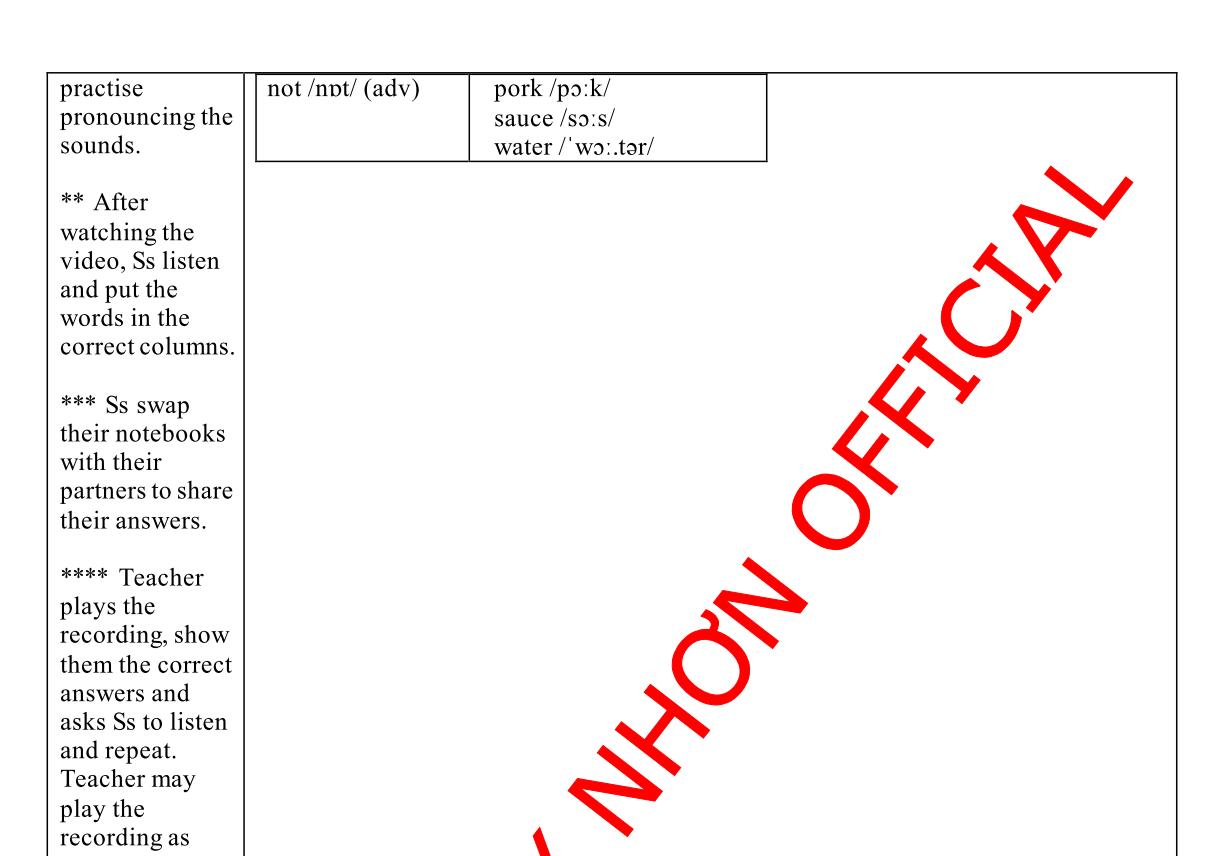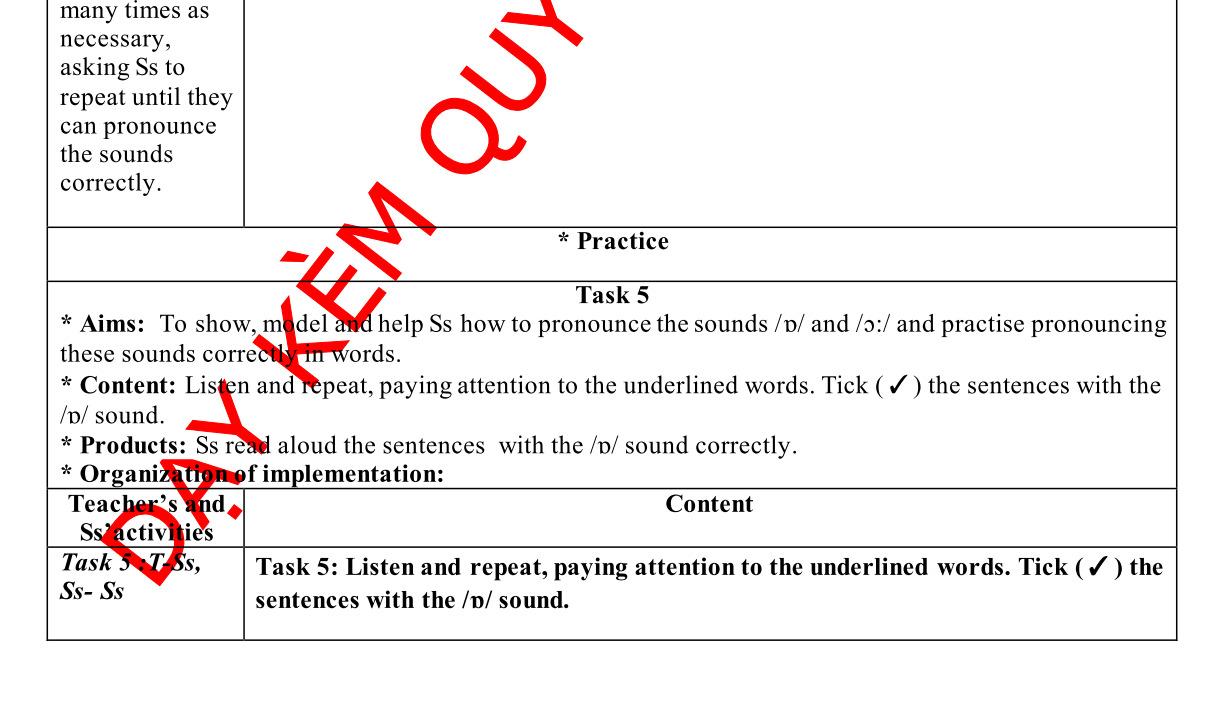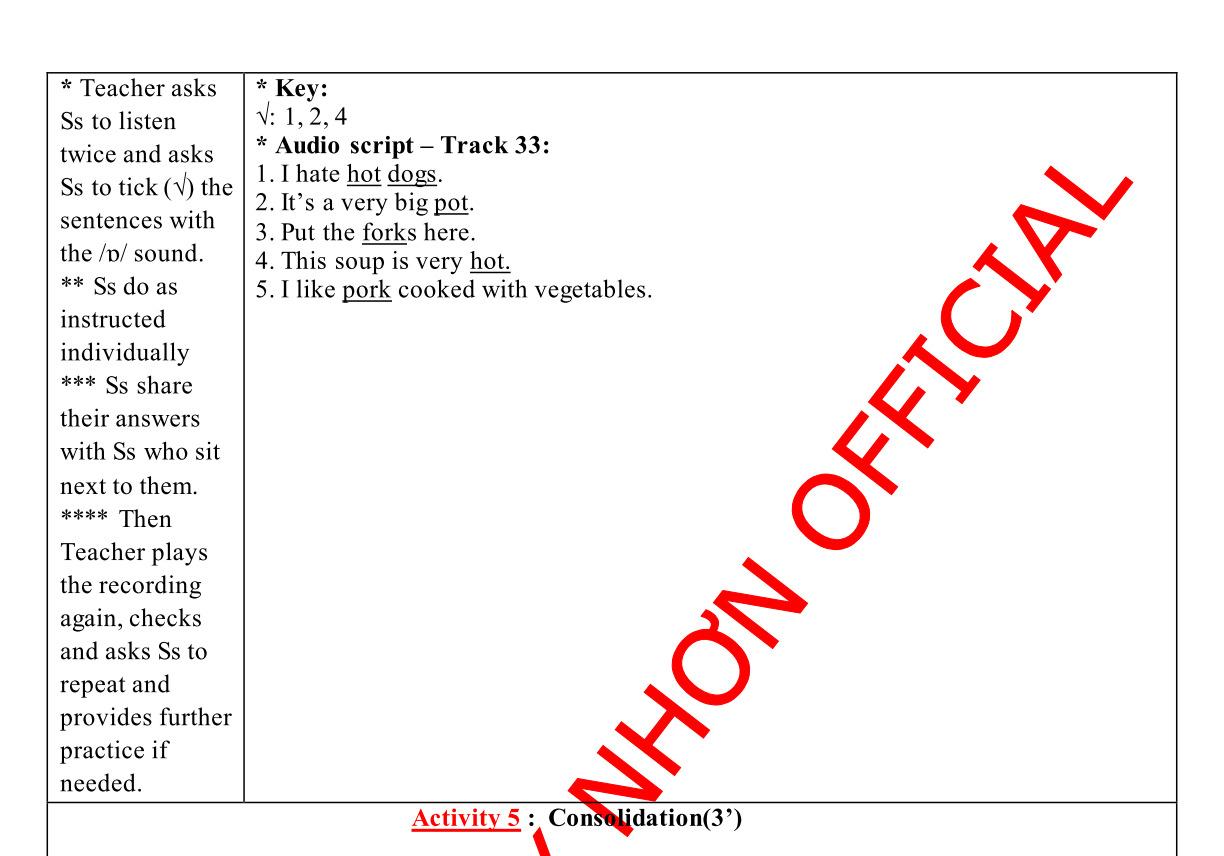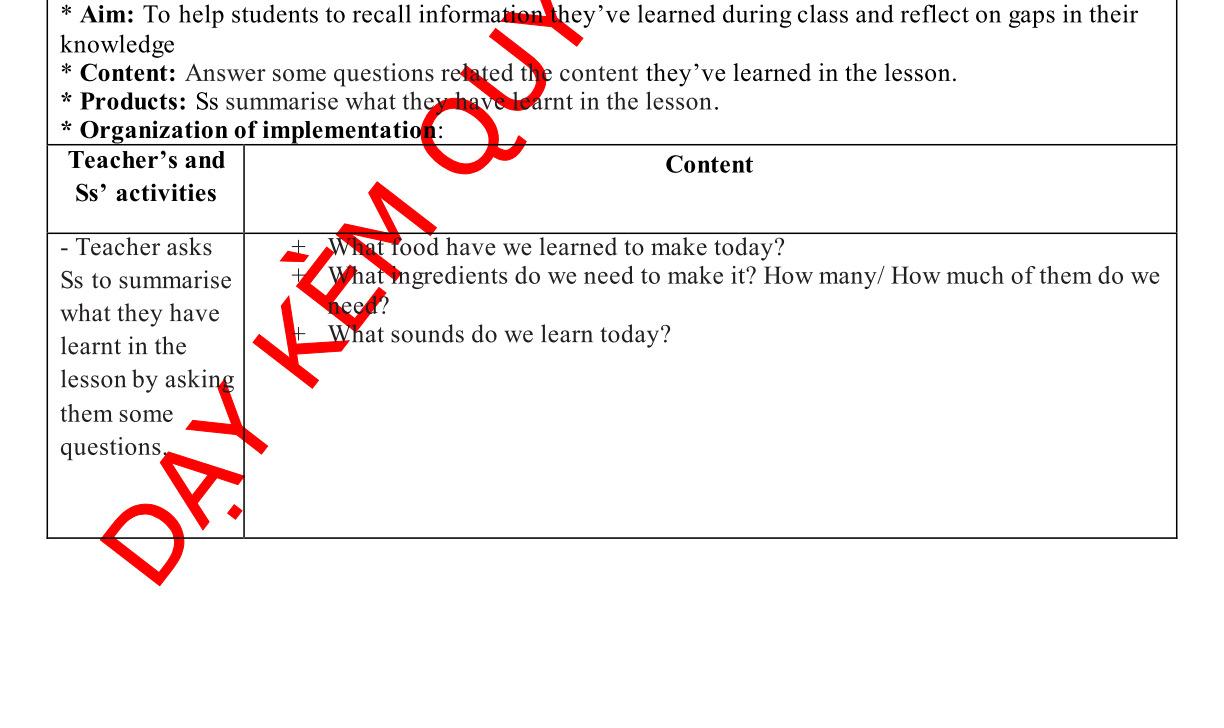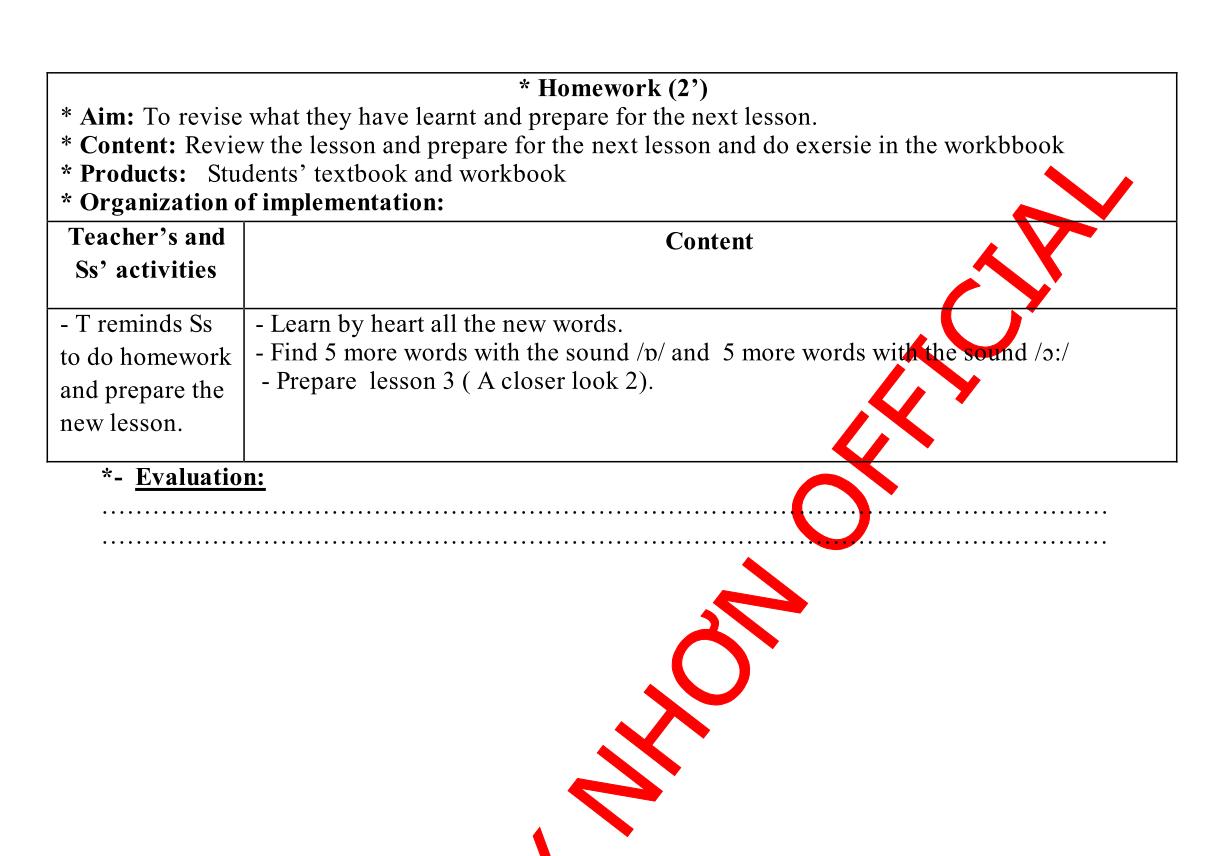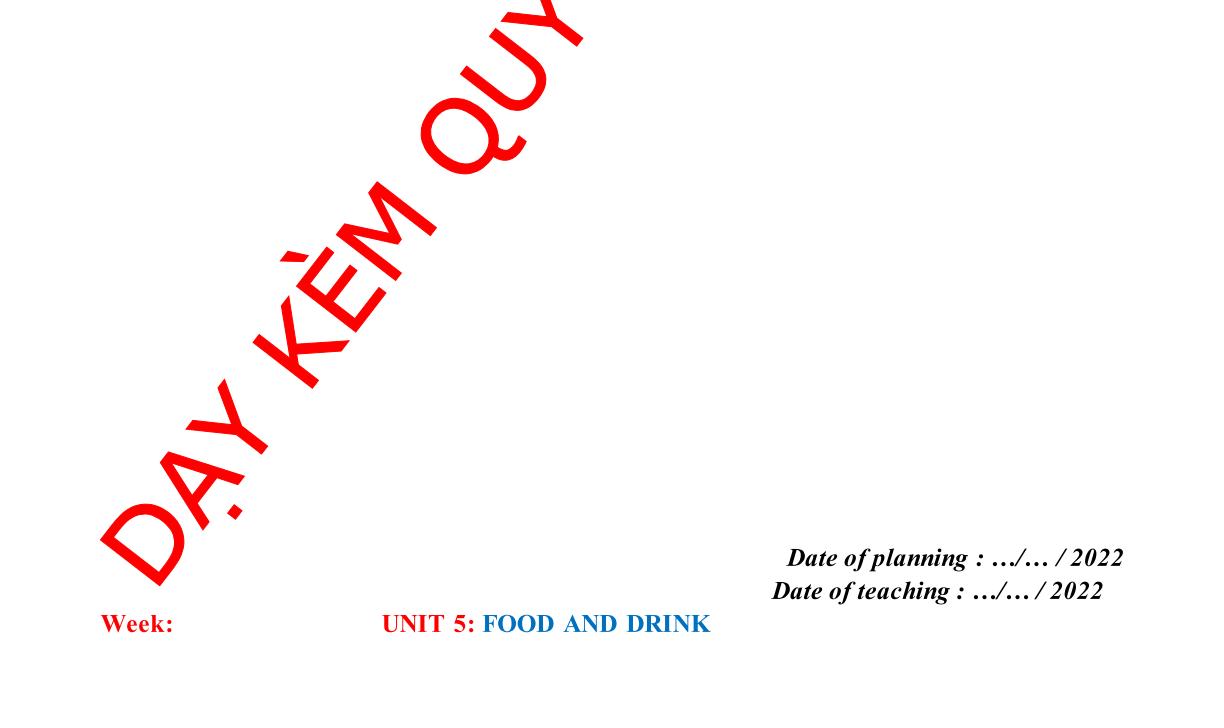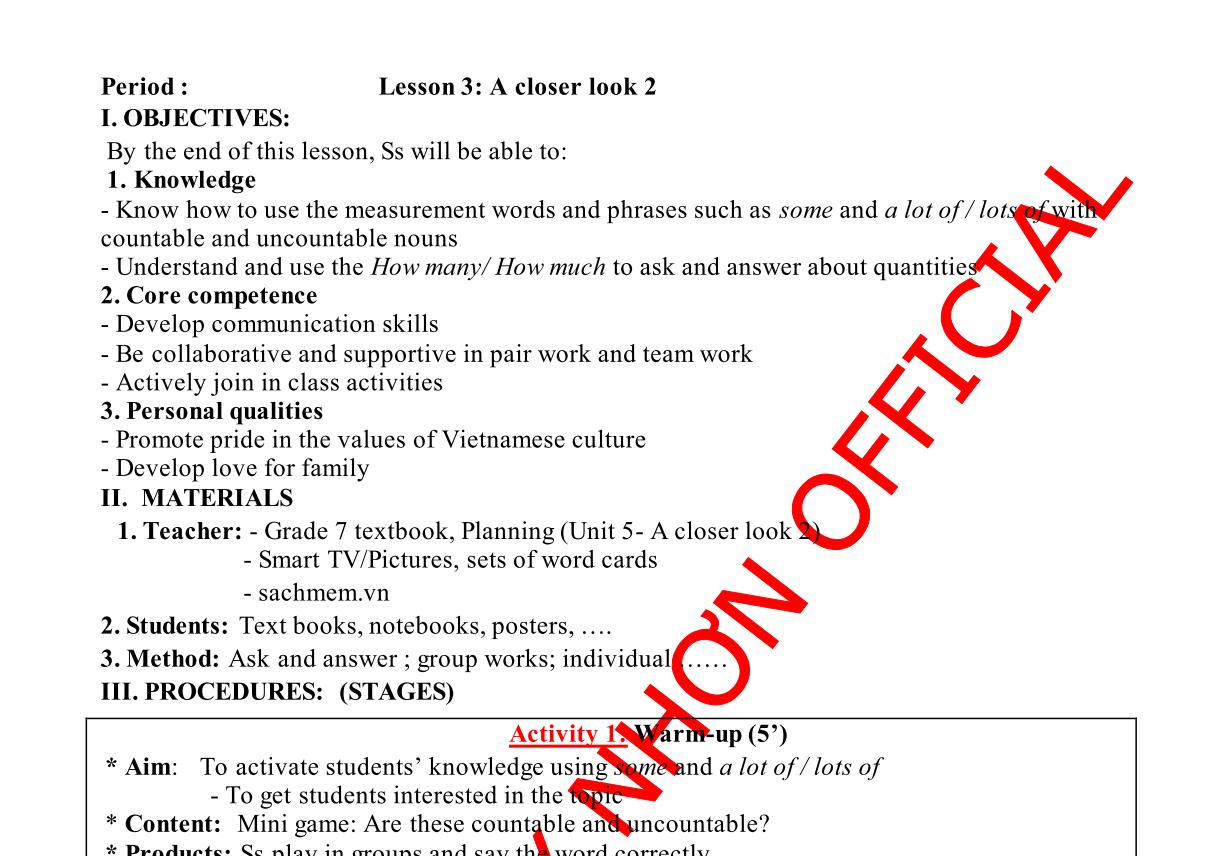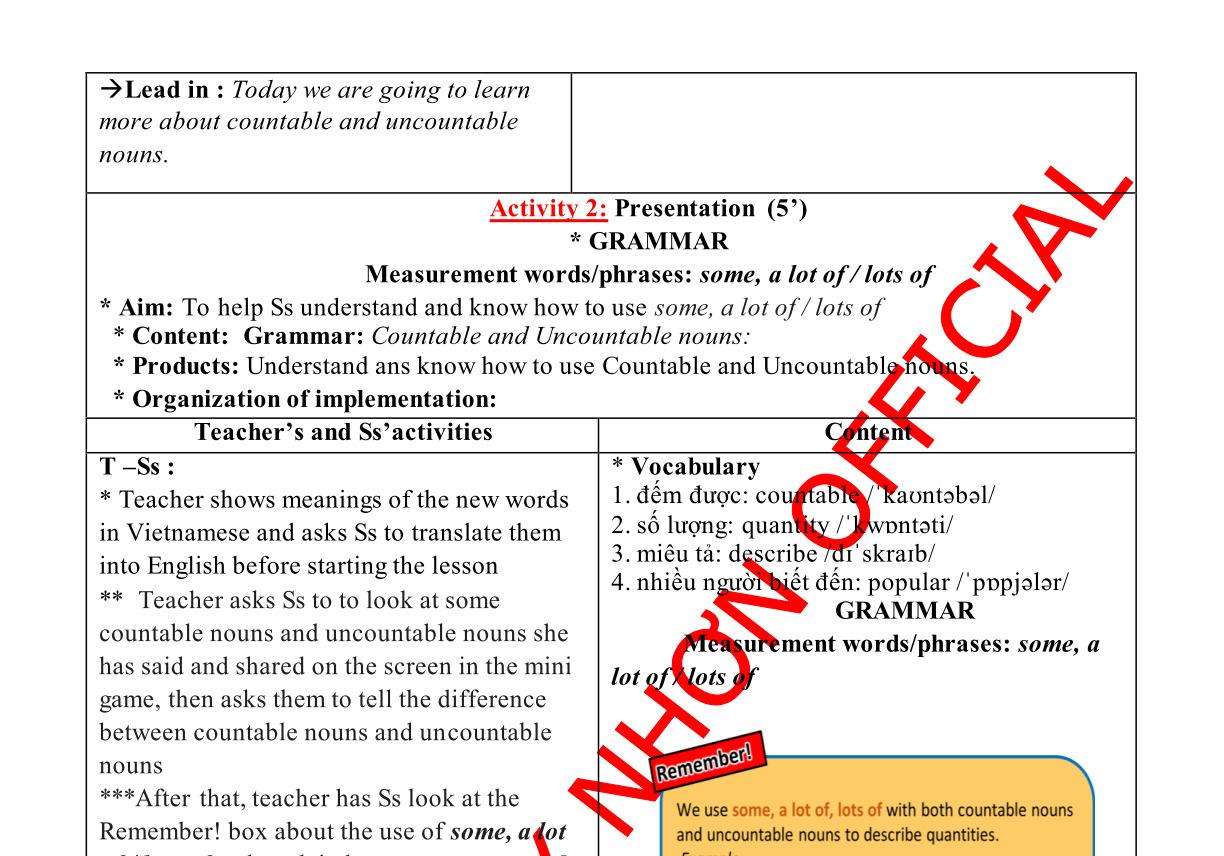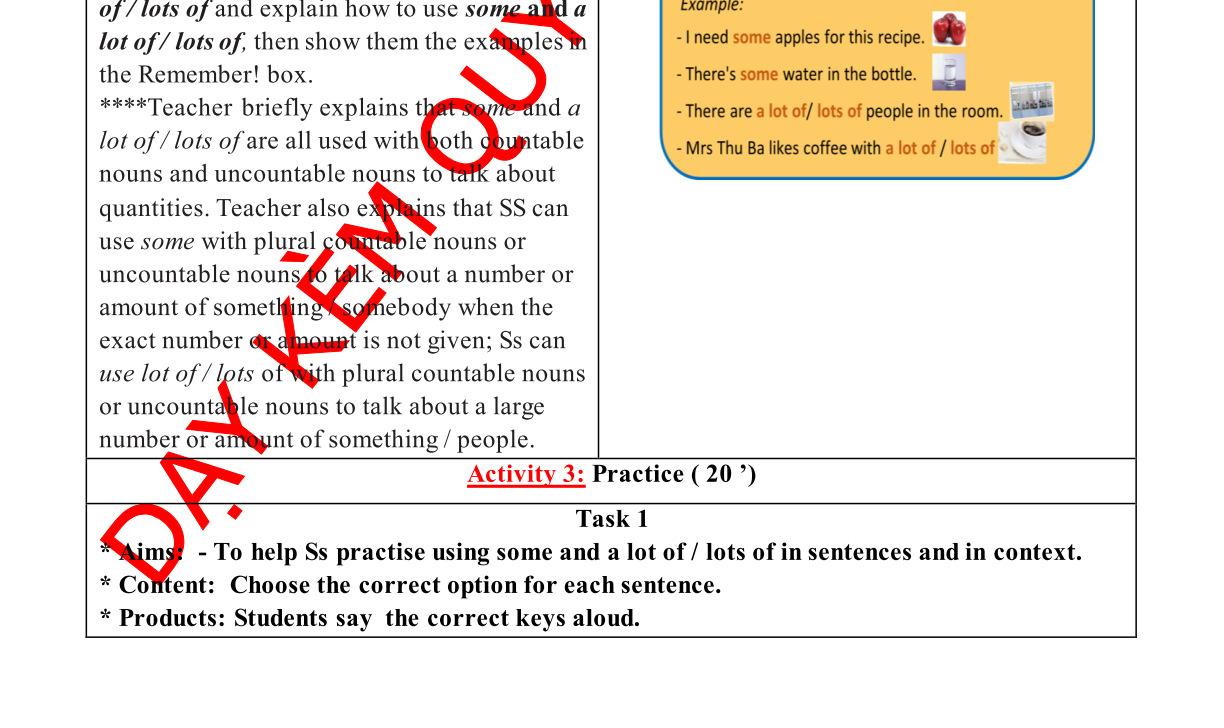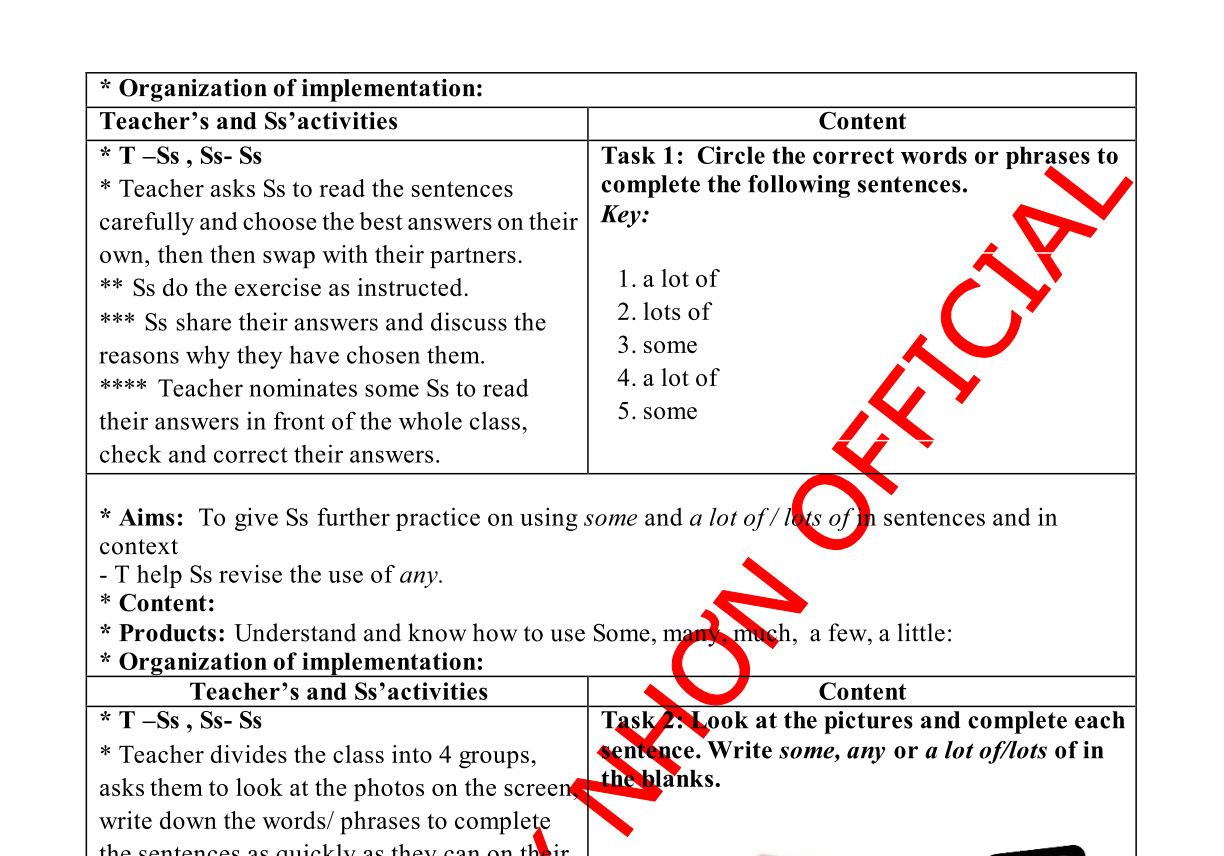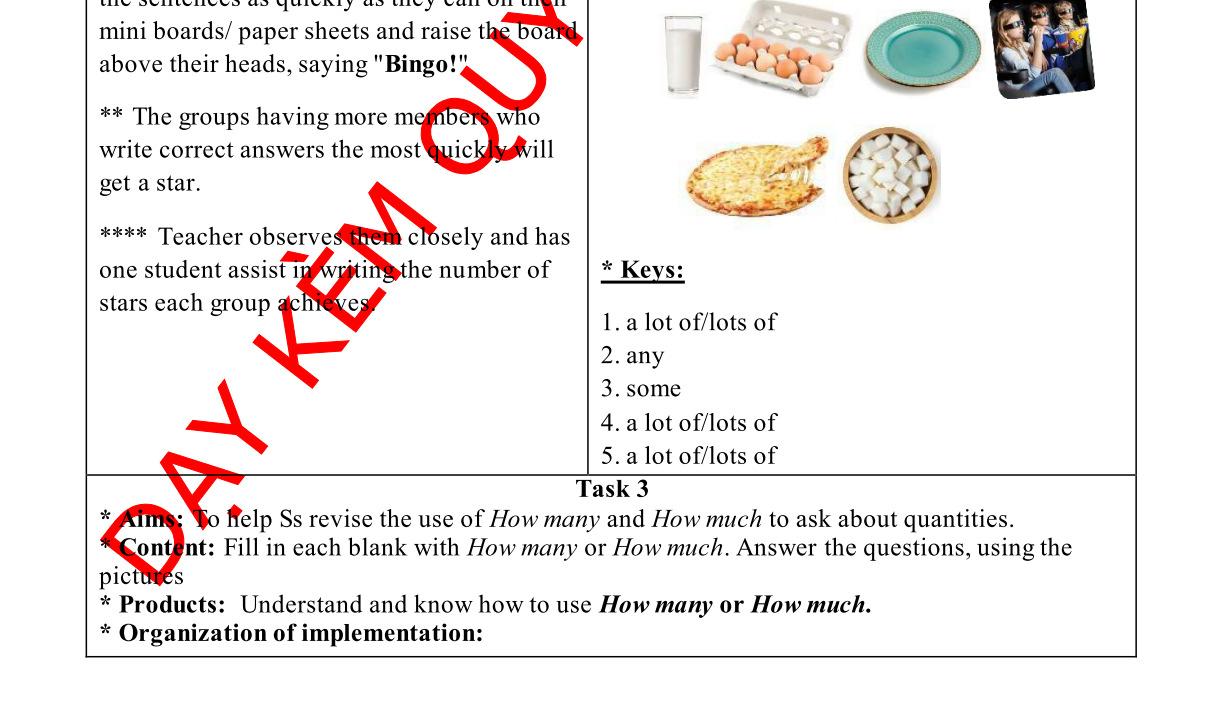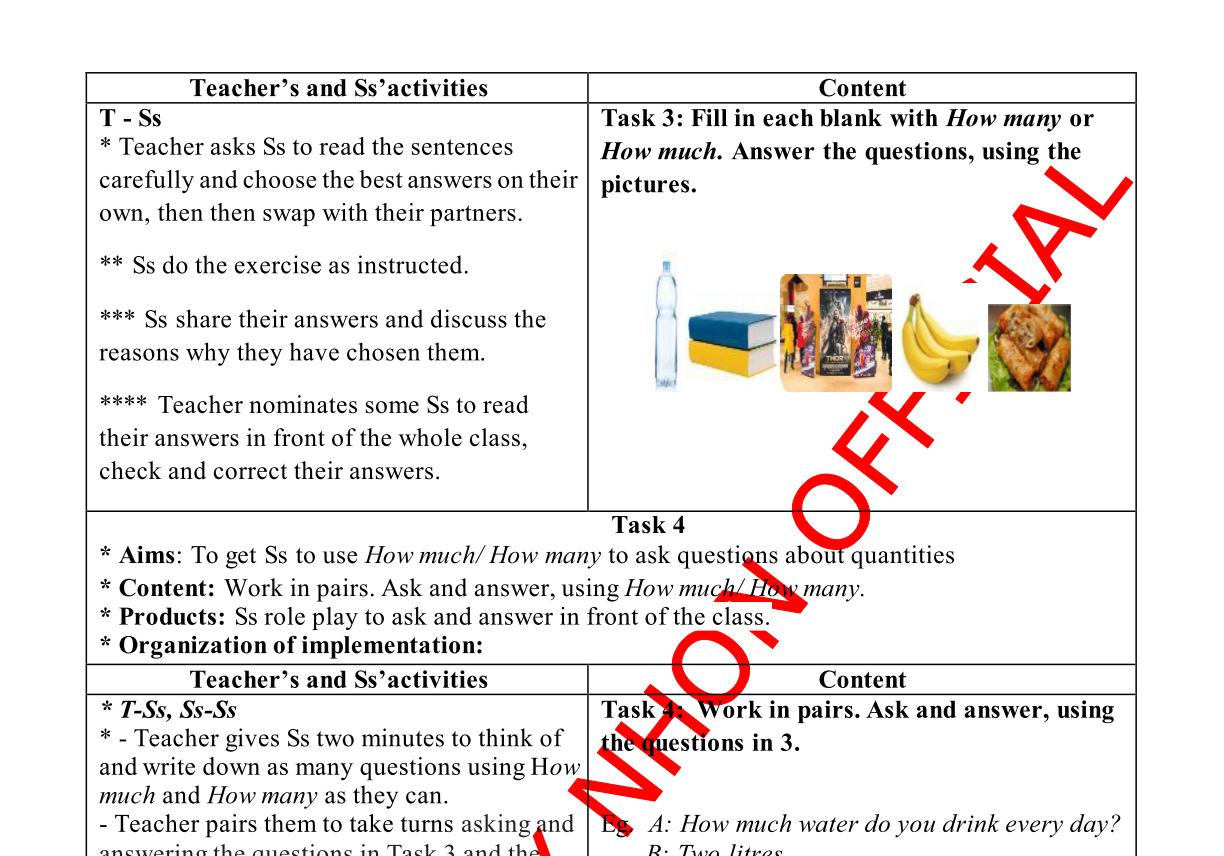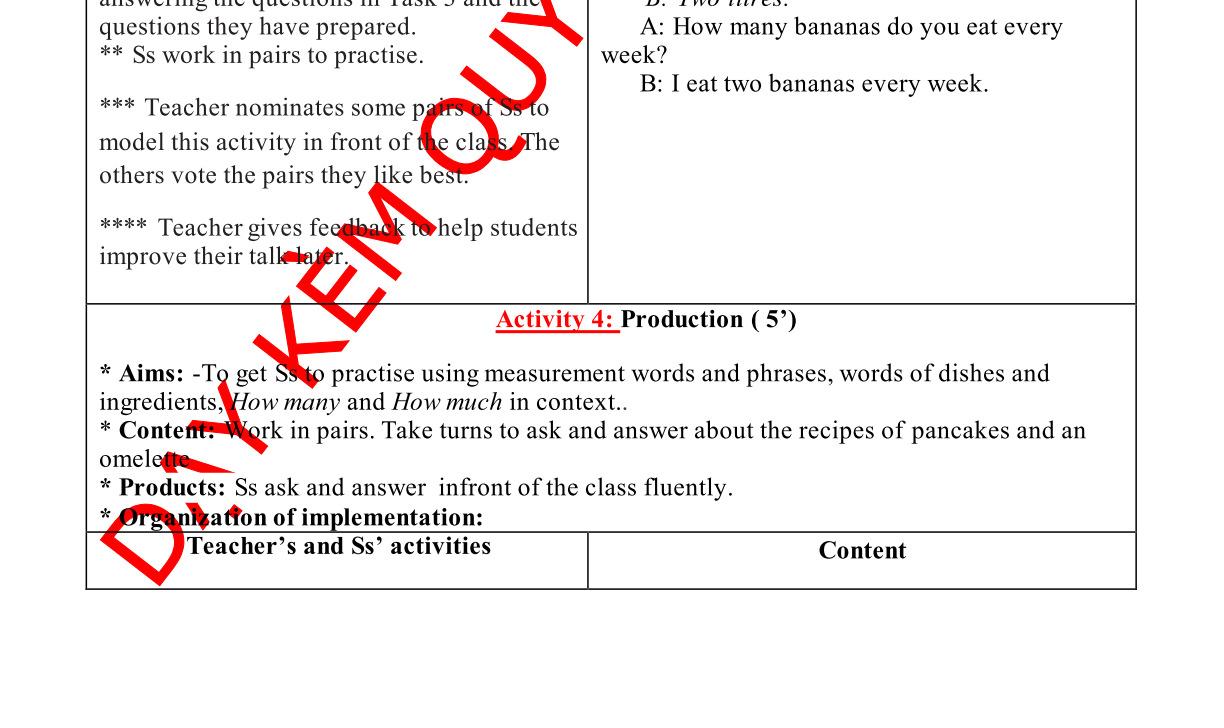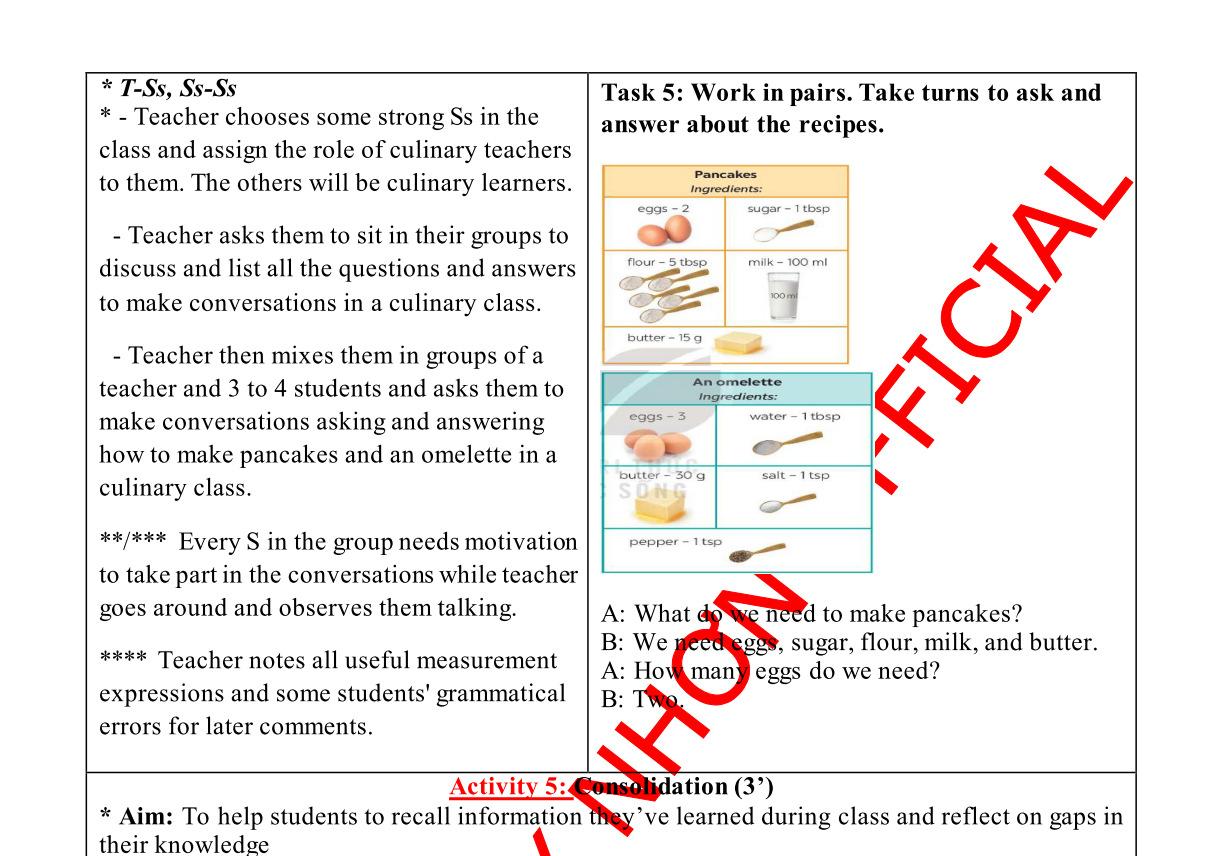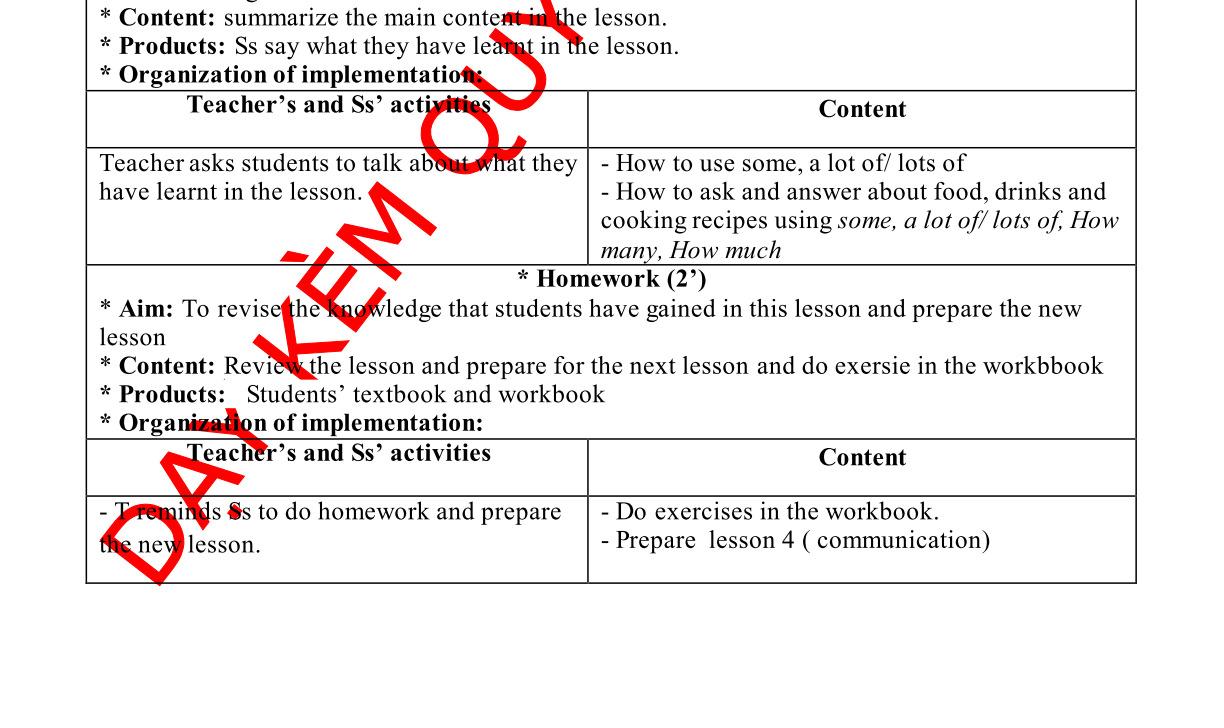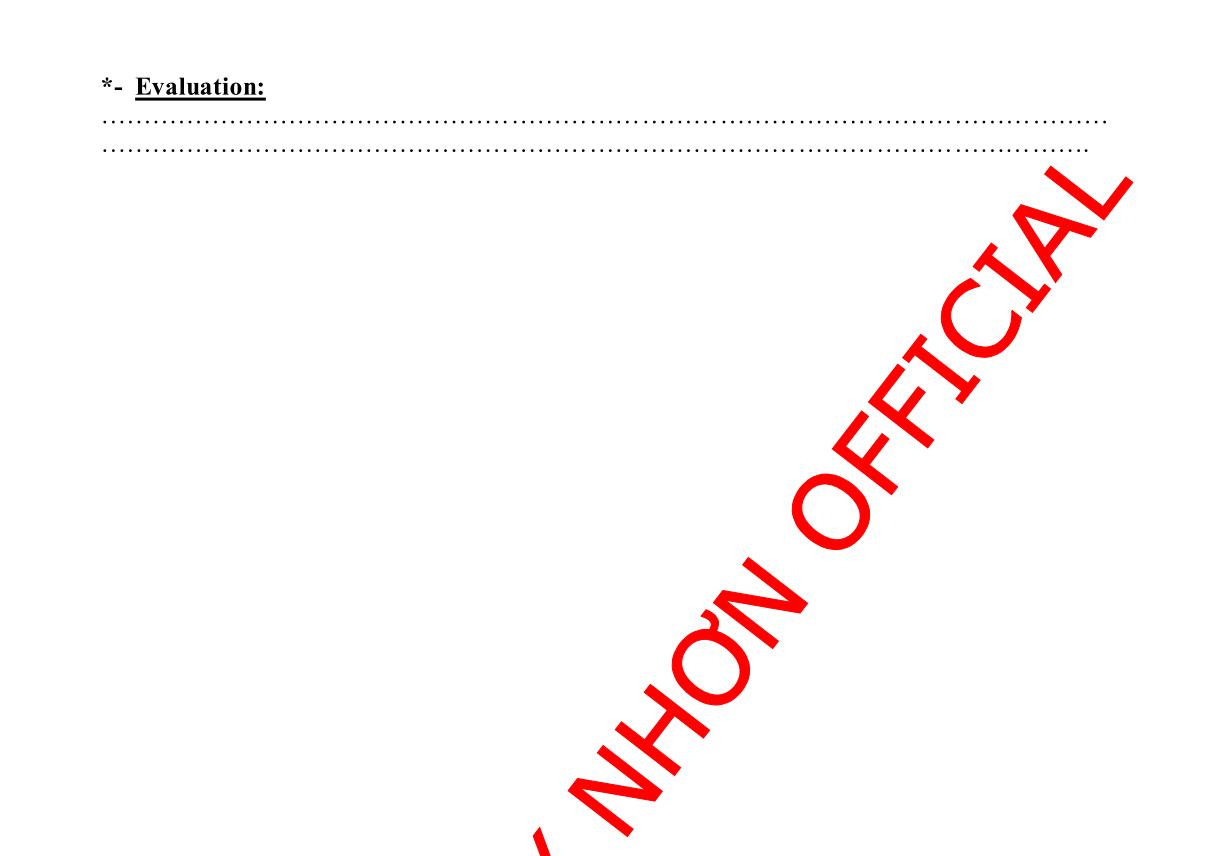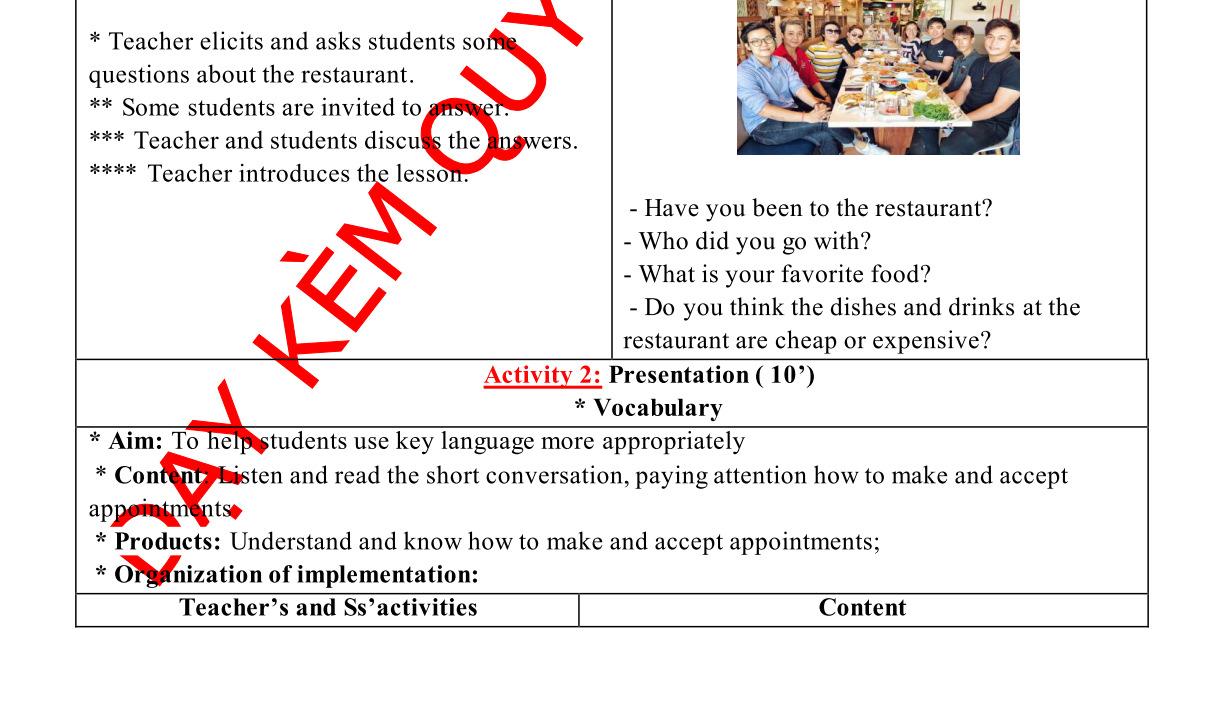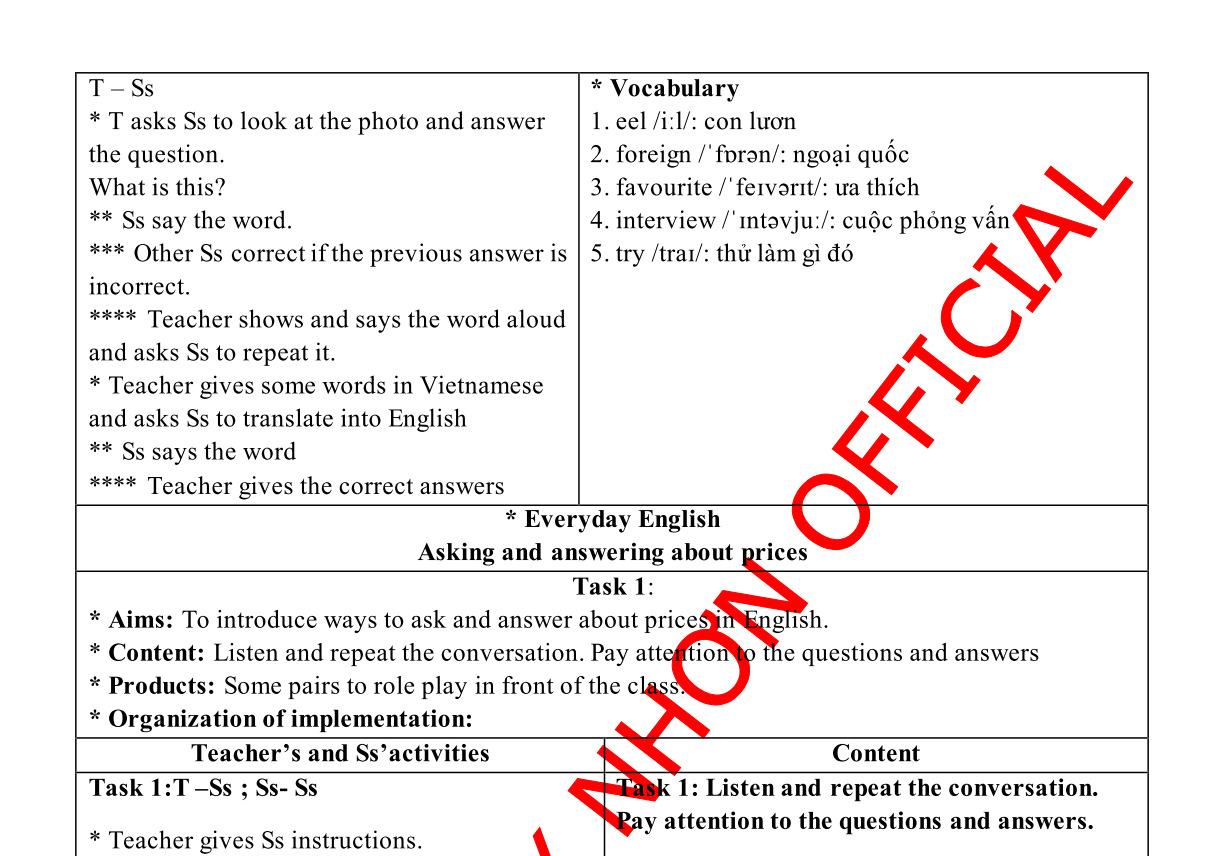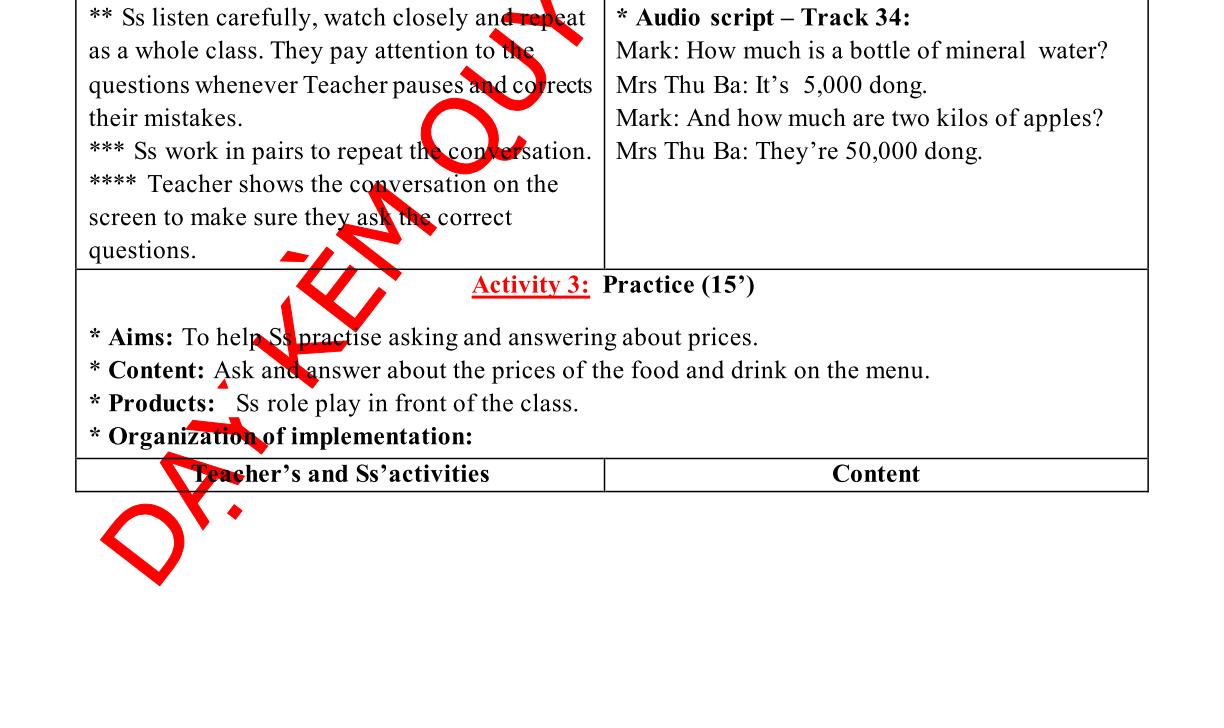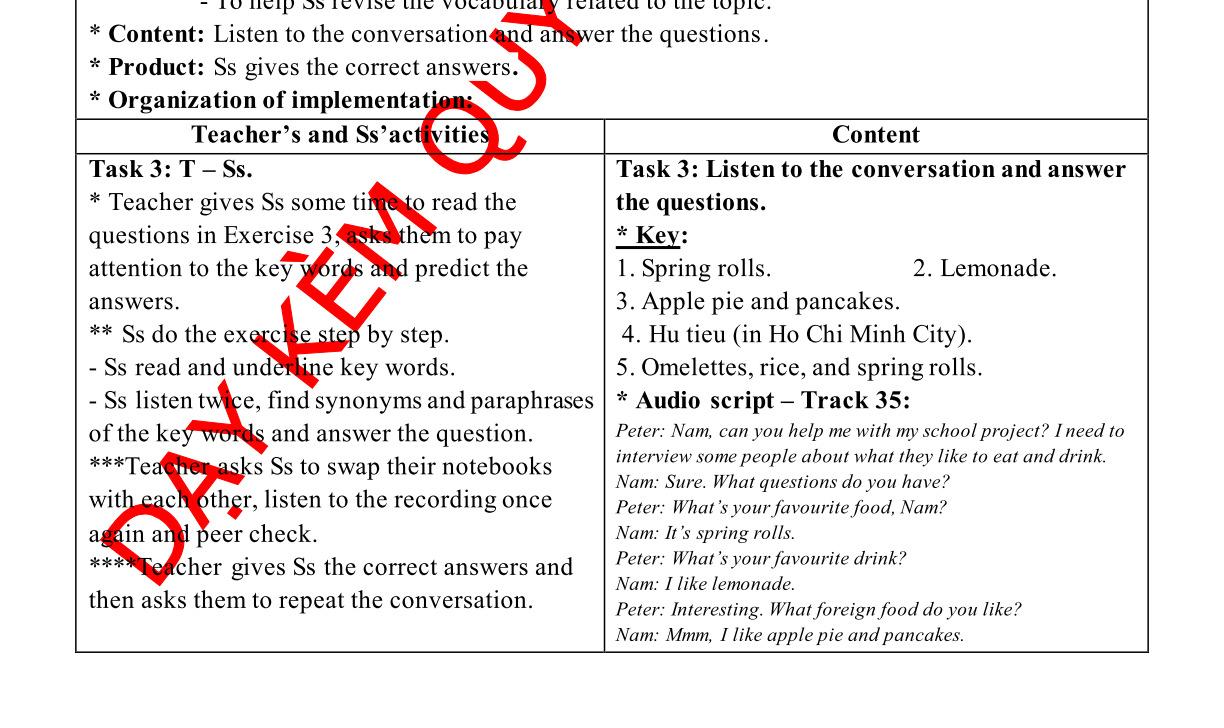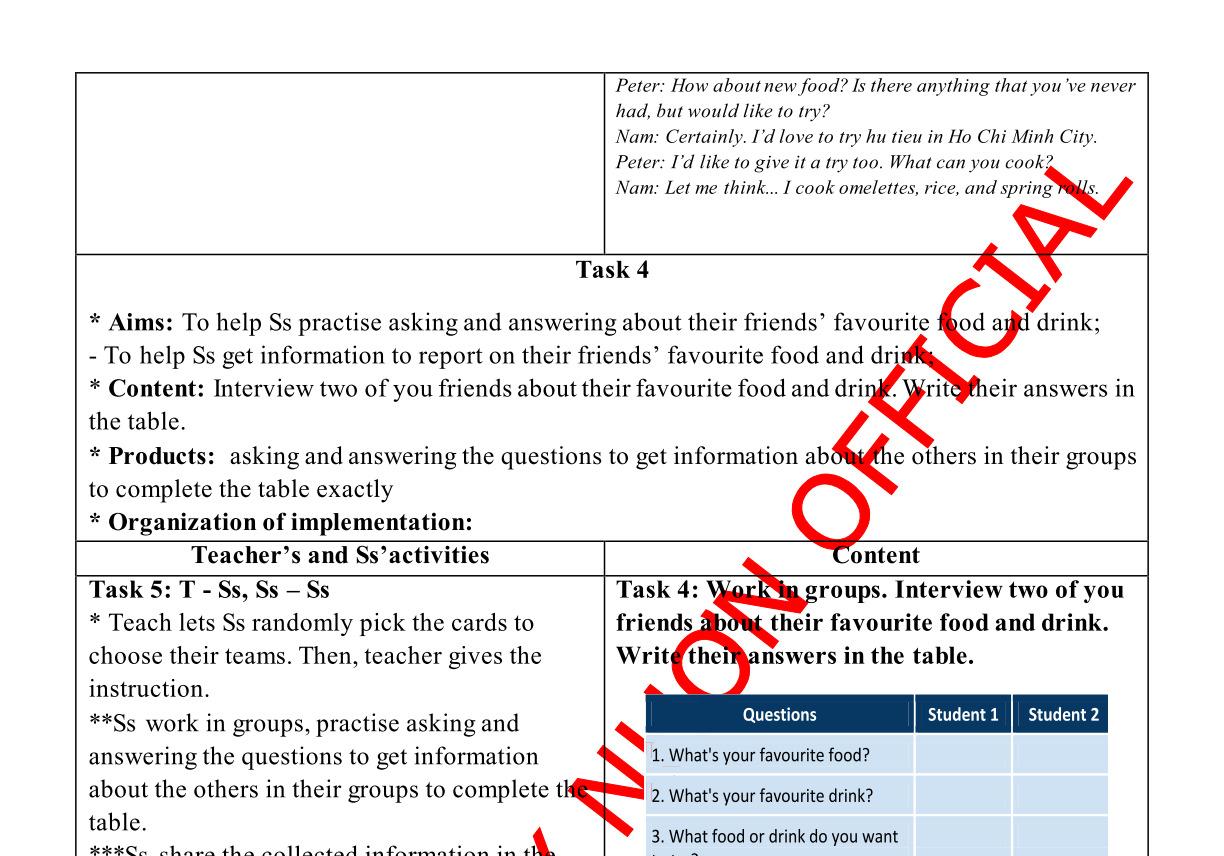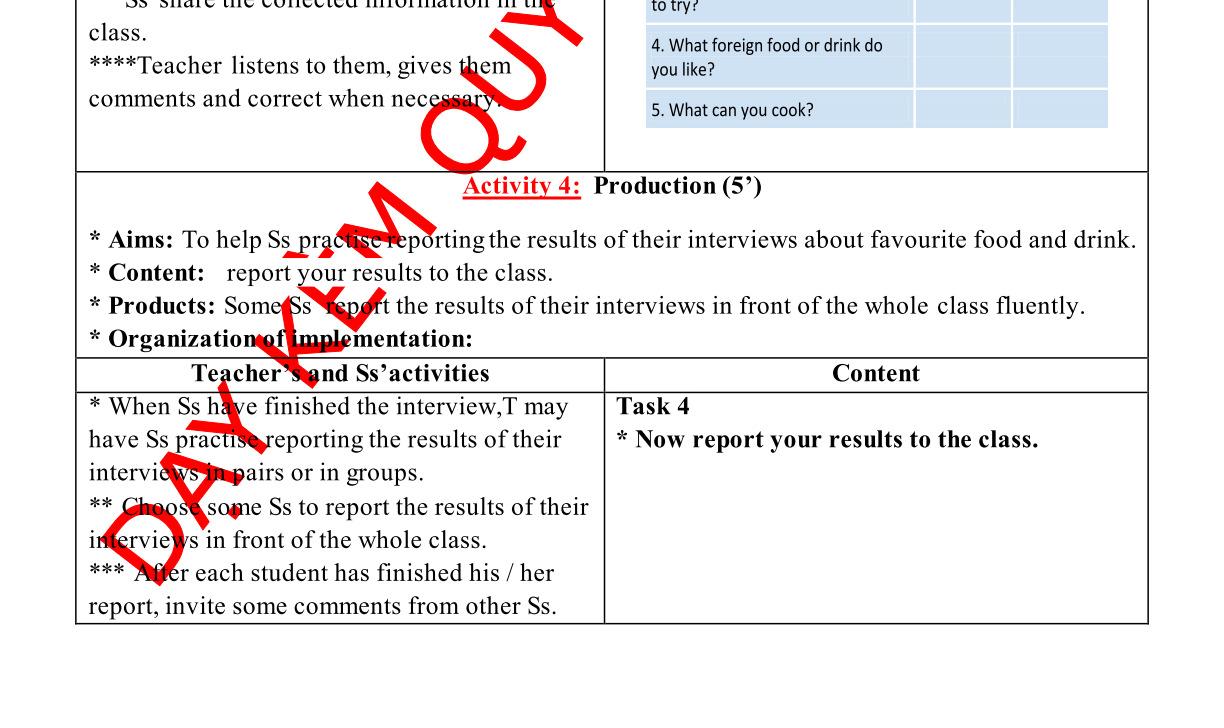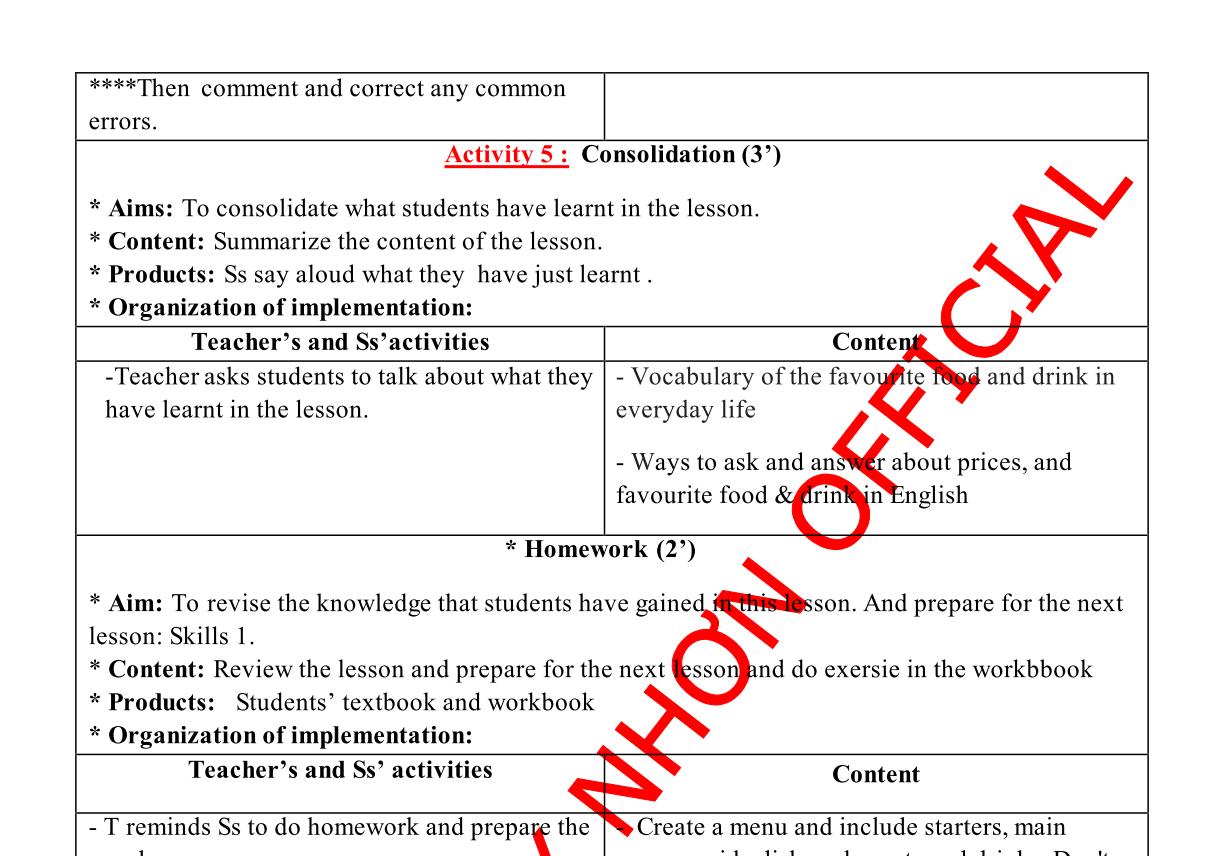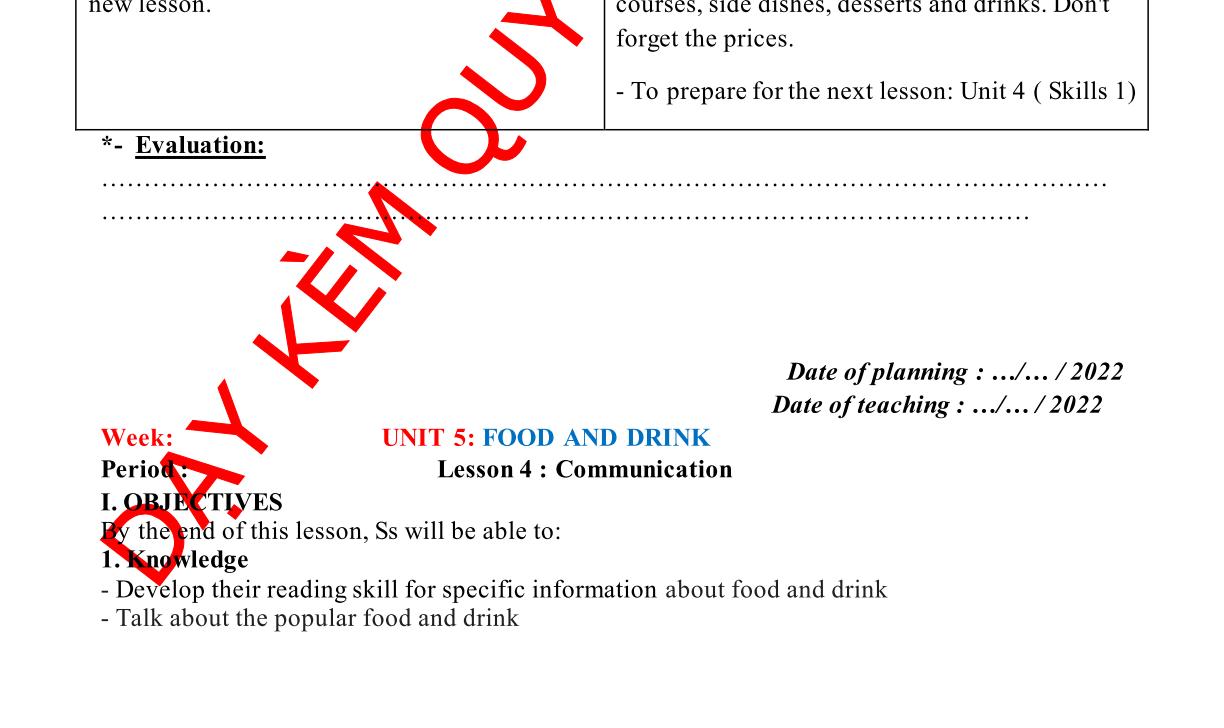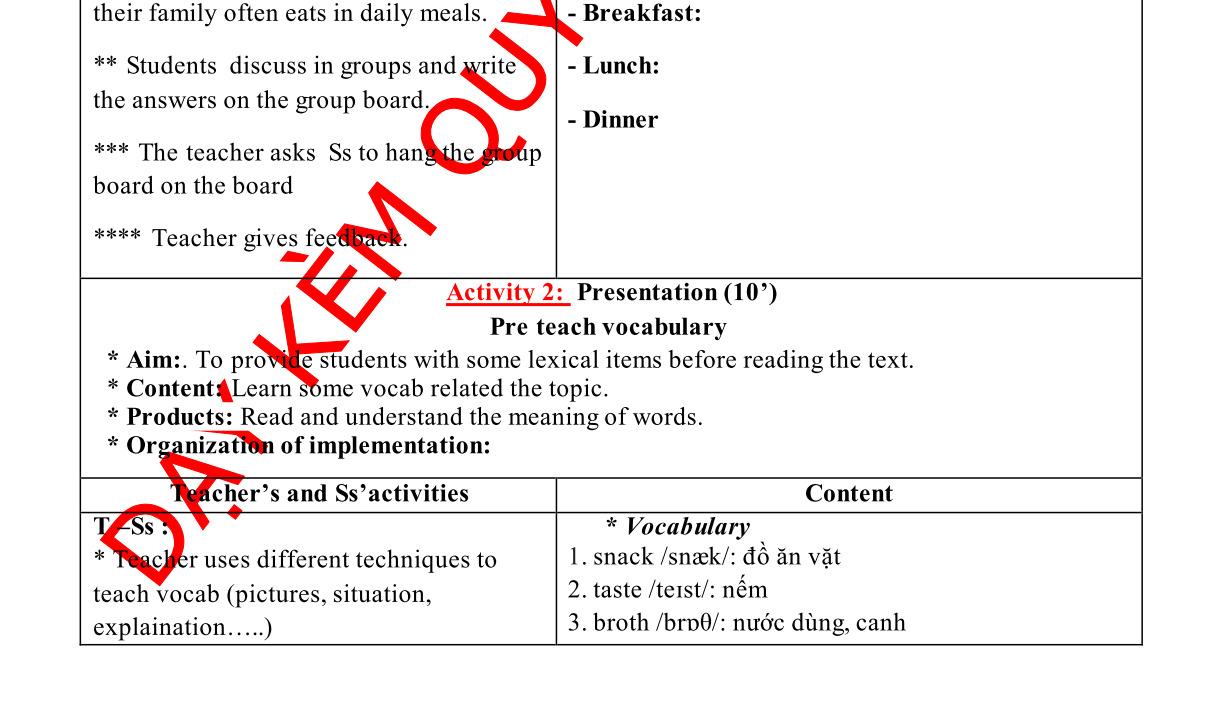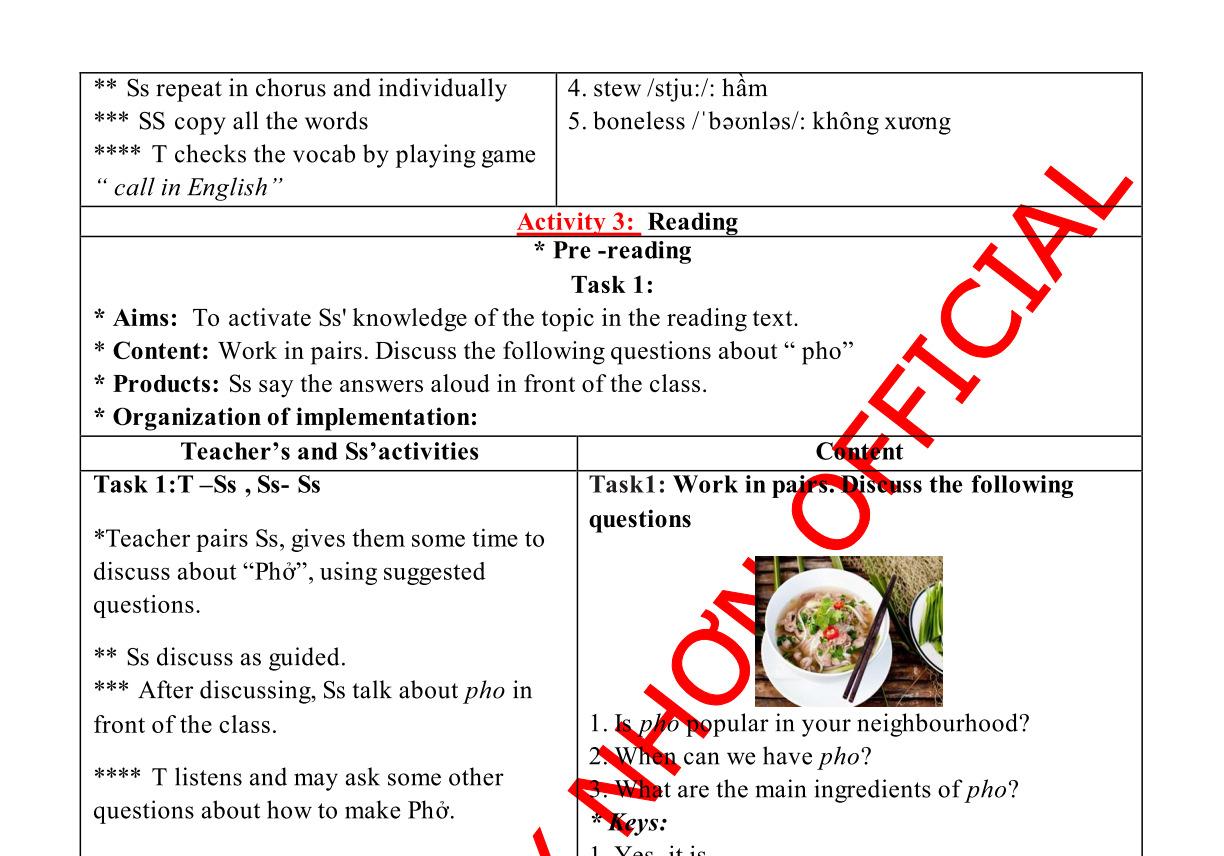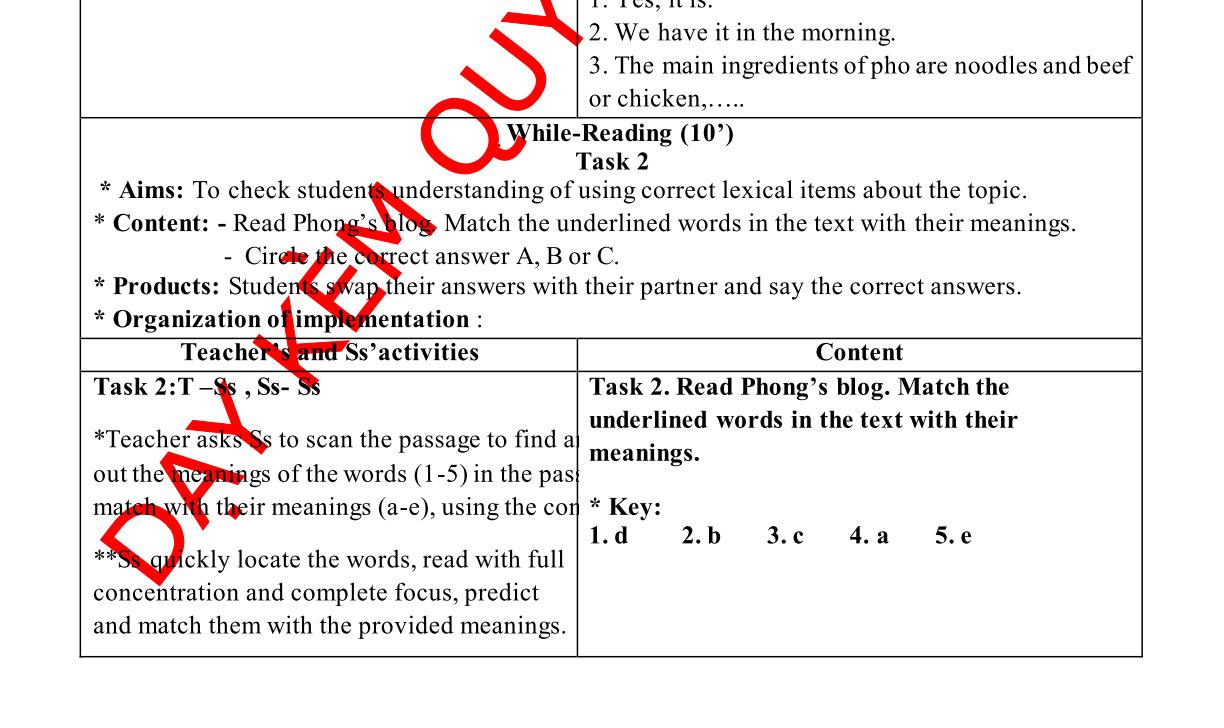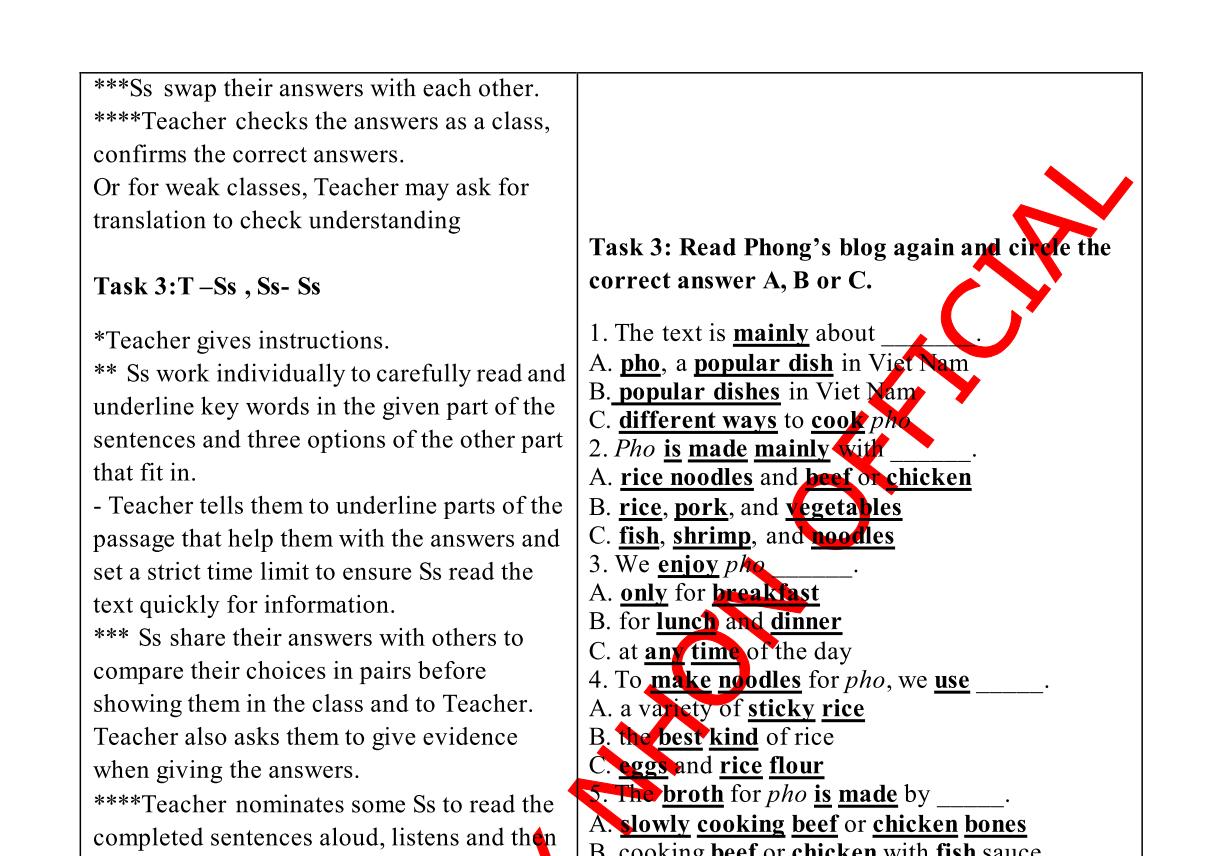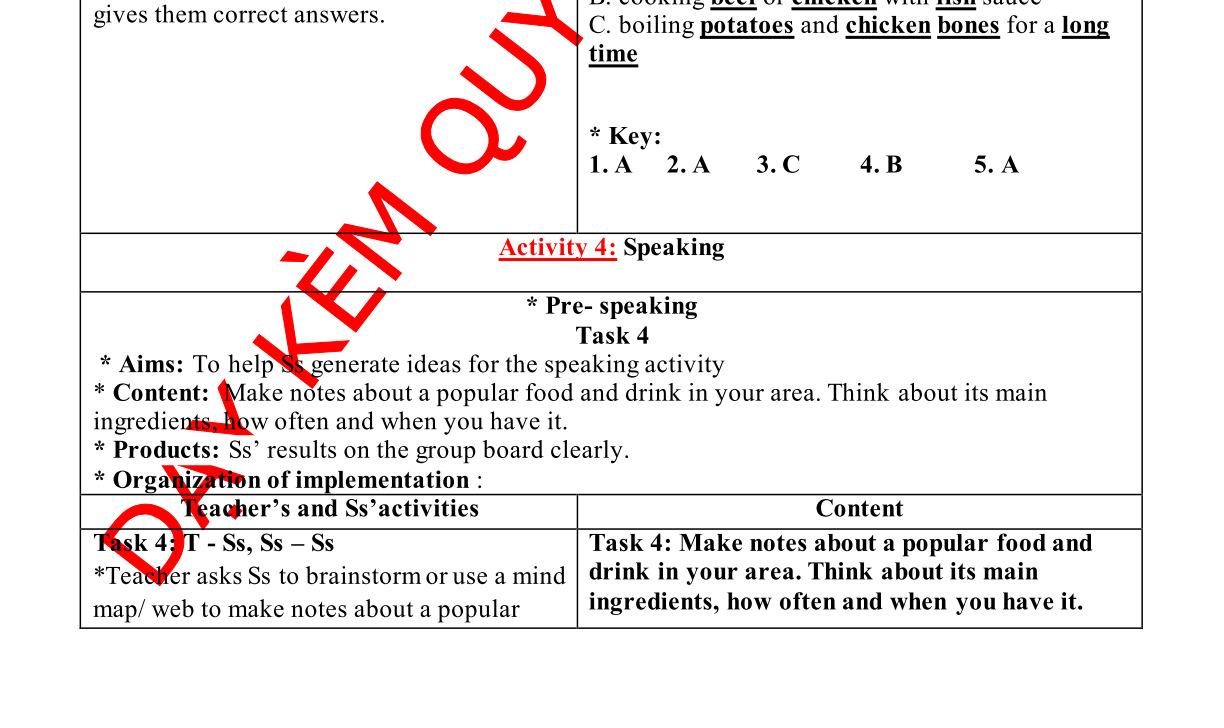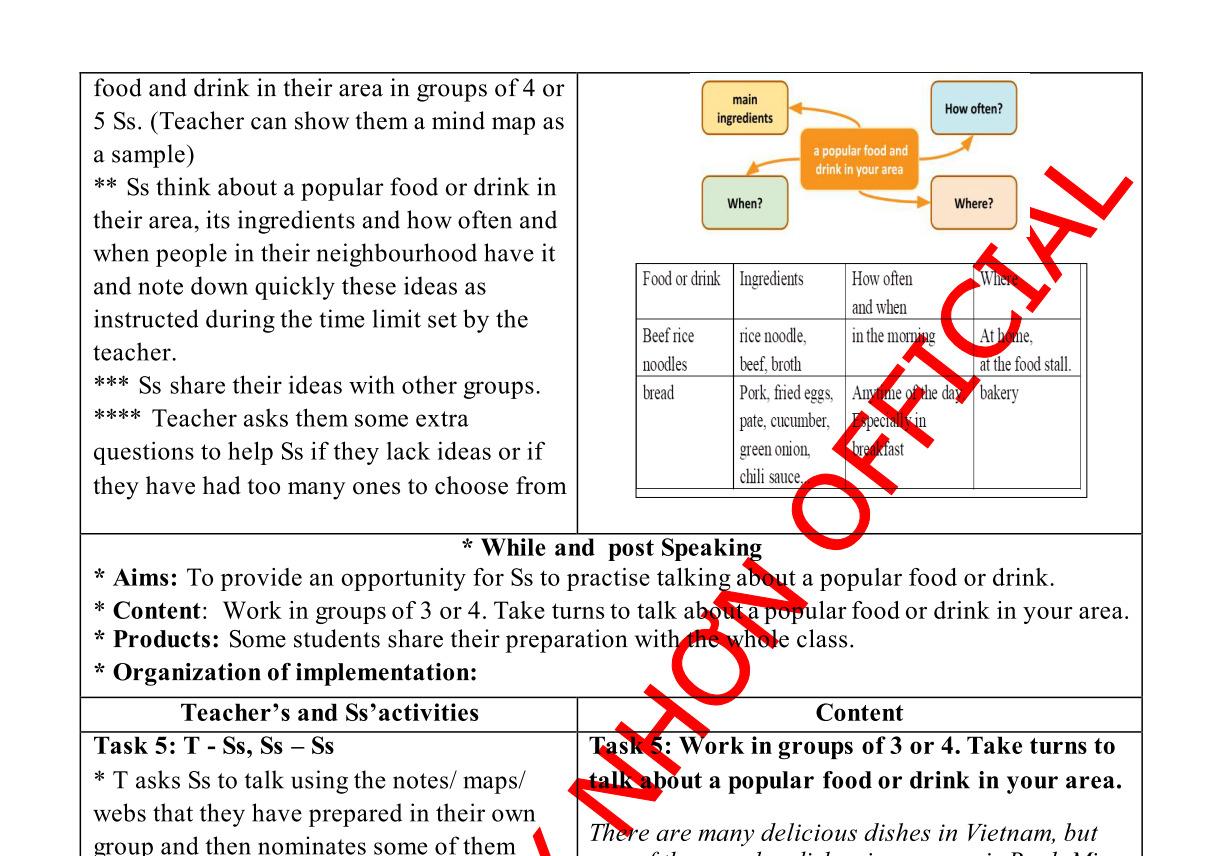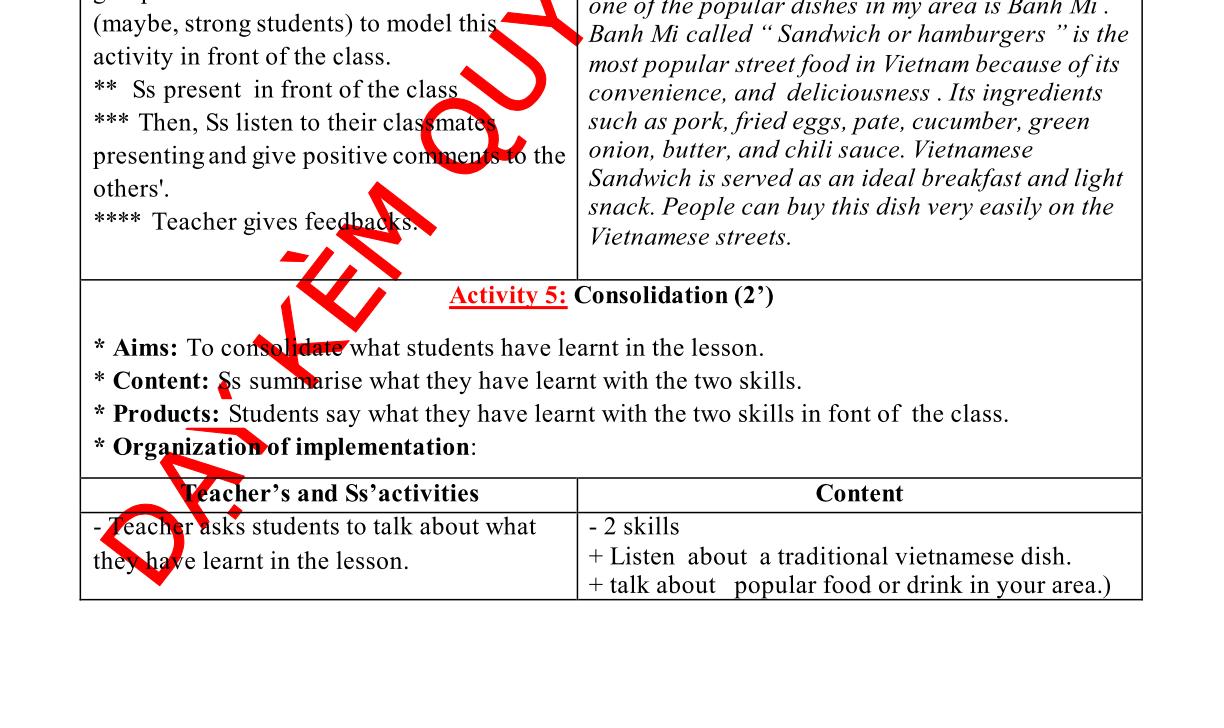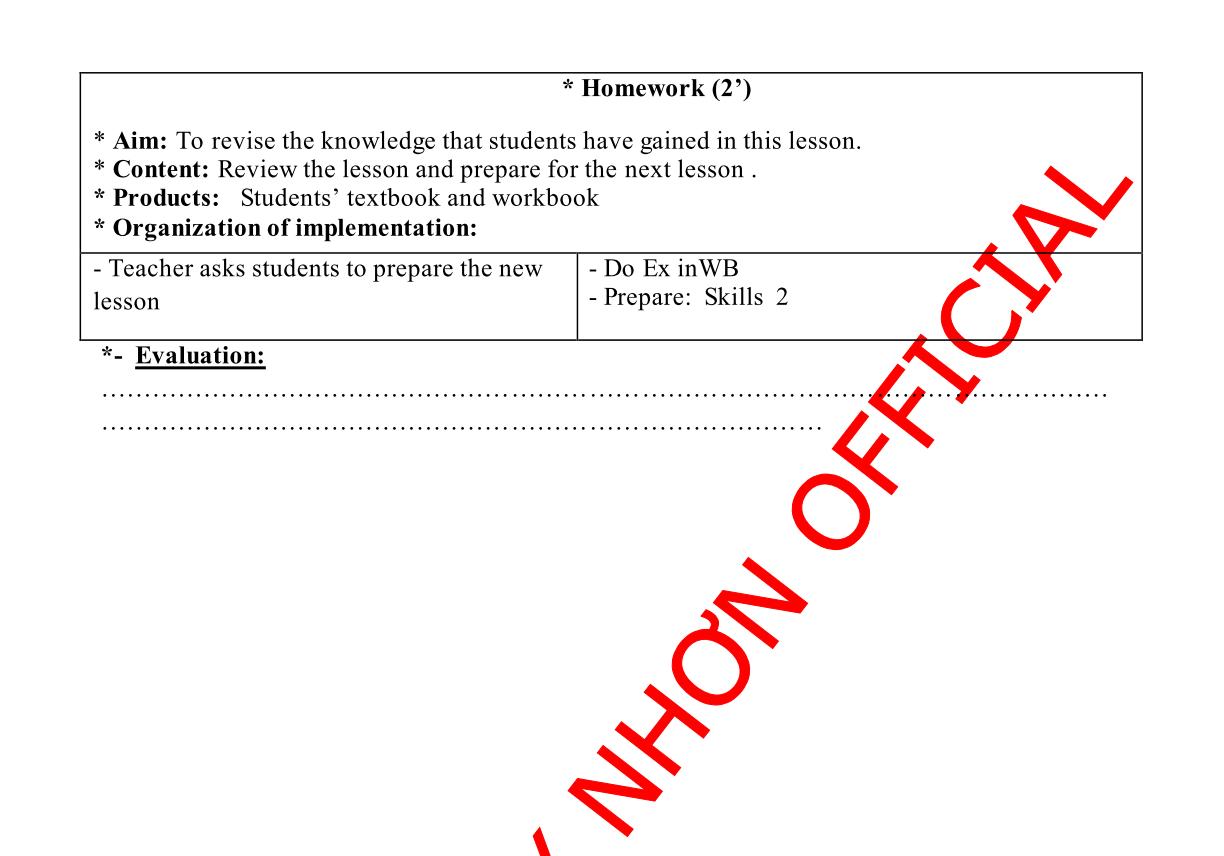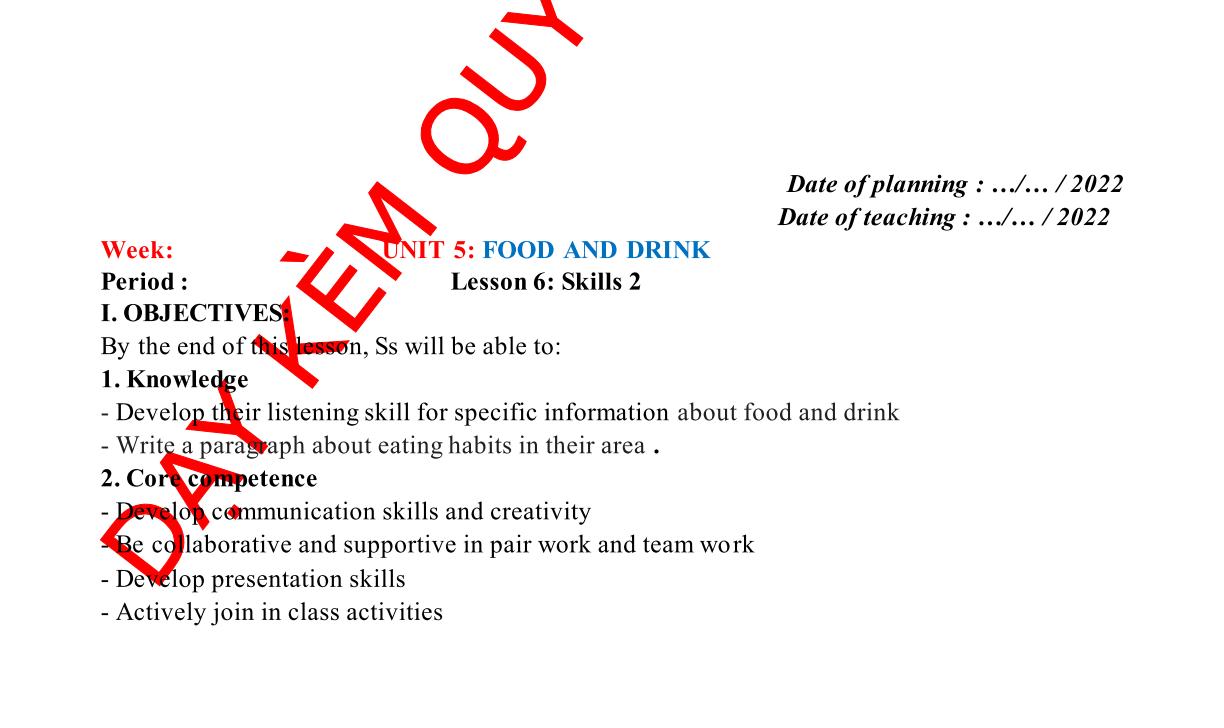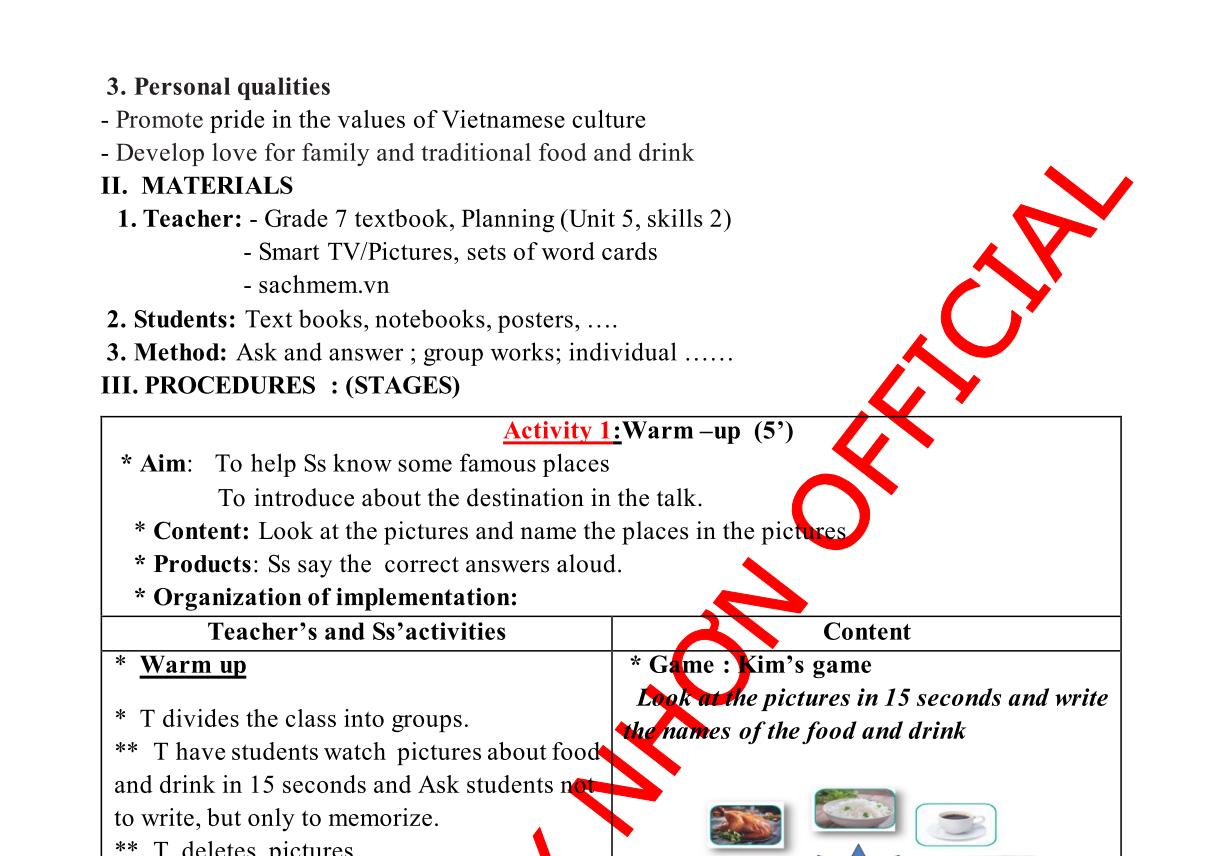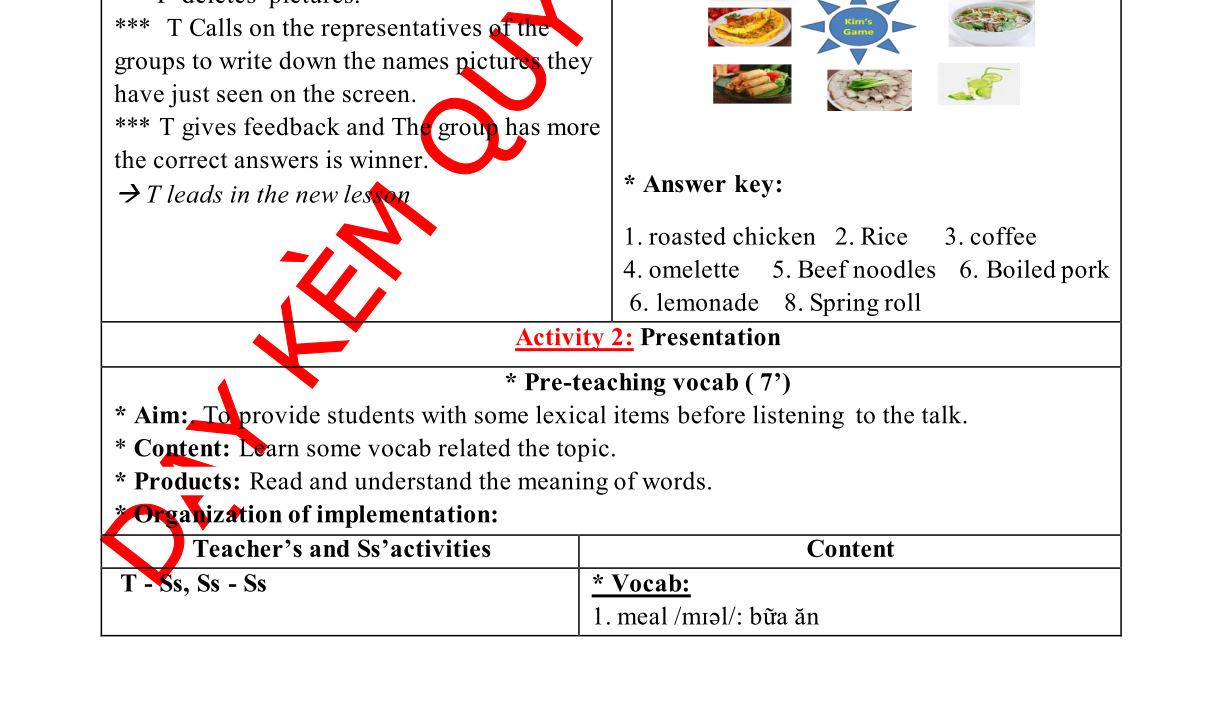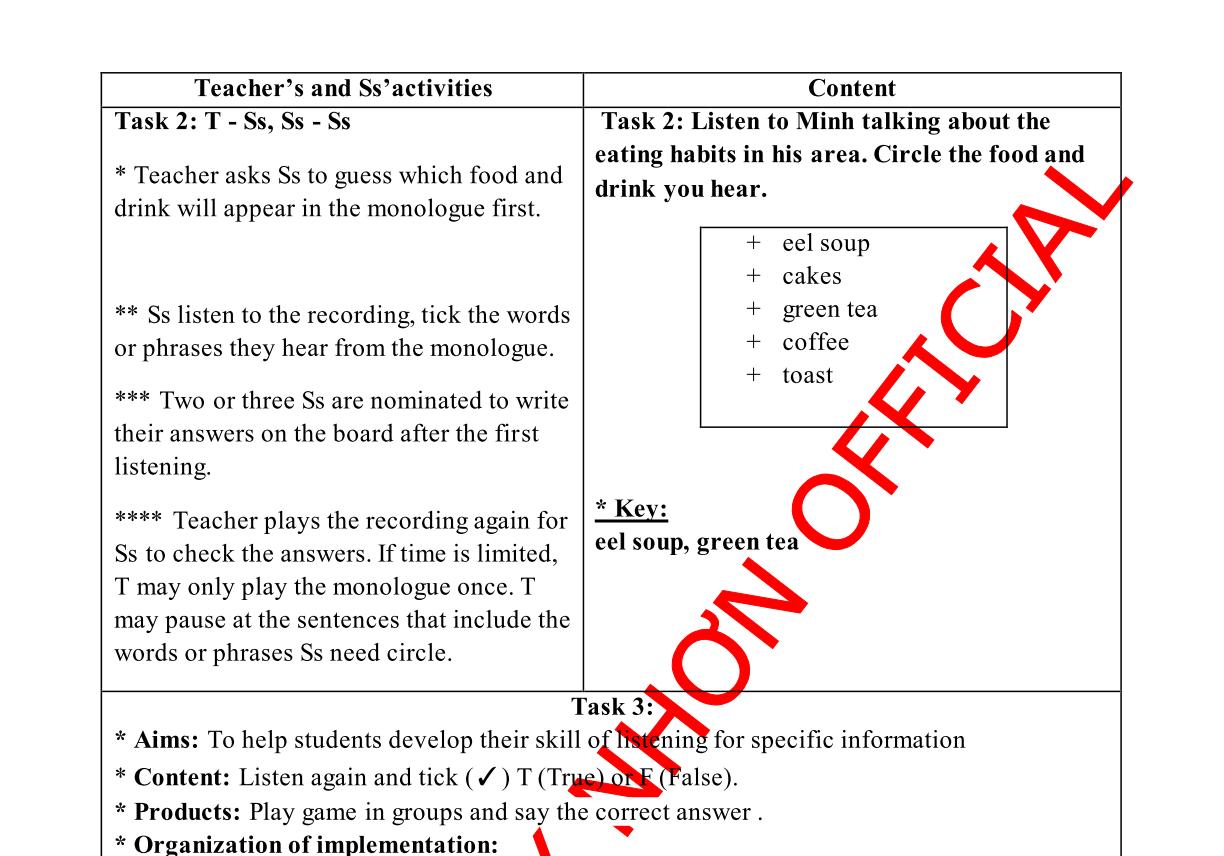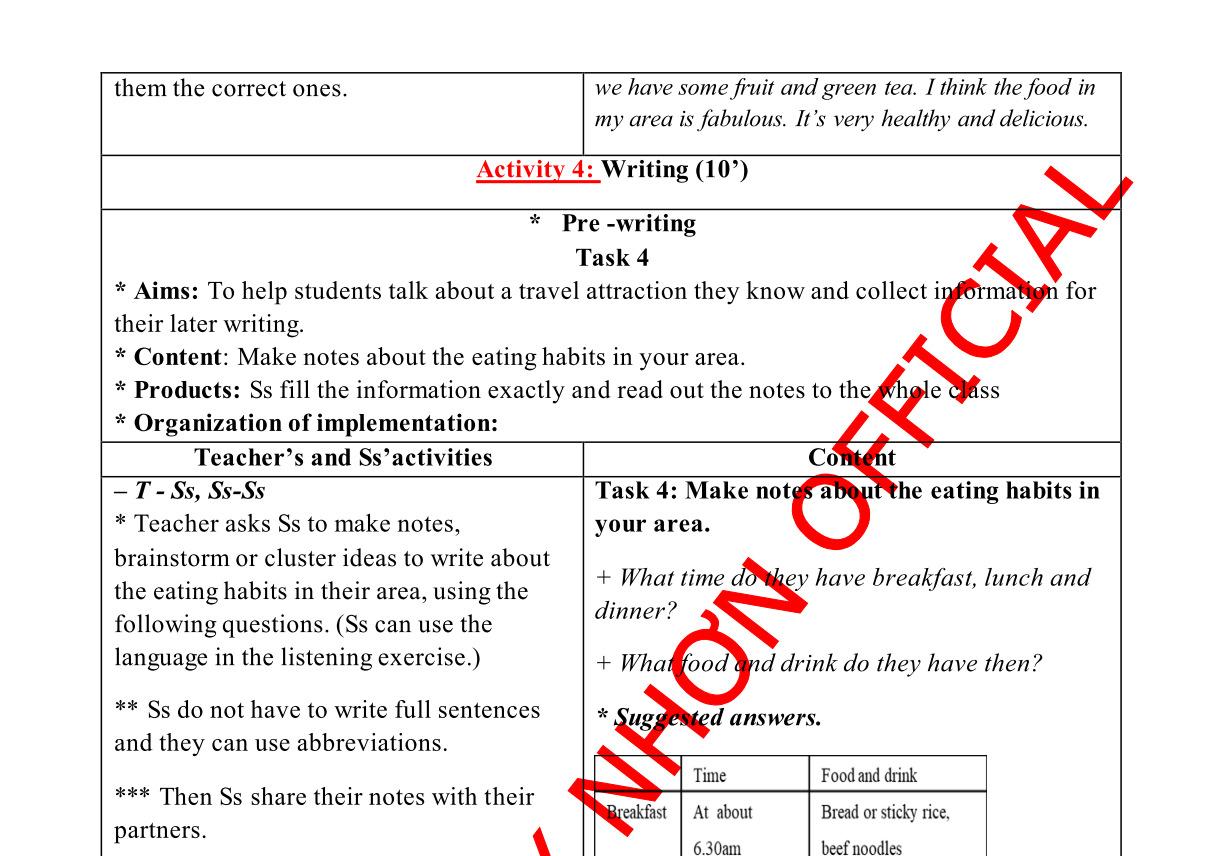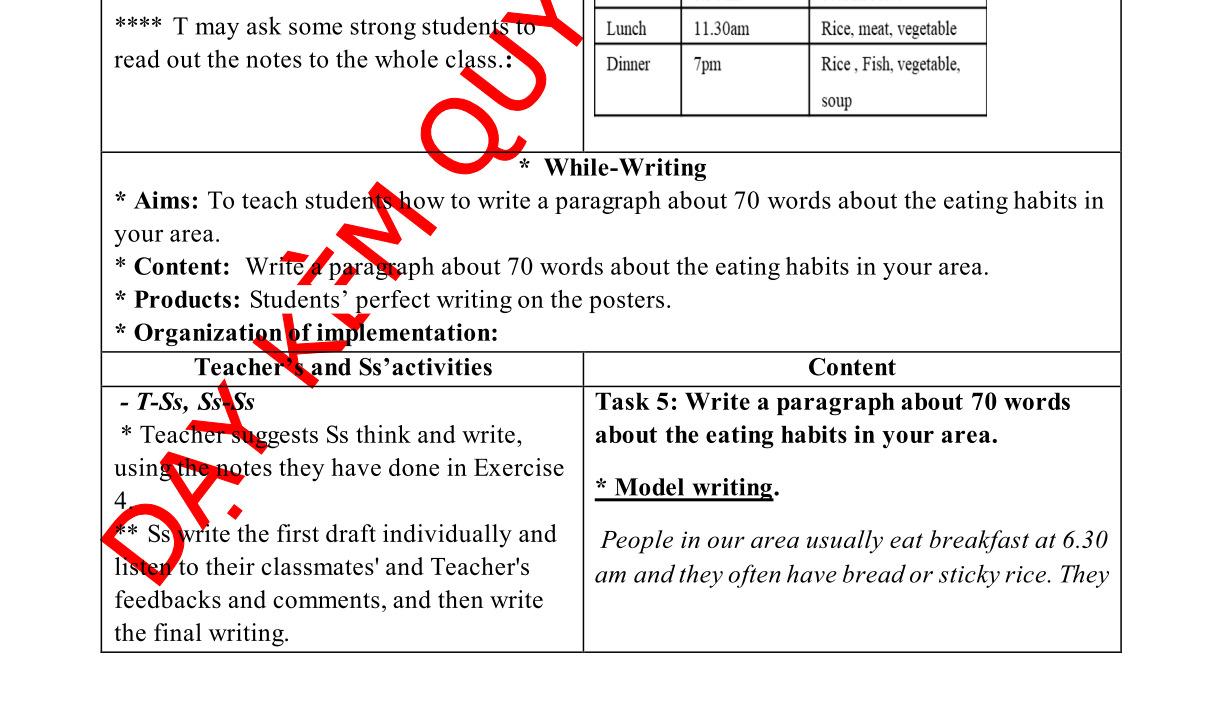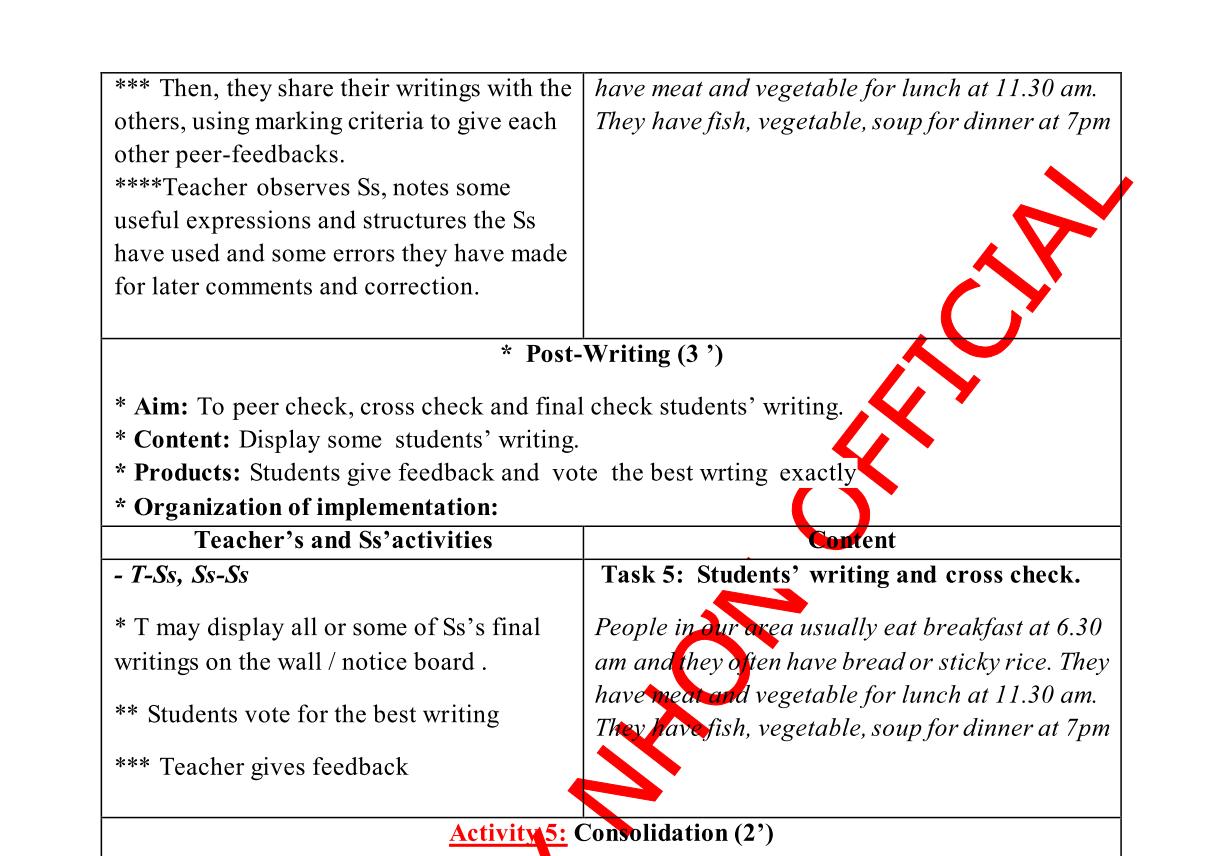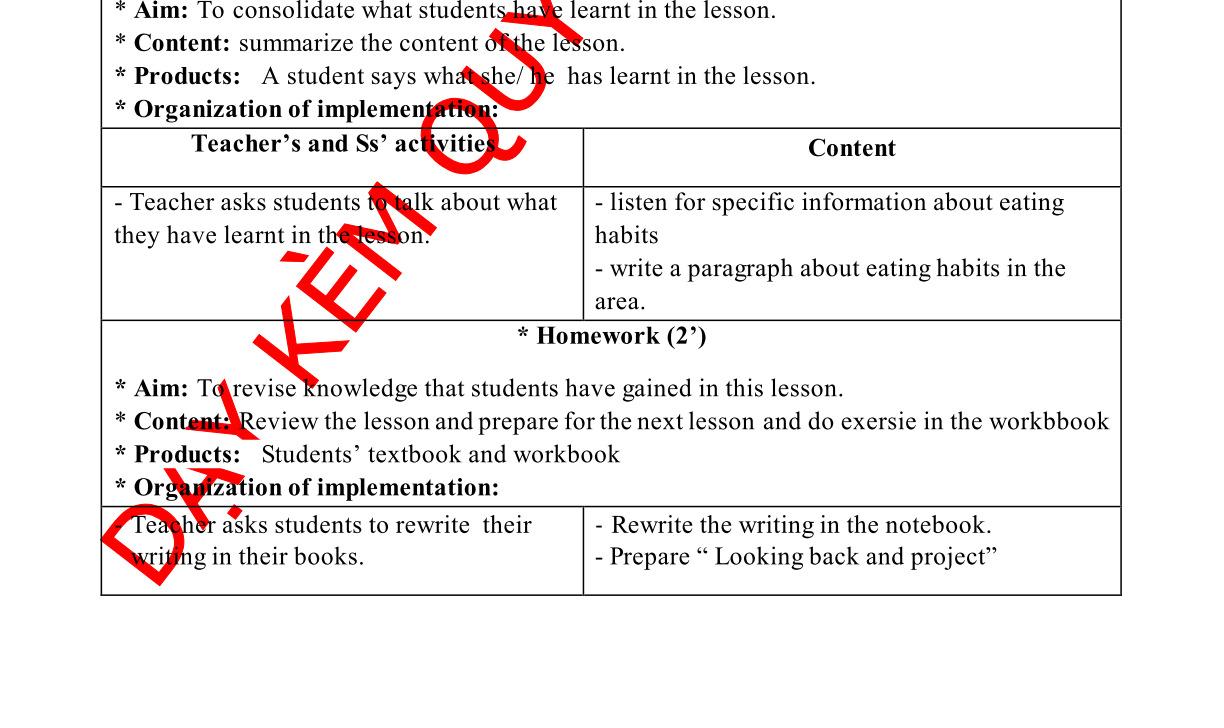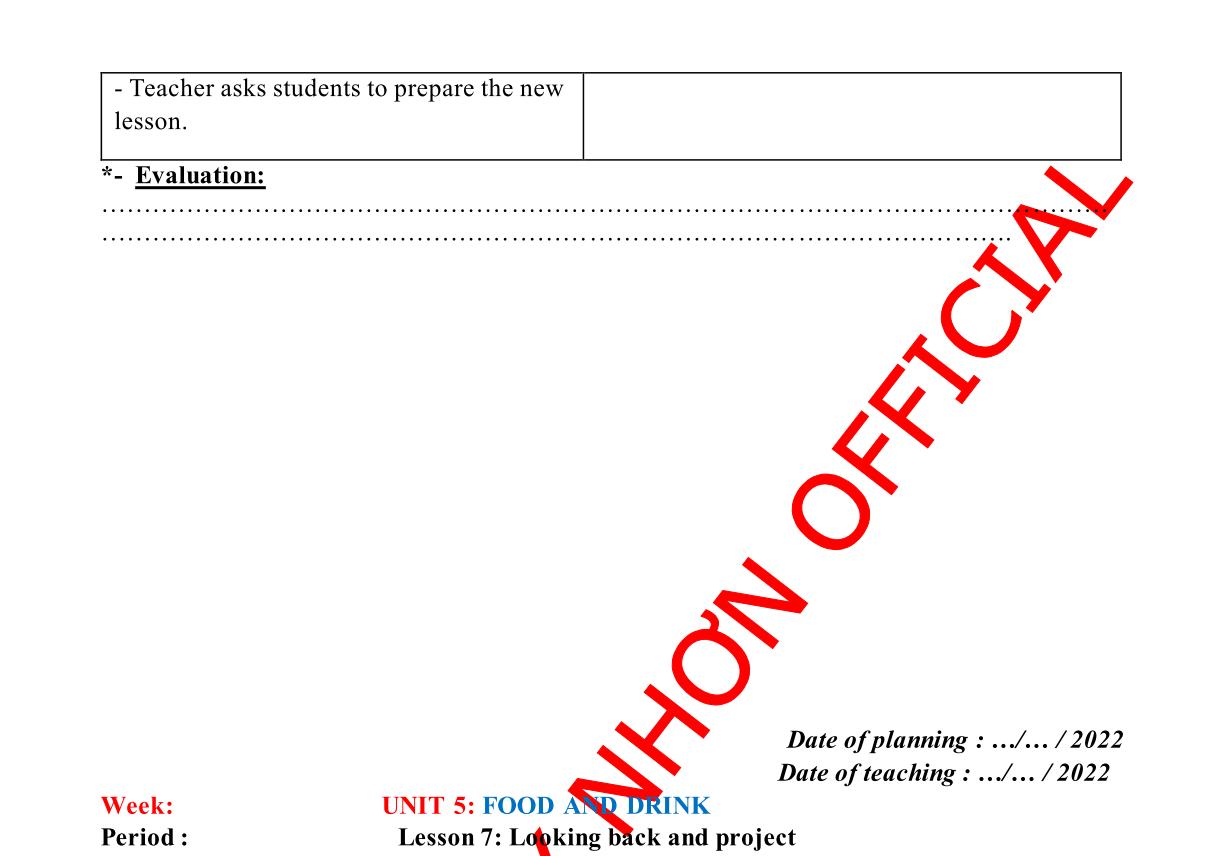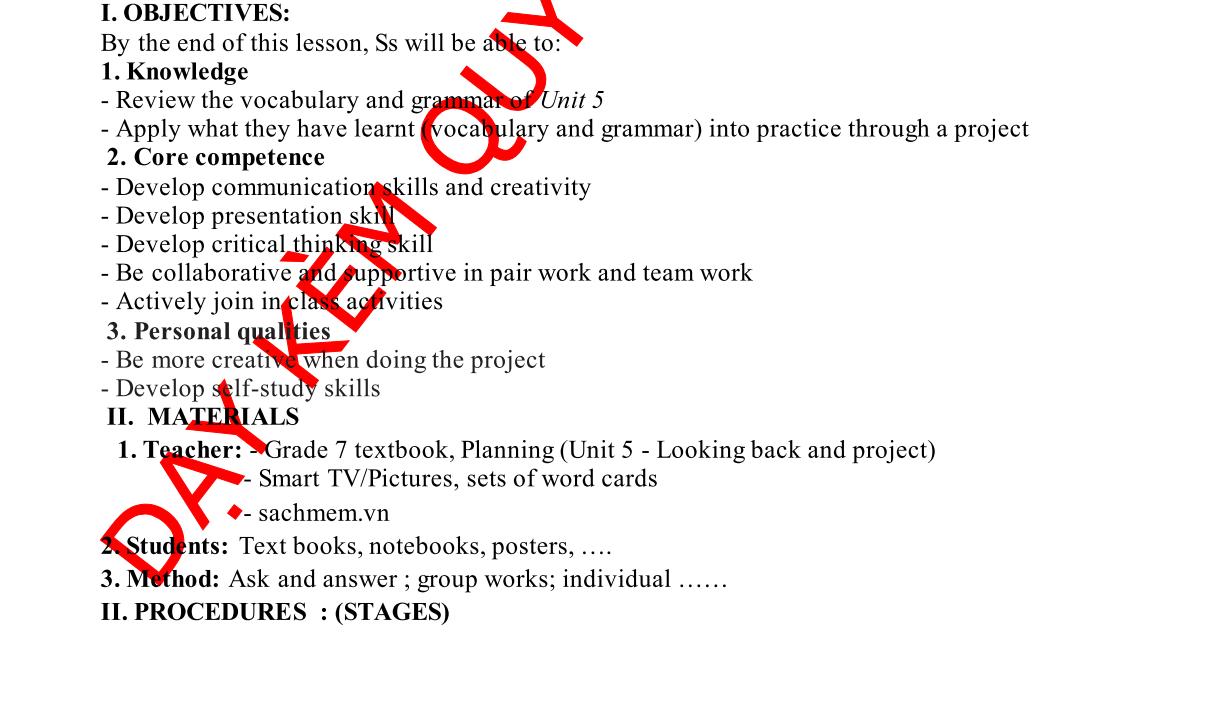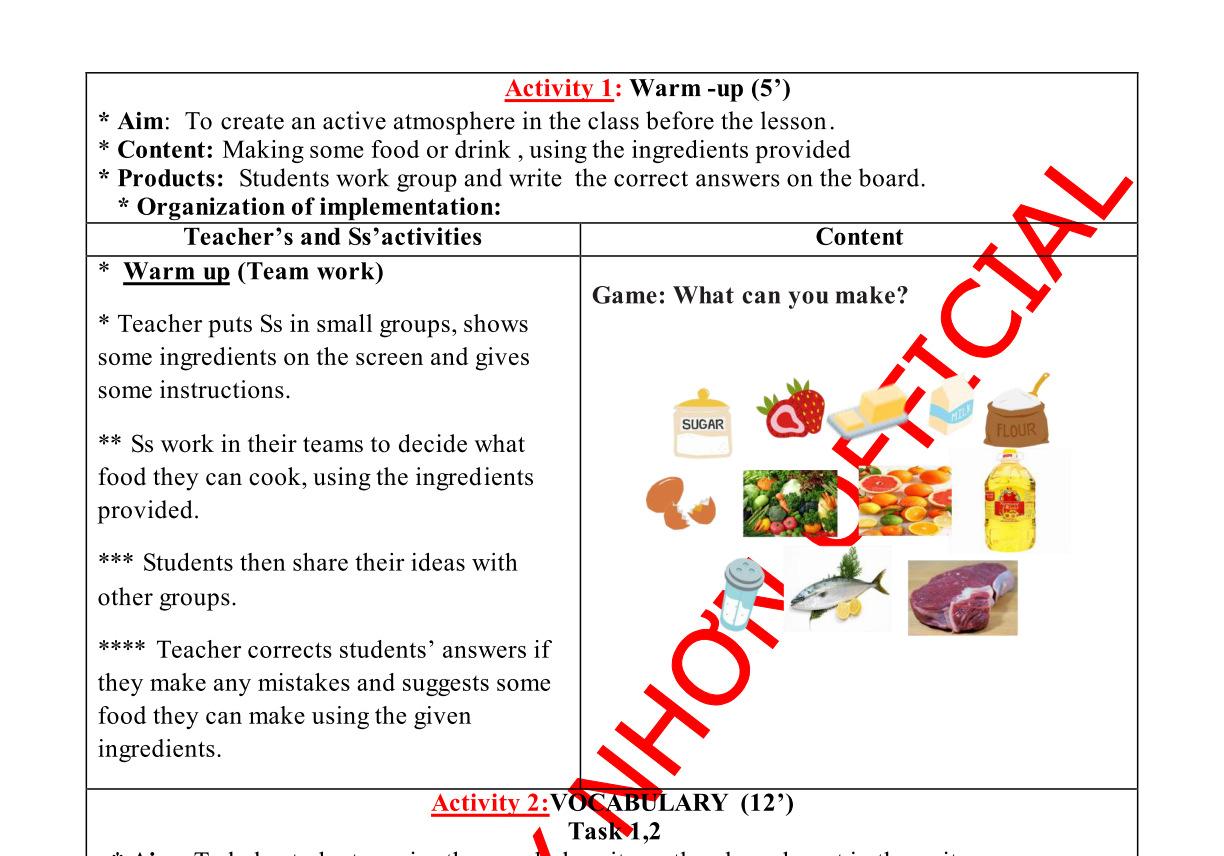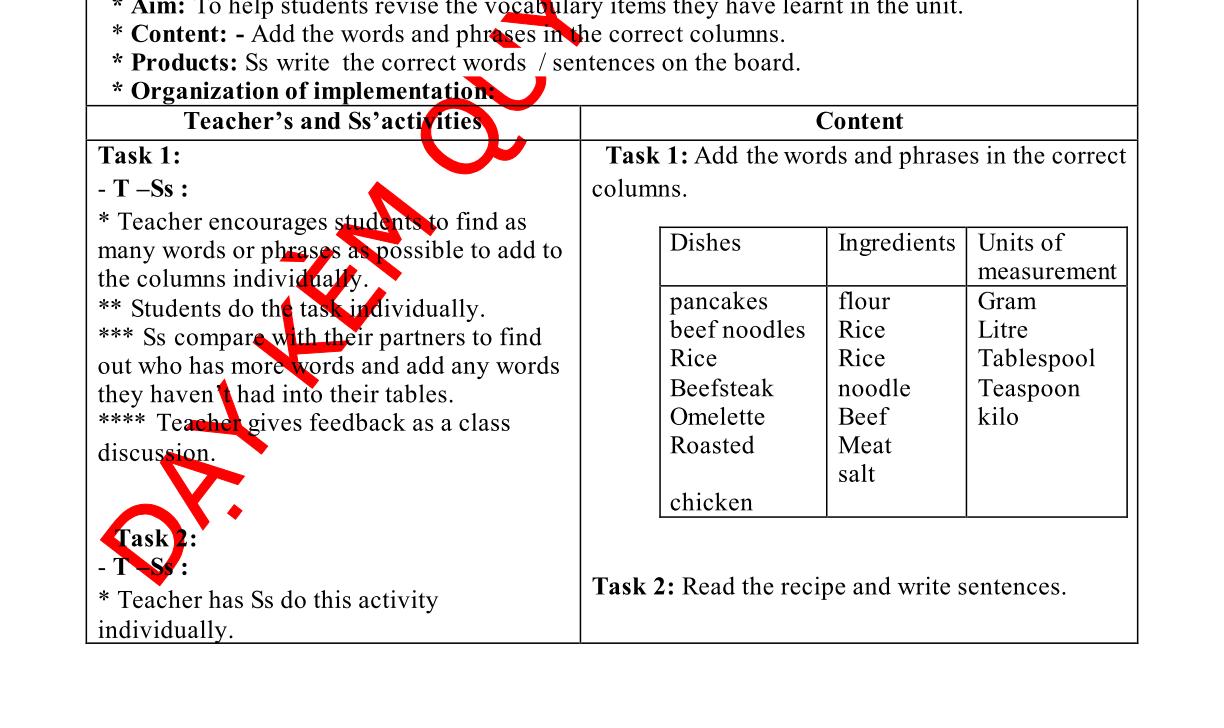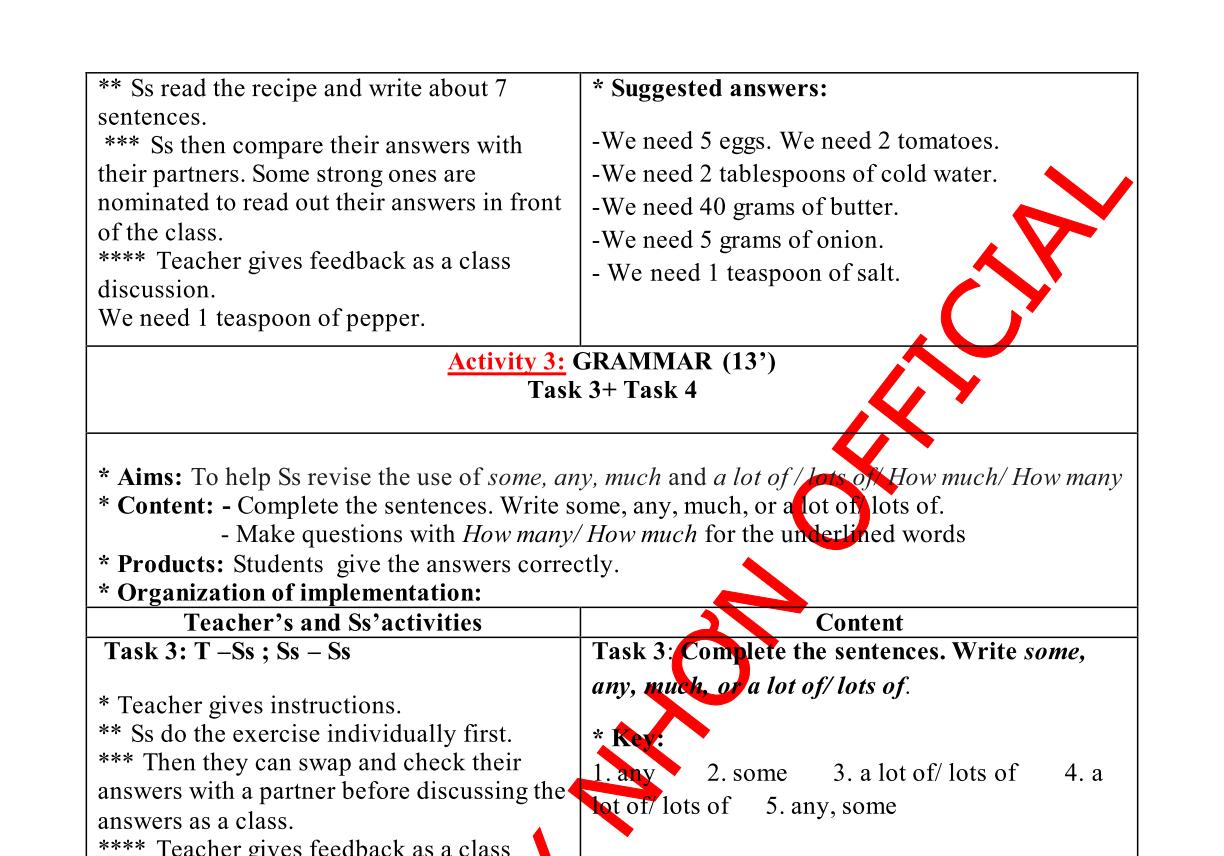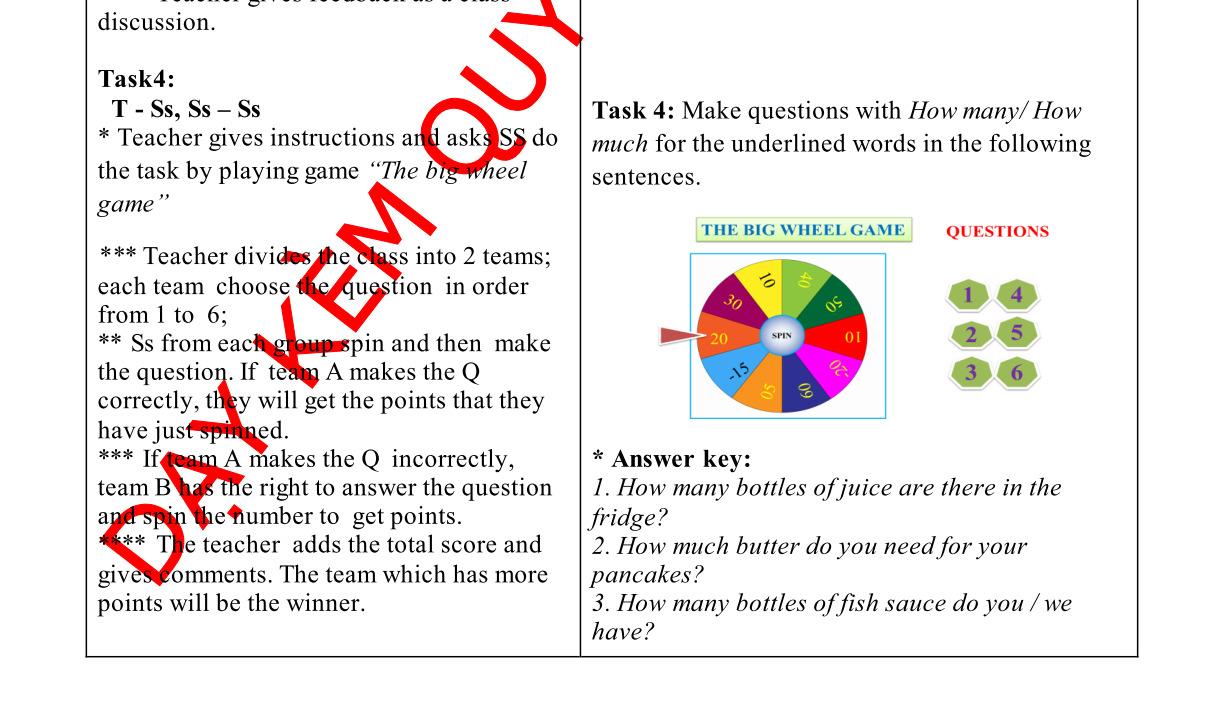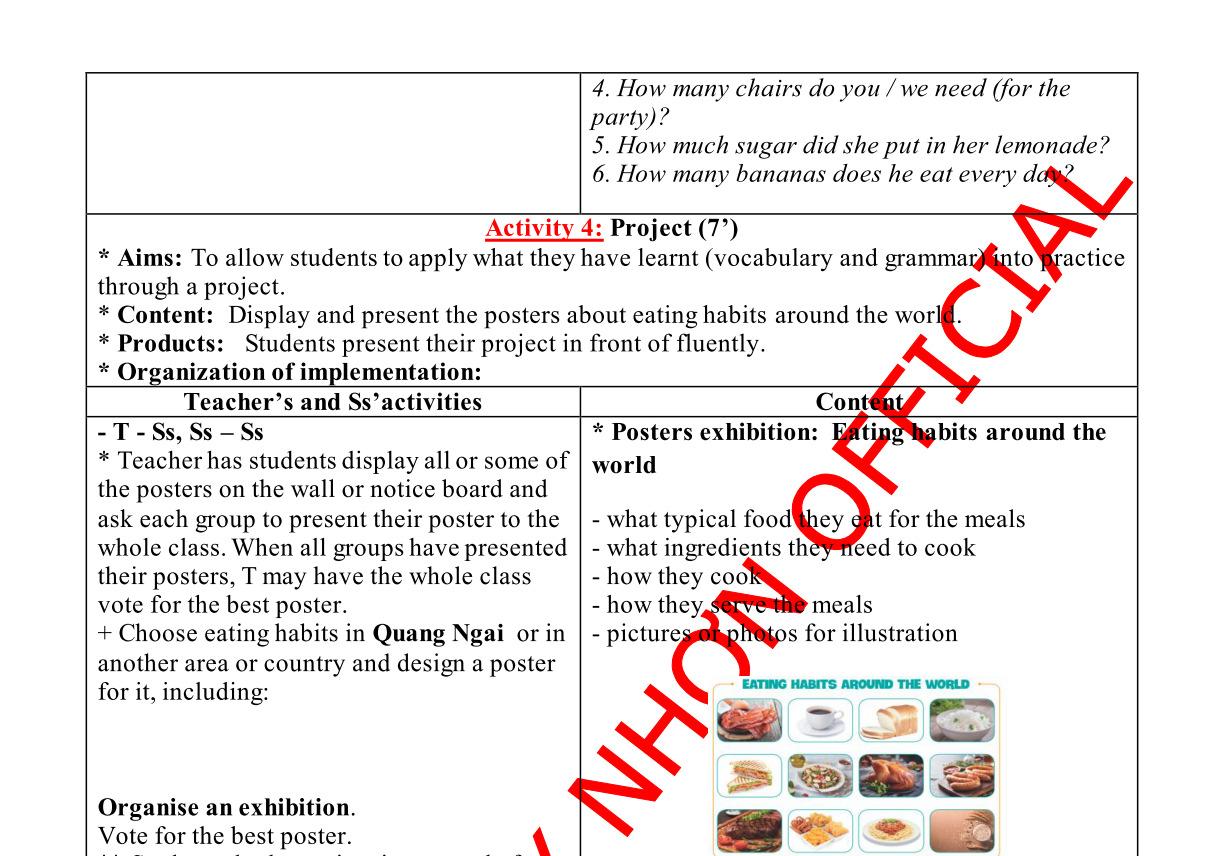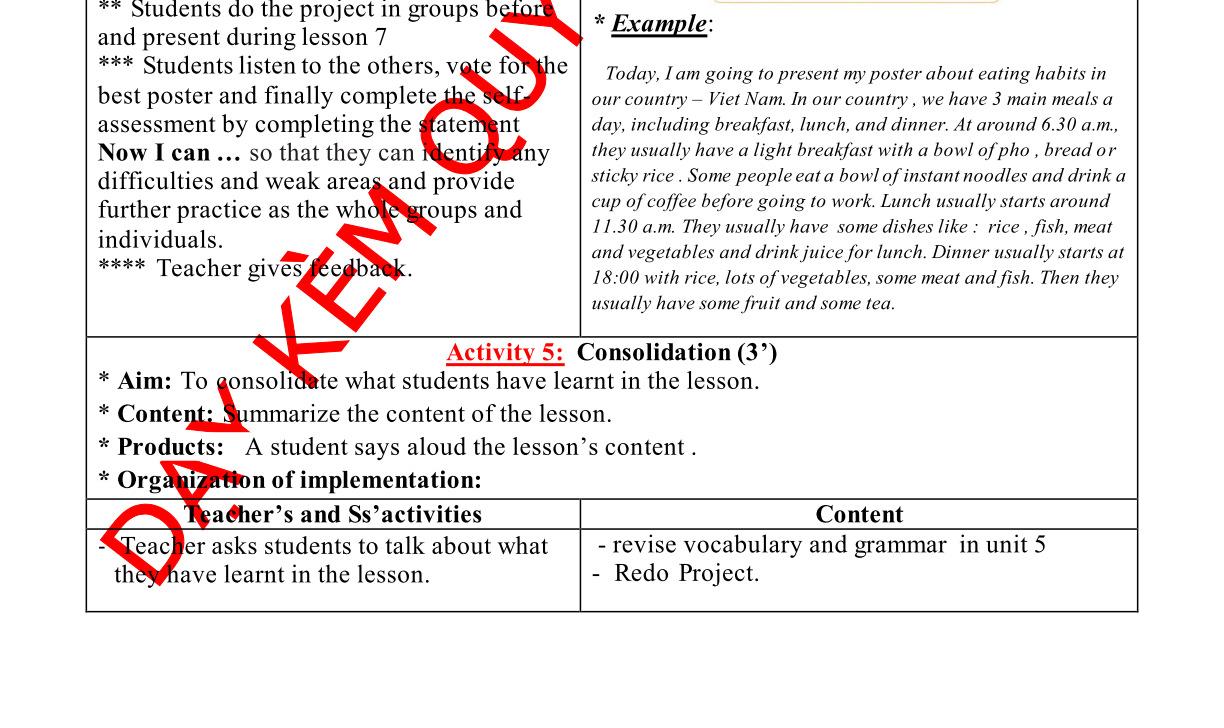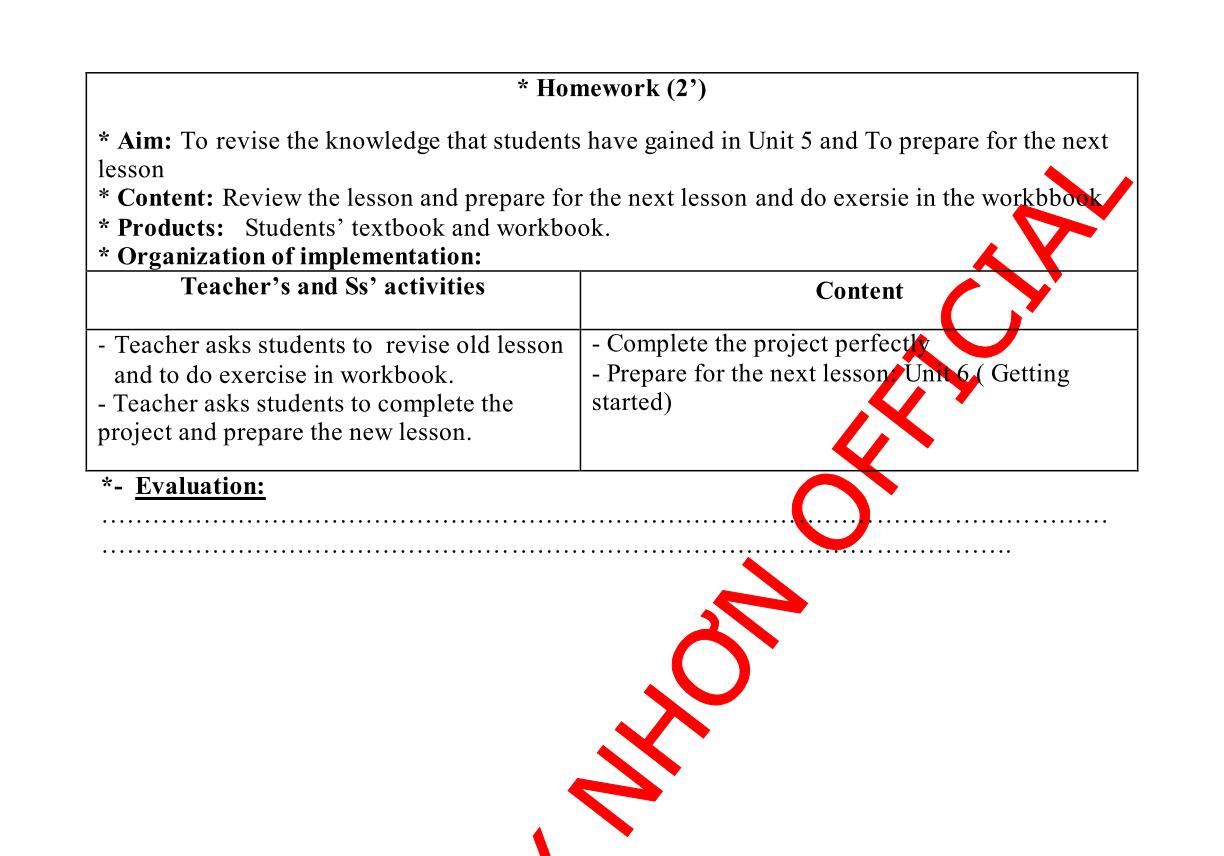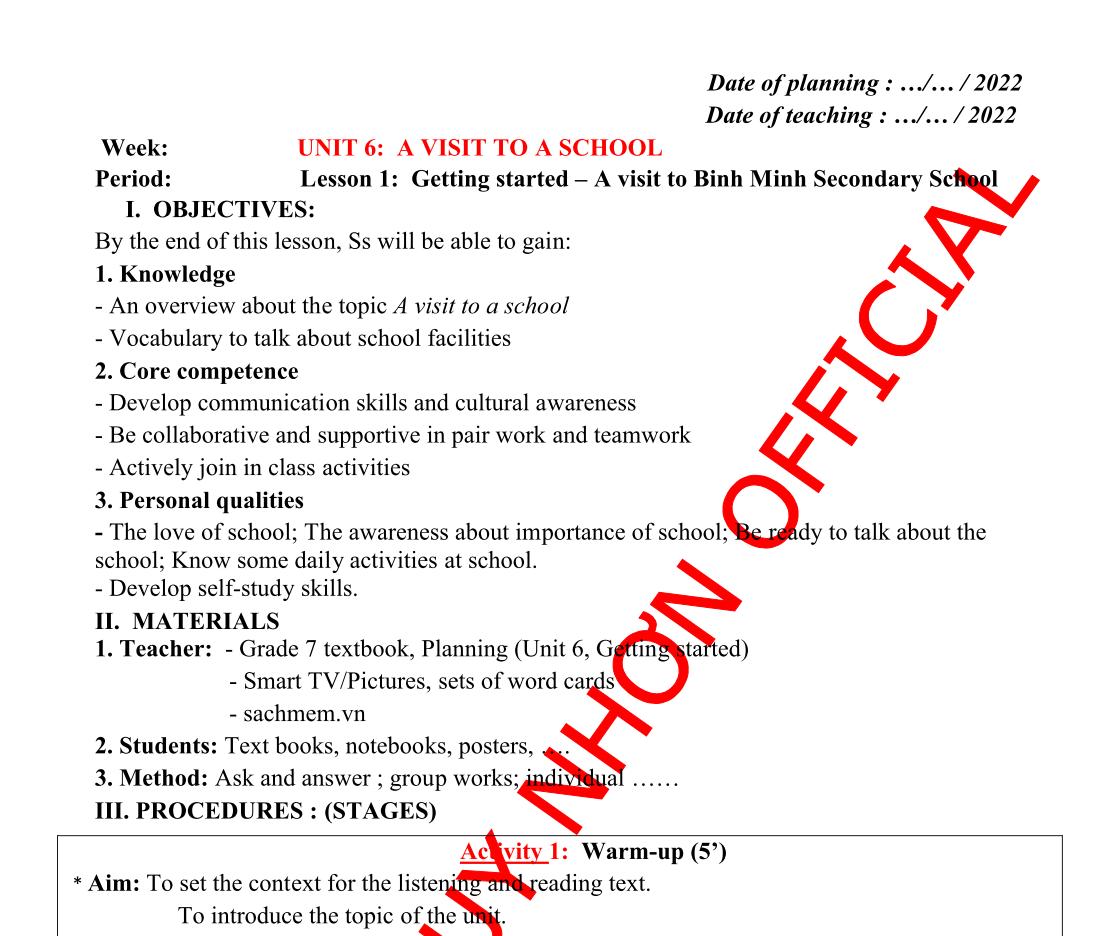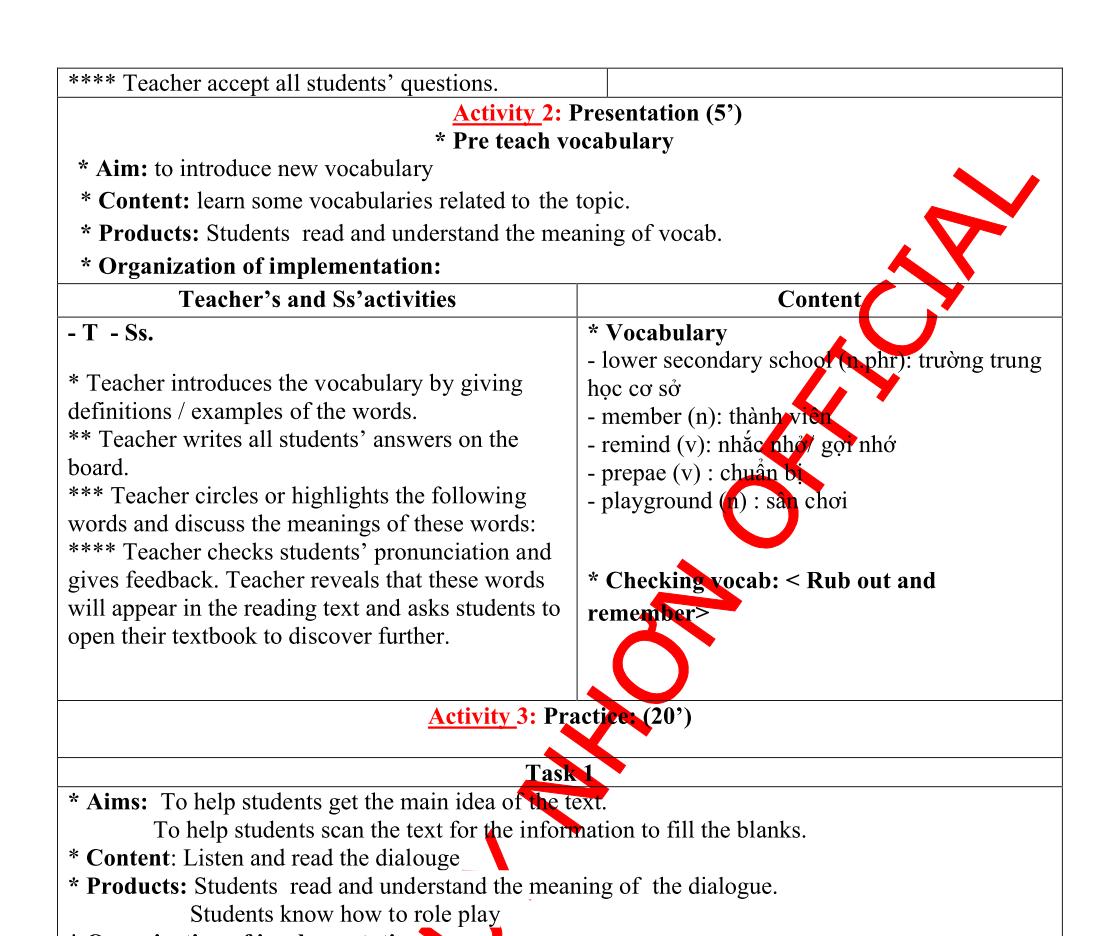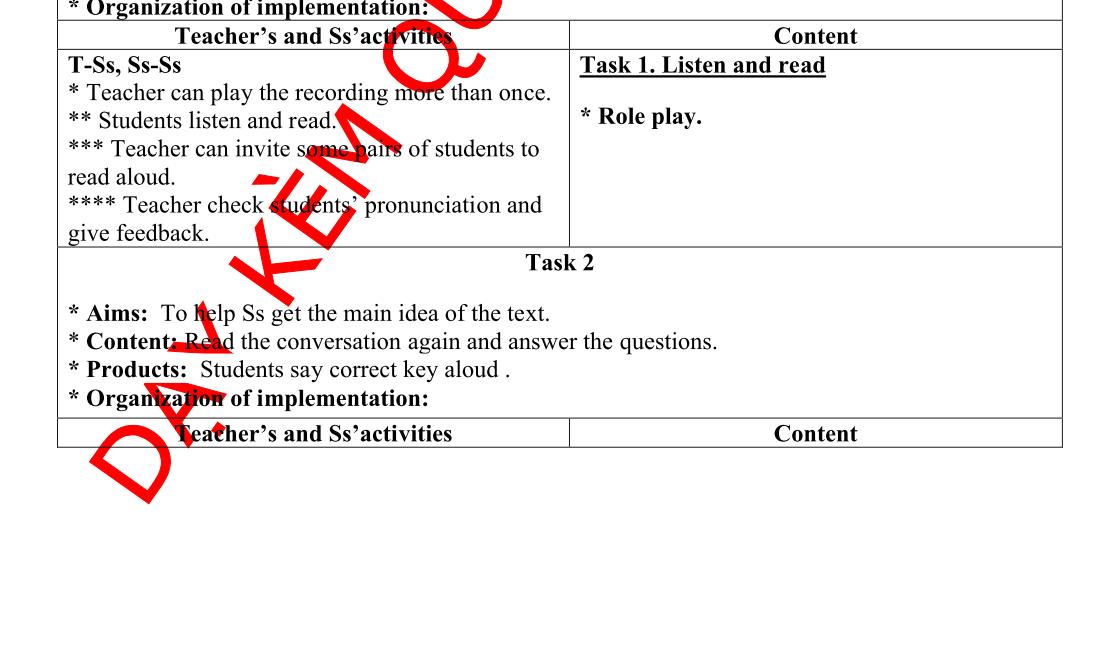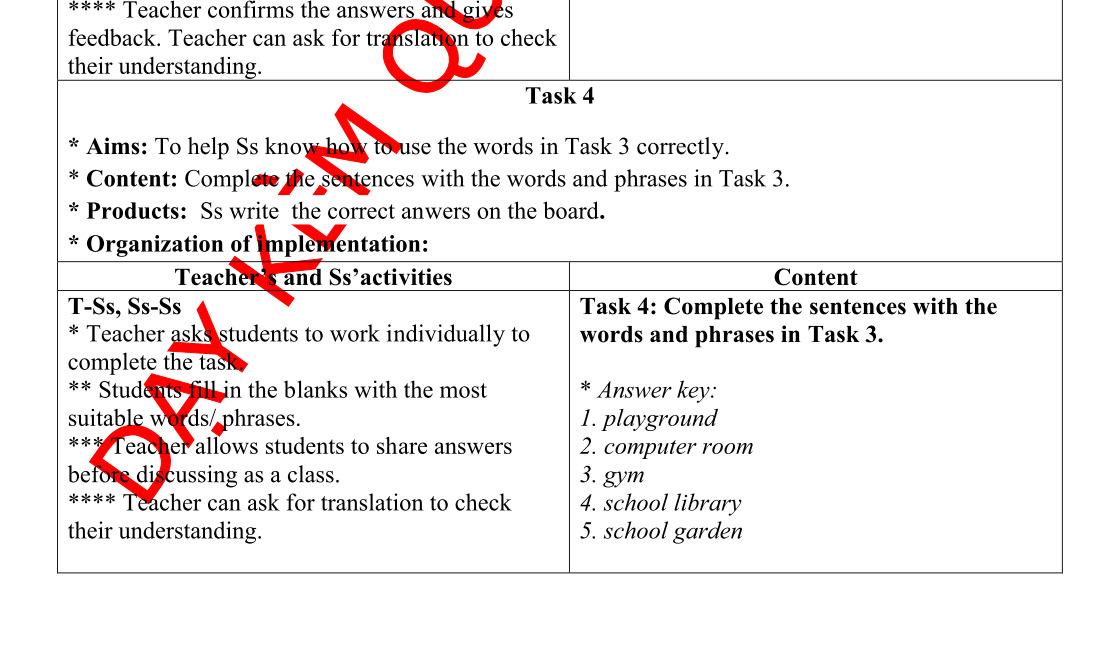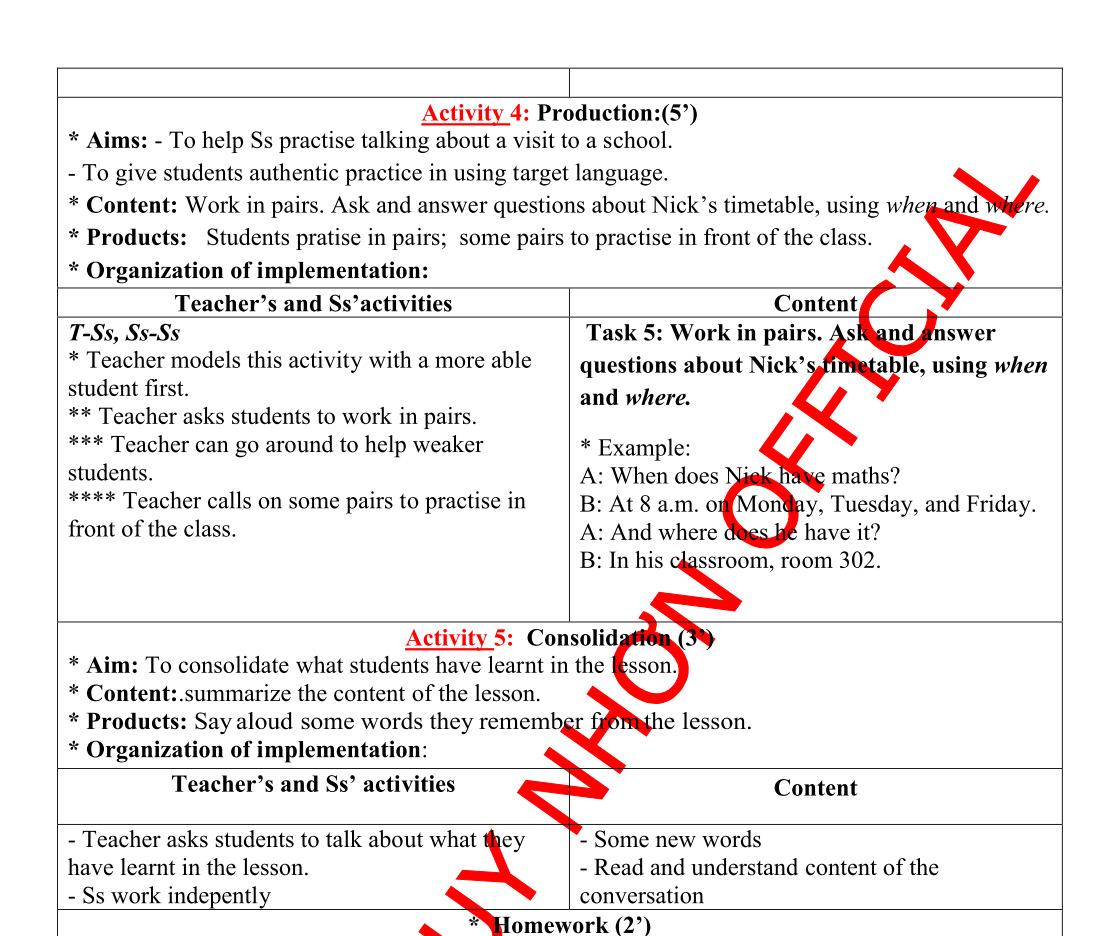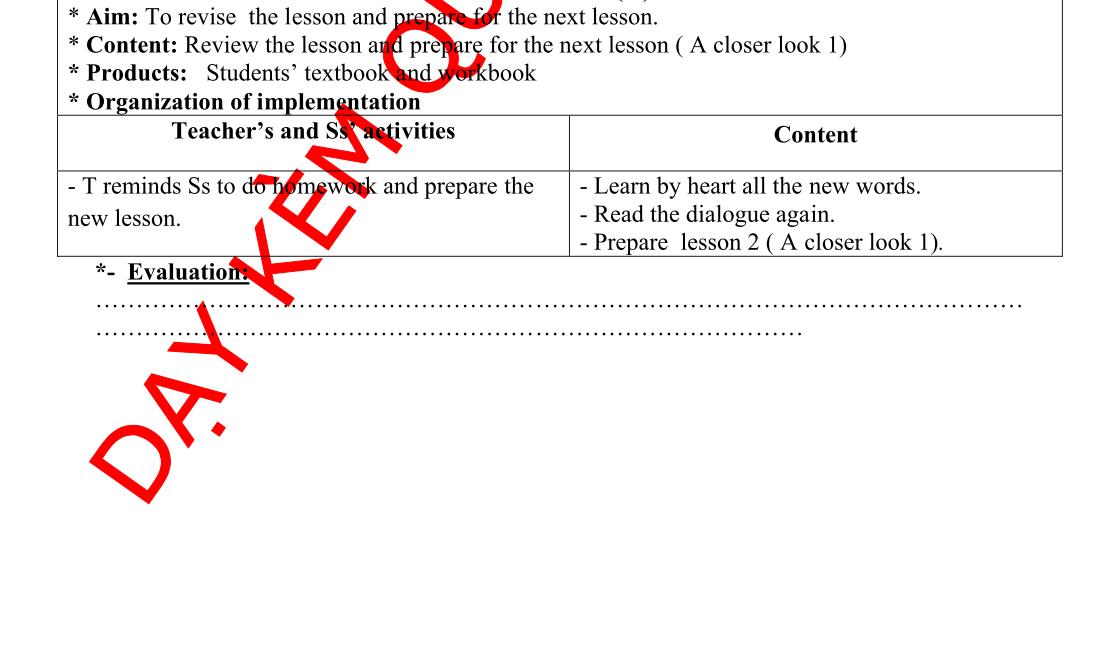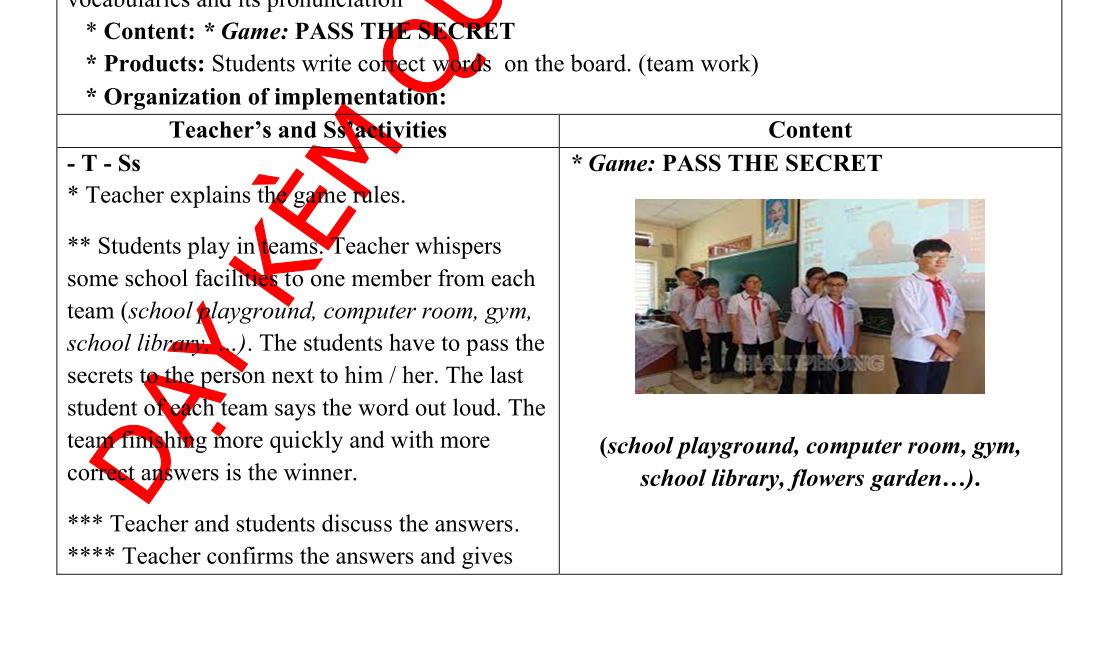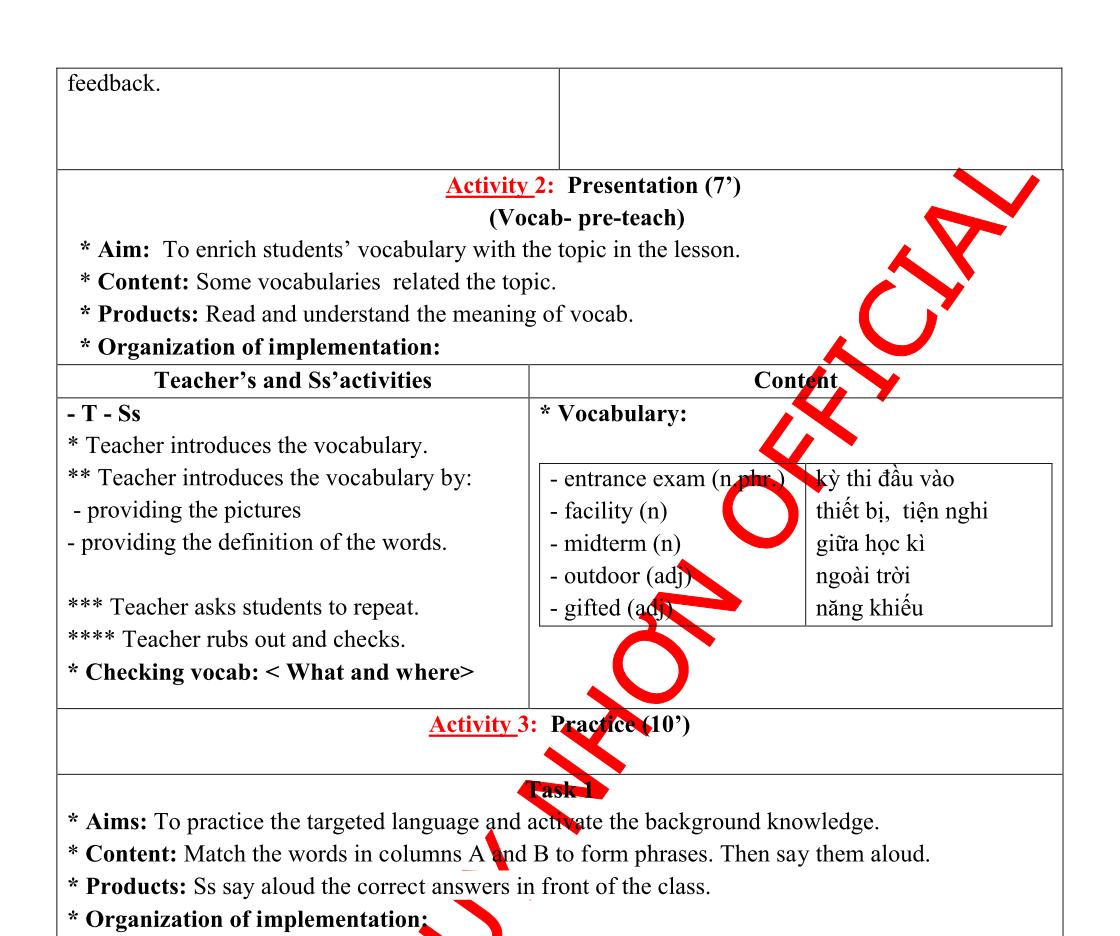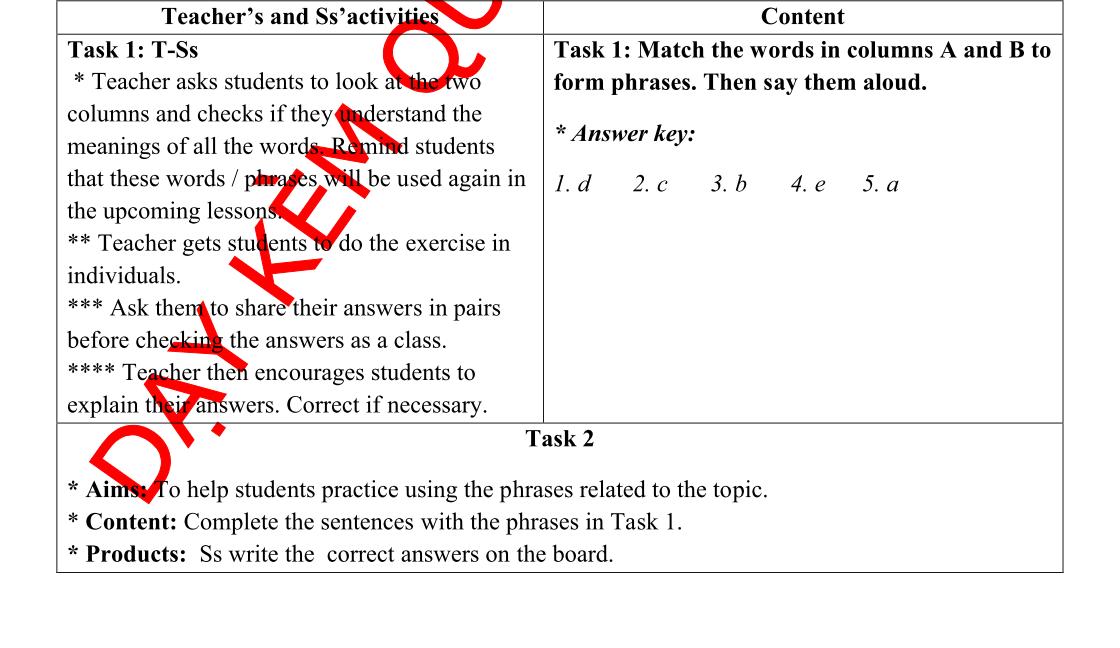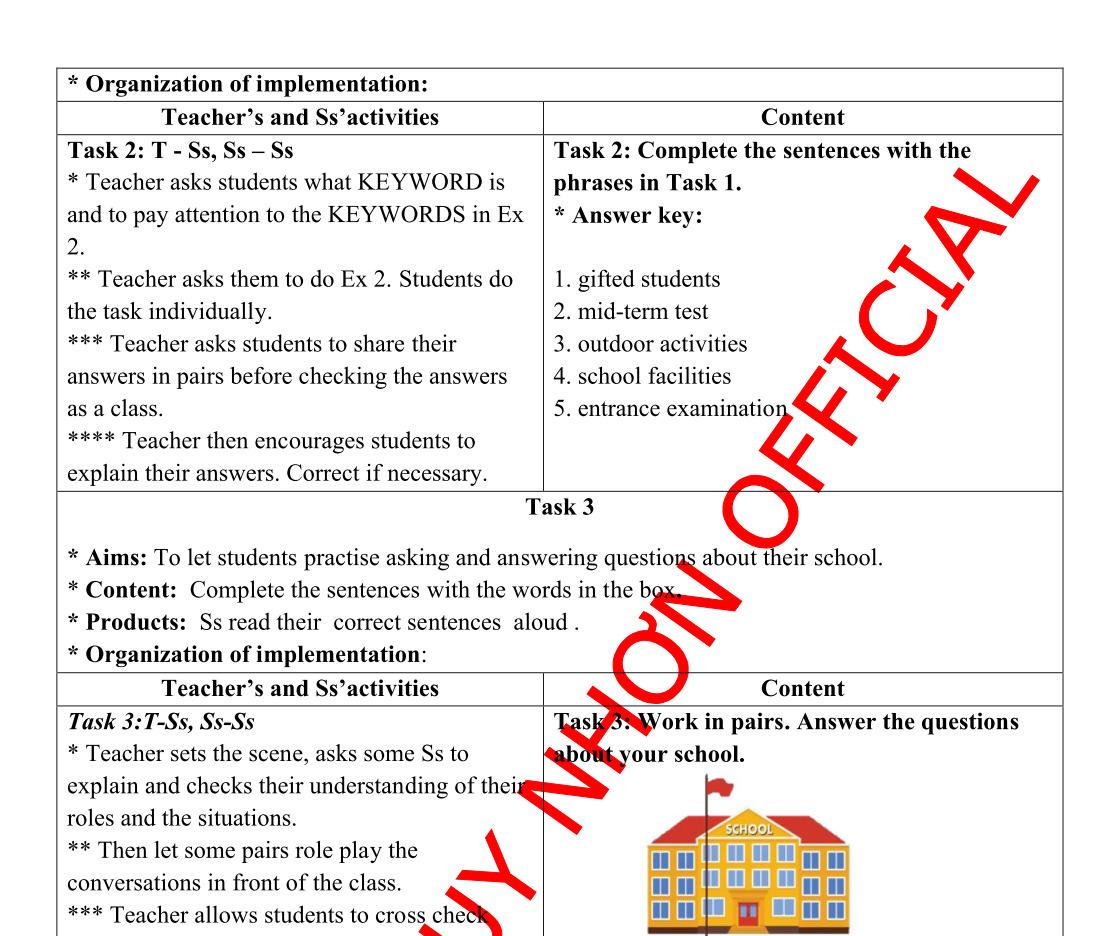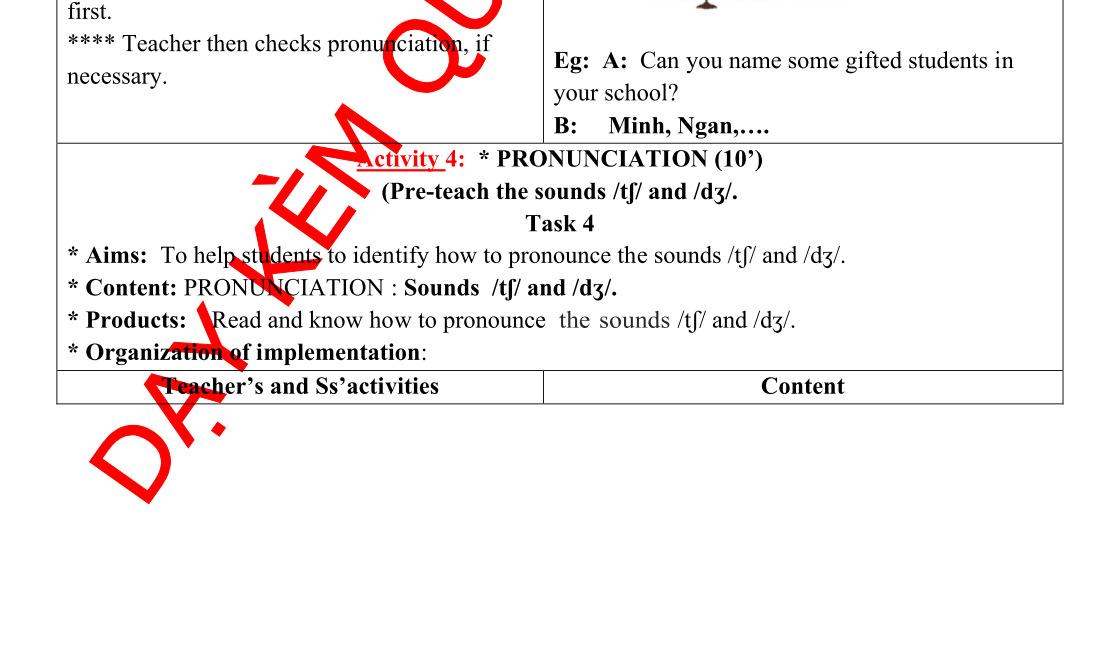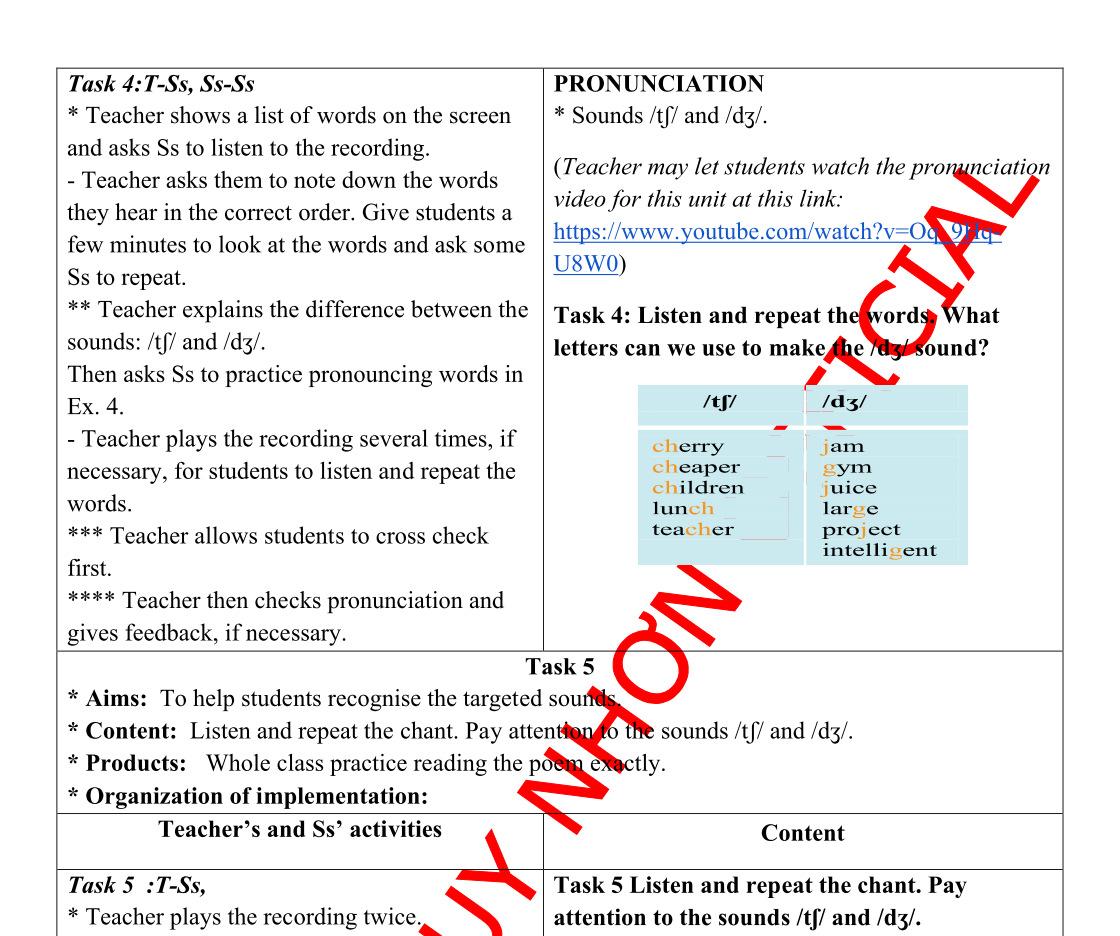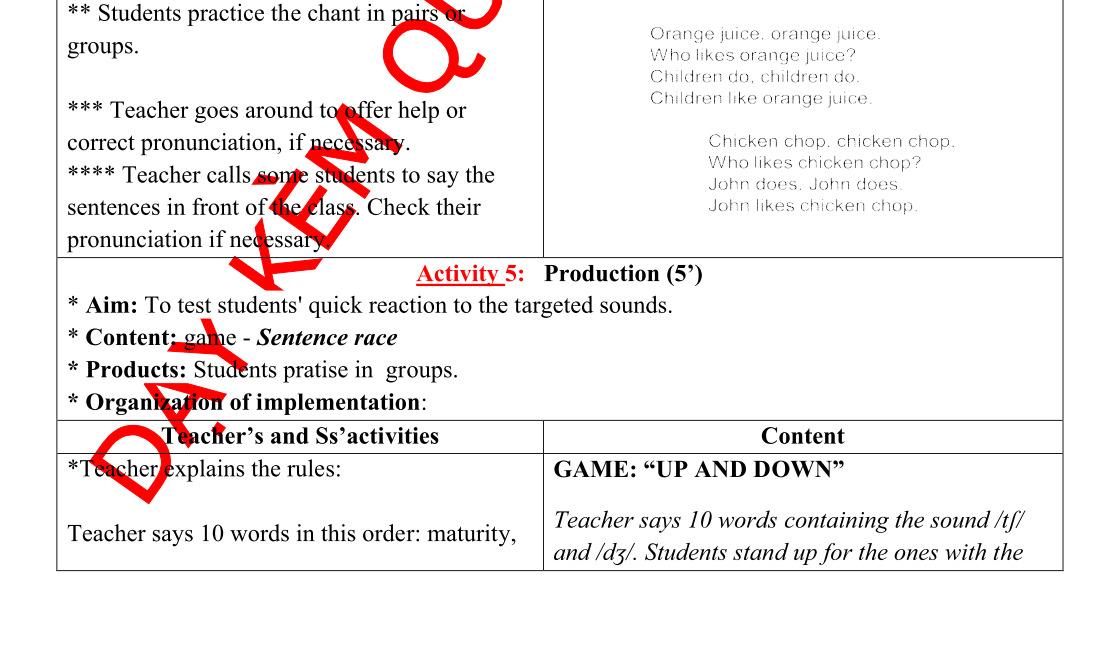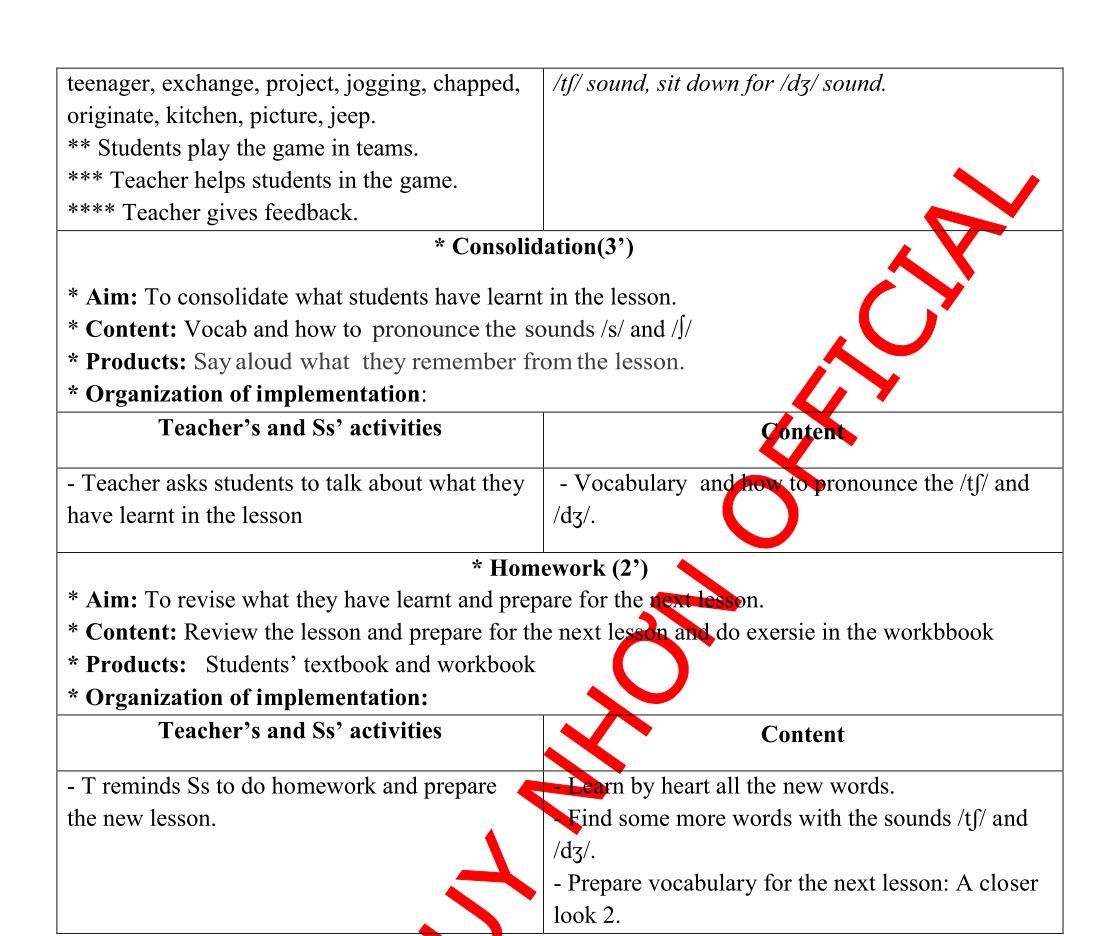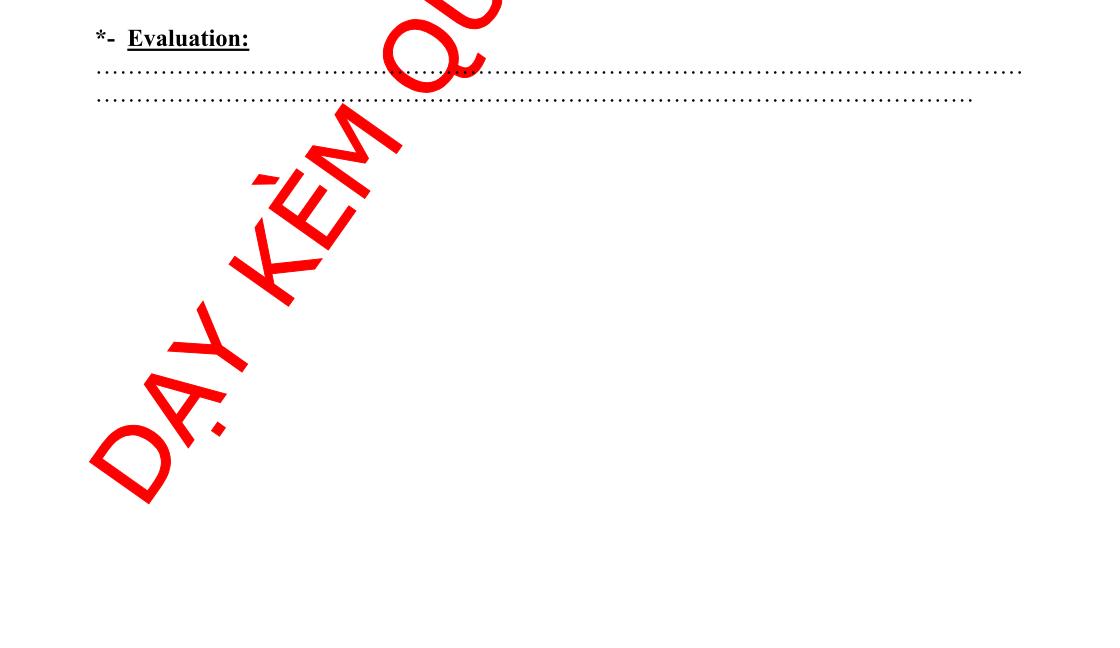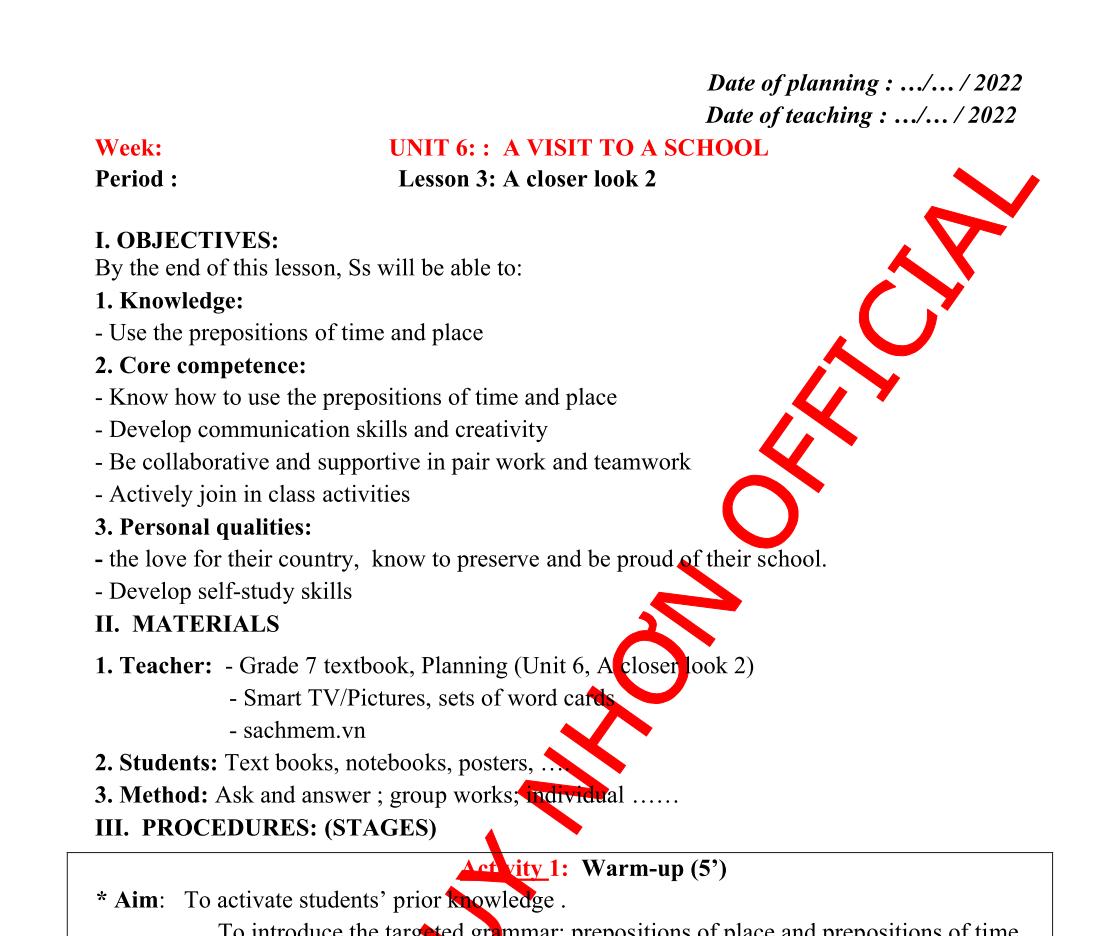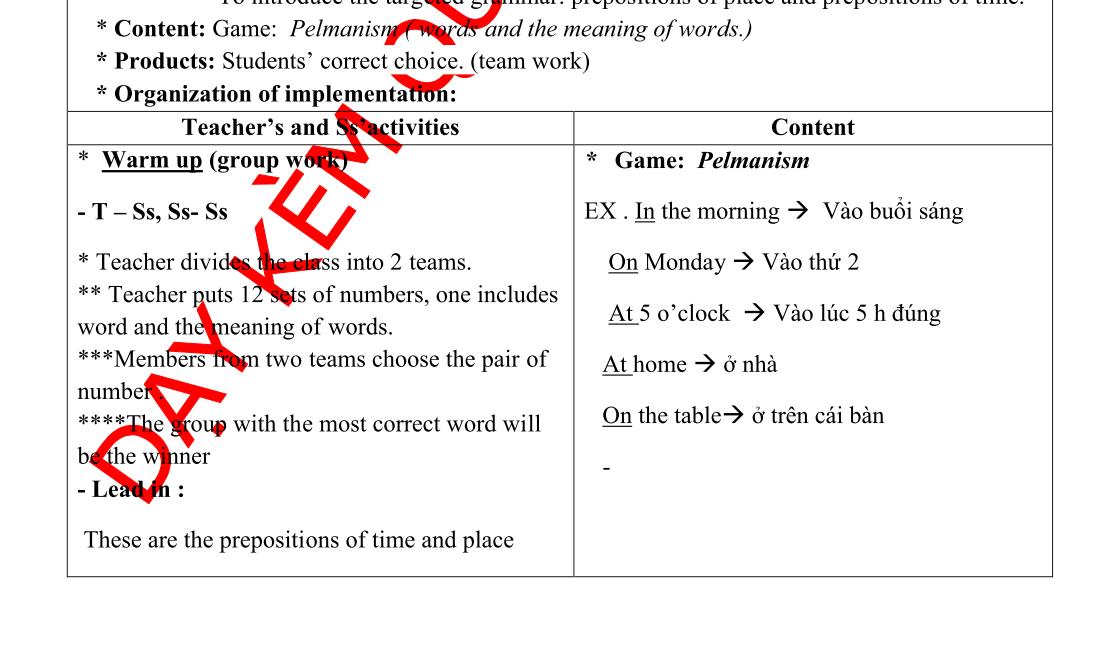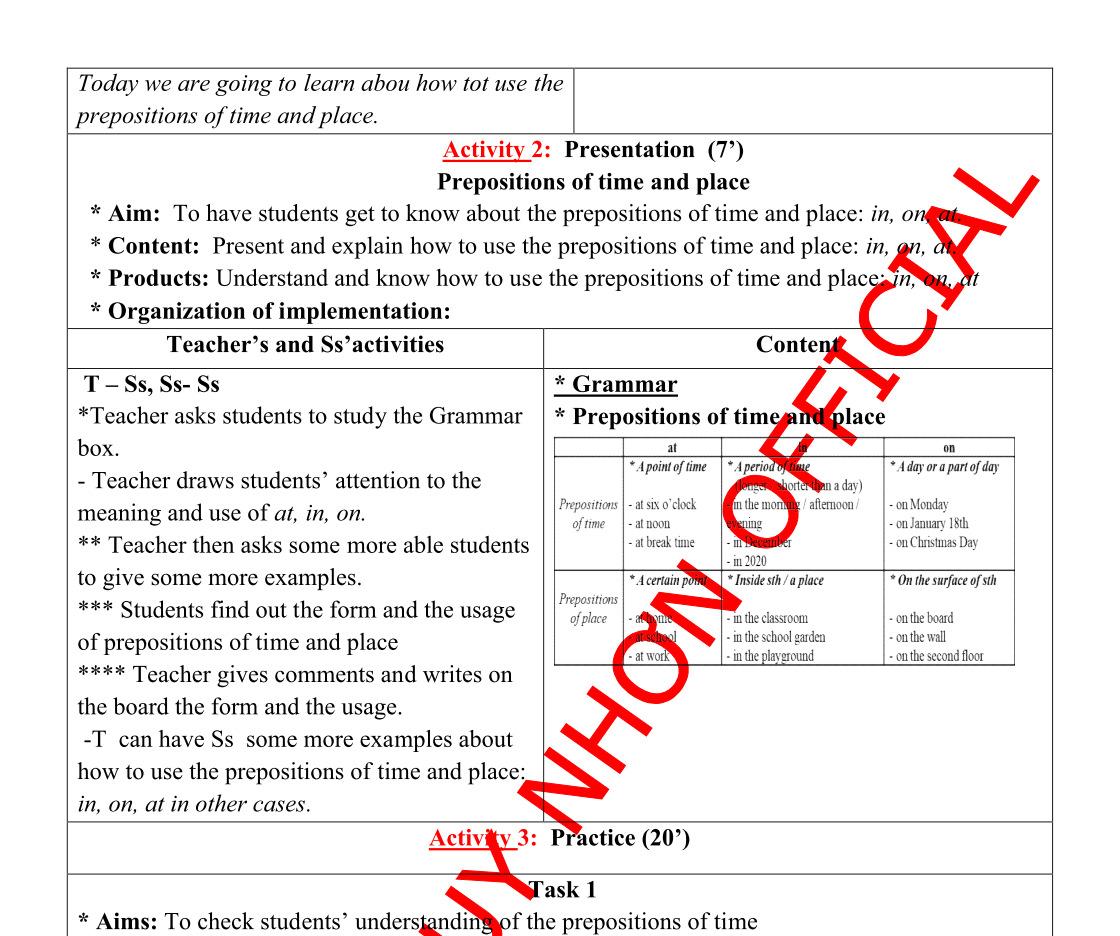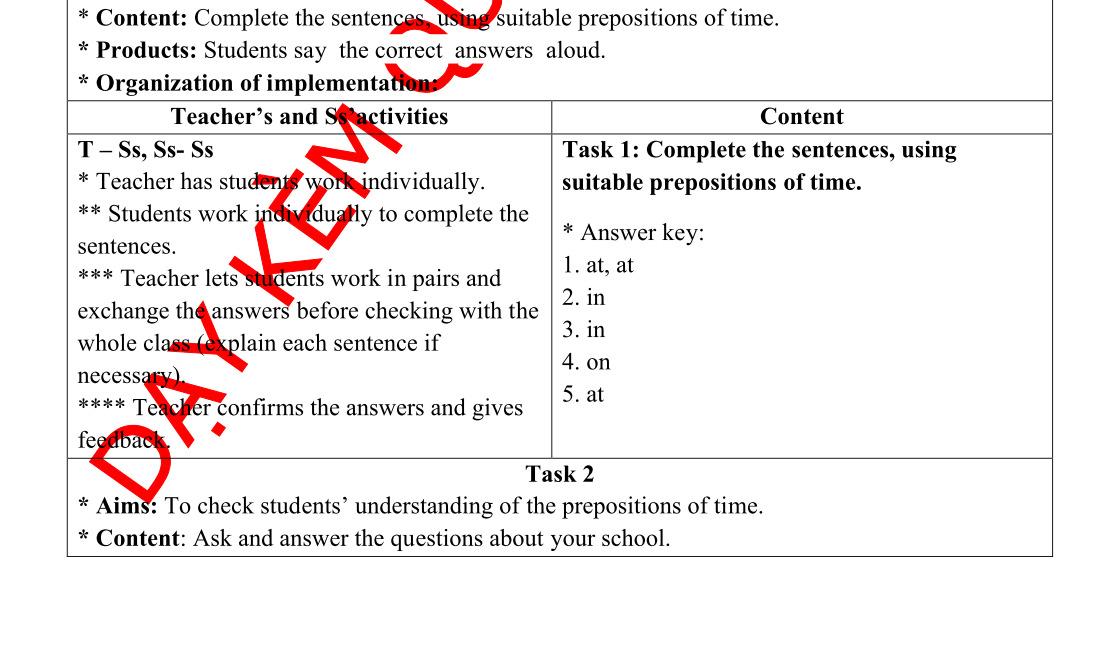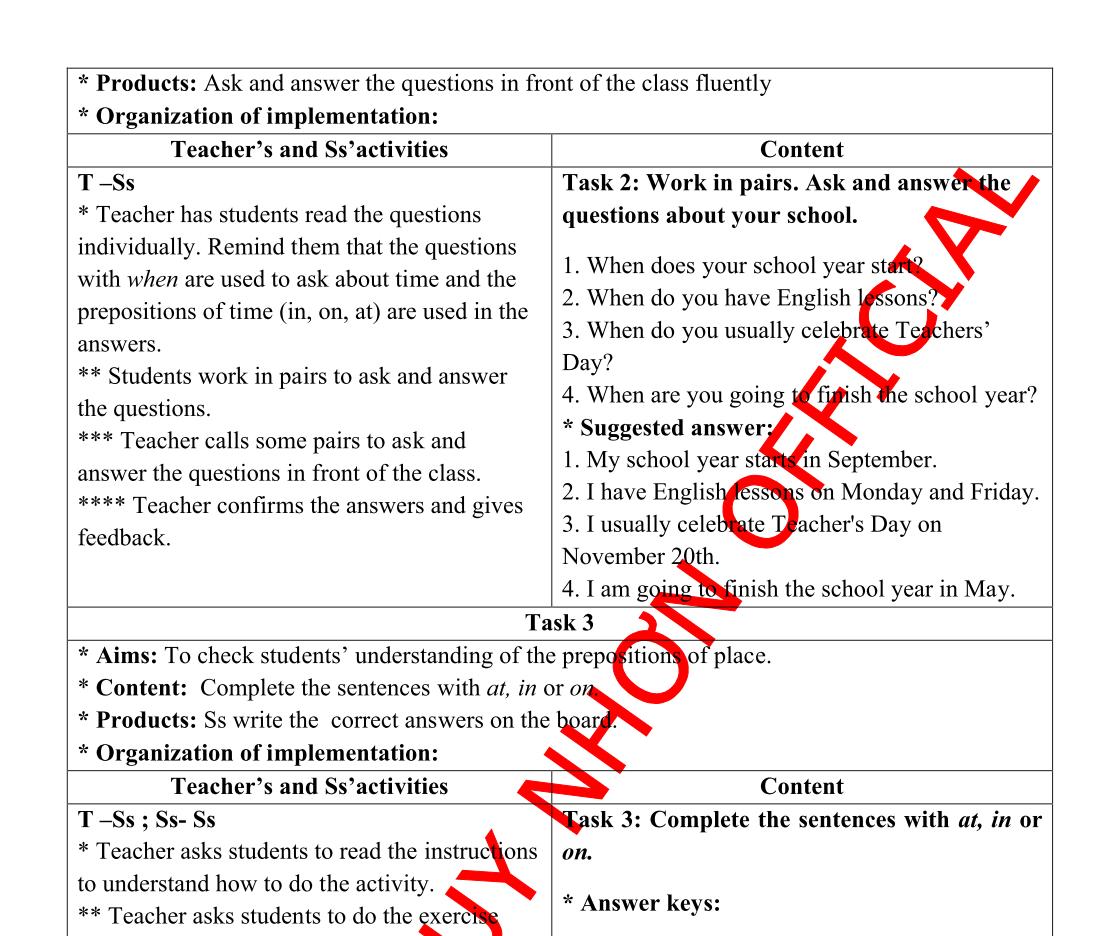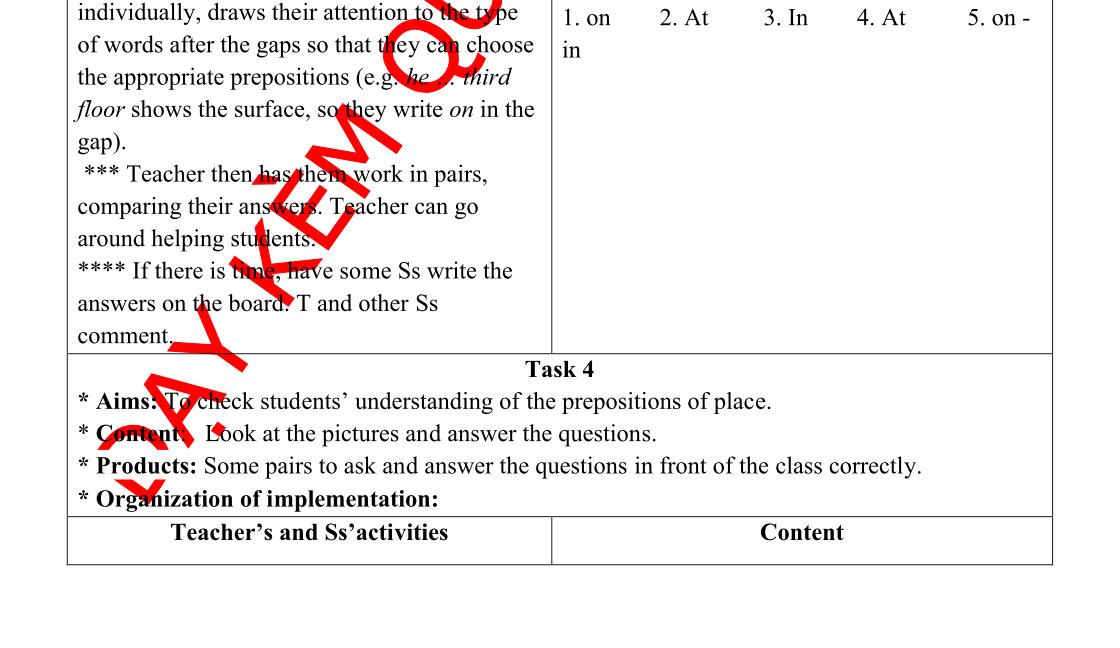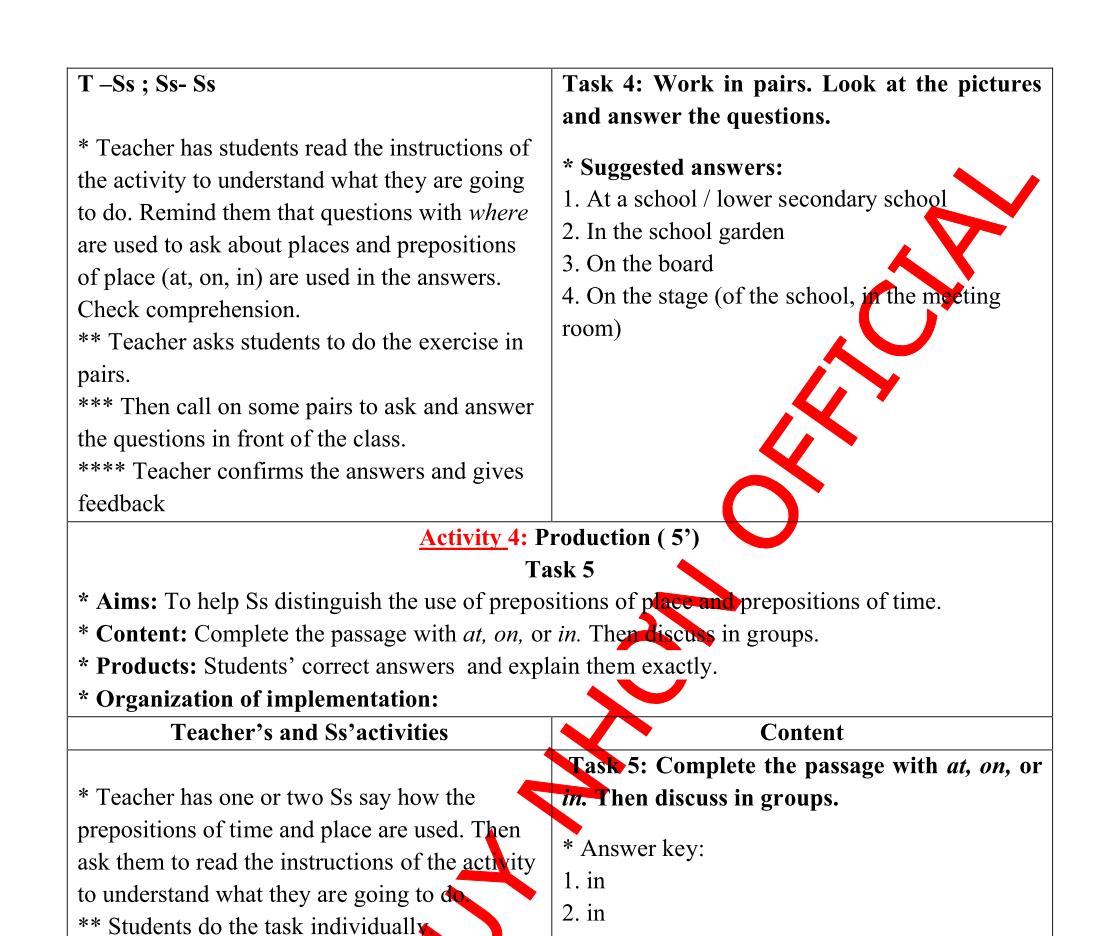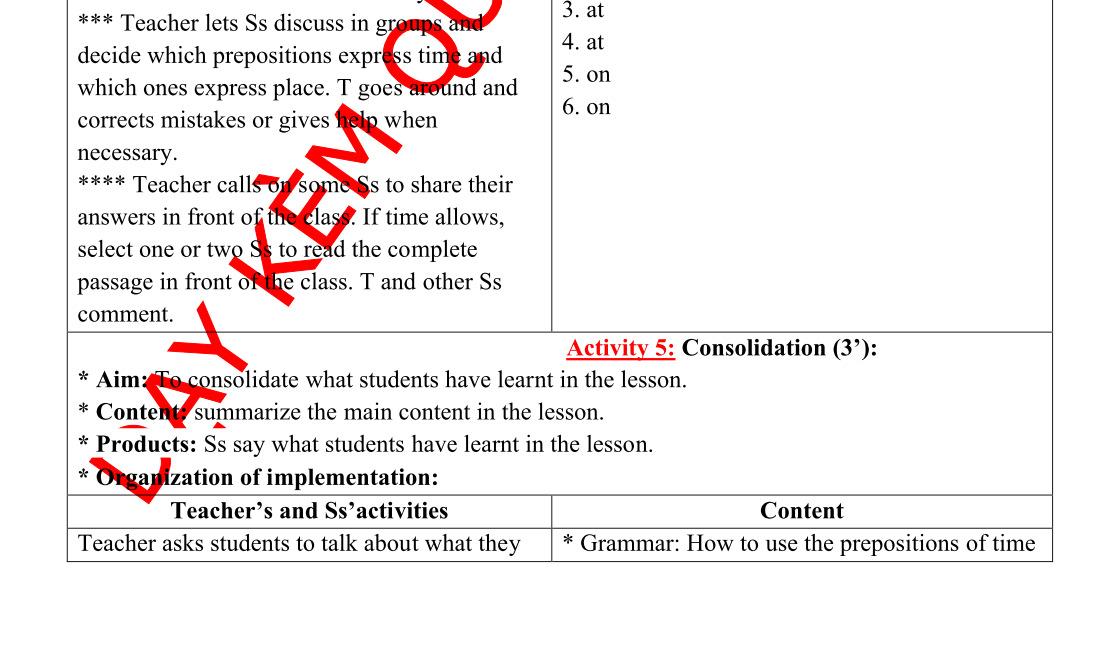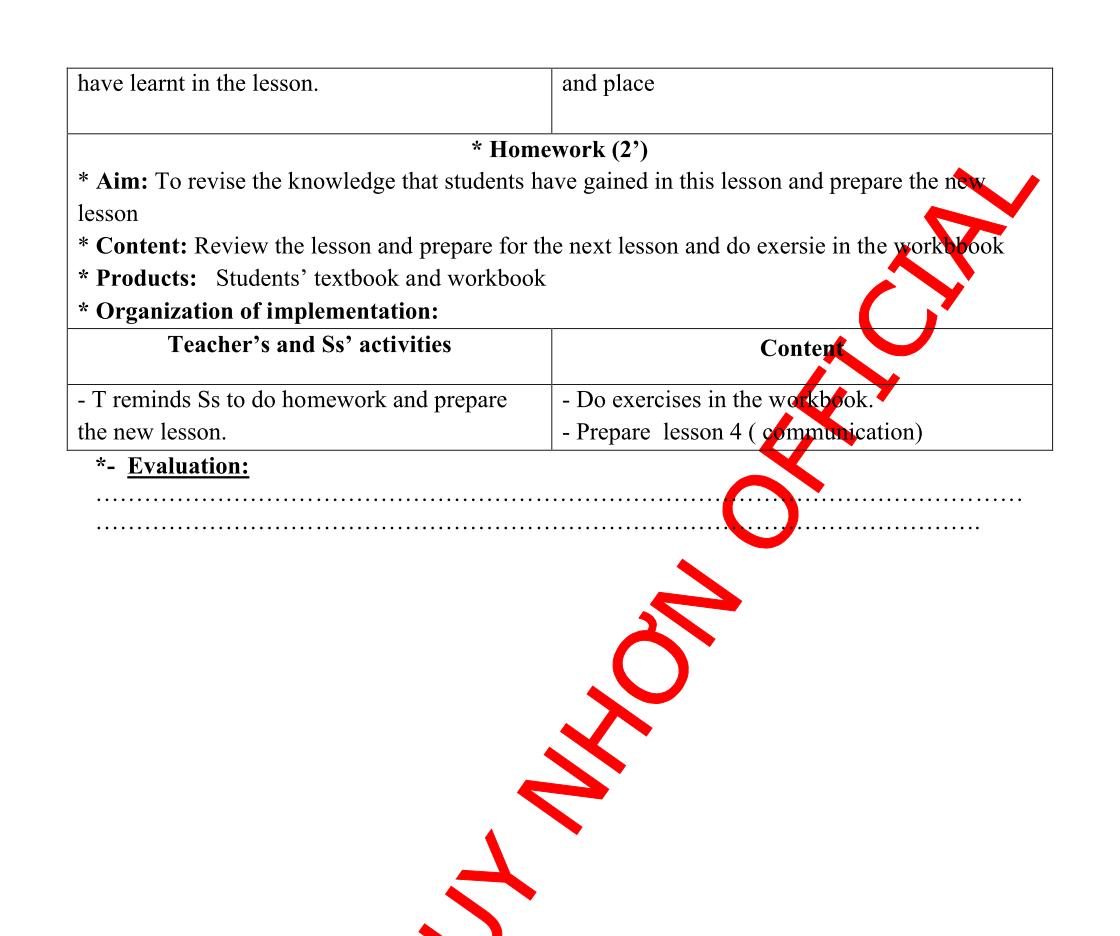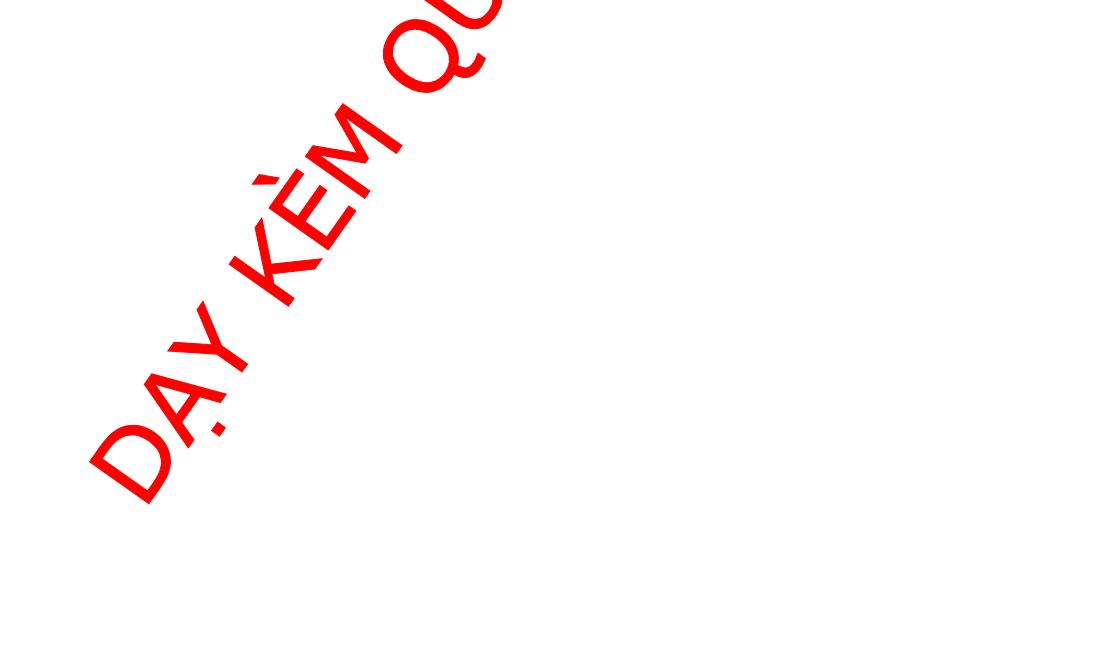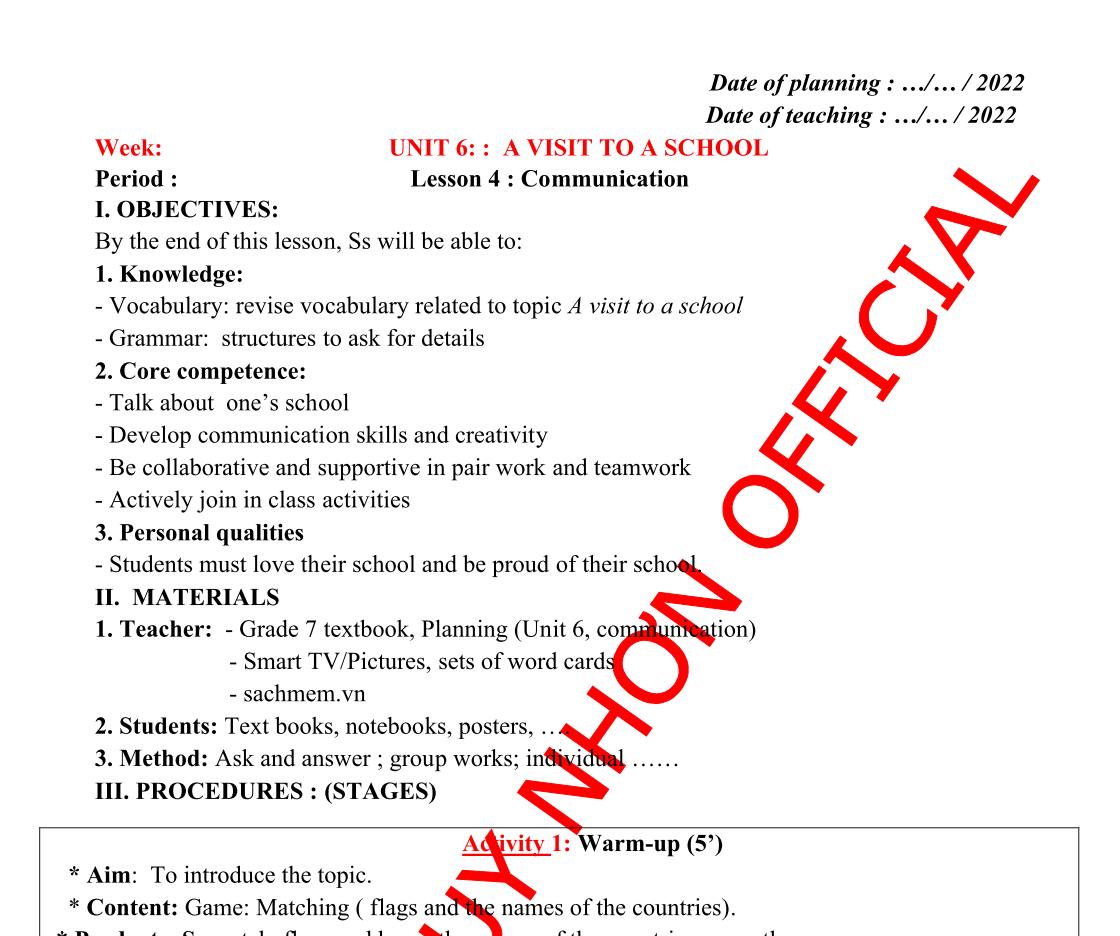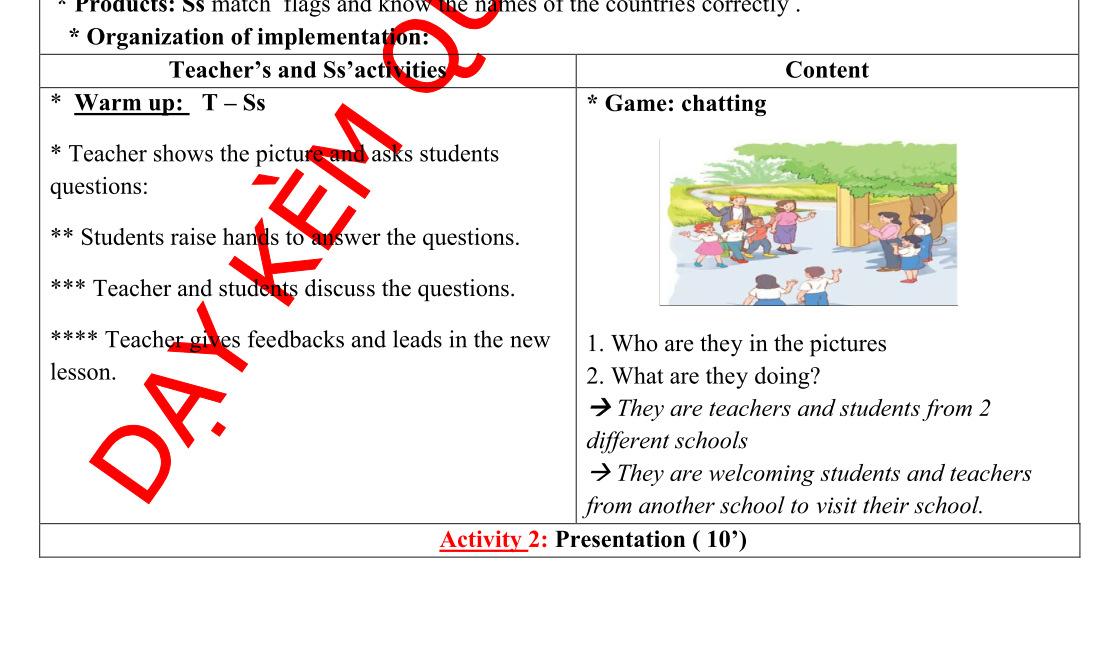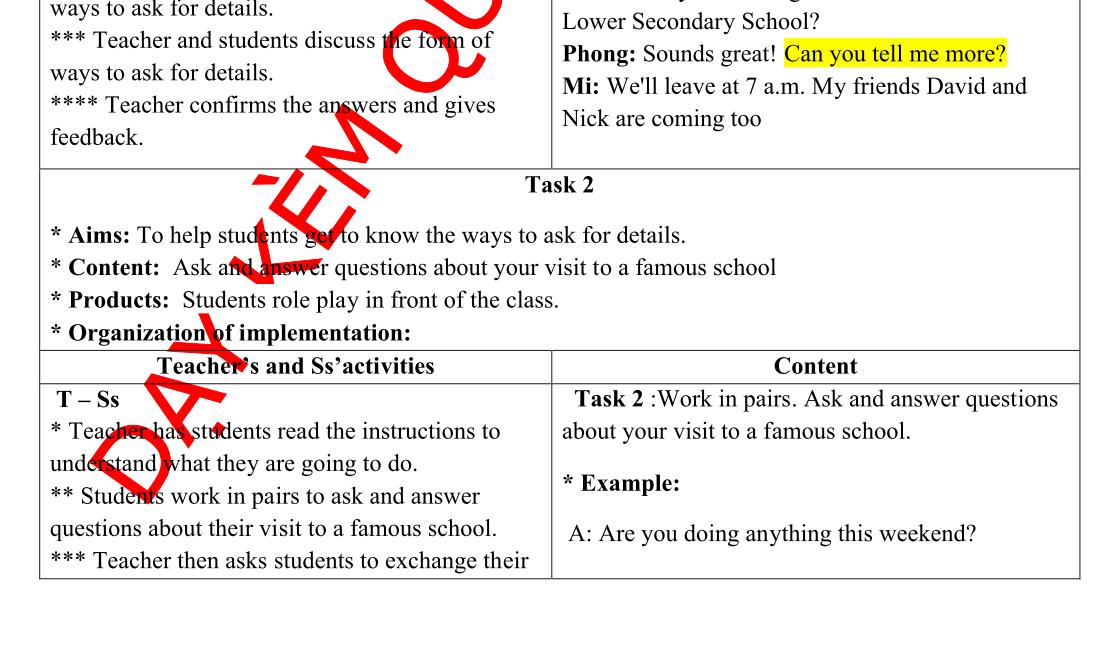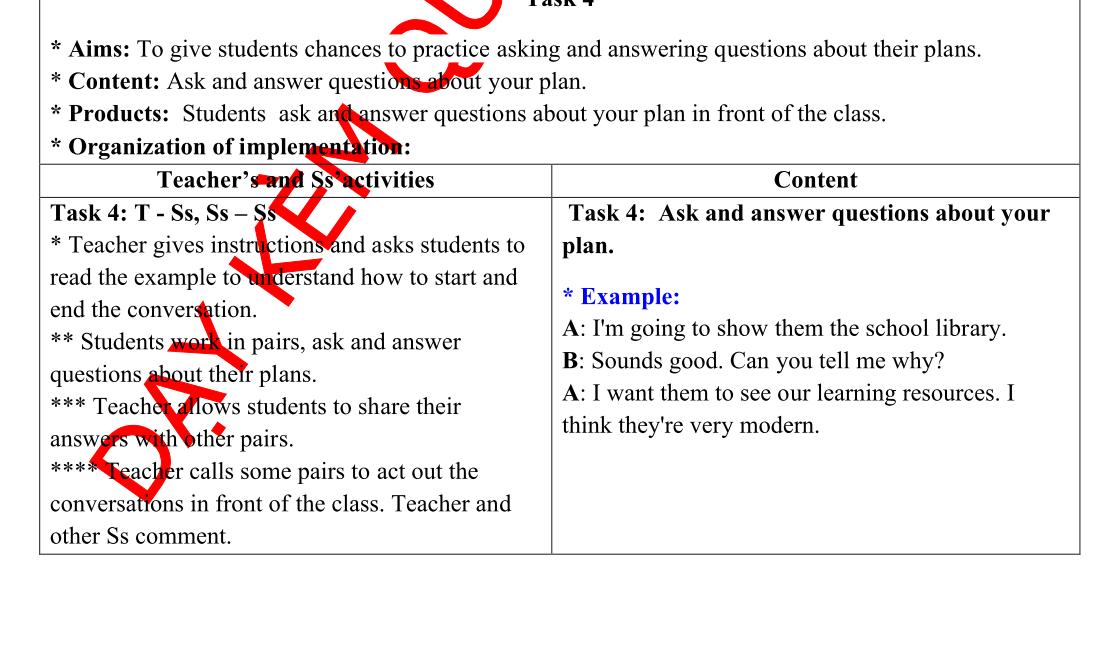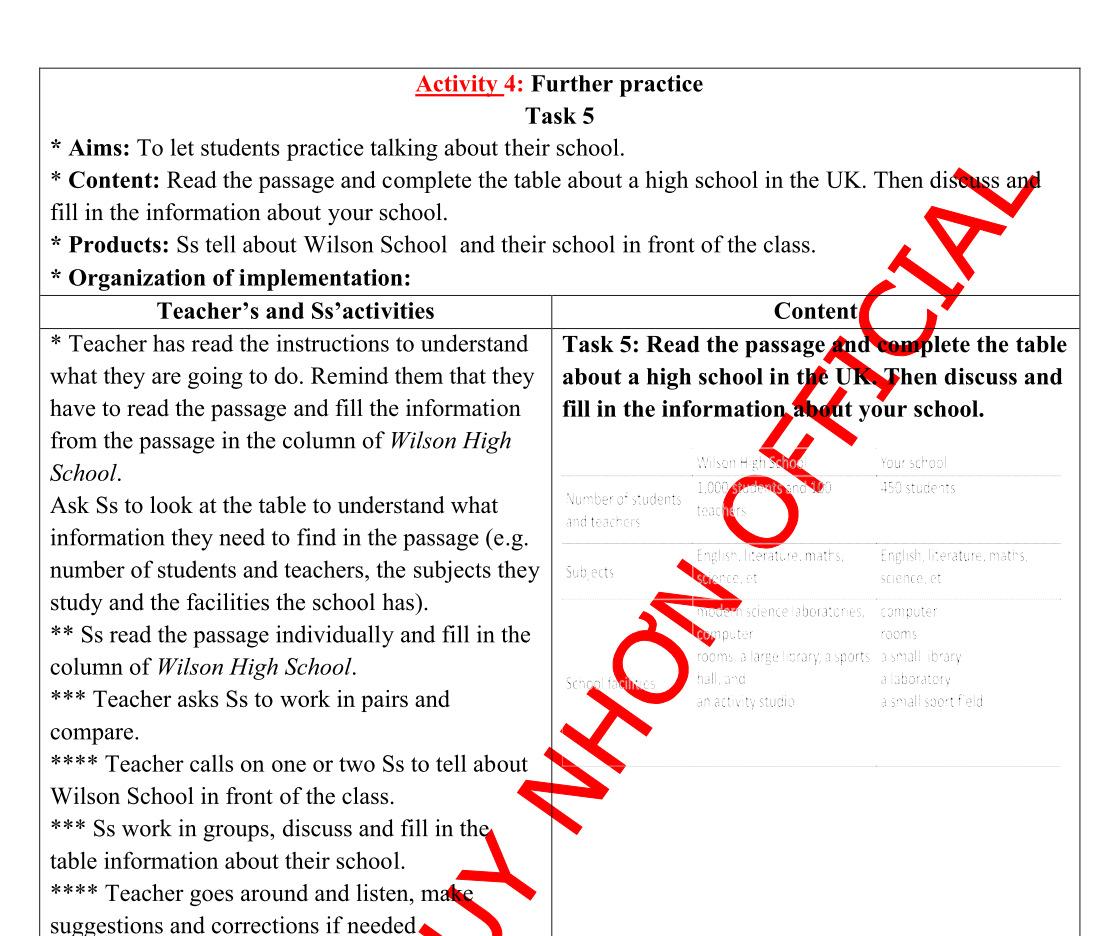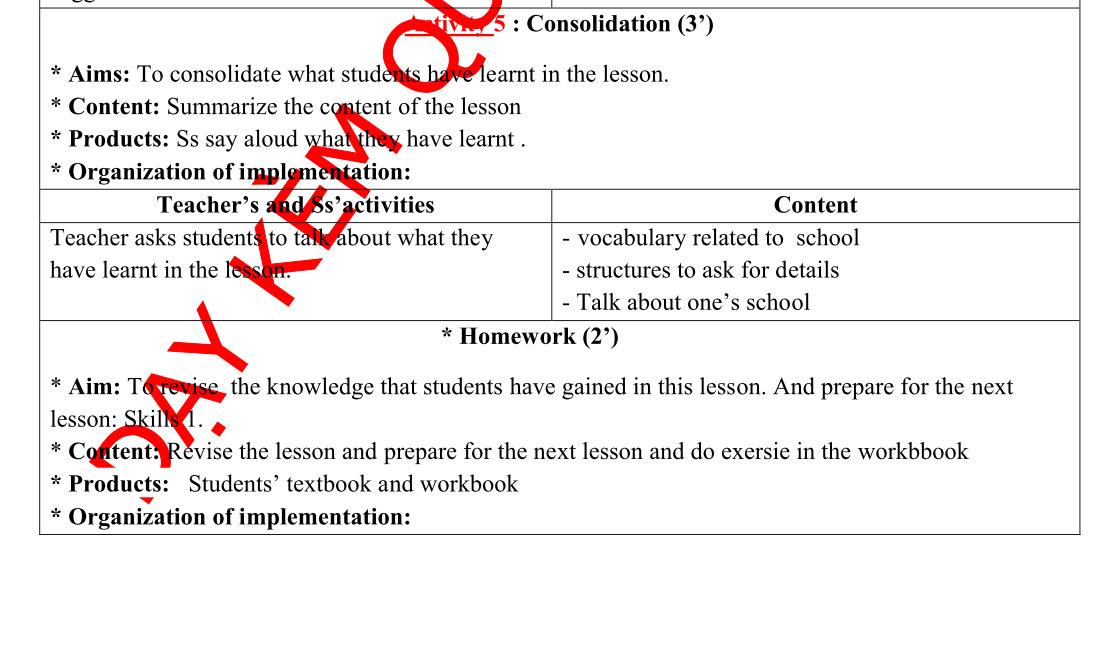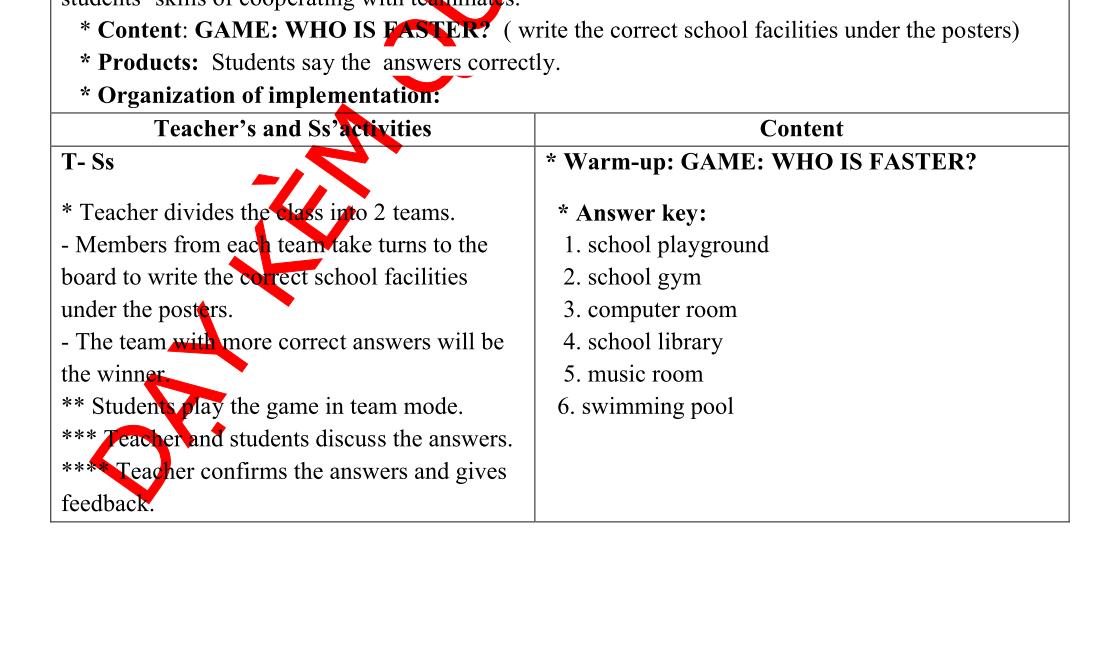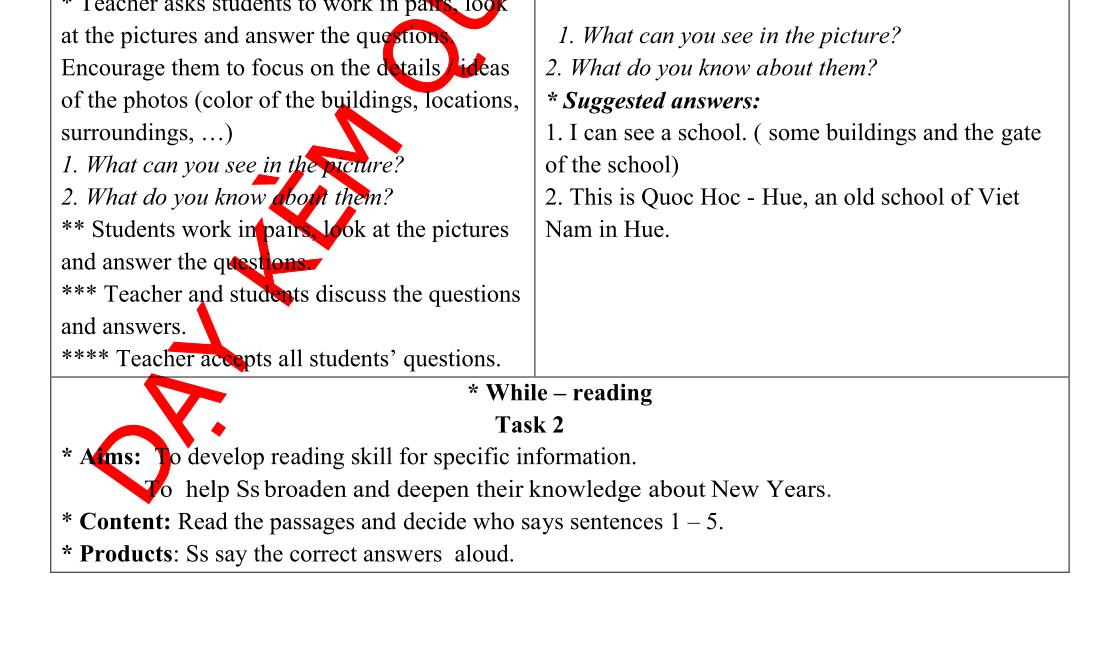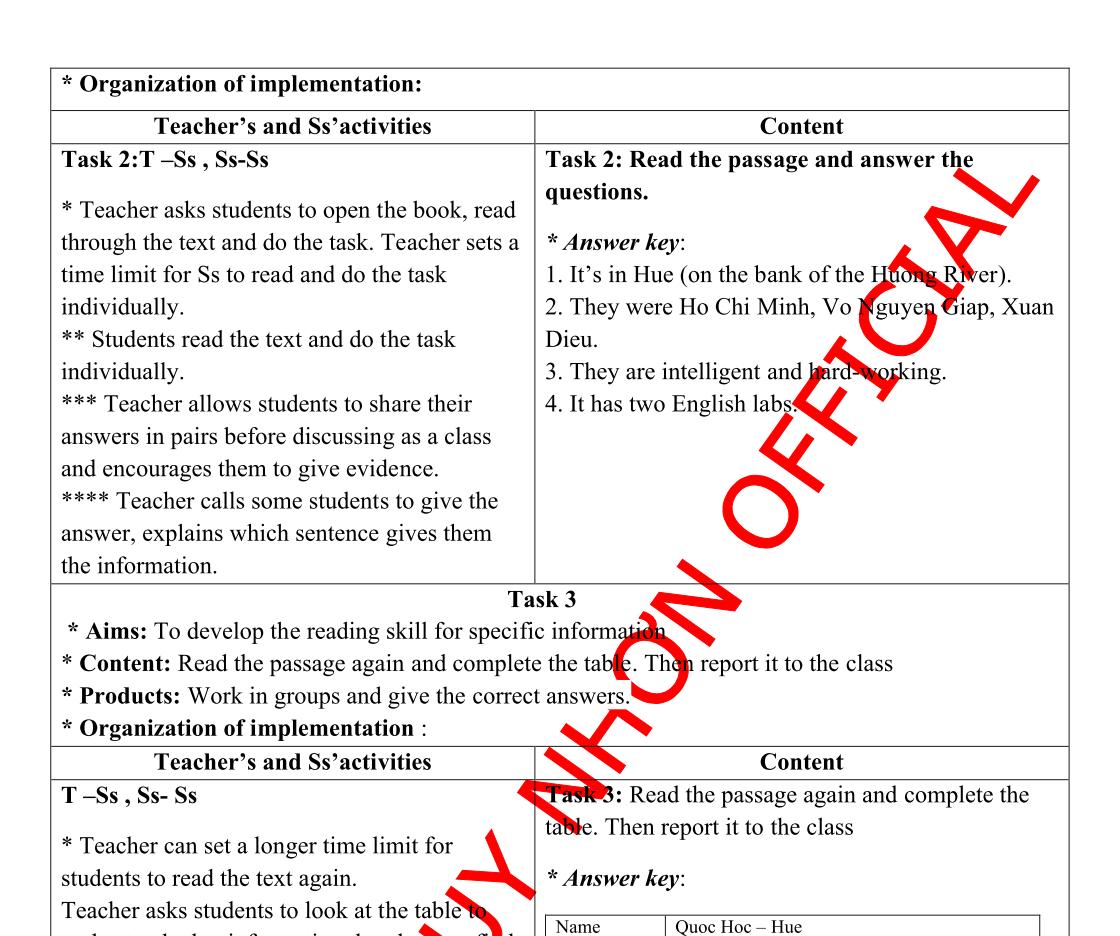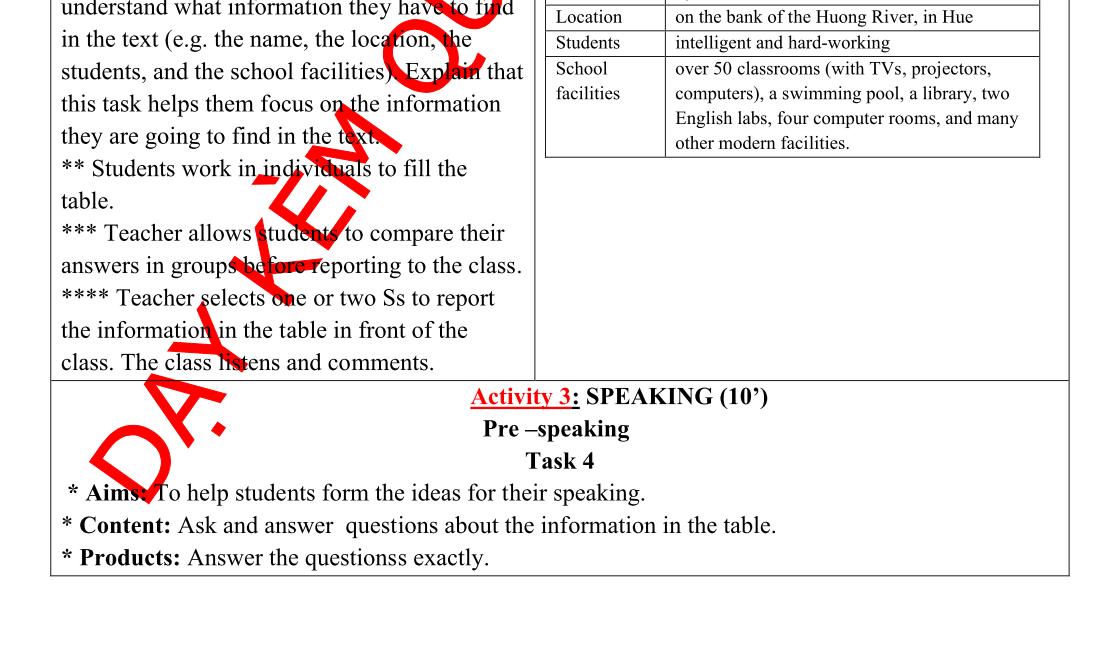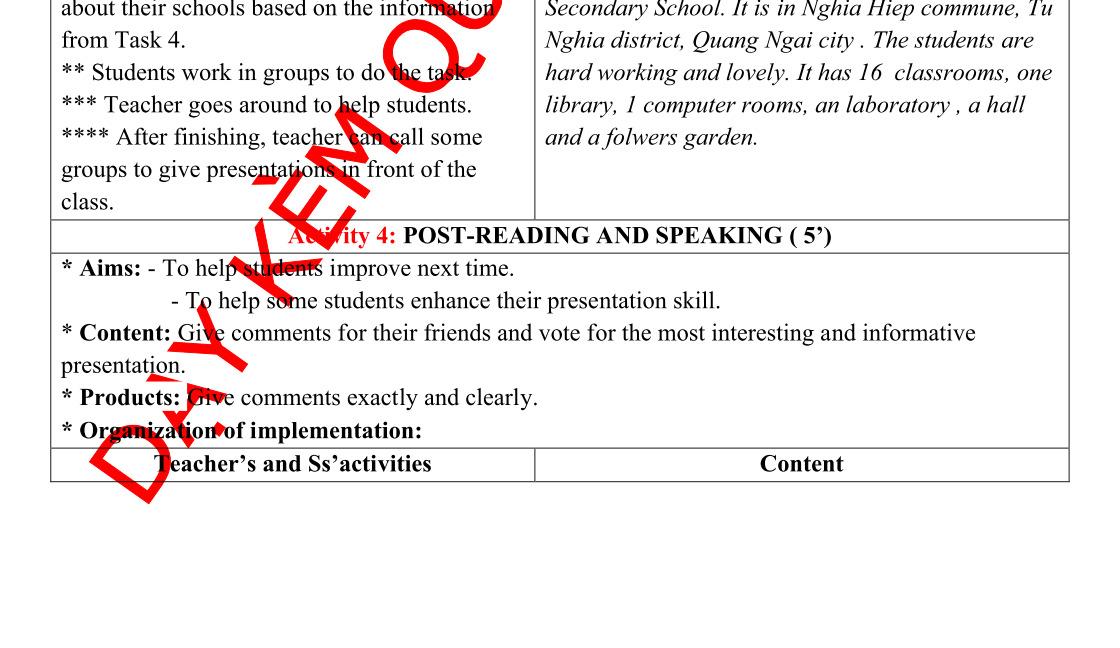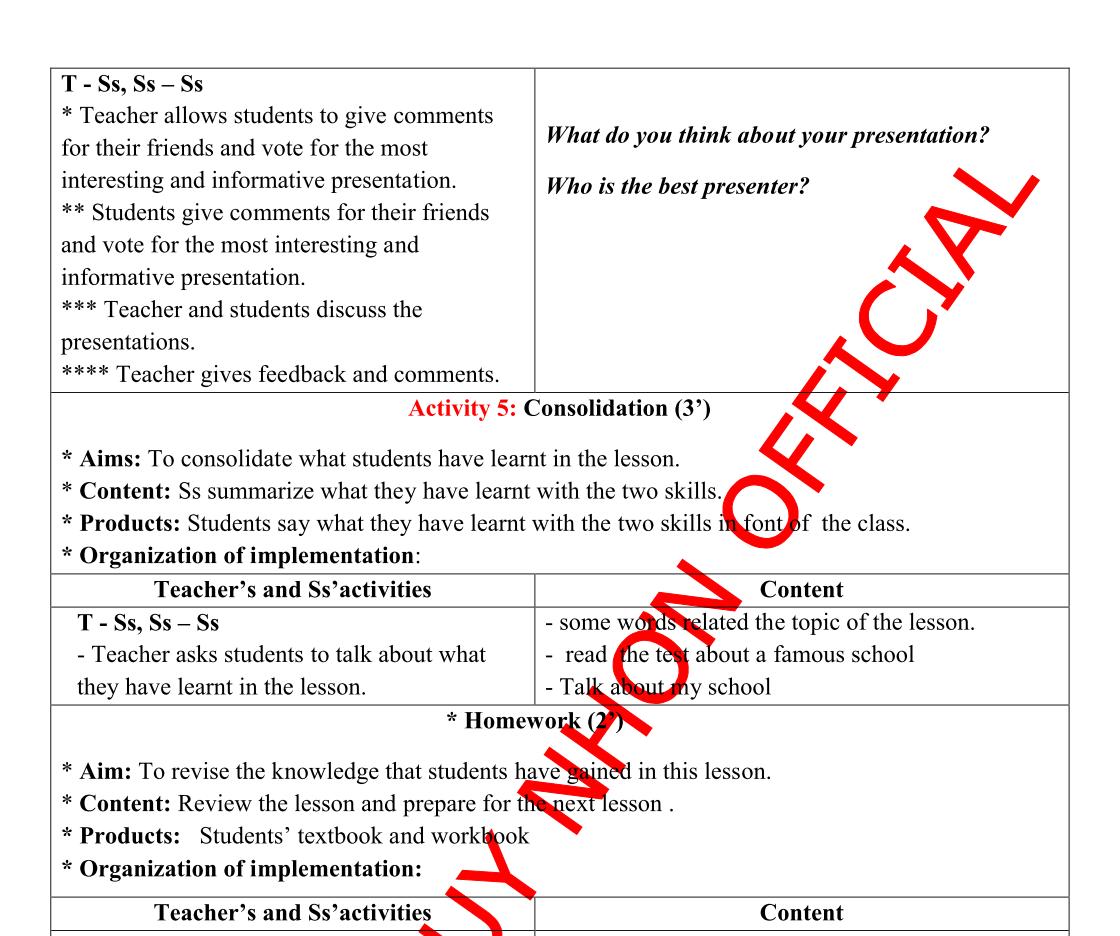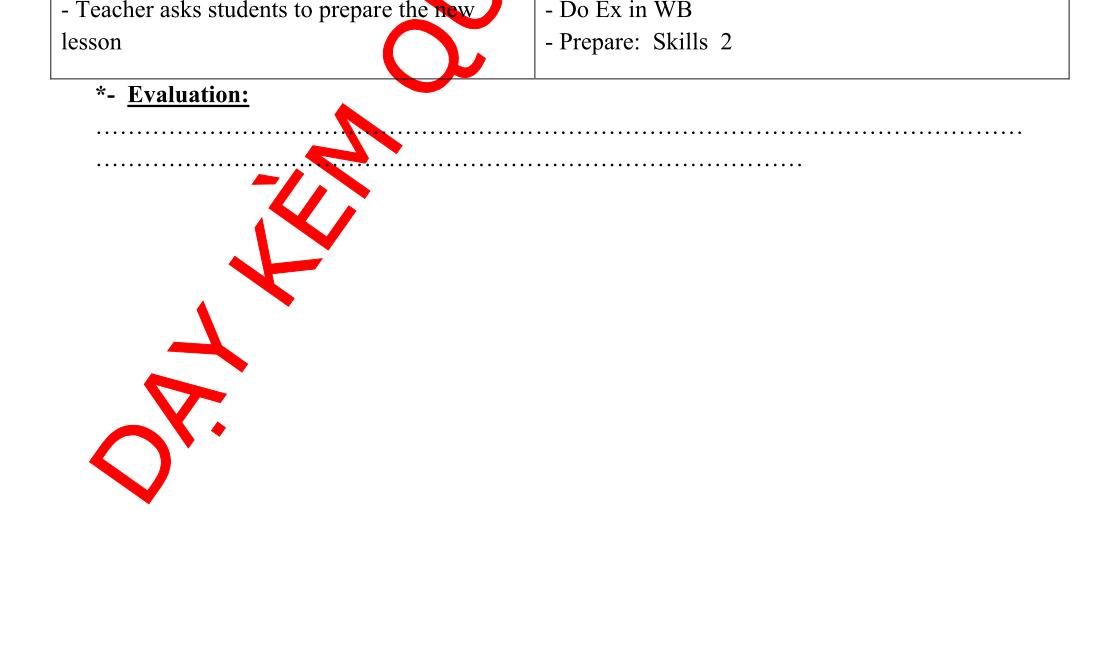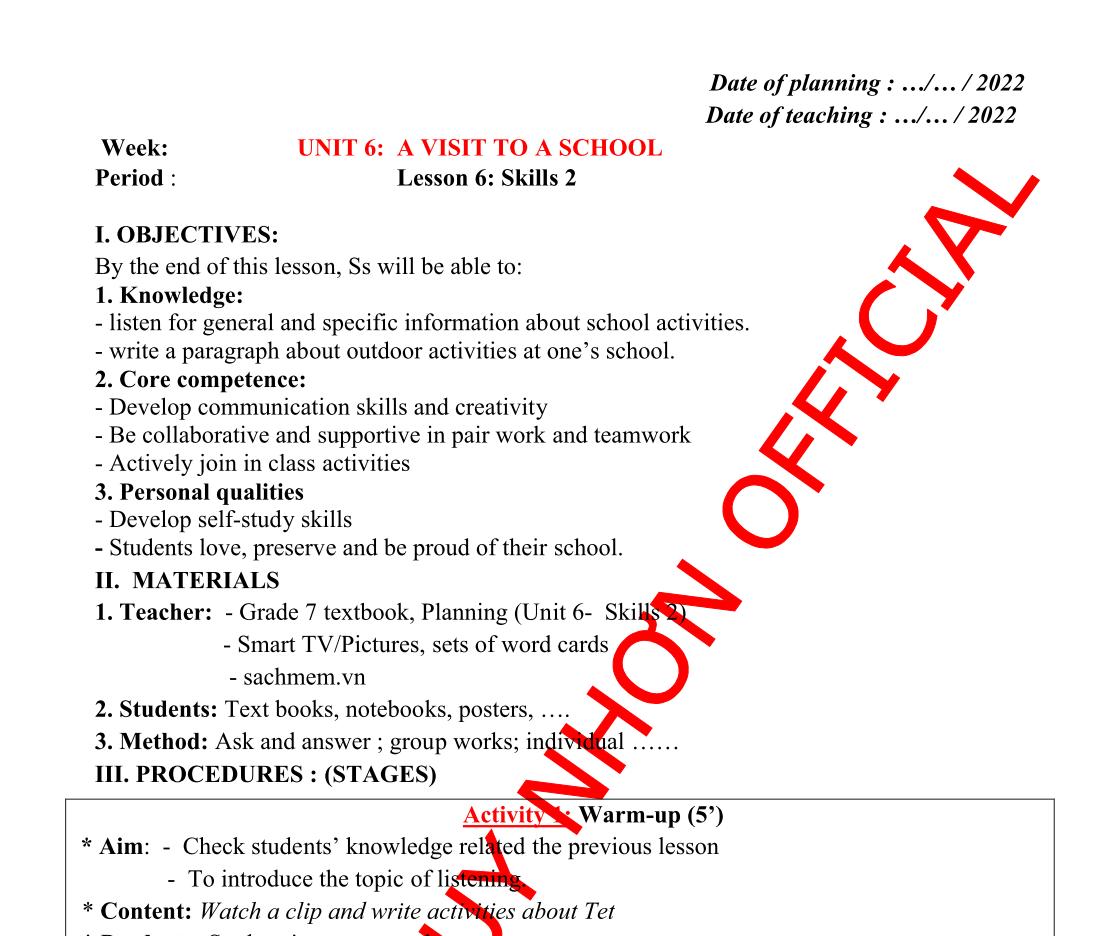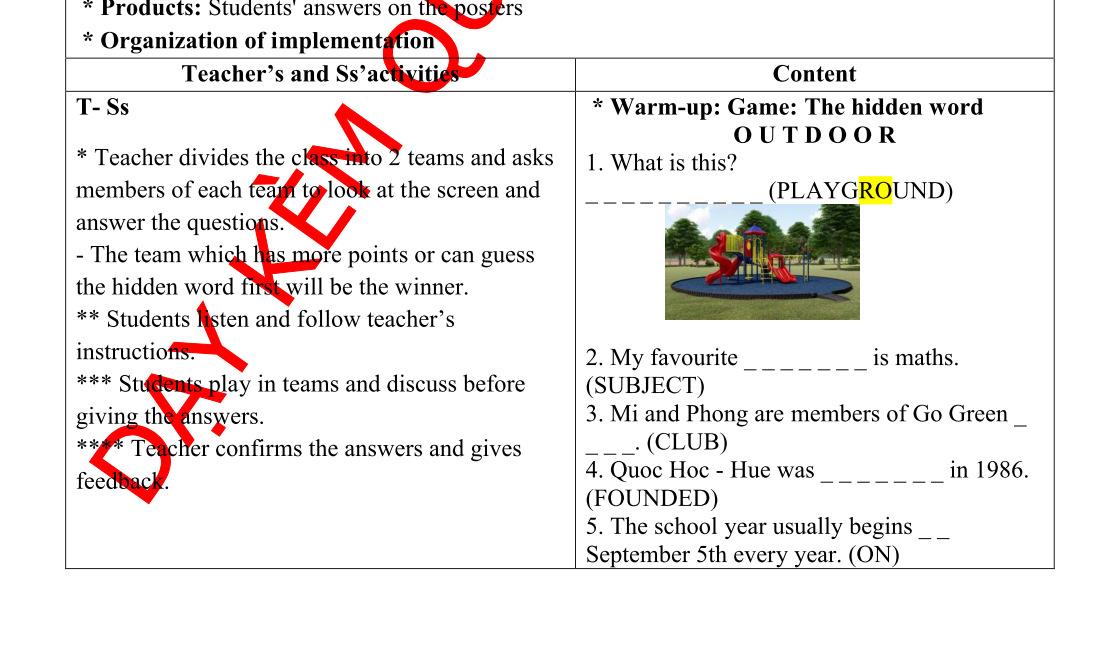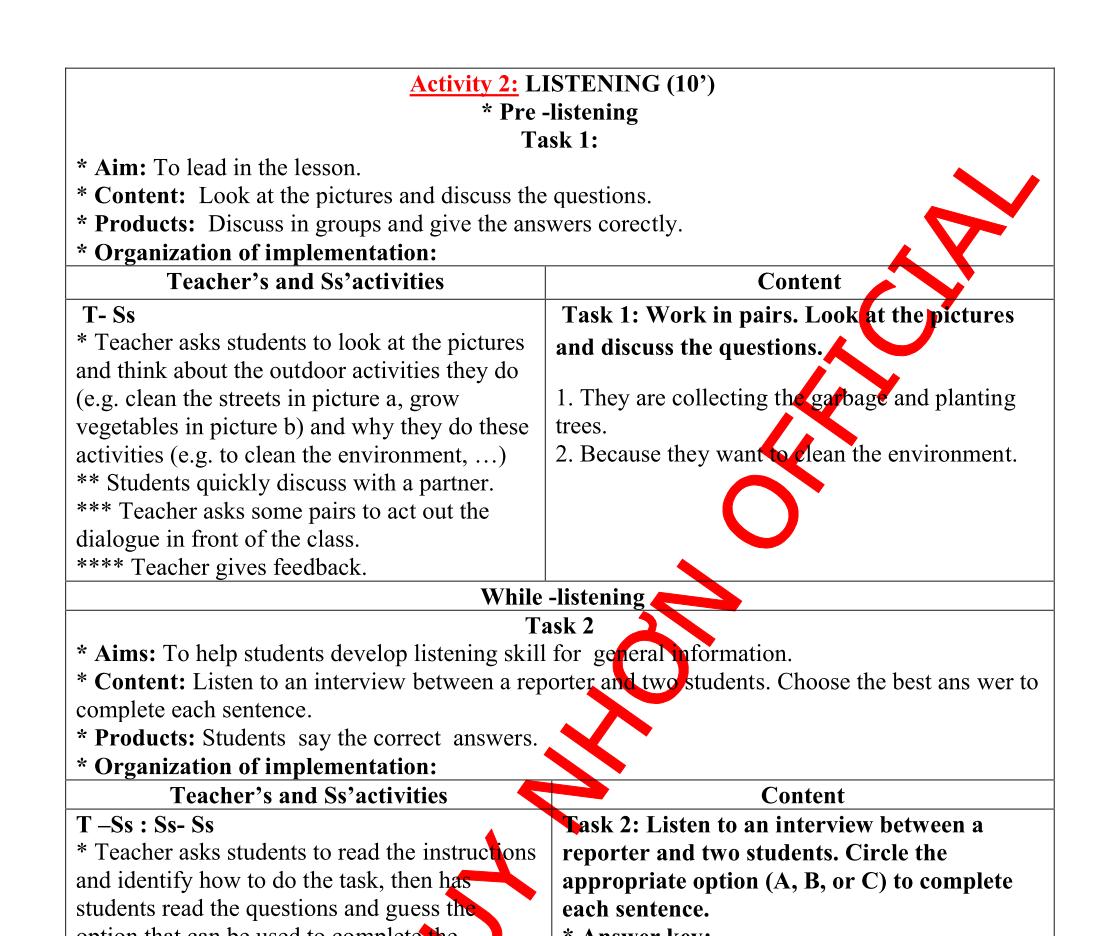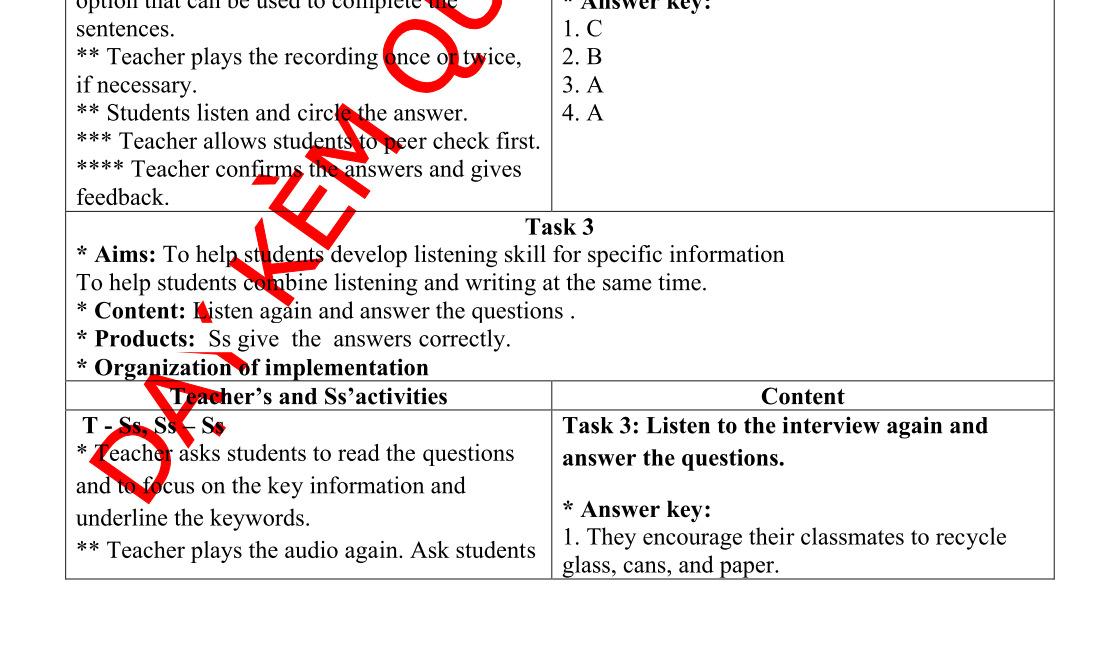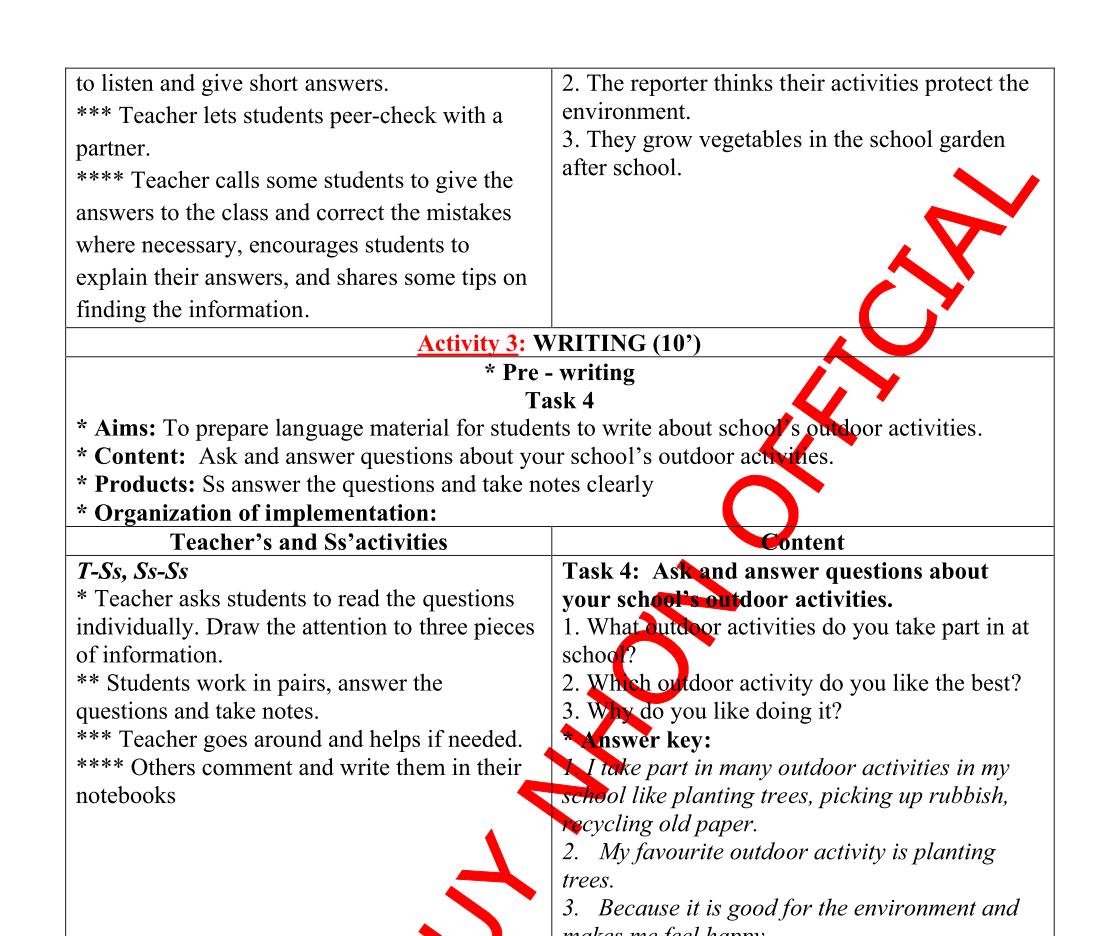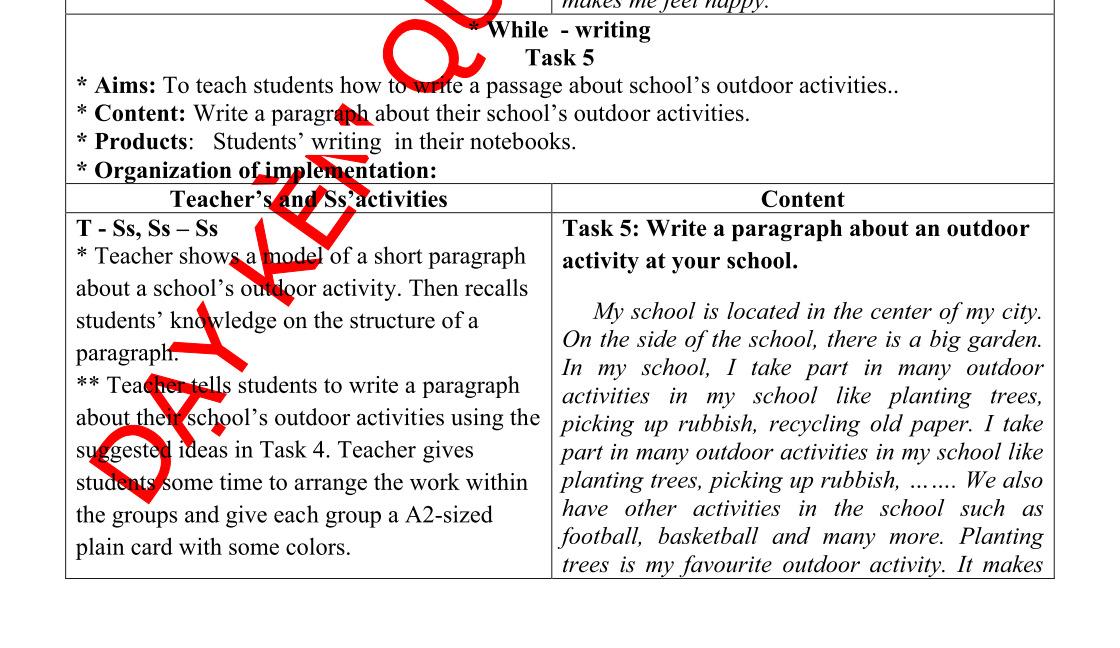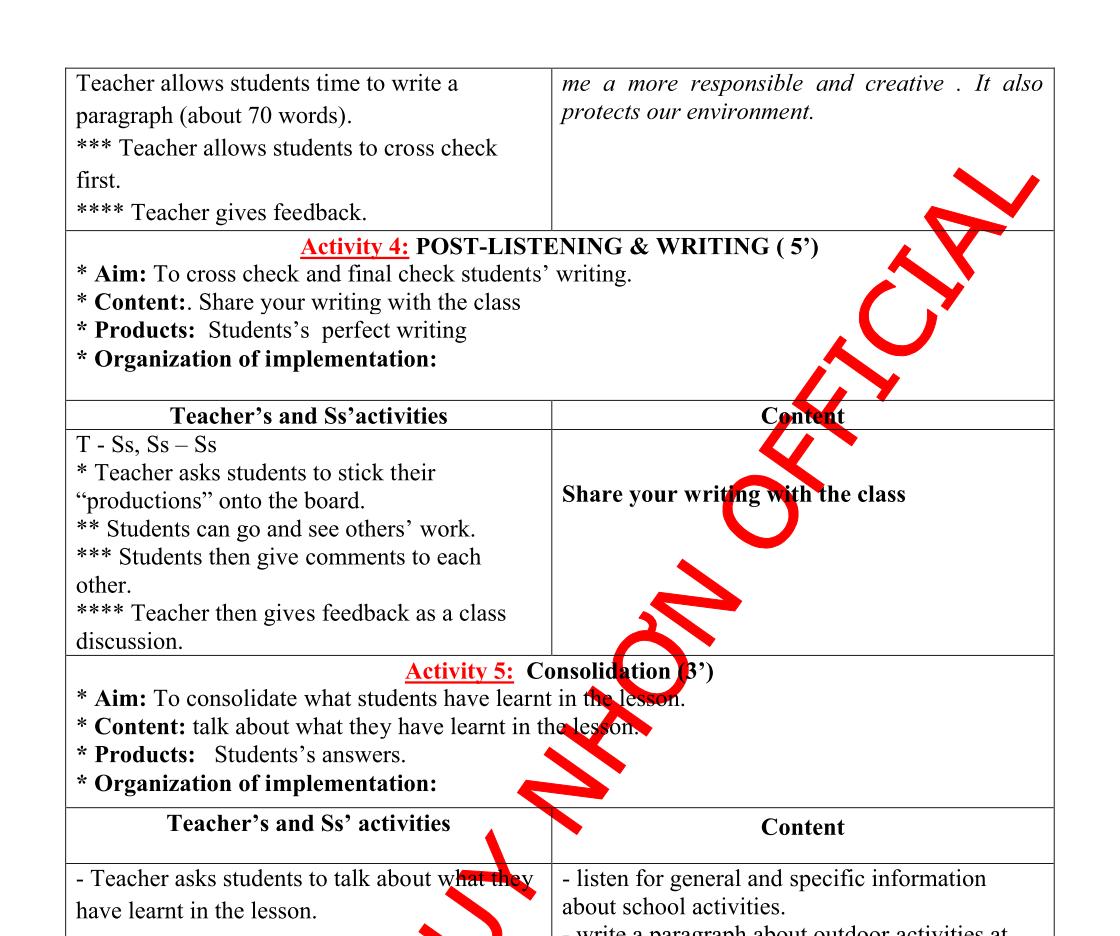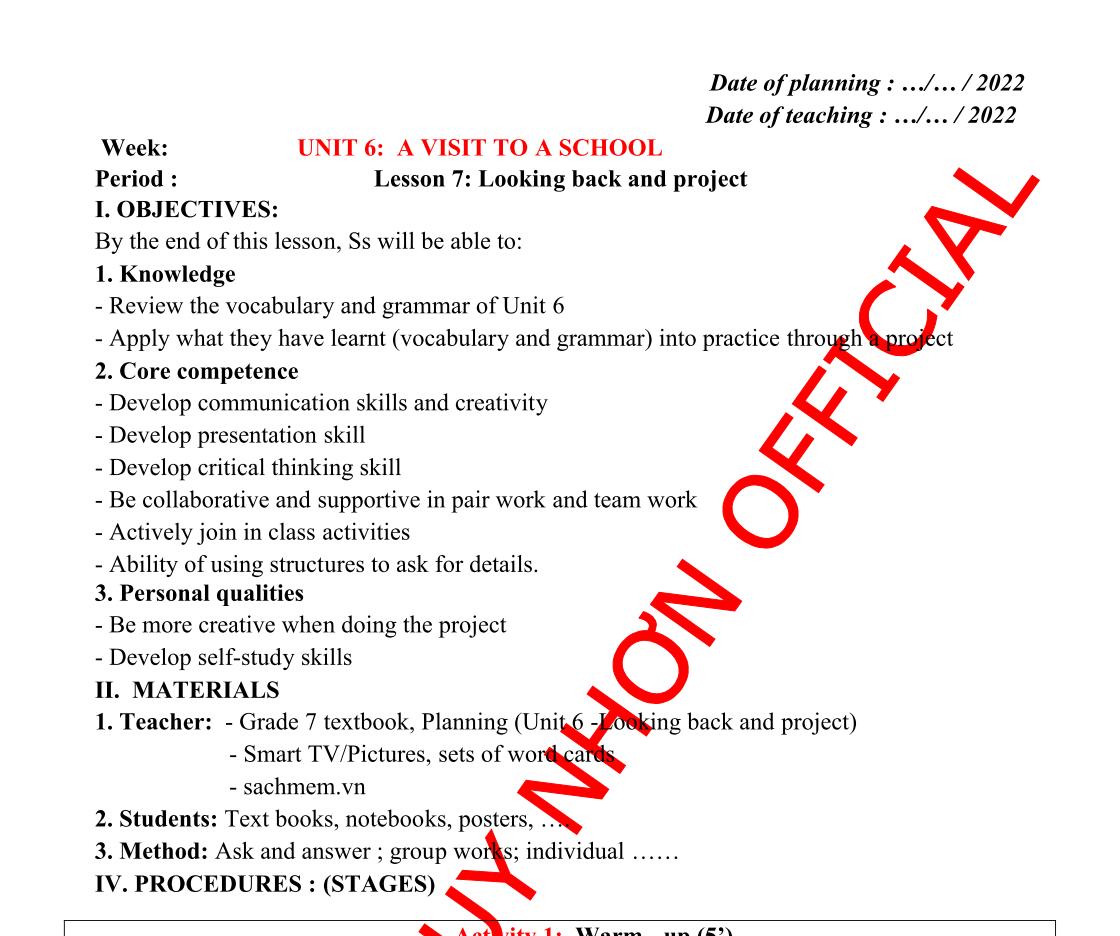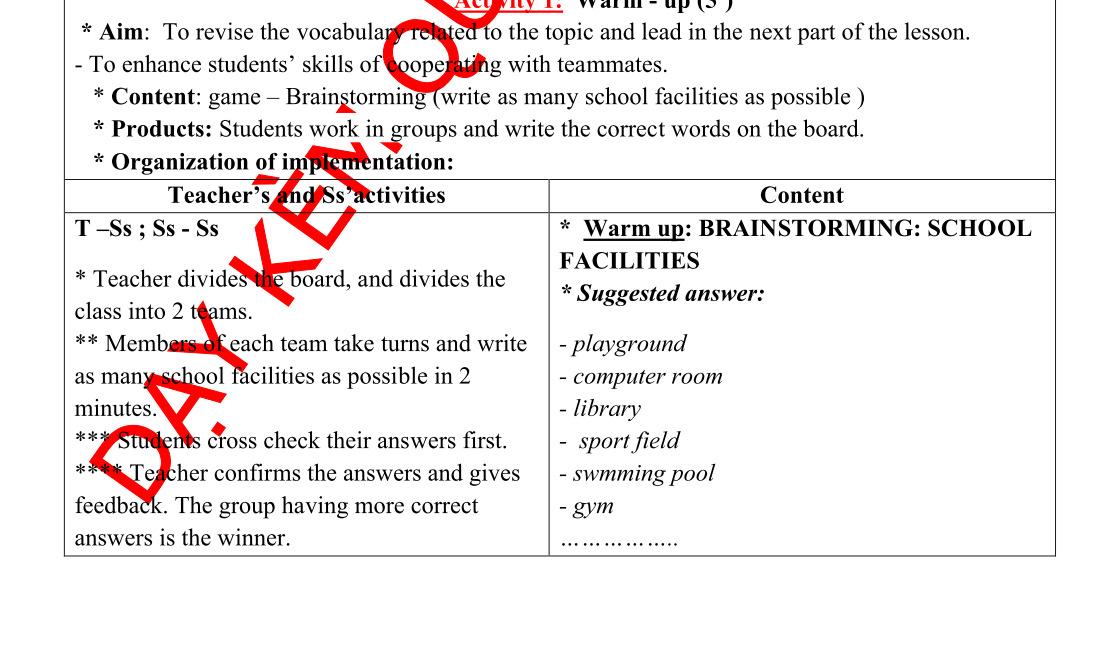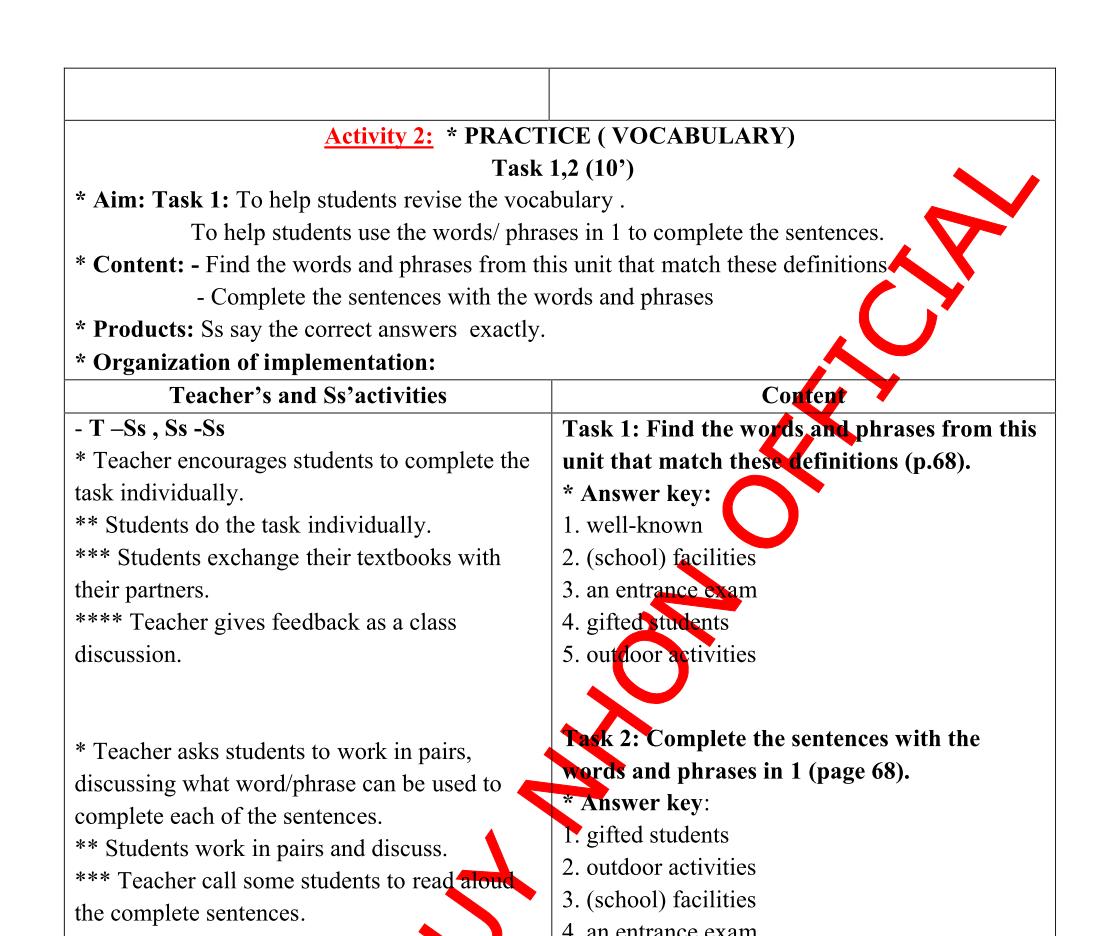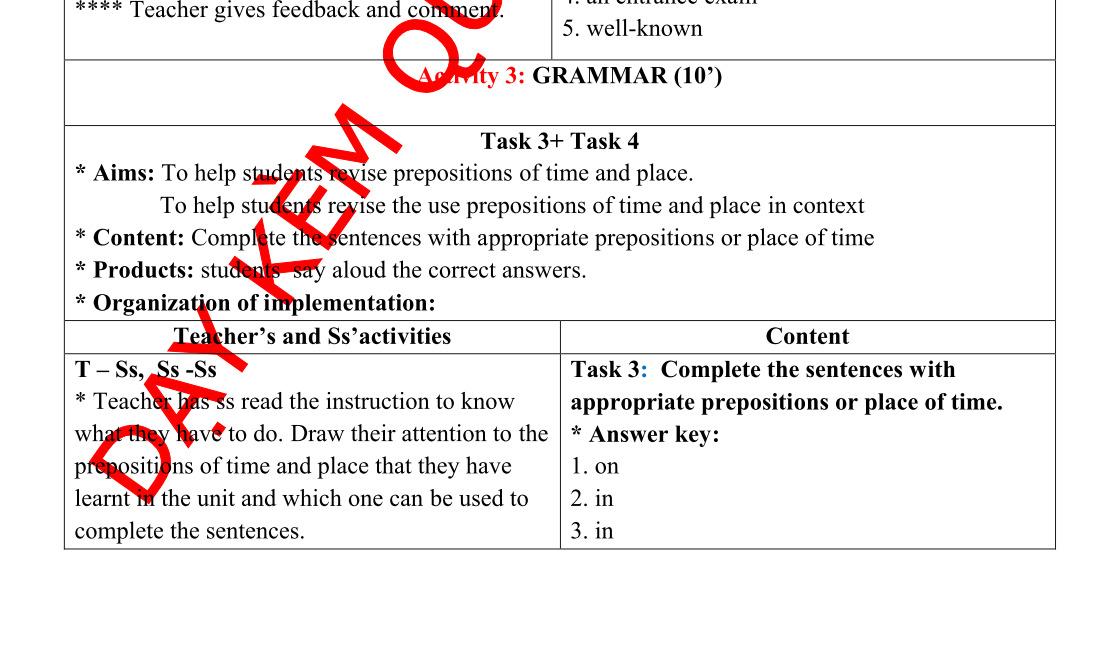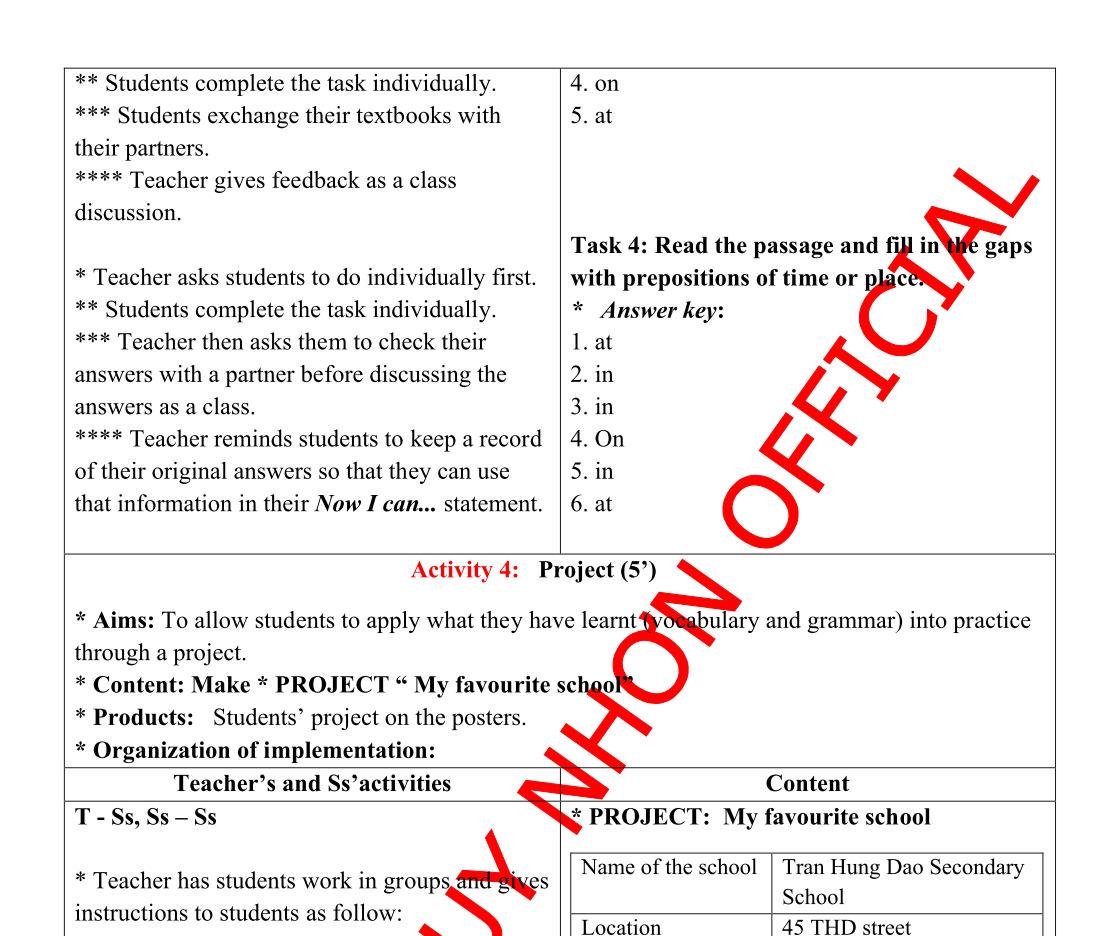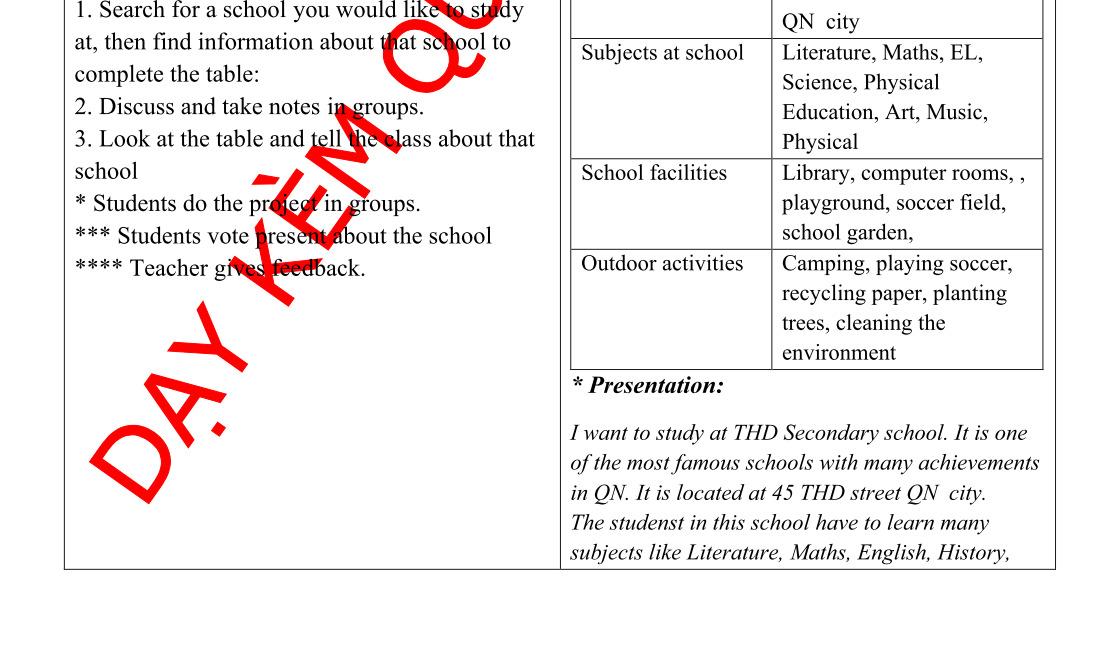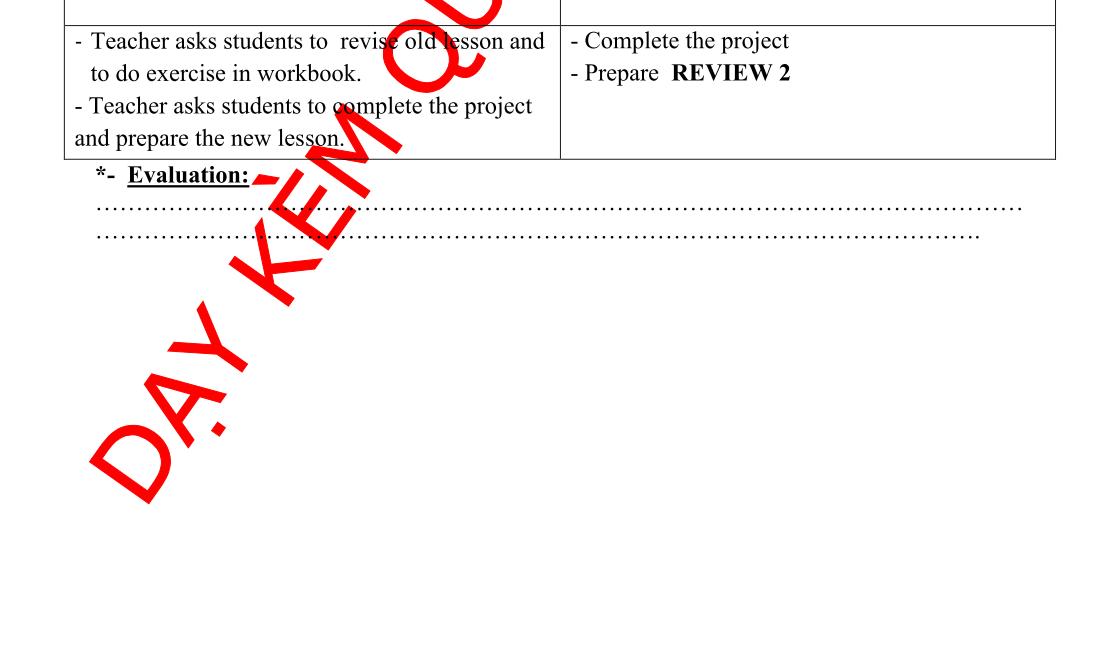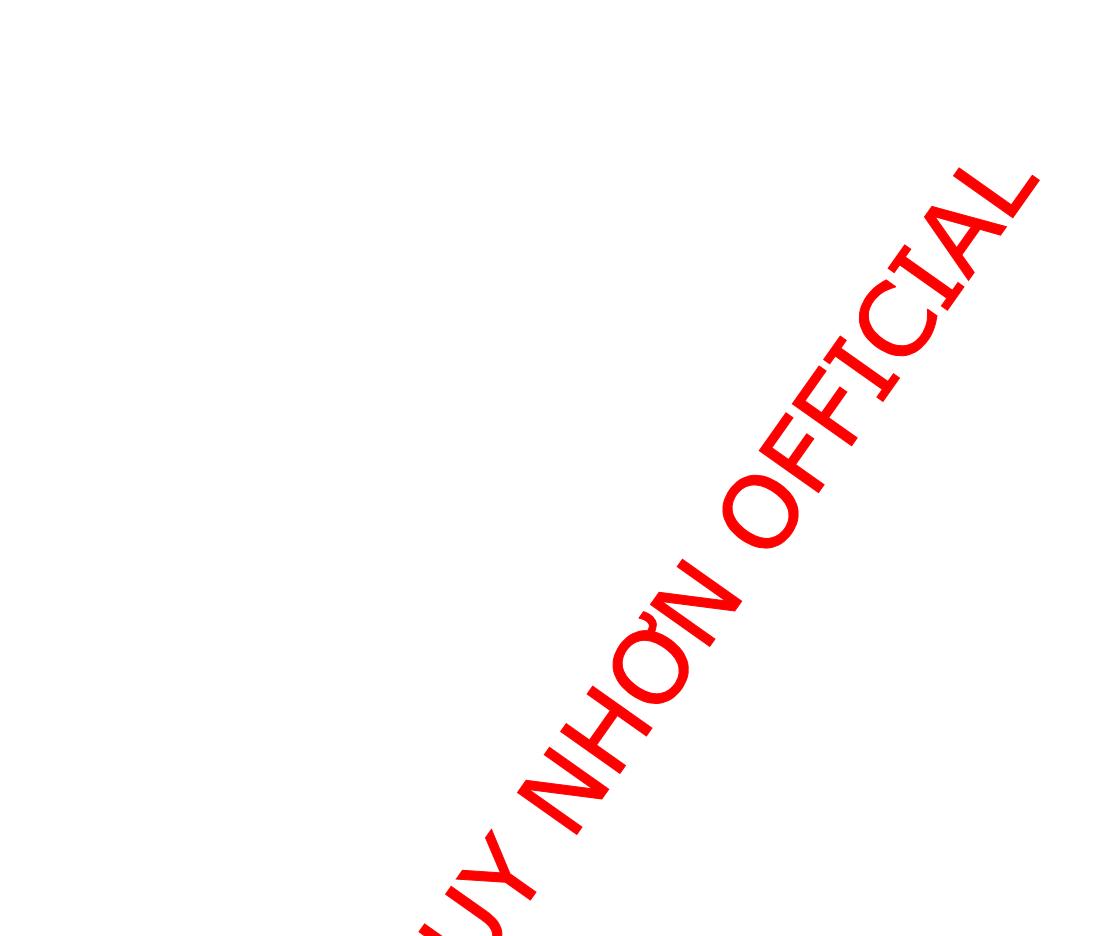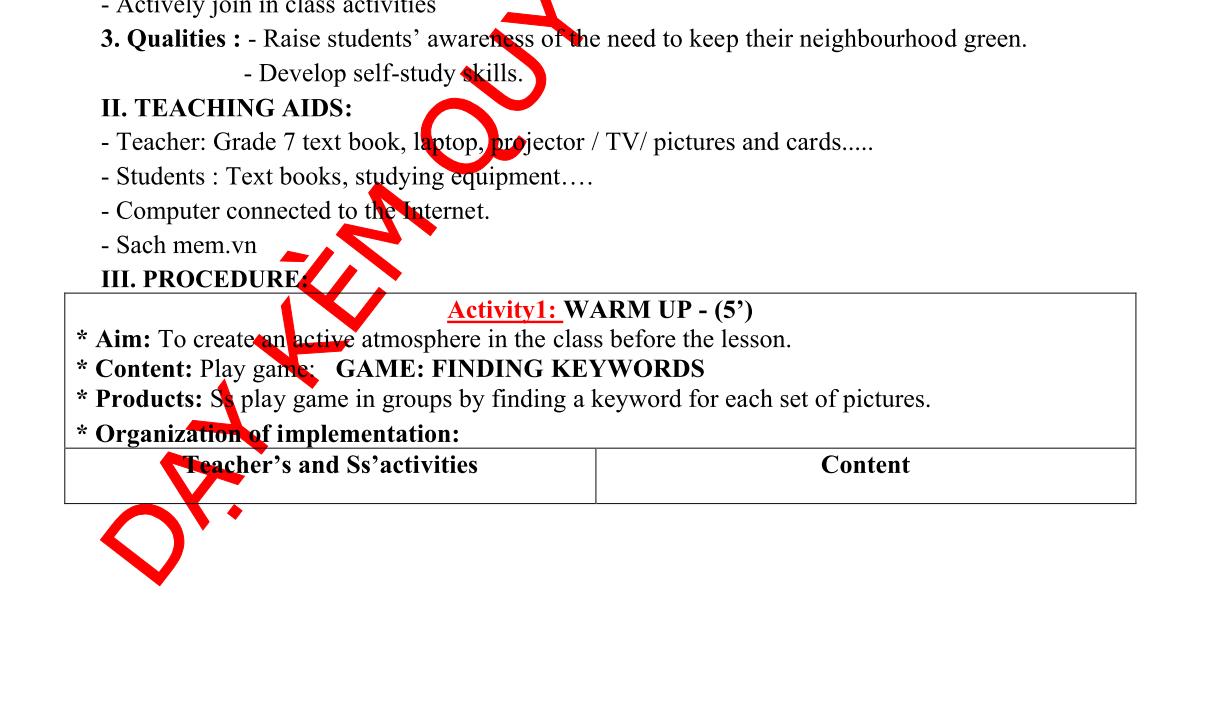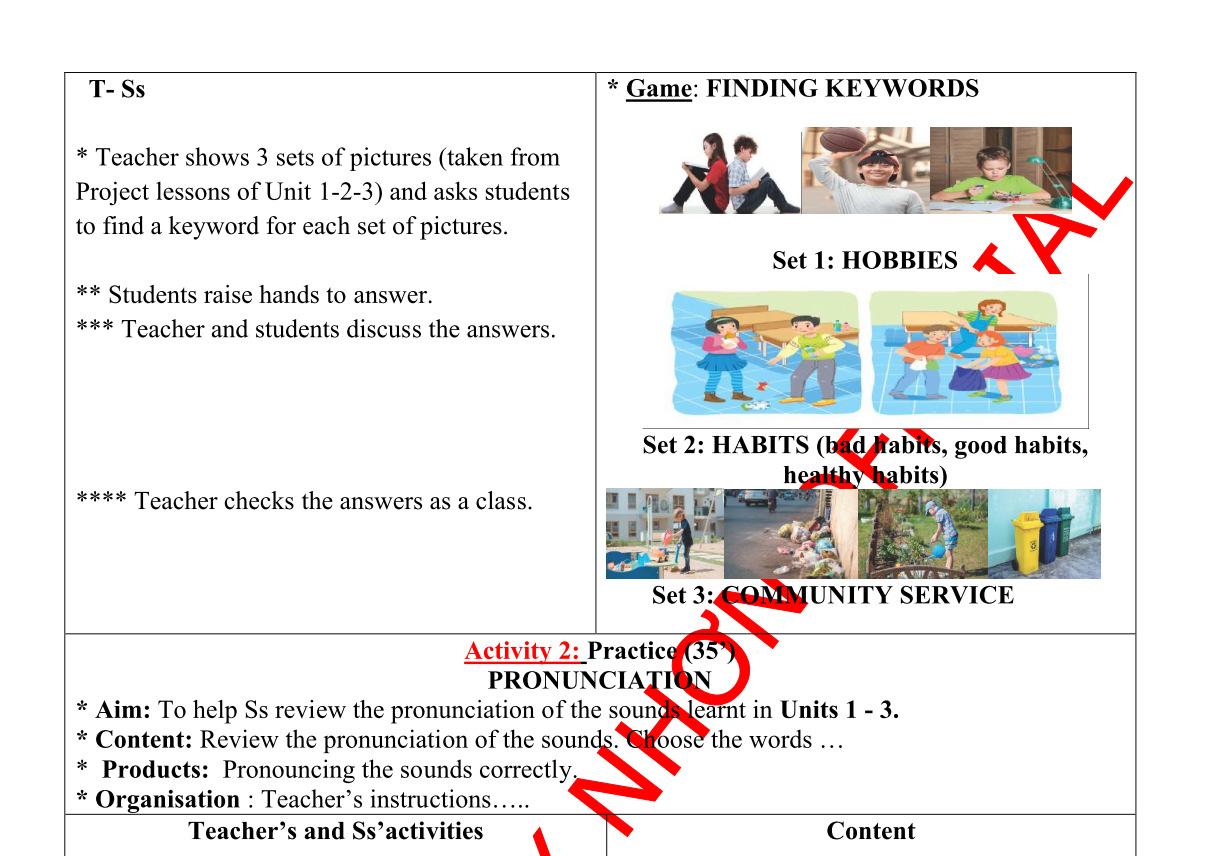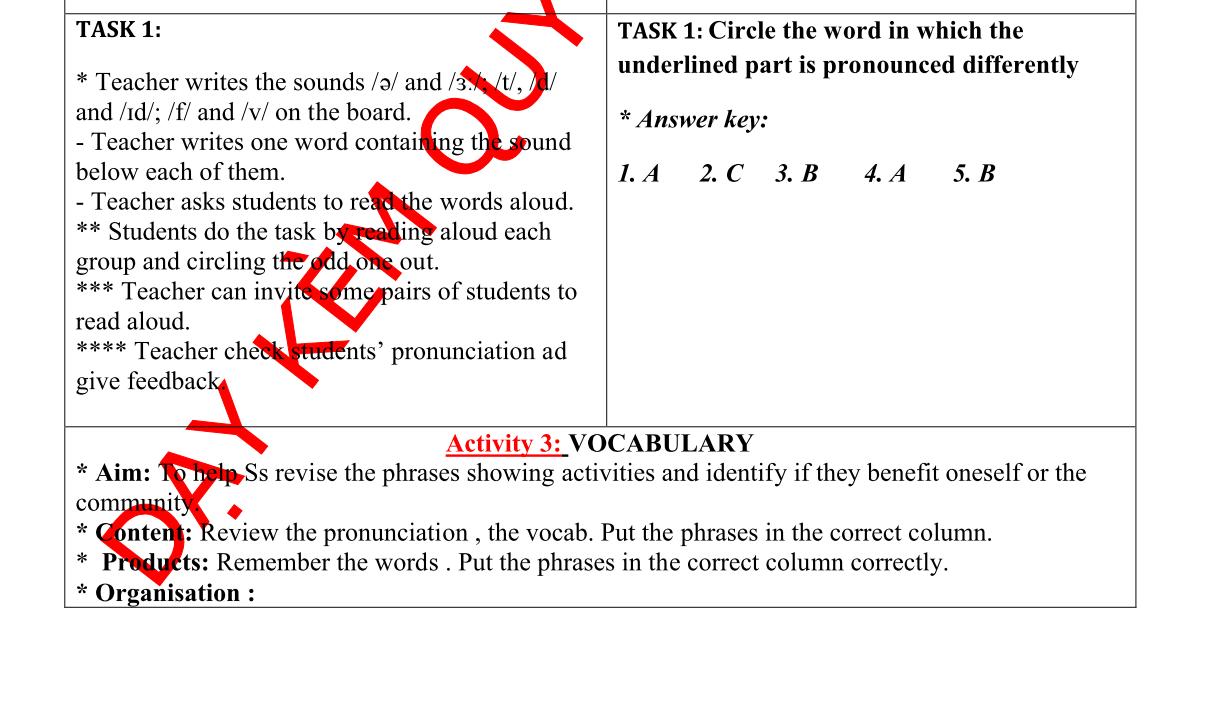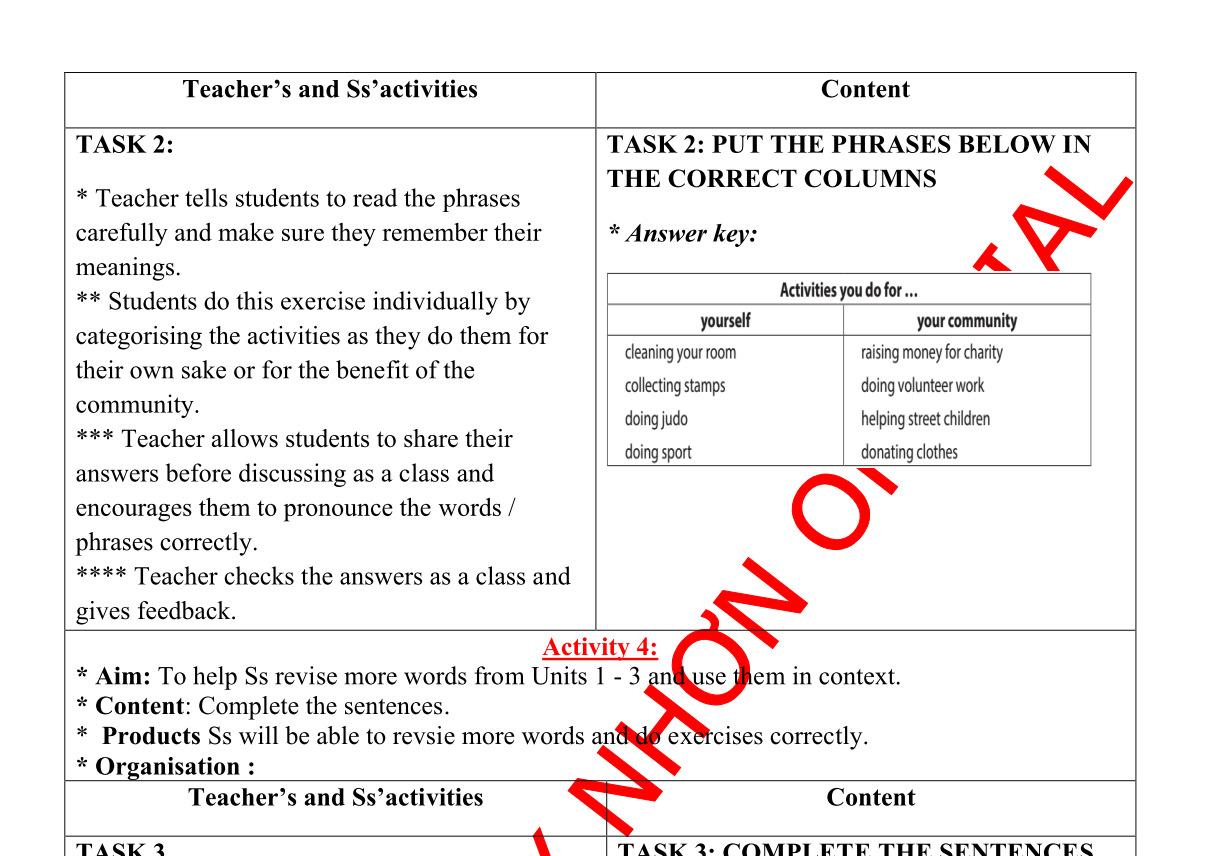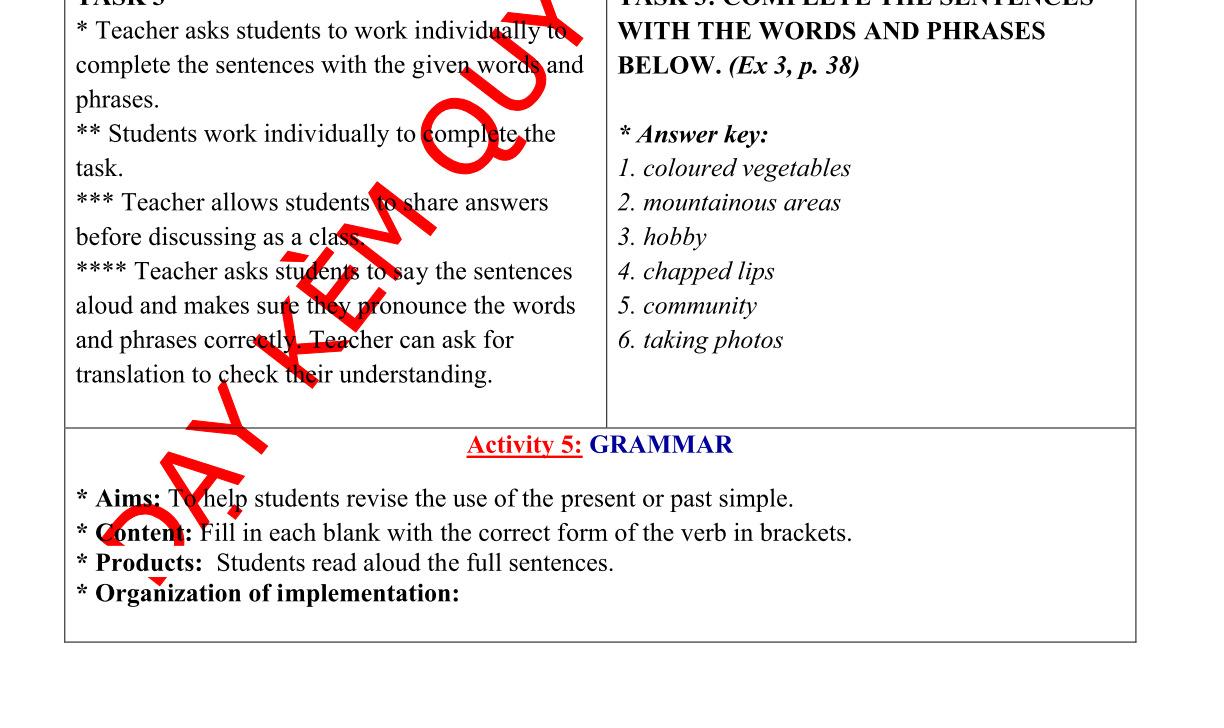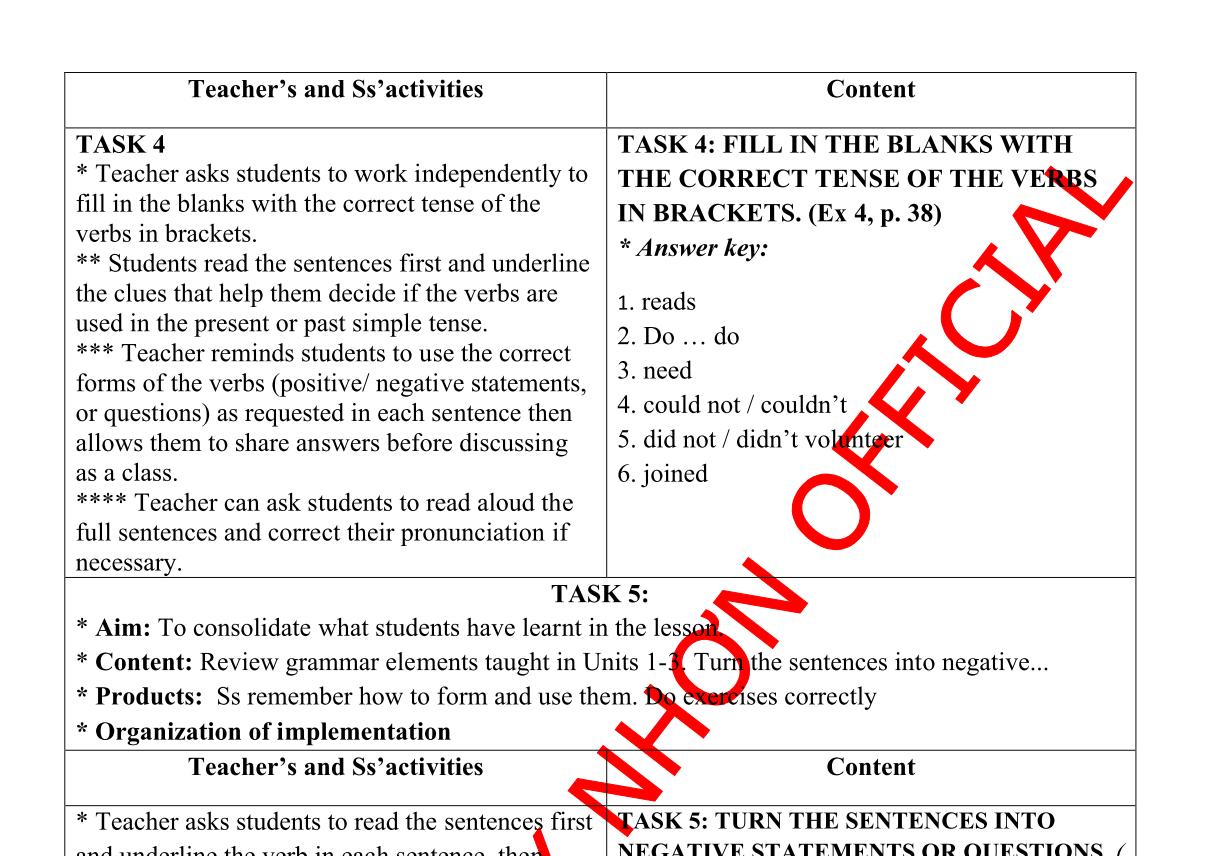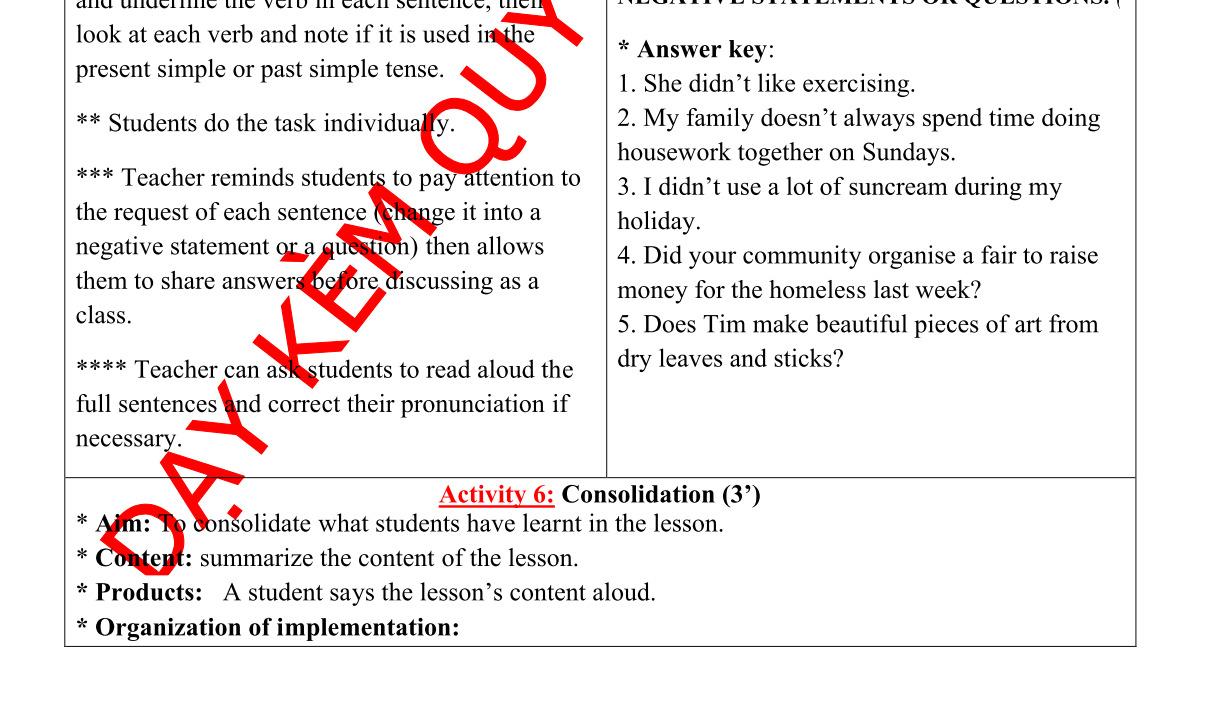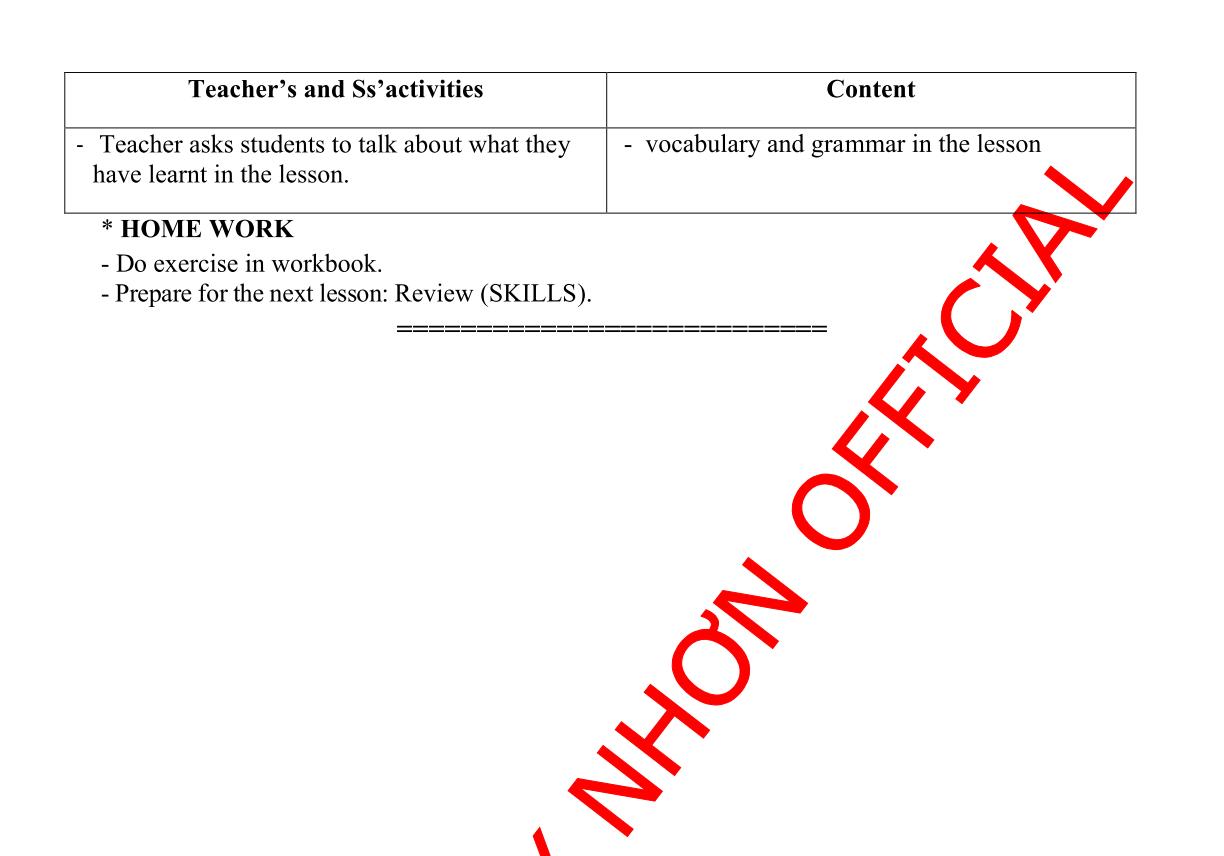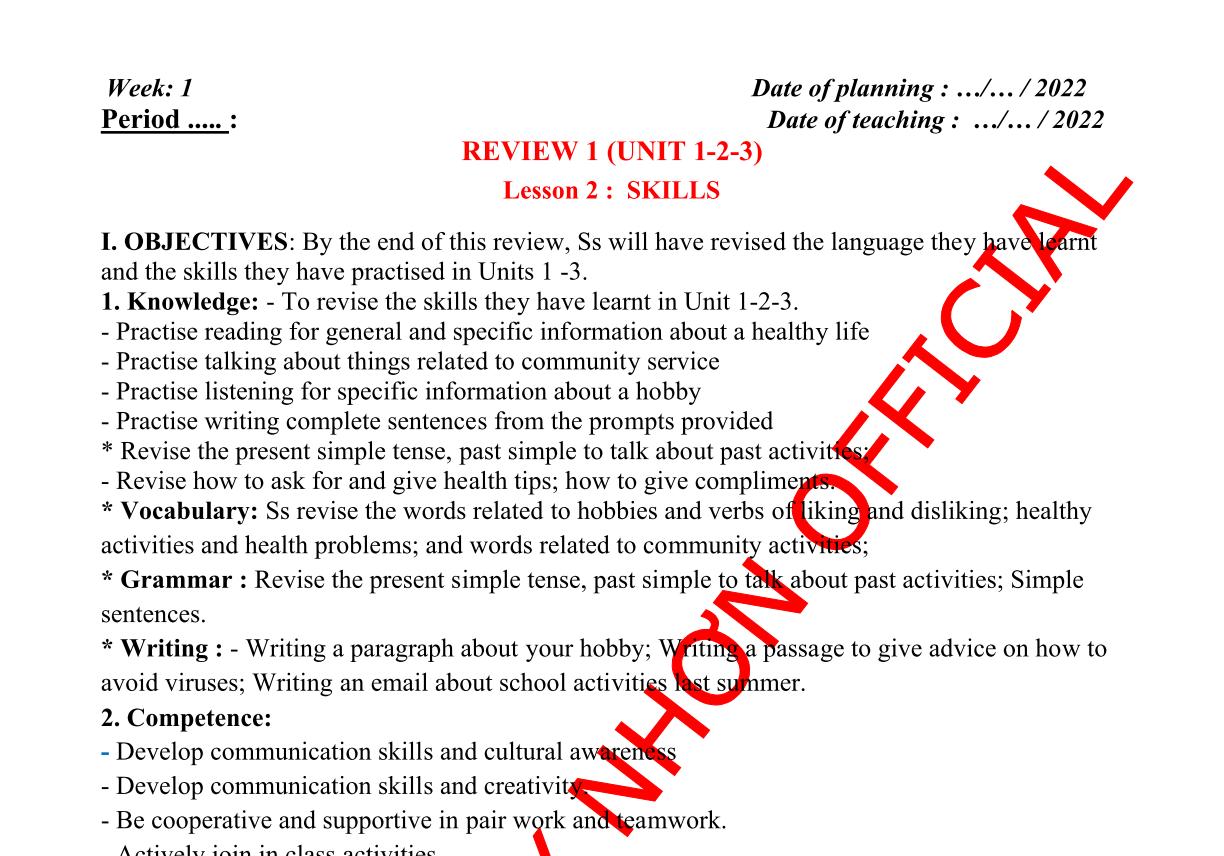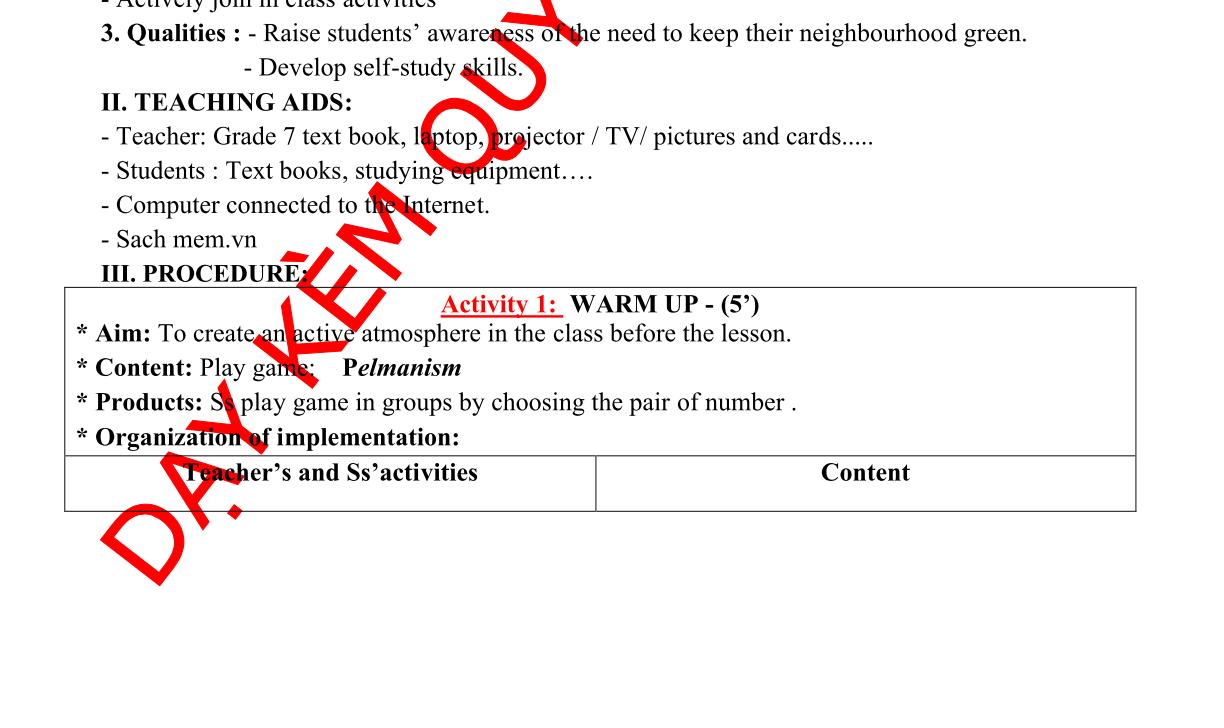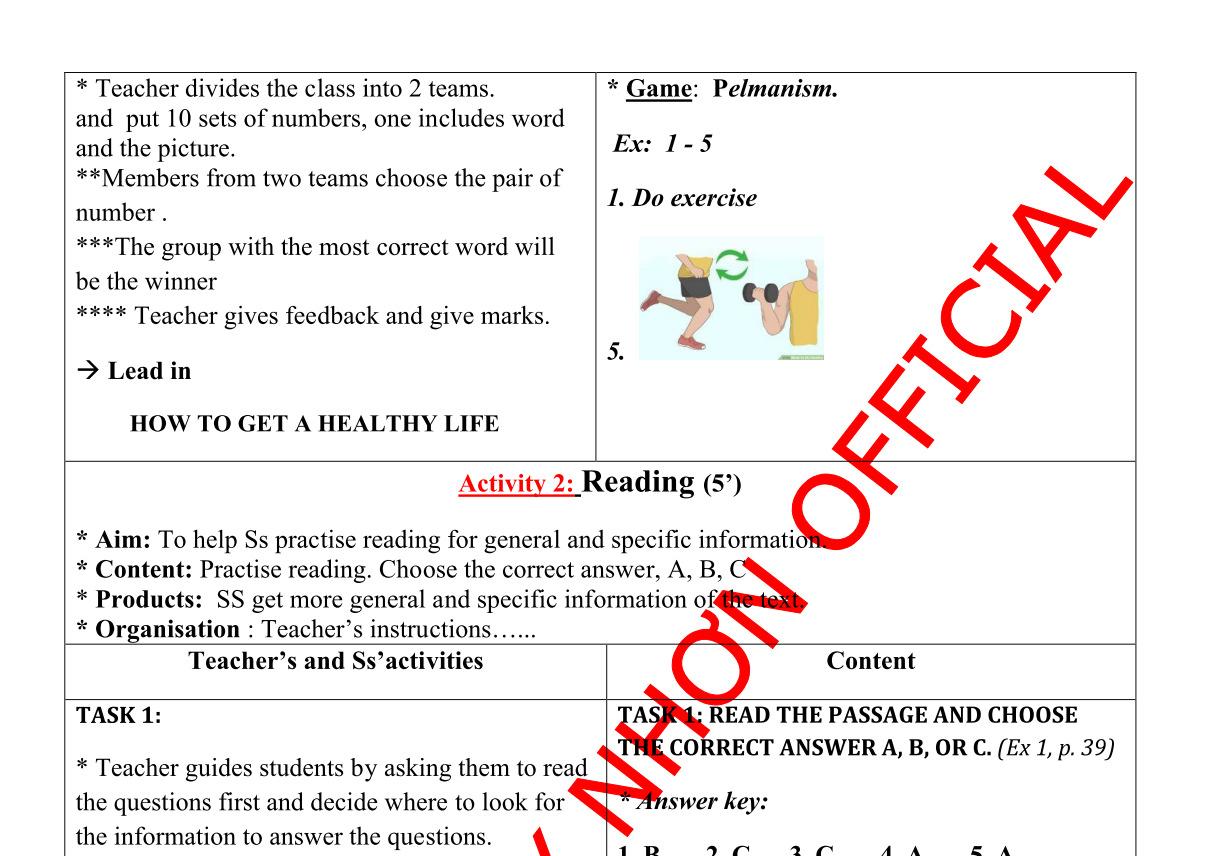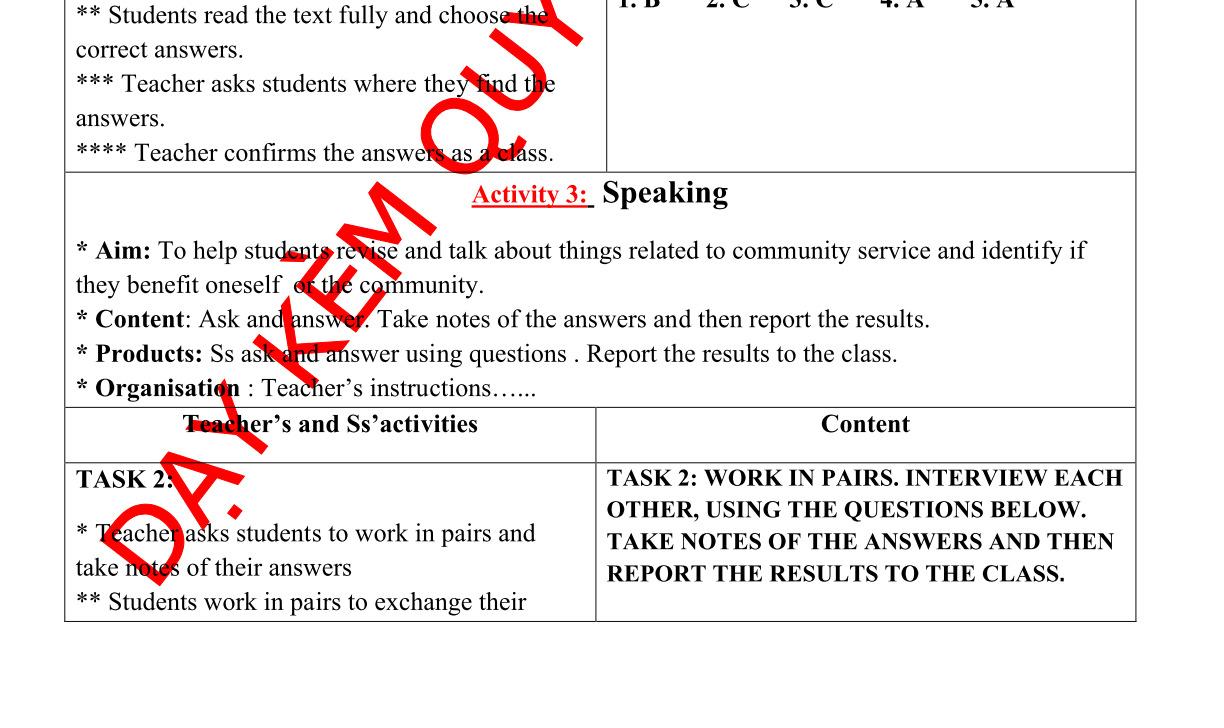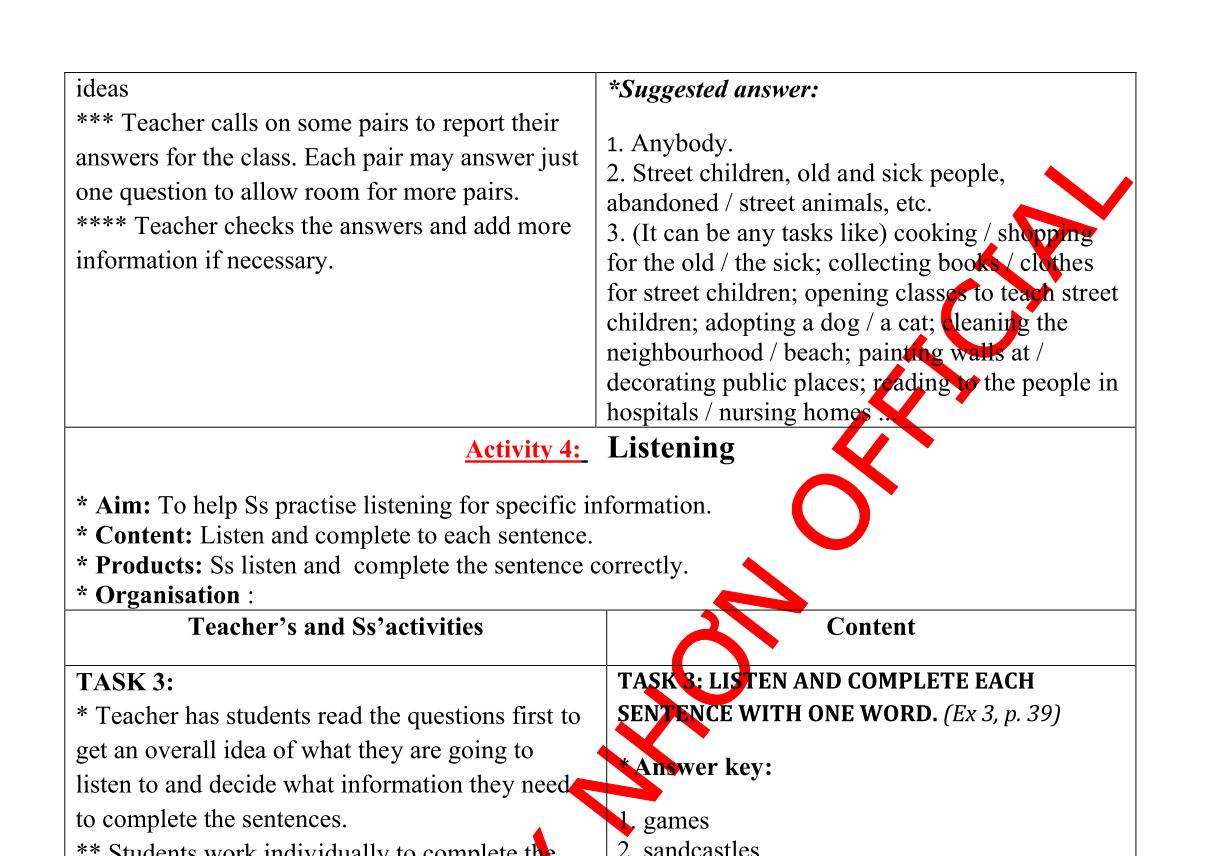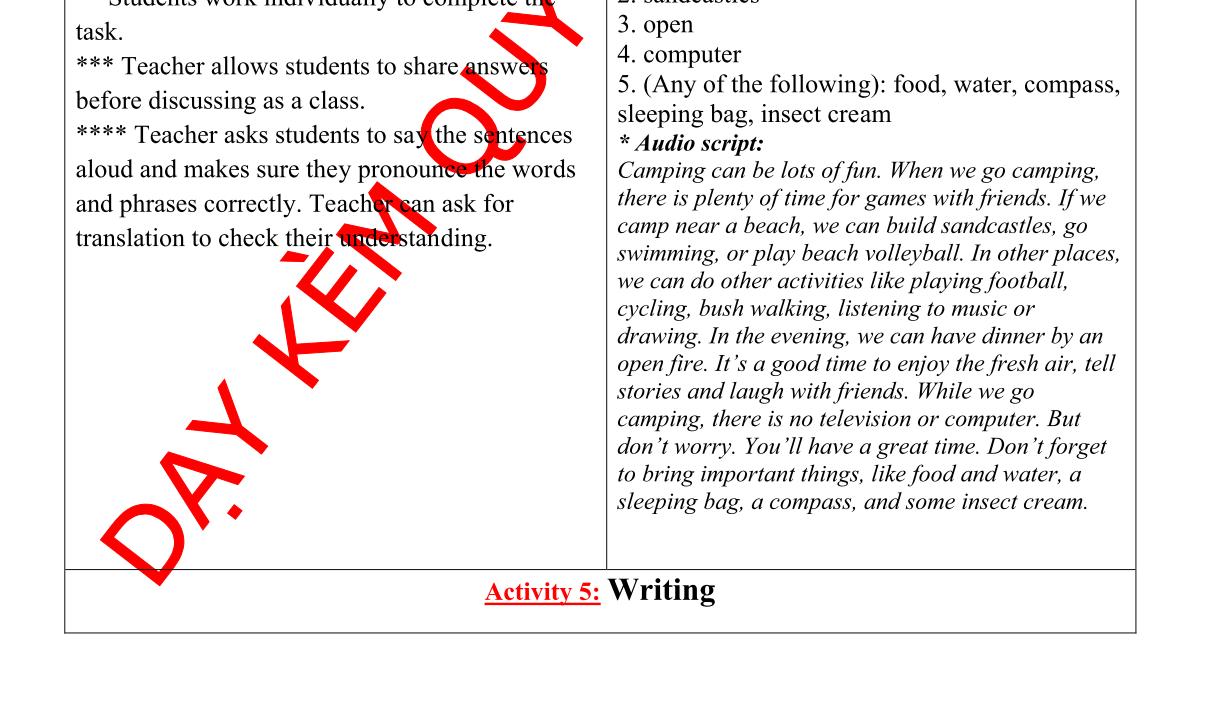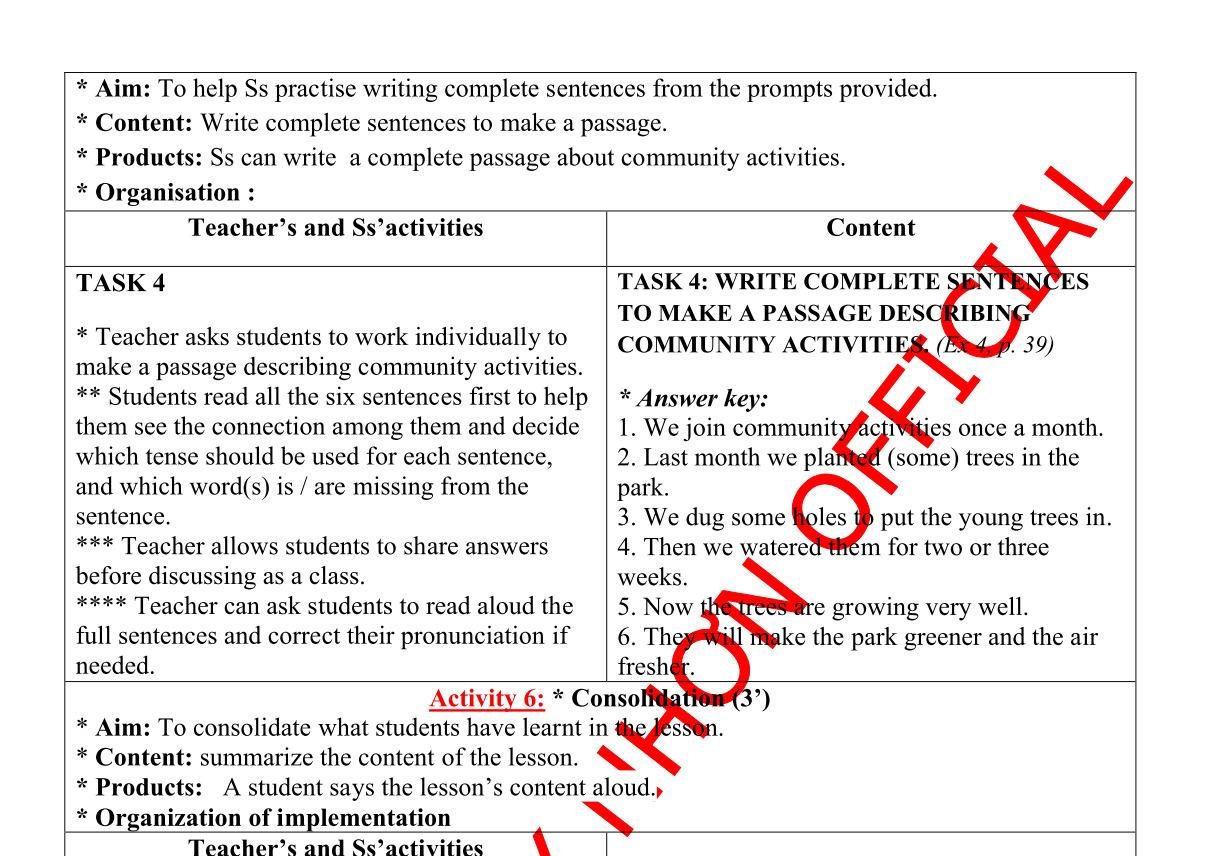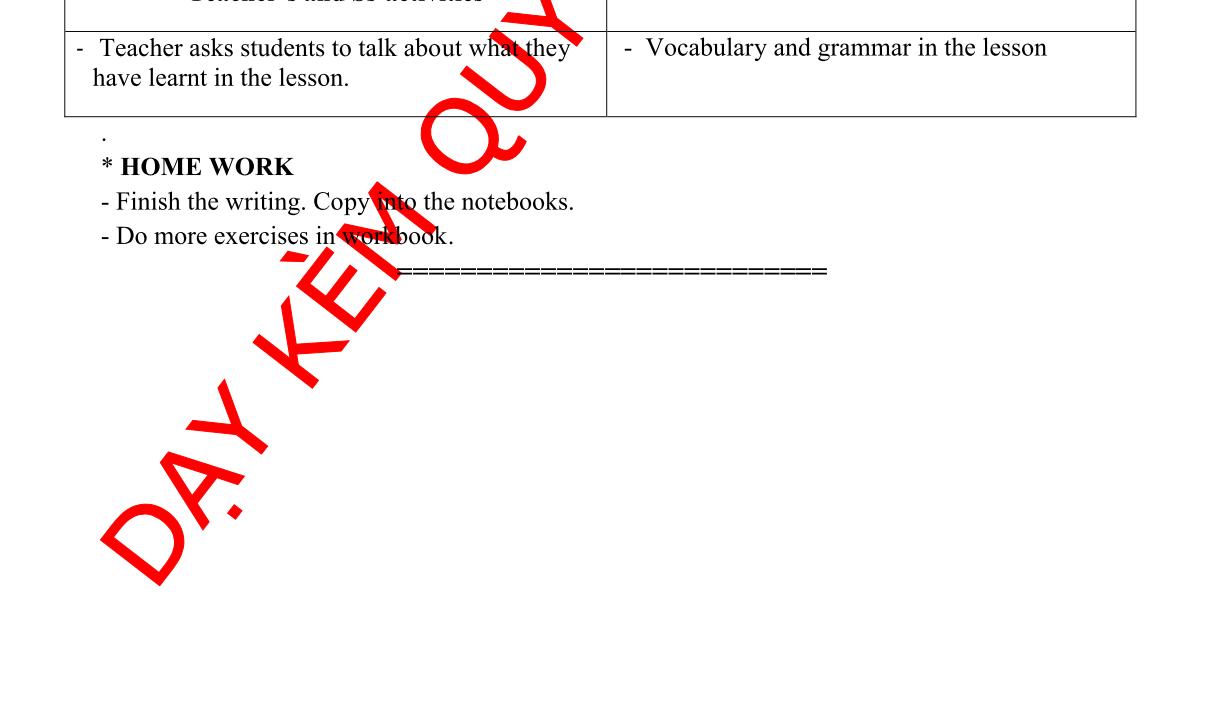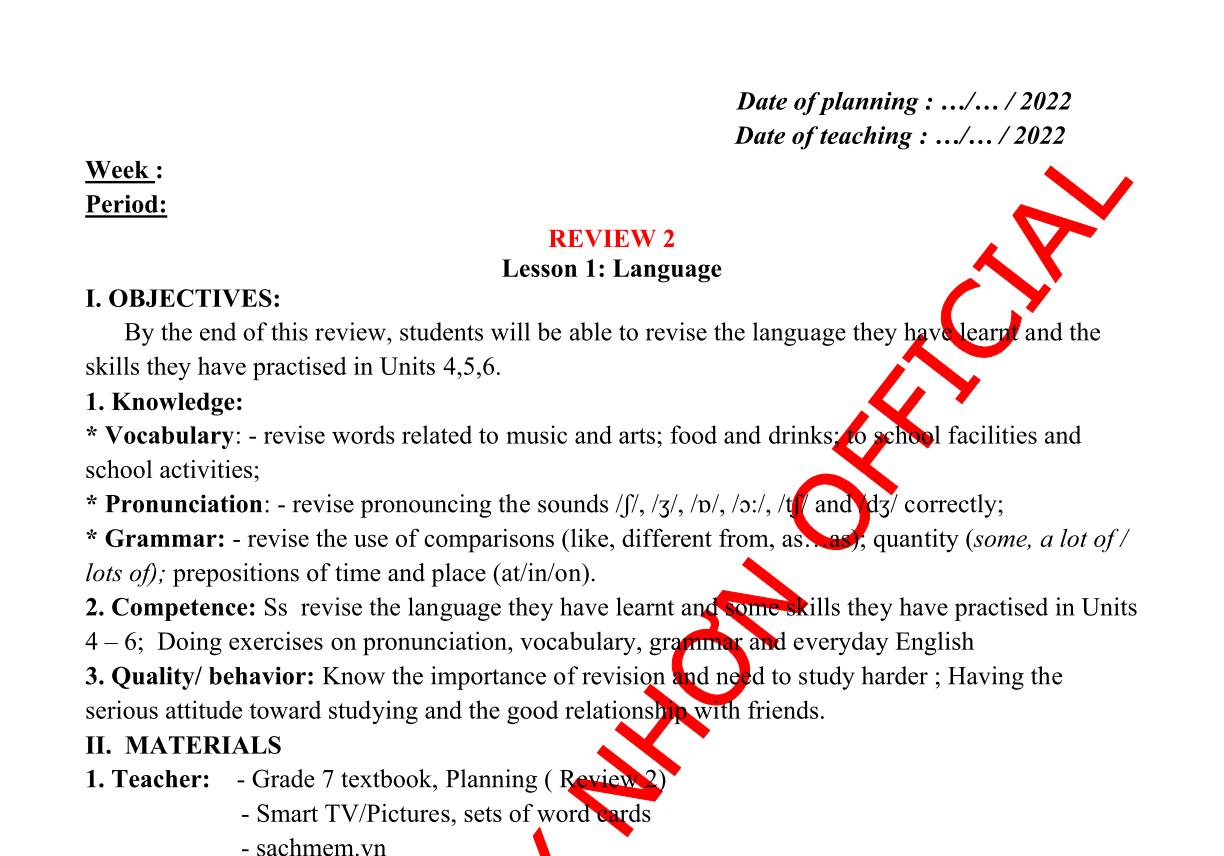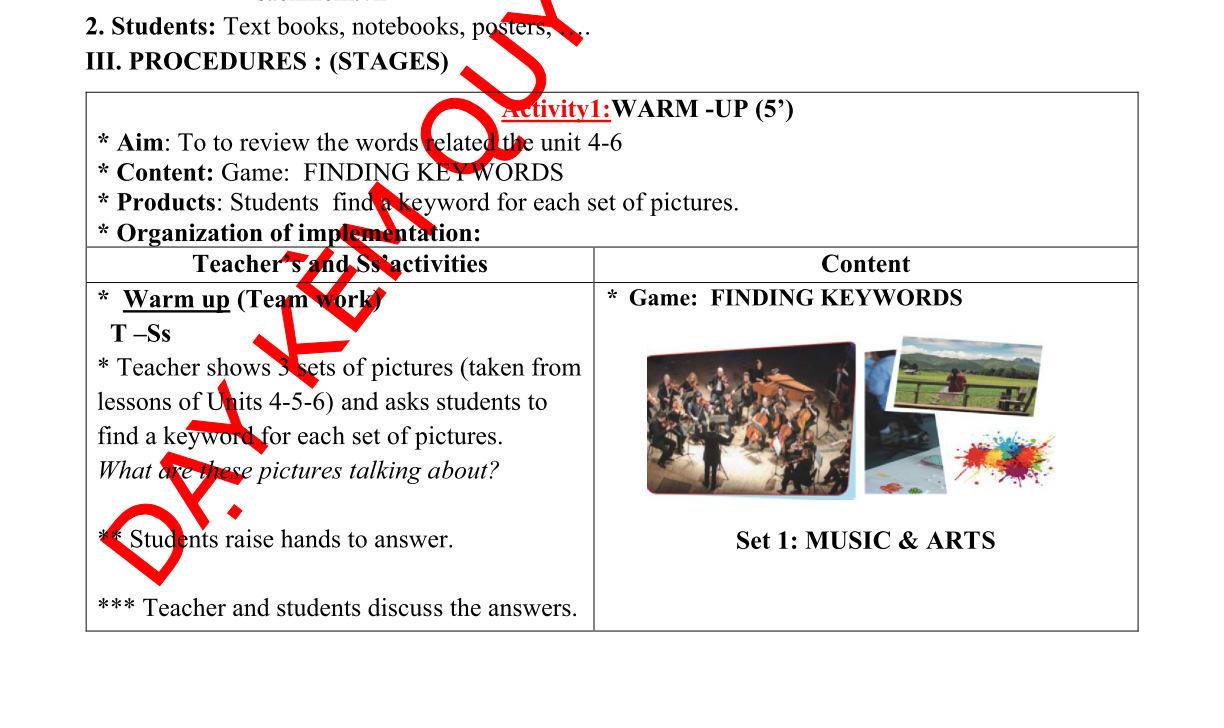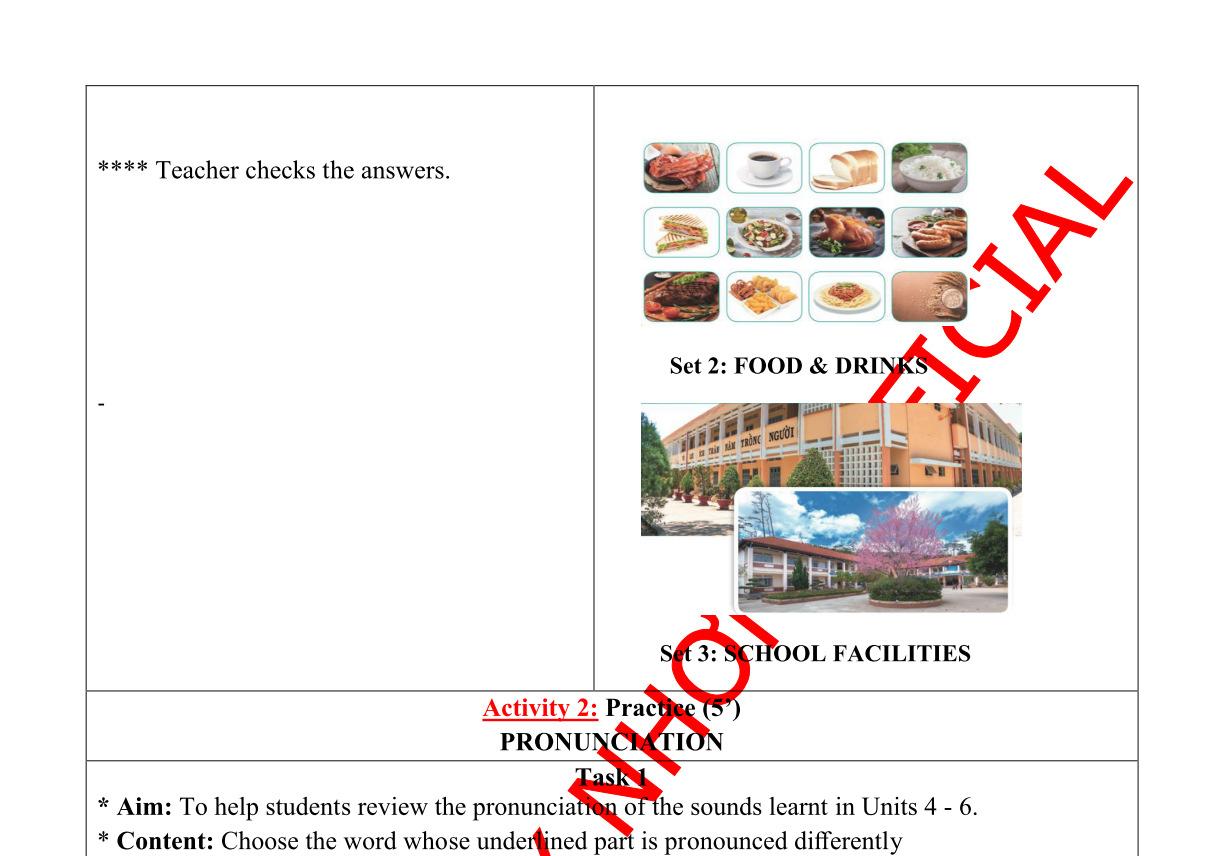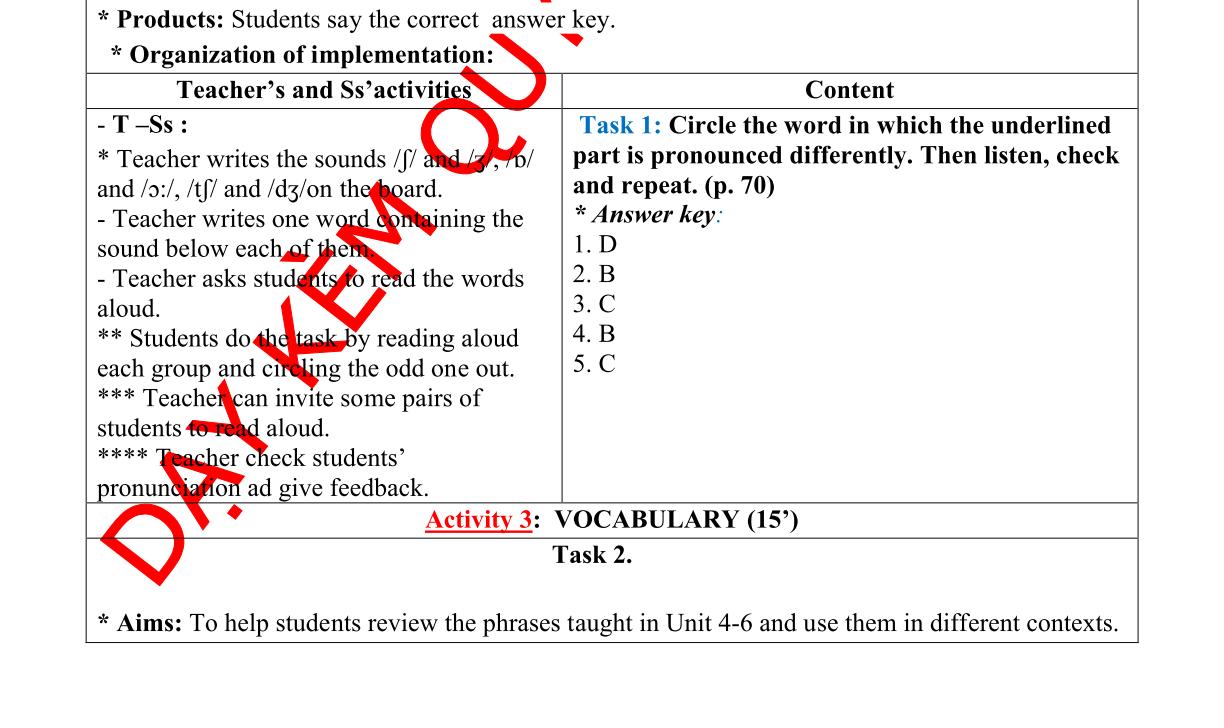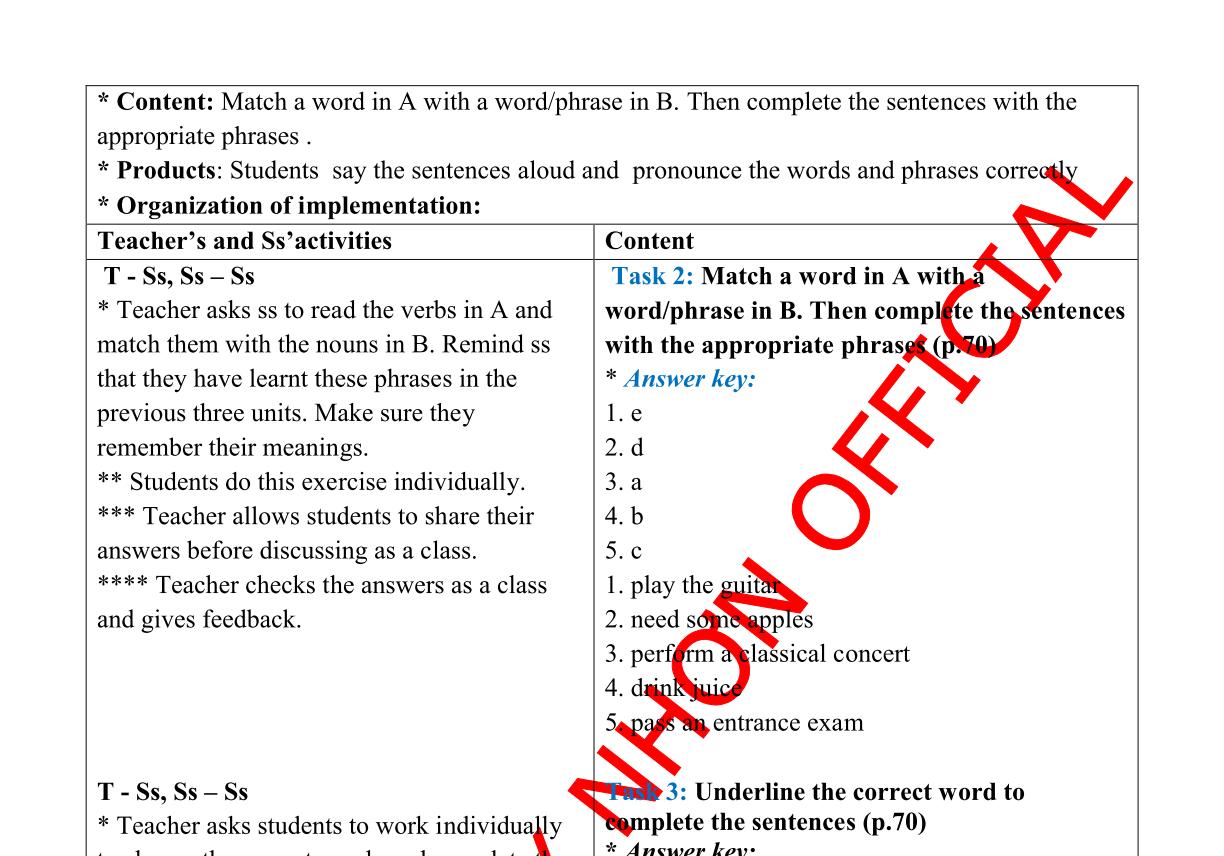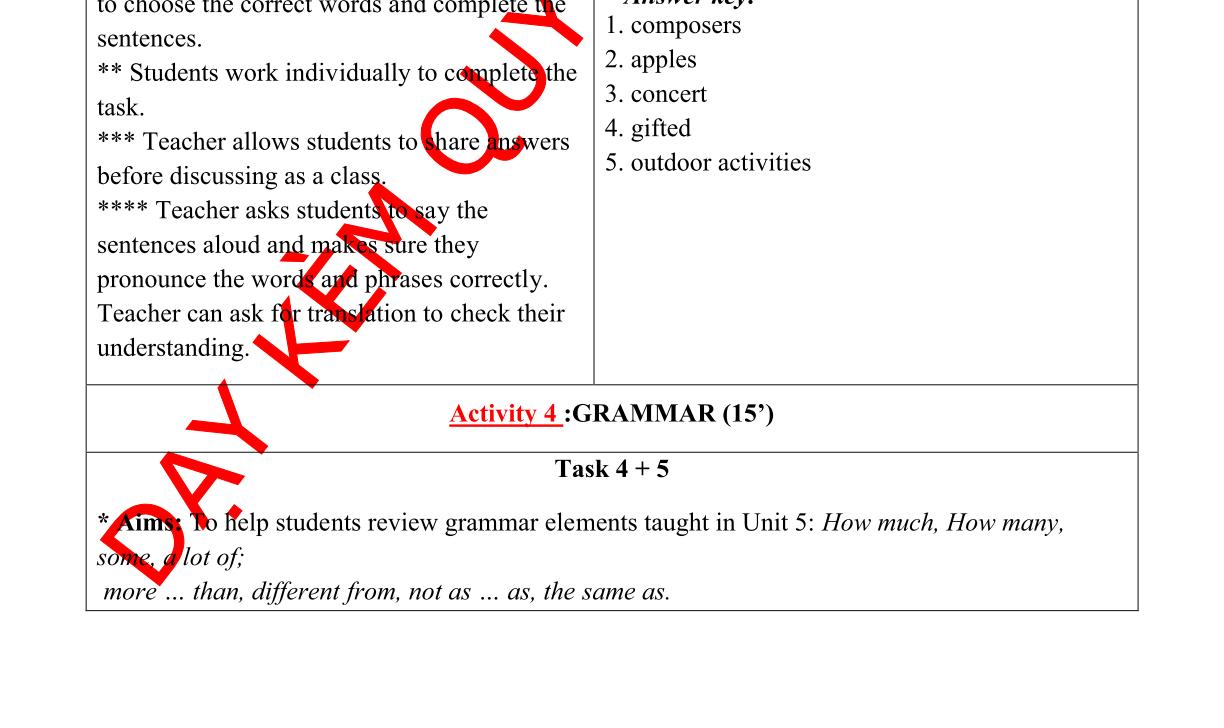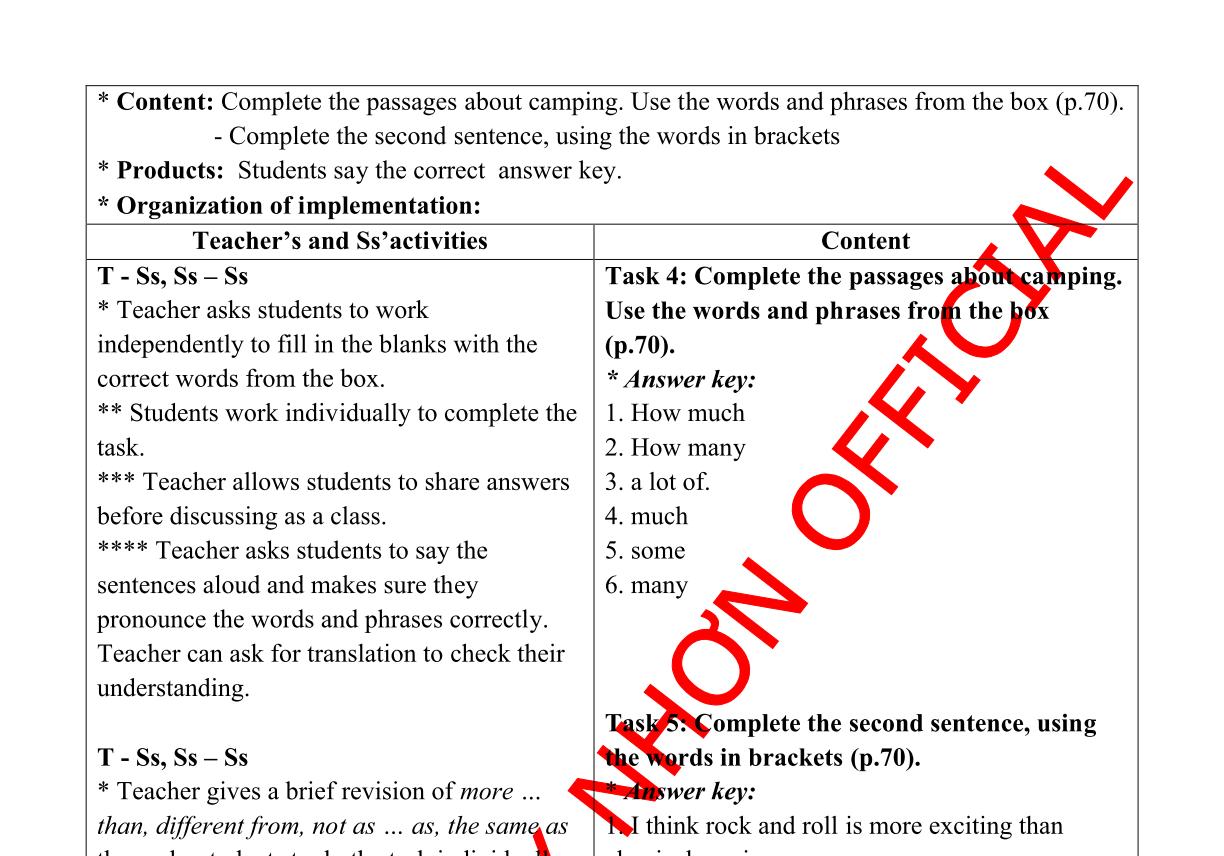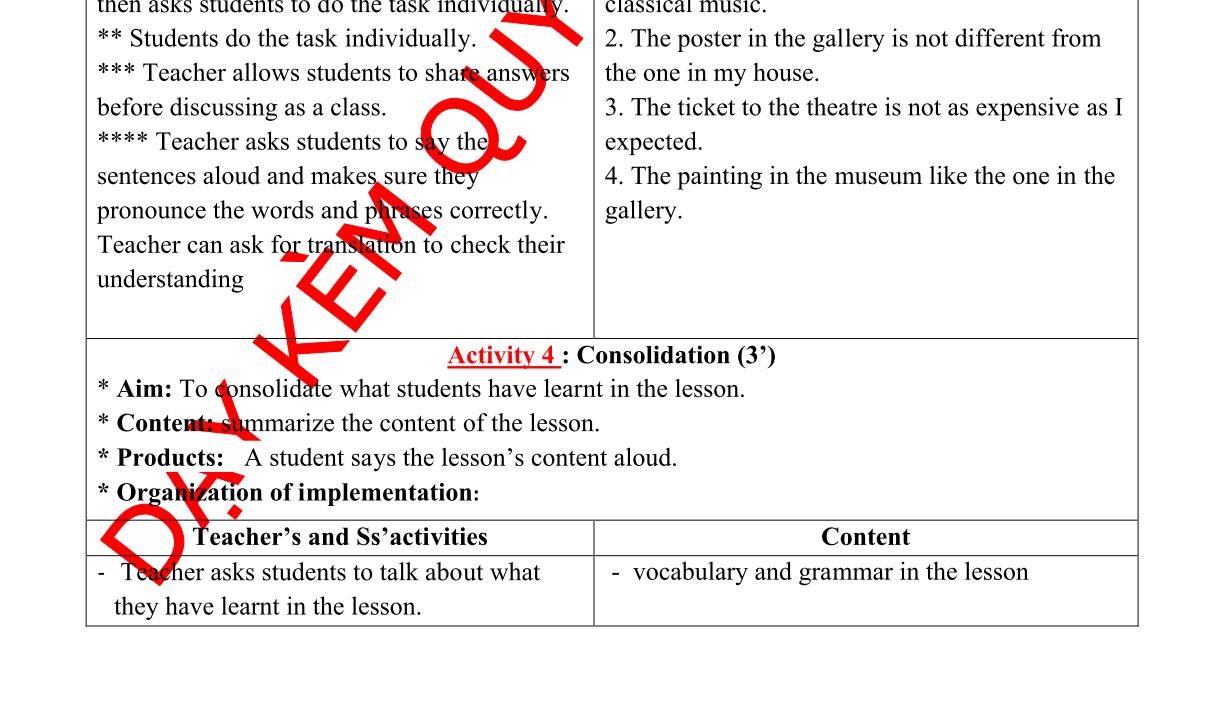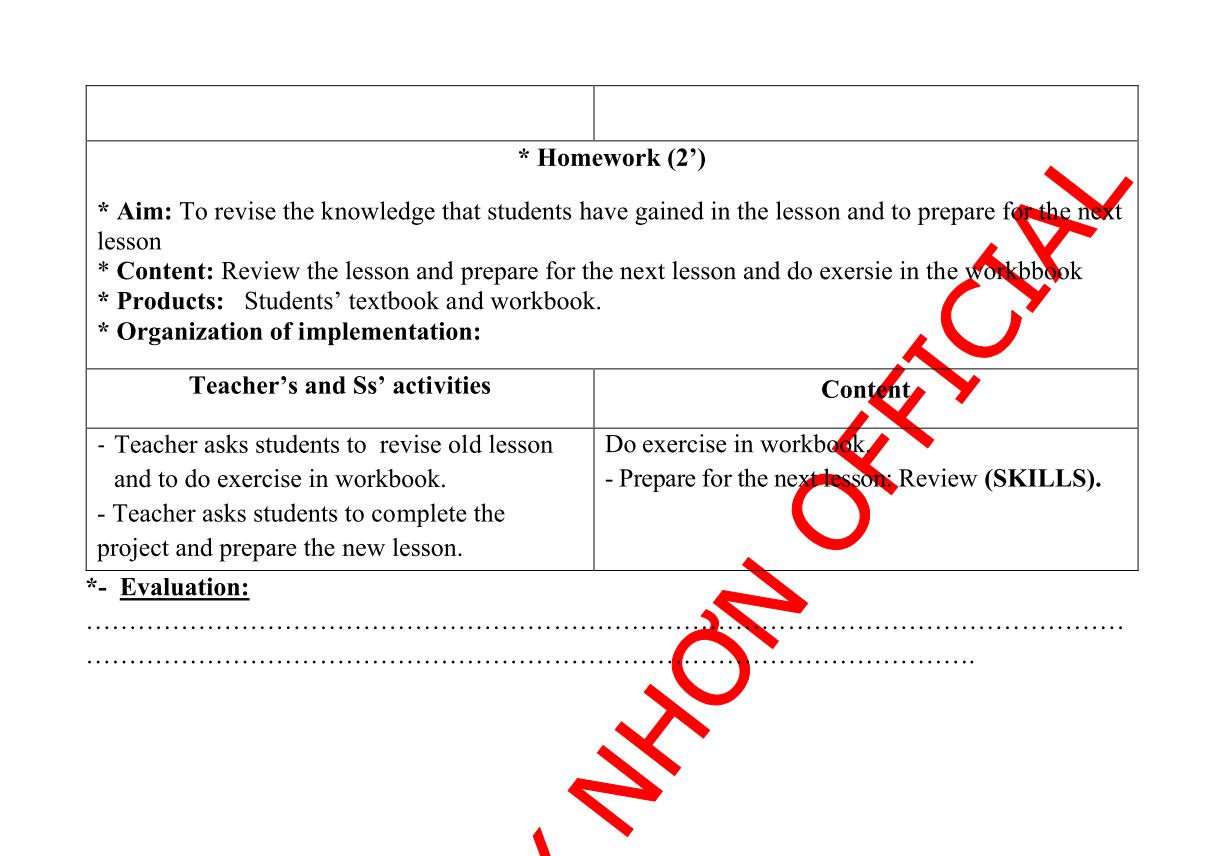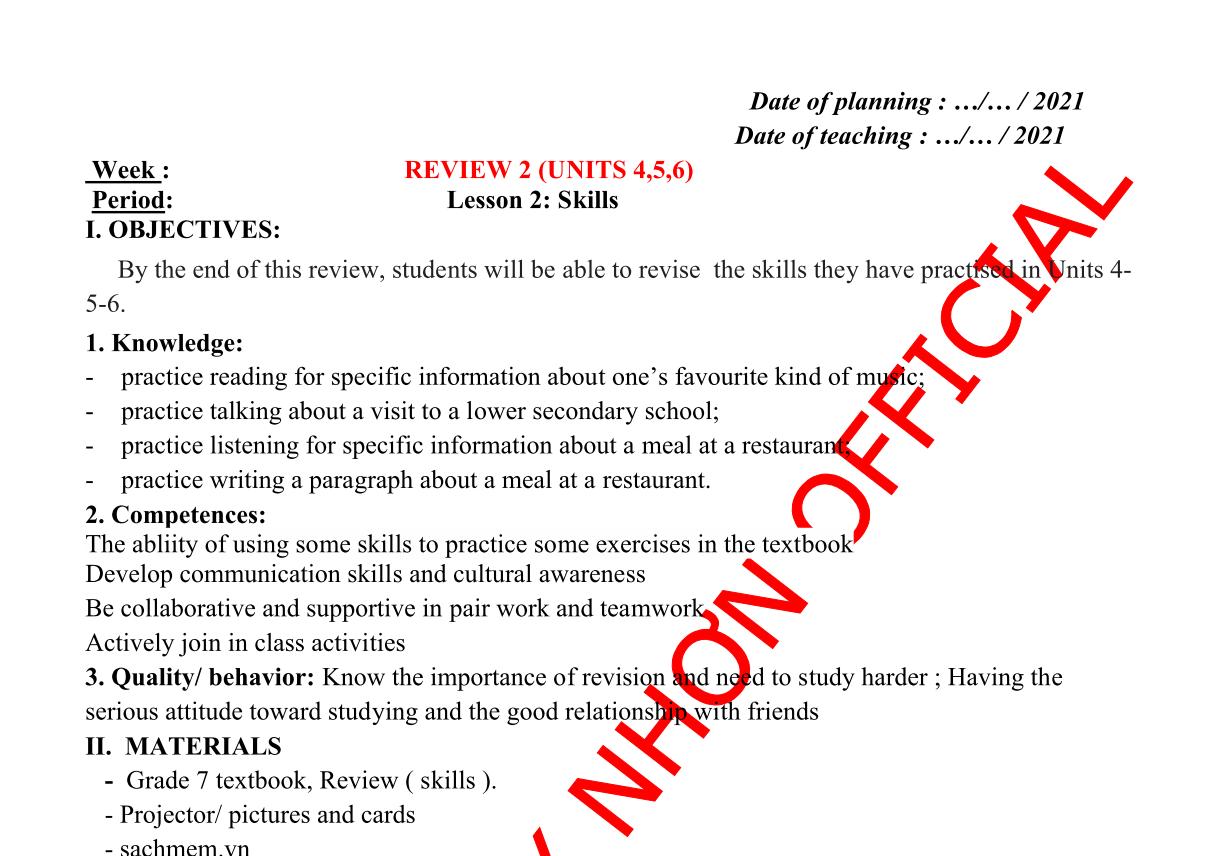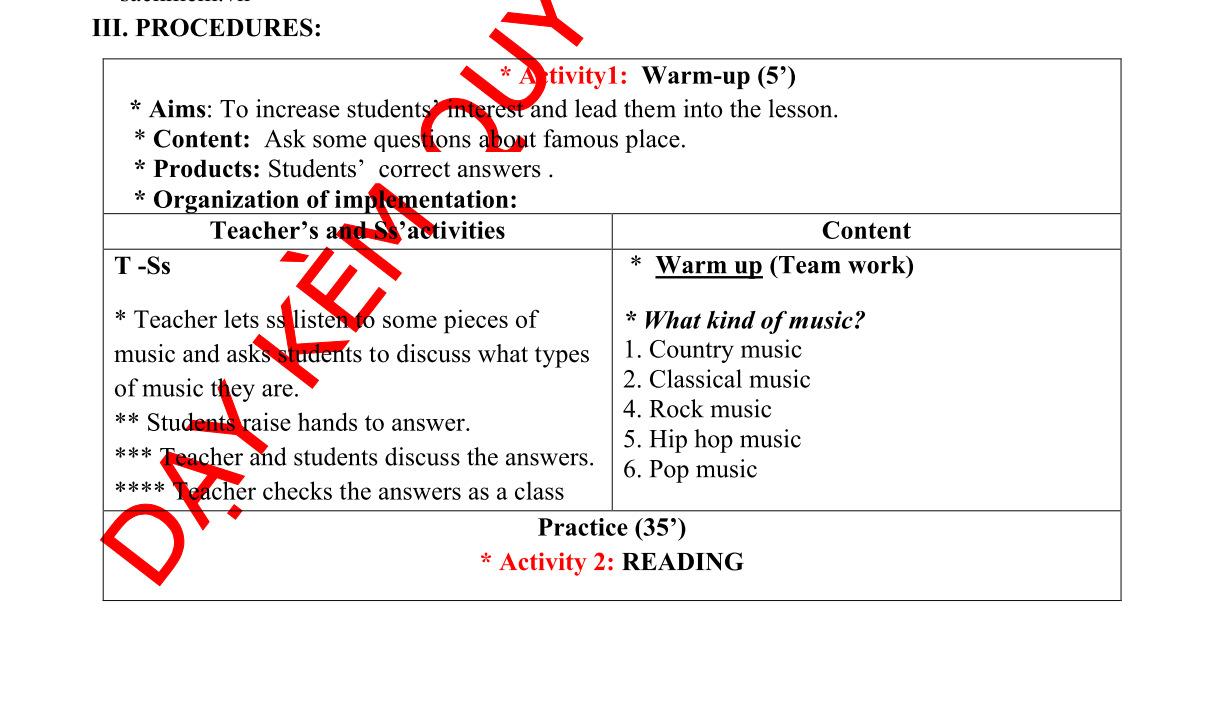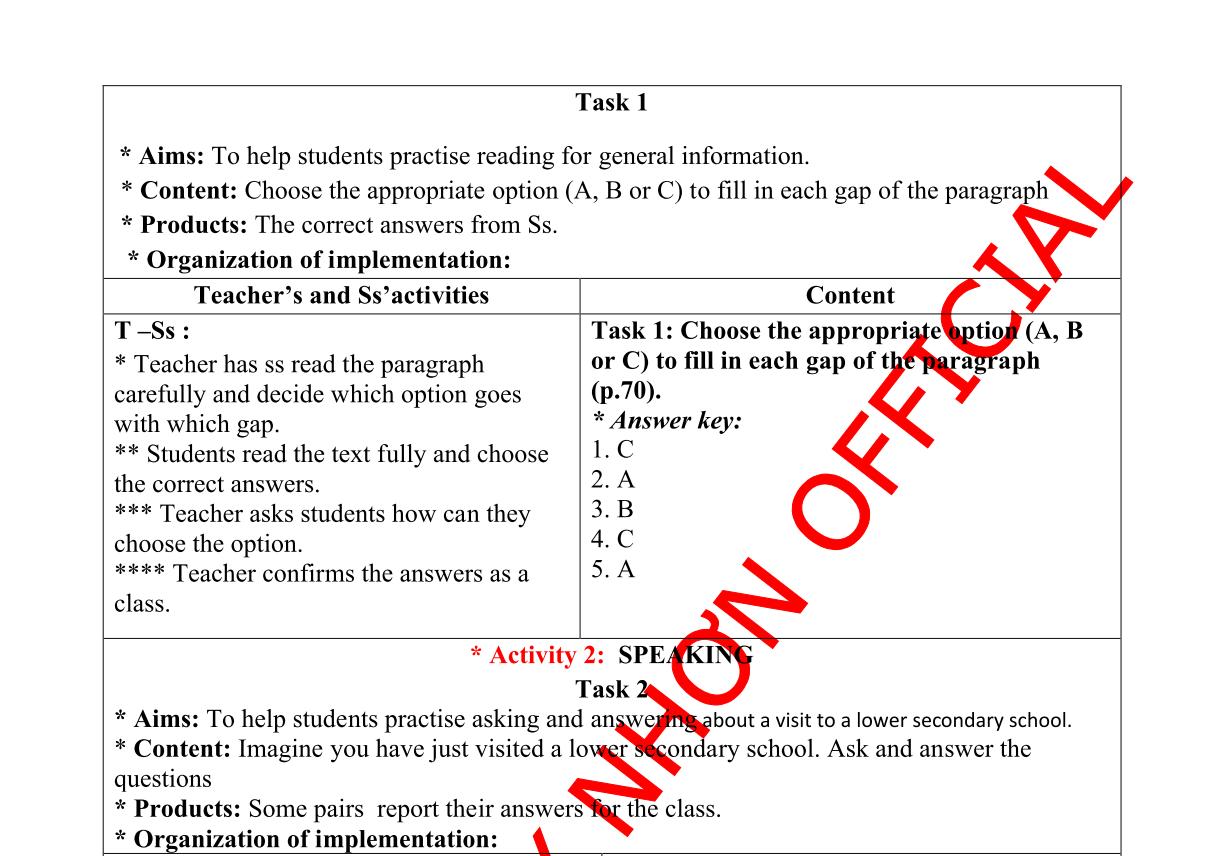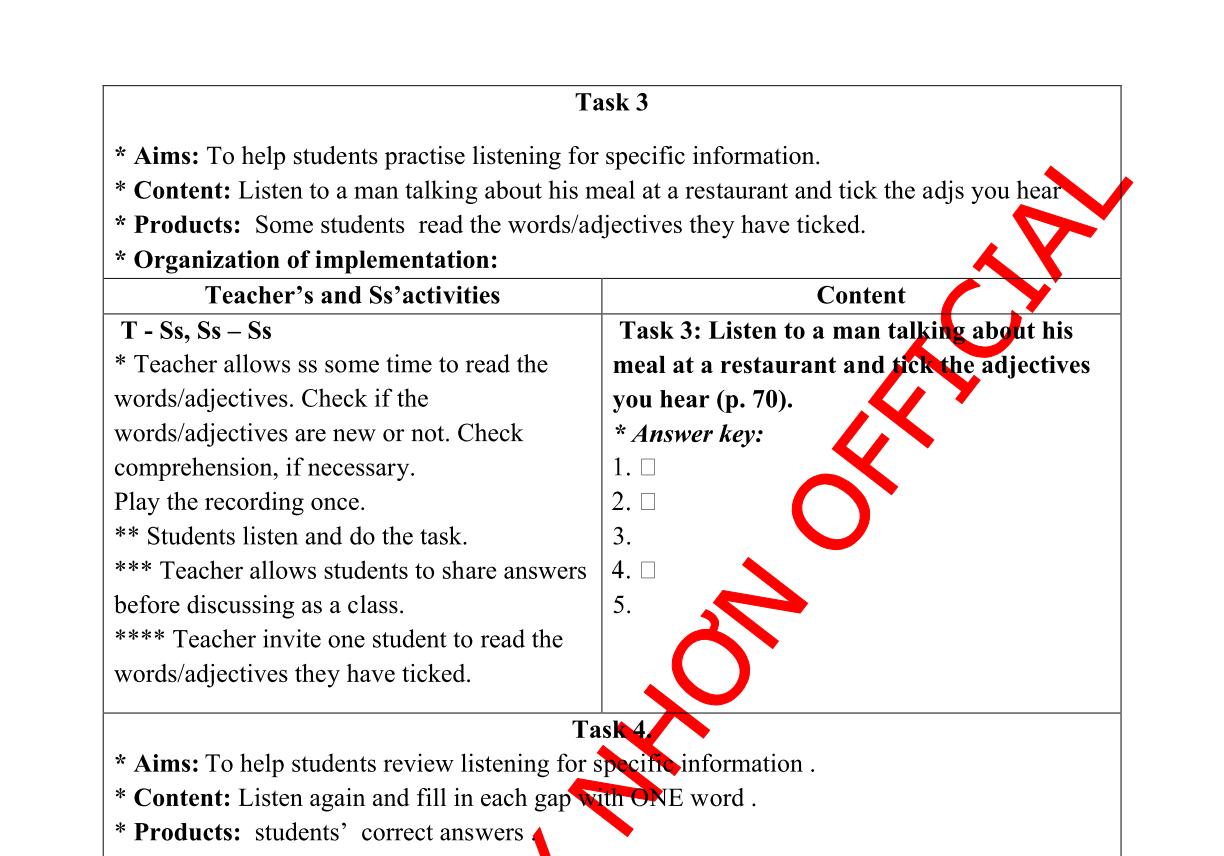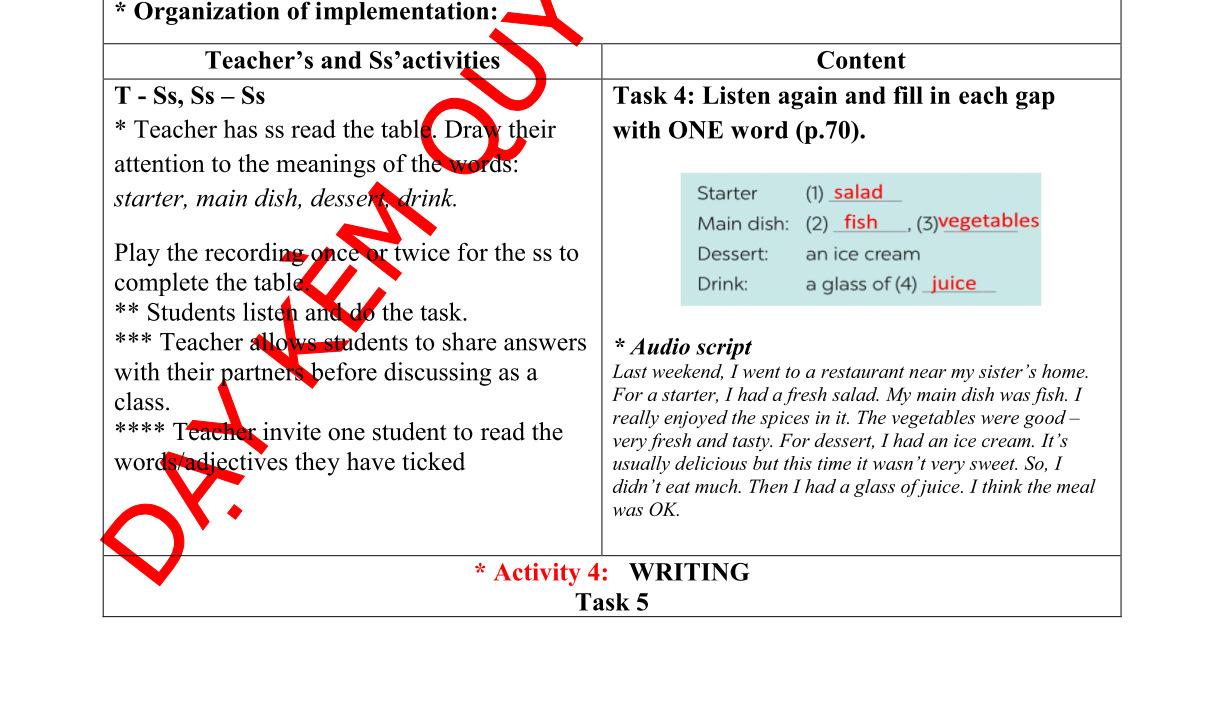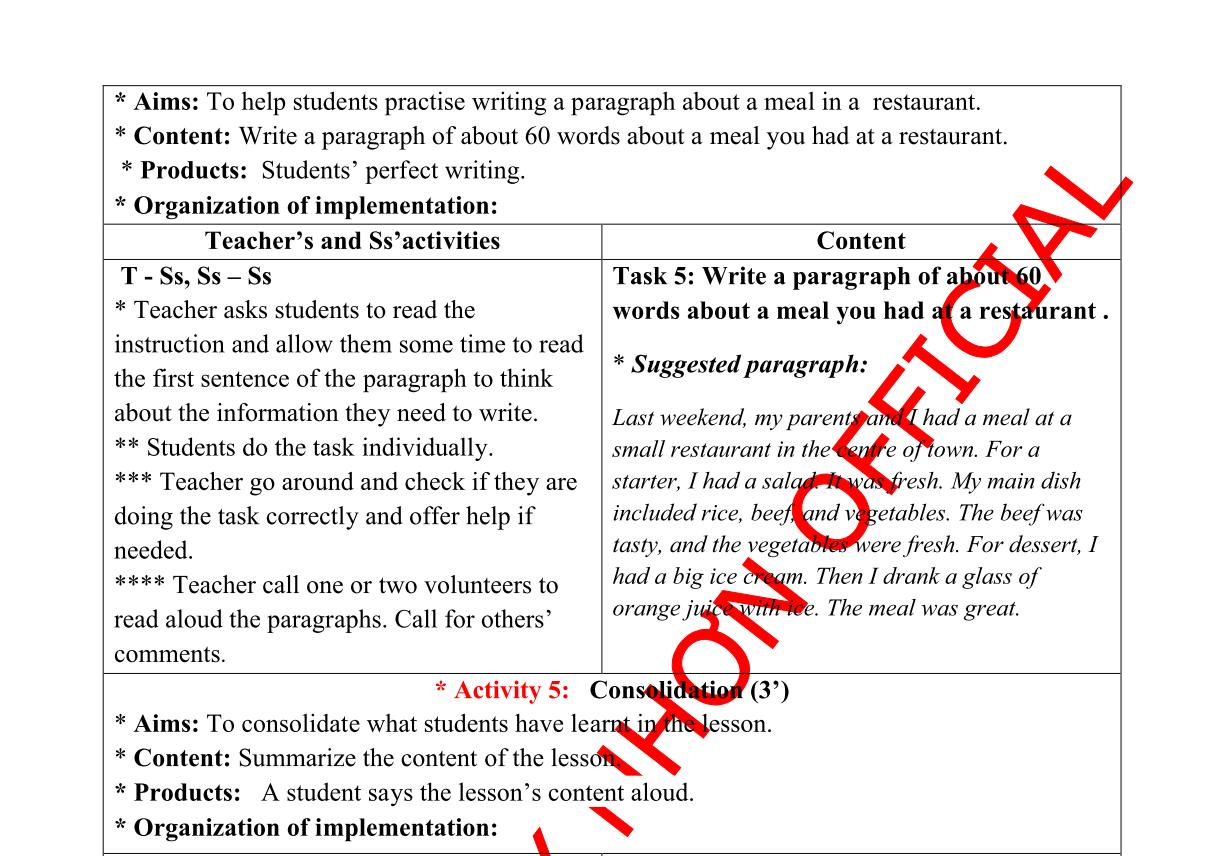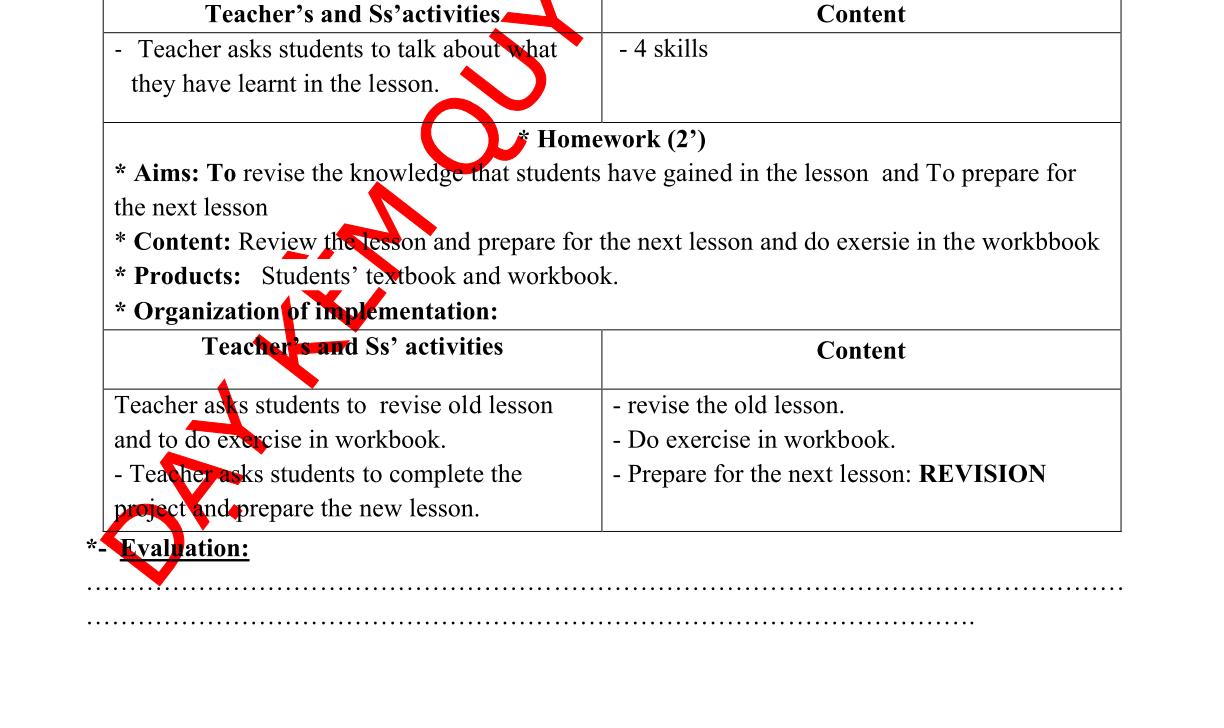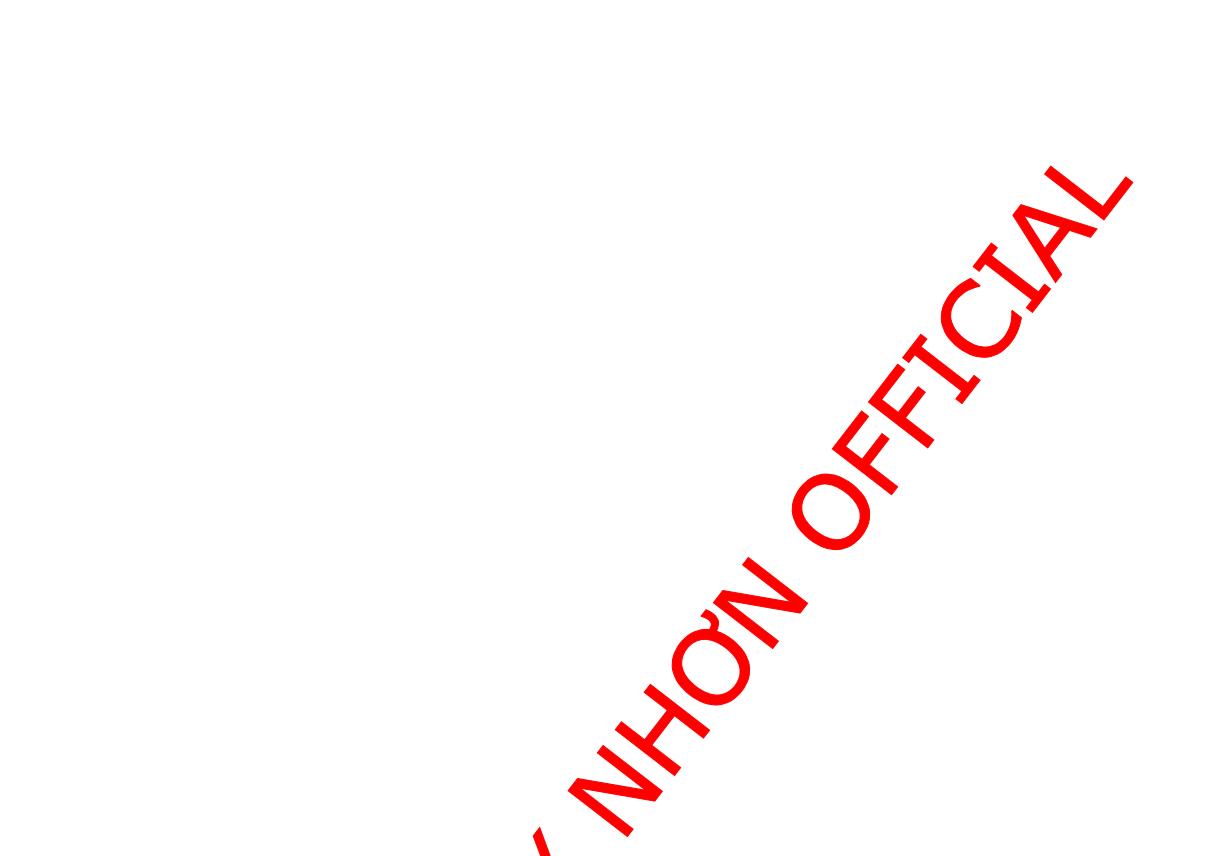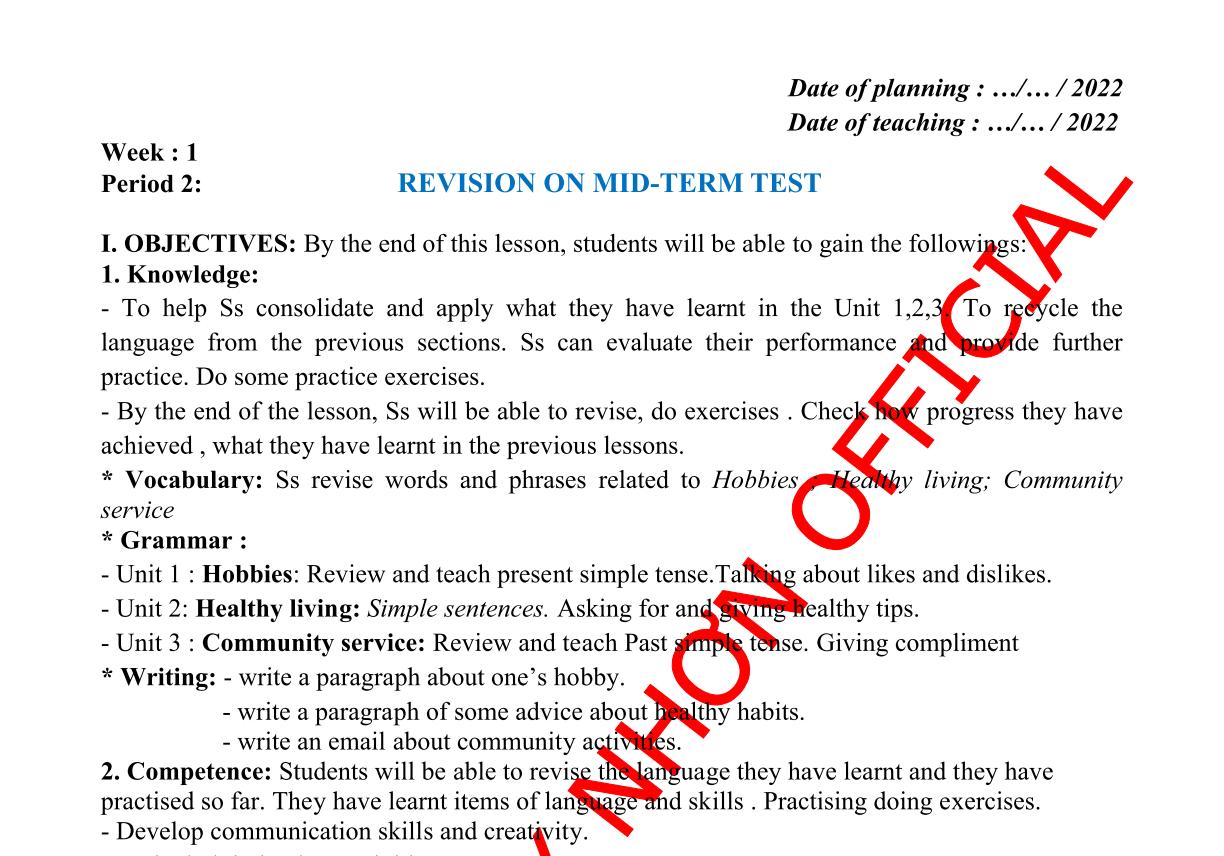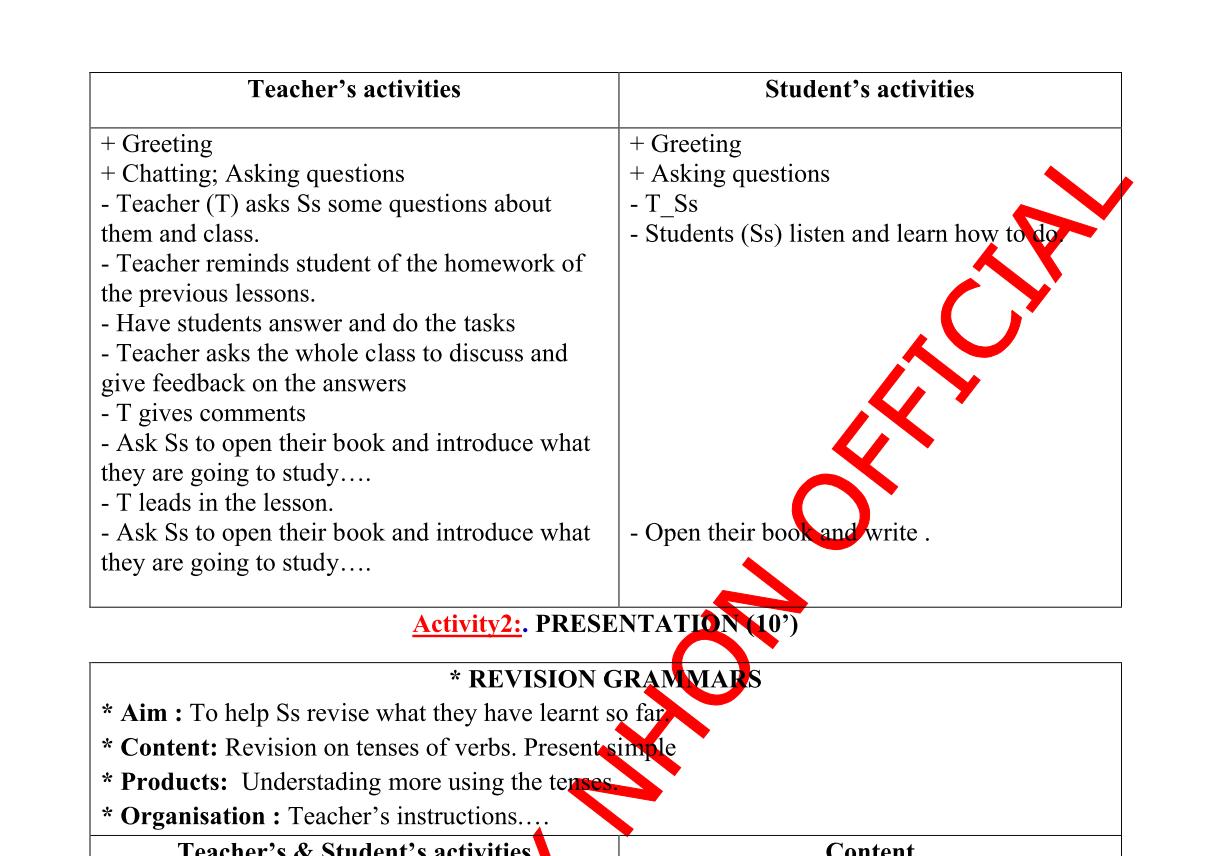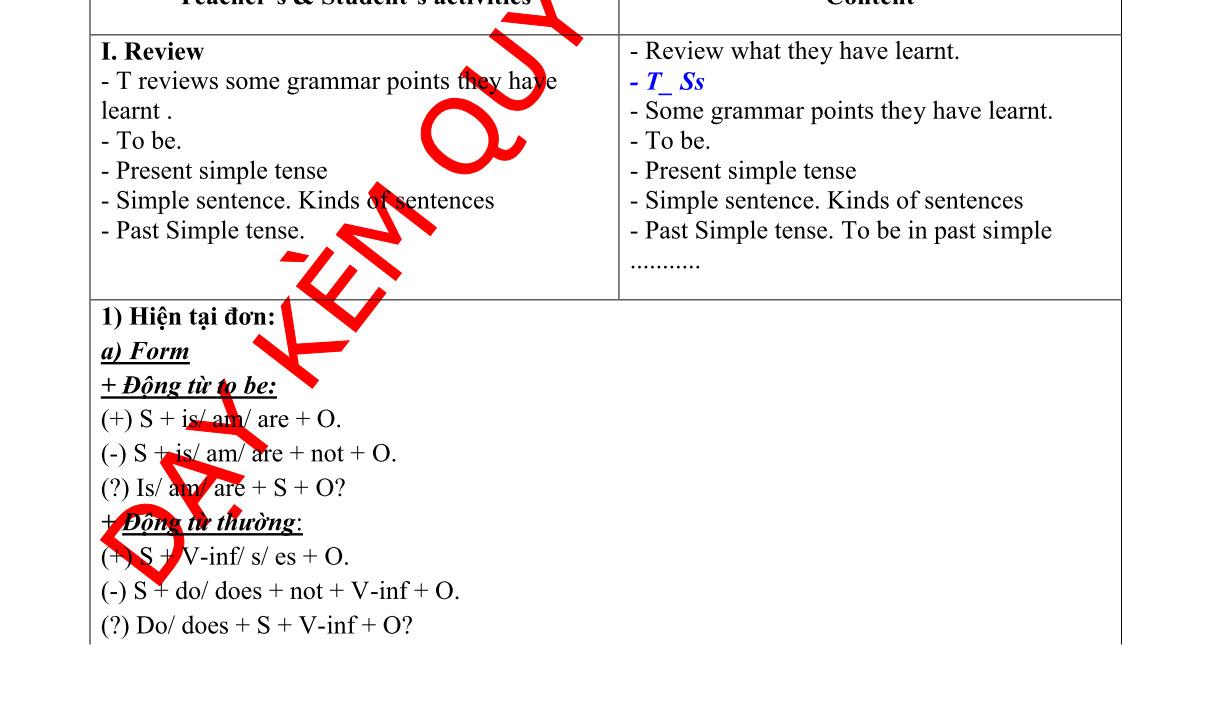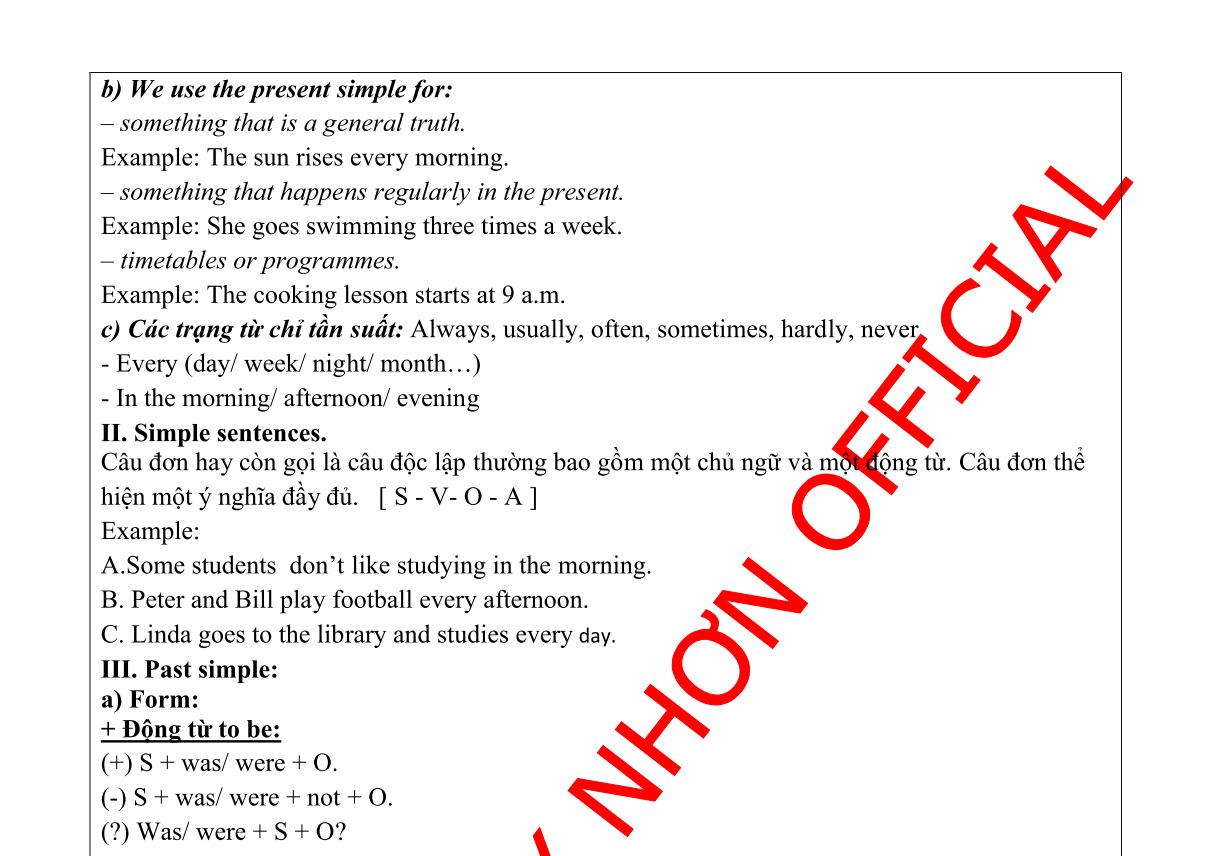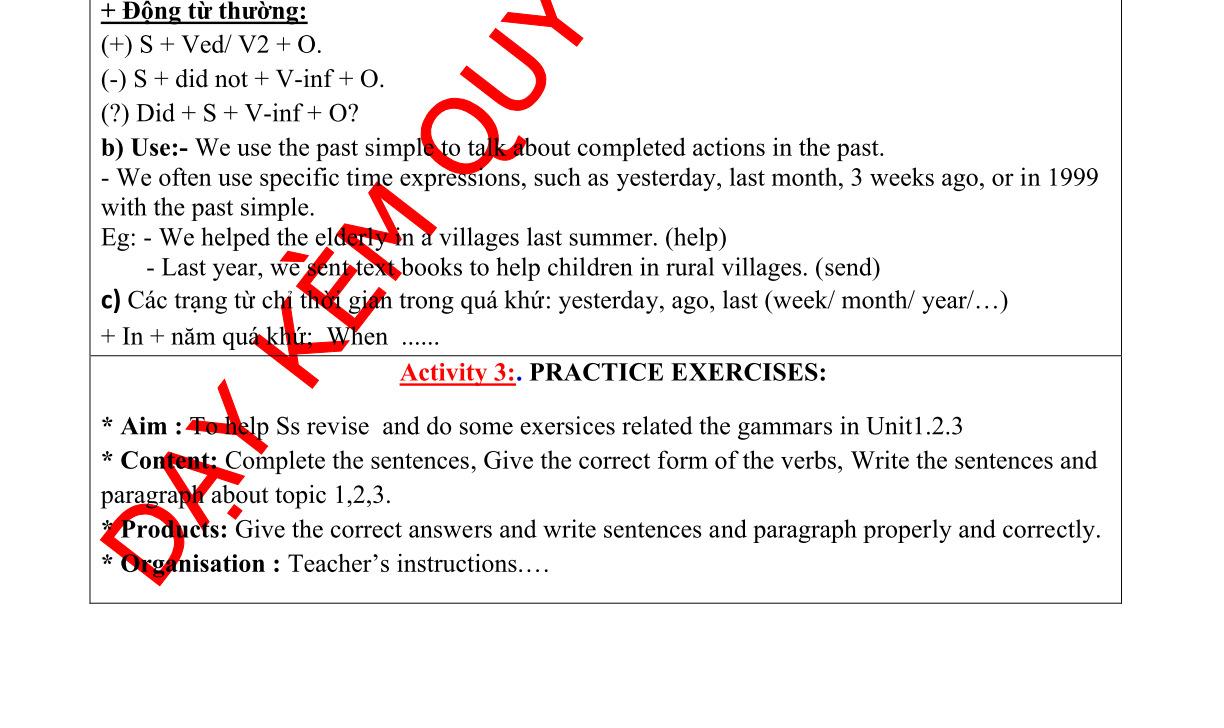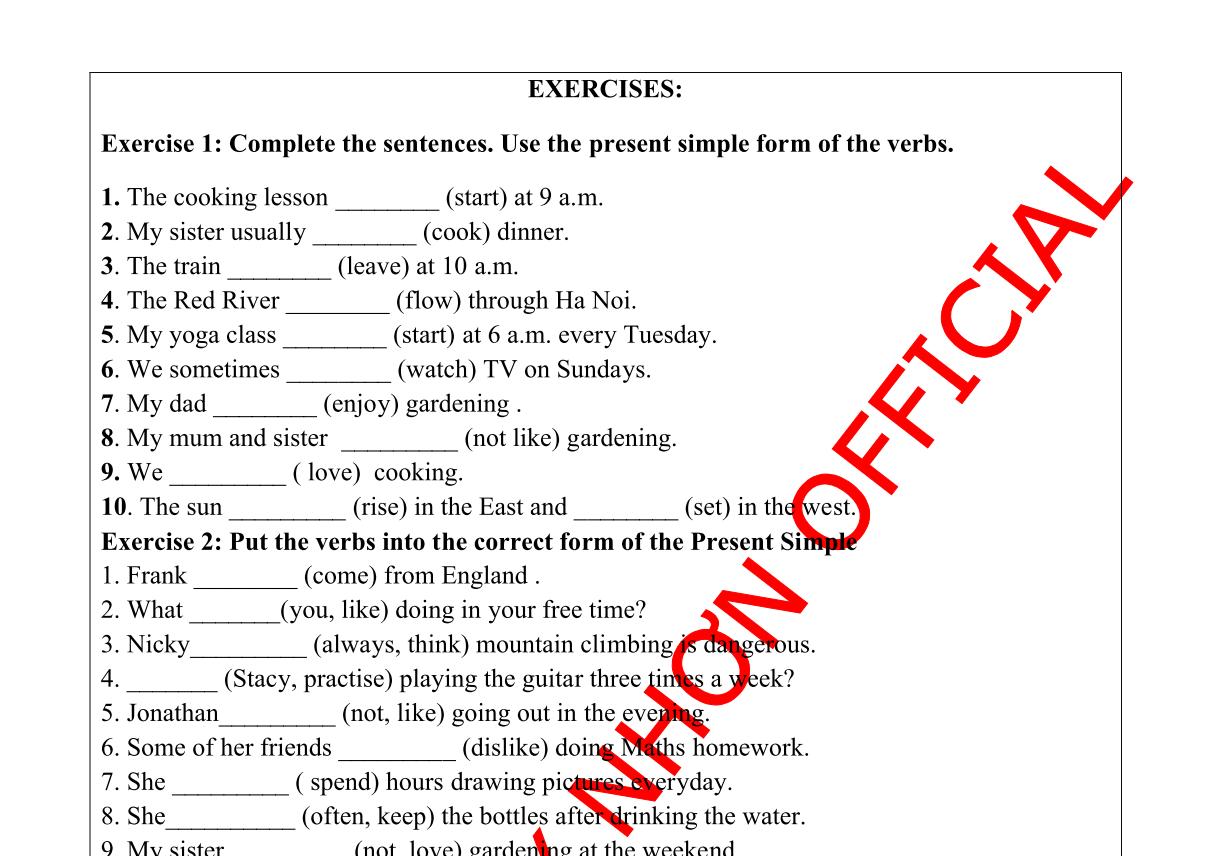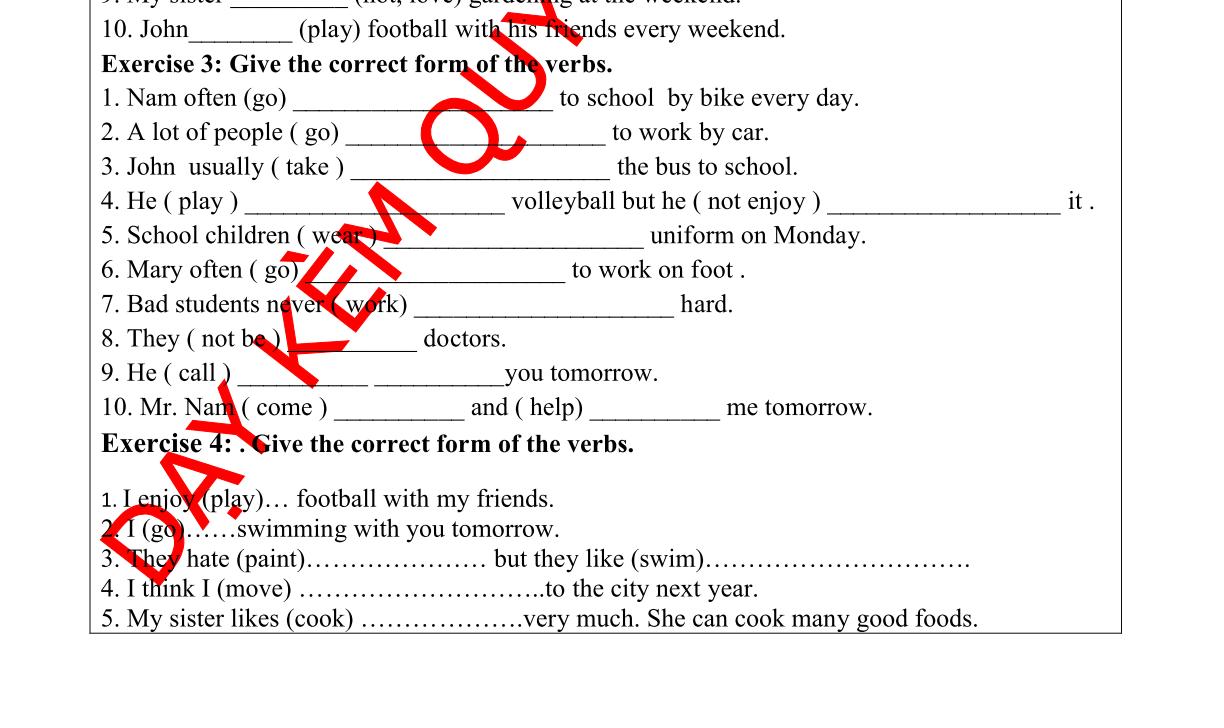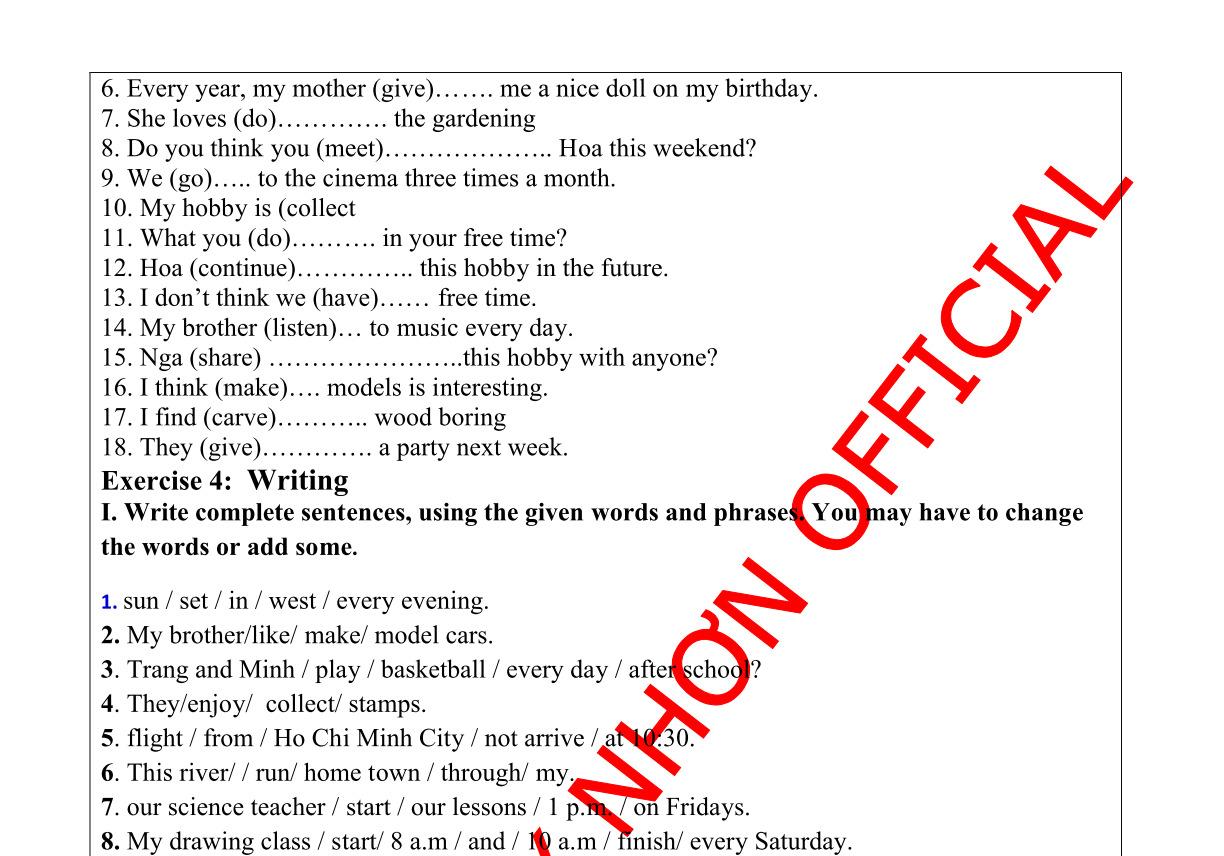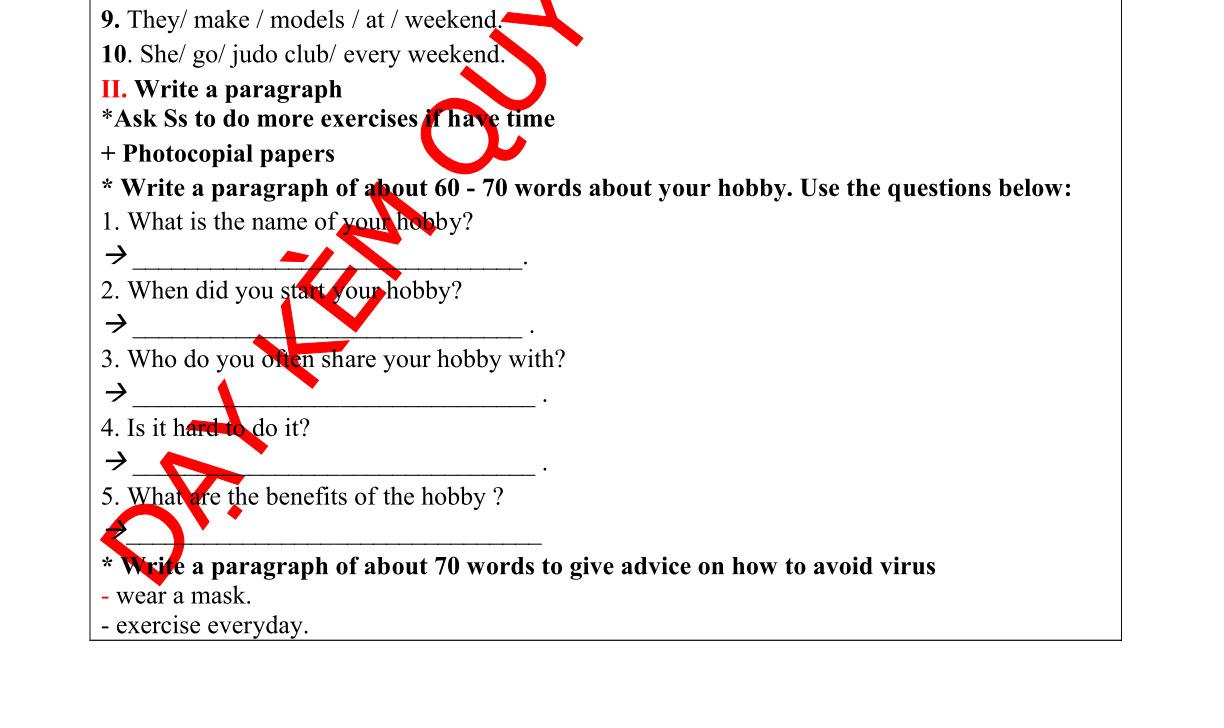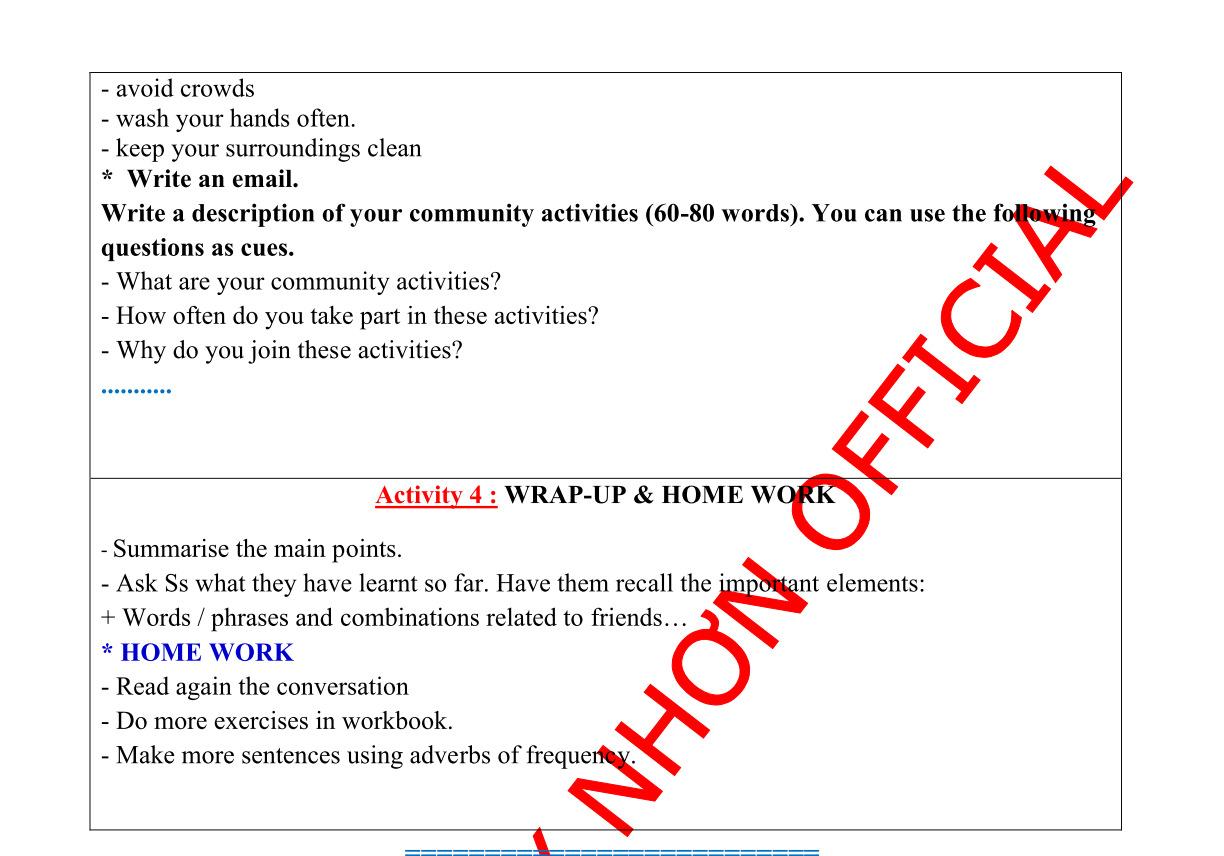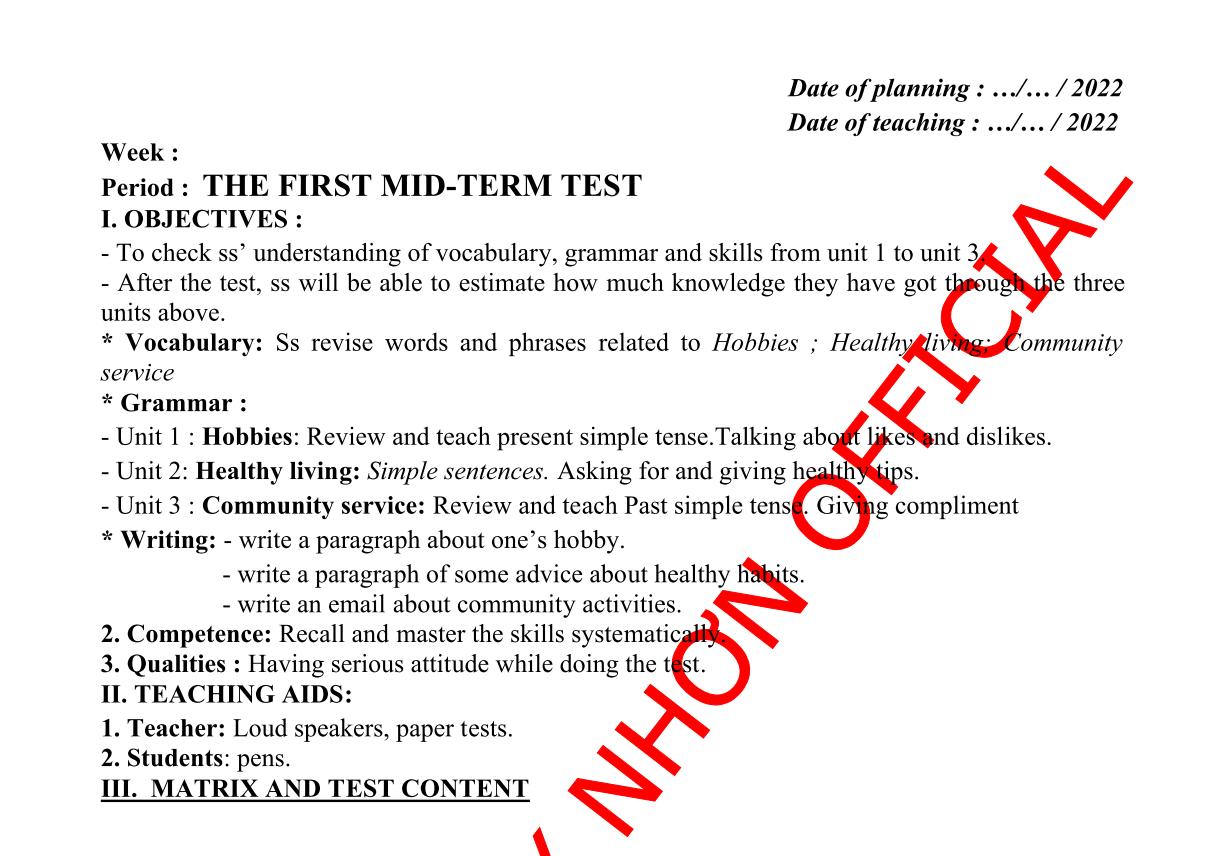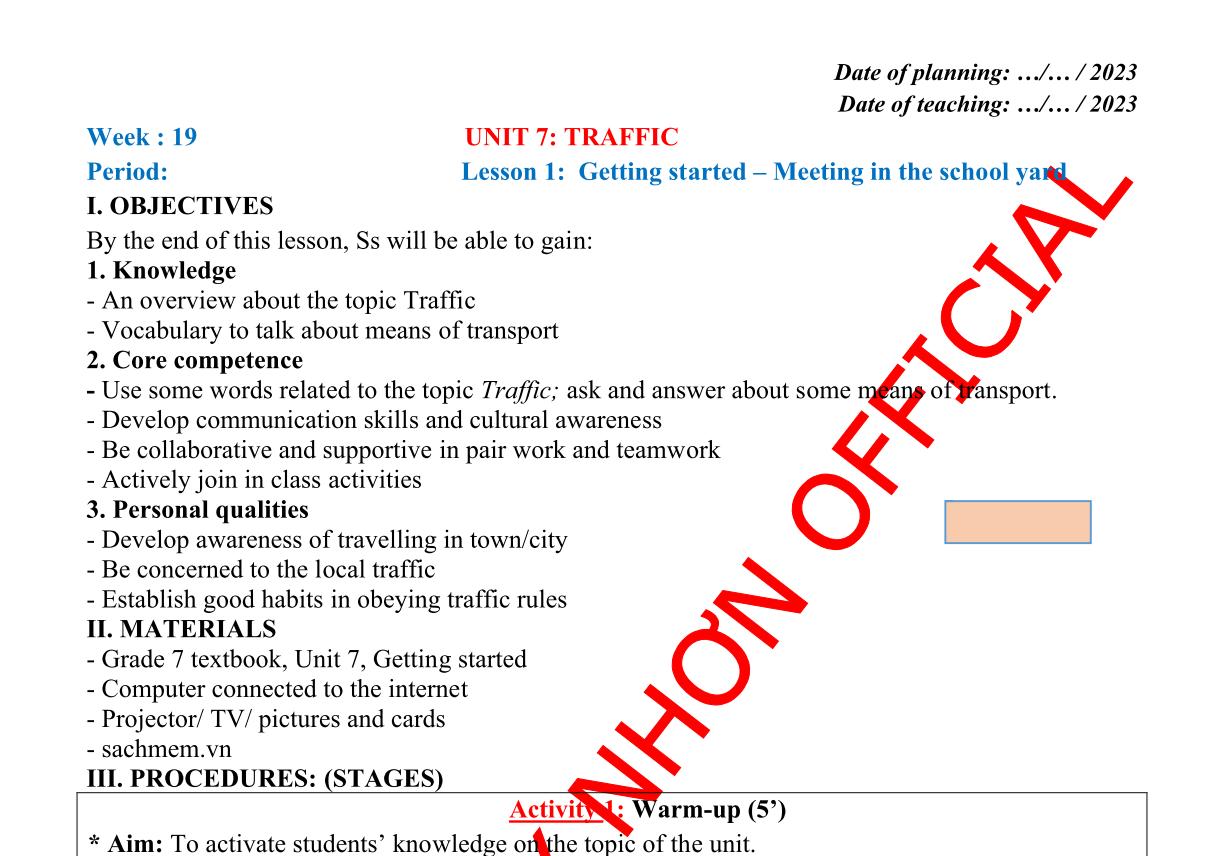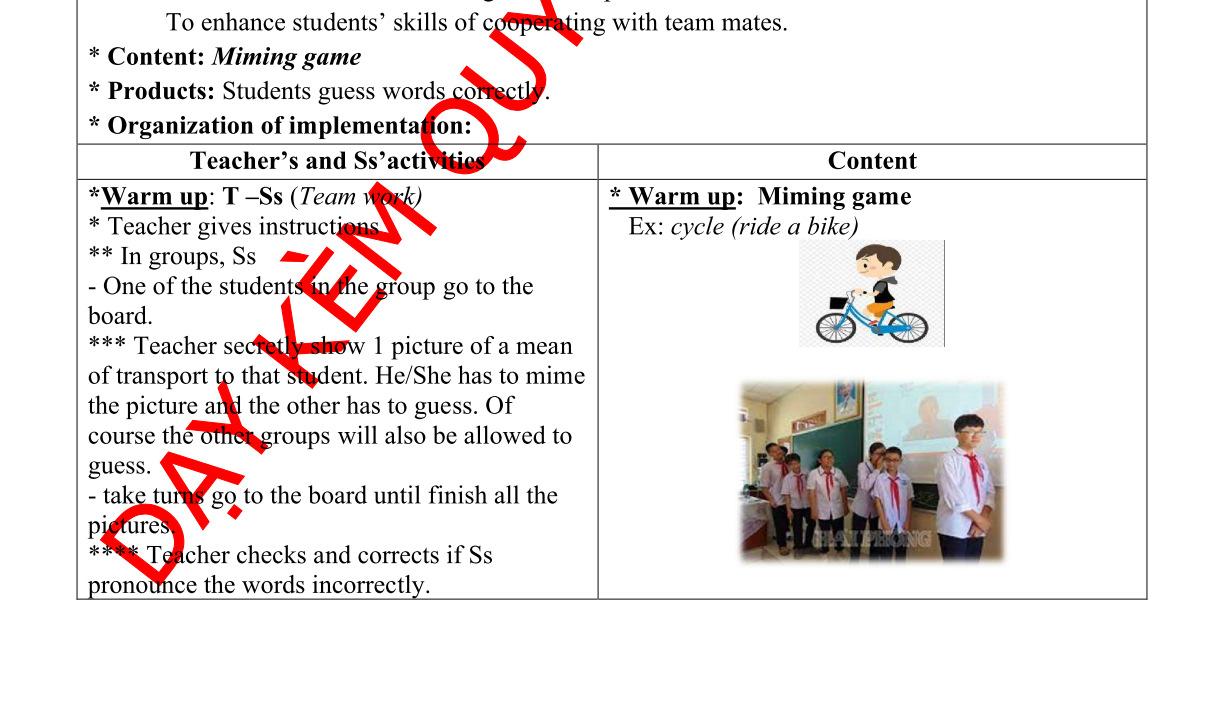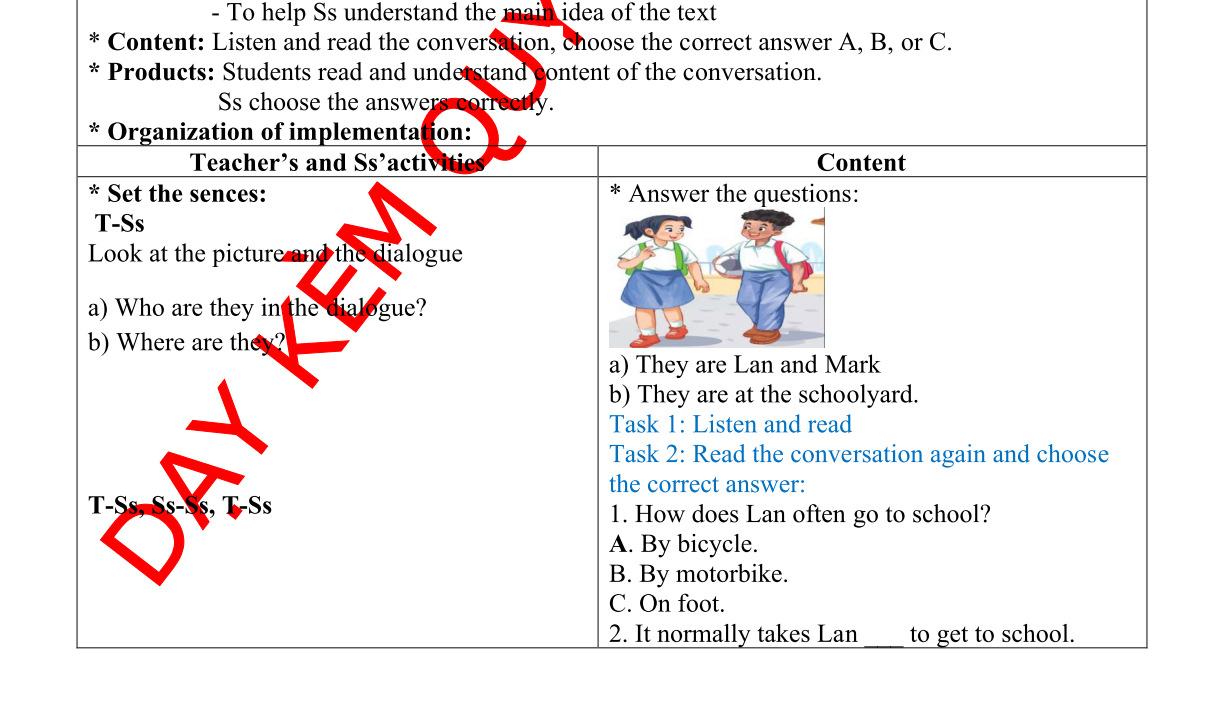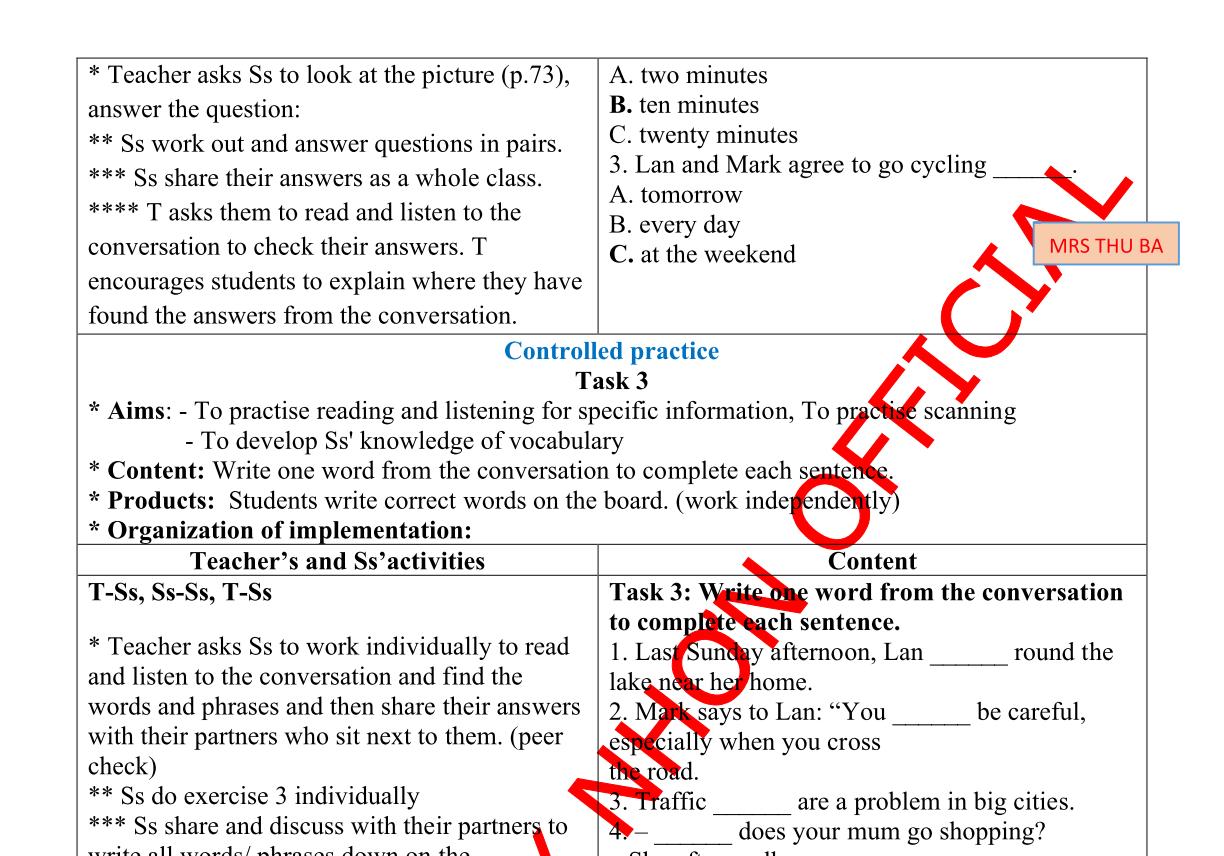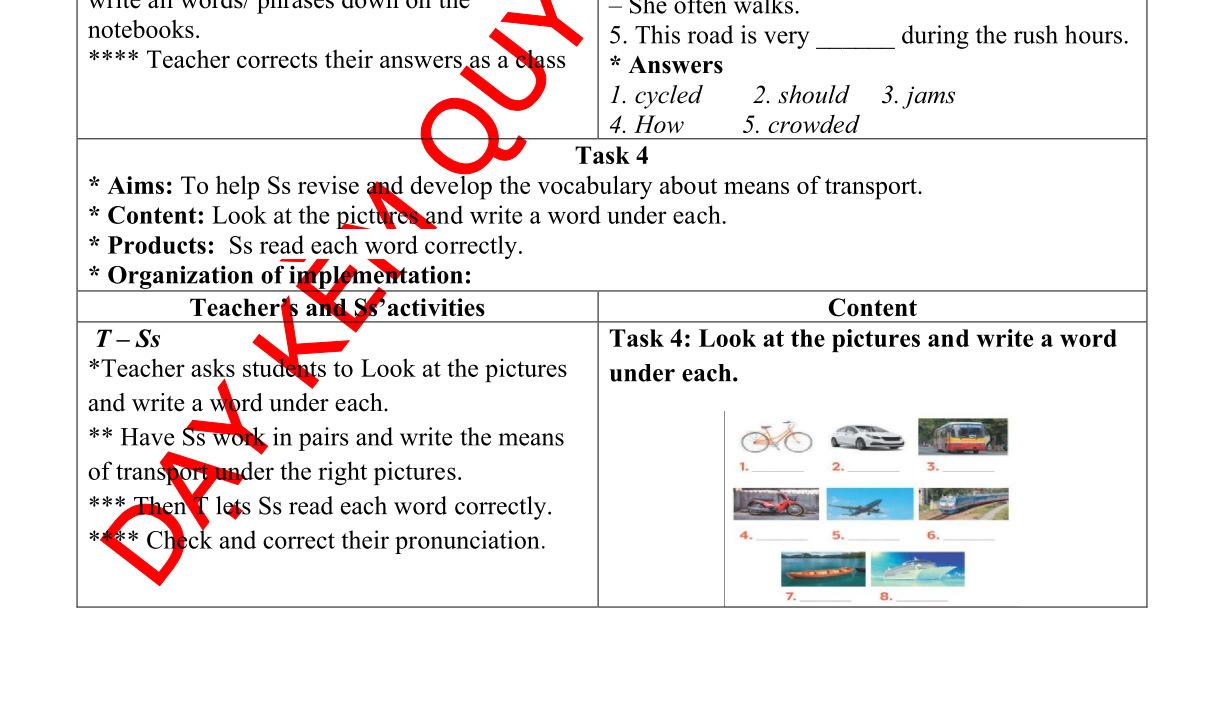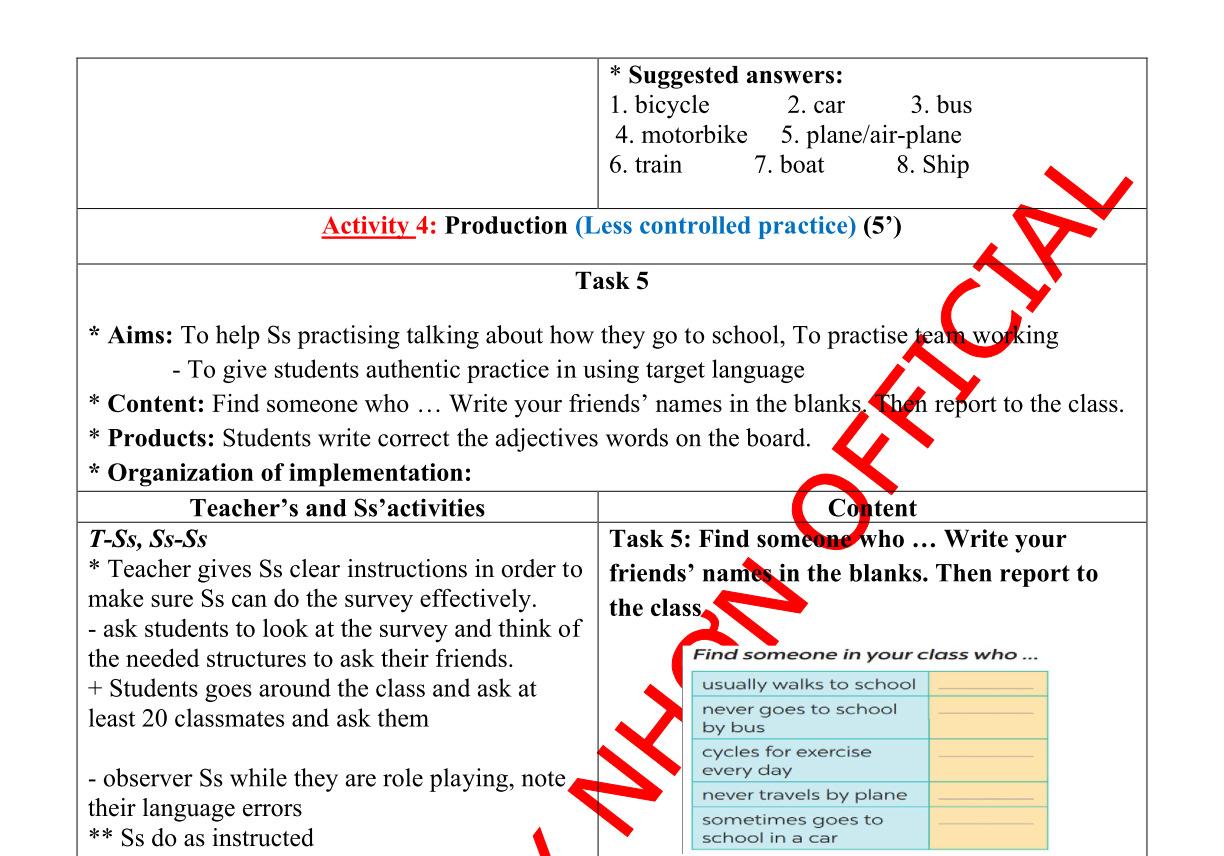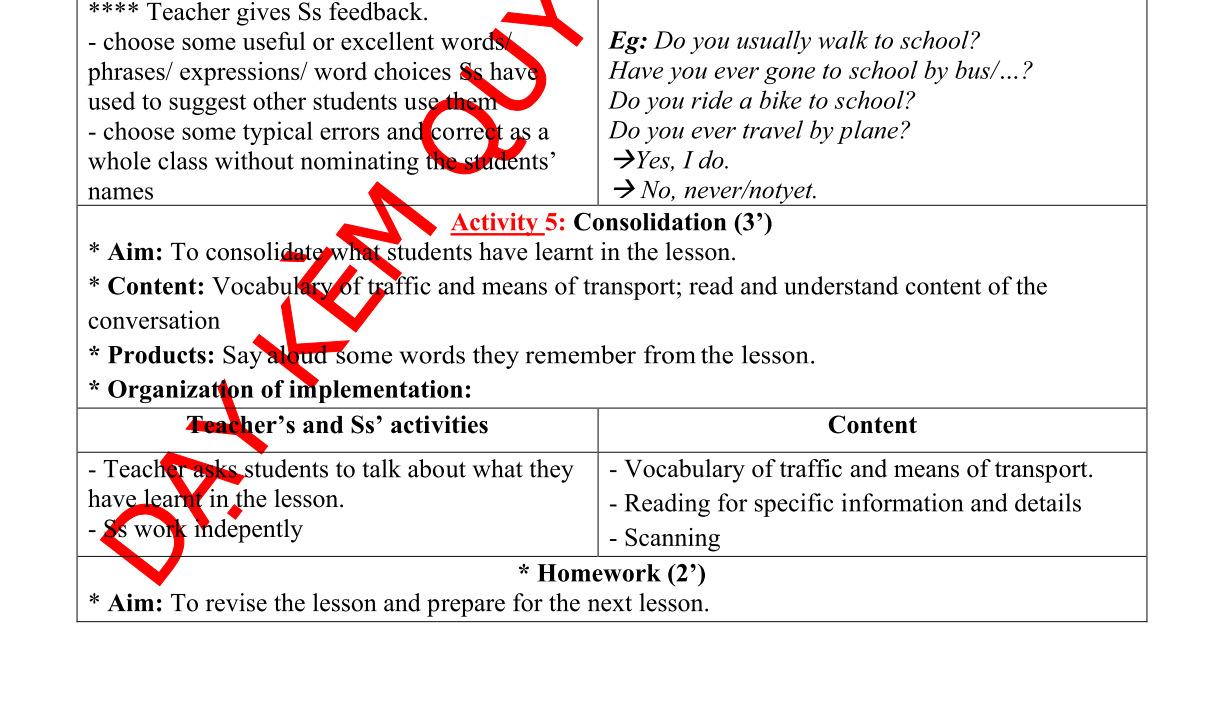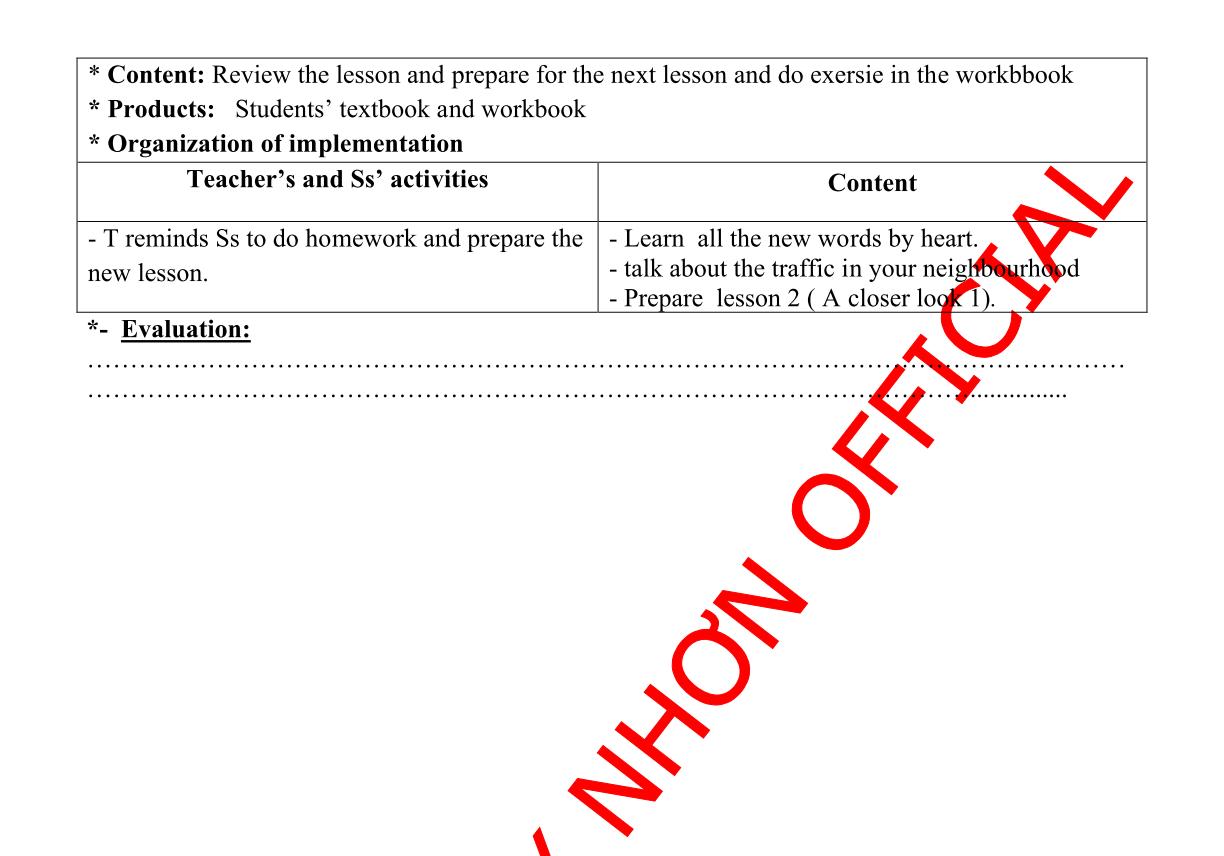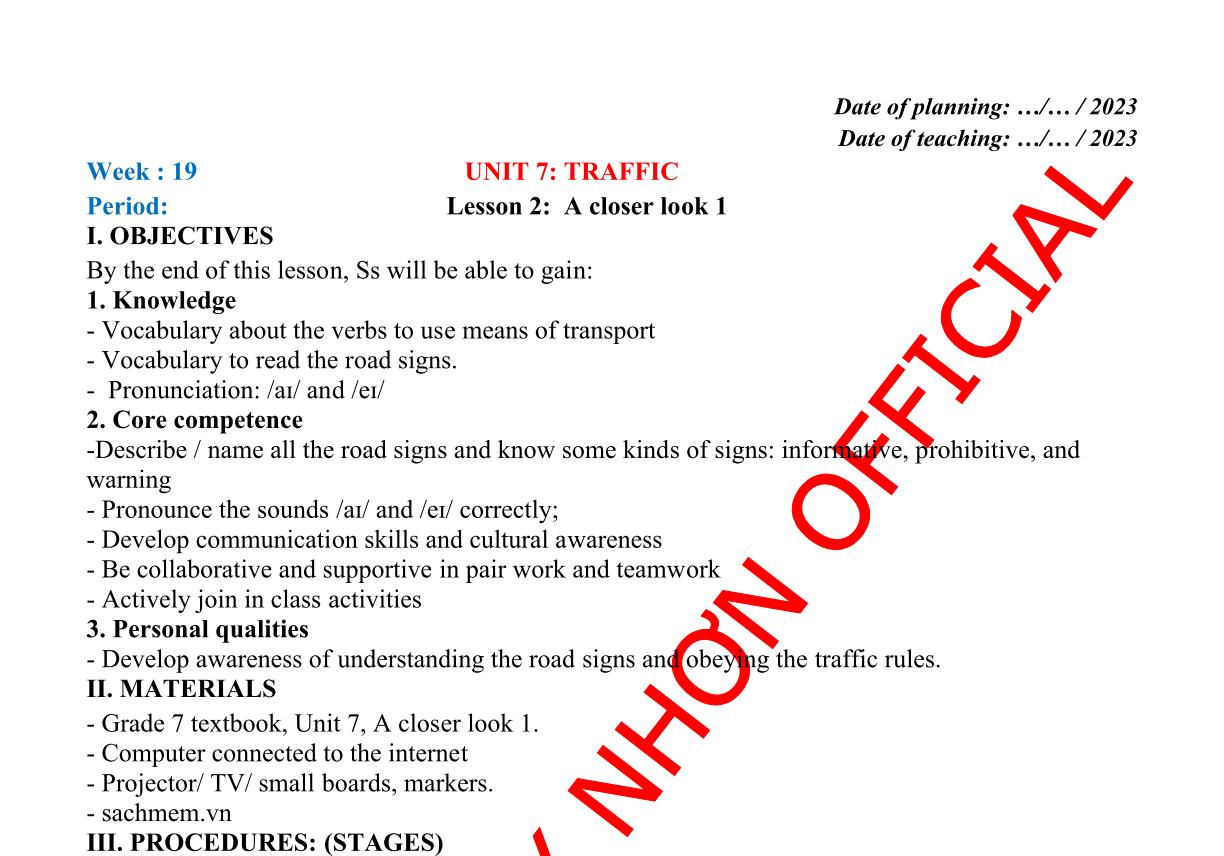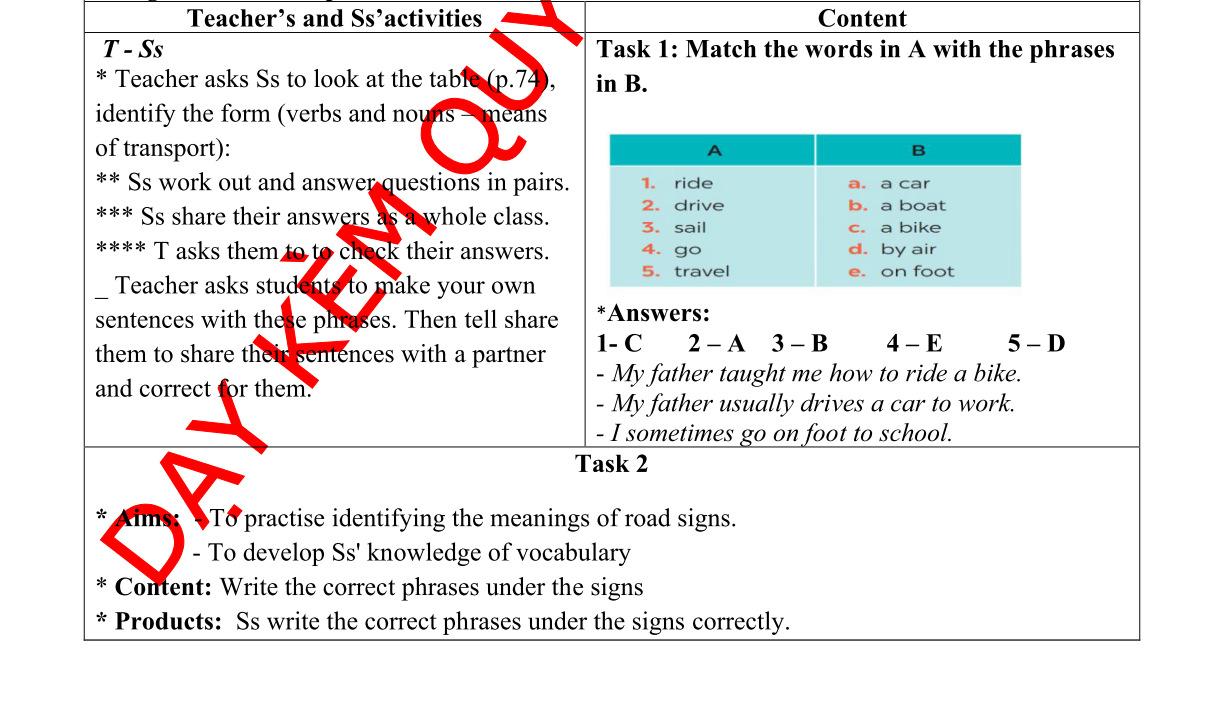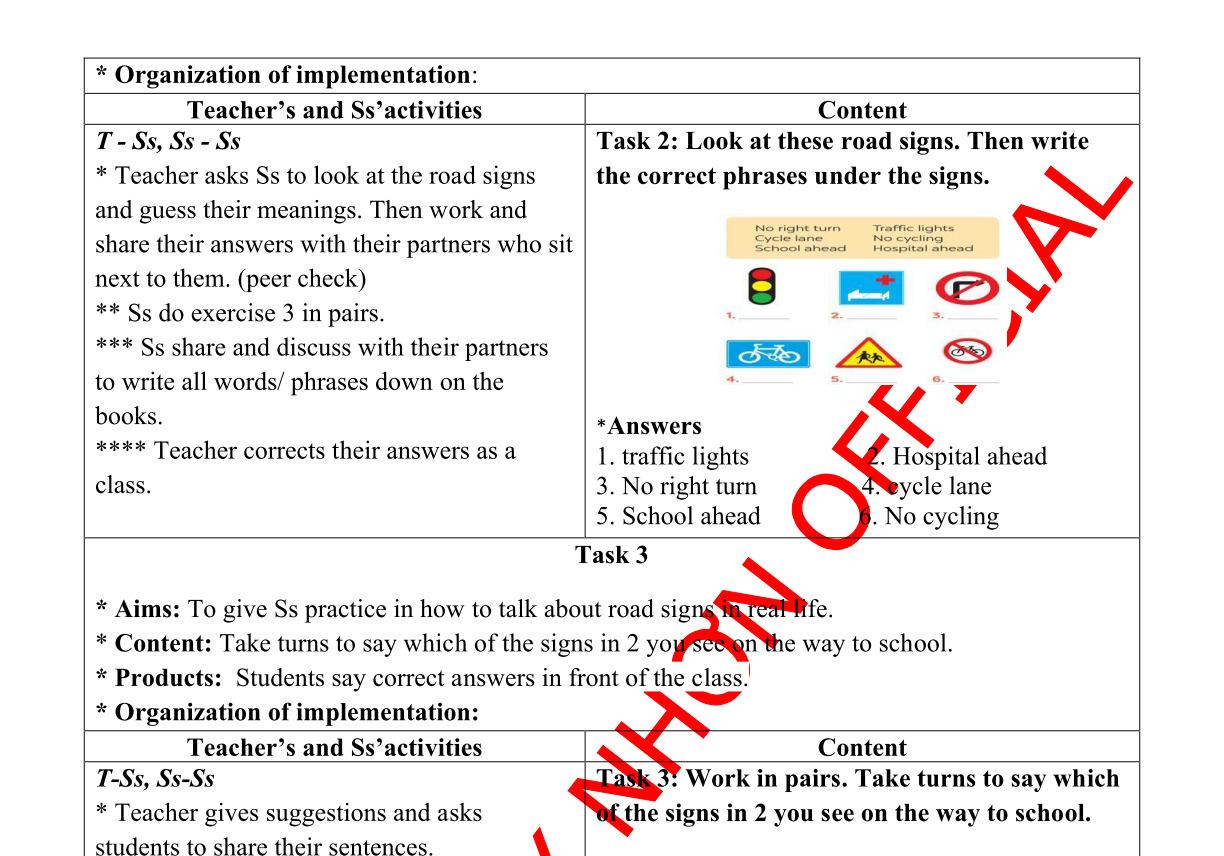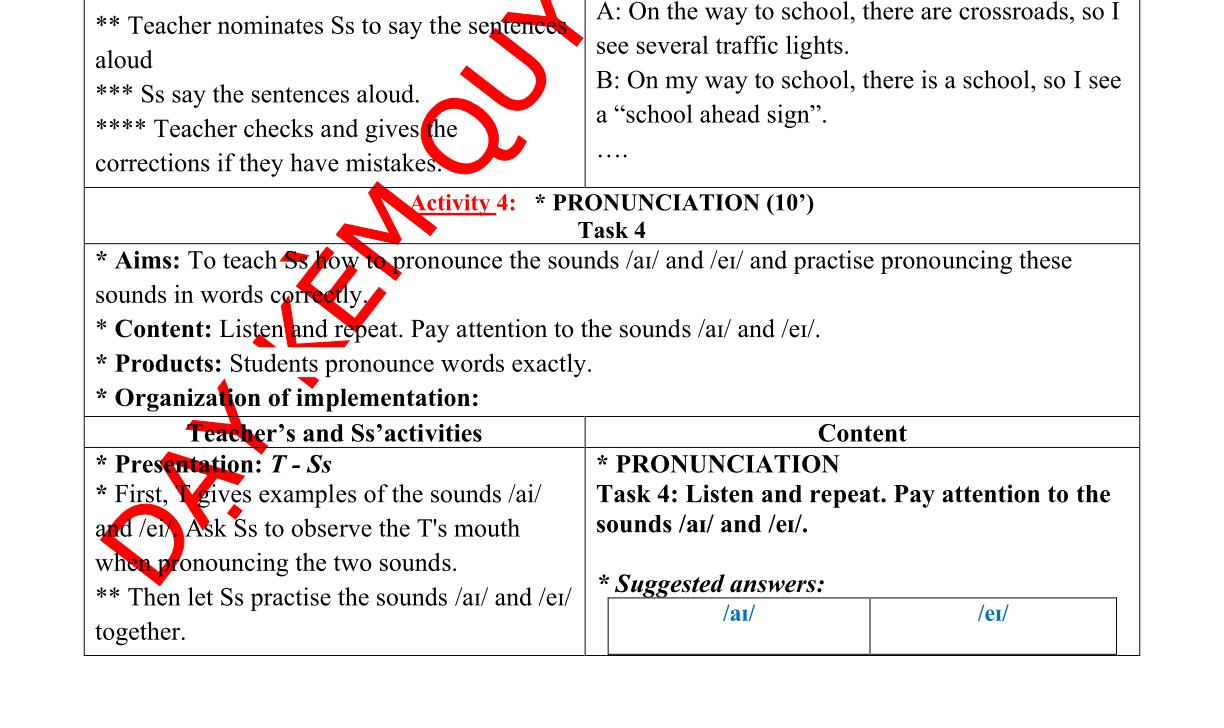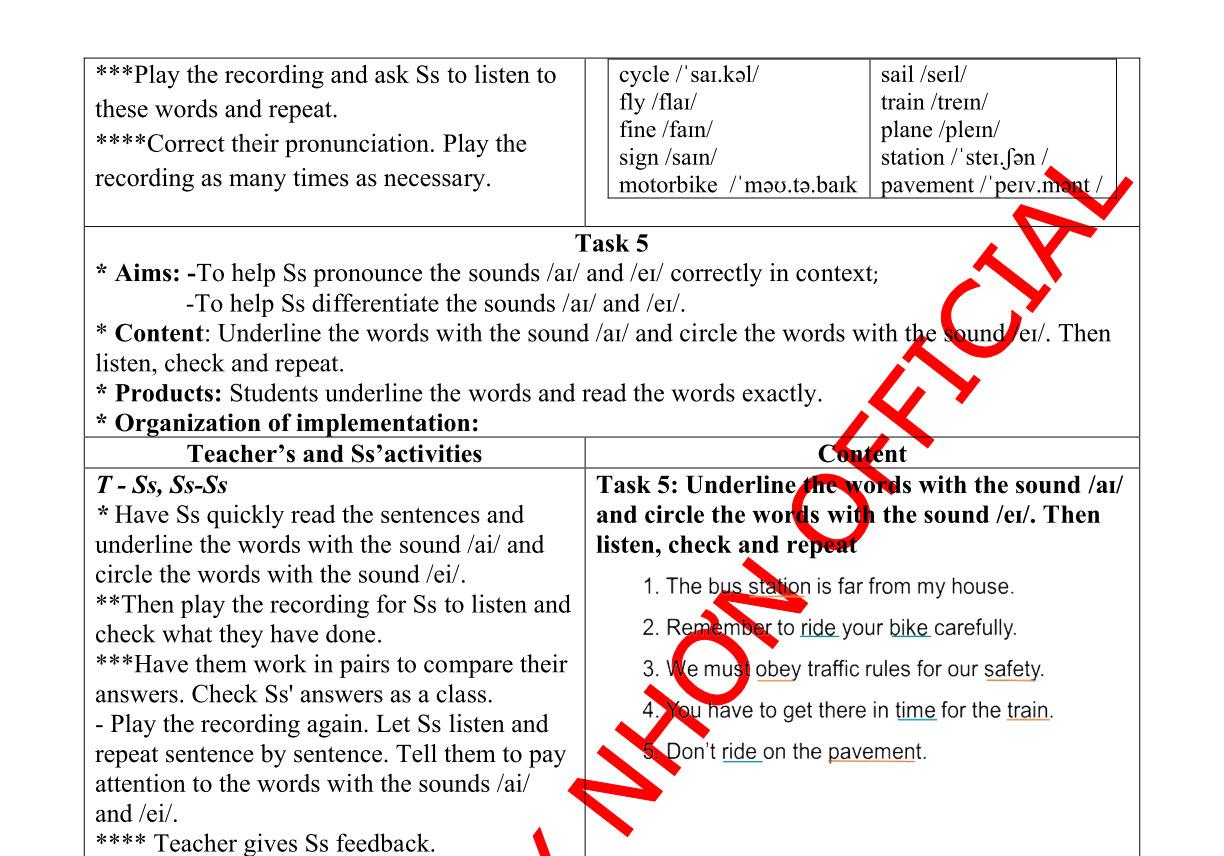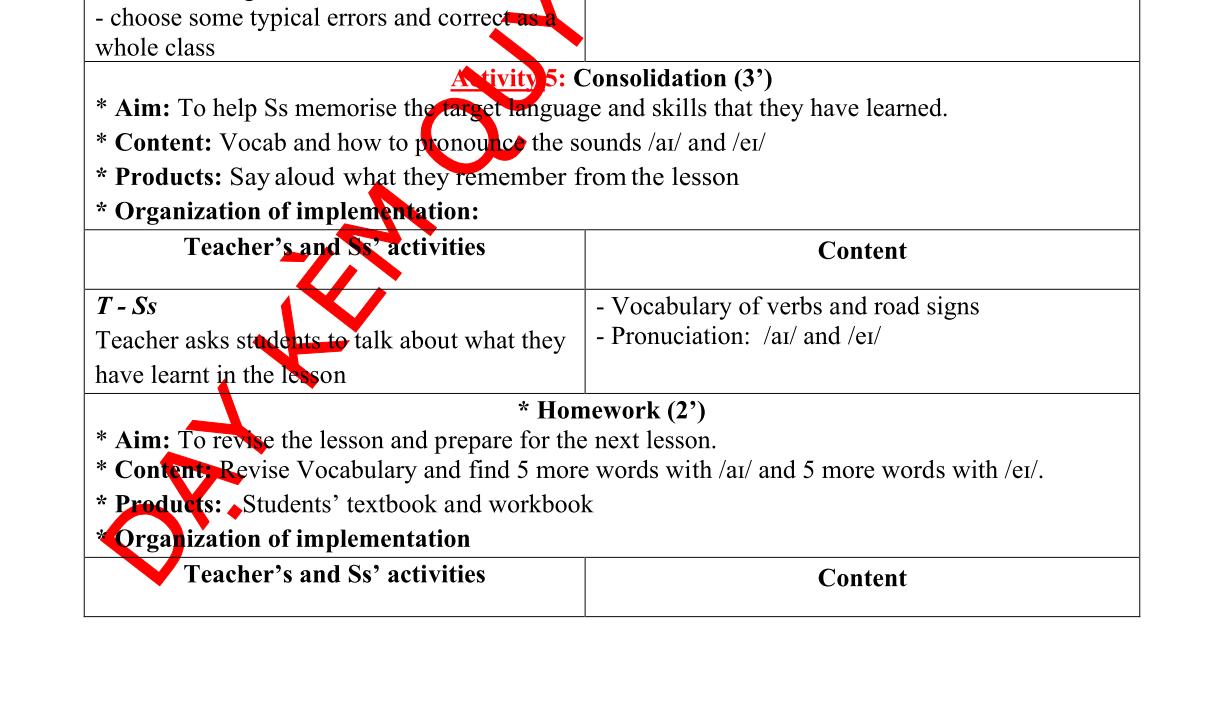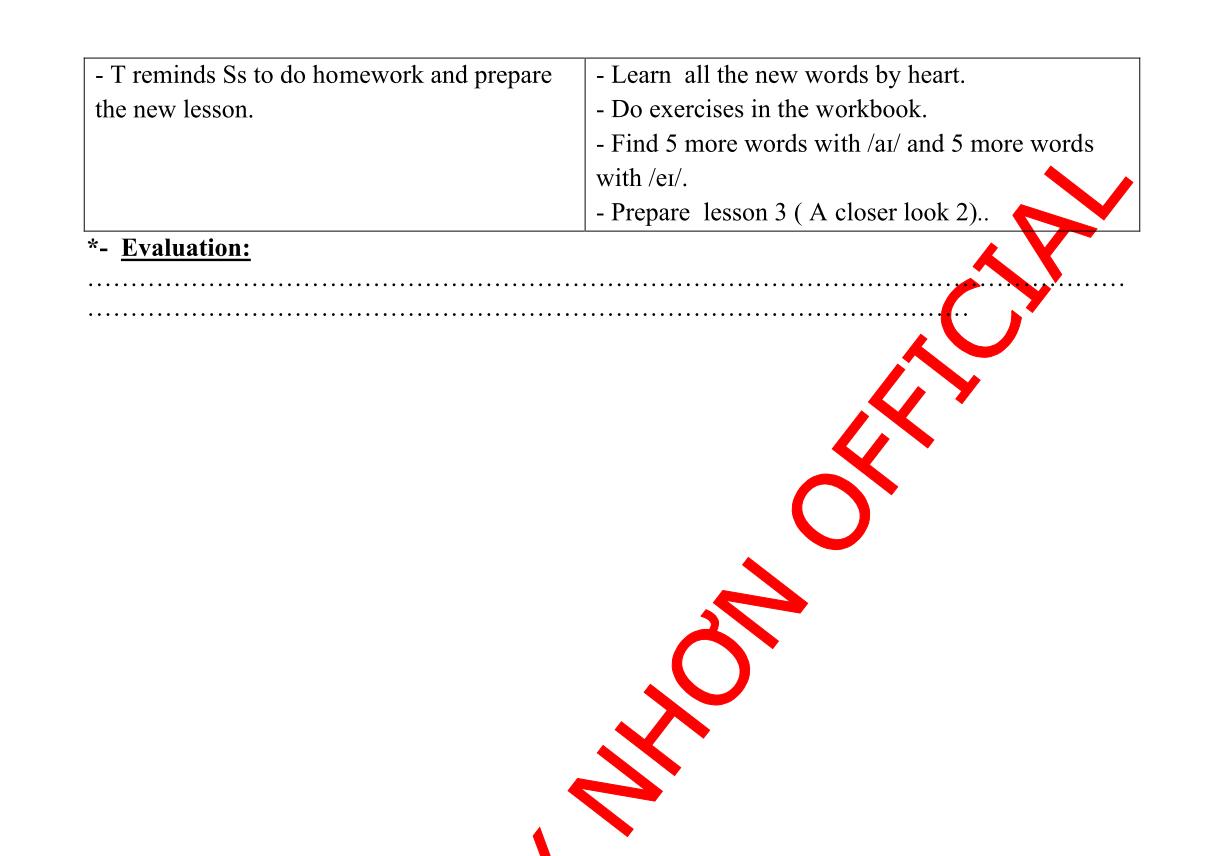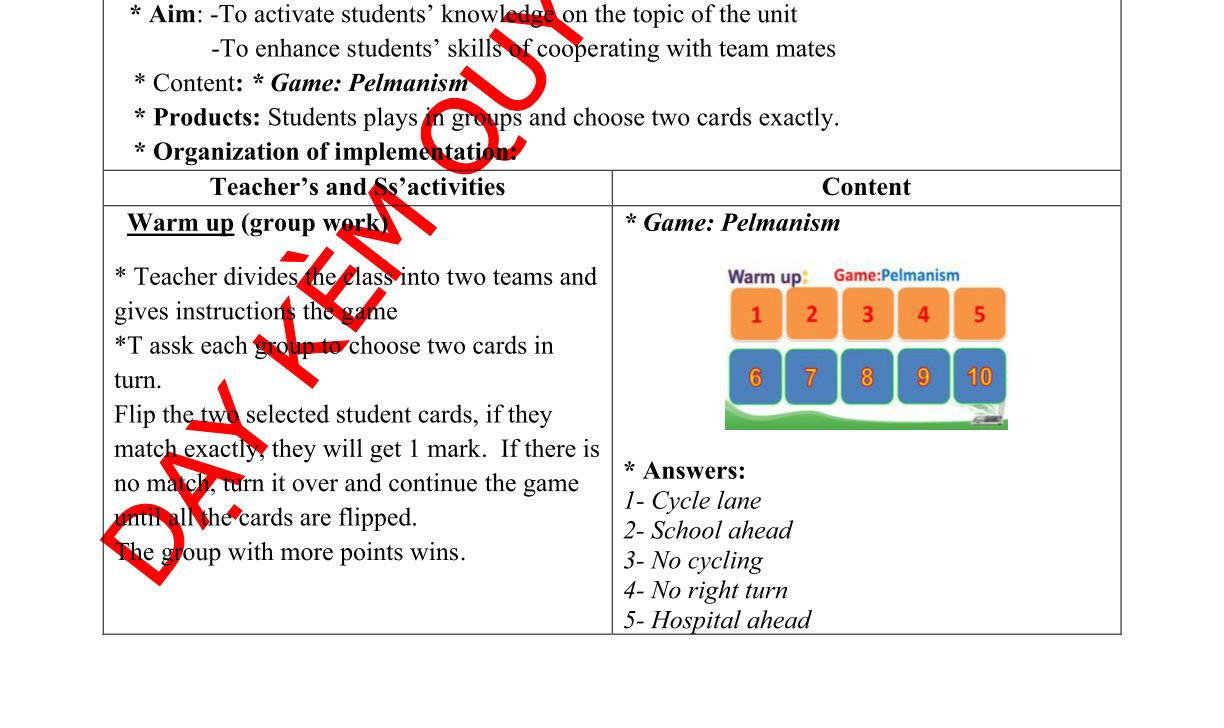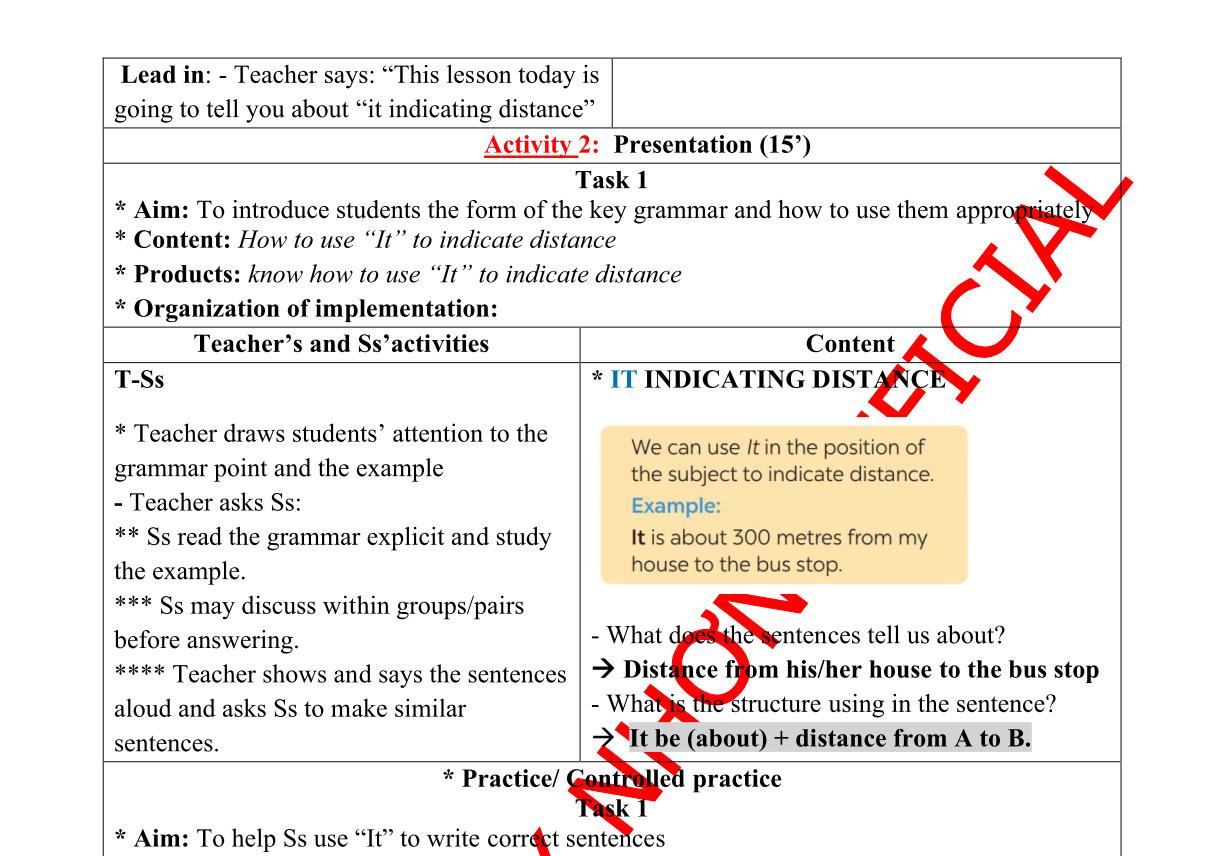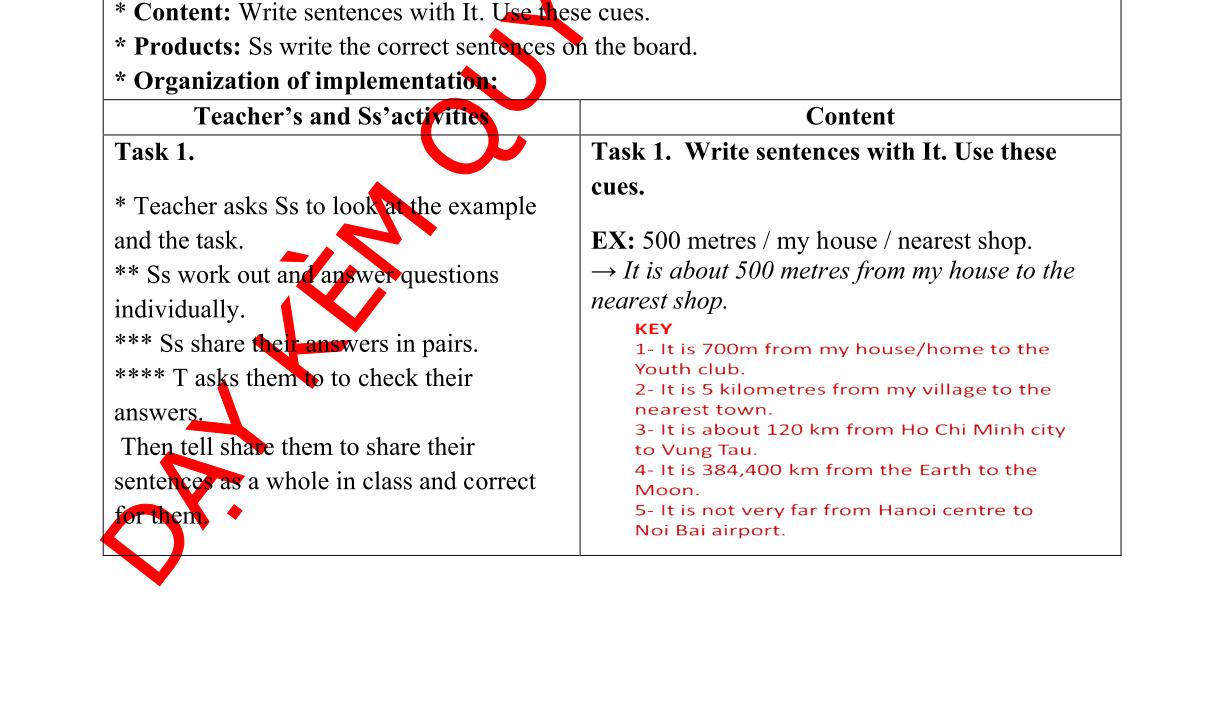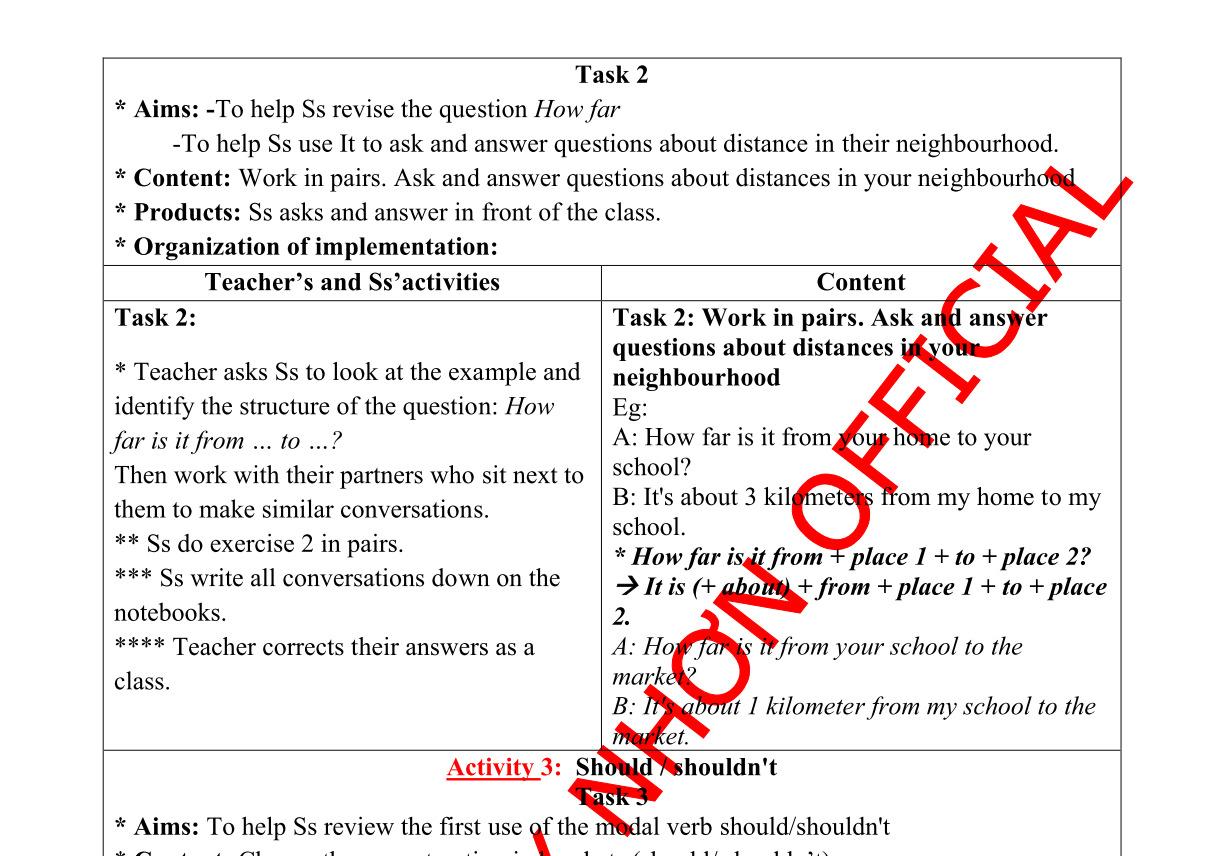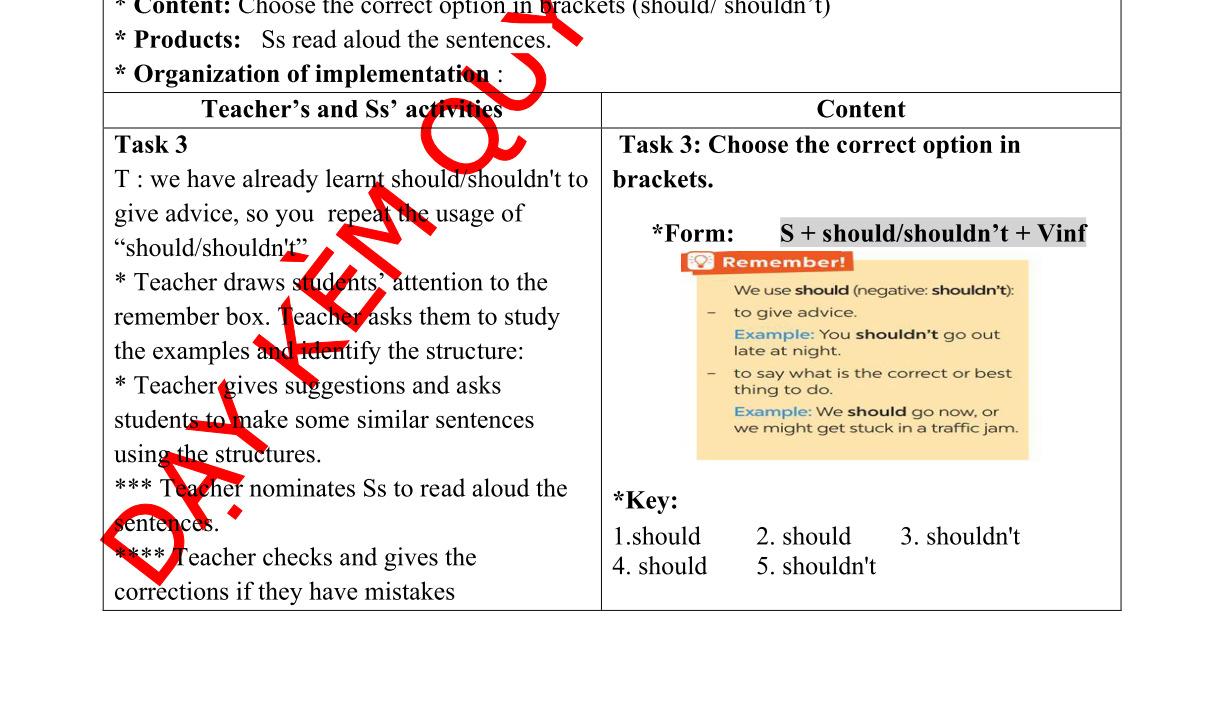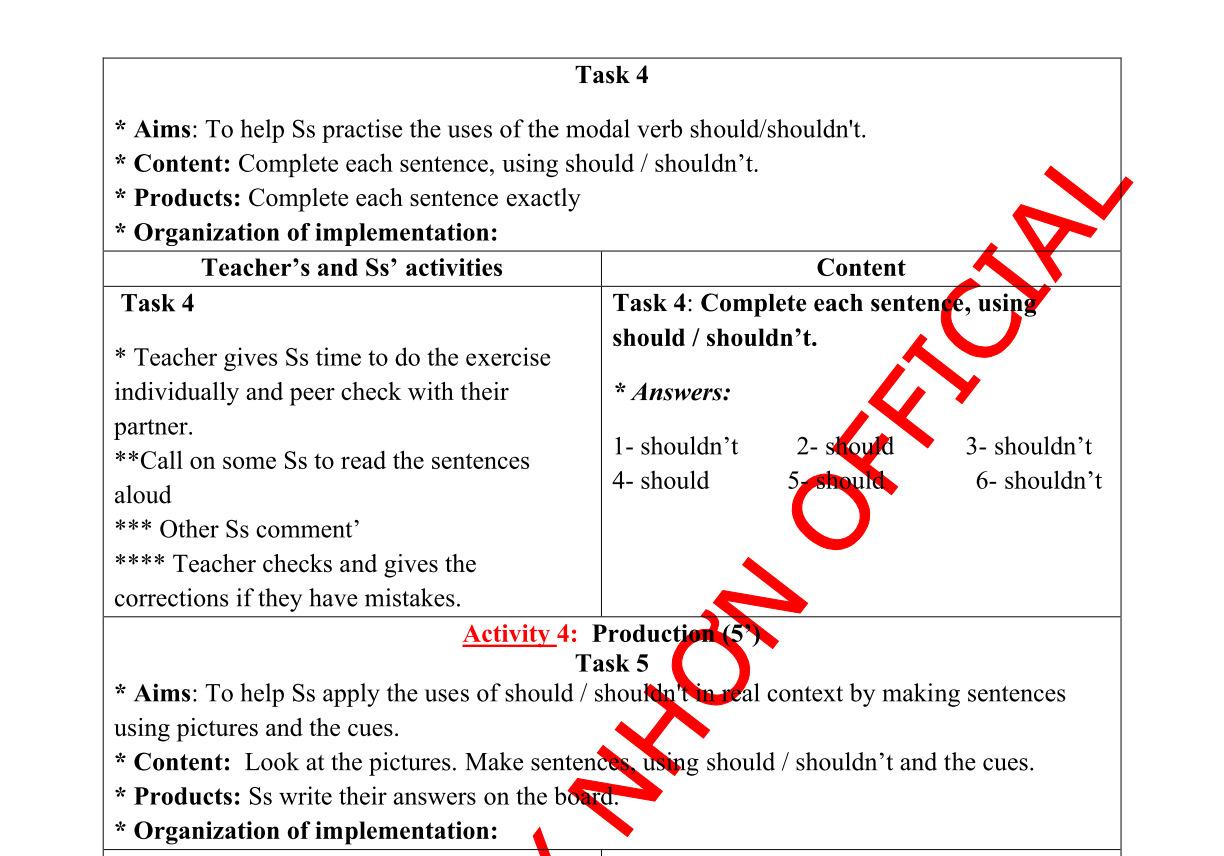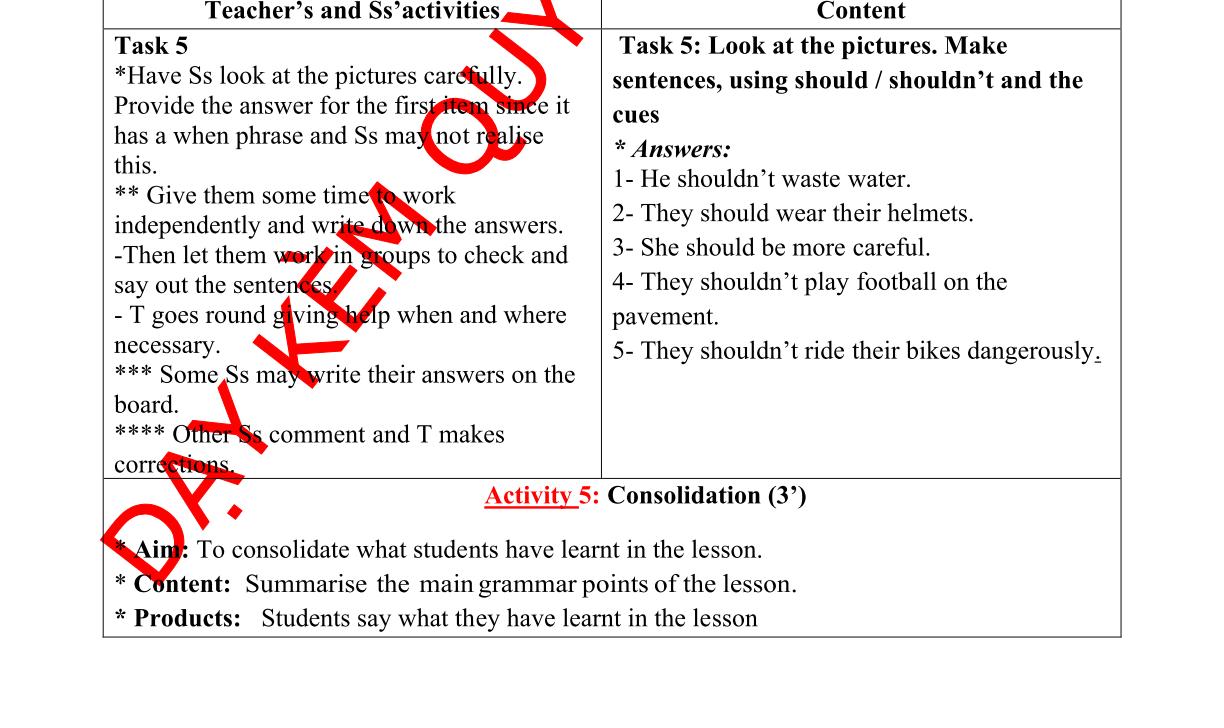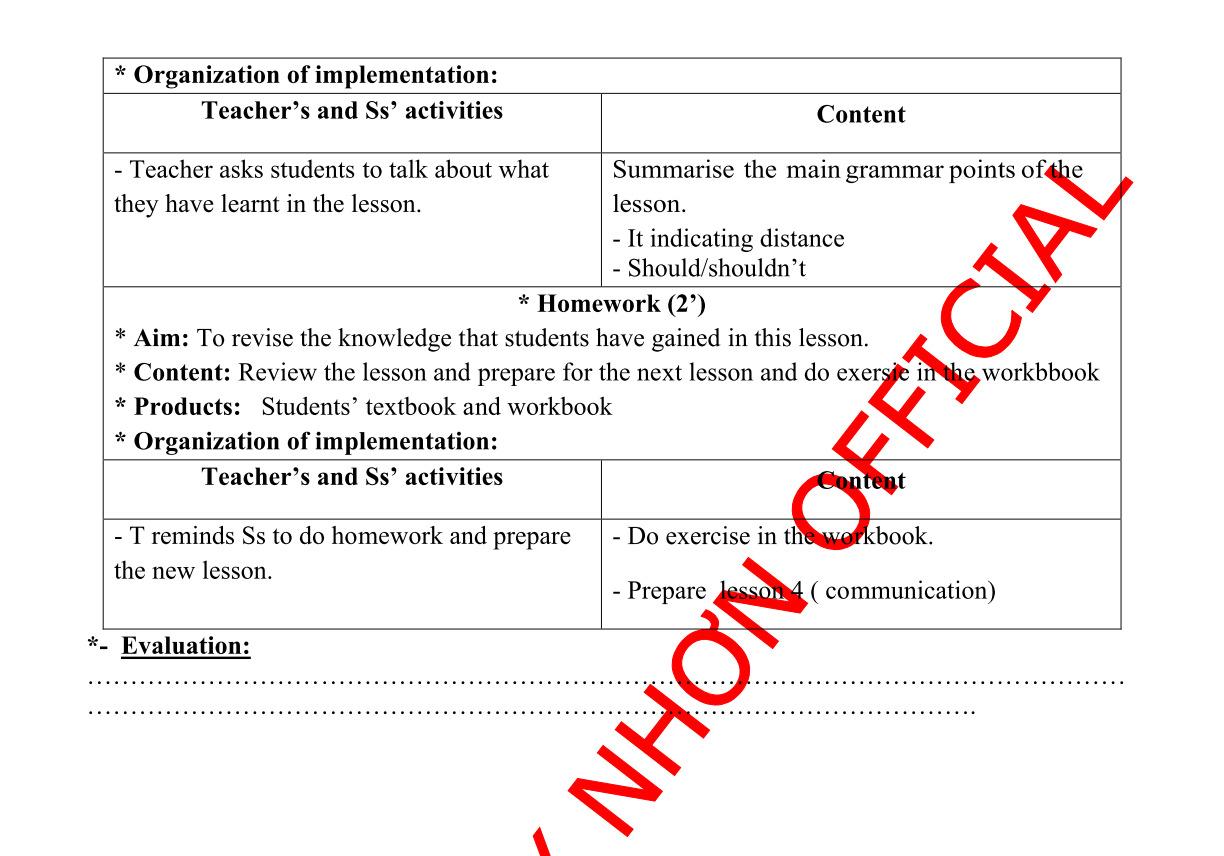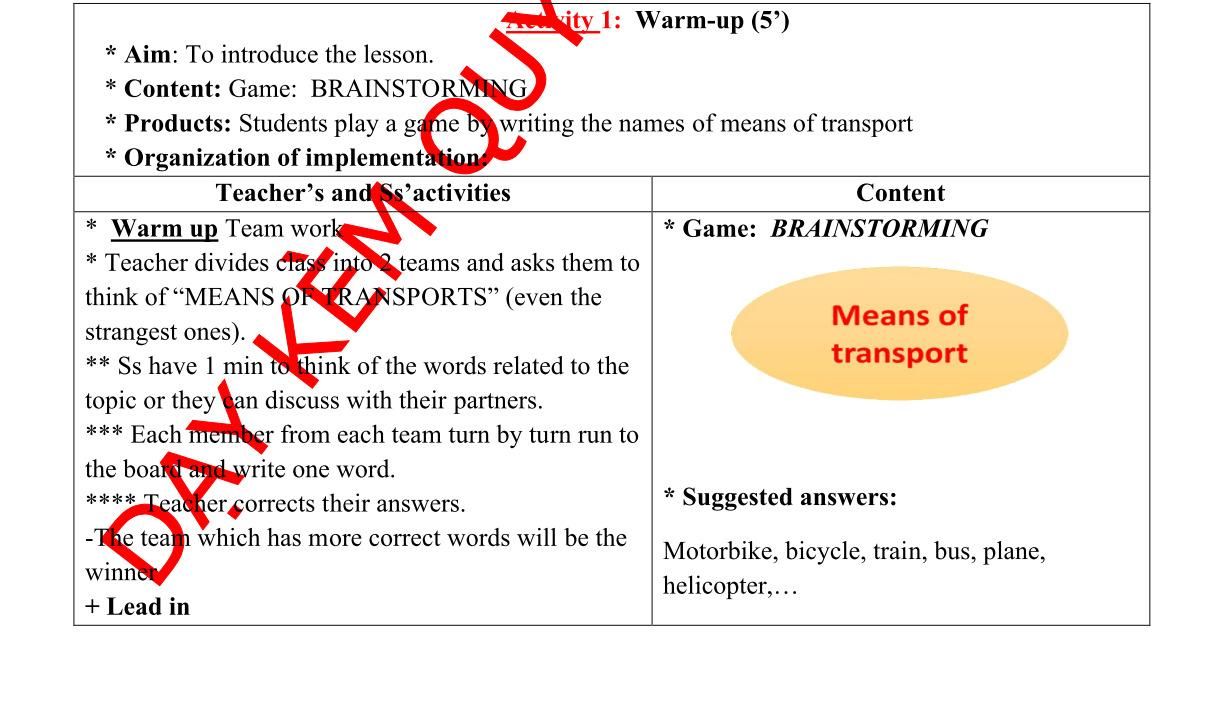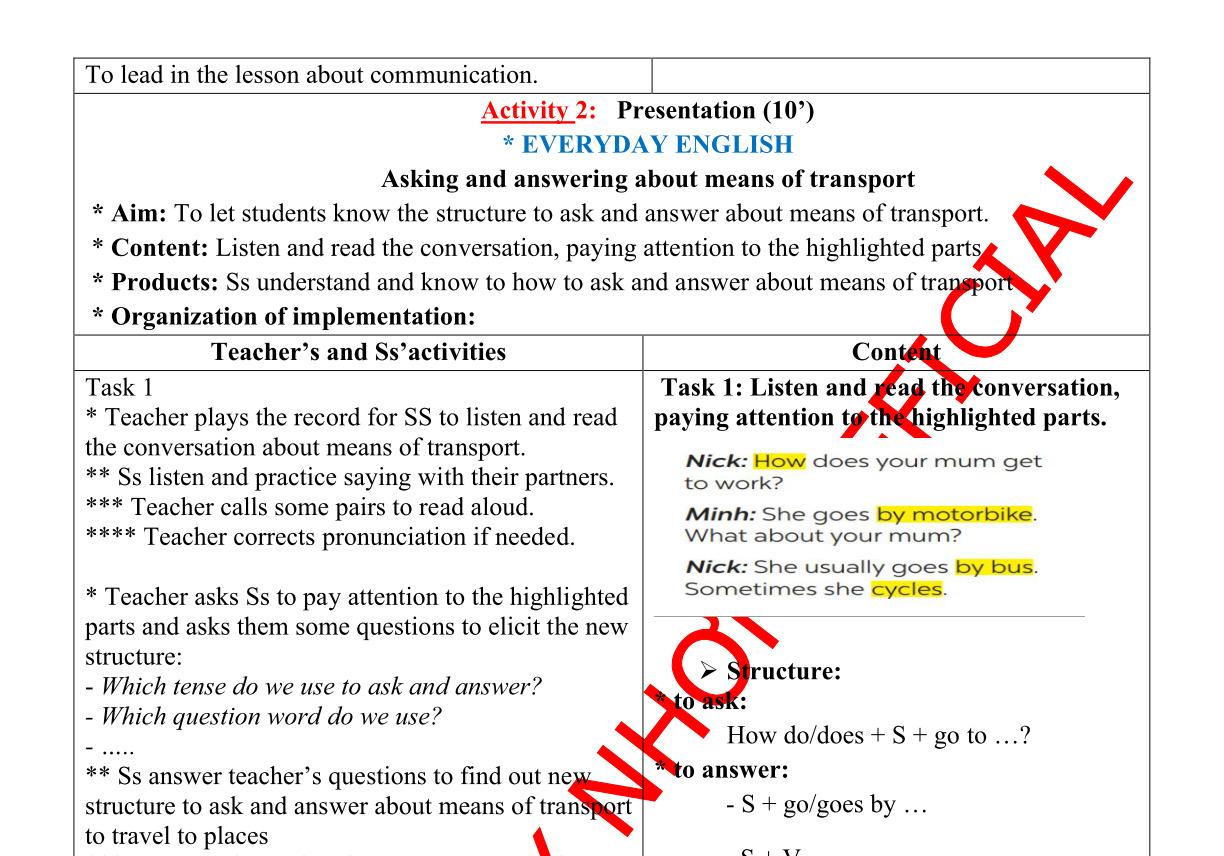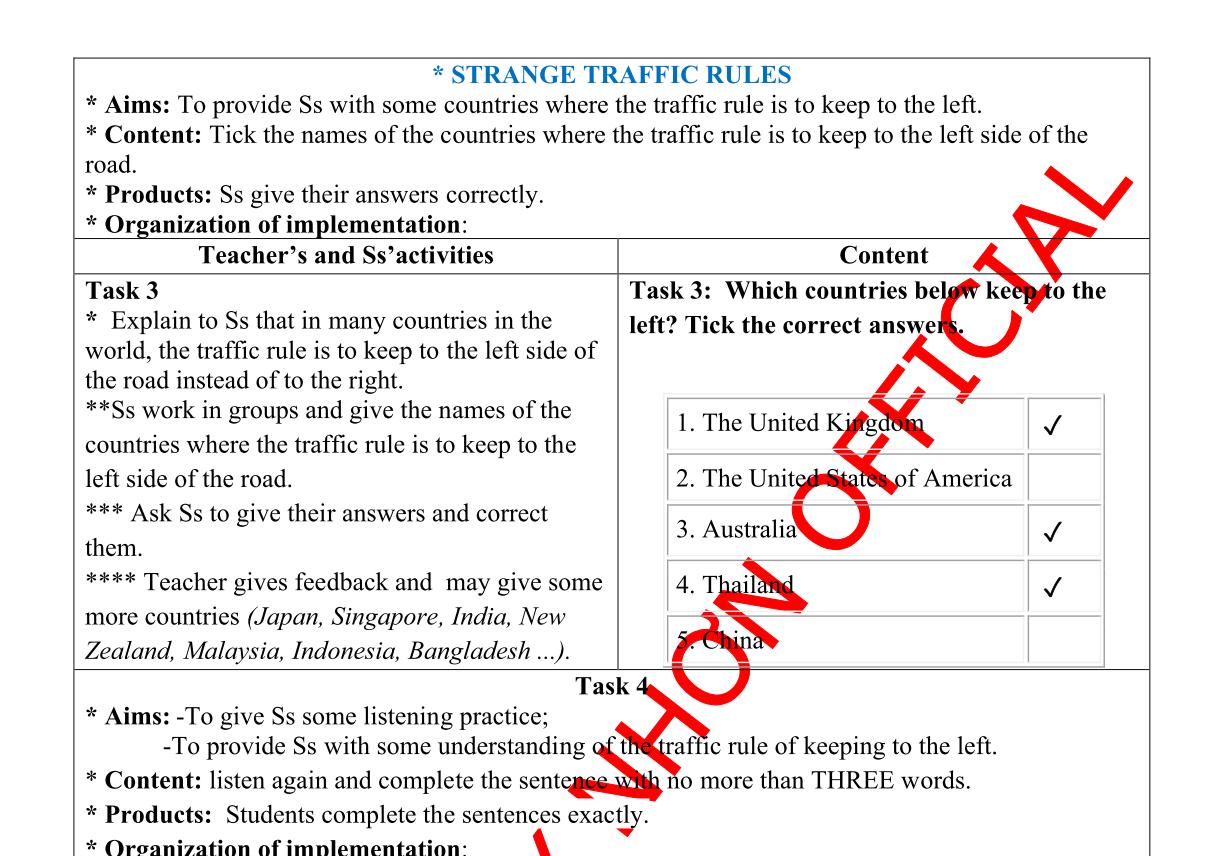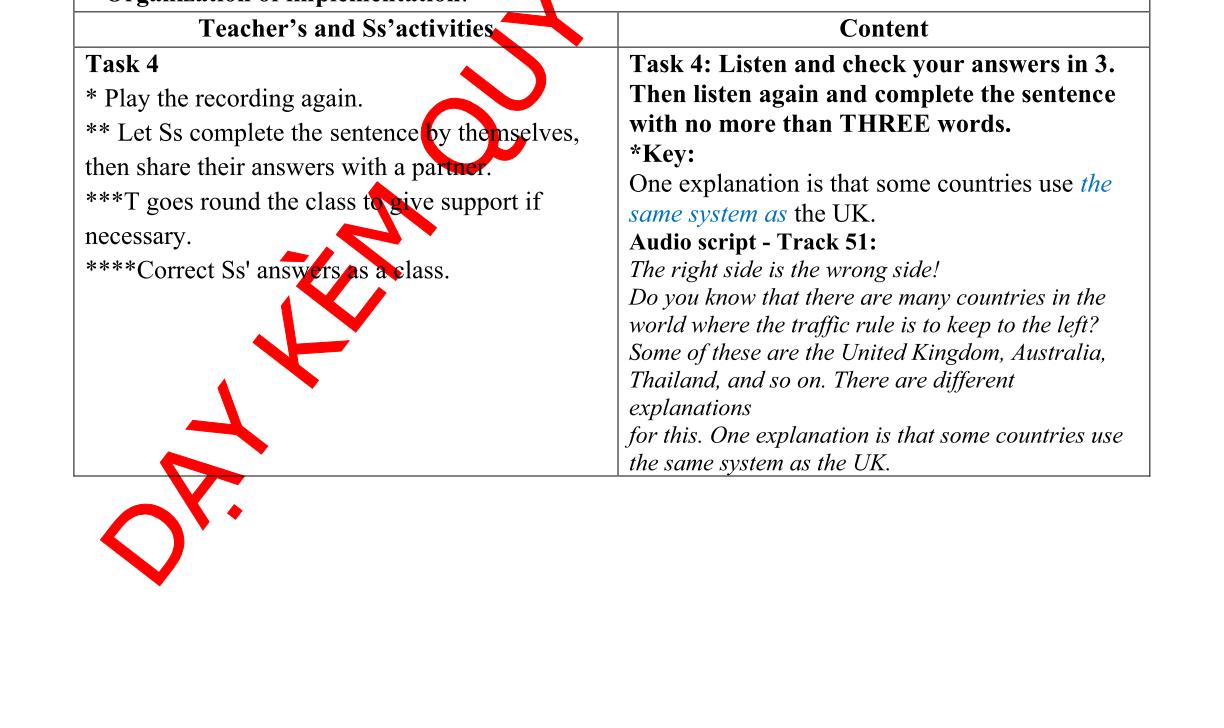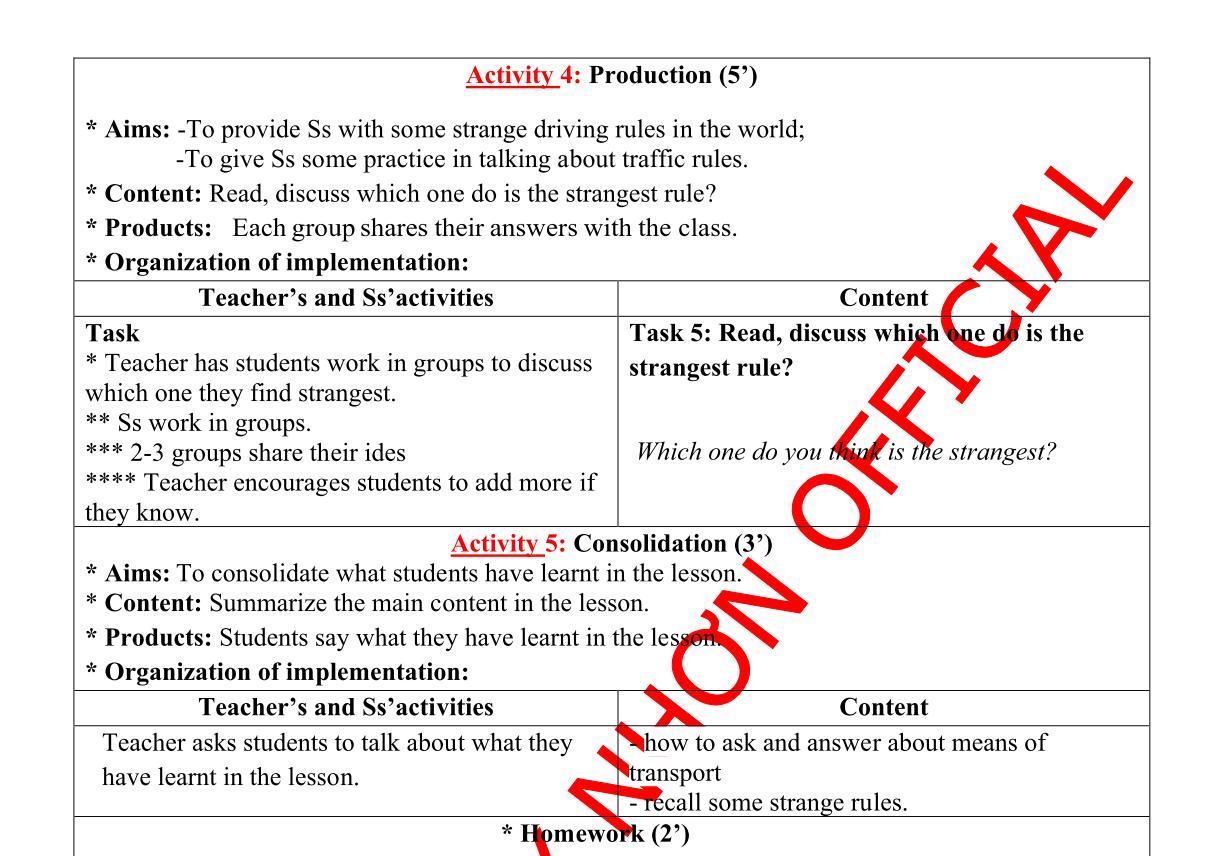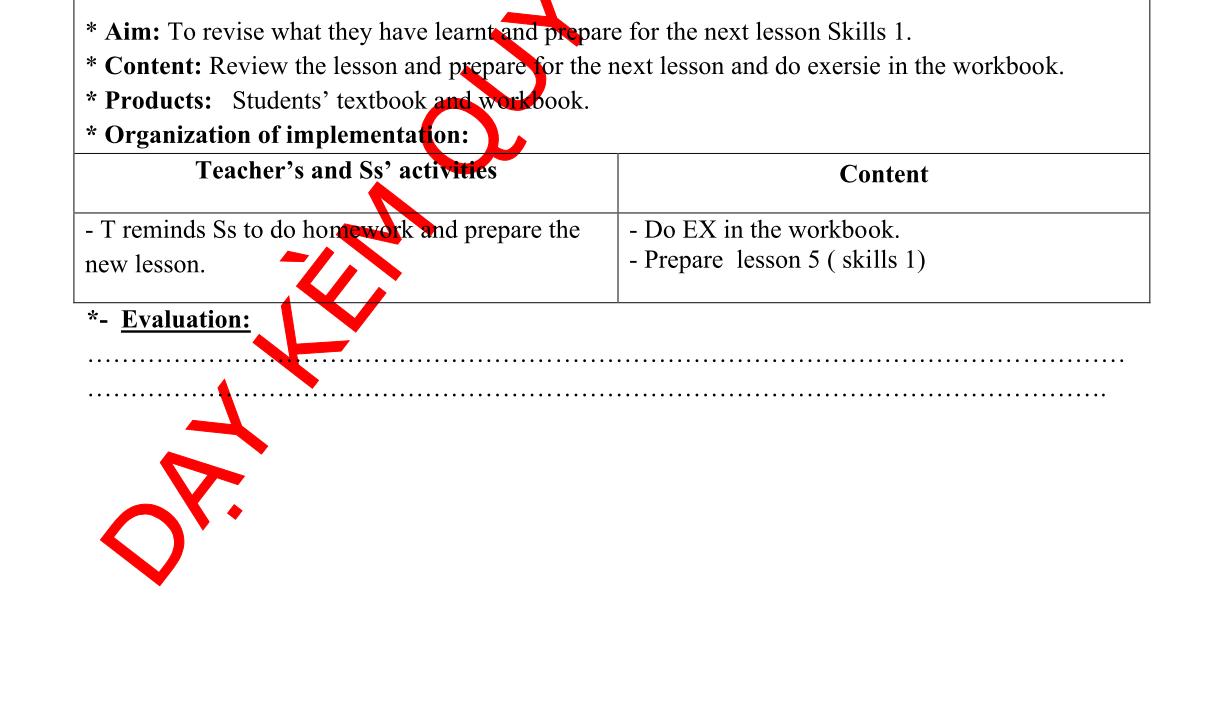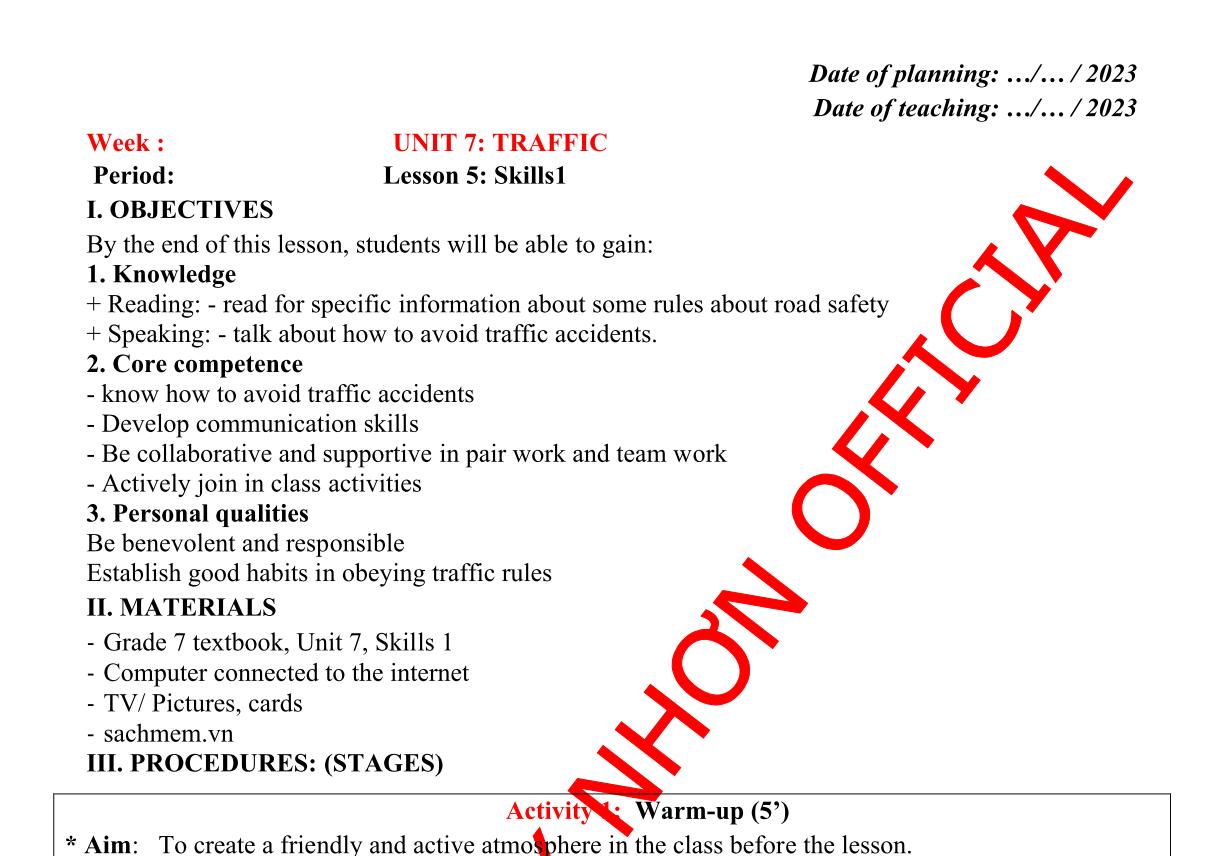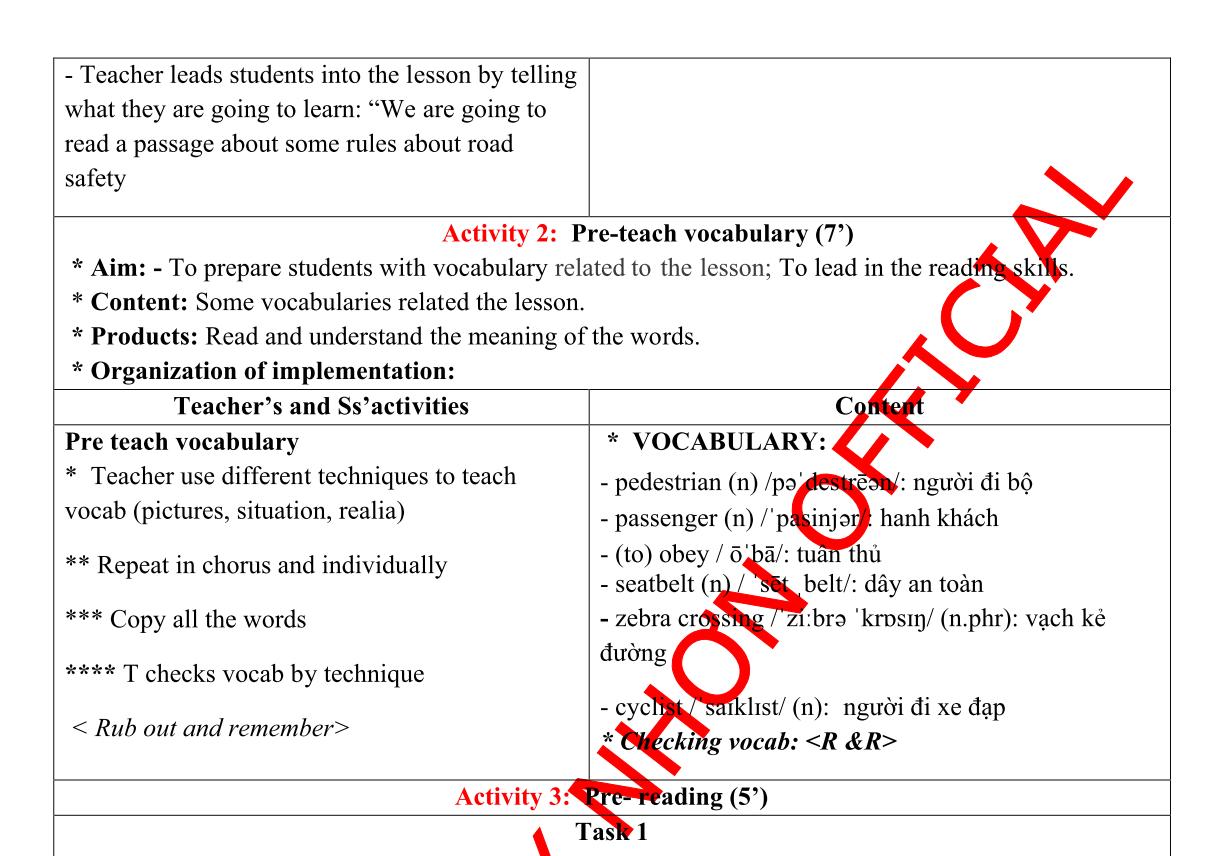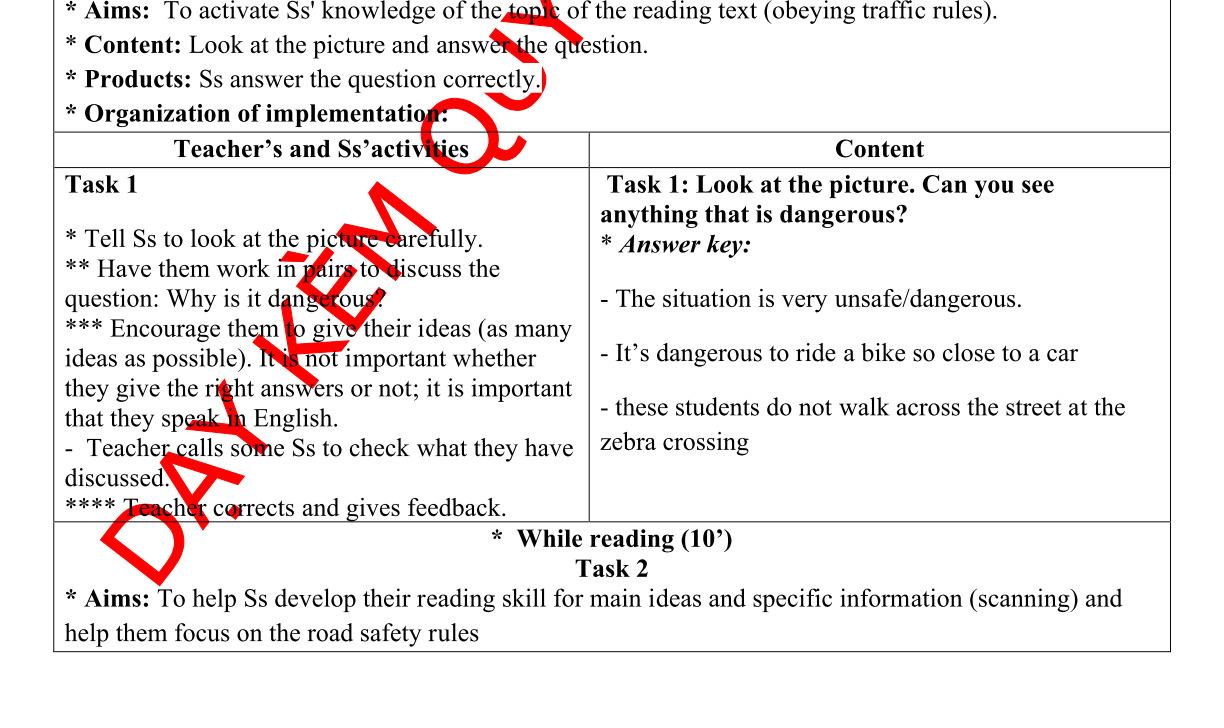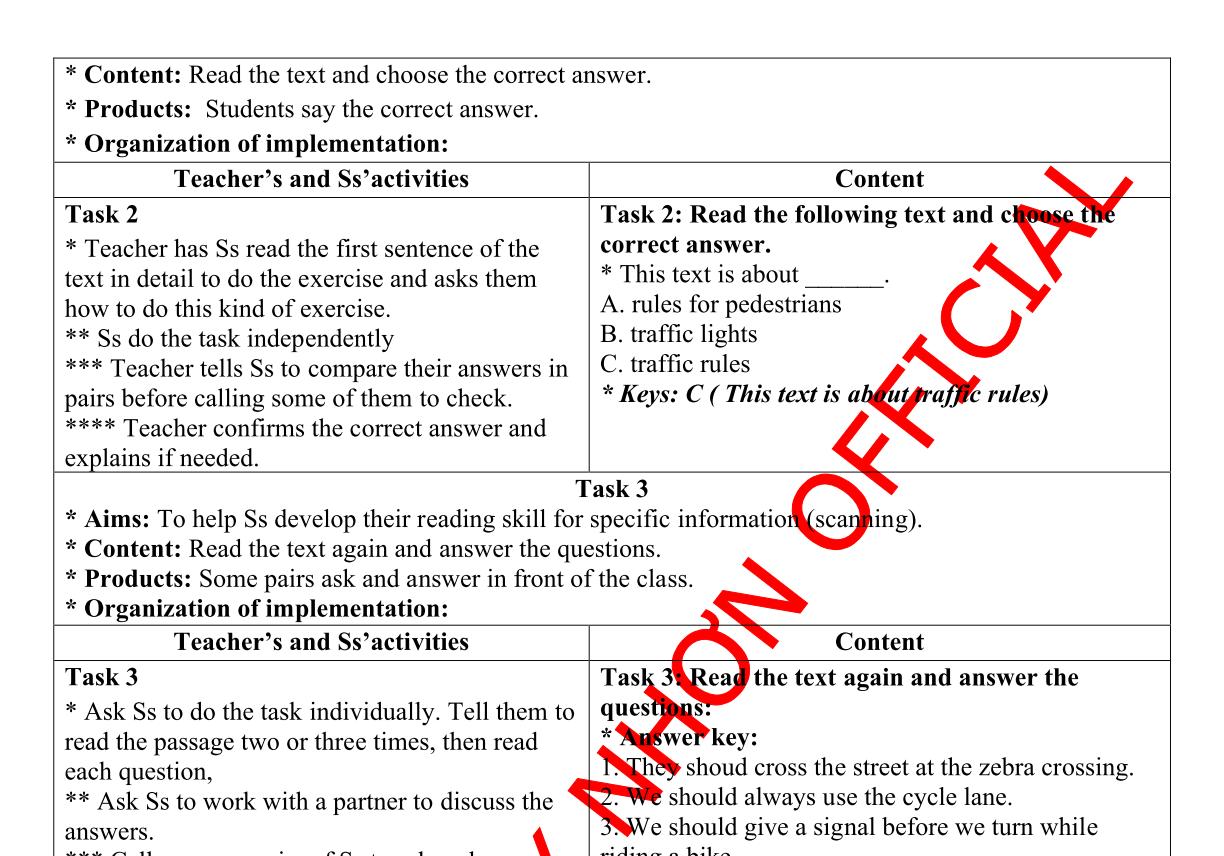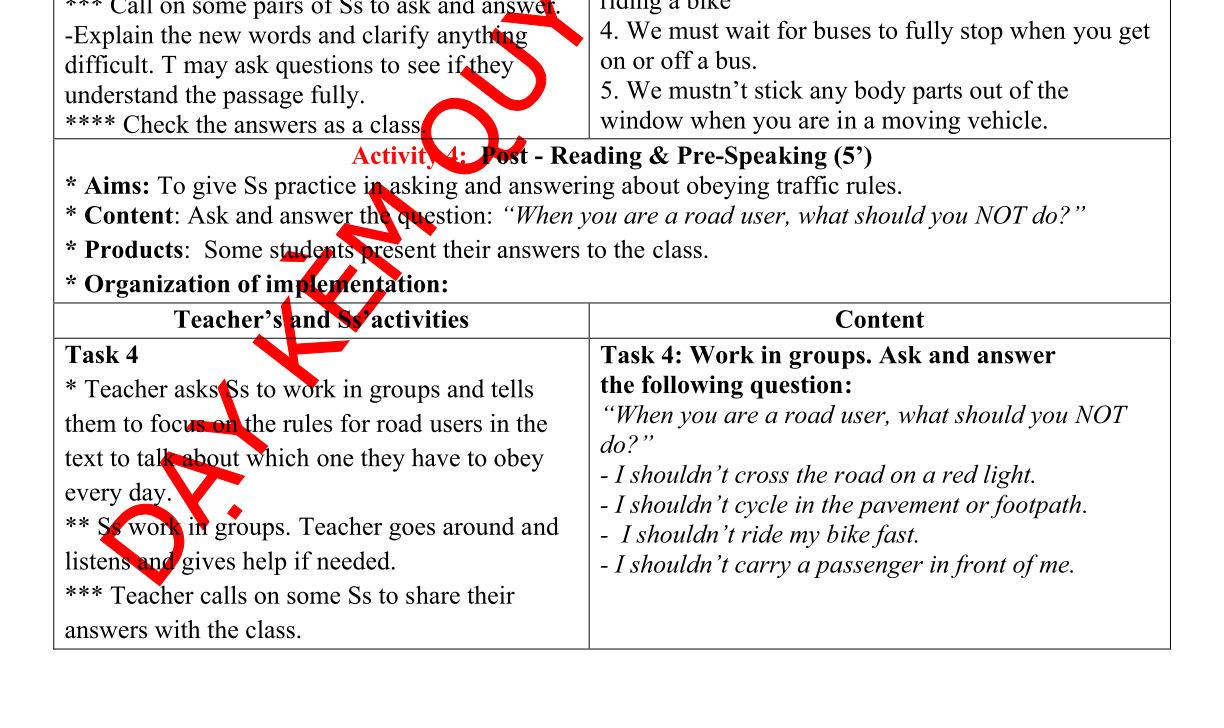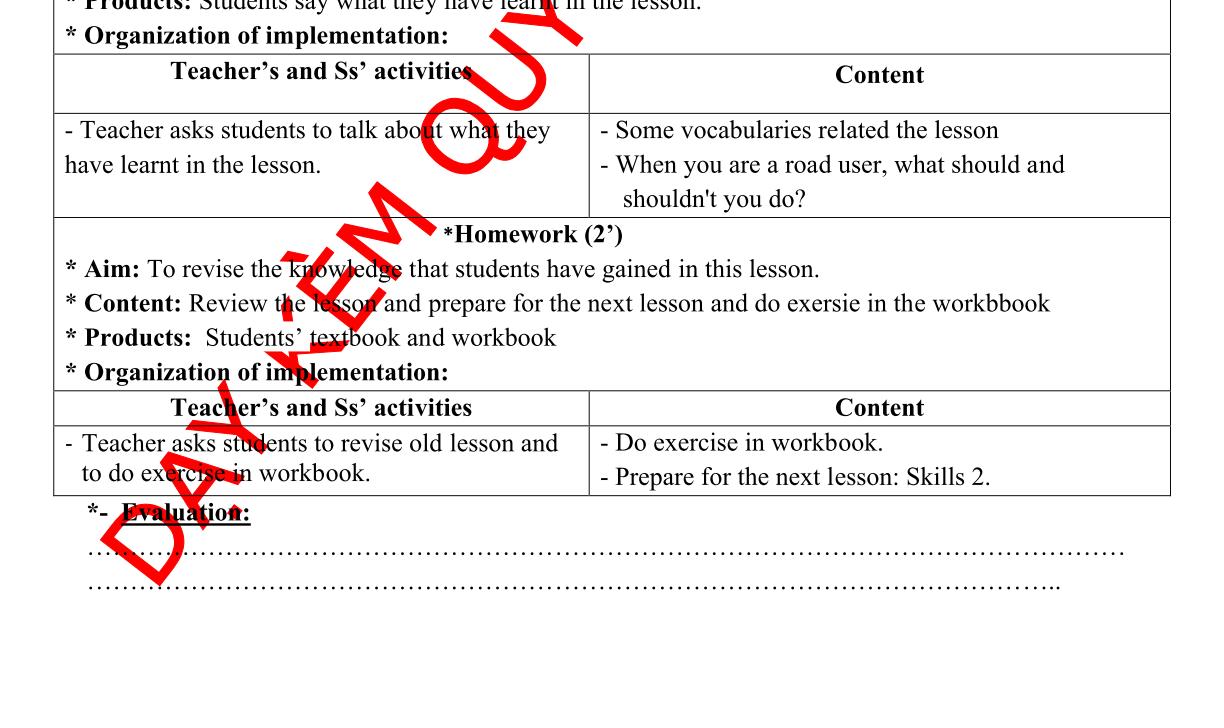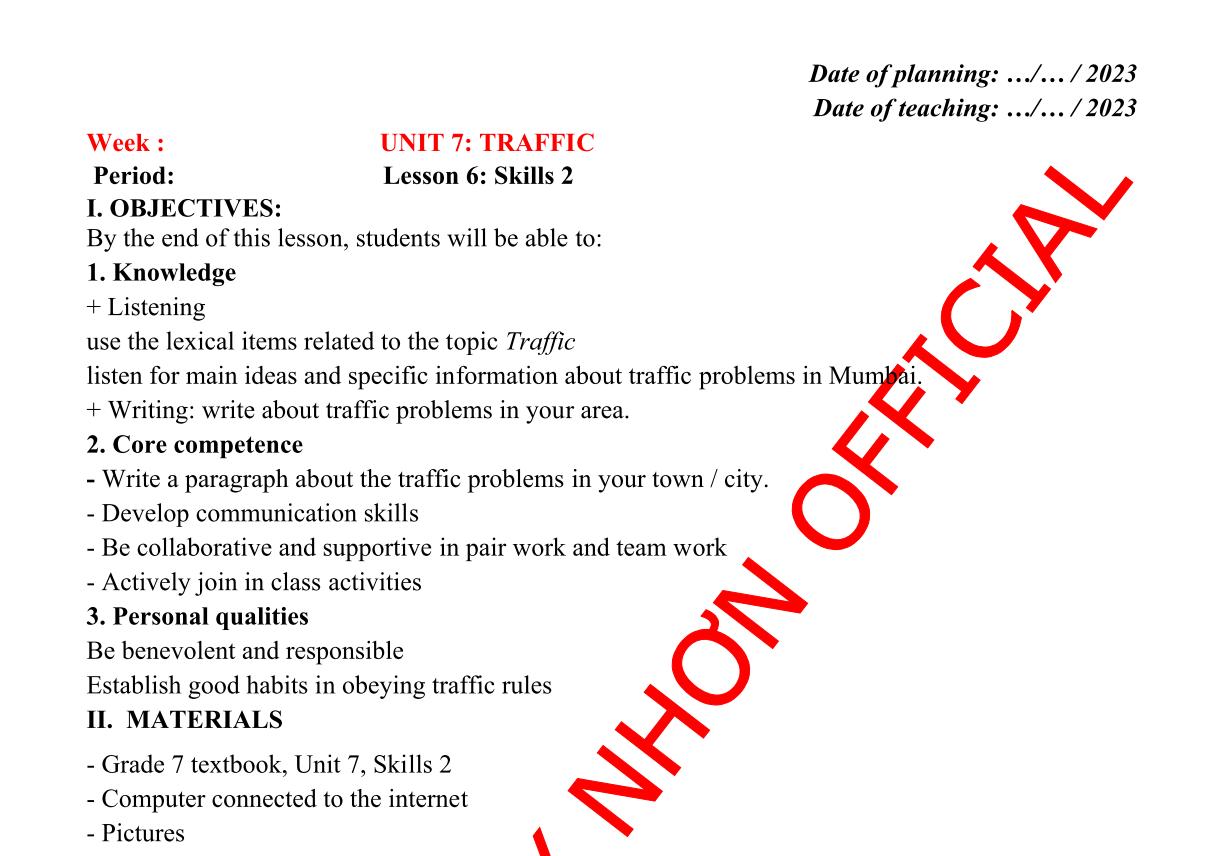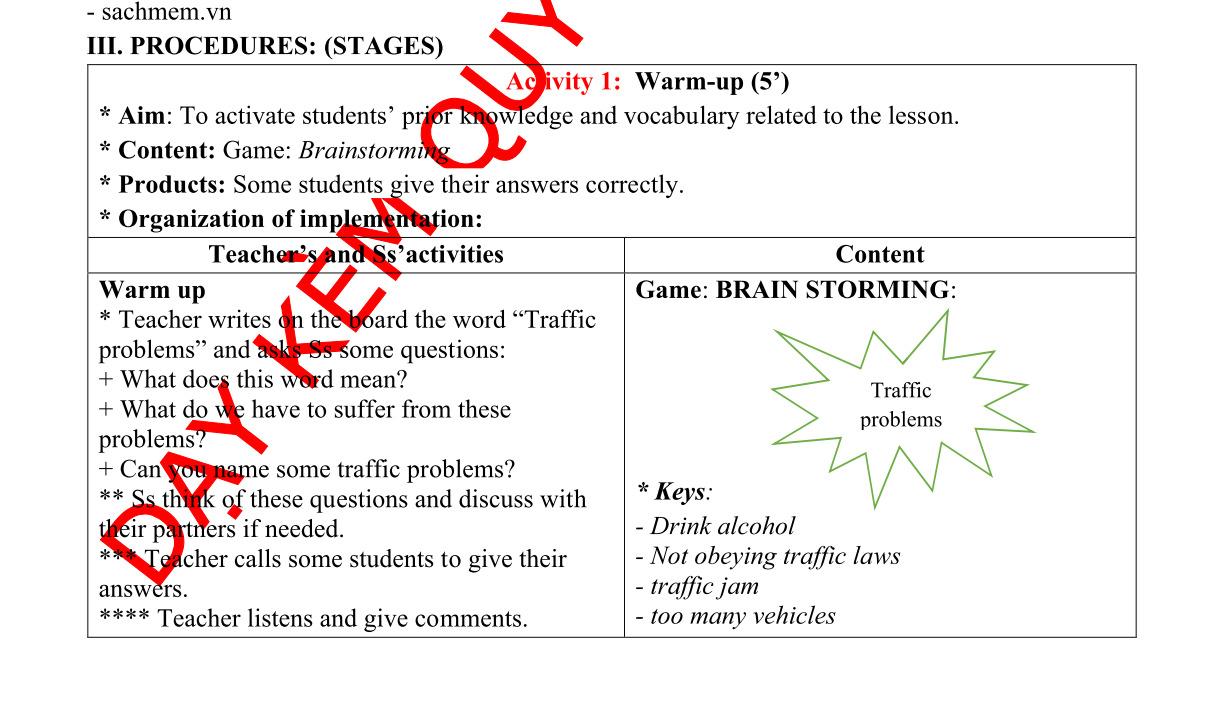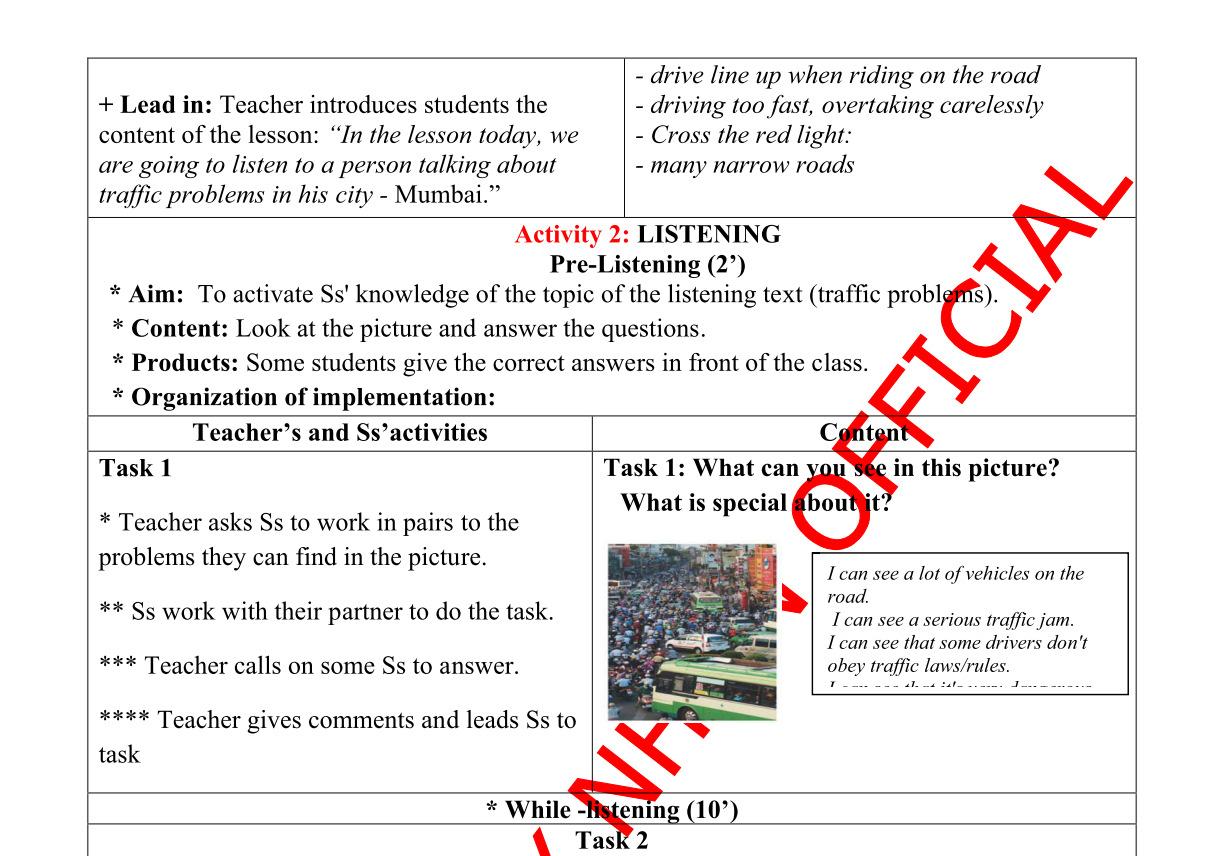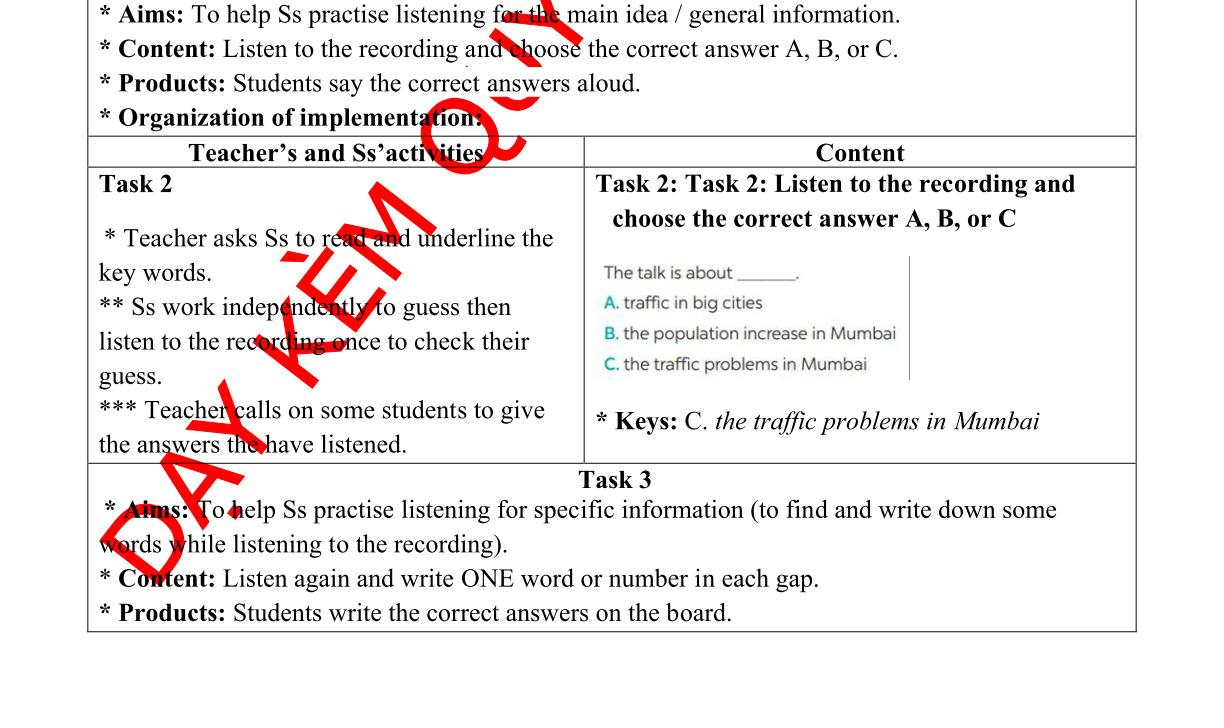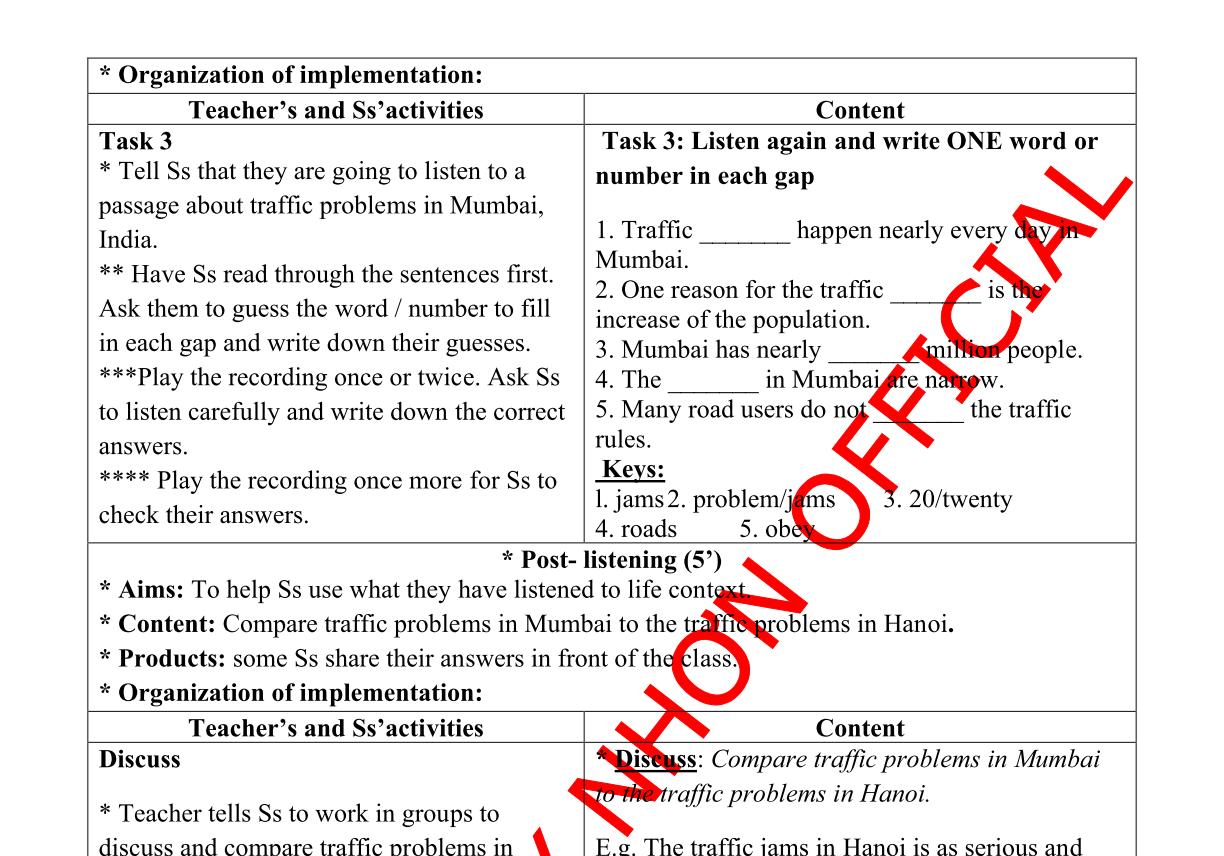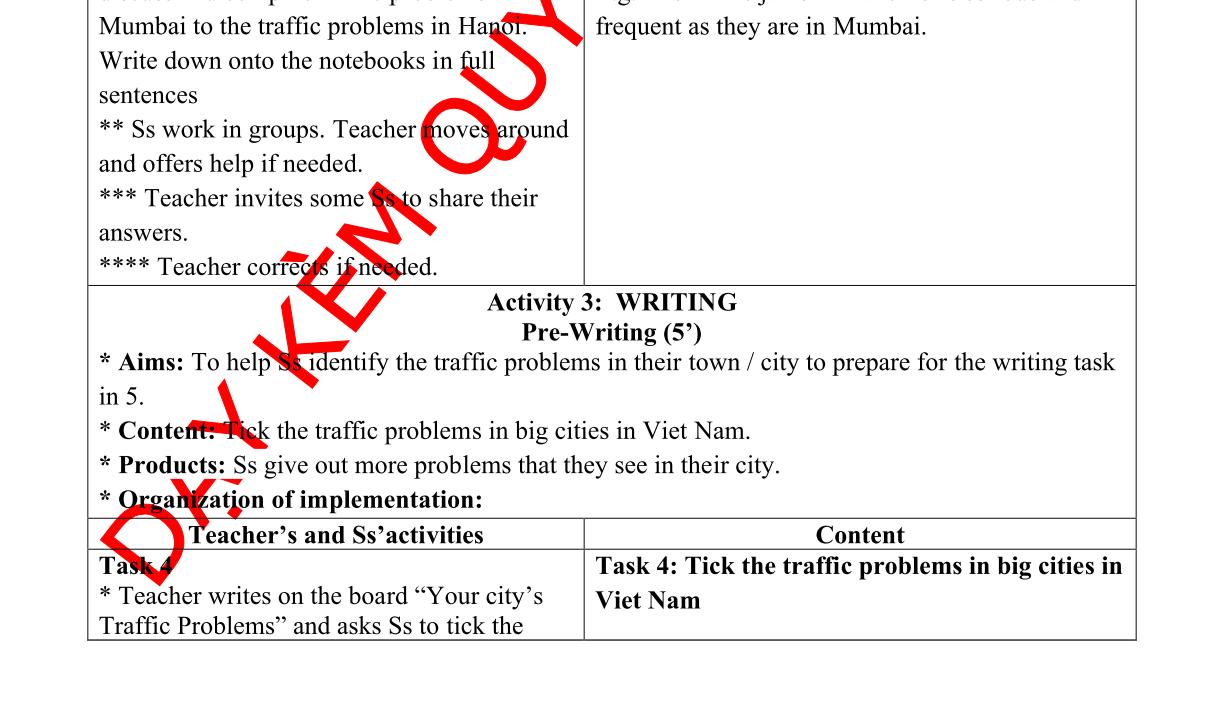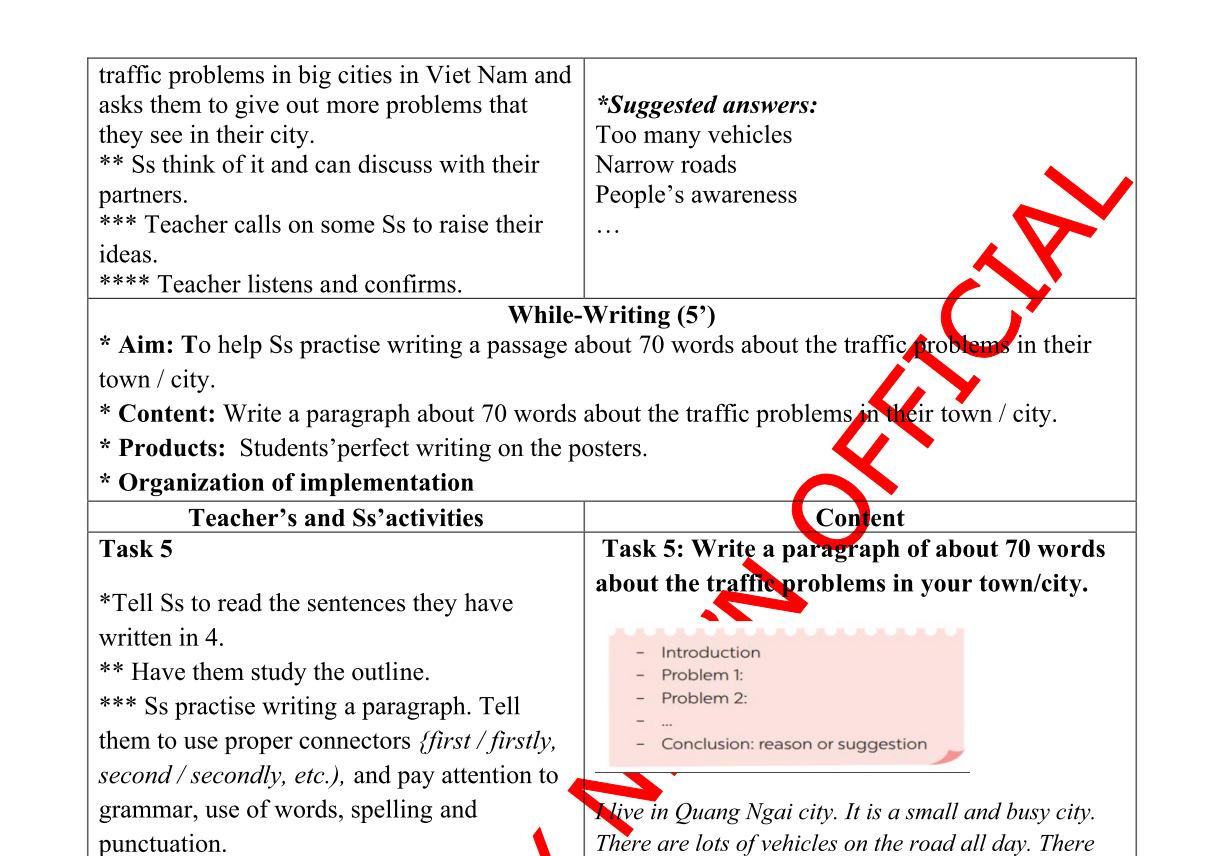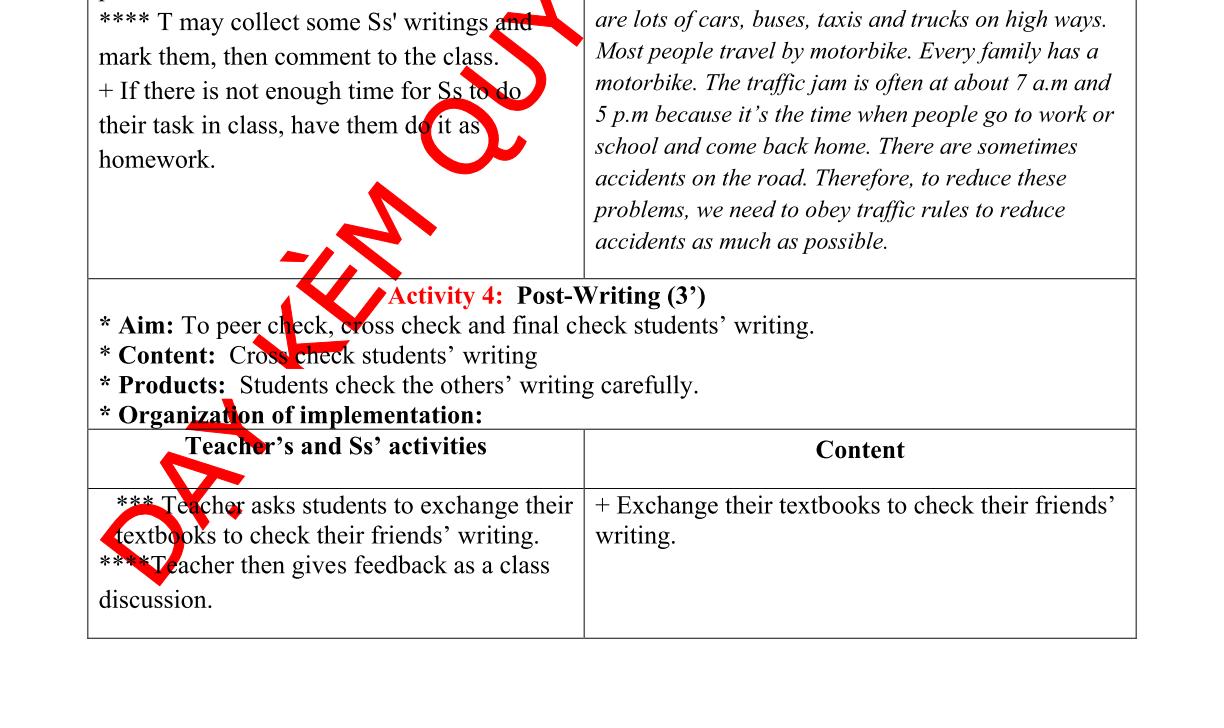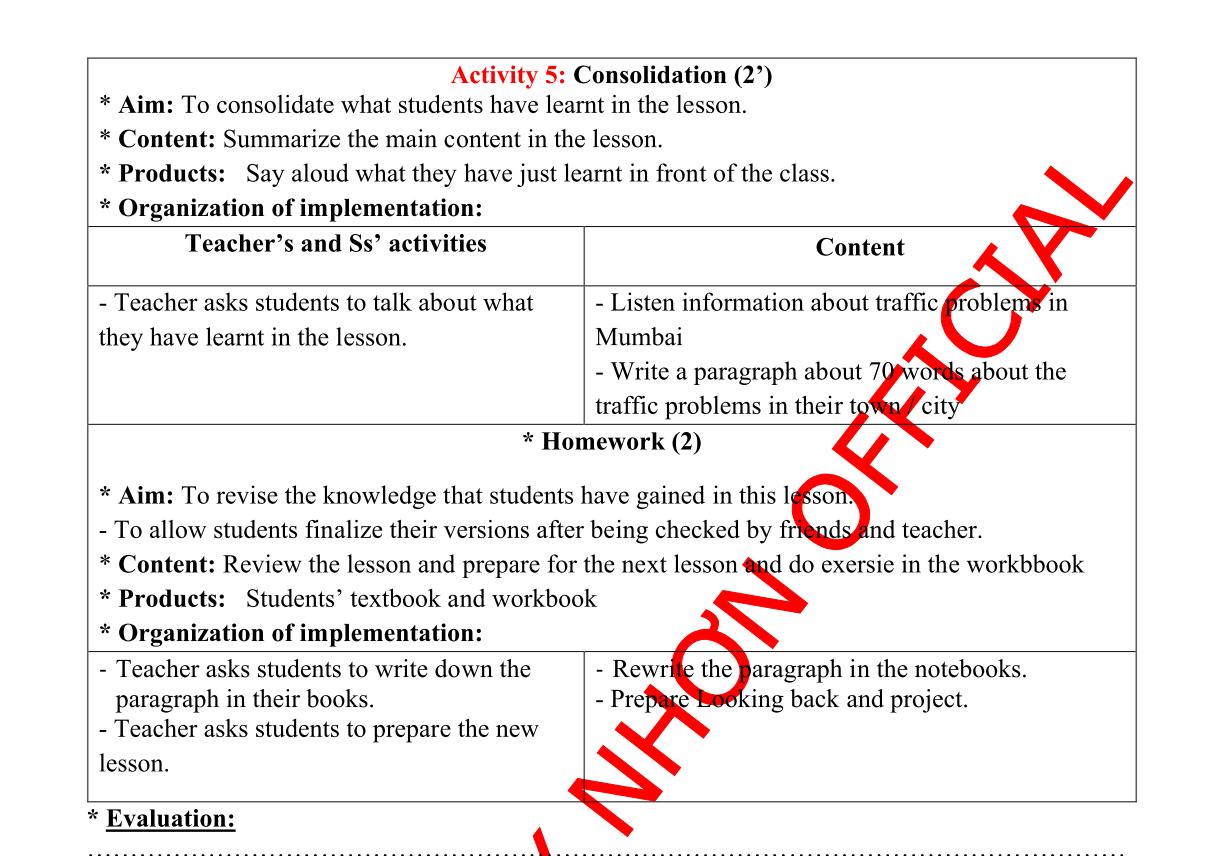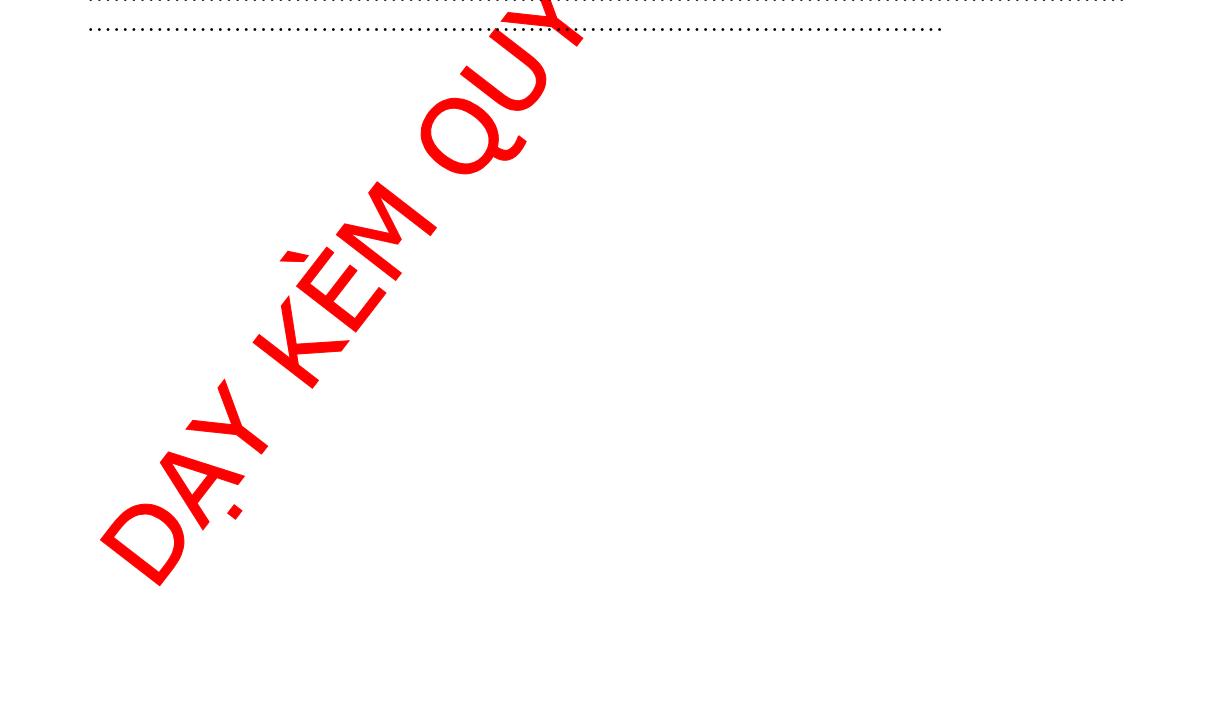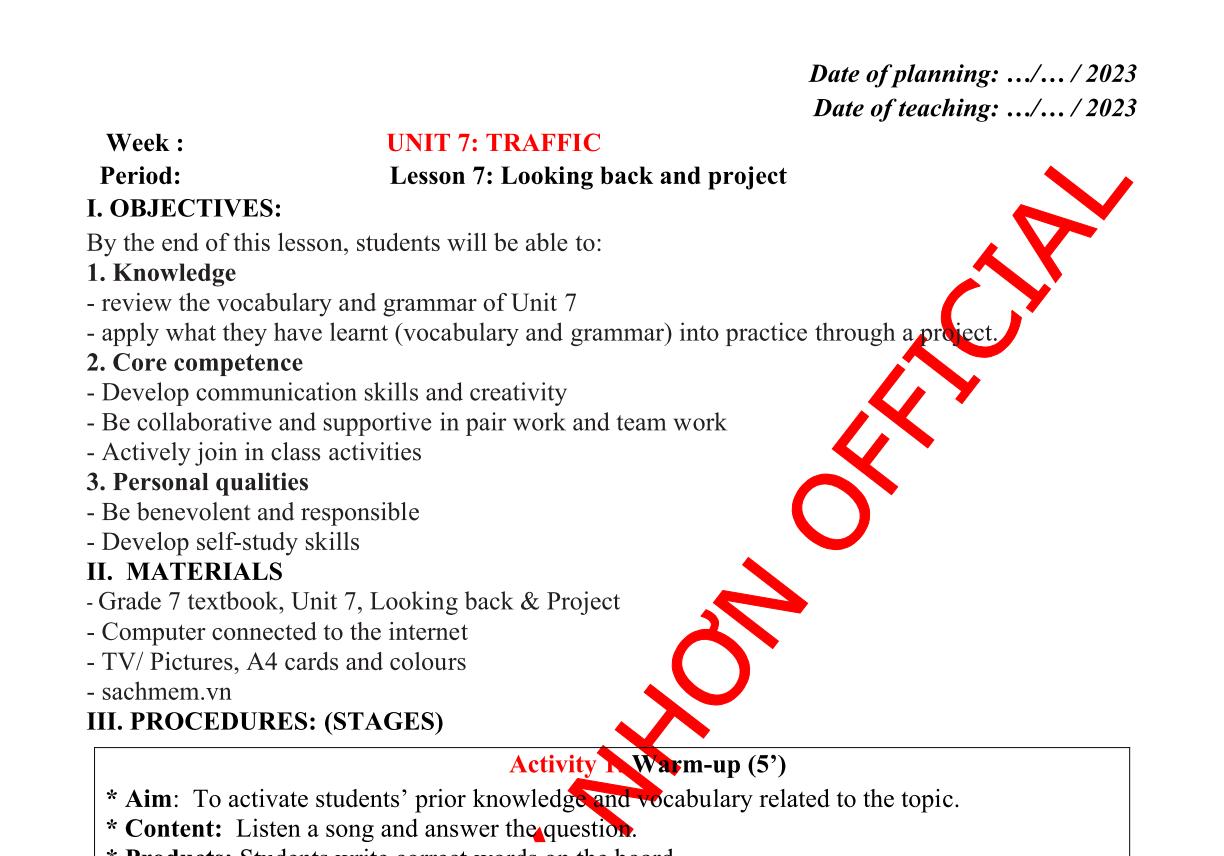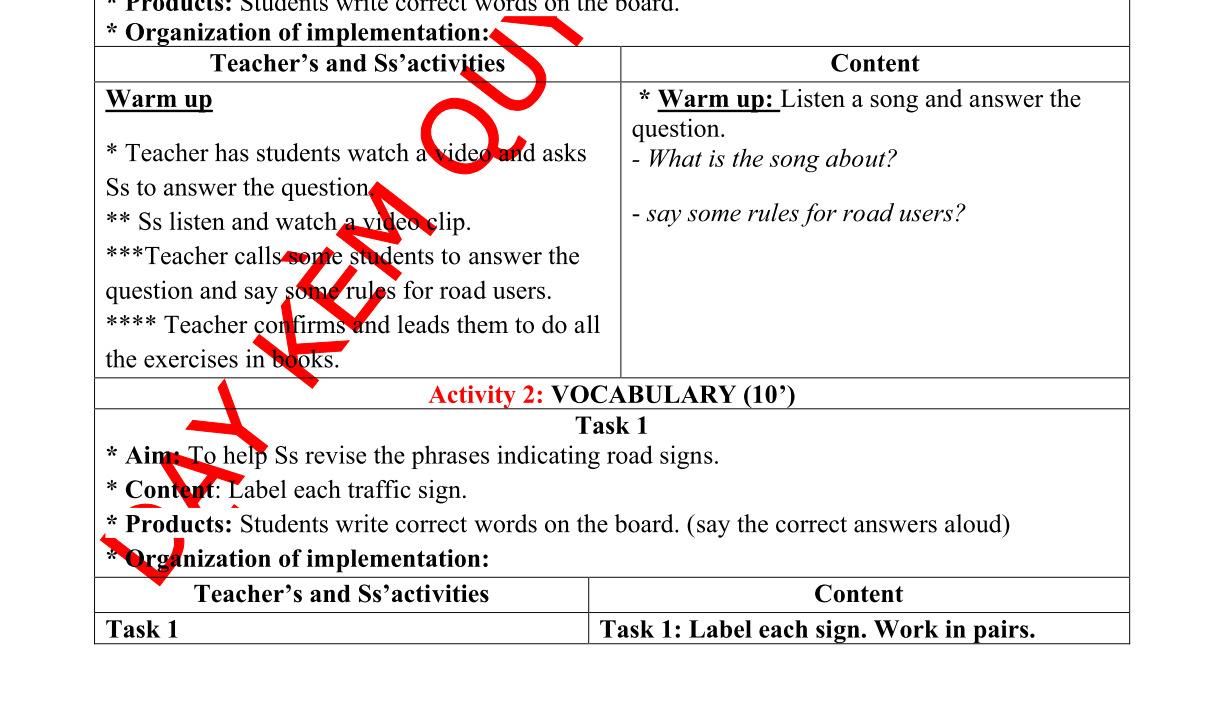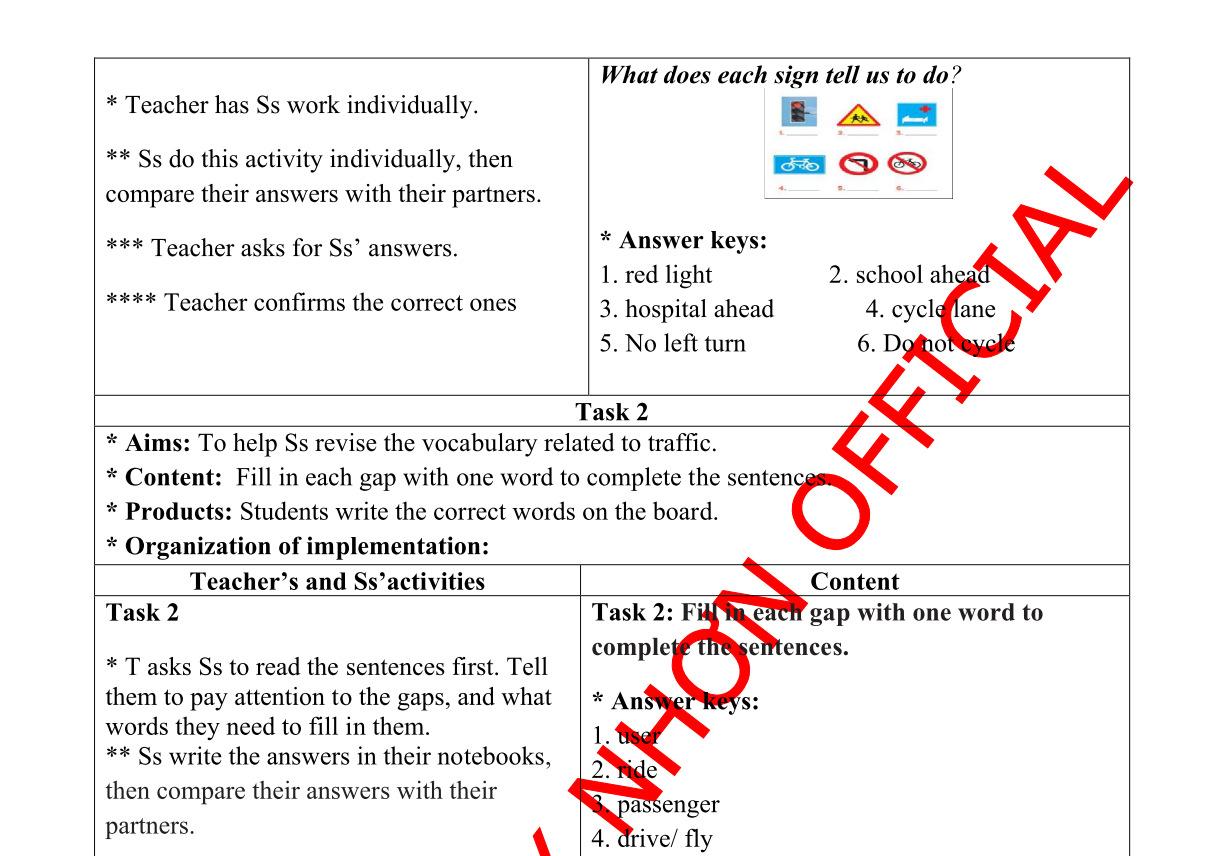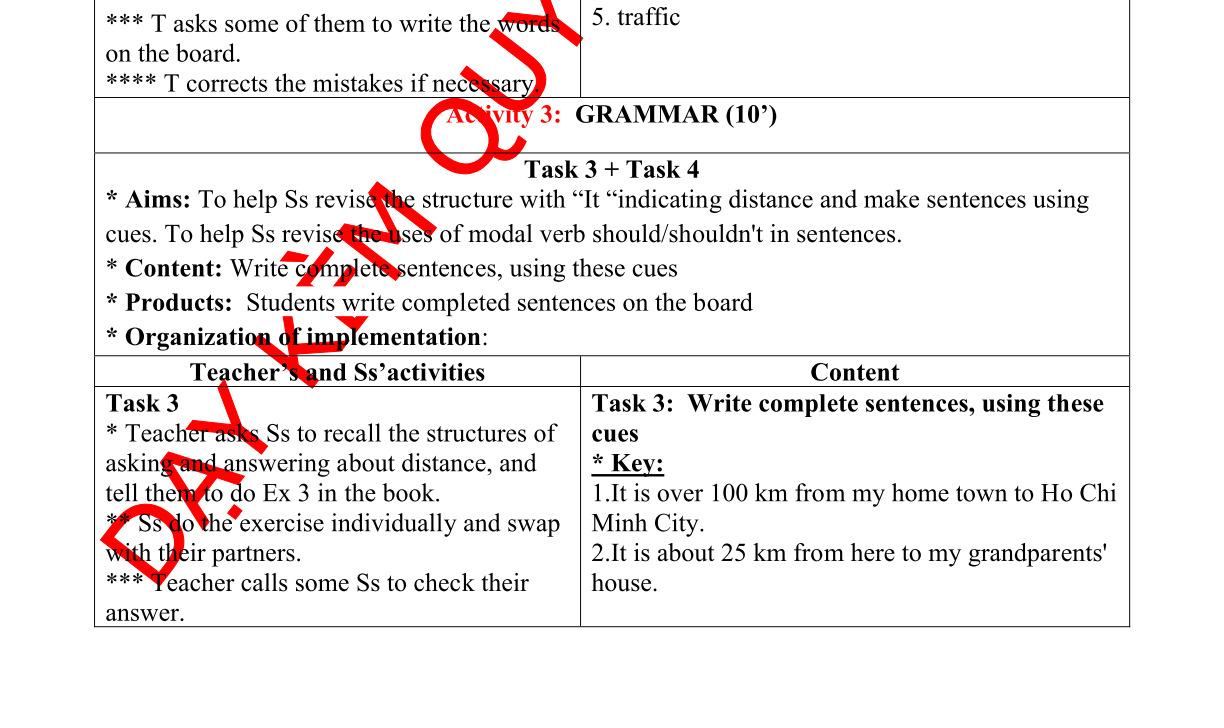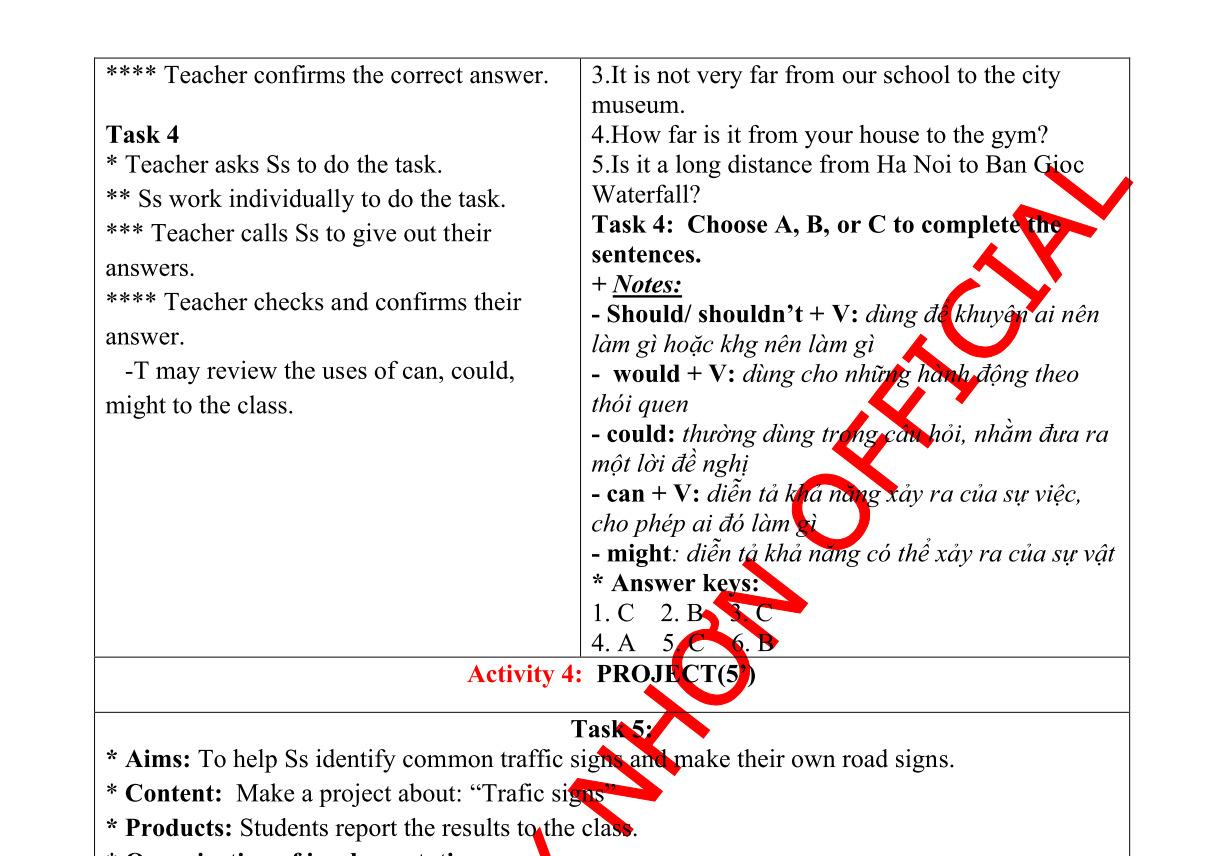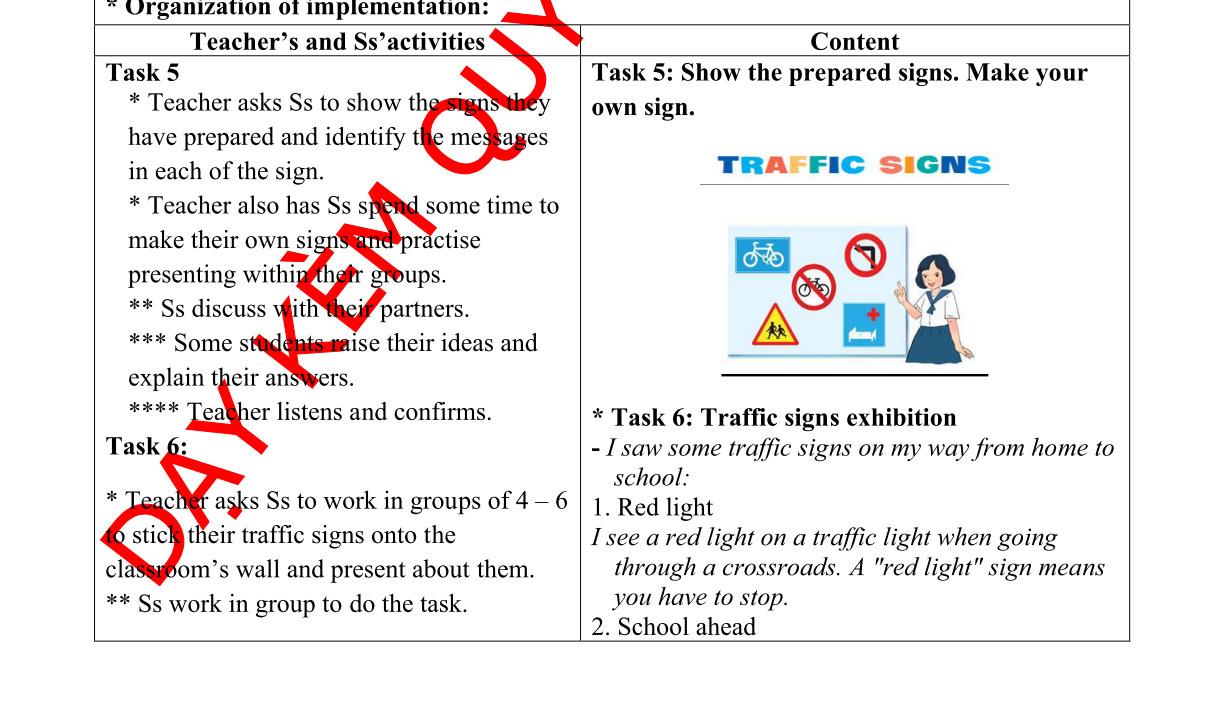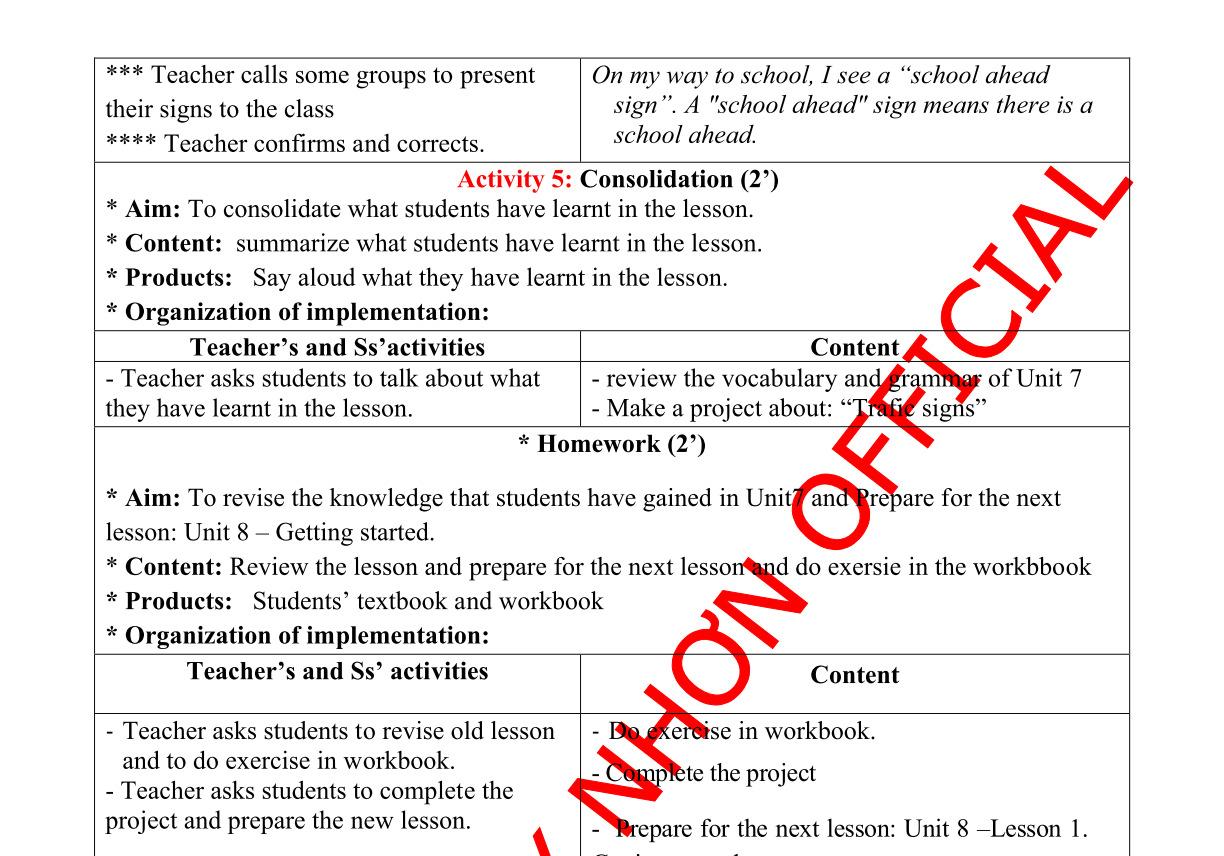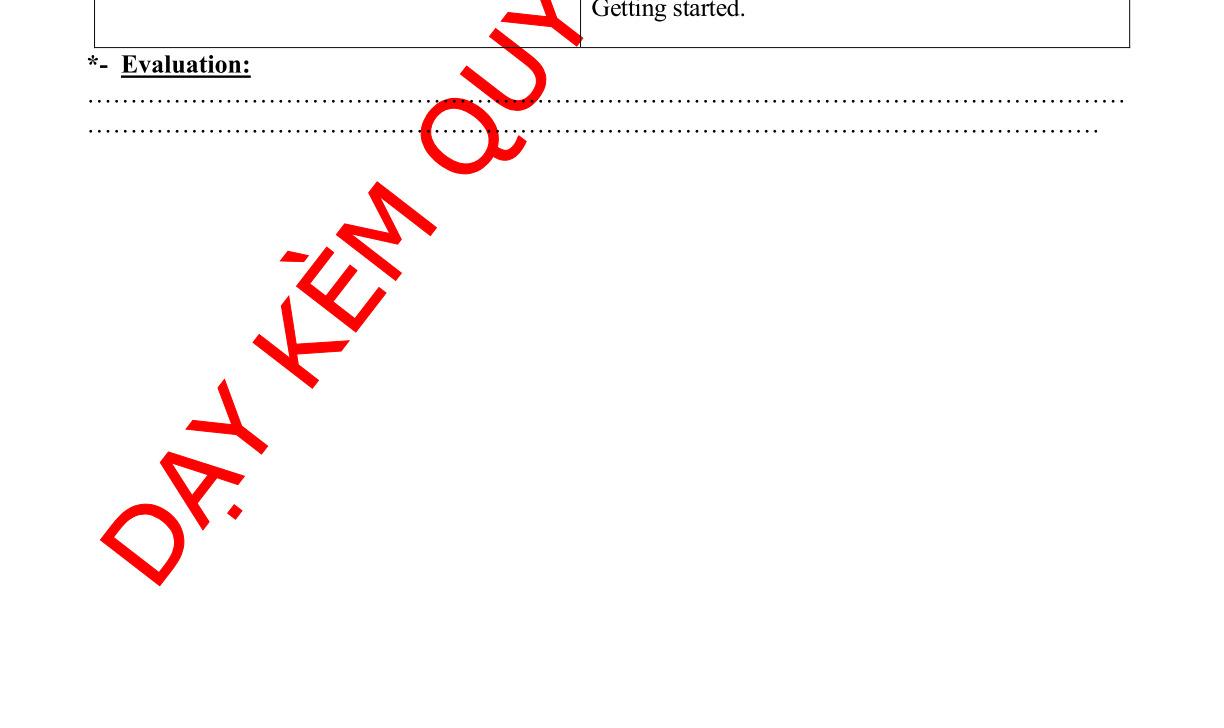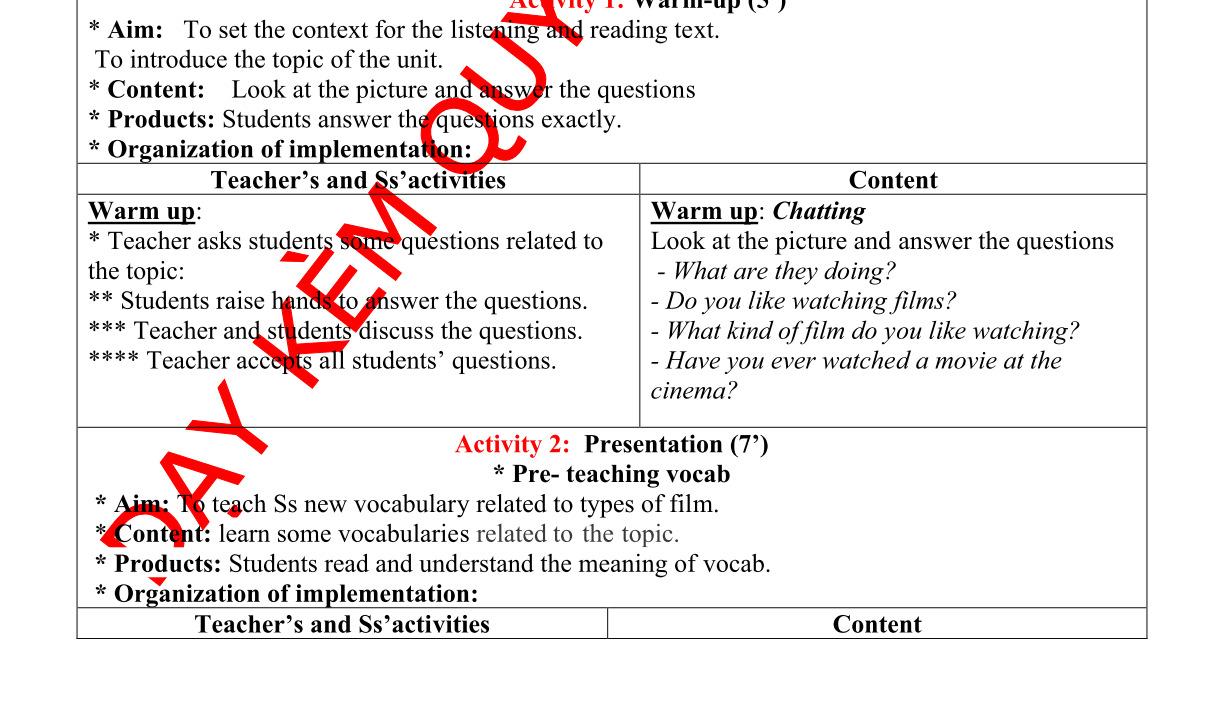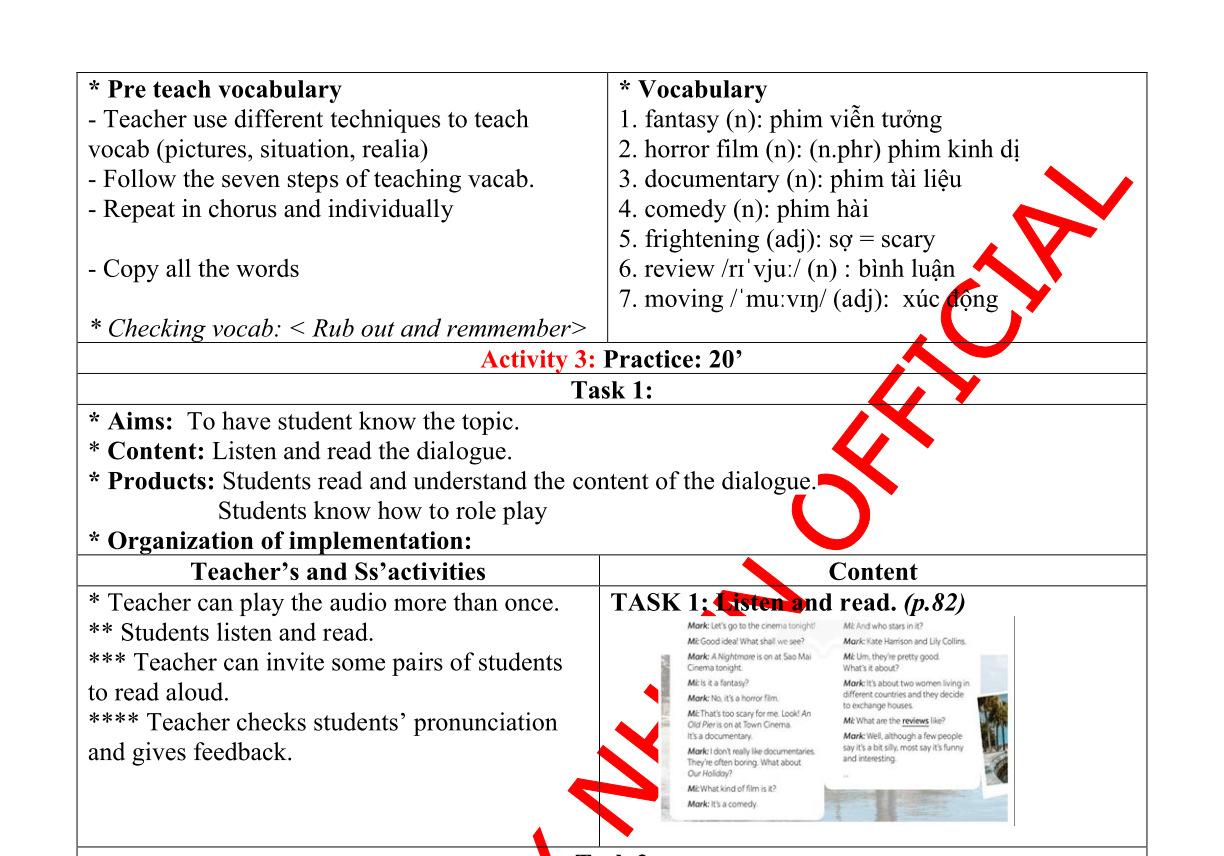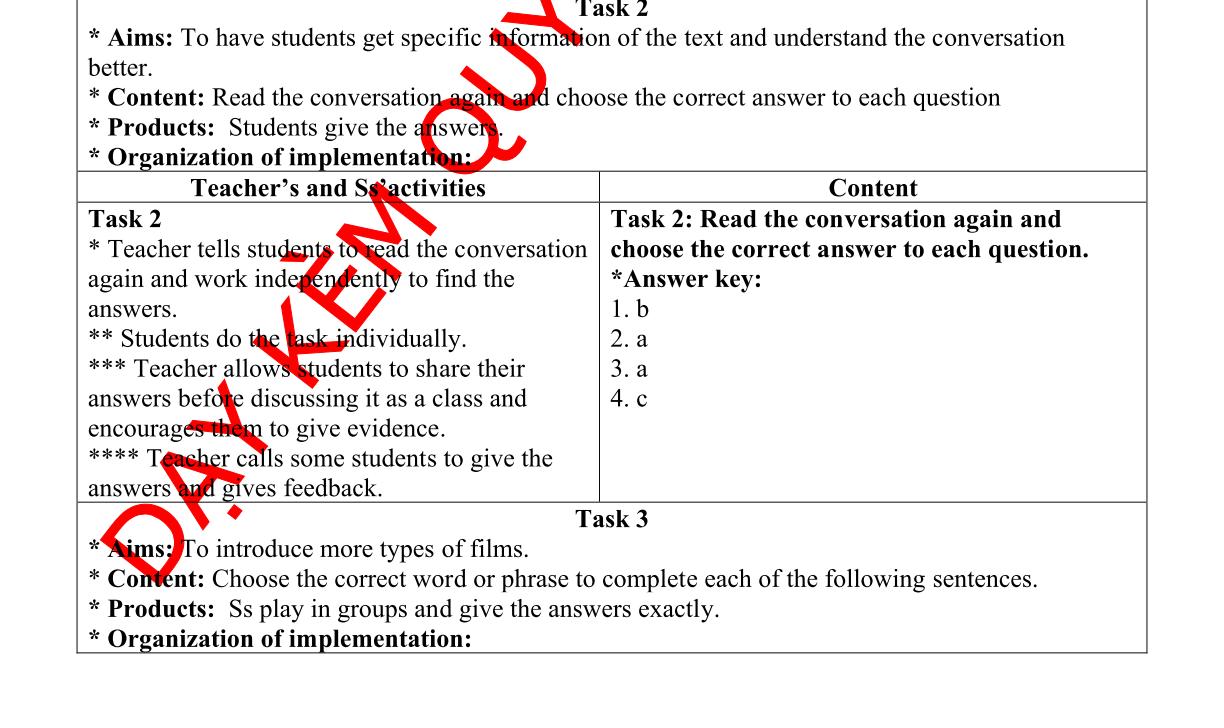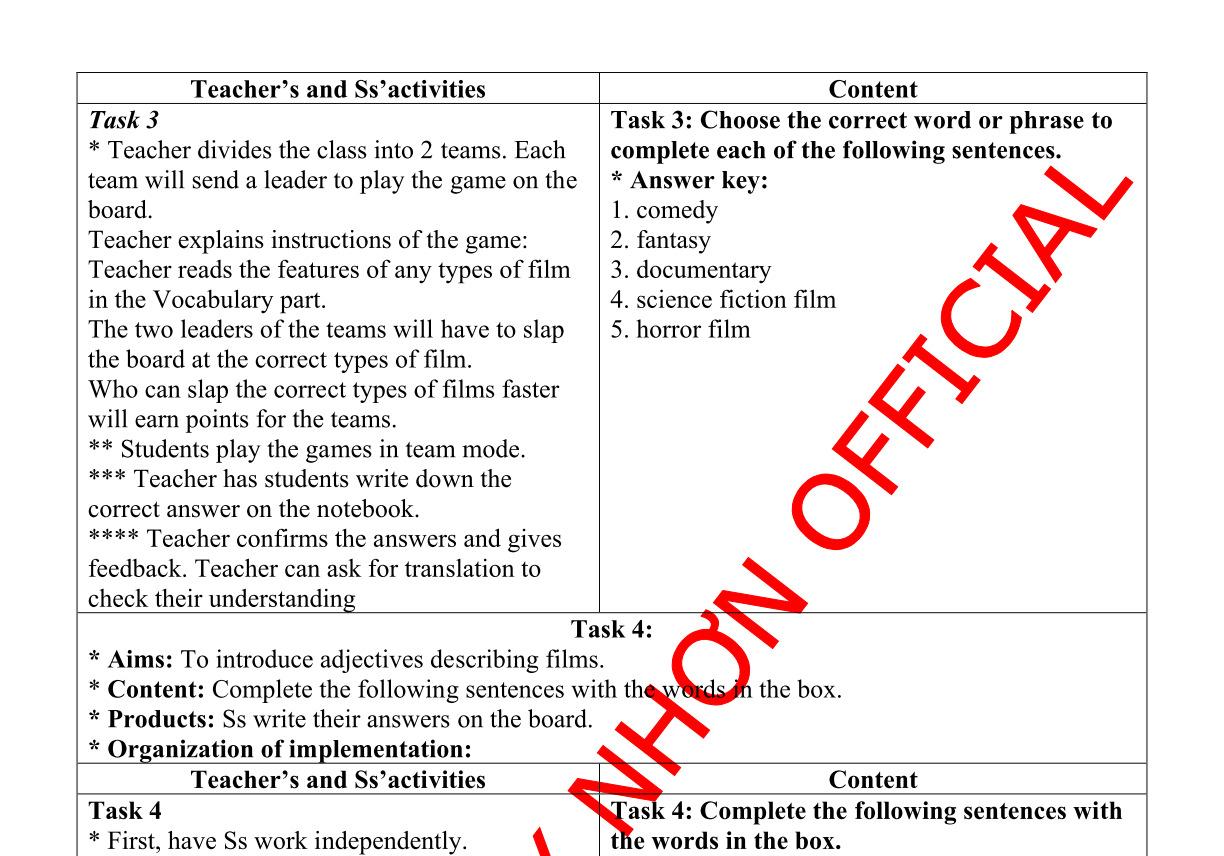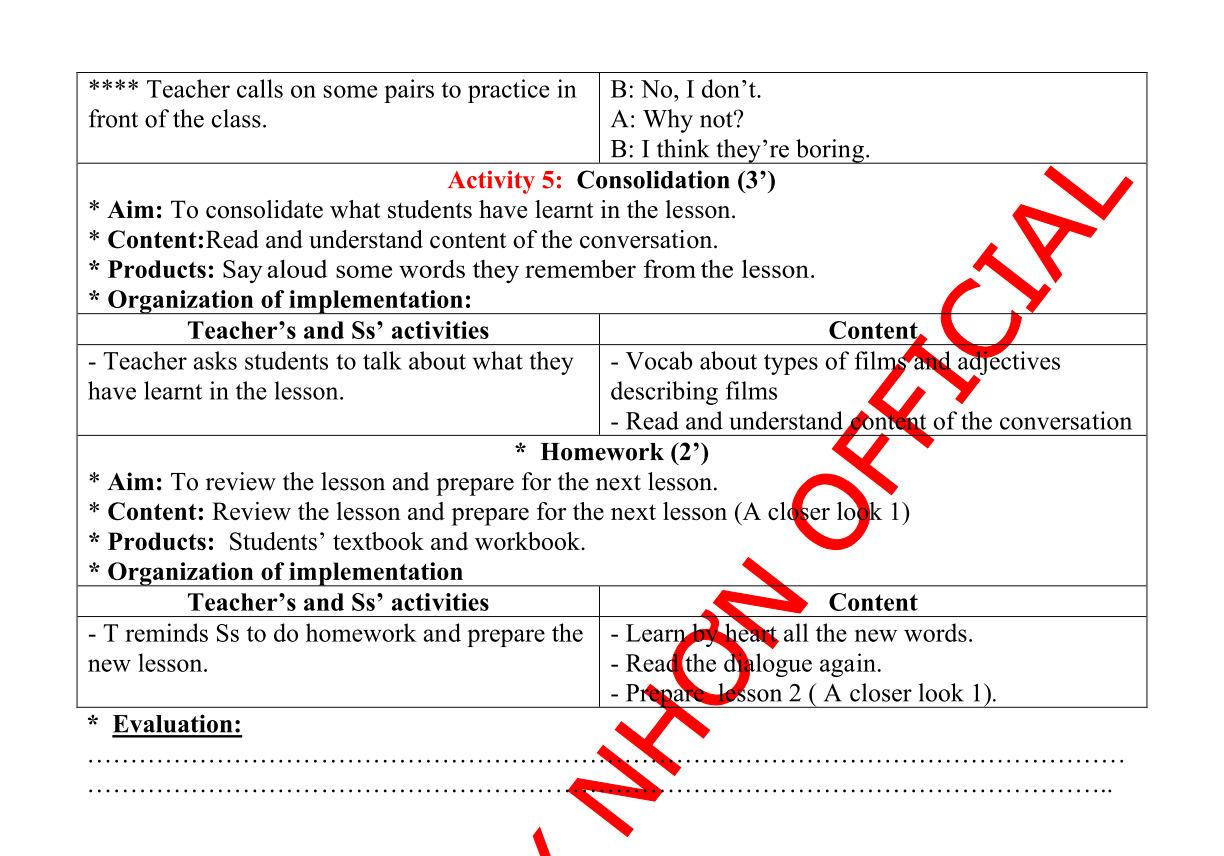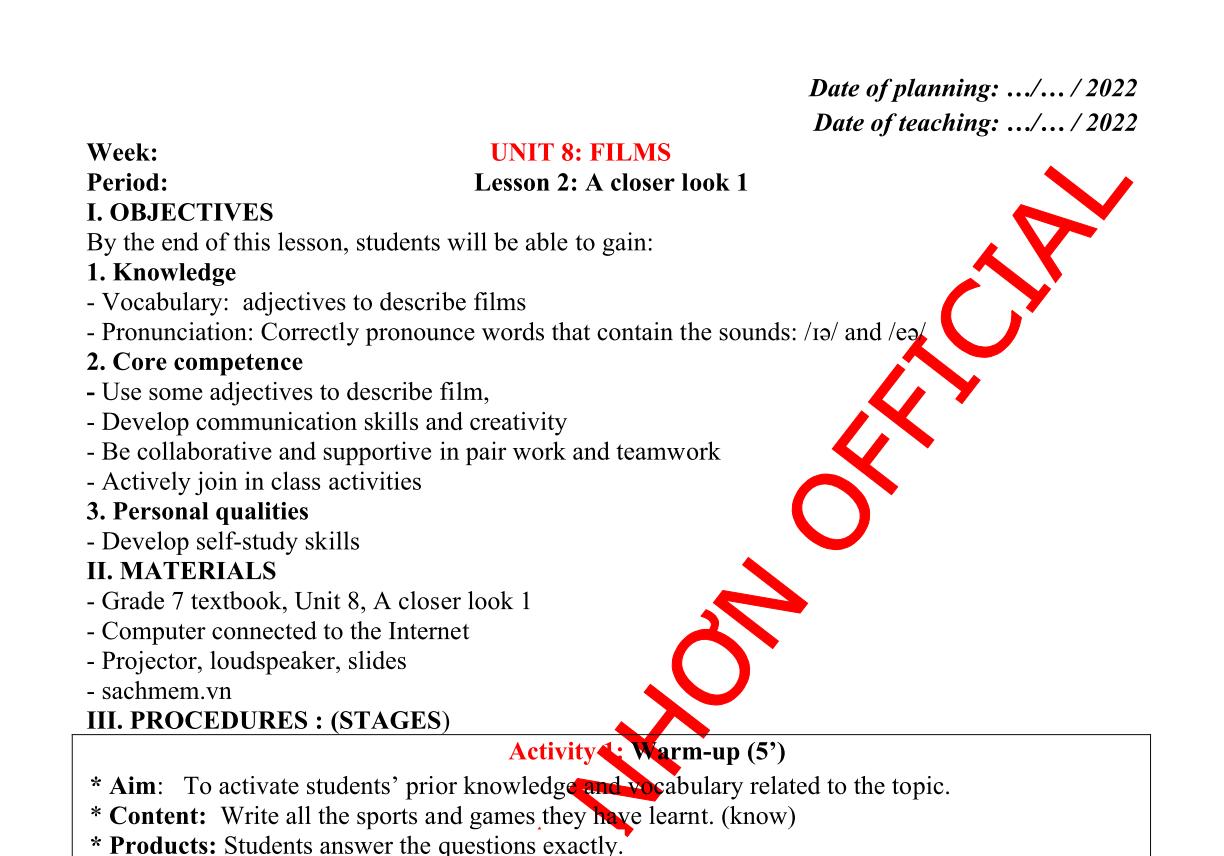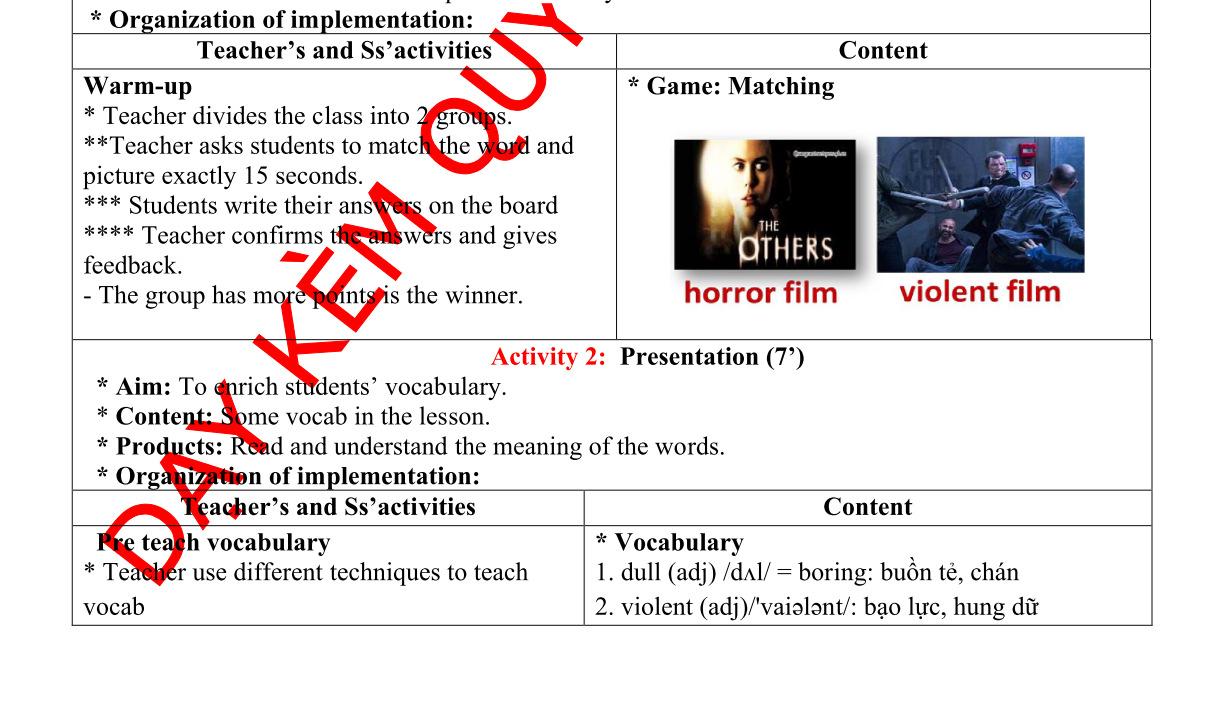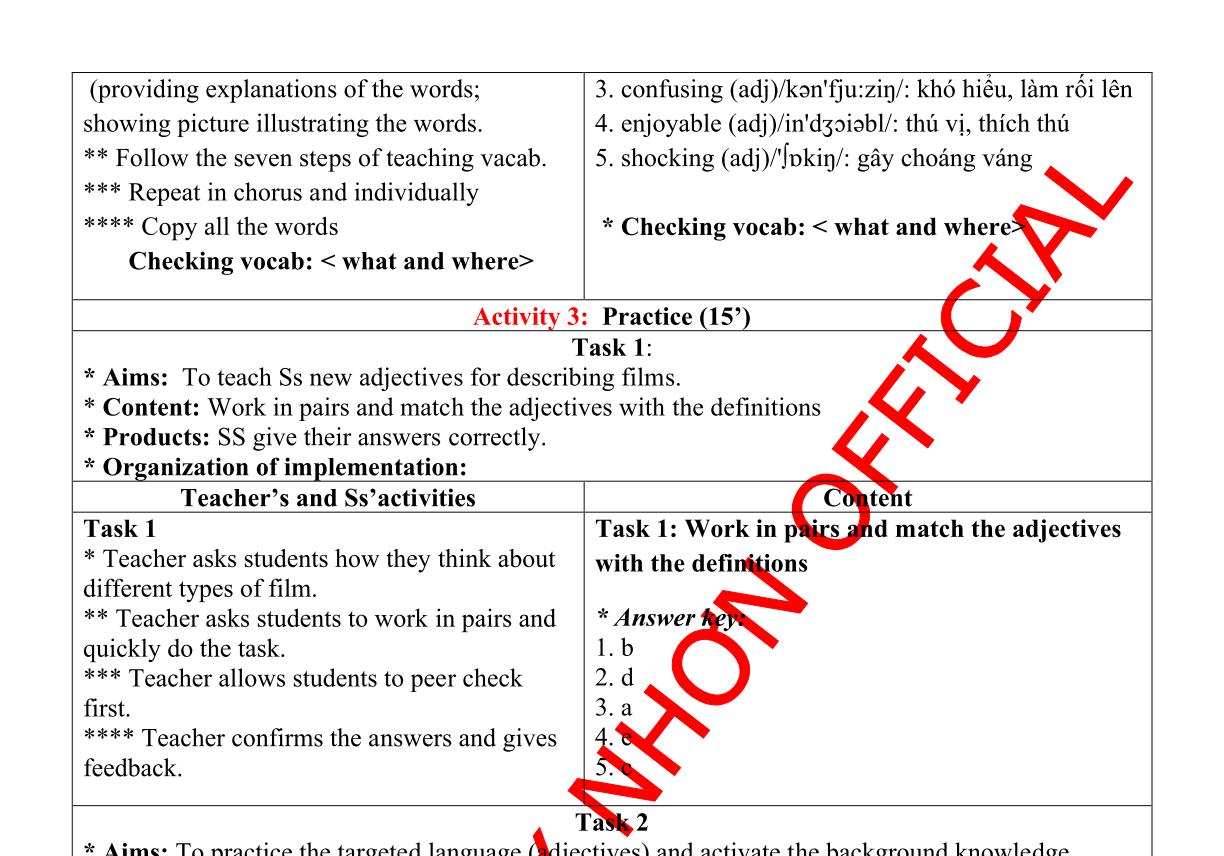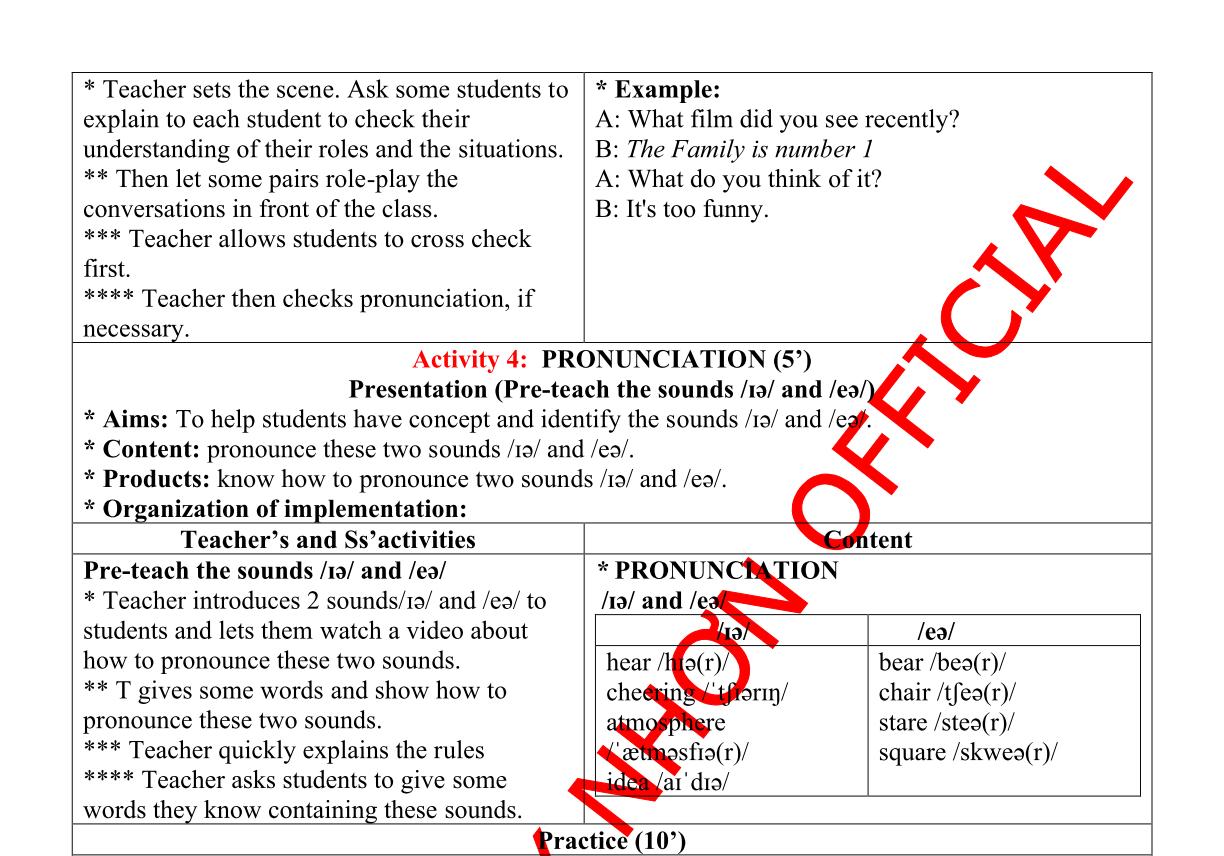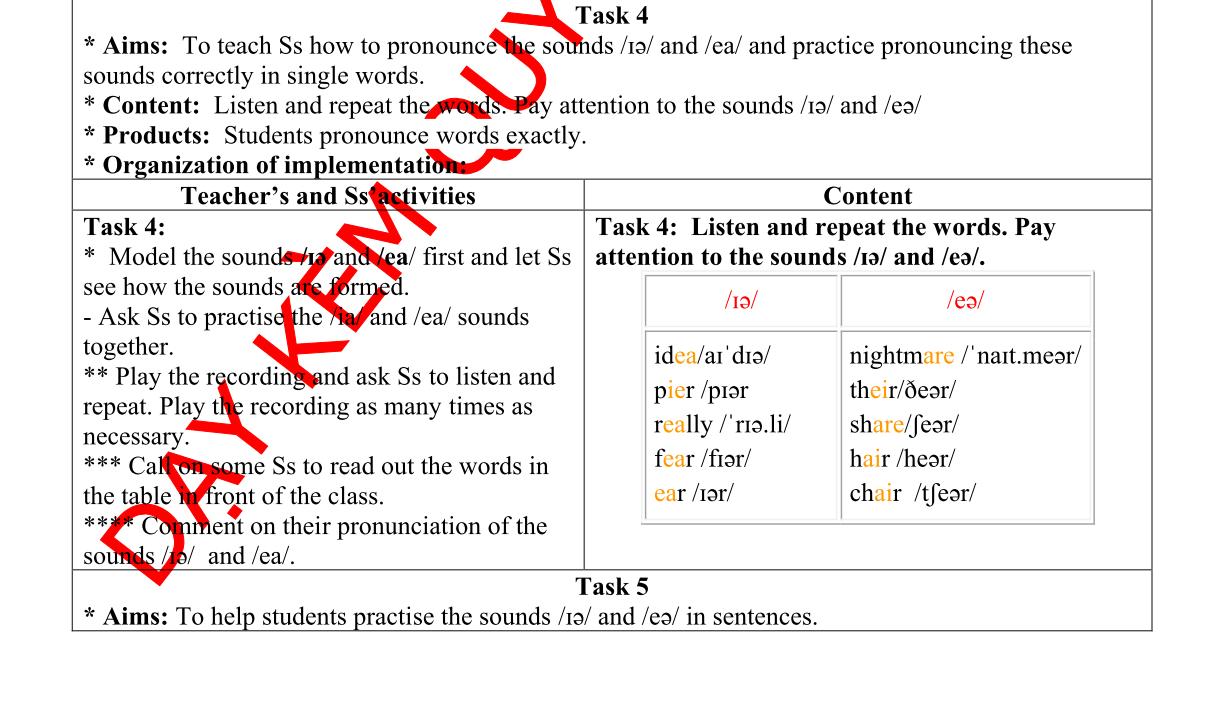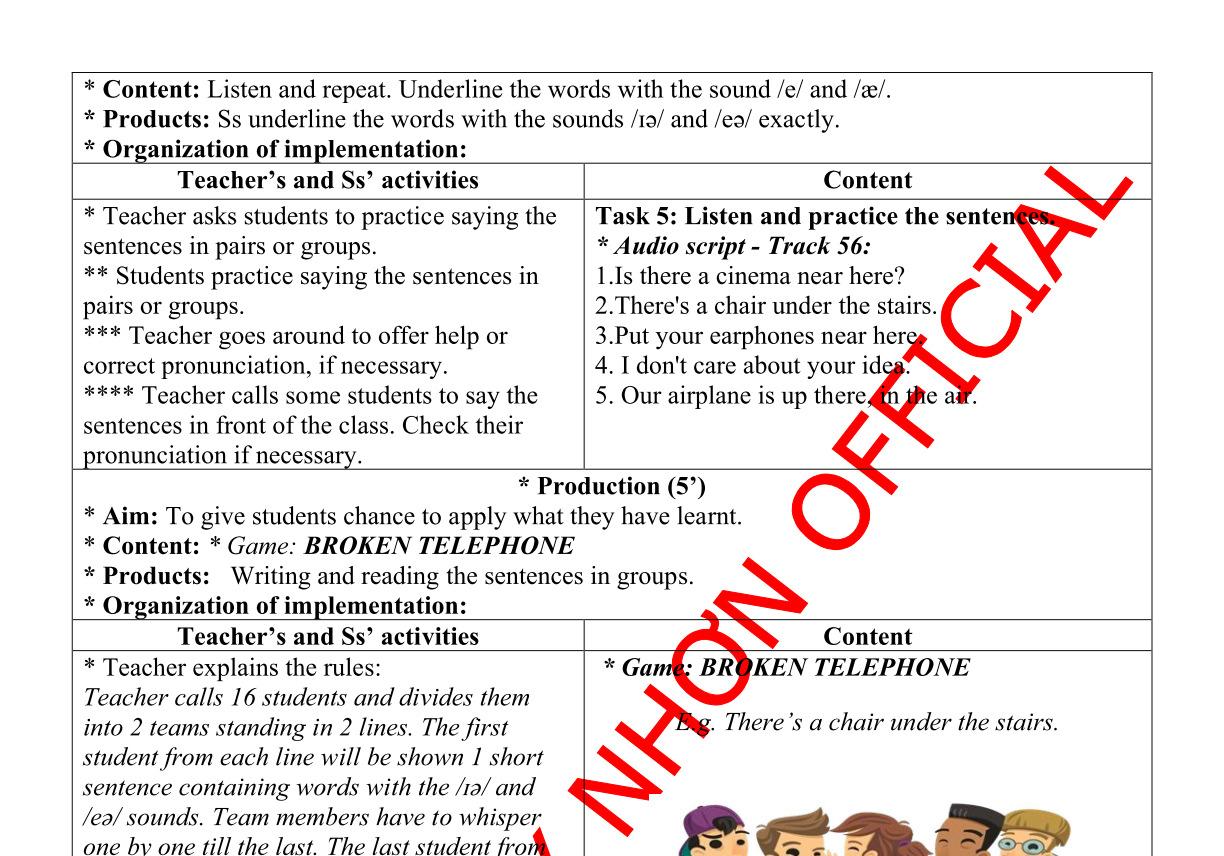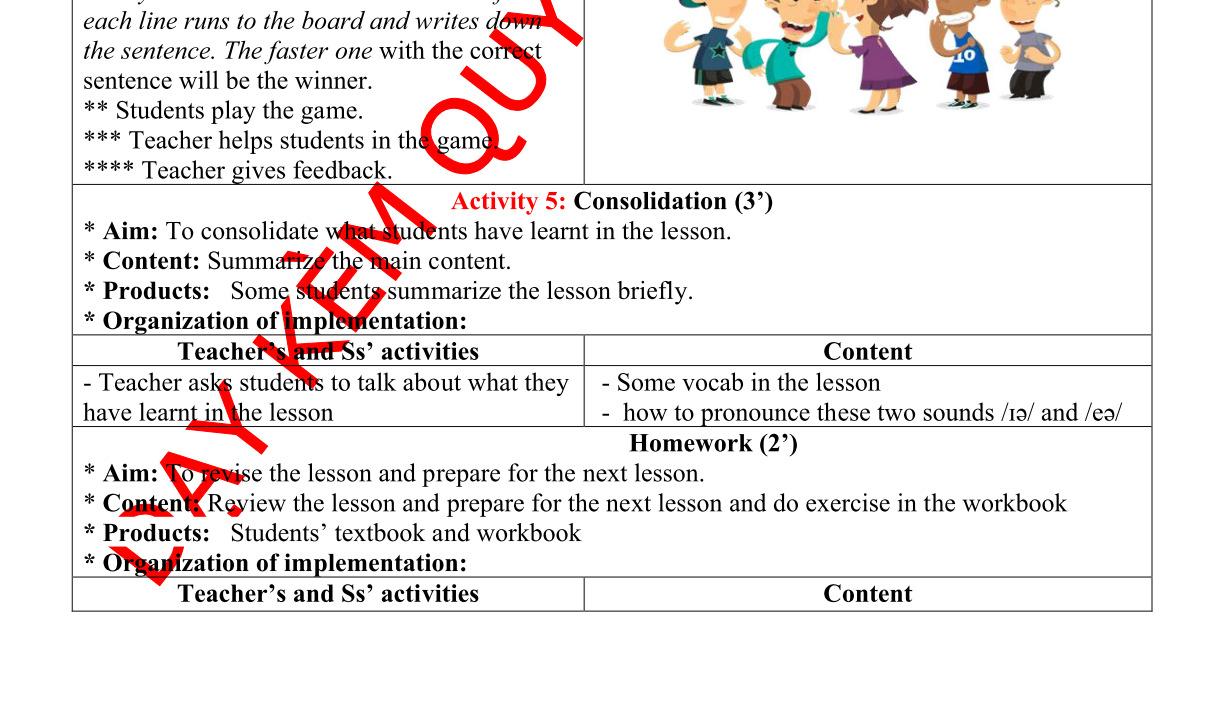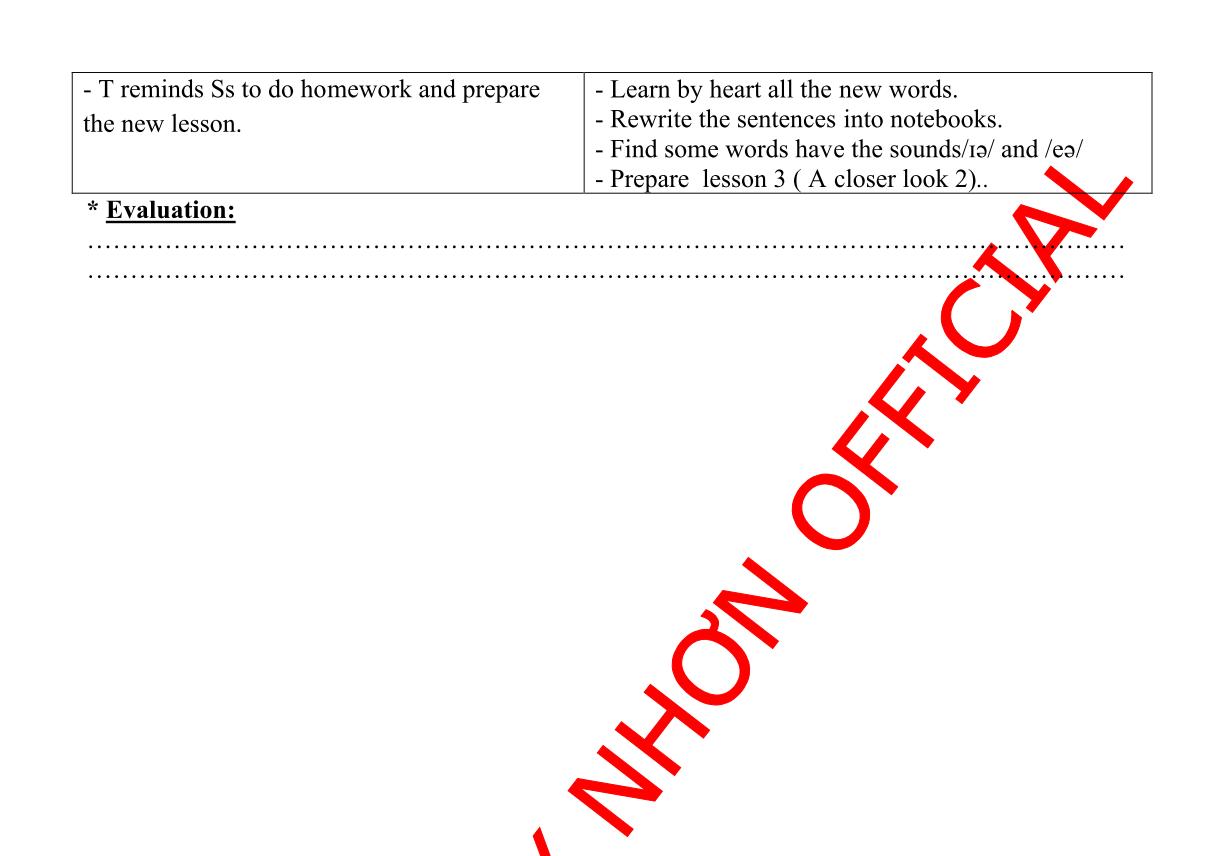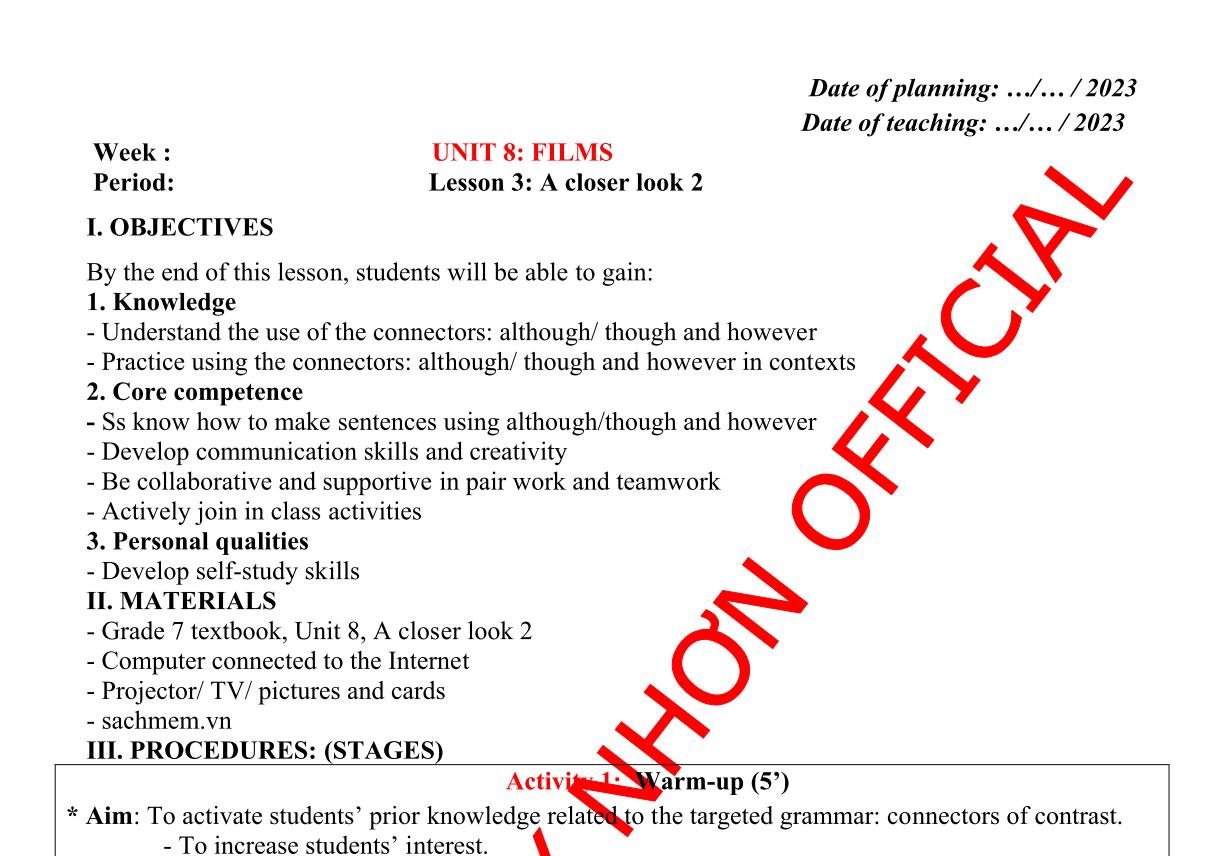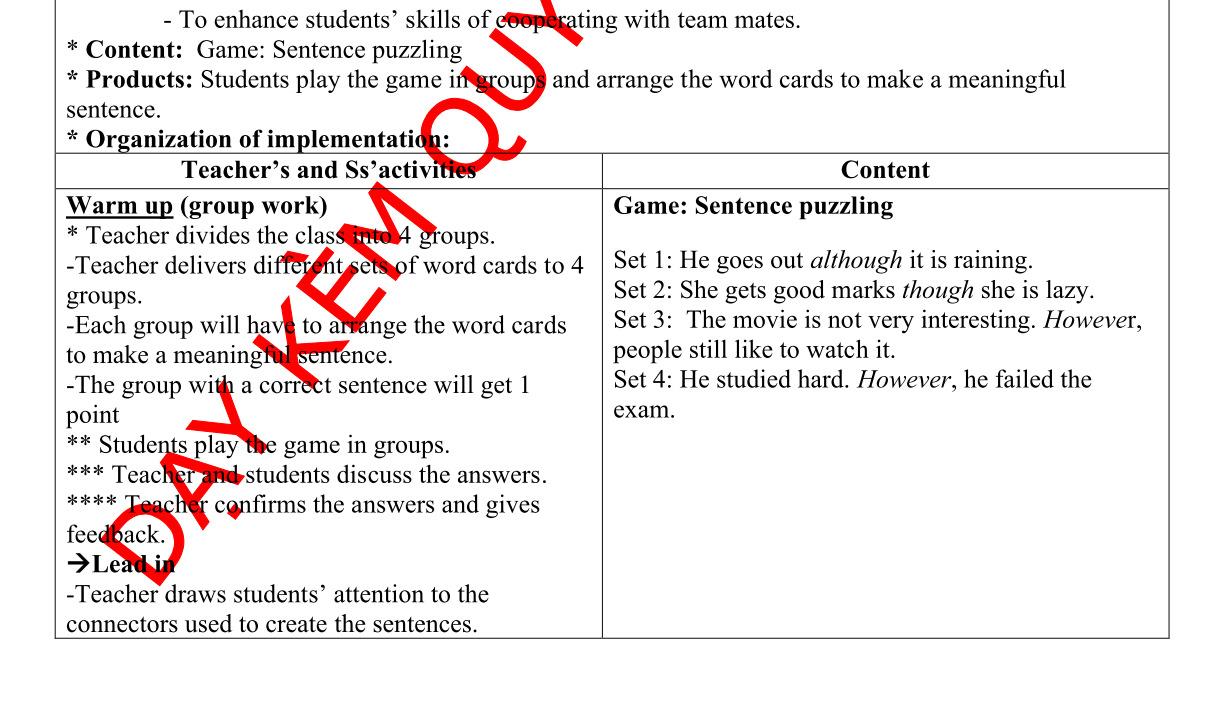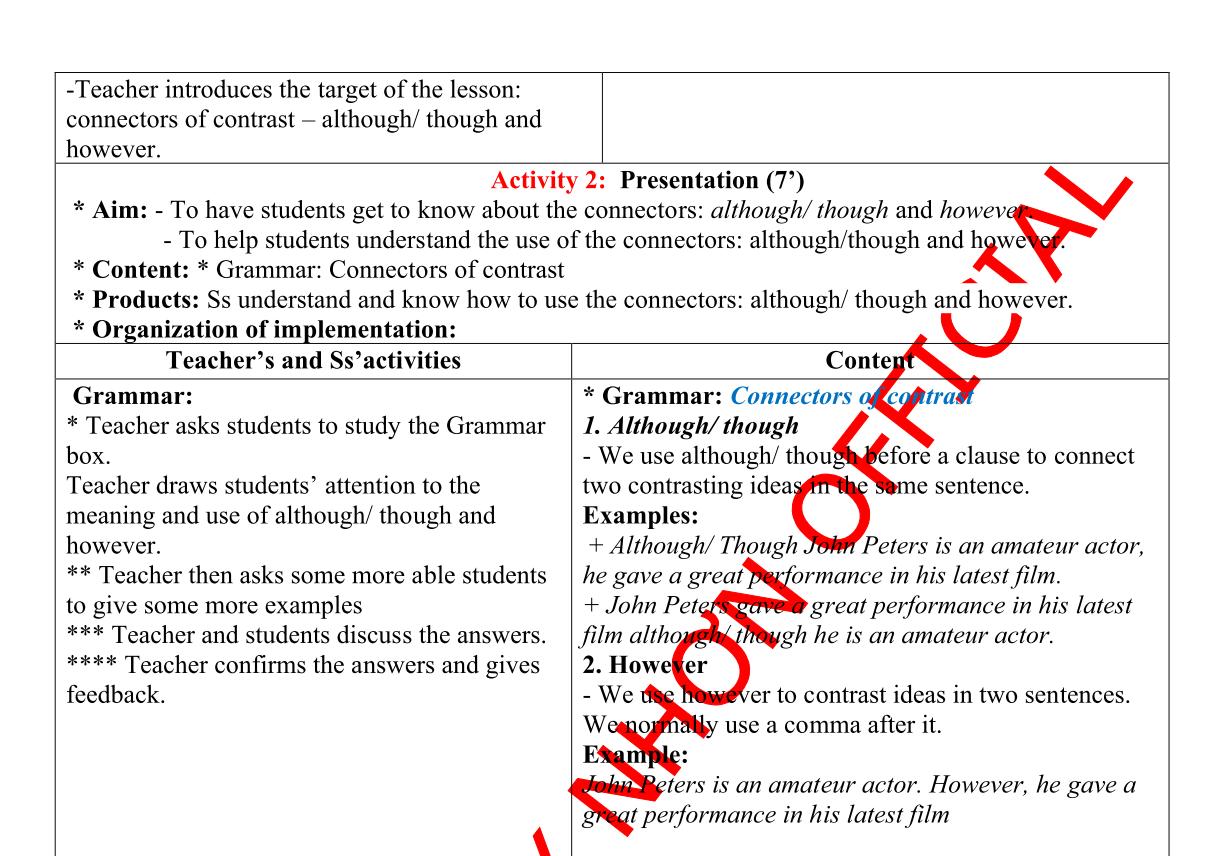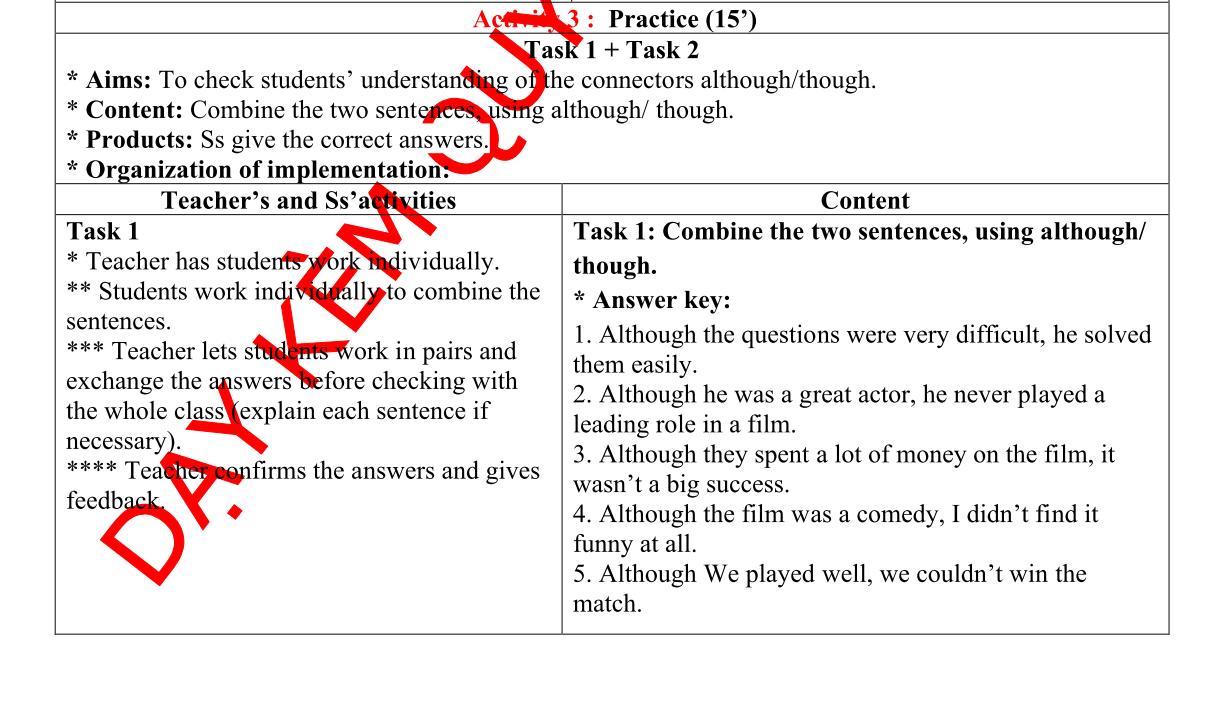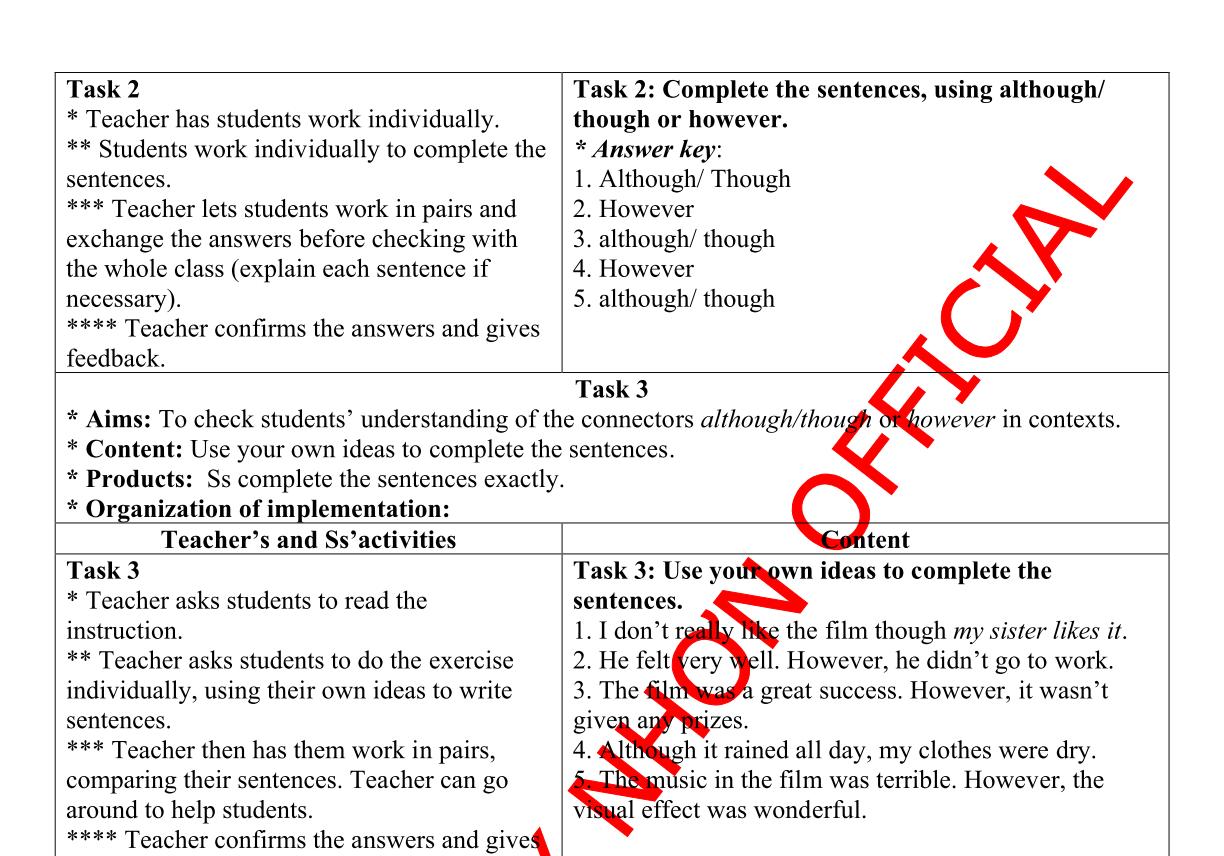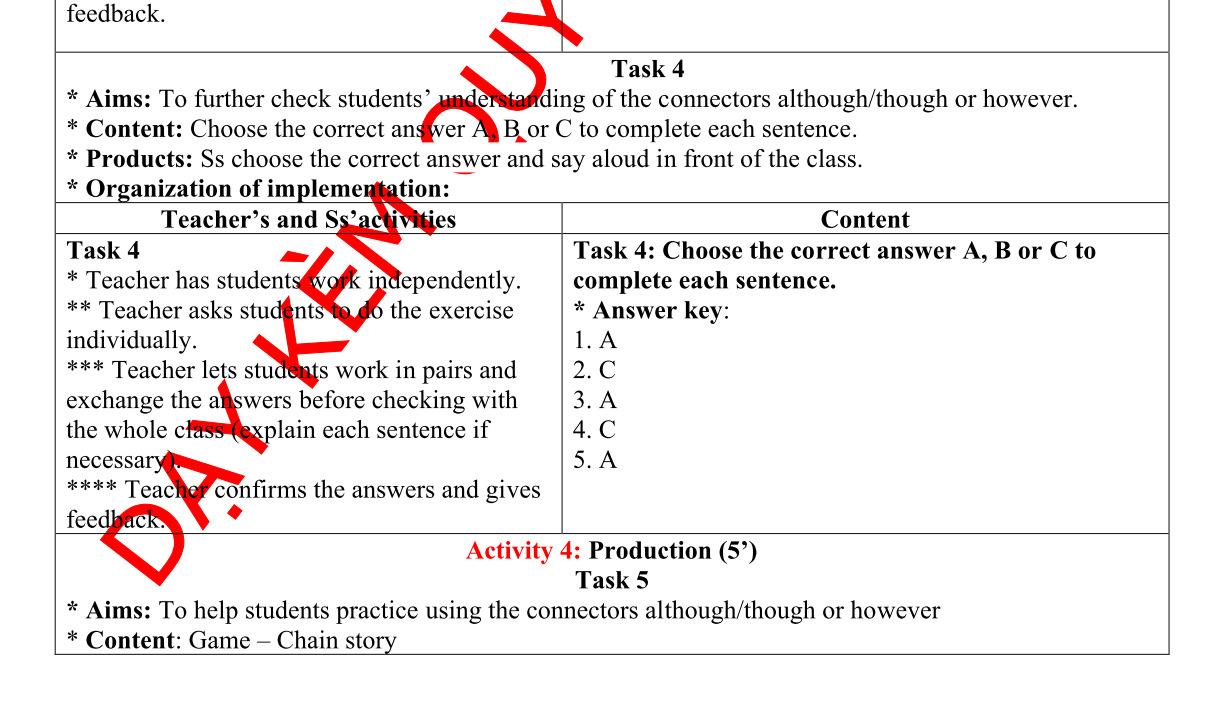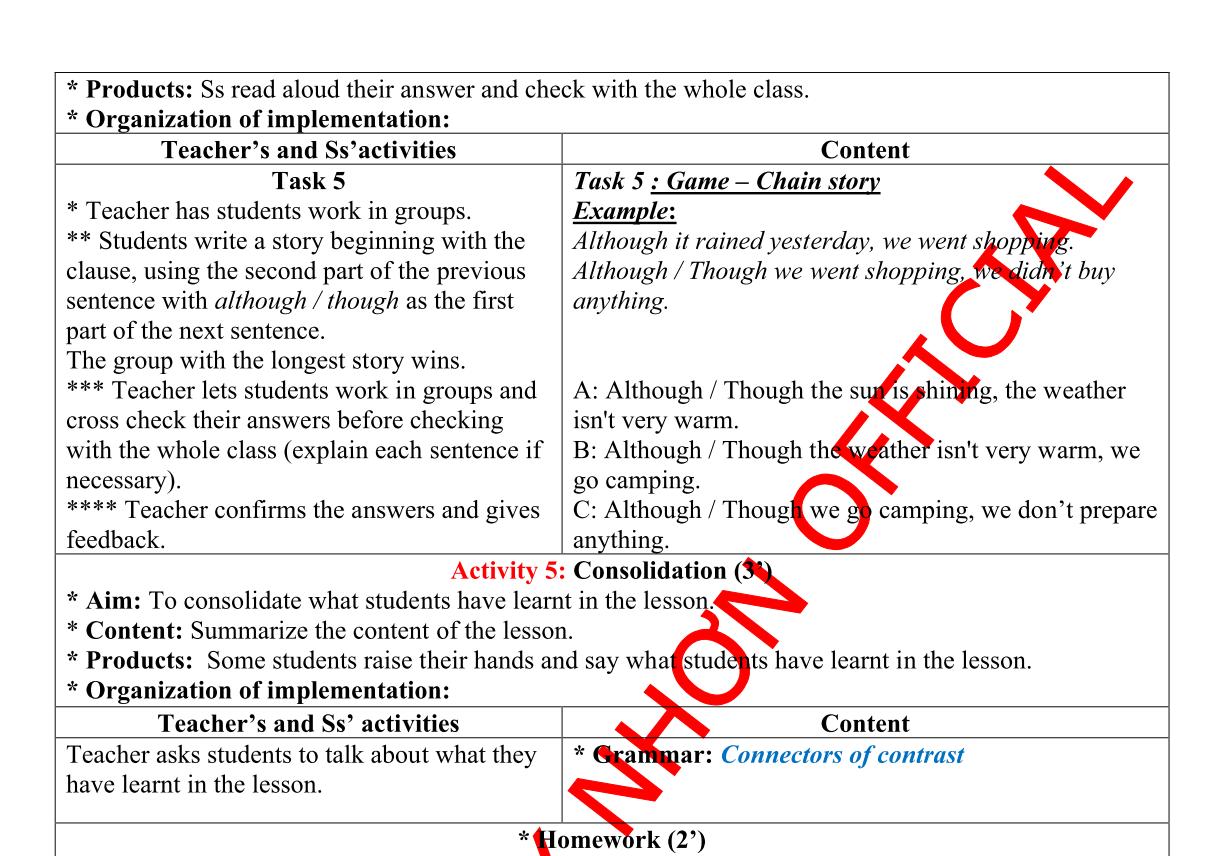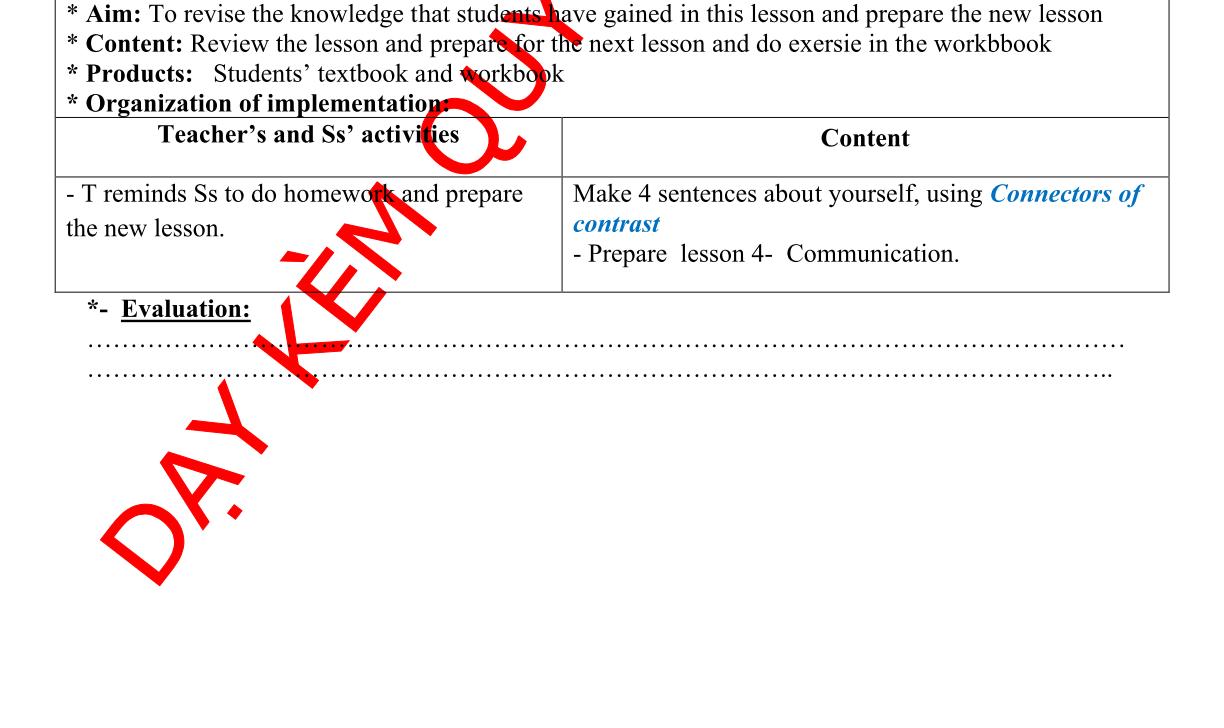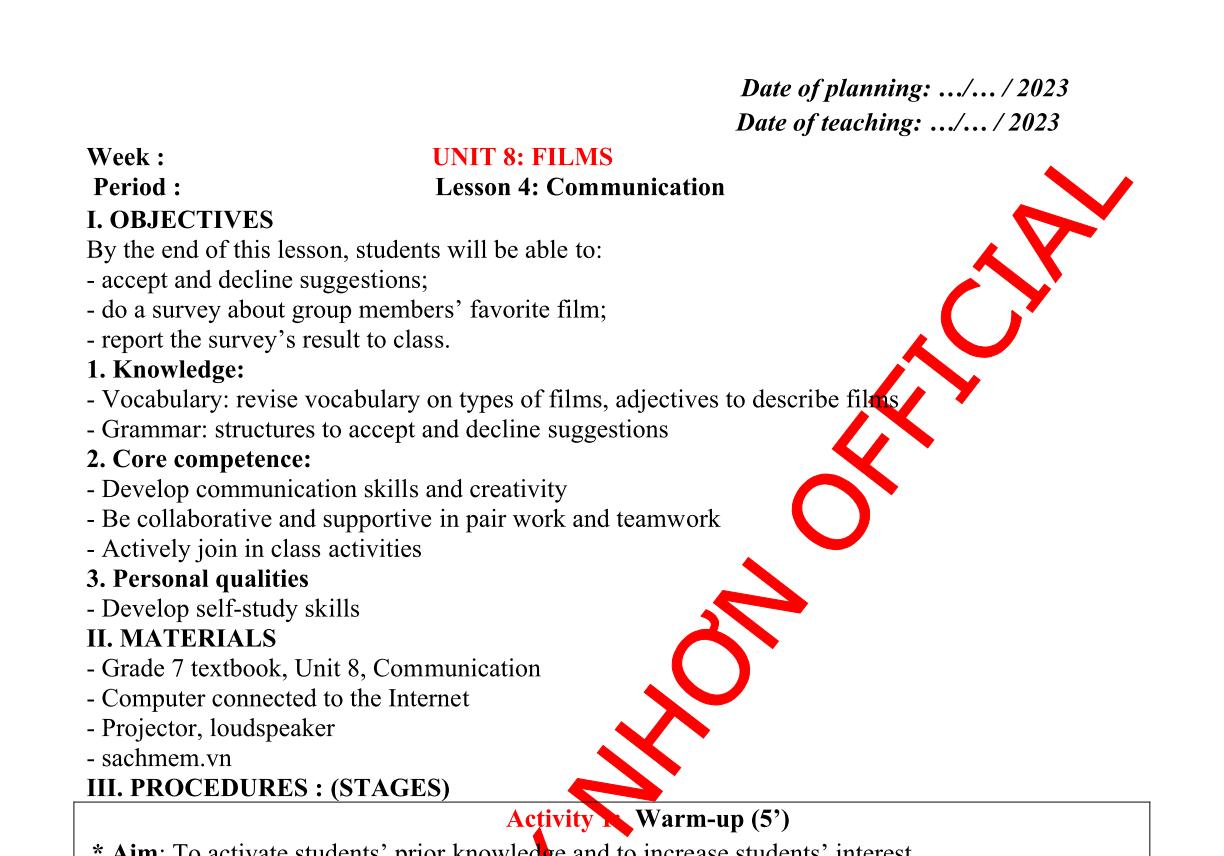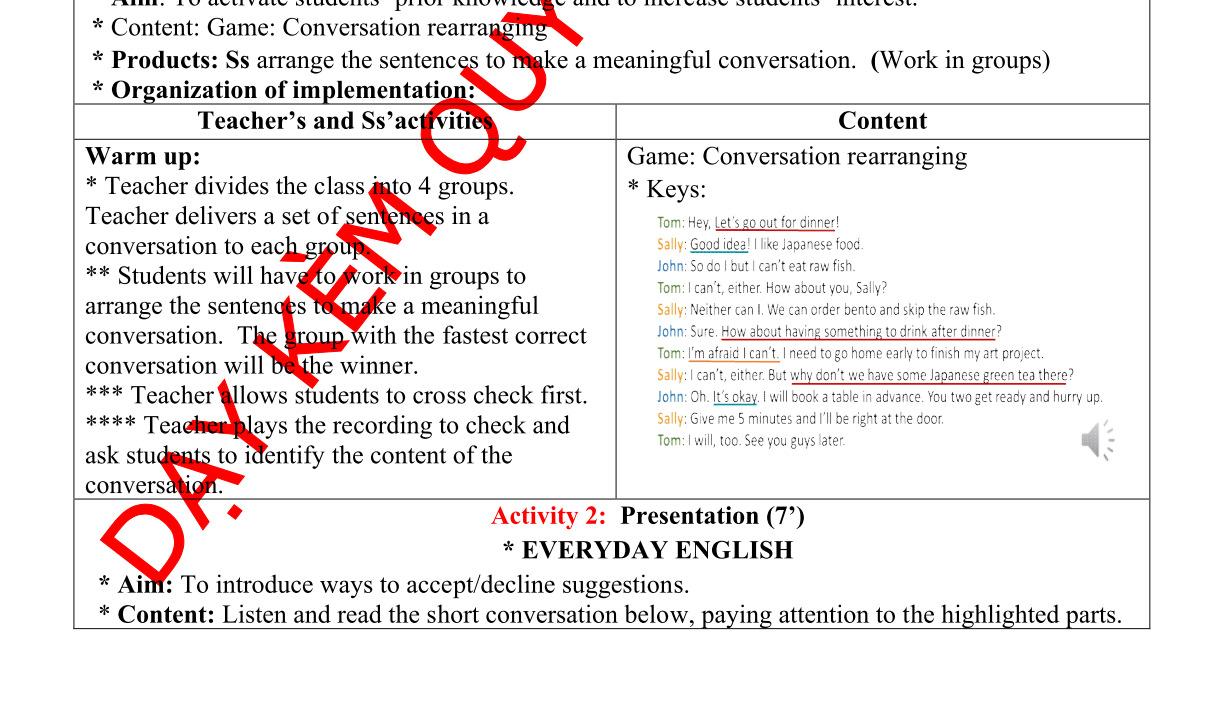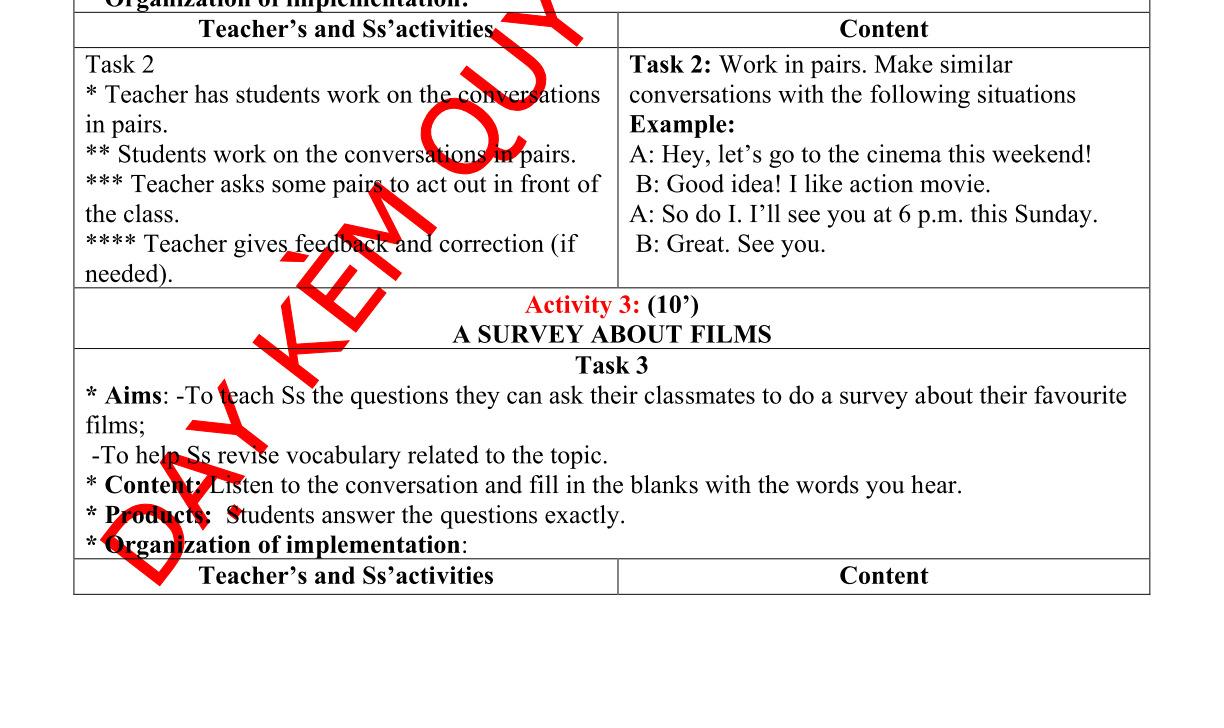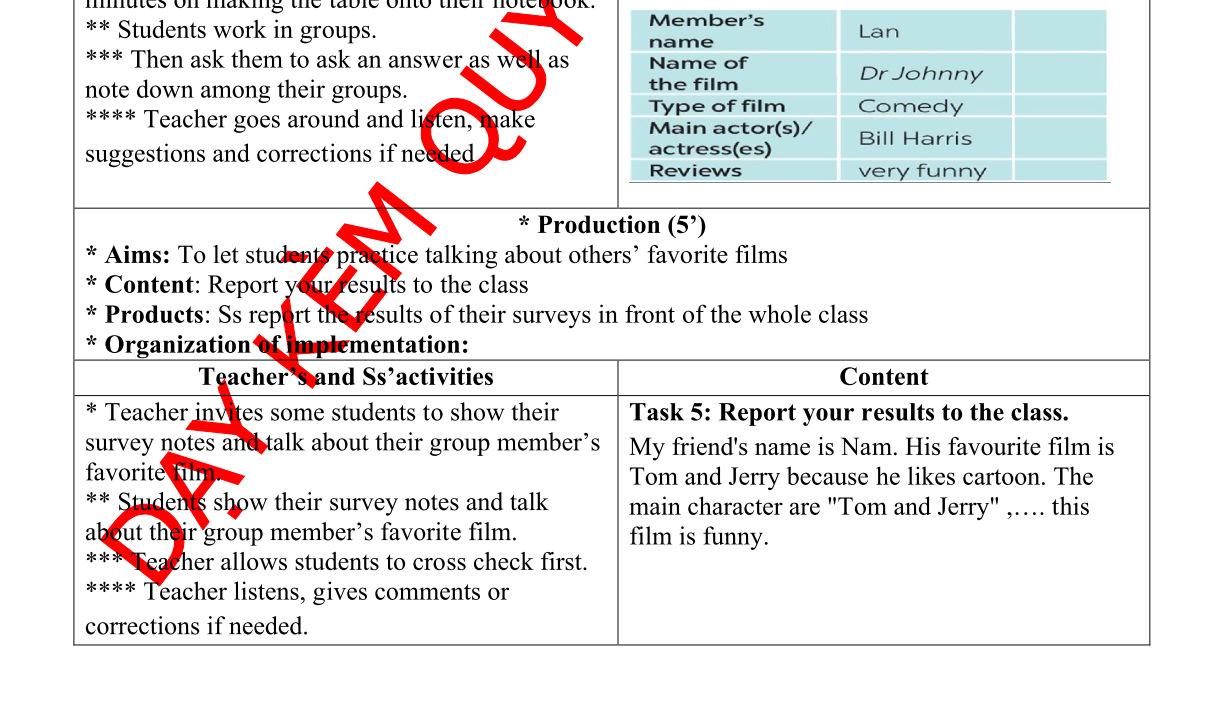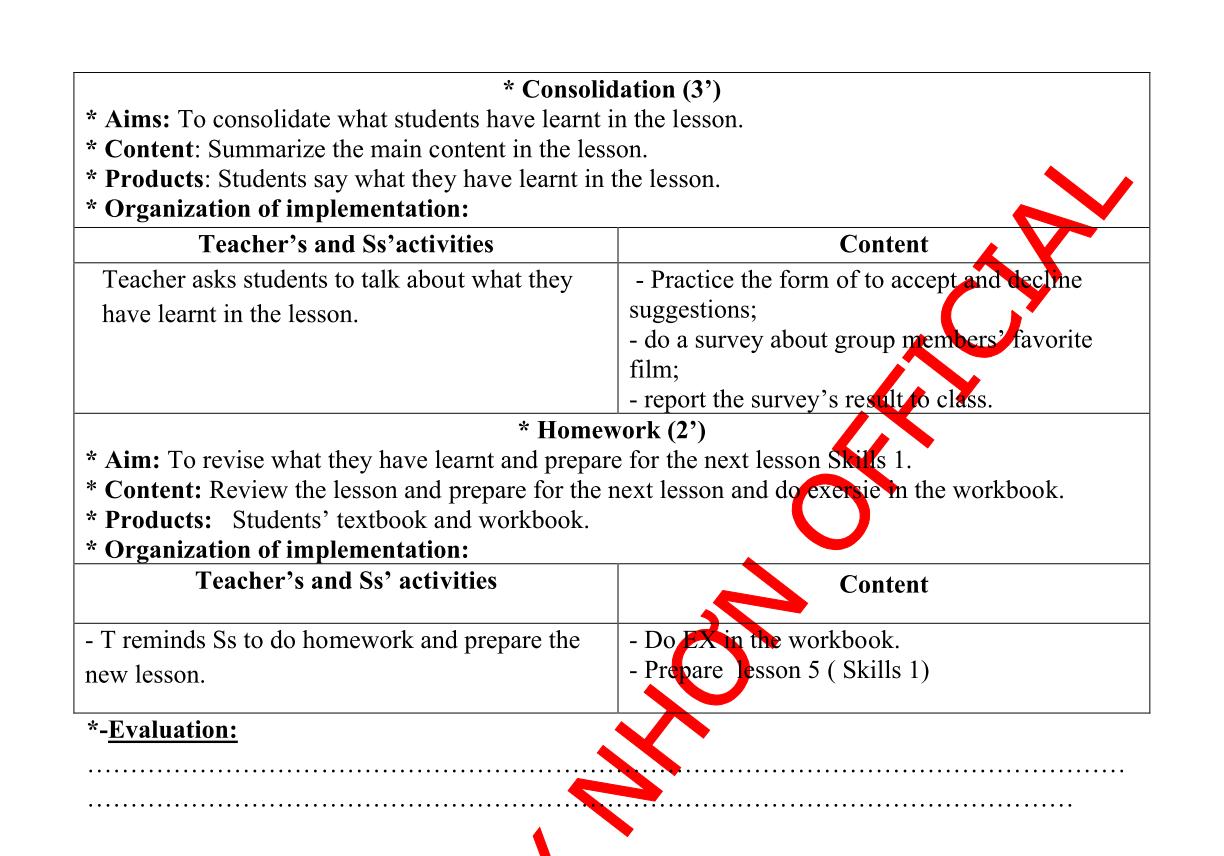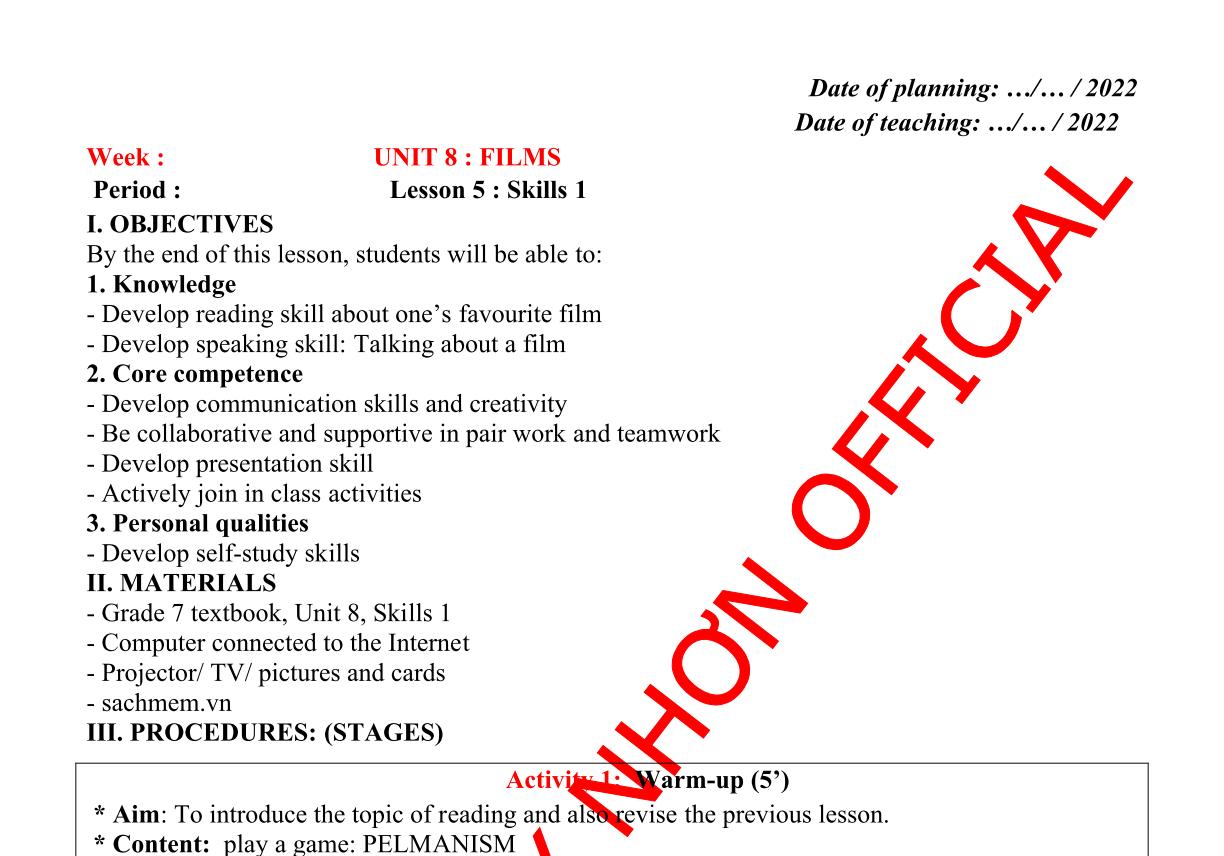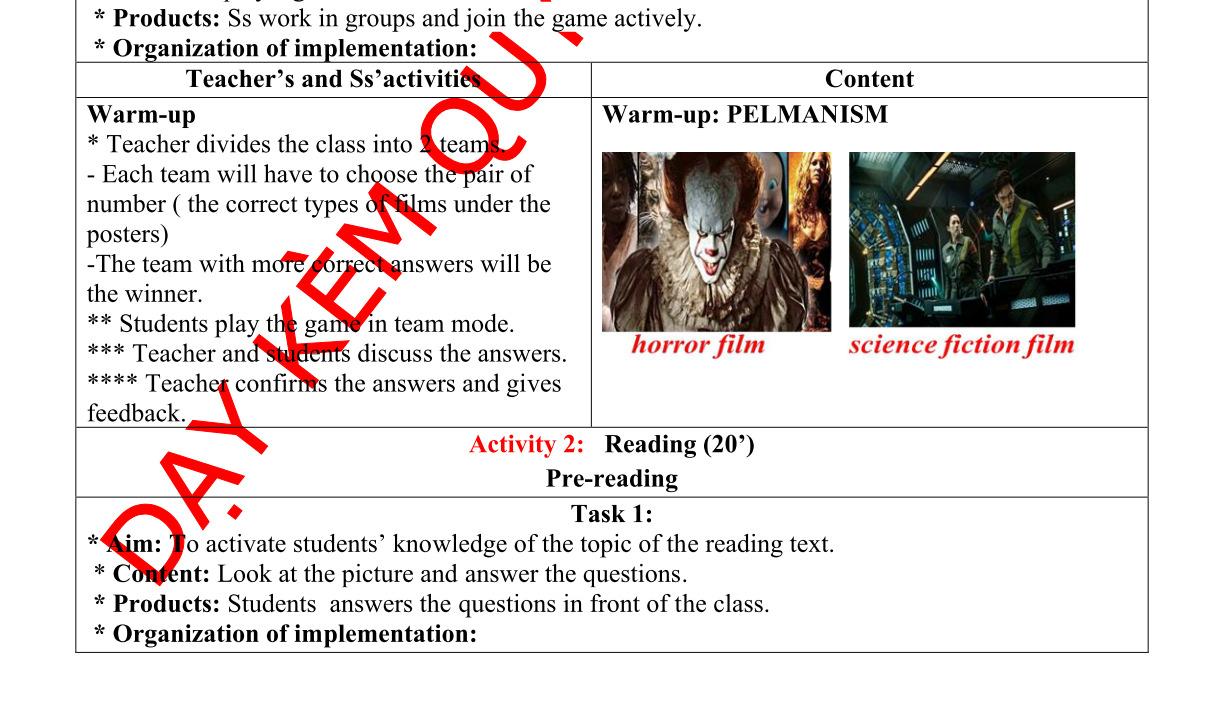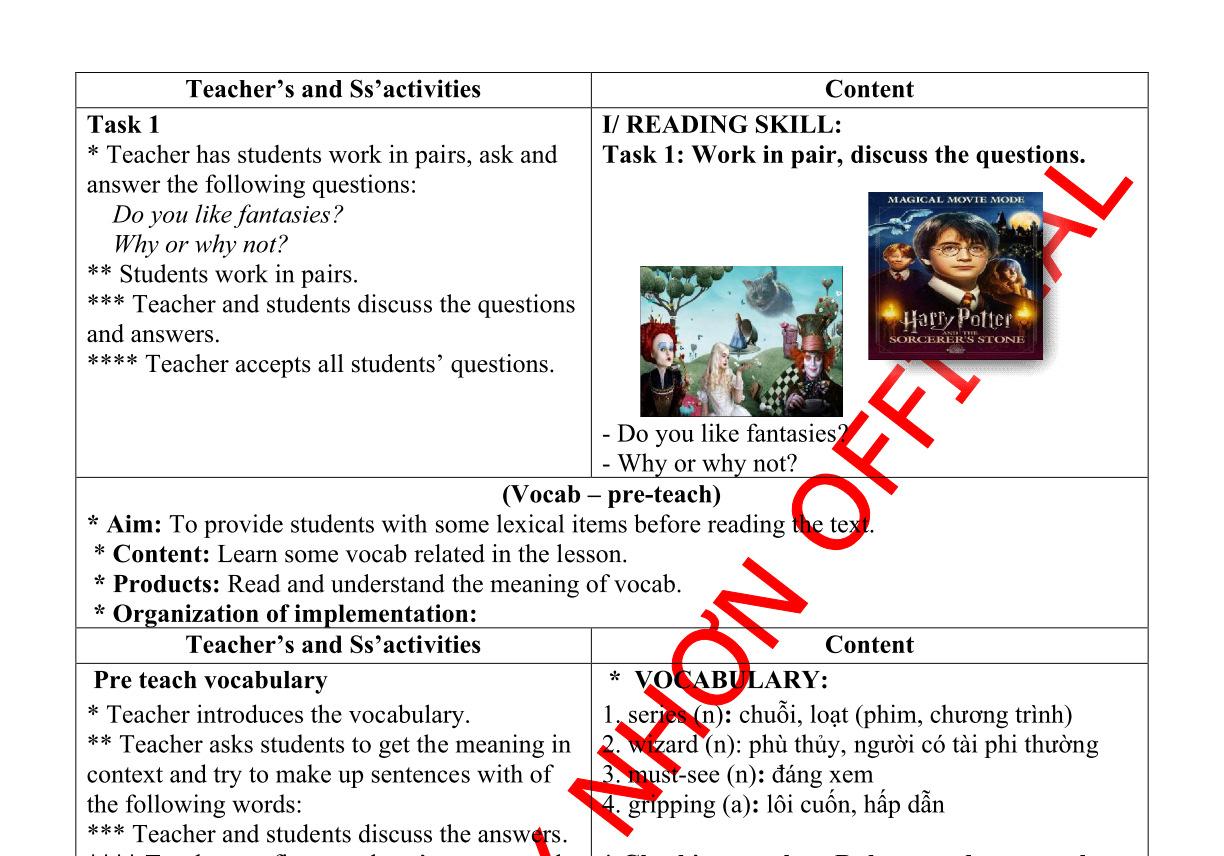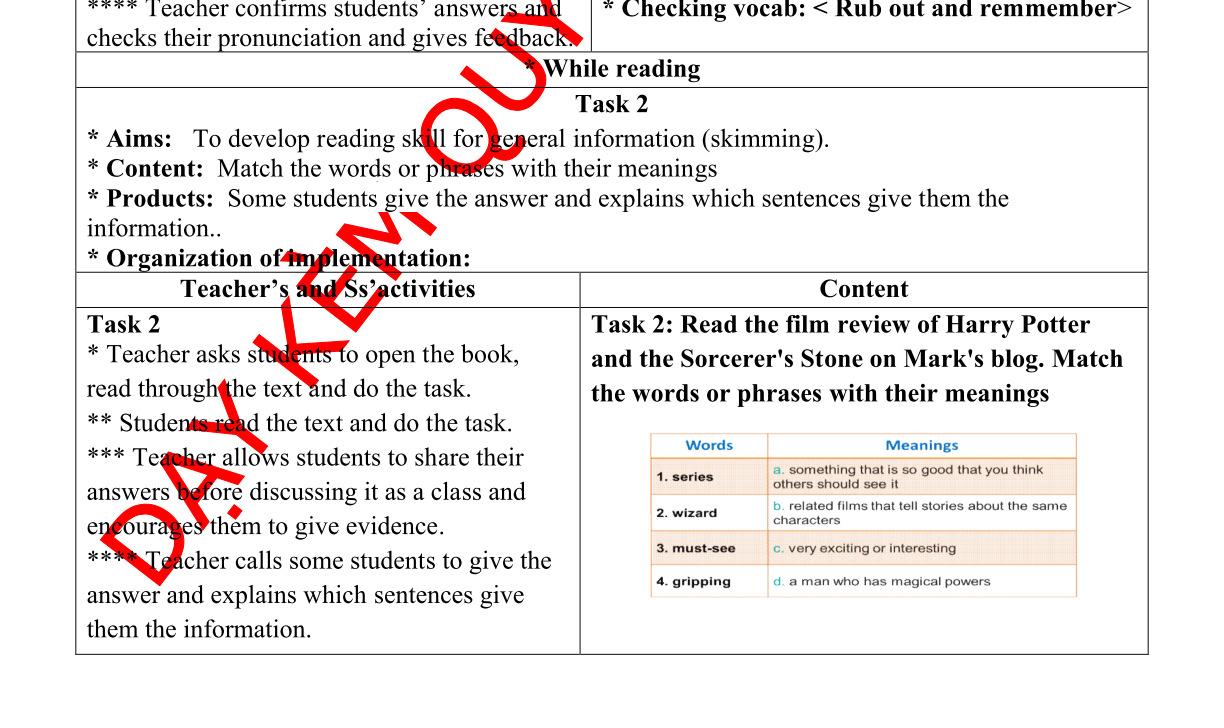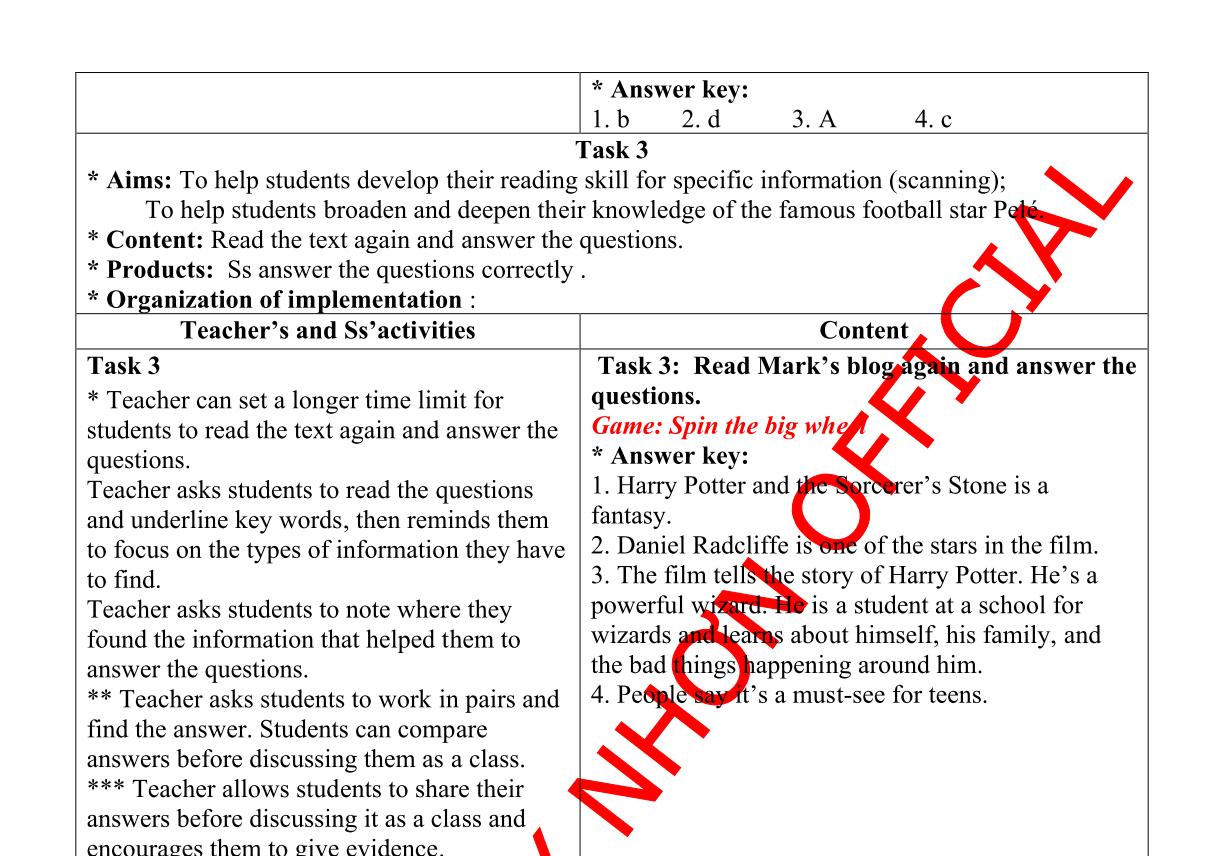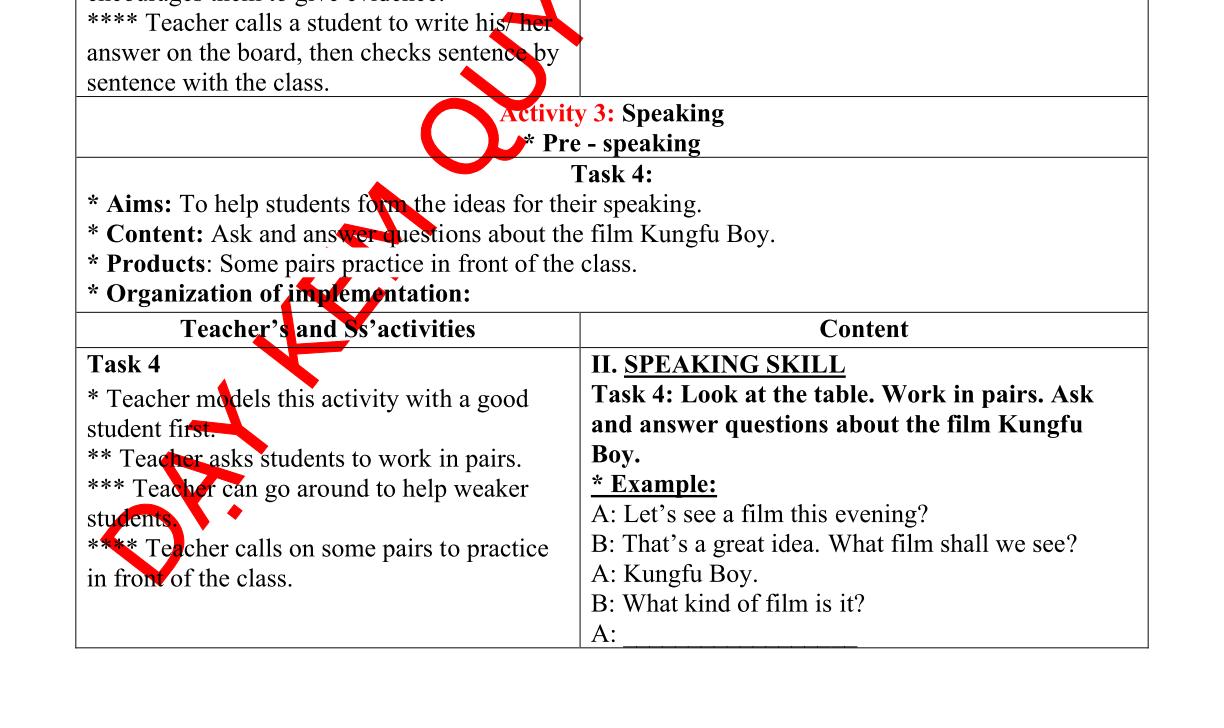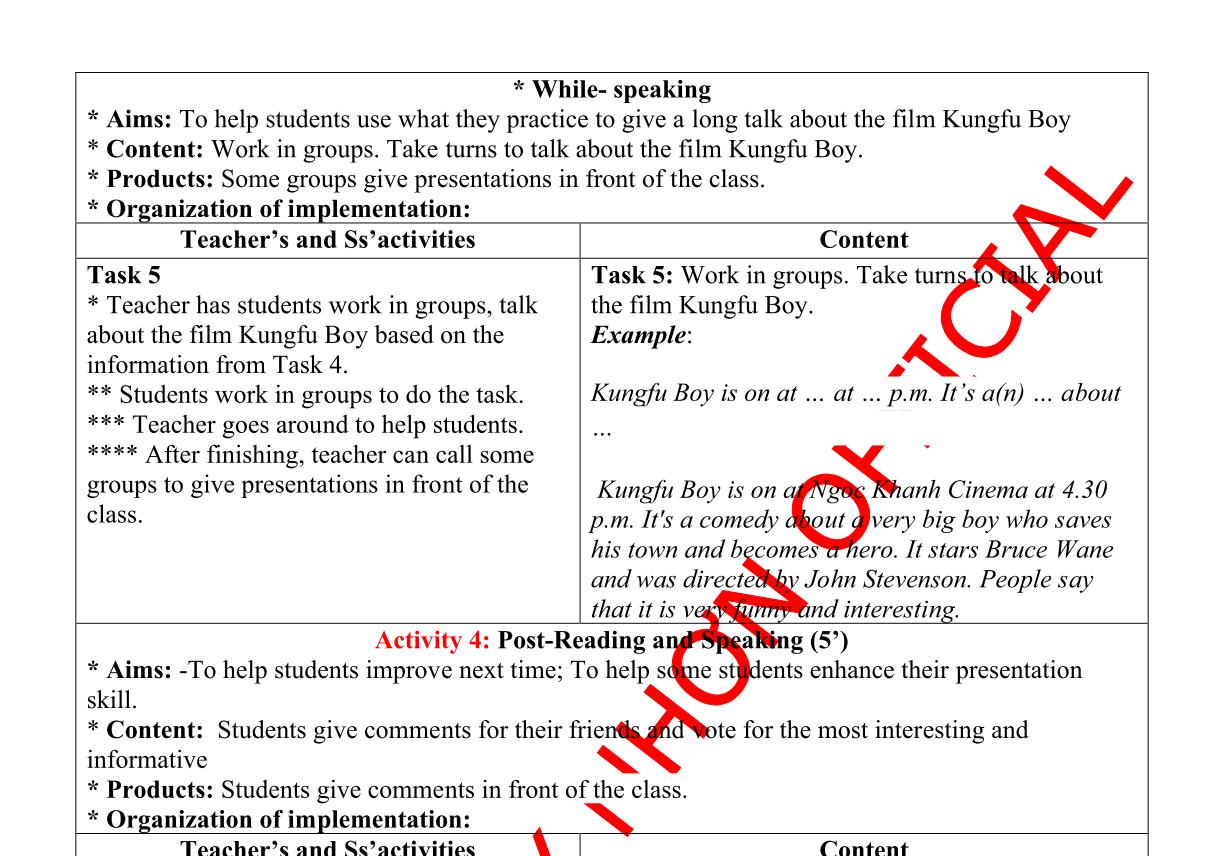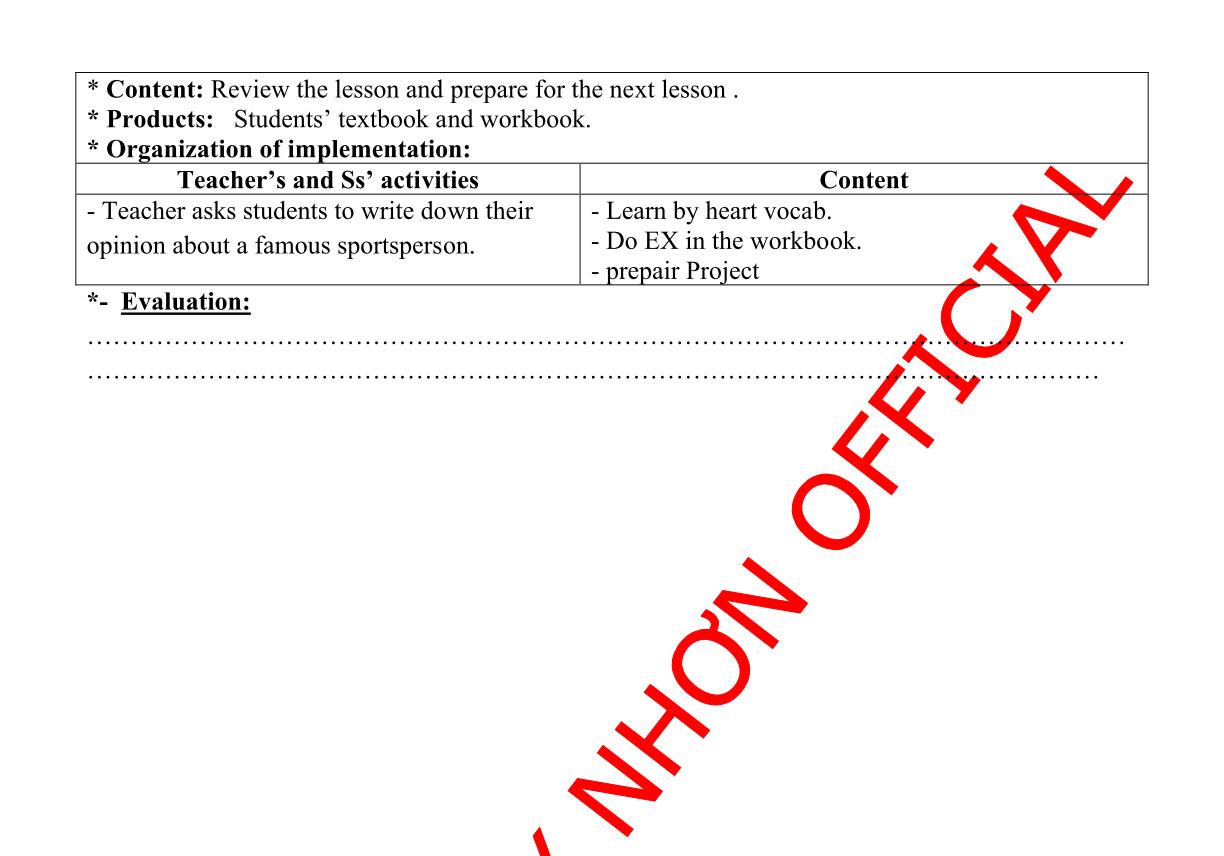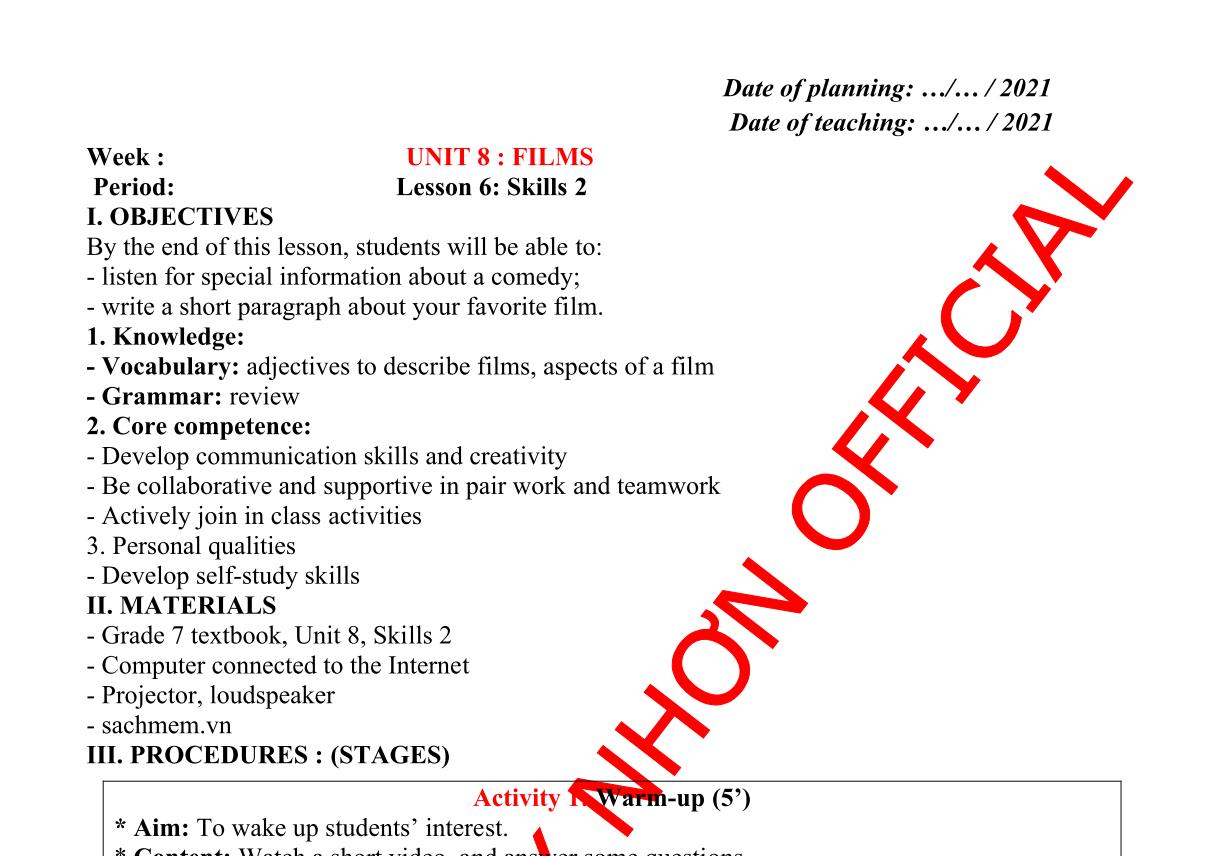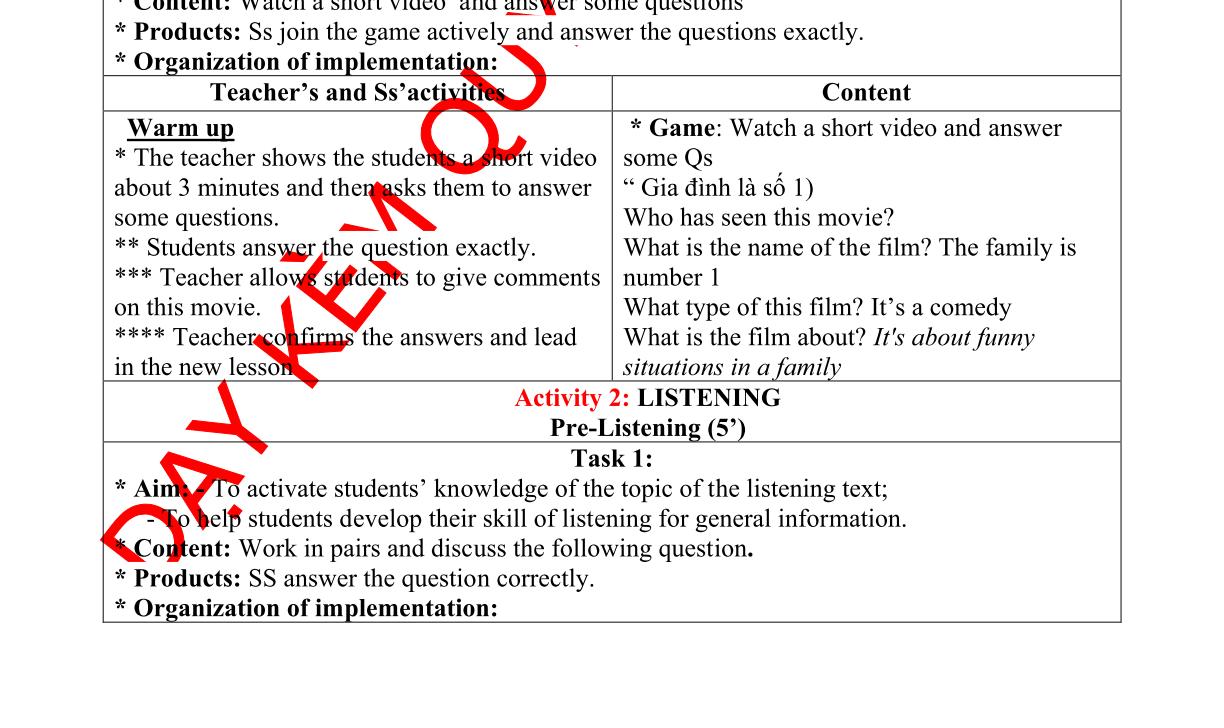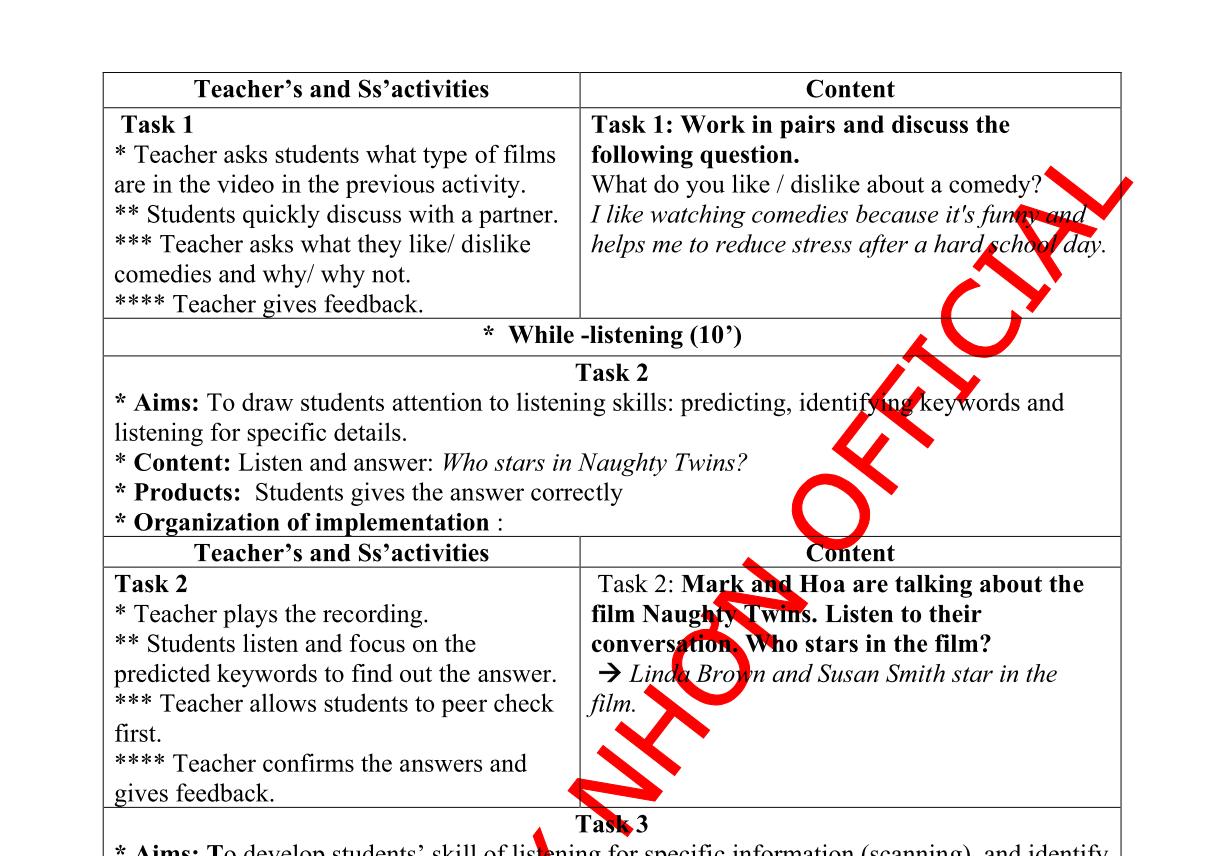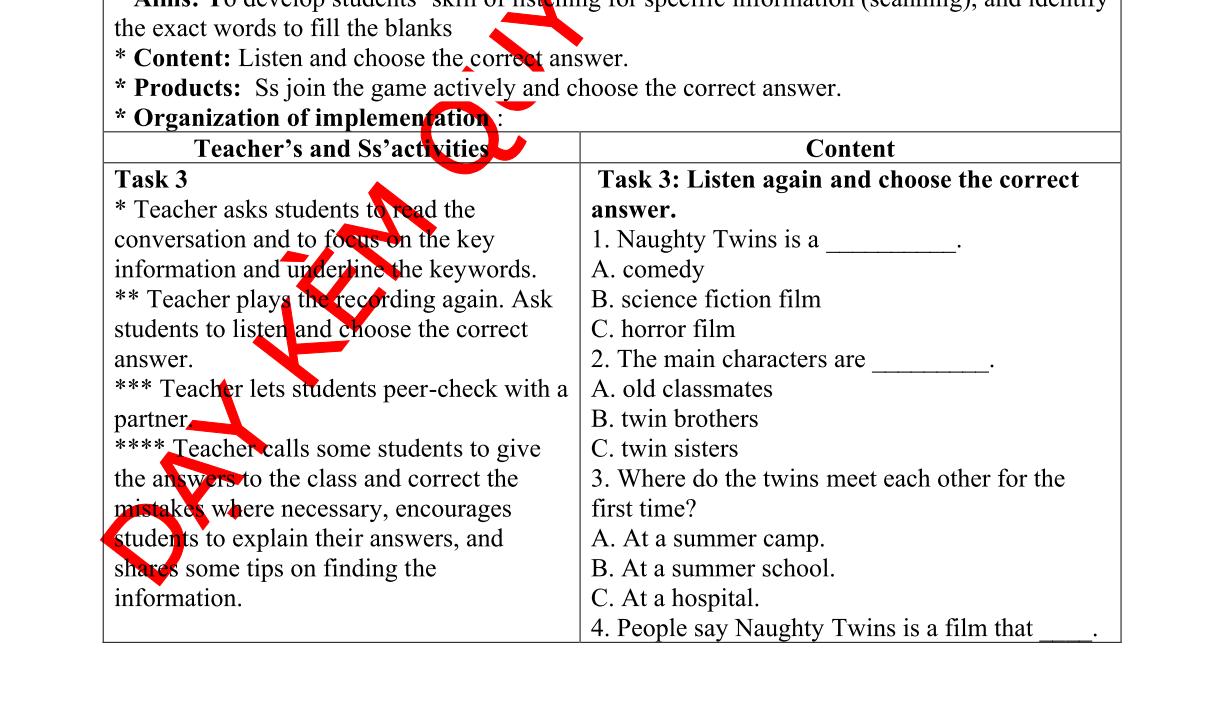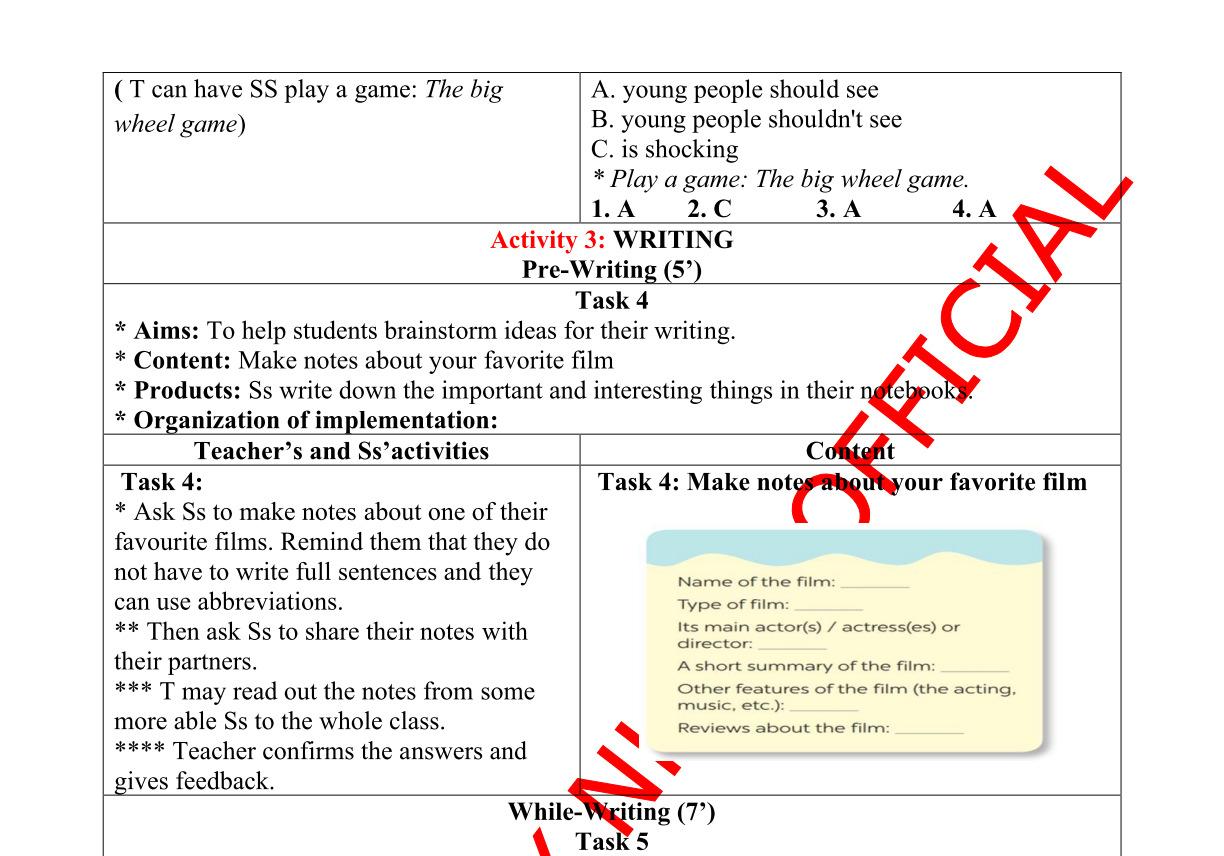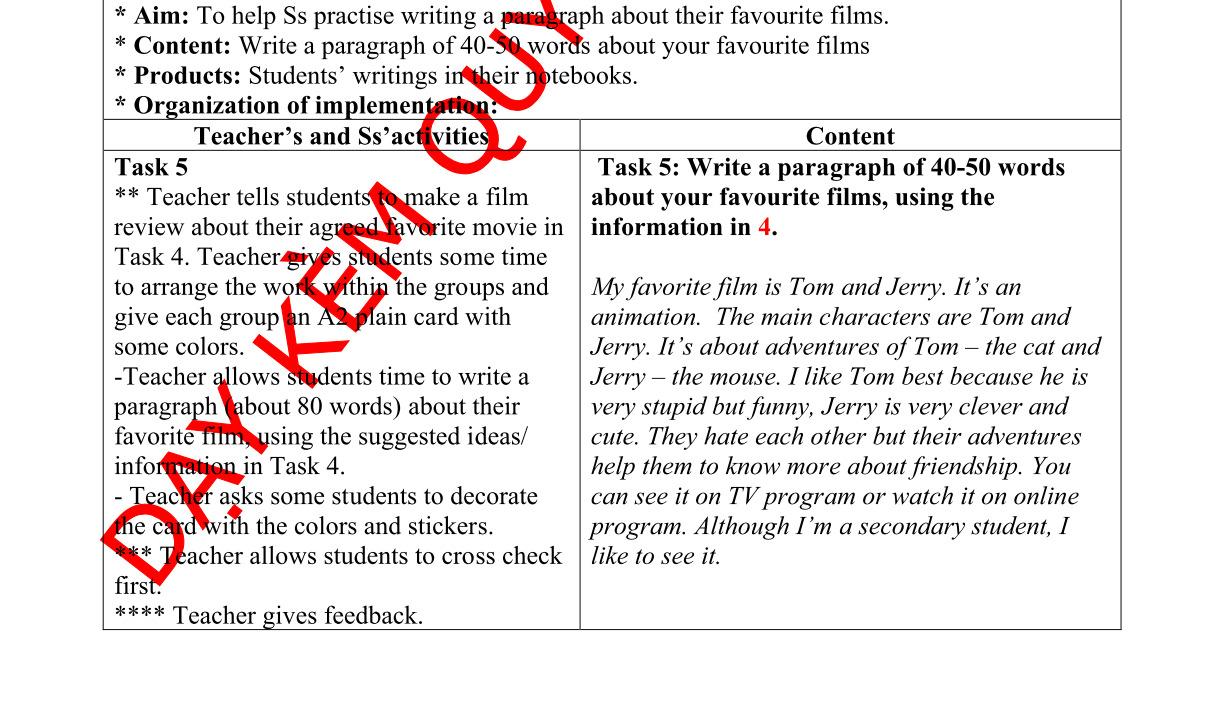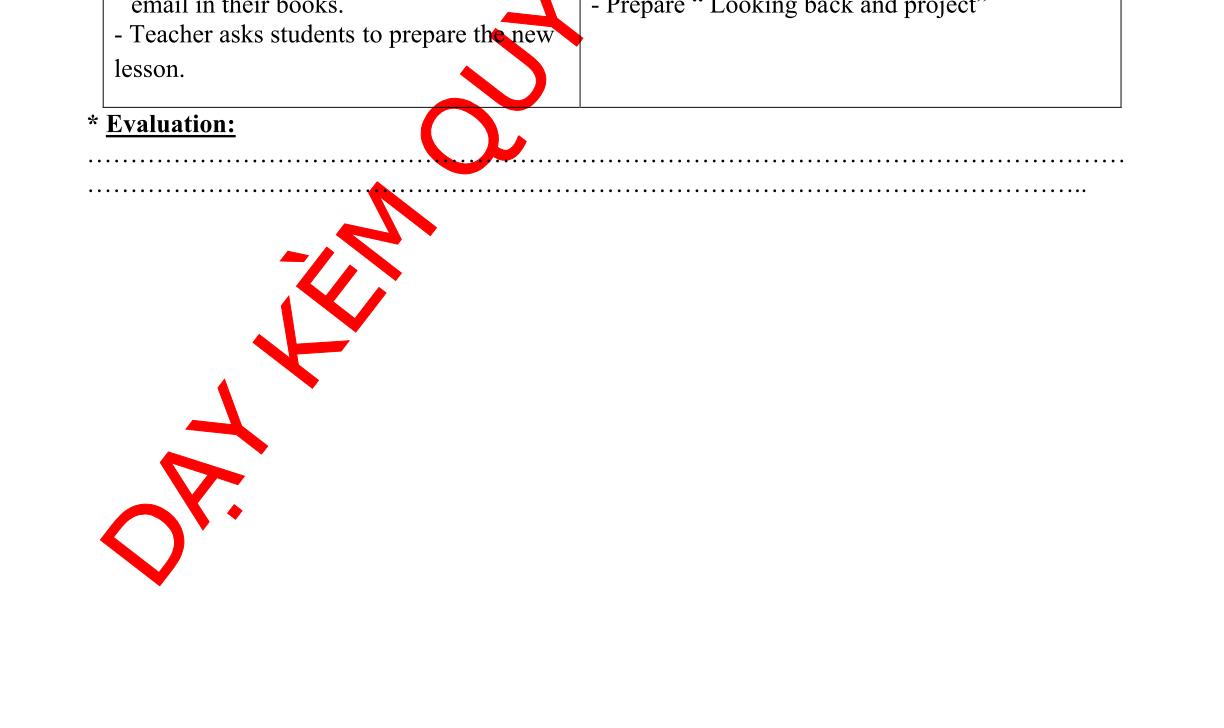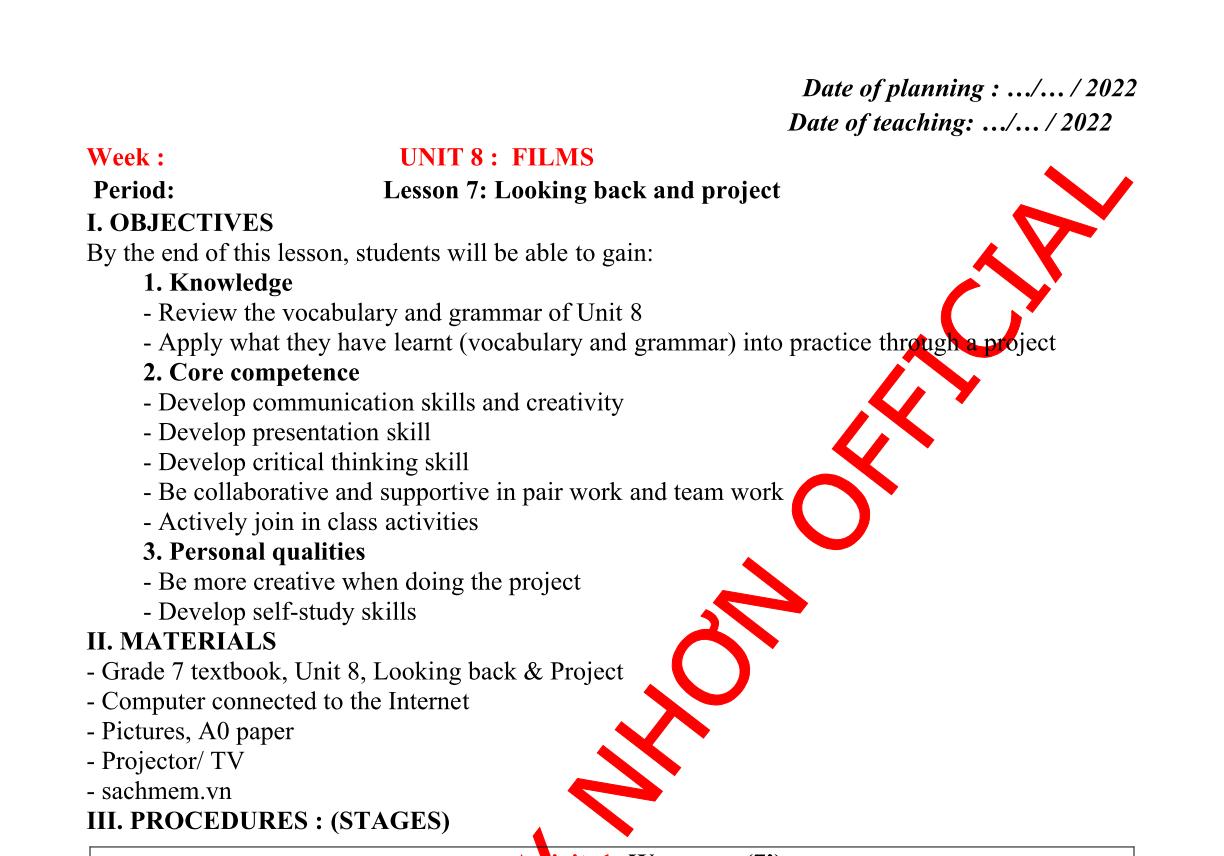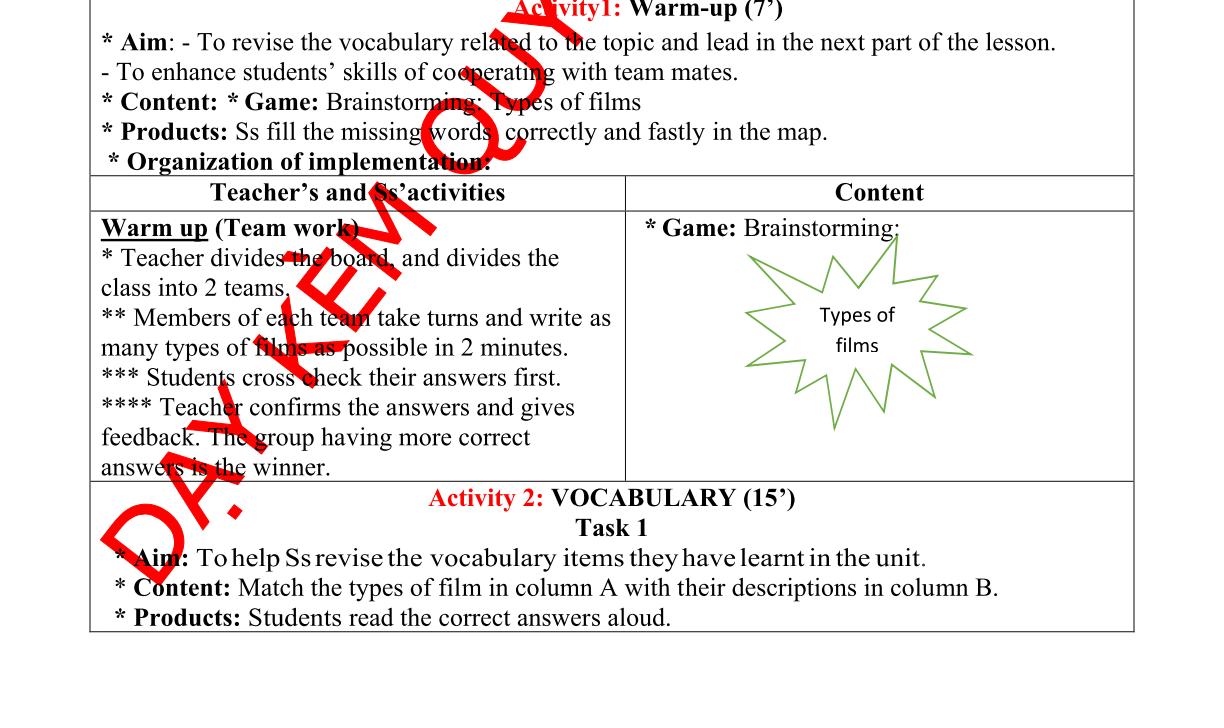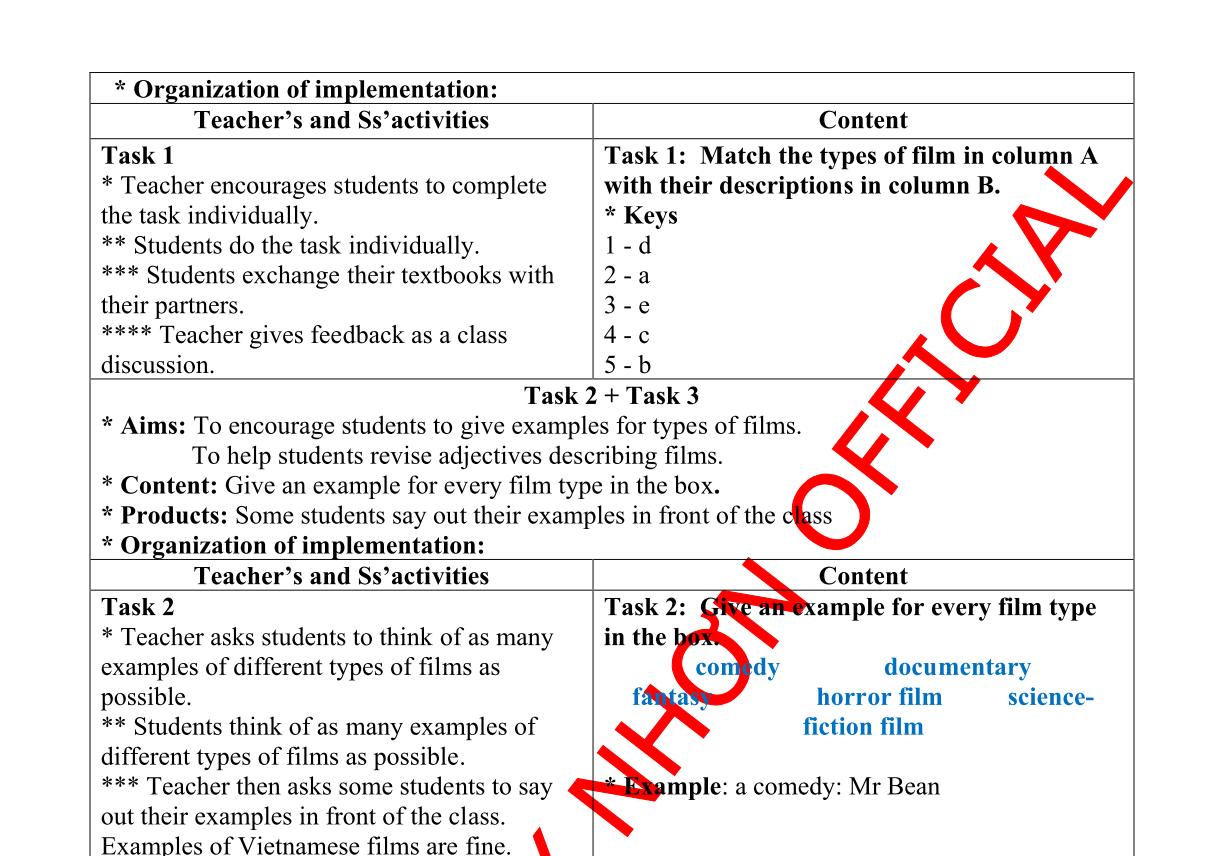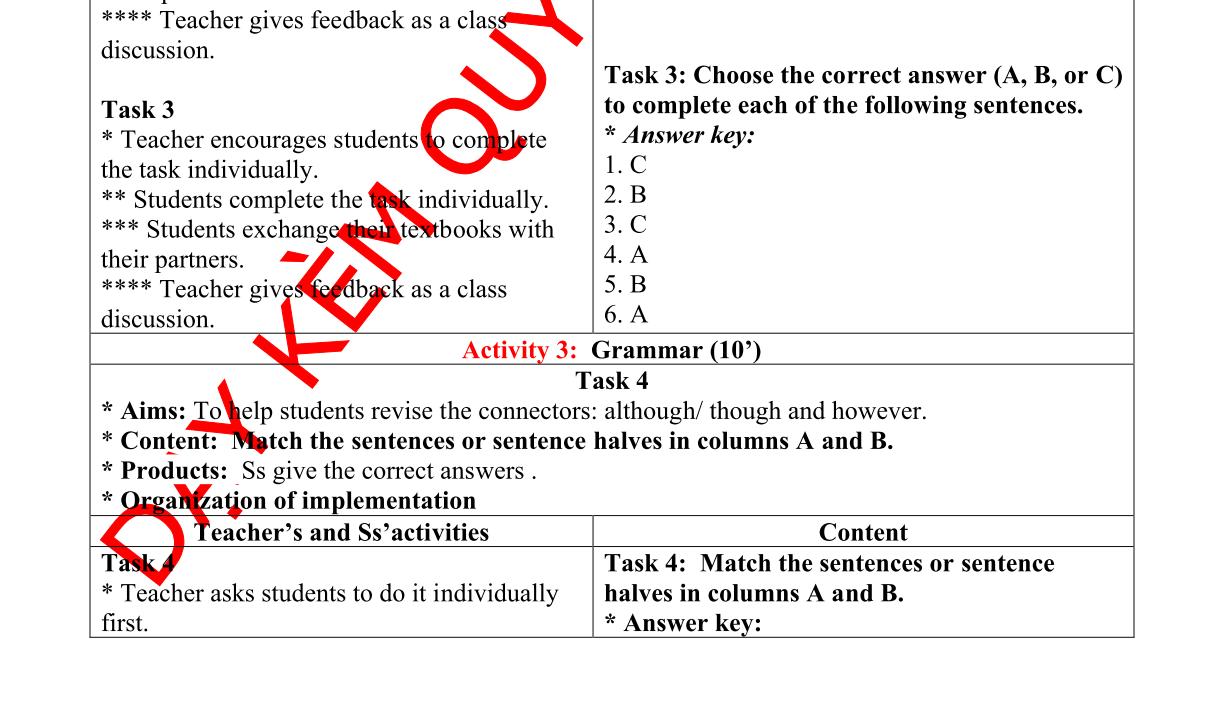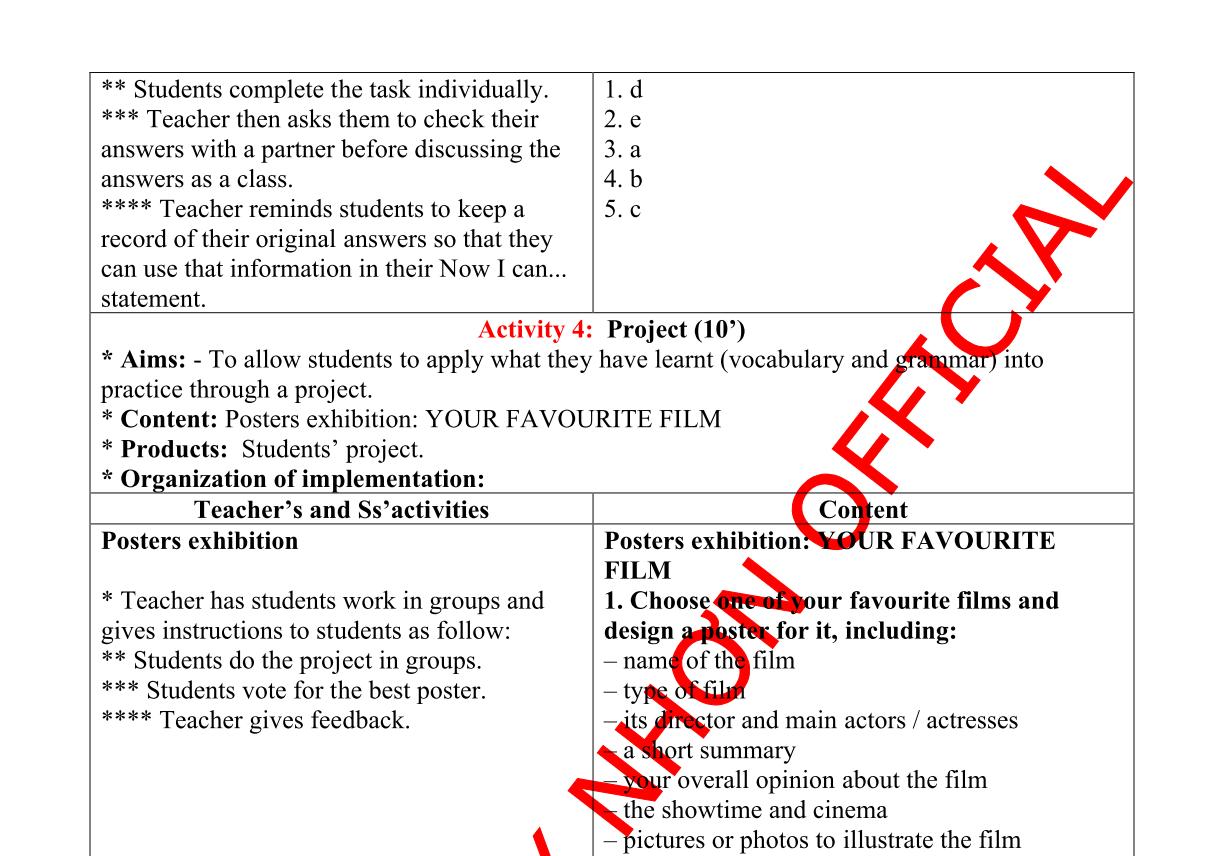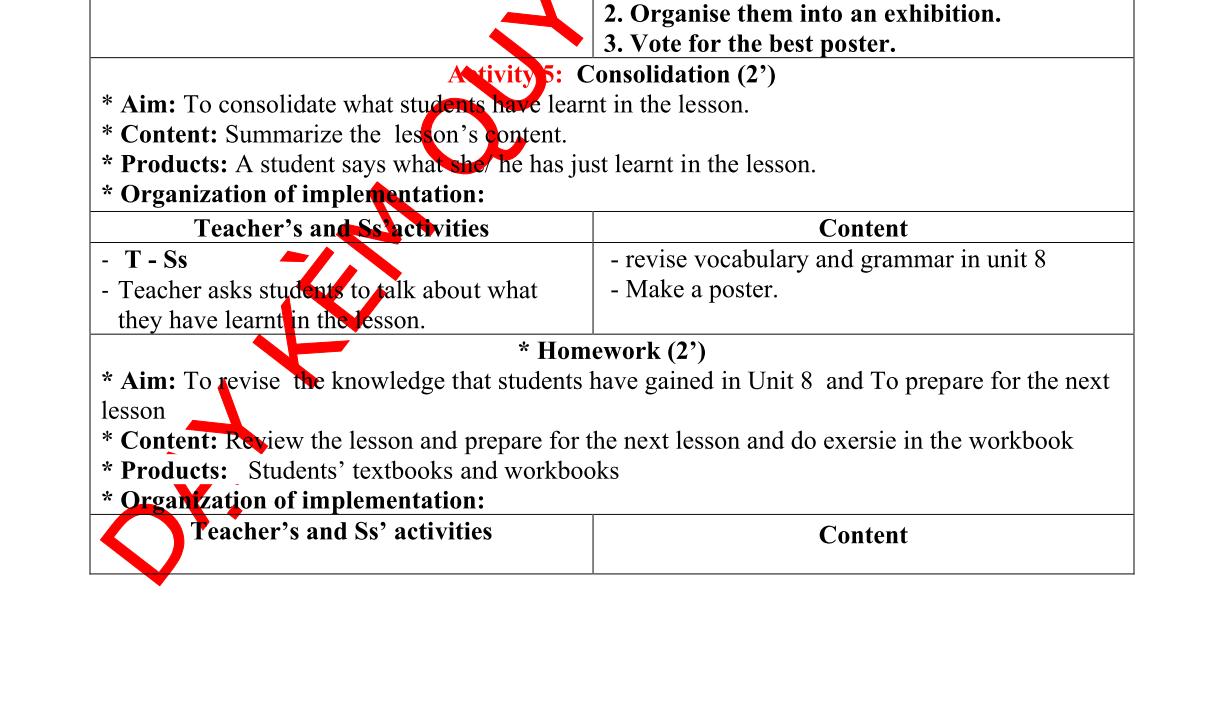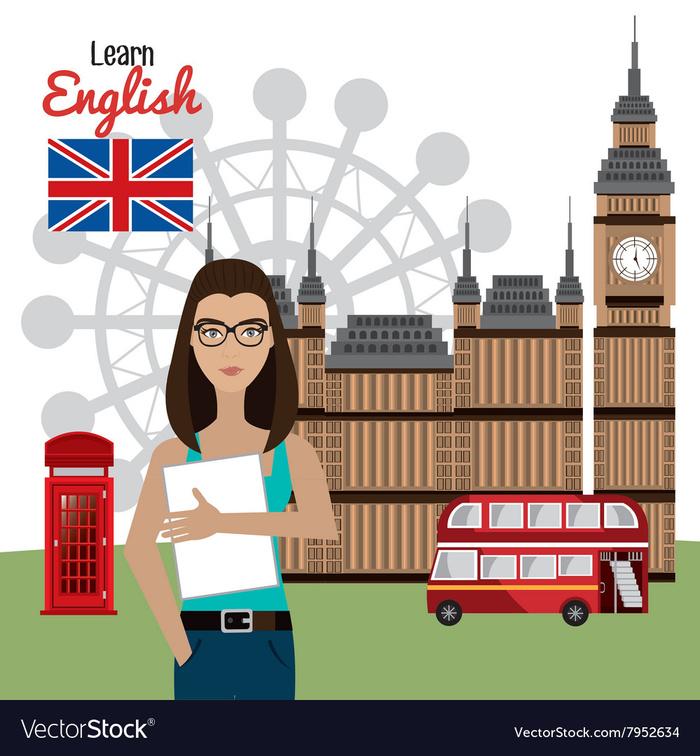

Hỗ trợ trực tuyến Fb www.facebook.com/DayKemQuyNhon Mobi/Zalo 0905779594 Tài liệu chuẩn tham khảo Phát triển kênh bởi Ths Nguyễn Thanh Tú Đơn vị tài trợ / phát hành / chia sẻ học thuật : Nguyen Thanh Tu Group GIÁO ÁN MÔN TIẾNG ANH 7 (GLOBAL SUCCESS) (BÀI 1-8) SOẠN THEO CÔNG VĂN 5512 (2 CỘT) NĂM HỌC 2022-2023 WORD VERSION | 2023 EDITION ORDER NOW / CHUYỂN GIAO QUA EMAIL TAILIEUCHUANTHAMKHAO@GMAIL COM GIÁO ÁN MÔN TIẾNG ANH GLOBAL SUCCESS Ths Nguyễn Thanh Tú eBook Collection vectorstock com/7952634
Week: 1
Date of planning : …/… / 2022
Date of teaching : …/… / 2022
ENGLISH 7 (GLOBAL SUCCESS)
Period 1: INTRODUCTIONAND REVISION EL 6
I. OBJECTIVES:
1. Knowledge:
After the lesson, students will review the main contents of the lessons which are learned in the 6th form: The simple present tense, the present continuous tense, near future, present perfect, conditional sentences, modal verb wh-questions,…
*Vocabulary: Use lexical items related to text book, and the way to learn English in class; at home... some classroom languages.
* Grammar : to be, some structures, tenses ( Present simple, past simple, future simple, present continuous,…), comparisions, Connectors, Articles, prepositions,….)
2. Competence: -Review all main what they have studied in the 6th form -Practice doing some exercises
3. Quality/Behavior: To teach SS to work hard,.The awareness about importance of revision ; Ss have the good attitude to working in groups, individual work, pairwork, cooperative learning and working.
II. TEACHING AIDS:
1. Teacher:
-Grade 7 textbook, planning lesson ( power point) -smart TV and cards,
2. Students: Text books, notebooks, computers, laptops or mobile phones with internet.
3. Method: Ask and answer ; group works; individual ……
III. PROCEDURE: 45’
A/ INTRODUCE HOW TO LEARN NEW ENGLISH CLASS 7
English 7: The whole year:3 periods x 35weeks = 105periods
Term I: 3 periods x 18weeks = 54 periods
Term II: 3 periods x 17weeks = 51periods
unit has 7 periods:
DẠYKÈMQUYNHƠNOFFICIAL
Each
+ Period 1: Getting Started + Period 2:A Closer Look 2 + Period3: A Closer Look 2 + Period 4: Communication + Period 5: Skiil1 + Period 6: Skill 2 + Period7: Looking Back
REVISION
+ Chatting
Q: How many tenses have you learnt in grades 6?
A: Four.
Q: Can you tell about the usages, the structures and some adverbs of time about these tenses?
A: Yes, I can. / No, I can not.
*.Practice:
1. Present Simple Tense
+ Use:chỉ thói quen, lập đi -lập lại, sự thật chân lí
+ Structure: (+) S + V 1 -S/ ES
(-) S + don’t/ doesn’t + V 1
( ?) Do/ Does + S + V1 ?
+ Adv: -adverbs of frequency (always, usually, often, sometimes, never) -; every + (time)
2. Present Continuous Tense
+ Use: -đang xảy ra ở thời điểm nói
+ Structure:
(+) S + am / is / are + Ving.
(-) S + am / is / are + not + Ving.
(?) Am / is / are + S + Ving?
+ Adv:-now, right now, at the moment; -Look!/ Listen!...
3. Future Simple Tense
+ Use:- chỉ sự viêc sẽ xảy ra trong tương lai có thời gian xác định
+ Structure: (+) S + will + V 1 (-) S + won’t + V 1 (?) Will + S + V 1
+ Adv: -tomorrow; next + (time); in a few + (time); -soon, later, ...
4. Past Simple Tense
+ Use: -chỉ sự viêc đã xảy ra trong quá khứ có thời gian xác định
+ Structure: (+) S + Ved/ V (BQT) (-) S + didn’t + V (?) Did + S + V ?
+ Adv:- yesterday ; last + (time); (duration of time)+ ago; time in the past (Ex: in 1998)*
* Cách phát âm đuôi ed:
1. /t/: khi đứng sau : /p, k, f, s/ ch/.. look –lookedlaugh –laughed watch –watched miss –misses wash –washed
2. /id/ khi đứng sau /t, d/ want –wanted need –needed
3. /d/ khi đứng sau các phụ âm còn lại hoặc nguyên âm
DẠYKÈMQUYNHƠNOFFICIAL B/
play –played seem –seemed
5. Some stuctures :
a/ Modal verbs: Can/could May/might+ V (inf) Should Must
b/ Conditional sentence -Type 1 -Câu điều kiện loại 1 dùng để diễn tả sự việc có thể xảy ra ở hiện tại hoặc tương lai. If + S + V (present simple), S +will/ won’t + V(inf)
Eg: 1.If it is sunny, I will go fishing. 2.If you eat a lot of sweet, you will have a stomachache …………………………
6. Wh-questions:
* What:
-What’s your name? => My name is An. What’s her name? => Her name is Hoa. -What do you do? => I am a teacher. What does he do? => He is a doctor.
* Where: Where do you live? => I live on Nguyen Du street. Where does she live? => She lives at 135 Hang Bai Street. * How many + Ns/es . How many students are there in your class?
* What time /When What time do you usually get up? When do you do your homework?
* How: -How are you? => I’m fine, thanks. -How do you go to school every day?
=> I go to school by bike.
* How old: How old are you?
* Why: Why does he have bad marks?
* Which: Which shirt do you like: red or blue?
* Who: Who is Mrs Lan talking to?
C/ PRODUCTION
DẠYKÈMQUYNHƠNOFFICIAL
I. Circle the letter before the word whose underlined part is pronounced diffrently from that of these others: 1) A. kitchen B. fish C. library D. tennis 2) A. that B. those C. there D. thanks 3) A. Who B. Where C. When D. What 4) A. six B. sit C. stand D. close 5) A. stopped B. washed C. lived D. missed II. Choose the correct words in brackets to fill in the gaps:
1) He often travels..........car..........my father . (by....for/ by.....with/ with.....by)
2) He ……………English and Math on Monday . ( is/ has/ have)…………
3) What ………………she do? ( does, is, do)
4) Do you want to go..........? (swim/ swiming/ swimming)
5) What.................. the matter with you yesterday morning? (is/ was/ were)
6) He …………. do his homework today. ( isn’t, doesn’t, didn’t)
7) People's health ……………..better if the air is cleaner. ( is, will be, are)
8) Jamie passed the exam because he………….very hard. (study, studied, studies)
III: Rewrite sentences without changing the meaning
1. My house is behind the hotel.
‡ The hotel ………………………………….
2. Shall we raise fund for the charity this weekend? ‡Let’s ……………………………………………………………………
3. Perhaps Helen is in her office ‡ She might …………………………………………………………..
4. The world has seven continents. ‡There ……………………………………………
5. Minh plays football very well ‡Minh is very good…………………………………………………………..
IV/ –Homework: Prepare for the next lesson: Unit 1: My hobbies < Getting started > V/ Evaluation: ………………………………………………………………………………………………………
DẠYKÈMQUYNHƠNOFFICIAL
……………………………………………………………………………………………………..
Date of planning : …/… / 2022
Date of teaching : …/… / 2022
Week : 1
UNIT 1: HOBBIES
Period 2: Lesson 1: Getting started –My favourite hobby
I. OBJECTIVES:
By the end of this lesson, Ss will be able to gain:
1. Knowledge
* Vocabulary: Vocabulary to talk about hobbies
* Grammar: Verbs of liking and disliking; Present simple
2. Core competence
-Develop communication skills and creativity
-Be collaborative and supportive in pair work and teamwork
-Actively join in class activities
3. Personal qualities
-Love talking about their hobbies
II. MATERIALS
1. Teacher:
-Grade 7 textbook, Unit 1, Getting started -Computer connected to the Internet -Projector / TV/ pictures and cards -sachmem.vn
2. Students: Text books, notebooks, posters, …. 3.Method: Ask and answer ; group works; individual
III. PROCEDURES : (STAGES)
* Warm-up (5’)
* Aim: To activate Ss’ knowledge on the topic of the unit.
To set the context for the listening and reading part.
To enhance Ss’ skills of cooperating with team mates.
* Content: Asking question about favorite activites in their free time
* Products: Ss answer the question individually.
* Organization of implementation: Teacher’s and Ss’activities Content T-Ss
-T asks Ss about what they like doing for pleasure in their free time.
-Ss answer the question individually.
‡T sets the context for the listening and reading text: Write the title on the board My favorite hobby. -Ask Ss to guess what the conversation might be about.
Warm up: Asking question:
-What do you like doing in your free time?
-Do you like collecting dolls?
-Do you like collecting glass bottles?
-Do you enjoy mountain climbing?
DẠYKÈMQUYNHƠNOFFICIAL
* Presentation (7’) ( Pre -Vovab)
* Aim: -To provide Ss with vocabulary.
-To help Ss well-prepared for the listening and reading tasks.
* Content: Learn some vocabularies relatedtothetopic.
* Products: Students read and understand the meaning of vocab.
* Organization of implementation: Teacher’s and Ss’activities
Pre teach vocabulary
-T-Ss
-Teacher use different techniques to teach vocab (pictures, situation, realia)
-Follow the seven steps of teaching vacab.
-Repeat in chorus and individually -Copy all the words
-Teacher checks students’ understanding with the “Rub out and remember” technique.
-Teacher checks students’ pronunciation and gives feedback.
* Aims:
Content
I.Vocabulary
1. unusual (adj) : khác thường
2. creativity (n) : sựsang tạo
3. dollhouse (n) : nhà búp bê
4. cardboard (n) : bìa các tông, bìa cứng
5. glue (n) : keo dán, hồ
6. making models : làm mô hình
* Checking vocab: <Rub out and remember>
* Practice (23’) Task 1:
* Content: Listen and read the conversation.
* Products: Students read and understand the meaning of the text. Students know how to role play

* Organization of implementation: Teacher’s and Ss’activities Content
* Set the sences: T-Ss
-Teacher asks Ss to look at the pictures in the book and answer the questions:
-Ss answer the questions in pairs.
-Teacher plays the recording twice. Ss listen and read.
-Teacher checks Ss’ prediction. T calls 2Ss to read the conversation aloud.
-Teacher check students’ pronunciation ad give feedback.
What can you see in each picture?
What may the hobby be?
Task 1: Listen and read. Task 2:
DẠYKÈMQUYNHƠNOFFICIAL
* Aims: To have students get specific information of the text.
* Content:.Read the conversation again and tick ( ✔) T (True) or F (False).
* Products: Ss say the answers aloud ( pair work)
* Organization of implementation: Teacher’s and Ss’activities Content
T-Ss, Ss-Ss, T-Ss
-Teacher tells Ss to read the conversation again and work independently to find the answers.
Remind Ss to underline the information and correct the false statements.
-Ss work independently to find the answers.
-Teacher has Ss compare the answers in pairs before checking with the whole class.
-Teacher checks the answers as a class and gives feedback.
Task 2: Read the conversation again and write T (True) or F (False).
* Answer key: 1. F (She made it herself.) 2. T 3. T 4. T 5. F (Her lesson starts at 8 a.m.)
Task 3:
* Aims: To introduce some vocabulary items related to hobbies.
* Content: Write the words and phrases from the box under the correct pictures
* Products: Student’s correct answers on the board.
* Organization of implementation: Teacher’s and Ss’activities Content
T-Ss, Ss-Ss
-T asks Ss to name the pictures.
-T has Ss work individually to match the words and phrases in the box with the pictures. Have them compare their answers with a partner. Then ask for Ss’ answers. Quickly write their answers on the board without confirming the correct answers.
-T has Ss listen to the recording, check their answers, and repeat the words / phrases. Ask Ss to look at the answers on the board and say if they are right or wrong. Confirm the correct answers.
-Teacher checks the answers as a class and gives feedback.
Task 3: Write the words and phrases from the box under the correct pictures. Then listen, check, and repeat.
* Answer keys: 1. making models 2. riding a horse 3. collecting coins 4. gardening 5. building dollhouses 6. collecting teddy bears
Task 4:
* Aims: To give Ss a chance to cooperate with others and help Ss categorise hobbies.
* Content:Write the hobbies from 3 in the suitable columns.
* Products: Student’s correct answers on the posters.
* Organization of implementation: Teacher’s and Ss’activities Content
T-Ss, Ss-Ss
-Have Ss work in pairs and complete the table.
Task 4: Work in pairs. Write the hobbies from 3 in the suitable columns.
* Answer key:
DẠYKÈMQUYNHƠNOFFICIAL
-Ss work in pairs and complete the table.
- Teacher allows students to share answers before discussing as a class.
+ doing things: riding a horse, gardening (others: travelling, skiing, doing yoga, etc.)
-Write their answers on the board.
-Have Ss add more words to the table.
+ making things: making models, building dollhouses (others: painting, making pottery, etc.)
+ collecting things: collecting coins, collecting teddy bears (others: collecting toys, collecting books,etc.)
* Production(5)
Task 5:
* Aims: To help Ss practise using the vocabulary items related to hobbies.
* Content:.Write names of the things around the class .
* Products: Students’ answers in your notebook ( Students share with the whole class)
* Organization of implementation:
Teacher’s and Ss’activities Content T-Ss, Ss-Ss
-T lets Ss to move around the class to ask their classmates about their favourite hobbies in 3-5 minutes.
Task 5-GAME: FIND SOMEONE WHO… Work in groups. Ask as your classmates which hobbies they like. Use the question ‘Do you like…?’. In the table below, write your classmates’ names beside the activities they like. Find someone who likes...
-Ss write the results into the table.
-Then T asks some Ss to report their results. Whoever has the most names wins.
-Teacher can ask students to read aloud the full sentences and correct their pronunciation if needed.
horse riding building dollhouses collecting teddy bears collecting coins gardening making models
* Give example: Nam: Do you like horse riding? Minh: Yes, Ido Nam: Do you like building dollhouses? Linh: Yes, I do
* Consolidation (3’)
* Aim: To consolidate what students have learnt in the lesson.
* Content: Talk about what they have learnt in the lesson
* Products:
DẠYKÈMQUYNHƠNOFFICIAL
* Organization of implementation: Teacher’s and Ss’ activities Content
- Teacher asks students to talk about what they - An overview about the topic Hobbies
have learnt in the lesson.
-Ss work indepently
-Vocabulary to talk about hobbies
* Homework (2’)
* Aim: To revise the lesson and prepare for the next lesson.
* Content: Review the lesson and prepare for the next lessonand do exersie in the workbbook
* Products: Students’ textbook and workbook
* Organization of implementation Teacher’s and Ss’ activities
-T reminds Ss to do homework and prepare the new lesson.
Content
-Learn by heart all the new words. -Do exercises in the workbook.
- Prepare lesson 2 ( A closer look 1).
*-Evaluation: …………………………………………………………………………
DẠYKÈMQUYNHƠNOFFICIAL
Date of planning : …/… / 2022
Date of teaching : …/… / 2022
Week : UNIT 1: HOBBIES
Period : Lesson 2: A closer look 1
I. OBJECTIVES:
By the end of this lesson, students will be able to gain:
1. Knowledge:
* Vocabulary:
+ The lexical items related to hobbies
+ Verbs of liking and disliking
* Pronunciation : Correctly pronounce words that contain the sounds /ə/ and /ɜ:/
2. Core competence
-Develop communication skills and creativity
-Be collaborative and supportive in pair work and teamwork
-Actively join in class activities
3. Personal qualities
-Love talking about their hobbies
-Develop self-study skills
II. MATERIALS
1. Teacher:
-Grade 7 textbook, Unit 1, Getting started -Computer connected to the Internet
-Projector / TV/ pictures and cards -sachmem.vn
2. Students: Text books, notebooks, posters, ….
3.Method: Ask and answer ; group works; individual
III. PROCEDURES : (STAGES)
* WARM-UP-LEAD-IN(5’)
* Aim:-To create an active atmosphere in the class before the lesson.
-To lead into the new lesson.
* Content: Game : Kim’s game( about school things)
* Products: Ss write words exactly on the board.
* Organization of implementation
Teacher’s and Ss’activities Content
-Teacher asks students some questions about the hobbies:
-Some students are invited to answer.
-Teacher and students discuss the answers.
-Teacher introduces the lesson.
* Kim's game:ASKING QUESTION:
1. What is your favorite hobby?
2. When did you start your hobby?
* PRESENTATION(5’) (Pre-vocab)
* Aim: To enrich students’ vocabulary to talk about hobbies .
DẠYKÈMQUYNHƠNOFFICIAL
* Content: Vocabulary about hobbies
* Products: Read and understand the meaning of words
* Organization of implementation: Teacher’s and Ss’activities Content
Pre teach vocabulary
-Teacher use different techniques to teach vocab (pictures, situation, realia)
-Follow the seven steps of teaching vacab. -Repeat in chorus and individually -Copy all the words
*Teacher asks students to repeat.
* Teacher checks students’ understanding with the “Rub out and remember” technique.
* Vocabulary .
1. jogging (n) 2. coin (n)
* Checking vocab: < Rub out and remember >
* PRACTICE (23’)
Task 1
* Aims: To present some action verbs that go with nouns to describe hobbies.
* Content: Complete the words webs below with the words from the box.
* Products: Students complete wordwebs exactly .
* Organization of implementation: Teacher’s and Ss’activities Content Task 1: T-Ss
-Teacher has students read the action verbs and match them with suitable words the box.
Remind them that a verb can go with more than one word.
-Teacher asks students to work in pairs and quickly do the task.
-Teacher allows students to peer check first.
-Teacher checks and confirms the answers. Then have students add more words that can go with these action verbs.
-Have students read the Remember! box. Ask them to make some examples with the verbs of liking and disliking.
Task 1: Complete the wordwebs below with the words from the box.
* Answer key: go: jogging, swimming (others: go camping, go fishing, go cycling, etc.) do: judo, yoga (others: do karate, do exercise, do sit-ups, etc.) collect: dolls, coins (others: collect books, collect watches, collect pencils, etc.)
Task 2
* Aims: To help students practise the verbs of liking / disliking and action verbs.
* Content: Complete the sentences, using the -ing form of the verbs .
* Products: Ss read all the sentences exactly.
* Organization of implementation :
DẠYKÈMQUYNHƠNOFFICIAL
Teacher’s and Ss’activities Content
Task 2: T-Ss, Ss -Ss
-Teacher reminds students about the form of verbs of liking / disliking.
-Have students do this activity individually. Have students read all the sentences carefully to make sure they understand the sentences.
-Teacher lets them share their answers in pairs. Invite some students to give the answers.
-Teacher writes the correct answers on the board.
Task 2: Complete the sentences, using theing form of the verbs from the box.
* Answer key: 1. collecting 2. going 3. playing 4. making 5. doing Task 3
* Aims: To give further practice with verbs of liking / disliking.
* Content: Look at the pictures and say the sentences. Use suitable verbs of liking or disliking and the -ing form.
* Products: Students work in pairs and make sentences exactly.
* Organization of implementation:
Teacher’s and Ss’activities
Task 3:T-Ss, Ss-Ss
-Teacher has students look at the pictures in this exercise and say what the person / people is / are doing in each picture.
-Ask them what the face in each picture means. (A sad face means ‘not like’ and a happy face means ‘like’.)
-Ask students to look at the example to make sure they understand what to do.
-Teacher asks students to work in pairs to make sentences.
-Teacher invites students to share their answers.
- Confirm the correct answers.
Content
Task3: Look at the pictures and say the sentences. Usesuitable verbs of liking or disliking and the -ing form.
* Answer key:
1. He hates / doesn’t like doing judo.
2. They like / love / enjoy playing football.
3. They love / like / enjoy gardening.
4. They enjoy / like / love collecting stamps.
5. She hates / doesn’t like riding a horse / horse riding.
* PRONUNCIATION
Task 4
* Aims: -To help students identify how to pronounce the sounds /ə/ and /ɜ:/. -To help students practise pronouncing these sounds in words.
* Content: Understand and howto pronounce the sounds /ə/ and /ɜ:/.
* Products: Students pronounce words exactly .
* Organization of implementation:
Teacher’s and Ss’activities Content
* Presentation
* Teacher has some students read out the words first.
-Teacher plays the recording for them to listen and repeat the words they hear. Ask them to pay close attention to the two sounds. Play the
Task 4:Listen and repeat. Pay attention to the sounds /ə/ and /ɜː/ /ə/ /ɜ:/ amazing learn
DẠYKÈMQUYNHƠNOFFICIAL
recording as many times as necessary.
** Teacher explains to students the difference between the two sounds if needed. Tell students that /ə/ is the schwa sound while /ɜ:/ sounds like it has a soft /r/ in it.
*** Teacher invites some students to say some words they know that include the two sounds.
**** Confirm the correct answers. (Teacher can play the pronunciation guide video of this unit for students to watch and learn).
yoga collect column
surf work thirteen
Task 5
* Aims: To help students pronounce the sounds /ə/ and /ɜ:/ correctly in sentences.
* Content:Listen and tick the appropriate sounds.Practise the sentences.
* Products: Students’ answers in your notebook ( Students share with the whole class)
* Organization of implementation: Teacher’s and Ss’activities Content
Task 5:T-Ss, Ss-Ss
-Teacher has students quickly read the sentences.
-Teacher plays the recording for students to listen to the sentences. Ask them to pay attention to the underlined parts and tick the appropriate sounds.
-Invite some students to share their answers.
-Confirm the correct ones.
Task 5: Listen to the sentences and pay attention to the underlined parts. Tick the appropriate sounds. Practise the sentences.
* Answer key:
/ə/ /ɜ:/
1.My hobby is collecting dolls. ¸
2.I go jogging every Thursday. ¸
3. My cousin likes getting up early ¸
4.My best friend has th irty pens. ¸
5. Nam enjoys playing the violin. ¸
*Production (5’)
* Aim: To test students' quick reaction to the targeted sounds.
* Content: Game : write sentences including: hobbie(s) and one of the sounds /ə/ and /ɜ:/.
* Products: Students read aloud their sentences.
* Organization of implementation: Teacher’s and Ss’ activities Content
-* Teacher divides students into groups of four, gives each group a piece of paper, asks them to write sentences including: hobbie(s) and one of the sounds /ə/ and /ɜ:/.
-Students play the game.
-Teacher asks each group to hand in their papers and checks, the groupwith the most correct sentences is the winner. Teacher invites the winner to read aloud their sentences.
-Teacher gives feedback.
* GAME: WHO IS FASTER? (e.g: Listening to music is a very common hobby.)
-Collecting stamps is an interesting hobby.
DẠYKÈMQUYNHƠNOFFICIAL
*Homework (2’)
* Aim: To revise the lesson and prepare for the next lesson.
* Content: Review the lesson and prepare for the next lessonand do exersie in the workbbook
* Products: Students’ textbook and workbook
* Organization of implementation Teacher’s and Ss’ activities Content
-T reminds Ss to do homework and prepare the new lesson.
*-Evaluation:
Learn by heart all the new words.
-Write sentences relating to hobbies that have the sounds /ə/ and /ɜ:/.
- Prepare lesson 3 ( A closer look 2)
DẠYKÈMQUYNHƠNOFFICIAL
……………………………………………………………………………………………………… ……………………………………………………………………………………………
Date of planning : …/… / 2022
Date of teaching : …/… / 2022
Week : UNIT 1: HOBBIES
Period : Lesson 3: A closer look 2
I. OBJECTIVES:
By the end of this lesson, Ss will be able to:
1. Knowledge
* Vocab: hobbies lexical items
* Grammar: -Review the knowledge on present simple tense
2. Core competence
-Develop communication skills
-Be collaborative and supportive in pair work and team work
-Actively join in class activities
3. Personal qualities
-Be encouraged to know more about their classmate’s hobbies
-Develop self-study skills
II.
MATERIALS
* Preparation:
1. Teacher: -Text books , pictures, planning (Unit 1, A closer look 2) -Smart TV/Pictures, sets of word cards -sachmem.vn
2. Students: Text books, notebooks, posters, ….
3. Method: Ask and answer ; group works; individual ……
III. PROCEDURES : (STAGES)
* Warm-up (5’)
* Aim:-To review some hobbies; To increase Ss’ interest. To enhance Ss’ skills of cooperating with teammates.
*Content: Game: Sentence puzzling ( with the simple present)
* Products: Students complete the perfect sentences on the board.
* Organization of implementation: Teacher’s and Ss’activities Content
* Warm up(group work)
- Teacher divides the class into 4 groups.
- Teacher delivers a set of word cards which are jumbled sentences in present simple to each group.
- Students will have to work in groups to create as many correct sentences from the word cards as possible.
- The group with the most correct sentences will be the winner.
‡LEAD-IN
T draws Ss’ attention to the form of the
* Game: Sentence puzzling
Suggested sentences:
1. Peter likes collectingstamps
2. My mother often listens to music in in her free time
3. They don’tlike playing basketball.
4.Whatdo you do in your free
DẠYKÈMQUYNHƠNOFFICIAL
sentences created in the game and asks them whether they know the target tense.
* Presentation (10’)
* Aim: To review the present simple tense.
* Content: To review the forms and use the present simple tense.
* Products: Understand and know how to use the present simple tense
* Organization of implementation
Teacher’s and Ss’activities Content
T –Ss : Ss-Ss
+ THEPRESENTSIMPLE:REVIEW
* T has the Ss review the forms and use of present simple before doing the exercises.
** Ss retell the form and the uses of the tense: The present simple.
*** T comments and explains again.
-T shows each of the examples in the Remember box on the slide or have Ss read the examples in the book. T highlights the present simple form. Explain each use.
-T has Ss read the orange box in the book again to help them understand better the uses of the present simple.
-T asks Ss what signal words help them identify the verb tense. Elicit answers from Ss. (Signal words areadverbs of frequency and verbs such as start, etc.)
**** Teacher checks their answers as a class.
* THE PRESENT SIMPLE TENSE * Form:
+ Positive: S + Vinf/ V(s/es) + … .
+ Negative: S + don’t/ doesn’t + Vinf + … .
+ Interrogative: Do/ Does + S + Vinf + … ?
->Yes, S + do/does. No, S + don’t/ doesn’t.
*signal words: Every day; everyweek ,often…..; always, usually, sometimes, today …
* Practice (20’)
Task 1
* Aims:- To help Ss identify and remember the uses of the present simple.
-To help Ss practise the correct form of the present simple.
-To give further practice with the present simple
*Content:
* Products: Students say the key aloud
* Organization of implementation: Teacher’s and Ss’activities Content
Task 1:T –Ss : Ss-Ss
* T asks Ss to do the exercise individually and then check their answers in pairs.
** Ss do the exercise individually.
*** T invites some Ss to share their answers.
**** Confirm the correct answers.
TASK 2:T –Ss : Ss-Ss
TASK 1: MATCH THE SENTENCES (1 –5) TO THE CORRECT USES (A –C).
* Answer key: 1. b 2. a 3. c 4. a 5. b
TASK 2: COMPLETE THE SENTENCES.
DẠYKÈMQUYNHƠNOFFICIAL
* T has Ss do this exercise individually and then compare their answers with a partner.
** T asks some Ss to write their answers on the board.
*** T checks the answers with the whole class. Ask Ss to explain the use of the tense in each sentence.
**** T confirms the correct answers.
TASK 3: T –Ss : Ss-Ss
* T has Ss do this exercise in pairs and then compare the answers with another pair.
** T asks some Ss to write their answers on the board.
*** T checks the answers with the whole class. T asks Ss to explain the use of the tense in each sentence.
**** T confirms the correct answers.
TASK 4: T –Ss : Ss-Ss
* T has Ss work in groups to write the sentences. Give each group a large-size sheet of paper to write.
** Ss work in groups to write the sentences.
*** T has groups cross-check.
**** T sticks some sheets on the board. Comment and confirm the correct answers.
USE THE PRESENT SIMPLE FORM OF THE VERBS.
Answer key:
1. make 2. does … do 3. have
4. doesn’t like 5. Does … start
TASK 3: FILL IN EACH BLANK WITH THE CORRECT FORM OF THE VERB IN BRACKETS.
Answer keys:
1. enjoys 2. spends 3. don’t like / do not like 4. go 5. begins 6. don’t enjoy / do not enjoy TASK 4: WRITE COMPLETE SENTENCES, USING THE GIVEN WORDS AND PHRASES. YOU MAY HAVE TO CHANGE THE WORDS OR ADD SOME.
* Answer key:
1. The sun sets in the west every evening.
2. Do Trang and Minh play basketball every day after school?
3. The flight from Ho Chi Minh City doesn’t arrive at 10:30.
4. Our science teacher starts our lessons at 1 p.m. on Fridays.
5. Do you make models at the weekend / at weekends?
* Production (7’)
TASK 5:
* Aims: To give Ss a chance to apply what they have learnt.
-To improve cooperative skill.
*Content:Make questions then interview your partner.
* Products: Role play ( ask and answer correctly)
* Organization of implementation:
Teacher’s and Ss’activities Content
TASK5: T-Ss, Ss -Ss
TASK 5: GAME: SENTENCE RACE
DẠYKÈMQUYNHƠNOFFICIAL
* T divides Ss into groups. Assign a group leader.
-T writes a verb on the board and have Ss make a sentence with the verb, using the present simple form.
** The group leader records his / her group’s points.
*** T invites group leaders to read aloud the sentences.
**** T comments and announces the winners. -
Ex:
1. go
I go to school at 7 a.m every day.
2. watch.
My brother watches TV at the weekend.
3. listen
My father usually listens to music.
4. ………
* Consolidation (3’)
* Aim: To consolidate what students have learnt in the lesson.
* Content:.Summarize the main content of the lesson
* Products: Students say what they have learnt in the lesson
* Organization of implementation
Teacher’s and Ss’ activities Content
Teacher asks students to talk about what they have learnt in the lesson.
-Complete with the simple present. -Make sentences with the simple present.
*Homework (2’)
* Aim: To revise the knowledge that students have gained in this lesson.
* Content: Review the lesson and prepare for the next lessonand do exersie in the workbbook
* Products: Students’ textbook and workbook
* Organization of implementation:
Teacher’s and Ss’ activities
-T reminds Ss to do homework and prepare the new lesson.
*-Evaluation:
Content
-Make 3 sentences in the present simple tense. -Complete the exercises in the Workbook. - Prepare lesson 4 ( communication)
DẠYKÈMQUYNHƠNOFFICIAL
………………………………………………………………………………………………………
Date of planning : …/… / 2022
Date of teaching : …/… / 2022
Week : UNIT 1: HOBBIES
Period : Lesson 4 : Communication
I. OBJECTIVES:
By the end of this lesson, Ss will be able to describe and give opinions about hobbies.
1. Knowledge
-Use the lexical items related to the topic Hobbies
-Talk about likes and dislikes
-Ask and answer about hobbies.
2. Core competence
-Develop creativity and communication skills
-Be collaborative and supportive in pair work and team work
-Actively join in class activities
3. Personal qualities
-Be ready to describe and give opinions about hobbies.
-Be interested more about new hobbies.
II. MATERIALS
* Preparation:
1. Teacher:
-Grade 7textbook, Planning (Unit 1 communication)
-Smart TV/Pictures, sets of word cards -sachmem.vn
2. Students: Text books, notebooks, posters, ….
3.Method: Ask and answer ; group works; individual ……
III. PROCEDURES : (STAGES)
* Warm-up (5’)
* Aim:To introduce the topicand To lead in the new lesson.
* Content: Game: Arrange the following verbs of liking in descending order of preference.
* Products: Studentswrite the correct answers on the posters.
* Organization of implementation: Teacher’s and Ss’activities Content
* Warm up Team work
T –Ss : Ss-Ss
-T asks Ss Arrange the following verbs of liking in descending order of preference.
-Studentswrite the correct answers on the posters.
-Then T asks some Ss to make sentences about themselves, using the verbs of liking / disliking.
-T introduces the objectives of the lesson: learning how to talk about likes / dislikes and about their
* GAME: ARRANGE THE FOLLOWING VERBS OF LIKING IN DESCENDING ORDER OF PREFERENCE.
DẠYKÈMQUYNHƠNOFFICIAL
hobbies.
Let’s find out more ways to give your opinion about something in this lesson.
* Presentation (10’) * EVERYDAY ENGLISH
* Aim: To introduce the use of verbs of liking.
* Content: learning how to talk about likes / dislikes and about their hobbies.
* Products:Ss know how to ask and answer about hobbies
* Organization of implementation:
Teacher’s and Ss’activities Content
Task 1:T –Ss : Ss-Ss
Teacher introduces how to use of verbs of liking and give examples .
* Play the recording for Ss to listen and read the dialogue between Mi and Ann at the same time.
-Ask Ss to pay attention to the questions and answers.
** Have Ss practise the dialogue in pairs.
* We often use the –ing form after verbs of liking and not liking.
⮚ Example: I likegoing to the cinema. She hatescleaning the floors.
Task 1: Listen and read the dialogue below. Pay attention to the questions and answers.
Mi: Do you like reading books?
Ann: Yes, very much, especially books about science.
Mi: What about painting? Do you like it?
Ann: No, I don't. I'm not that interested in art.
* Practice (25’) Task 2:
* Aims: To help Ss practise talking about likes and dislikes.
* Content: Practise Asking and answer questions about what you like and don’t like doing.
* Products: role play and practice in front of the class fluently.
* Organization of implementation:
Teacher’s and Ss’activities
Content
Task
2:T –Ss : Ss-Ss
Tell Ss that they can use other verbs they learn in A Closer Look 1 to talk about likes and dislikes.
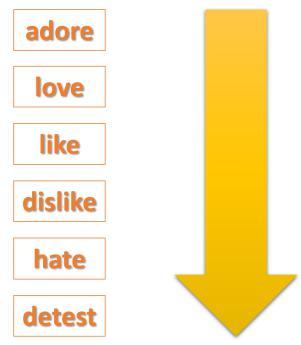
-T asks Ss to give some examples with these verbs. Model asking and answering with a student.
-Ask Ss to work in pairs to make similar dialogues, using different verbs to show likes and dislikes.
Task 2: Work in pairs. Ask and answer questions about what you like and don’t like doing.
* Example:
Teacher: Do you love running?
Student: Yes, very much. I usually run in the park at weekends.
Vy: Do you like playing soccer?
Minh: Yes, I love it. I love playing football with my friends every Sunda
Vy:What about playing guitar? Do you like it?
DẠYKÈMQUYNHƠNOFFICIAL
-Move around to observe and provide help. Call on some pairs to performin front of the class. Comment on their performance.
Minh: No, I don't. I'm not interest in it.
Task3:
All about your hobbies
* Aims: To provide practice with answering about Ss’ hobbies
* Content: Fill some information about your hobbies.
* Products: The answers on the group board and give feedback and comments clearly and exactly.
* Organization of implementation:
Teacher’s and Ss’activities
Task 3: T-Ss, Ss –Ss
* T asks Ss to work individually and fill in column A
** Ss work individually to do the task.
*** T invites some Ss to share their answers before checking with the whole class.
**** T gives feedback and comments.
Content
Task 3: Answer the questions. Fill in column a with your answers.
A (Me)
-Amount of free time per day: 1 hour -Thing(s) you like doing every day: reading books, listening to music, watching TV -Thing(s) you don't like doing: washing the dishes, cooking -Thing(s) you love doing in the summer: eating ice cream, going swimming -Thing(s) you love doingin the winter: lying under the warm blanket, drinking hot chocolate
Task 4:
* Aims: To provide practice with asking and answering about hobbies.
* Content: Now interview your friend, using the questions in Task 3. Write his / her answers in column B.
*Products: Role play and practice asking and answering about hobbiesin front of the class fluently.
* Organization of implementation:
Teacher’s and Ss’activities Content
Task 4: T-Ss, Ss –Ss
* T asks Ss to take turns being the person who asks the questions. This S has to note down his/ her partner’s answers to report to the class later.
** Ss work in pairs to do the task.
*** T calls on some Ss to report the answers to the class.
**** T and other Ss give comments.
Task 4: Now interview your friend, using the questions in Task 3. Write his / her answers in column B.
B (My friend)
Amount of free time per day: 2 hours
-Thing(s) he/she likes doing every day: drawing pictures, arranging flowers -Thing(s) he/she doesn't like doing: doing homework, doing housework -Thing(s) he/she loves doing in the summer: making cold drink, going to the beach -Thing(s) he/she loves doing in the winter: eating icecreams, cooking
DẠYKÈMQUYNHƠNOFFICIAL
* Production (5’)
* Aims: To provide practice with comparing answers and giving a presentation about hobbies.
*Content: Compare your answers with your friend’s. Then present them to the class.
* Products: Some Ss present their work in front of the class.
* Organization of implementation: Teacher’s and Ss’activities Content
Task 5: T-Ss, Ss -Ss
* T asks Ss to read the example to understand how to report the answers.
** Ss work in pairs again to compare the answers and prepare a short presentation.
*** T invites some Ss to present their work.
**** T and other Ss give comments.
Task 5: Compare your answers with your friend’s. Then present them to the class.
* Example:
I have only one hour of free time a day, but my friend Lan has 2 hours
I like listening to music every day, and Lan likes it too. I don’t like exercising, but Lan does.
* Consolidation (3’)
* Aims: To consolidate what students have learnt in the lesson.
* Content: summarize the main content in the lesson.
* Products: Students say what they have learnt in the lesson.
* Organization of implementation: Teacher’s and Ss’activities Content
Teacher asks students to talk about what they have learnt in the lesson.
- Practise Asking and answer questions about what you like and don’t like doing. -………….
* Homework (2’)
* Aim: To revise the knowledge that students have gained in this lesson.
* Content: Review the lesson and prepare for the next lessonand do exercisein the workbook.
* Products: Students’ textbook and workbook.
* Organization of implementation
Teacher’s and Ss’ activities Content
-T reminds Ss to do homework and prepare the new lesson.
*-Evaluation:
-Do EX in the workbook. -Prepare lesson 5 ( skills 1)
DẠYKÈMQUYNHƠNOFFICIAL
……………………………………………………………………………………………………… …………………………………………………………………………
Dateof planning : …/… / 2022
Date of teaching : …/… / 2022
Week : UNIT 1: HOBBIES
Period : Lesson 5 : Skills1
I. OBJECTIVES:
By the end of this lesson, Ss will be able to:
1. Knowledge
-Develop reading skill for general and specific information about Gardening. -Talk about their hobbies and the benefits of them.
2. Core competence
-Develop communication skills and creativity
-Be collaborative and supportive in pair work and team work
-Develop presentation skill
-Actively join in class activities
3. Personal qualities
-Understand more about their preference of different types of hobbies
-Develop self-study skills
II. MATERIALS
1. Teacher:
-Grade 7textbook,planning (Unit 1, skills 1)
-Smart TV/Pictures, sets of word cards -sachmem.vn
2. Students: Text books, notebooks, posters, ….
3.Method: Ask and answer ; group works; individual ……
III. PROCEDURES : (STAGES)
* Warm-up (5’)
* Aim:-To create an active atmosphere in the class before the lesson.
-To lead into the new lesson.
* Content: Game :LIST OUT AS MANY HOBBIES AS POSSIBLE
* Products: Studentswrite the names of hobbies on the group board.(work in groups )
* Organization of implementation: Teacher’s and Ss’activities Content - T-Ss
* T introduces the objectives of the lesson and asks Ss to list out as many hobbies as possible within 1 minute.
* Ss work in groups to brainstorm hobbies.
* Play a game : LIST OUT AS MANY HOBBIES AS POSSIBLE
* Suggested answers:
-playing badminton -playing tennis -playing football -playing basketball - riding a bike
-collecting dolls -collecting bottles -. collecting stamps -collecting coins - carving wood
DẠYKÈMQUYNHƠNOFFICIAL
*** Which teams can list out more correct answers wins.
**** T confirms answers as a class.
-taking photos -arranging flowers -ice –skating -gardening -listening to music ……….
* PRESENTATION
* Pre-Vocabulary(7’)
* Aim:- To prepare students with vocabulary relatedtothelesson - To lead in the reading skills.
* Content: Some vocabularies related the lesson.
* Products: Read and understand the meaning of the words.
-reading book -playing games -cooking -. playing the guitar -cycling ……………….
* Organization of implementation: Teacher’s and Ss’activities Content
T –Ss : -Pre teach vocabulary -Teacher use different techniques to teach vocab (pictures, situation, realia) -Repeat in chorus and individually -Copy all the words
* Checking vocab: < what and where>
‡ Teacher leads students into the lesson
* VOCABULARY:
- outdoor (adj) : ngài trời -patient (adj) : kiên nhẫn -responsibility (n): trách nhiệm -maturity (adj): sự trưởng thành -valuable (adj): quý giá, quan trọng, hữu ích
* Checking vocab: < what and where>
* Pre-Reading (5’) Task 1
* Aims: - To develop reading skill for general information. understand a
* Content: Look at the picture and discuss the questions.
* Products: Students work in pairs and answer the questions exactly.
* Organization of implementation:
Teacher’s and Ss’activities Content
* T has Ss look at the picture in the book or show the picture in the book on a slide. -Ask Ss who they see in the picture and what they are doing.
** T has Ss work in pairs to discuss the two questions.
*** T invites some Ss to share their answers.
Task 1: Work in pairs. Look at the picture and discuss the questions.
1. What can you see in the picture?
2. In your opinion, what is good about gardening?
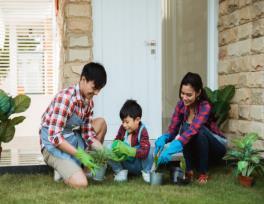
DẠYKÈMQUYNHƠNOFFICIAL
**** Tell Ss that they are going to read a text about gardening.
1. In the picture, I can see 3 people. Maybe It’s a family. They are gardening together. There are a lot of plants around.
2. In my opinion, gardening is very good. Gardening can connect family members. It also helps people protect our environment. Gardening can help us to have clean food to eat.
* WHILE -READING(10’) Task 2:
* Aims: To help students read to find some words in context, and their meaning.
* Content: Read the text about gardening. Match word in column A with its definition in column B.
* Products: Students say the correct answers.
* Organization of implementation: Teacher’s and Ss’activities Content
Task 2:T –Ss : Ss-Ss
* T tells Ss what they are going to do.
-T asks Ss how to do the exercise. Elicit answers from Ss.
-If needed, T will tell them to follow these steps:
+ Read the words in column A.
+ Locate each word in the text.
+ Read around the word to get the general meaning.
+ Read the definitions in column B, find the suitable meaning to match each word.
-T asks Ss to repeat the steps (they can speak in Vietnamese).
** Ss do the exercise individually and then check answers in pairs.
*** T invites some Ss to share their answers.
**** Confirm the correct answ ers.
* Aims:
Task 2:Read the text about gardening. Match each word in column A with its definition in column B. A B 1. outdoor 2. patient 3. responsibility 4. maturity 5. valuable
a. a very developed from b. happening outside c. the duty of taking care of something d. very helpful e. able to wait for a long time
* Answer key: 1. b 2. e 3. c 4. a 5. d
Task 3:(5’)
* Content: Read the passages again and complete the sentences.
* Products: Stusents’ correct answers on the board.
* Organization of implementation:
Teacher’s and Ss’activities
Task 3: T-Ss, Ss –Ss ( Pair work)
-
* T asks Ss what they are going to do.
–T has Ss share how to do this exercise.
–T briefly tells them the steps: read the sentences, underline the key words in the
Content
Task 3:Read the text again. Complete each sentence with no more than THREE words.
1. Gardening belongs to the group of ____________. 2. Gardening teaches children about flowers, fruits, vegetables,_________. 3. Gardening makes children become _______and
DẠYKÈMQUYNHƠNOFFICIAL
sentences, locate the key words in the text and find the words to complete the sentences.
–T asks Ss to repeat the steps (they can speak in Vietnamese).
** T asks Ss to do the exercise individually and then check their answers in pairs.
*** T invites some Ss to share their answers. Have them explain their answers.
**** Confirm the correct answers.
–T asks Ss to tell the class the benefits of gardening as mentioned in the text.
responsible.
4. It is an activity that everyone in the family can ________. 5. The author and her mother usually garden for _______ a day.
* Answer key: 1. doing things 2. insects and bugs 3. patient 4. join in 5. an hour
* PRE-SPEAKING (5’)
Task4 :
* Aims: To help Ss prepare ideas for the speaking activity;
* Content: Ask and answer about the school they like and say the reason.
* Products: Students ask and answer fluently in groups .
* Organization of implementation: Teacher’s and Ss’activities Content
Task 4: T-Ss, Ss –Ss
* T introduces some structures to talk about the benefits of hobbies: + to develop sth + to make sb + adj + to reduce sth + to help sb / sth do sth –Give some examples.
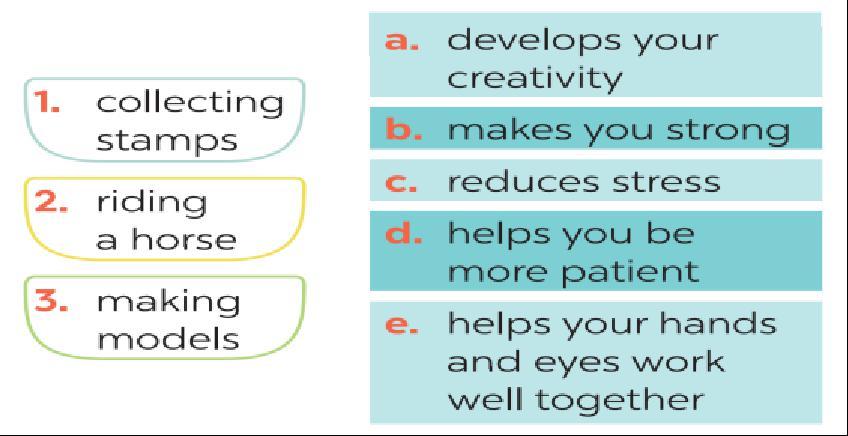
** Ss work in pairs to match the hobby with its benefit(s). Check as the whole class.
–T asks Ss to name other benefits of these hobbies.
*** Invite some Ss toshare their answers.
**** Confirm the answers.
II. Speaking
Task 4 : Work in pairs. Match each hobby with its benefit(s).
*Answer key: 1. c, d 2. b, c 3. a, c, d, e
* WHILE -SPEAKING(6’)
* Aims: To help Ss use what they have learnt so far to talk about hobbies.
* Content: Work in groups to ask and answer the two questions.
* Products: Practice in groups and then present in front of the class.
* Organization of implementation:
Teacher’s and Ss’activities Content
Task 5: T-Ss, Ss –Ss
* Have Ss work in groups to ask and answer the two questions.
– Model the answers to the two questions if
Task 5: Work in groups. Ask one another the following questions. Then present your partners’ answers to the class.
* Questions:
DẠYKÈMQUYNHƠNOFFICIAL
needed.
** Ss work in groups to ask and answer the two questions.
*** Invite some Ss to share their partner’s answers to the questions.
–Invite other Ss to comment on the answers.
**** Comment on Ss’ answers.
1,What is your favourite hobby? My favourite hobby is listening to English music 2, What are its benefit s? It makes me happy and helps me improve my English ‡ My friend Hoa’s favourite hobby is listening to music
lt makes her happy and helps me improve my english
* POST-READING AND SPEAKING
* Aim: - Check Ss’ understanding about the reading passage. -To help some Ss enhance presentation skill.
* Content: Comments and vote for the most interesting and informative presentation.
* Products:* Organization of implementation: Teacher’s and Ss’activities Content
T-Ss, Ss -Ss
*T allows Ss to give comments for their friends and vote for the most interesting and informative presentation.
** Ss do as required.
*** T calls Ss to share answer.
****T gives feedback and comments.
* Ss’ comments
* Consolidation (3’)
* Aims: To consolidate what students have learnt in the lesson.
* Content: summarize the main content in the lesson.
* Products: Students say what they have learnt in the lesson.
* Organization of implementation:
-Teacher asks students to talk about what they have learnt in the lesson. -Some new words - Ask and answer about hobbies.
* Homework (2’)
* Aim: To review the lesson that they have learnt and prepare for the next lesson Skills 2.
* Content: Review the lesson and prepare for the next lessonand do exercsie in the workbbook
* Products: Students’ textbook and workbook
* Organization of implementation:
-T asks Ss to write down their opinion about carving eggshells.
-T asks Ss to search for more information about this unique hobby.
*-Evaluation:
-Write down their opinion about carving eggshells. -Search for more information about this unique hobby.
DẠYKÈMQUYNHƠNOFFICIAL
………………………………………………………………………………………………………
Date of planning : …/… / 2022
Date of teaching : …/… / 2022
Week : UNIT 1: HOBBIES
Period : Lesson 6: Skills 2
I. OBJECTIVES:
By the end of this lesson, Ss will be able to:
1. Knowledge
-Use the lexical items related to the topic Hobbies
-Listen for specific information about Trang’s hobby
-Write a passage about her hobbies
2. Core competence
-Develop communication skills and creativity
-Be collaborative and supportive in pair work and team work
-Actively join in class activities
3. Personal qualities
-Learn more about their own hobby
-Be encouraged to take up a new hobby if they haven’t had one.
II. MATERIALS
1. Teacher:
-Text books ,pictures, planning (Unit 1, Skills 2)
-Smart TV/Pictures.
-sachmem.vn
2. Students: Text books, notebooks, posters, ….
3.Method: Ask and answer ; group works; individual ……
III. PROCEDURES : (STAGES)
* Warm-up (5’)
* Aim:-Check students’ knowledge related the previous lesson.
-To introduce the topic of listening.
*Content: Game:Network ( my new school)
* Products: Ss write word on the board.
* Organization of implementation
Teacher’s and Ss’activities Content
* Warm up(Individual work)
T -Ss
-T asks Ss to answer the question: What will you mention when you talk about someone’s hobby?
-Ss work individually to answer the questions.
-T calls Ss to give answers.
-T gets feedback and write on the board.
- T leads Ss to the new lesson.
* Game:CHATTING
What will you mention when you talk about someone’s hobby?
* Suggested answers:
+ Name of the hobby
+ The time he / she started the hobby
+ His / Her feeling about the hobby
+ His / Her future plan about the hobby
DẠYKÈMQUYNHƠNOFFICIAL
-T sets the scene: You are going to listen to an interview about Trang’s hobby and complete the word web.
* PRE-LISTENING(5’)
* Pre-vocab
* Aim: -To enrich students’vocabulary
-To lead in the listening tasks.
* Content: Some vocab related the topic.
* Products: Read and understand the meaning of words.
* Organization of implementation: Teacher’s and Ss’activities Content
- T –Ss :
-Pre teach vocabulary
-Teacher use different techniques to teach vocab (pictures, situation, realia)
-Repeat in chorus and individually -Copy all the words
Lead in: T-Ss And then T leads students in the listening tasks.
* Vocabulary: decorate /ˈdekəreɪt/: trang trí benefit (n) /ˈbenɪfɪt/: lợi ích
* Pre -listening (5’)
Task 1:
* Aims: To help Ss understand and activate their knowledge of the topic.
*Content: Look at the picture. What hobby is it? Do you think it is a good hobby? Why or why not?
* Products: Students say the correct answers aloud.
* Organization of implementation: Teacher’s and Ss’activities Content
Task 1:T –Ss : Ss-Ss
* T asks Ss to work in pairs to answer the questions.
+ Do you know anything about building dollhouses?
+ Do you think it is a good hobby? Why/ Why not?
-Ss work in pairs to answer.
-Ss share their answers. T monitors and accepts all answers if they make sense.
Task 1: Look at the picture. What hobby is it? Do you think it is a good hobby? Why or why not?
* Suggested answers:
In the picture, I can see two girls. They build a dollhouse. In my opinion, their hobby is building dollhouses. I think It’s a good hobby. Because it develops your creativity. It also makes you more patient.
* WHILE-LISTENING(7’) Task 2:
* Aims: To help students develop listening skill for specific information.
* Content: Task 2: Listen and complete the mind map.
DẠYKÈMQUYNHƠNOFFICIAL
* Products: Students’ correct answers on the posters.
* Organization of implementation Teacher’s and Ss’activities Content Task 2: T-Ss, Ss –Ss
-T explains the way to listen to Trang’s hobby and asks them to guess and complete the mind map.
**** Ss share their answer.
-T asks Ss to work individually to listen and complete the word web.
-Ss work individually to listen and complete the word web.
-Ss work in pairs to compare their answers with each other and with the word / phrase on the board.
-T plays the recording a second time for pairs to check their answers.
-T asks Ss to write the answers on the board.
-T checks and corrects.
- T gives further comments
Task 2: Listen and complete the mind map.
+ What is Trang’s hobby? (name of the hobby)
+ When did she start the hobby?
+ Who shares the hobby with Trang?
+ To do this hobby what does Trang have to ?
+ How does she feel about the hobby?
+ Does she intend to continue her hobby in the future ?
* Suggested answers: 1. dollhouses 2. three / 3 3. cousin 4. a) house b) cloth 5. creative
* Audio script –Track 7:
Lan: Today we’ll talk about hobbies. I know that your hobby is building dollhouses. It’s quite unusual, isn’t it?
Trang: Not really. A lot of girls like it.
Lan: When did you start doing this?
Trang: Three years ago. I read an article about building dollhouses. I loved the idea right away.
Lan: Do any of your friends or relatives build dollhouses too?
Trang: Yes, my cousin Mi loves building them too.
Lan: Is it hard to build a dollhouse?
Trang: No, it isn’t. I use cardboard and glue to build the house and make the furniture. Then I make the dolls from cloth. Finally, I decorate the house.
Lan: What are the benefits of the hobby?
Trang: Well, I’m more patient and creative now .
* POST-LISTENING(5’)
* Aims: To check students’ understanding of the listening part.
*Content: Summarize the information of the listening part.
* Products: Ss summarize the information in the listening part before the class.
* Organization of implementation: Teacher’s and Ss’activities Content
Task 3:T-Ss, Ss-Ss( work group)
- Students work in groups of four.
- Teacher asks students to summarize the information in the listening part and talk about it.
- Teacher helps if necessary.
* Summarize the information of the listening part.
* PRE-WRITING (5’)
* Aims: -To brainstorm ideas and make an outline for Ss’ writing.
- To help Ss take notes and make outline for the next writing passage
DẠYKÈMQUYNHƠNOFFICIAL
* Content: Fill in the blanks about your hobby.
* Products: Ss complete the information about their exactly.
* Organization of implementation:
Teacher’s and Ss’activities Content
Task 3: T-Ss, Ss –Ss
* T tells Ss that they are going to write about his / her hobby.
** T asks Ss to use the word web as a way to organize their ideas.
** T models with a S (Ex: Lan)
*** Ss work individually to do Task 3.
*** T checks the answer.
**** T give more comments and feedback.
Task 3: What is your hobby? Fill in the blanks below.
Suggested answers :
Lan's hobby: 1. Name of the hobby: collecting waste paper 2. Started: 3 years ago 3. Person who shares he hobby with: Nga 4. To do this hobby Nga has to: a. collect paper after use b. make flowers, dishes, toys. boxes... c. use it for drawing if possible 5. Lan's feeling about the hobby: interesting, useful, protect the environment 6. Future: continue the hobby
* WHILE -WRITING(5’)
* Aim: To let Ss write about their hobby.
* Content: Write a paragraph about your hobby.
* Products: Students’ perfect writingon the posters.
* Organization of implementation Teacher’s and Ss’activities Content
* T asks Ss to write their paragraphs individually based on the information in their word webs.
** Ss listen to the teacher then do the task.
*** T asks one S to write his / her paragraph on the board.
**** T asks Ss to check the writing.
- **** T gives comments to the students.
*
Task 4:Write a paragraph about your hobby.
Students’ writing
* POST -WRITING(3’)
* Aim: To cross check and final check students’ writing.
* Content: Cross check students’ writing
* Products: Students check the others’ writing carefully .
* Organization of implementation: Teacher’s and Ss’ activities Content
DẠYKÈMQUYNHƠNOFFICIAL
- T may have students do their writing on large sheets of paper and organize a class gallery for students to display their writings on the board. Then students can go around to see their friends’ work, give and receive comments.
-Teacher tgives feedback on one writing as a model..
My hobby is arranging flowers. I started this hobby 3 years ago. I share my hobby with my mom. We often arrange flowers at weekend. To arrange flowers, I need flowers, vase and scissors. When I arranging flowers, I feel happy. It helps me to develop my creativity and to be more patient.
* Consolidation (2’)
* Aim: To consolidate what students have learnt in the lesson.
* Content: Summarize the main content in the lesson.
* Products: Say aloud what they have just learnt in front of the class.
* Organization of implementation:
Teacher’s and Ss’ activities Content
-Teacher asks students to talk about what they have learnt in the lesson.
-Some new words. -Listen a passage about Trang’s hobby. - write a paragraph about your hobby
* Homework (2)
* Aim: To revise the knowledge that students have gained in this lesson.
-To allow students finalize their versions after being checked by friends and teacher.
* Content: Review the lesson and prepare for the next lessonand do exersie in the workbook
* Products: Students’ textbook and workbook
* Organization of implementation:
- Teacher asks students to write down the paragraph in their books.
-Teacher asks students to prepare the new lesson.
*-Evaluation:
- Rewrite the paragraph in the notebooks.
- Write about one of your family members’ hobby in about 60 words.
- Prepare for the project.
DẠYKÈMQUYNHƠNOFFICIAL
……………………………………………………………………………………………………… …………………………………………………………………………………………………….
Date of planning : …/… / 2022
Date of teaching : …/… / 2022
Week : UNIT 1:
HOBBIES
Period : Lesson 7: Looking back and project
I. OBJECTIVES:
-Review the vocabulary and grammar of Unit 1
-Apply what they have learnt (vocabulary and grammar) into practice through a project
1. Knowledge
* Vocab: hobbies lexical items
* Grammar: -Review the knowledge on present simple tense
2. Core competence
-Develop communication skills and creativity
-Develop presentation skill
-Develop critical thinking skill
-Be collaborative and supportive in pair work and team work
-Actively join in class activities
3. Personal qualities
-Be more creative when doing the project
-Develop self-study skills
III. MATERIALS
1. Teacher:
-Text books , pictures, planning (Unit 1, Looking back and project)
-Smart TV/Pictures.
-sachmem.vn
2. Students: Text books, notebooks, posters, ….
3. Method: Ask and answer ; group works; individual ……
III. PROCEDURES : (STAGES)
* Warm-up (3’)
* Aim:-To revise the vocabulary related to the topic and lead in the next part of the lesson.
-To enhance Ss’ skills of cooperating with team mates.
*Content: Game: Guessing game
* Products: Students write correct words on the board.
* Organization of implementation: Teacher’s and Ss’activities Content
* Warm up(Team work)
T –Ss
* T divides the class into two big groups.
-Ss take turns to think of a hobby for your partner to guess.
-Their partner can ask up to 10 yes / no questions and he / she can only answer with a 'yes’ or 'no’.
* Game: Guessing game
E.g:1. I have a lot of bottles, dolls or stamps. What is my hobby?
DẠYKÈMQUYNHƠNOFFICIAL
-Time allowance: 3 minutes
** T asks ss to listen carefully and say aloud the name of the hobby. Who has the quicker and correct answer will get one point. The group with more points is the winner.
** Ss work in groups to do the task.
*** Ss give answer.
**** T monitors and gives feedback
LOOKING BACK
(vocabulary)
Task 1(5’)
* Aim:
* Content: Complete the sentences with appropriate hobbies.
* Products: Students write corr ectwords on the board. ( say the correct answers aloud)
* Organization of implementation: Teacher’s and Ss’activities Content
- T –Ss :
* Have Ss do this activity individually then compare their answers with their partners.
** Ss do this activity individually.
*** Ask for Ss’ answers or ask one student to write his / her answer on the board.
**** Confirm the correct answers.
Task 1:Complete the sentences with appropriate hobbies.
* Answer key: 1. collecting coins 2. doing judo 3. making models 4. gardening 5. playing football Task 2: (5’)
* Aims: To help Ss revise vocabulary relating to hobbies
*Content: Write true sentences about you and your family members.
* Products: Students’ correct answers on the board.
* Organization of implementation: Teacher’s and Ss’activities
Task 2:T –Ss : Ss-Ss
* T has Ss write true sentences about them and their family members.
** Ss write true sentences about them and their family members.
*** T asks them to share their answers with a classmate.
**** T invites some Ss to write their sentences on the board. T and other Ss comment
Content
Task 2: Write true sentences about you and your family members.
Eg: 1. I like playing volleyball. 2. My dad enjoys reading books 3. My mom doesn’t like gardening 4. My grandmother loves cooking 5. My grandfather hates making models
* Grammar
DẠYKÈMQUYNHƠNOFFICIAL
Task 3. + Task4 (10’)
* Aims: - To help students revise the present simple tense. -To help Ss revise the present simple in questions and negative sentences.
* Content: Use the present simple form of each verb to complete the passage; Change the sentences into questions and negative ones.
* Products: Write correct words on the board.
* Organization of implementation:
Teacher’s and Ss’activities
Task 3: T-Ss, Ss –Ss
* Ask Ss about the uses of the present simple that they have learnt in the unit.
** Have Ss do this exercise individually.
*** Have compare their answers with a partner. Call on some Ss to give the answers.
**** Confirm the correct answers and write them on the board.
Task 4:T-Ss, Ss-Ss
* Have Ss do this exercise individually then compare their sentences with a partner.
** Ss do this exercise individually.
*** Invite some Ss to read their answers aloud.
**** Give feedback.
Content
Task 3: Use the present simple form of each verb to complete the passage.
* Answer key:
1. loves 2. has 3. enjoys 4. don’t like 5. is 6. is 7. go 8. begins Task 4: Change the sentences into questions and negative ones.
* Answer key:
1. Does this river run through your home town? This river doesn’t / does not run through my home town.
2. Does your drawing class start at 8 a.m. every Sunday?
My drawing class doesn’t / does not start at 8 a.m. every Sunday.
3. Do they enjoy collecting stamps? They don’t / do not enjoy collecting stamps.
4. Do you do judo every Tuesday? I don’t / do not do judo every Tuesday.
5. Does your brother love making model cars? My brother doesn’t / does not love making model cars.
* PROJECT
* My dream school
* Aims: To allow studentsto apply what they have learnt (vocabulary and grammar) into practice througha project.
* Content: Make project “ My hobby”
* Products: Students’ answers on the posters. .
* Organization of implementation:
Teacher’s and Ss’activities
Content
DẠYKÈMQUYNHƠNOFFICIAL
Project: T-Ss, Ss –Ss (group work)
* Ask Ss to read the instructions again (T has already assigned the project since the first lesson of the Unit and check their progress after each lesson). Let students have some time to check their posters for the final time and make any adjustments if neccessary.
** T has groups show their posters and present the hobbies to the class.
Remember to have the “show and tell” session and vote for the best poster.
*** Students vote for the best poster.
**** Teacher givesfeedback. Remember to have the “show and tell” session and vote for the best poster.
*** Students vote for the best poster.
**** Teacher gives feedback.
* HOBBY POSTER
1. List of hobbies: gardening, cooking, reading, listening to music, cycling, swimming, building dollhouses, painting,...
2. The benefits of the hobby –Reading: -It is a great way to learn about new things, learn more about your own world. -It can reduce stress. -It can improve your concentration.
My favourite hobby is reading. It is one of the popular activities. It is suitable for everyone, especially teens. You can do it everywhere, from your own room to the park, library,... When reading, you learn more about your own world. It is a great way to learn about new things. Reading is also good because it can reduce stress and improve your concentration.
* Consolidation (2’)
* Aim: To consolidate what students have learnt in the lesson.
* Content: Summarize what students have learnt in the lesson.
* Products: Say aloud what they have learnt in the lesson.
* Organization of implementation: Teacher’s and Ss’activities
Content
- Teacher asks students to talk about what they have learnt in the lesson. -revise vocabulary in unit 1. - /ə/ and /ɜ:/
-Verbs of liking and disliking -Make a project about some hobbies
* Homework (2)
* Aim: To revise the knowledge that students have gained in Unit1 and To prepare for the next lesson
* Content: Review the lesson and prepare for the next lessonand do exersie in the workbbook
* Products: Students’ textbook and workbook
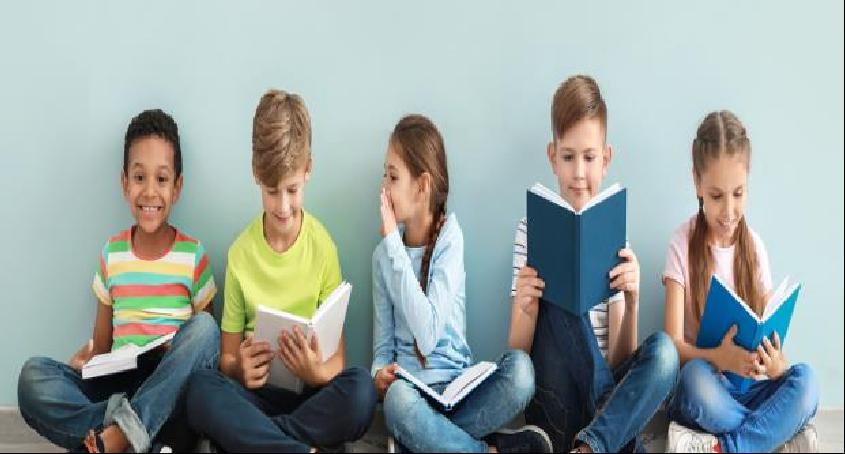
* Organization of implementation: Teacher’s and Ss’ activities
Content
DẠYKÈMQUYNHƠNOFFICIAL
- Teacher asks students to revise old lesson and to do exercise in workbook.
-Teacher asks students to complete the project and prepare the new lesson.
-Complete the project -Prepare for the next lesson: Unit 2 –Lesson 1. Getting started. *-Evaluation:
DẠYKÈMQUYNHƠNOFFICIAL
……………………………………………………………………………………………………… …………………………………………………………………………………………….
Date ofplanning : …/… / 2022
Date of teaching : …/… / 2022
UNIT 2: HEALTHY LIVING
Lesson 1: Getting started –Let’s go out!
I. OBJECTIVES:
By the end of this lesson, students will be able to:
1. Knowledge
-Use the lexical items related to the topic Healthy living
-Identify and talk about the daily activities and decide if they are good or bad for health
2. Core competence
-Develop communication skills and creativity
-Be collaborative and supportive in pair work and teamwork
-Actively join in class activities
3. Personal qualities
-Be ready to talk about Healthy living
-Know some daily activities whether good or bad for health
II. MATERIALS
1. Teacher: -Grade 7textbook,Planning (Unit 2, Getting started) -Smart TV/Pictures, sets of word cards -sachmem.vn
2. Students: Text books, notebooks, posters, ….
3. Method: Ask and answer ; group works; individual ……
III. PROCEDURES : (STAGES)
* WARM-UP(5’)
* Aim: -To create an active atmosphere in the class before the lesson. -To introduce the topicand To lead in the topic of Healthy living
* Content:
* Products: Work in groups and then write words relating to health on the board.
* Organization of implementation
Teacher’s and Ss’activities Content
Warm up: Team work
* Teacher gives instructions.
-Teacher writes the word “HEALTH” on the board, divides the class into two teams.
** Members of each team to think of words relating to health.
*** In team, Ss take turn to come to the board and write one word.
**** Teacher checks and corrects if Ss spellor pronounce the words / phrases incorrectly.
- The team which has more points or more correct answers will be the winner.
- -Then, teacher asks student a question -
* Game: BRAINSTORMING
weak strong sick ill
HEALTH
- ‡What should we do to be stronger?”
DẠYKÈMQUYNHƠNOFFICIAL
- Students can have their own answers. After that, teacher says: “There are many ways to be stronger and the most important thing is that: we should have a healthy living. And it’s also our topic in this unit”.
-T Introduces the topic of the lesson.
we should have a healthy living (Eat, drink healthy, exercise regularly,relax,….)
* PRESENTATION(5’)
* Aim: To prepare students with vocabulary relatedtothetopic Healthy living;
* Content: Learn some vocabularies relatedtothetopic.
* Products: Students read and understand the meaning of vocab.
* Organization of implementation: Teacher’s and Ss’activities Content
* Pre teach vocabulary
-Teacher use different techniques to teach vocab (pictures, situation, realia)
-Follow the seven steps of teaching vacab.
-Repeat in chorus and individually -Copy all the words
* Checking vocab: < matching>
* Vocabulary -popular (a): phổ biến -fresh (a):tươi mát -join (v): tham gia -bring (v): mang , đem theo -boat(v): chèo thuyền -suncream (n): kem chống nắng -sunburn (n):cháy nắng
Task 1: (5’)
Listen and read:
* Aims: -To set the context for the listening and reading text. -To introduce the topic of the unit.
* Content: Listen and read the dialogue.
* Products: Students read and understand the content of the dialogue. Students know how to role play
* Organization of implementation
Teacher’s and Ss’activities Content
* Set the sences: T-Ss
- Teacher draws students’ attention to the pictures in the textbook and asks them some questions about the pictures.
* Now we are going to listen a conversation between Markand Mi Task 1: T-Ss
* Teacher plays the recording, asks students to underline the words related to the topic Healthy living. (Teacher may check the meaning of
* Chatting 1.Who are they in the picture?
are they doing?
Are they healthy activities?
Suggested answers: 1-‡They are Mark and his dad 2->. They are doing boating, 3..(Students’answers)
Task 1: Listen and read.
DẠYKÈMQUYNHƠNOFFICIAL
2.What
3.
some words if necessary.)
-Teacher can play the recording more than once.
-Students listen and read.
** Teacher can invite some pairs of students to read aloud.
*** Teacher refers to the questions previously asked.
- **** Then, teacher confirms the correct answer.
* PRACTICE/ CONTROLLED PRACTICE(15’)
* Task 2
* Aims: To help students understand the main idea of the conversation.
* Content: Tick the correct answers
* Products: Students say the correct answers aloud.
* Organization of implementation:
Teacher’s and Ss’activities Content Task 2: T-Ss, Ss-Ss, T-Ss
* Teacher asks students to answer without reading the conversation again.
** Sswork out and answer questions in pairs.
*** Teacher asks some students to explain why they did not choose the other two options.
**** Teacher confirms the correct answer.
Task 2: What are Mark and Mi talking about?
*Answer key: B
ÿ Because the dialogue mentions cycling and boating and they are good for our health. So the answer is B. Healthy activities.
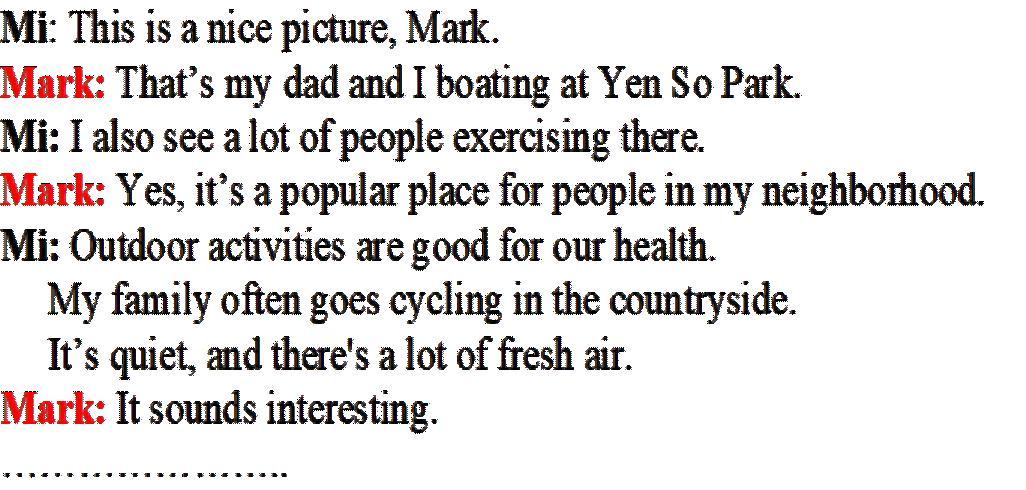
Task 3:
* Aims: To help student learn some vocabulary from the conversation visually to ensure their understanding of the context.
* Content: Write a word or phrase from the box under its picture
* Products: Students write correct words on the board.
* Organization of implementation: Teacher’s and Ss’activities Content Task 3:T-Ss, Ss-Ss
* Teacher asks students to work independently to read the words, look at the pictures and write the correct words / phrase under the pictures
** Teacher allows students to share their answers before discussing as a class.
*** Teacher calls some students to check.
**** Teacher confirms the right answers and writes on the board.
Task 3: Write a word or phrase from the box under its picture
* Answer key:
1. sunburn
2. suncream 3. lunch box 4. boating 5. cycling
DẠYKÈMQUYNHƠNOFFICIAL
Task 4:
* Aims: To help student develop the vocabulary about the topic.
* Content: Complete each sentence with a word from the conversation.
* Products: Students’ answers on the posters .
* Organization of implementation: Teacher’s and Ss’activities Content
Task 4:T-Ss, Ss-Ss
* Teacher asks students to work independently to fill in each blank with a word from the conversation.
** Ss do exercise 3 individually.
*** Teacher asks them to tell where to find the words.
**** Teacher checks the answers as a class.
Task 4:Complete each sentence with a word from the conversation.
* Answer keys: 1. boating 2. park 3. countryside 4. suncream 5. health
* PRODUCTION (5’)
Task 5:
* Aims: To help student identify and talk about their daily activities and decide if they are good or bad for their health
* Content: Take survey and report.
* Products: Students take survey and present in front of the class.
* Organization of implementation: Teacher’s and Ss’activities Content
Task 5:T-Ss, Ss-Ss
* Teacher asks students to work in groups of 4 or 6 to take turns to ask and answer about their daily activities, how often they do these activities and discuss if they are good or bad for their health.
** Ss work in groups to ask and answer -Teacher moves around to observe and offer help when needed.
*** By the end of the activity, one student from each group can stand up and report to the class.
- **** Teacher checks and gives the correct answers
Task 5:Survey: Good or bad for health
* Suggested answers: Daily activities How often Good Bad Walking to school Every day √
Eating breakfast Rarely √ Going swimming Twice a week √ Sleeping 12 hours per day √ Doing yoga Three times a week √ … … … …
* Consolidation (3’)
* Aim: To consolidate what students have learnt in the lesson.
* Content:.Vocab about school things and Read and understand content of the conversation
* Products: * Organization of implementation
Teacher’s and Ss’ activities Content
-Teacher asks students to talk about what they have learnt in the lesson.
-Vocab about Healthy living - Read and understand content of the conversation
DẠYKÈMQUYNHƠNOFFICIAL
- Ss work indepently
* Homework (2’)
* Aim: To review the lesson and prepare for the next lesson.
* Content: Review the lesson and prepare for the next lesson( A closer look 1)
* Products: Students’ textbook and workbook
* Organization of implementation Teacher’s and Ss’ activities Content
-T reminds Ssto do homework and prepare the new lesson.
*-Evaluation:
-Learn by heart all the new words.
-Read the dialogue again.
-Prepare the vocabulary for the next lesson: A closer look1.
-Start preparing for the Project of the unit.
DẠYKÈMQUYNHƠNOFFICIAL
Date of planning : …/… / 2022
Date of teaching : …/… / 2022
Week: Unit 2: : HEALTHY LIVING
Period : Lesson 2: A closer look 1
I. OBJECTIVES:
By the end of this lesson, students will be able to:
1. Knowledge
-Vocabulary:
+ use the lexical items related to the topic Healthy living
+ use the words about healthy activities and health problems
-Pronunciation: pronounce and recognize the sounds / f/ and /v/in isolation and in context
2. Core competence
-Develop communication skills
-Be collaborative and supportive in pair work and teamwork
-Actively join in class activities
3. Personal qualities
-Be ready to know the words about healthy activities and health problems
-Develop self-study skills
II. MATERIALS
1. Teacher: -Grade 7textbook,Planning ( Unit 2, A closer look 1) -Smart TV/Pictures, sets of word cards -sachmem.vn
2. Students: Text books, notebooks, posters, ….
3. Method: Ask and answer ;group works; individual ……
III. PROCEDURES : (STAGES)
* Warm-up (5’)
* Aim:-To activate students’ knowledge on the topic of the unit and vocabulary related to the topic, the targeted vocabulary and its pronunciation;
-To lead in the lesson about vocabulary and pronunciation.
* Content: Say words or phrases related to “Healthy activities”
* Products: The team has more right answers will be the winner
* Organization of implementation:
Teacher’s and Ss’activities
T-Ss. Ss-Ss
* Teacher divides class into 2 teams: Cats and Dogs.
-Teacher asks students to think of words or phrases related to “Healthy activities” which they have learnt in the previous lesson or words they may know already.
** Ss have 3 min utes to think of the topic
Content
*Warm-up Game: Face to face:
Say words or phrases related to “Healthy activities”
* Suggested answer: -Going cycling/ swimming - Walking
DẠYKÈMQUYNHƠNOFFICIAL
*** Students in each team turn by turn stand up and say 1 word or phrase related to the topic. **** In 90 seconds, the team has more right answers will be the winner, and the team repeat the word which is mentioned already or cannot give a word will be the loser.
ÿ Lead -in: Teacher leads students into the lesson by telling them that “In today lesson, we are going to learn more words to talk about Health problems and two sounds /f/ and /v/.”
-Boating
-Eating breakfast
-Doing yoga/ aerobics -Playing sports
PRESENTATION
* Pre teach vocabulary(7’)
* Aim: To teach students with vocabulary relatedtothetopic Healthy living; * Content: Some vocab in the lesson.
* Products: Read and understand the meaning of the words.
* Organization of implementation: Teacher’s and Ss’activities Content T-Ss, Ss-Ss
* Teacher introduces the vocabulary by: + providing the synonym or antonym of the words + providing the pictures of the words -Teacher havestudents read the phrases aloud and correct their pronunciation if necessary.
-Teacher asks students for the Vietnamese meanings of these phrases.
* Checking vocab: < “Rub out and remember”>
* Vocabulary
1. dim light (n.phr.): ánh sáng lờmờ 2. lip balm (n.phr.): son dưỡng môi 3. chapped lips (n.phr.): môi nứt nẻ 4. coloured vegetables (n.phr.): rau có màu sắc 5. red spots (n.phr.): đốm đỏ
* Checking vocab: < “Rub out and remember”>
* PRACTICE (10’)
Task 1:
* Aims: To revise the words or phrases they have learnt.
* Content: Match the phrase on the left with the correct pictures on the right.
* Products: Ss write the correct answers on the board.
* Organization of implementation: Teacher’s and Ss’activities Content
Task 1: T-Ss
* Teacher asks students to work independently to do matching.
** Ss work individually.
*** Teacher has students to check their work with their partner.
**** Then, teacher call one student to do matching in front of the class and give correct answer.
Task 1: Match the phrase on the left with the correct pictures on the right.
* Answer keys: 1. c 2. e 3. d 4. a 5. b
DẠYKÈMQUYNHƠNOFFICIAL
Task2:(5’)
* Aims: To help student use the words/ phrases in specific contexts.
* Content: Complete the sentences with the correct words and phrases.
* Products: Ss say aloud correct answers in front of the class.
* Organization of implementation: Teacher’s and Ss’activities Content Task 2: T-Ss, Ss -Ss
* Teacher asks students to read the words and phrases provided aloud and give them their meaning if necessary.
** Teacher asks Ss to work individually.
*** Then, teacher calls some students to check and asks them to explain their answers.
**** Teacher checks students ‘answers as a class.
Task 2:Complete thesentences with the correct words and phrases.
* Answer key: 1. coloured vegetables 2. Soft drinks 3. fit 4. skin condition 5. sunburn.
* Task 3
* Aims: To help students talk about their daily activities and decide if each activity is healthy or unhealthy.
* Content: Discuss and tick each activity in the table as H (Healthy) or U (Unhealthy).
* Products:Ssgive the correct answers and explain their answers as a class.
* Organization of implementation: Teacher’s and Ss’activities Content Task 3: T-Ss, Ss -Ss
* First, teacher asks students to read all the sentences in the table and find out any words are new to them.
-Then, teacher has students work in group of 4 -6 to discuss whether each activity is healthy or unhealthy.
** Ss work in groups.
*** Finally, teacher calls out some group to give and explain their answers as a class.
**** Teacher listens and correct their answers.
Task 3 : Discuss and tick each activity in the table as H (Healthy) or U (Unhealthy).
* Suggested answers: Healthy: 1, 3, 4 Unhealthy: 2, 5
* PRONUNCIATION(5’)
Presentation (Pre-teach the sounds /f/ and /v/)
* Aims: To help studentsidentify how to pronounce the sounds /f/ and /v/in words and sentences.
* Content: pronounce the sounds /f/ and /v/ in words and sentences.
* Products: know how topronounce the sounds /f/ and /v/( repeat and repeat the words)
* Organization of implementation: Teacher’s and Ss’activities Content T-Ss
* Teacher writes on the board two words “ fit” and “vegetables”.
-Then, teacher has students focus on the underlined letters “f” and “v”.
** Ss practice saying the word individually.
* Pronunciation: /f/ and /v/ (link YouTube)
DẠYKÈMQUYNHƠNOFFICIAL
*** Teacher calls some students to read aloud.
**** Teacher corrects if necessary.
* After that, teacher says “In this lessonwe are going to learn how to pronounce two sounds f and v”.
** Teacher asks Ss to watch Tiếng Anh 7Pronunciation video Unit 2 (link YouTube)
*** Ss imitate and practice the two sounds together.
- **** Teacher explains if necessary.
/f/ /v/ fit affect leaf photograph enough
* PRACTICE(10’)
Task 4:(5’)
* Aims: To help students practise pronouncing these sounds in words.
* Content: Listen and write the words in the correct column.
vitamin activity active ……
* Products: Students pronounce words exactly and write the words in the correct column.
* Organization of implementation: Teacher’s and Ss’activities Content T-Ss, Ss-Ss
* Teacher has students read out the words first.
** Ss practice saying the words independently
*** Teacher asks students to listen and try to repeat the words as a class, a group, and individually.
- **** Teacher may play the recording as many times as necessary and correct their pronunciation
Task 5:(5’)
-activity /ækˈtɪv.ə.ti/ -vitamin /ˈvɪt.ə.mɪn/ -avoid /əˈvɔɪd/ -active /ˈæk.tɪv/
* Task 4: Listen and repeat. Pay attention to the sounds /f/ and /v/. /f/ /v/ -food /fuːd/ -breakfast /ˈbrek.fəst/ -affect /əˈfekt/ -fit /fɪt/
* Aims: To help students pronounce the sounds /f/ and /v/ correctly in context.
* Content: :Listen and repeat. Pay attention to the underlined words.
* Products: Students listen, readand underline exactly thesounds /f/ and /v/in the words.
* Organization of implementation:
Teacher’s and Ss’activities Content
Task 5:T-Ss, Ss-Ss
-Teacher has students read the sentences and tell them to pay attention to the underlined words with sounds /f/ and /v/.
** Ss read and underline the words
*** Teacher plays the recording for students to listen and repeat each sentence.
**** Teacher corrects their pronunciation if necessary.
-Teacher calls on some students to read the sentences individually.
Task 5: Listen and repeat. Pay attention to the underlined words.
Coloured vegetablesare good food.
My favouriteoutdoor activityis cycling.
We need vitaminA forour eyes.
Being activehelps keep you fit.
Jack never eats fish.
DẠYKÈMQUYNHƠNOFFICIAL
2.
3.
4.
5.
1.
* PRODUCTION(5’)
* Aim: To give students chance to apply what they have learnt.
* Content: practice reading the sentences.
* Products: Ss read andpronounce the sounds /f/ and /v/ correctly in the sentences.
* Organization of implementation: Teacher’s and Ss’ activities Content
T-Ss, Ss-Ss
* Teacherasks students to focus on 2 sentences on the board and try to say it.
-Teacher models, then call some students to read and correct pronunciation if necessary.
** Ss practice saying the sentences.
*** Teacher has students try to read the whole sentence asquick as possible without making any mistakes.
**** Teacher corrects if necessary.
* Game: TONGUE TWISTER
1. Victoria fried some fresh fish.
2. Van fried the fish in half a vat of fat.
* Consolidation(3’)
* Aim: To consolidate what students have learnt in the lesson.
* Content:.Summarize the main content.
* Products: Some students volunteer (summarize the lesson briefly).
* Organization of implementation: Teacher’s and Ss’ activities Content
-Teacher asks students to talk about what they have learnt in the lesson
-Vocabulary about related to the topic Healthy living and househow to pronounce the sound /f/ and /v/.
*Homework (2’)
* Aim: To revise the lesson and prepare for the next lesson.
* Content: Review the lesson and prepare for the next lessonand do exersie in the workbbook
* Products: Students’ textbook and workbook
* Organization of implementation:
Teacher’s and Ss’ activities Content
-T reminds Ss to do homework and prepare the new lesson.
*Evaluation:
-Learn by heart all the new words. -Find 5 more words with the sound /f/ and 5 more words with the sound /v/.
- Prepare lesson 3 ( A closer look 2)..
DẠYKÈMQUYNHƠNOFFICIAL
……………………………………………………………………………………………………… ……………………………………………………………………………………………
Date of planning : …/… / 2022 Date of teaching : …/… / 2022
Week : UNIT 2: HEALTHY LIVING
Period : Lesson 3: A closer look 2
I. OBJECTIVES: By the end of this lesson, students will be able to:
1.Knowledge:
* Vocab: + use the lexical items related to the topic Healthy living
* Grammar: Know how to recognize and write simple sentences
2. Core competence
-Develop communication skills
-Be collaborative and supportive in pair work and team work
-Actively join in class activities
3. Personal qualities Be responsible and hard working
II. MATERIALS
1. Teacher: -Grade 7textbook,Planning ( Unit 2, A closer look 2) -Smart TV/Pictures, sets of word cards -sachmem.vn
2. Students: Text books, notebooks, posters, ….
3. Method: Ask and answer ; group works; individual ……
IV. PROCEDURES : (STAGES)
* WARM -UP (5’)
* Aim:-To activate students’ prior knowledge and vocabulary related to the targeted grammar; -To introduce the targeted grammar of the lesson.
* Content: Game - Jumbled sentences
* Products: Ssrearrange the words to make meaningful and completed sentences on the board.
* Organization of implementation: Teacher’s and Ss’activities Content
* Warm up(group work)
T –Ss : Ss-Ss
* Teacher gives instructions.
** In groups, Ssdiscuss to rearrange the words to make meaningful and completed sentences.
*** The group which can finish all the sentences first and has all correct answers will be the winner
**** Teacher checks and corrects Ss’ answer.
*
Game: JUMBLED SENTENCES
1. books / I / science / read /.
2. games / children / love / outdoor /. 3. their / every day / they / clean / house /. 4. night/ watched / I / T.V / last /. 5. learn / words / every day / You / should / the / new /.
*Answer key:
1 . I read science books.
2. Children love outdoor games.
3. They clean their house every day.
DẠYKÈMQUYNHƠNOFFICIAL
‡ Lead in: Teacher says: “This lesson today is going to tell you about “simple sentences”.
4. I watched T.V last night.
5. You should learn the new words every day.
* PRESENTATION(5’)
* Aim: To introduce students the form of simple sentences.
*Content: How to recognize and write simple sentences
* Products: Ss understand and knowto identify each part of a sentences.
* Organization of implementation: Teacher’s and Ss’activities
T –Ss : Ss-Ss
* Teacher draws students’ attention to the sentences in the answers from the Warm-up and writes 1 more example, then underlines the main parts of each sentence.
** Ss look at the board and listen to the teacher’s questions to identify each part of a sentences.
*** Ss answer the teacher’s questions, then read REMEMBER box in Ss’ book.
****Teacher tells Ss that a simple sentence has only one subject and one verb, some simple sentences also have an object, some simple sentences also have an adverb.
Content
*GRAMMAR: SIMPLE SENTENCES
1. Itrained. S V 2.Ireadscience books. S V O 3. I watchedT.Vlast night. S V O A
* PRACTICE (20’)
Task 1
* Aims: To help students identify the correct form of simple sentences.
* Content: Tick the simple sentence.
* Products:Ss identify the simple sentences exactly.
* Organization of implementation: Teacher’s and Ss’activities Content
Task 1:T –Ss : Ss-Ss
* Teacher asks students to do the exercise individually and then compare their answers with a classmate.
** Ss do the task individually.
*** Some Ss explain their choices.
****Teacher confirms the correct answers.
Task 1: Tick the simple sentence.
1. The Japanese eat a lot of tofu.
2. She drinks lemonade every morning.
3. I don’t eat fast food, and I don’t drink soft drinks.
4. I am fit.
5. I like fish, but my sister likes meat.
* Answer key: Simple sentences: 1, 2, 4 Task2
* Aims: To help students identify the subject and the verb in a simple sentence.
* Content: Underline and write S for the subject and V for the verb in each simple sentence below.
* Products: Ss identify the subject and the verb in a simple sentence exactly .
* Organization of implementation: Teacher’s and Ss’activities
Content
DẠYKÈMQUYNHƠNOFFICIAL
Task 2: T-Ss, Ss –Ss
* Teacher has students do this exercise individually by reading each sentence carefully to look for the two main parts.
** Ss do the task individually.
Task 2: Underline and write S for the subject and V for the verb in each simple sentence below.
1. Vegetarianseata lot of vegetables and fruit. S V
2. Acnecausesblack and white pimples on the face.
S V
3. On Saturdays, my brotheroften spends two hours S V exercising at the sports center.
*** Ss give and explain their answers.
**** Teacher confirms the correct answers.
4. My motherdidn’t buymy favourite cheesecake. S V
5. Weare not cleaningup our community library. S V Task 3
* Aims: To help student identify different parts of a simple sentence and put them in the correct order to form a simple sentence.
* Content: Rearrange the words and phrases to make simple sentences
* Products: Ssread aloud the complete sentences.
* Organization of implementation: Teacher’s and Ss’activities Content
Task 3: T-Ss, Ss -Ss
* Teacher asks Ss to work in pairs.
** Ss work in pairs to do the task.
*** Teacher calls on Ssto read aloud the complete sentences.
**** Teacher confirms the correct answers.
Task 3: Rearrange the words and phrases to make simple sentences
* Answer key:
1. My sister never drinks soft drinks.
2. Acne affects 80% of young people. 3. He has bread and eggs for breakfast. 4. We don’t eat much fast food.
5. Fruit and vegetables have a lot of vitamins.
* PRODUCTION/ LESS CONTROLLED PRACTICE (10’) Task 4
* Aims: To give Ssfurther practice on writing out simple sentences from the prompts given.
* Content: Write complete sentences from the prompts
* Products: Some students read out their answers.
* Organization of implementation: Teacher’s and Ss’activities Content
T-Ss, Ss -Ss
* Teacher asks Ss to look at the prompts of each sentence and decide the two main parts of the sentence.
** Ss do the task individually.
*** Call on some students to read out their answers.
**** Teacher confirms the correct answers.
-Choose some typical errors and correct as a whole class without nominating the students’ names.
Task 4: Write complete sentences from the prompts. You may have to change the words or add some
* Answer key:
1. Tofu is healthy.
2. Many Vietnamese drink green tea. 3. She does not use suncream.
4. My father does not exercise every morning.
5. Most children have chapped lips and skin in winter.
DẠYKÈMQUYNHƠNOFFICIAL
* Task 5
* Aims: To allow Ssmore advanced practice in forming a simple sentence from two separate ones.
* Content:Discuss and write a simple sentence from the two given sentences.
* Products: Ss write the correct sentences on the board.
* Organization of implementation: Teacher’s and Ss’activities Content
T-Ss, Ss –Ss
* Teacher asks Ssto work in pairs to read the two separate sentences, discuss and determine the two main parts for the new sentence.
** Ss work in pairs.
*** Call on some Ss to write the sentences on the board.
**** Teacher corrects the answers.
-Choose some typical errors and correct as a whole class without nominating the students’ names.
Task 5: Discuss and write a simple sentence from the two given sentences.
* Answer key:
1. We avoid sweetened food and soft drinks.
2. My dad and I love outdoor activities.
3. You should wear a hat and suncream.
4. My mother read and downloaded the health tips.
* CONSOLIDATION(3’)
* Aim: To consolidate what students have learnt in the lesson.
* Content: Summarize the content of the lesson.
* Products: Some students raise their hands and say what students have learnt in the lesson.
* Organization of implementation: Teacher’s and Ss’ activities Content
Teacher asks students to talk about what they have learnt in the lesson. - Know how to recognize and write simple sentences.
*HOMEWORK(2’)
* Aim: To revise the knowledge that students have gained in this lesson and prepare the new lesson
* Content: Review the lesson and prepare for the next lessonand do exersie in the workbbook
* Products: Students’ textbook and workbook
* Organization of implementation: Teacher’s and Ss’ activities Content
-T reminds Ssto do homework and prepare the new lesson. -Do exercises in the workbook. - Prepare lesson 4 ( communication)
*-Evaluation:
DẠYKÈMQUYNHƠNOFFICIAL
………………………………………………………………………………………………………
Date of planning : …/… / 2022
Date of teaching : …/… / 2022
Week : UNIT 2: HEALTHY LIVING Period : Lesson 4 : Communication
I. OBJECTIVES:
By the end of this lesson, students will be able to:
1. Knowledge -learn how to ask for and give health tips -practise using some grammar points and vocabulary related to the topic.
2. Core competence
-Develop communication skills -Be collaborative and supportive in pair work and team work -Actively join in class activities
3. Personal qualities -Be benevolent (nhân từ)and responsible
II.
MATERIALS
1. Teacher: -Grade 7textbook,Planning ( Unit 2, Communication) -Smart TV/Pictures, sets of word cards -sachmem.vn
2. Students: Text books, notebooks, posters, ….
3. Method: Ask and answer ; group works; individual ……
IV. PROCEDURES : (STAGES)
1.Warm-up (5’)
* Aim:To introduce the lessonand to lead in the lesson.
* Content: Game: Brainstorming. (Write words related to “health problems”
* Products: The team which has more correct words will be the winner.
* Organization of implementation: Teacher’s and Ss’activities Content
DẠYKÈMQUYNHƠNOFFICIAL
* Warm up
T –Ss : Ss-Ss
* Teacher divides class into 2 teams and asks them to think of “health problems”.
** Sshave 1 min to think of the words related to the topic or they can discuss with their partners.
*** Each member from each team turn by turn run to the board and write one word.
**** Teacher corrects their answers.
-The team which has more correct words will be the winner
‡ Lead -in:
Teacher leads students into the lesson by telling what they are going to learn: “We are going to learn how to give tips for health problems”.
HEALTH PROBLEMS
* Suggested answers: Asthma, a backache, a broken leg, a cold, a cough, an earache, a headache, a sore throat, a toothache, sunburn, etc.
* PRESENTATION(7’)
* EVERYDAY ENGLISH
Giving tips for health problems Task 1
* Aim: To introduce two ways to give tips on health problems and to allow Ss some practice.
* Content: Learn about two ways to give tips on health problems.
* Products: Understand and know how to give tips on health problems.
* Organization of implementation: Teacher’s and Ss’activities Content Task 1:T –Ss : Ss-Ss
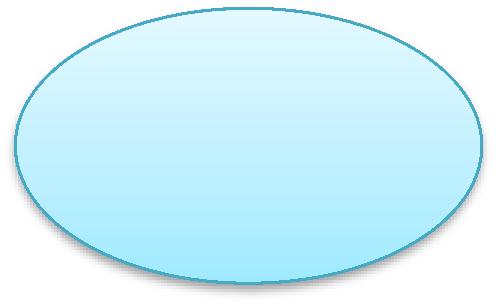
- Teacher plays the record for SS to listen and read the conversation about health problem. -Ss listen and practice saying with their partners.
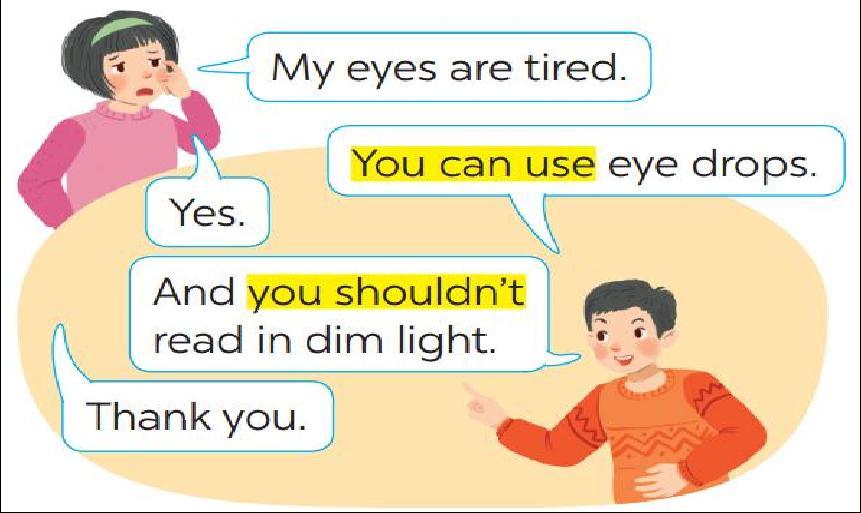
-Teacher calls some pairs to read aloud.
-Teacher corrects pronunciation if necessary.
-Teacher asks Ss to pay attention to the highlighted parts and asks them some questions to elicit the new structure: -What do these sentences mean? -When do we use these sentences?
-…
-Ssanswer teacher’s questions to find out new structure to give tips for health problems.
-Some students give the new structure to the teacher.
- Teacher corrects and writes on the board:
TASK 1: LISTEN AND READ THE DIALOGUE. (Ex 1, p. 22)
* Structure: to give advice: -You should/ shouldn’t + V -You can + V
* PRACTICE (15’) Task 2:
DẠYKÈMQUYNHƠNOFFICIAL
* Game:BRAINSTORMING
* Aims: To help students practise giving tips on health problems.
* Content: Make similar dialogues.
* Products: Role play and practisein front of the class.
* Organization of implementation: Teacher’s and Ss’activities Content
Task 2:T –Ss : Ss-Ss
* Teacher has Ss look at the situation in Ex 2 to make similar dialogue:
** Sswork in pairs to make similar dialogue.
*** Teacher calls some pairs to present it in front of the class.
**** Teacher gives feedback and some comments.
-
TASK 2: MAKE SIMILAR CONVERSATION.
1. I’m tired.
2. I have acne.
3. My hands are chapped.
* Suggested answers:
A: I am tired.
B: You can drink some milk. A: Yes.
B: And you should have a nap. A: Thank you.
TIPS FOR A HEALTHY LIFE
Task 3:
* Aims: To provide studentswith more knowledge about healthy living and help them practice the skill of reading for the main idea
* Content: Read the passage and choose the correct title for it.
* Products: Ss give their answer and explain it exactly.
* Organization of implementation: Teacher’s and Ss’activities Content
Task 3: T-Ss, Ss –Ss
* Teacher asks Ss to read the passage independently and choose the correct answer of the main idea.
** Ss so the task individually.
*** Teacher calls some Ss to give their answer and explain it.
**** Teacher confirms the correct answers.
TASK 3: READ THE PASSAGE AND CHOOSE THE CORRECT TITLE FOR IT. (Ex 3, p, 22)
* Answer key: A In this passage, the author mentions to the way to live long including diet and outdoor activities. Task 4
* Aims: To helpstudentsidentify the main points in a reading and talk about them.
* Content: Discuss and make a list for the tips which help the Japanese live long lives.
* Products: prastice in groups and give the answers perfectly.
* Organization of implementation:
Teacher’s and Ss’activities
Task 4:T-Ss, Ss –Ss
* Teacher has students work in groups to discuss and takes notes of the tips for a long life that they find in the text.
** Ss work in groups.
*** 2-3 groups share their lists.
**** Teacher confirms and corrects if necessary.
Content
TASK 4: DISCUSS AND MAKE A LIST FOR THE TIPS WHICH HELP THE JAPANESE LIVE LONG LIVES. (Ex 4, p. 22)
* Suggested answers:
+ List of tips:
(1) They eat a lot of fish and vegetable.
(2) They cook fish with little cooking oil.
(3) They also eat a lot of tofu.
DẠYKÈMQUYNHƠNOFFICIAL
(4) The Japanese work hard and do a lot of outdoor activities.
* PRODUCTION (5’)
* Aims: To help students practisegiving health tips on their own context.
* Content: Discuss and come up with some tips for how the Vietnamese can live longer.
* Products: Students’ ideas on the group boards.
* Organization of implementation: Teacher’s and Ss’activities Content
Task 5: T-Ss, Ss -Ss
* Teacher asks students to work in groups of 4-5.
** Ss work in group of 4-5 to discuss and come up with some tips for how the Vietnamese can live longer.
*** Some groups share ideas with the whole class and other groups listen and add more their ideas.
**** Teacher listens and corrects if necessary.
TASK 5: DISCUSS AND MAKE A LIST FOR THE TIPS THAT THE VIETNAMESE CAN DO TO LIVE LONGER. (
* Suggested answers: 1. avoid overeating 2. domore outdoor activities. 3. drink enough water 4. sleep before 10 p.m 5. eat more nuts. 6. do more exercises. 7. …
* CONSOLIDATION (3’)
* Aims: To consolidate what students have learnt in the lesson.
* Content: Summarize the content in the lesson .
* Products: Some students say aloud what students have learnt in the lesson.
* Organization of implementation: Teacher’s and Ss’activities Content
Teacher asks students to talk about what they have learnt in the lesson. -learn how to ask for and give health tips -practise using some grammar points and vocabulary related to the topic. -
* HOMEWORK(2’)
* Aim: To revise the knowledge that students have gained in this lesson. And prepare for the next lesson: Skills 1.
* Content: Review the lesson and prepare for the next lessonand do exersie in the workbbook
* Products: Students’ textbook and workbook
* Organization of implementation: Teacher’s and Ss’ activities Content
-T reminds Ss to do homework and prepare the new lesson. -Do exercises in the workbook -Prepare lesson 5 ( skills 1)
*-Evaluation:
DẠYKÈMQUYNHƠNOFFICIAL
……………………………………………………………………………………………………… …………………………………………………………………………
Date of planning : …/… / 2022
Date of teaching : …/… / 2022
Week : UNIT 2: HEALTHY LIVING Period : Lesson 5 : Skills 1
I. OBJECTIVES:
By the end of this lesson, students will be able to gain:
1. Knowledge
+ Reading: -read for specific information about acne
+ Speaking: -talk about how to deal with some health problems.
2. Core competence
-Develop communication skills
-Be collaborative and supportive in pair work and team work
-Actively join in class activities
3. Personal qualities Be benevolent and responsible
II. MATERIALS
1. Teacher: -Grade 7textbook,Planning ( Unit 2, Skill 1) -Smart TV/Pictures, sets of word cards -sachmem.vn
2. Students: Text books, notebooks, posters, ….
3. Method: Ask and answer ; group works; individual ……
IV. PROCEDURES : (STAGES)
* Warm-up (5’)
* Aim:To introduce the topic of reading; To lead in the lesson about Skills 1.
*Content: GAME: HANGMAN
* Products: The team which can find or guess the secret first will be the winner.
* Organization of implementation: Teacher’s and Ss’activities Content - T-Ss
* Teacher divides class into 2 teams and asks them to think of the word which has 13 letters in it related the topic “health problems”.
** Sshave 1 min to think of the words related to the topic or they can discuss with their partners.
*** Each member from each team turn by turn guesses the letter in the secret word.
**** Teacher corrects their answers.
-The team which can find or guess the secret first will be the winner.
‡ Lead - in
* Play a game : GAME: HANGMAN SKINCONDITION
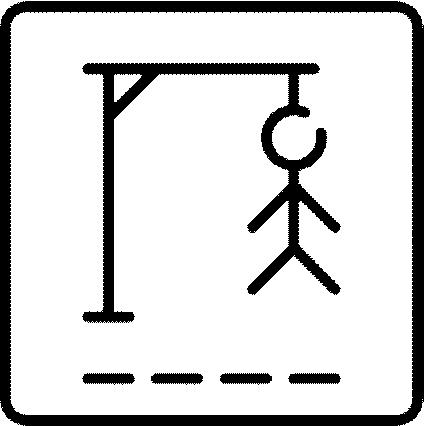
DẠYKÈMQUYNHƠNOFFICIAL
Teacher leads students into the lesson by telling what they are going to learn: “We are going to read a passage about one of the most common “Skin condition” among teenagers
* PRE-READING (PRE-TEACH VOCABULARY)(10’)
* Aim: To provide students with some lexical items before reading the text again.
* Content: Learn some vocabrelated in the lesson.
* Products: Read and understand the meaning of vocab.
* Organization of implementation:
Teacher’s and Ss’activities Content
- T -Ss
- Teacher introduces the vocabulary by:
+ Providing the synonym or antonym of the words.
+ Providing the pictures of the words.
+ Providing the definition of the words
. * VOCABULARY:
1. disease (n):[explanation] 2. serious (a): [explanation] 3. take care of (phr v): [symnonym] 4. pop (v): [visual + explanation]
* Concept check: Rub out and Remember. Task 1
* Aim: To introduce words related to skin conditions to Ss and help Ss have a general idea of what they are going to read.
* Content:Discusss “ Which skin condition is the most common among teenagers?”
* Products: Ssdiscuss and give the answers exactly.
* Organization of implementation: Teacher’s and Ss’activities Content
T –Ss :
* Teacher asks Ssto work in pairs to look at some pictures in Ex 1 on page 23 to write each word or phrase under the correct picture and discuss with their partners “Which skin condition is the most common among teenagers”.
** Ss work in pairs.
*** Teacher calls some Ss to check what they have discussed.
**** Teacher corrects.
Task 1. Work in pairs. Discuss and write each word or phrase under the correct picture. Which skin condition is the most common among teenagers?
* Answer keys:
1. chapped skin 2. acne 3. sunburn
* WHILE -READING(10’)
Task 2
* Aims: To help Ss develop their reading skill for specific information (scanning) and help them focus on the problem of acne.
* Content: Read the passage and match the beginnings in A with the endings in B.
* Products: Students say aloud the correct answers .
* Organization of implementation: Teacher’s and Ss’activities Content
Task 2:T –Ss : Ss-Ss
* Teacher has Ss read the text in detail to do
Task 2:Read the passage and match the beginnings in A with the endings in B.
DẠYKÈMQUYNHƠNOFFICIAL
the exercise and asks them how to do this kind of exercise.
-Read the beginnings in A. They all start with ‘acne’ plus the verbs (is, affects, causes).
-Locate the part of the text where they find the information. They all appear right in the first paragraph. --Read that part and do the matching.
** Ss do the task independently
*** Teacher tells Ss to compare their answers in pairs before calling some of them to check.
**** Teacher confirms the correct answer and explains if necessary.
A B
1. Acne i a. young people the most
2. Acne causes b. a skin condition 3. Acne affects c. a serious disease 4. Acne is not d. small, red spots
* Answer key: 1. b 2. d 3. a 4. c Task 3:
* Aims: To help students further develop their reading skill for specific information (scanning).
* Content: Read the passage again and choose the correct answer A, B, or C. (Ex 3, p. 23)
* Products: Ss give the correct answers.
* Organization of implementation :
Teacher’s and Ss’activities
Task 3: T-Ss, Ss –Ss
* Teacher asks Ss: reading each question, locating where the information appears in the text, reading that part carefully and circling the correct answer.
** Ss do the task independently.
*** Teachers has Sscompare their answers in pairs and call some Ss to give their ideas.
**** Teacher checks and confirms the correct answers.
Content
Task 3: Read the passage again and choose the correct answer A, B, or C. (Ex 3, p. 23)
* Answer key: 1. A 2. C 3. B 4. B 5. A
* POST –READING (5’) Task 4:
* Aims: To check students’ reading comprehension
* Content: Retelling the text.
* Products: A student retells the text fluently.
* Organization of implementation:
Teacher’s and Ss’activities
T-Ss, Ss –Ss
* Teacher asks Ssto work in groups and take turn to say 1 sentence which they can remember from the passage they have read about “acne”.
** Ss work in groups.
*** Teacher calls some groups to check.
**** Teacher corrects if necessary
* Retelling
Content
-Acne is a skin condition, -Here are some tips for taking care of skin with acne
DẠYKÈMQUYNHƠNOFFICIAL
* PRE-SPEAKING (5’)
* Aims: To help Ss talk about how they apply the tips in the reading to themselves.
* Content: Read the passage again. Pick the tips which you can easily follow.
* Products: Ss share their answers with the class.
* Organization of implementation: Teacher’s and Ss’activities Content
Task 4: T-Ss, Ss –Ss
* Teacher asks Ssto work in pairs and tells them to focus on the tips for acne in the text to talk about which tip they can easily follow.
** Sswork in pairs. Teacher goes around and listens and gives help if necessary.
*** Teacher calls on some Ss to share their answers with the class. If there is a tip they cannot follow, ask them to explain why not.
**** Teacher listens and gives comment.
II. Speaking
Task 4:Read the passage again. Pick the tips which you can easily follow. Share your ideas with your partner.
* I can easily follow some tips: -Go to bed early. -Eat more fruit and vegetables. -Wash my face with special soap for acne. -Go to bed early and get enough sleep. -Eat more fruit and vegetables, and less fast food. -Wash my face with special soap for acne, but no more than twice a day.
* WHILE -SPEAKING(6’)
* Aims: To provide Ssan opportunity to practise giving tips for health problems.
*Content: Read about the health problems below. Discuss and make notes of some tips you can give each person.
* Products: Some groups share their answers with the class.
* Organization of implementation: Teacher’s and Ss’activities Content
Task 5: T-Ss, Ss-Ss
* Teacher has Ss work in groups and asks them to take turns to give tips for each health problem.
** Ss work in groups to do the task. Teacher goes around, listens and gives help if necessary.
*** Teacher calls on some groups to share their answers with the class.
**** Teacher comments.
Task 5:Read about the health problems below. Discuss and make notes of some tips you can give each person. Then share your ideas with the class.
* Suggested answers:
1. Use some lip balm. Use coconut oil or body lotion.
2. Eat less fast food, meat, and ice cream. Eat more fruit and vegetable.
3. Get enough sleep, 7 -8 hours a day. Don't go to bed too late.
4. Keep warm and stay in bed. Drink plenty of water and eat light food.
5. Avoid washing your hair every day. Take vitamins.
* POST –SPEAKING (3’)
* Aim:- To help students improve next time.
* Content: Give commentsandvote the best tips about the health problems.
* Products: Students comment and give opinions clearly.
DẠYKÈMQUYNHƠNOFFICIAL
* Organization of implementation: Teacher’s and Ss’ activities Content
T-Ss, Ss -Ss
- Have students give comments on their friends and vote for the most interesting and informative presentation.
-Teacher gives feedback and comments.
Ss’ comments.
* Consolidation (3’)
* Aims: To consolidate what students have learnt in the lesson.
* Content: Summarize the lesson’s content briefly.
* Products: Some students say aloud what theyhave learnt in the lesson.
* Organization of implementation:
-Teacher asks students to talk about what they have learnt in the lesson. -Some new words -Some tips for taking care of skin with acne and the common health problems.
* Homework (2’)
* Aim: To revise the knowledge that students have gained in this lesson.
* Content: Review the lesson and prepare for the next lesson.
* Products: Students’ textbook and workbook.
* Organization of implementation:
-Teacher asks students to prepare the new lesson -Do exercises in the workbook. -Prepare for the next lesson: Unit 2-Skills 2.
*-Evaluation:
DẠYKÈMQUYNHƠNOFFICIAL
……………………………………………………………………………………………………… …………………………………………………………………………
Date of planning : …/… / 2022
Date of teaching : …/… / 2022
Week : UNIT 2: HEALTHY LIVING Period : Lesson 6: Skills 2
I. OBJECTIVES:
By the end of this lesson, students will be able to:
1. Knowledge
+ Listening
-use the lexical items related to the topic Healthy living -listen for specific information about some advice about healthy habits
+ Writing: write some advice to avoid viruses.
2. Core competence
-Develop communication skills
-Be collaborative and supportive in pair work and team work
-Actively join in class activities
3. Personal qualities Be benevolent and responsible
II. MATERIALS
1. Teacher: -Grade 7textbook,Planning ( Unit 2 –Looking back) -Smart TV/Pictures, sets of word cards -sachmem.vn
2. Students: Text books, notebooks, posters, ….
3. Method: Ask and answer ; group works; individual ……
IV. PROCEDURES : (STAGES)
* Warm–up (5’)
* Aim:To activate students’ prior knowledge and vocabulary related to the lesson . To introduce the new lesson.
* Content:
* Products:* Organization of implementation: Teacher’s and Ss’activities Content
* Warm upT-Ss
* Teacher writes on the board the word “Healthy habits” and asks Ss some questions: ** Ss think of these questions and discuss with their partners if needed.
*** Teacher calls some students to give their answers.
**** Teacher listens and give comments.
‡ Lead –in:
Teacher introduces students the content of the lesson: “In the lesson today, we are going
* Warm up: CHATTING:
+ What does this word mean?
+ What do we do to have “healthy habits”?
+ Can you name some “healthy habits?”
* Suggest answer:
-Eating and drinking healthy -Be active and exercise every day. -Get enough sleep, 7 -8 hours a day.
-Drink enough water,
+ Eat less fast food, meat, ….
+ Eatmore fruit and vegetable.
+ Don't go to bed too late.
+………………
DẠYKÈMQUYNHƠNOFFICIAL
to listen to the professor talking about healthy habits
* PRE-LISTENING(5’)
Task 1:
* Aim: To help Ssbrainstorm the topic and prepare for the listening text
* Content: Discuss and tick the habits you think are good for your health.
* Products: Ssgive the correct answers.
* Organization of implementation: Teacher’s and Ss’activities Content
Task 1: T-Ss, Ss -Ss
* Teacher asks Ss to work in pairs to discuss if these sentences are good or bad for their health.
** Ss work with their partner to do the task.
*** Teacher calls on some Ss to answer.
**** Teacher gives comments and leads Ss to task
Task 1: Discuss and tick the habits you think are good for your health.
1. Eat a lot of meat and cheese.
2. Drink soft drinks every day. 3. Get ten hours of sleep daily. 4. Be active and exercise every day.
* Suggested answers: Good for health: 2, 3
* WHILE –LISTENING(10’)
Task 2:
* Aims: To help Ss develop their skill of listening for specific information.
* Content: Listen and tick the habits mentioned.
* Products: students givethe answers exactly.
* Organization of implementation : Teacher’s and Ss’activities Content
Task 2: T-Ss, Ss -Ss
* Teacher has students guess if these habits are mentioned in the listening text. If they say yes for a habit, put a tick next to the word. Then, teacher plays the recording once for students to check their guesses.
** Ss work independently to guess then listen to the recording once to check their guess.
*** Teacher calls on some students to give the answers the have listened.
**** Teacher plays the recording again and confirms the correct answers for their prediction.
Task 2: Listen and tick the habits mentioned. * Answer key: Habits mentioned in the listening text: 1, 3, 4, 6 Audio script –Tracks 12 + 13: “Healthy habits help us keep fit and avoid disease. Here is some advice. Eat more fruit and vegetable, especially coloured ones like carrots and tomatoes. They provide a lot of vitamins. Eat meat, eggs, and cheese, but not too much. You may put on weight. Drink enough water, but not soft drinks. Be active and exercise every day. Do outdoor activities like cycling, swimming, or playing sports. They keep you fit. Go to bed early and get about 8 hours of sleep daily, so you will not feel tired. Keep your room tidy and clean. Open windows to let in fresh air and sunshine on fine days.”
Task 3:
* Aims: To help Ss further develop their skill of listening for specific information.
* Content: Listen again and answer the questions with no more than THREE words
* Products: Ss write the correct answer on the board.
DẠYKÈMQUYNHƠNOFFICIAL
* Organization of implementation :
Teacher’s and Ss’activities Content
-T-Ss, Ss-Ss
* Teacher has Ss read the questions and determinewhat information they need for answering the questions. Remind them answer the questions with no more than THREE words. Then, teacher plays the recording once or twice more for Ss to do the exercise.
** Ss work independently to listen again and determinewhat information they need. After that, Ss can share their answers in pairs.
*** Teacher calls on some pairs to give answers.
**** Teacher confirms the correct ones and plays the recording again if needed, stopping at the places where students are having difficulties.
Task 3: Listen again and answer the questions with no more than THREE words.
1. What do healthy habits help you avoid?
2. What do fruit and vegetables provide you with?
3. How many hours do you need to sleep a day?
4. How should you keep your room?
*Suggested answers:
1. disease
2. (lots of) vitamins 3. 8 / eight hours
4. tidy and clean
*PRE –WRITING (7’)
* Aims: To help Ss make simple notes of what they have listened to.
* Content: Discuss and make notes of the tips from the listening. Then share them with the class.
* Products: Ss share their answers as the class .
* Organization of implementation: Teacher’s and Ss’activities Content -T-Ss, Ss-Ss
* Teacher tells Ss to work in groups to discuss and make notes of the tips and write in full sentences.
** Ss work in groups. Teacher moves around and offers help if needed.
*** Teacher invites some Ss to share their answers.
**** Teacher confirms the correct answers.
Task 4: Discuss and make notes of the tips from the listening. Then share them with the class e.g. Don’t eat too much meat and cheese.
* Suggested answers:
- Drink enough water, but not soft drinks.
- Be active and exercise every day.
- Do outdoor activities like cycling, swimming, or playing sports.
- Go to bed early and get about 8 hours of sleep daily.
- Keep your room tidy and clean.
Task 5:
* Aim: To help Ss prepare ideas to write a passage.
* Content:Discuss and brainstorm ideas.
* Products: Students’ ideas in their notebooks.
* Organization of implementation: Teacher’s and Ss’activities Content
DẠYKÈMQUYNHƠNOFFICIAL
-T-Ss, Ss-Ss
* Teacher writes on the board “Covid-19” and asks Ss to give ideas on what they have known about it and asks them to look at the pictures and explains if needed ** Ss think of it and can discuss with their partners.
*** Teacher calls on some Ss to raise their ideas.
**** Teacher listens and confirms.
Task 5: Discuss and brainstorm ideas.
Suggested answers: happened in 2019, it caused by virus, many people died of it, …
WHILE –WRITING ( 7’) Task 6
* Aim: To help Ss practisewriting a passage to give advice on how to avoid viruses.
* Content: Write a passage of about 70 words to give advice on how to avoid viruses.
* Products: Students’ writing in their noteboooks.
* Organization of implementation:
Teacher’s and Ss’activities
-T-Ss, Ss-Ss
* Teacher tells Ss that they are going to write a passage to give advice on how to avoid viruses
** Sswork independently to do the task and try to add more tips if they can.
-Teacher goes around and help if necessary.
Content
Task 6: Write a passage of about 70 words to give advice on howto avoid viruses.
* POST -WRITING(3’)
* Aim: To peer check, cross check and final check students’ writing.
* Content: Ss’writing about some advice to avoid viruses.

* Products: Some Ss showtheir writing in front of the class.
* Organization of implementation:
Teacher’s and Ss’ activities
-T-Ss, Ss-Ss
*** Teacher asks Ssto share their writing with their partners. Then, call on some Ss to show their writing in front of the class.
**** Teacher checks ideas, grammar, vocabulary and gives comments.
Content
* WRITE A PASSAGE OF ABOUT 70 WORDS TO GIVE ADVICE ON HOW TO AVOID VIRUSES
Suggested answers:
We can do a lot of things to avoid viruses. First, always keep your surroundings clean. Sweep your house, clean your furniture, and change your pillow covers and bedsheets often. Remember to take a bath daily. Wash your hands with soap regularly. Drink a
DẠYKÈMQUYNHƠNOFFICIAL
lot of water and eat more fruit and vegetable. Exercise three times a day for at least 15 minutes each time. When you go out, wear a mask and avoid crowds.
* Consolidation (2’)
* Aim: To consolidate what students have learnt in the lesson.
* Content: Summarize some main content in the lesson.
* Products: Students say what they have just learnt in the lesson.
* Organization of implementation: Teacher’s and Ss’ activities Content
-Teacher asks students to talk about what they have learnt in the lesson. -listen for specific information about some advice about healthy habits -write some advice to avoid viruses.
* Homework (2)
* Aim: To review the knowledge that students have gainedin this lesson.
-To allow students finalize their versions after being checked by friends and teacher.
* Content: Review the lesson and prepare for the next lessonand do exersie in the workbook.
* Products: Students’ textbook and workbook.
* Organization of implementation:
- Teacher asks students to write down the email in their books.
-Teacher asks students to prepare the new lesson.
*-Evaluation:
- Rewrite the passage on the notebook. -Prepare “ Looking back and project”
DẠYKÈMQUYNHƠNOFFICIAL
……………………………………………………………………………………………………… …………………………………………………………………………………………….
Date of planning : …/… / 2022
Date of teaching : …/… / 2022
Week : UNIT 2: HEALTHY LIVING
Period : Lesson 7: Looking back and project
I. OBJECTIVES:
By the end of the lesson, students will be able to: -review the vocabulary and grammar of Unit 2; -apply what they have learnt (vocabulary and grammar) into practice through a project.
1. Knowledge:
* Vocab: Revise some words of unit 2.
* Grammar: Know how to recognize and write simple sentences
2. Core competence
-Develop communication skills and creativity
-Be collaborative and supportive in pair work and team work
-Actively join in class activities
3. Personal qualities
-Be benevolent and responsible -Develop self-study skills
II. MATERIALS
1. Teacher: -Grade 7textbook, Planning ( Unit2 –Looking back and project) -Smart TV/Pictures, sets of word cards -sachmem.vn
2. Students: Text books, notebooks, posters, ….
3. Method: Ask and answer ; group works; individual ……
IV. PROCEDURES : (STAGES)
* Warm-up (5’)
* Aim:To help students revise the vocabulary items they have learnt in the unit.
-To enhance students’ skills of cooperating with team mates.
*Content: Retell the main content in the unit.
* Products: Some students retell themain content in the unit.
* Organization of implementation: Teacher’s and Ss’activities Content
* Warm up
T -Ss
* Teacher asks Ss to think of what they have learnt already in Unit 2.
** Ss work in pairs to do the task.
*** Teacher calls some students to retell.
**** Teacher confirms and leads them to do all the exercises in books.
* Game:BRAINSTORMING
Healthy living
-Some words related to the topic Healthy living
- Talk about Healthy living
- Know how to recognize and write simple sentences
* VOCABULARY ( 10’) Task 1
* Aim: To help Ss revise the vocabulary items (verbs) they have learnt in the unit.
DẠYKÈMQUYNHƠNOFFICIAL
* Content: Complete the sentences with the verbs in the box.
* Products:
* Organization of implementation: Teacher’s and Ss’activities Content
- T –Ss :
* Teacher has Sswork individually read the verbs in the box and see if they still remember their meanings.
** Ss do this activity individually, then compare their answers with their partners.
*** Teacher asks for Ss’ answers.
**** Teacher confirms the correct ones
Task 1: Complete the sentences with the verbs below.
* Answer key: 1. keep 2. affects 3. avoid 4. are 5. exercise Task 2:
* Aims: To help Ssrevise the vocabulary items (adjectives) they have learnt in the unit.
* Content: Write the words below next to their definitions
* Products: Some students write correct answers on the board.
* Organization of implementation: Teacher’s and Ss’activities Content
- T –Ss ; Ss -Ss
* Teacher has Ss work individually read the adjectives in the box and see if they still remember their meanings.
** Ss do this activity individually, then compare their answers with their partners.
*** Teacher asks for Ss’ answers.
**** Teacher confirms the correct ones.
Task 2: Write the words below next to their definitions (Ex 2, p. 26)
Answer key: 1. active 2. healthy 3. tidy 4. fit 5. dirty
*GRAMMAR ( 10’) Task 3.
* Aims: To help Ss revise simple sentences.
* Content: Tick the simple sentences.
* Products: Ss do the exercise individually and swap with their partners.
* Organization of implementation
Teacher’s and Ss’activities Content
Task 3: T-Ss, Ss -Ss
* Teacher asks Ss again What is a simple sentence? and tell them to do Ex 3 in the workbook.
** Ssdo the exercise individually and swap with their partners.
*** Teacher calls some Ss to check their answer.
**** Teacher confirms the correct answer.
Task 3:Tick the simple sentences
* Answer key: Simple sentences: 2, 3, 5
DẠYKÈMQUYNHƠNOFFICIAL
Task 4:
* Aims: To help Ss revise simple sentences.
* Content: Change the following sentences into simple ones.
* Products: Students write the sentences on the board.
* Organization of implementation: Teacher’s and Ss’activities Content
Task 4:T-Ss, Ss-Ss
* Teacher asks Ss to write a simple sentence by identifying the main parts of the new sentence.
** Ss work individually to do the task.
*** Teacher calls 1 -2 Ss to write on the board.
**** Teacher checks and confirms their answer.
Task 4: Change the following sentences into simple ones.
* Answer key:
1. Both you and your brother are active.
2. Your room looks dark and untidy.
3. The Japanese work hard and exercise regularly.
4. My mother eats a lot of fruit and vegetable.
* PROJECT(5’)
* Aims: To help Ssidentify a bad habit for healthy living in their school and offer some tips to change that habit..
* Content: Posters exhibition
* Products: Students’ posters
* Organization of implementation: Teacher’s and Ss’activities Content
Project: T-Ss, Ss–Ss (group work)
* Ask Ssto read the instructions again (T has already assigned the project since the first lesson of the Unit and check their progress after each lesson). Let students have some time to check their posters for the final time and make any adjustments if neccessary.
** T has groups show their posters and present the hobbies to the class. Remember to have the “show and tell” session and vote for the best poster.
*** Students vote for the best poster.
**** Teacher gives feedback.
Task 5: Posters exhibition:
1. Discuss and find a bad habit and some tips to change it.
2. Find or draw a picture to illustrate your idea. 3. Present your poster to the class.
* Some groups’ posters BUILD HEALTHY HABITS
+ Give some tips to change that habit.
Eg: A bad habit: Eating unhealthy food -Eat healthy food. -Drink more water. -Avoid drinking soft drinks -Eat less fast food.
* Consolidation (2’)
* Aim: To consolidate what students have learnt in the lesson.
* Content: Summarize thelesson’s content.
* Products: A student says what she/ he has just learnt in the lesson.
* Organization of implementation: Teacher’s and Ss’activities Content
- Teacher asks students to talk about what - revise vocabulary in unit 2
DẠYKÈMQUYNHƠNOFFICIAL
they have learnt in the lesson.
-revise Know how to recognize and write simple sentences
* Homework (2’)
* Aim: To revise the knowledge that students have gained in Unit2 and To prepare for the next lesson
* Content: Review the lesson and prepare for the next lessonand do exersie in the workbbook
* Products: Students’ textbook and workbook
* Organization of implementation: Teacher’s and Ss’ activities Content
- Teacher asks students to reviseold lesson and to do exercise in workbook.
-Teacher asks students to complete the project and prepare the new lesson.
- Complete the project -Prepare for the next lesson: Unit 3 –Lesson 1. Getting started.
DẠYKÈMQUYNHƠNOFFICIAL
*-Evaluation: …………………………………………………………………………………………….
Date of planning : …/… / 2022
Date of teaching : …/… / 2022
UNIT 3: COMMUNITY SERVICE
Lesson 1: Getting started –Sounds like great work!
I. OBJECTIVES:
By the end of this lesson, Ss will be able to gain:
1.
Knowledge
-An overview about the topic “Community service” -lexical items related to community activities

2. Core competence
-Develop communication skills and enhance awareness of preserving the culture -Be collaborative and supportive in pair work and teamwork
-Actively join in class activities
3. Personal qualities
-Develop self-study skills
-Raise students’ awareness of the need to keep their neighbourhood green
II. MATERIALS
1. Teacher: -Grade 7textbook,Planning ( Unit 3-Getting started ) -Smart TV/Pictures, sets of word cards -sachmem.vn
2. Students: Text books, notebooks, posters, ….
3. Method: Ask and answer ; group works; individual ……
III. PROCEDURES : (STAGES)
* Warm-up (5’)
* Aim: To revise old lesson and to introduce the new lesson.
* Content: Picture describing
* Products: Ssunderstand and say activities about “ Community service”
* Organization of implementation: Teacher’s and Ss’activities Content
* Warm up: T –SS
* Teacher shows the picture and asks students questions:
** Students raise hands to answer the questions.
*** Teacher and students discuss the questions.
**** Teacher accepts all students’ questions and explains the term “Community service”
‡ Lead in:
-T introduces the topic of the lesson. Today we aregoing to learn about “Community service”
* Teacher draws students’ attention to the picture in the textbook and asks them about “community
* Picture describing -What can you infer from this picture?
‡ Community service (The work that people do to help others without paying)
DẠYKÈMQUYNHƠNOFFICIAL
activities”.
** Students raise hands to answer the questions.
+ pick up litter + help homeless people + clean the street + donate clothes , books, money,… + plant trees, vegetables,..
* PRESENTATION (5’)
Pre teach vocabulary
* Aim: -To provide students with vocabulary.
-To help students well-prepared for the listening and reading tasks.
* Content: learn some vocabularies relatedtothetopic.
* Products: Students read and understand the meaning of vocab.
* Organization of implementation: Teacher’s and Ss’activities Content
* Pre teach vocabulary
-Teacher use different techniques to teach vocab (pictures, situation, realia) -Follow the seven steps of teaching vacab. -Repeat in chorus and individually
-Copy all the words
* Checking vocab: < what and where>
* Vocabulary
-community activity (n.phr.): hoạt động cộng đồng -donate (v): quyên góp, ủng hộ -nursing home (n.phr.): viện dưỡng lão -homeless (adj): vô gia cư
* Checking vocab: < what and where>
PRACTICE(20’)
Task 1
* Aims: To set the context for the introductory conversation; -To introduce the topic of the unit.
* Content: Listen and read the conversation.
* Products: Students read and understand the meaning of the conversation Students know how to role play
* Organization of implementation:
Teacher’s and Ss’activities Content -T-Ss
-Set the context: Have Ss look at the conversation and the picture, and answer some questions,
-Encourage Ss to answer, but do not confirm whether their answers are right.
-Set the context:
e.g. What can you see in the pictures? Where do you think the boys and the girls are? What do you think they are doing?
+ In picture 1: I can see a boy with a box. He is arranging books and toys (and may be clothes).
+ In picture 2: I can see a girl and some small children. They are in a classroom. The girl is teaching the small children.
+ In picture 3: I can see two girls and a boy. They are in the garden.They are gardening.
DẠYKÈMQUYNHƠNOFFICIAL
* Teacher can play the recording more than once.
** Students listen and read.
*** Teacher can invite some pairs of students to read aloud.
**** Teacher check students’ pronunciation and give feedback.
-To help Ss understand the main idea of the conversation, ask Ss to answer the question:
Task 1. Listen and read
-What are Tom and Minh talking about? (They are talking about community activities in their school.)
Task 2 (5’)
* Aims: -To help students read for specific information about Minh and Tom’s community activities
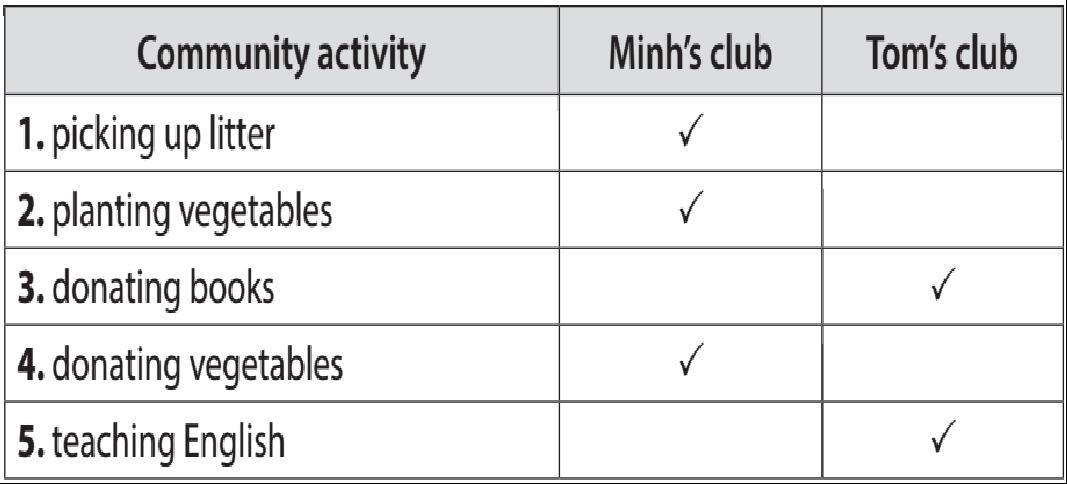
* Content: Read the conversation again and tick the appropriate box.
* Products: Ss tick the appropriate boxes. Some pairs say the answers aloud
* Organization of implementation: Teacher’s and Ss’activities Content
Task 2: T-Ss, Ss-Ss, T-Ss
* Teacher tells students to read the conversation again and work in pairs to find the answers.
** Students can underline the words and phrases about community activities then work together for one or two minutes to check the words / phrases they have underlined.
***Have pairs tick the appropriate boxes. Ask pairs to say the answers aloud: Mirth's club picks up litter; Tom's club donates books, etc. Make sure they pronounce the words / phrases correctly.
****Check the answers as a class.
Task 2: Read the conversation again and tick the appropriate box.
* Answer key:
Task 3
* Aims:- To help students use phrases related to community activities. -To help students further understand the text.
* Content: Complete the phrases under the pictures with the verbs below..
* Products: Students say the phrases aloud and pronounce the words and phrases correctly.
* Organization of implementation:
Teacher’s and Ss’activities Content
Task 3:T-Ss, Ss-Ss
Teacher asks students to work individually to complete the phrases under the pictures with the given verbs.
** Students work individually to complete the task.
*** Teacher allows students to share answers before discussing as a class.
**** Teacher asks students to say the phrases aloud and makes sure they pronounce the words and phrases correctly. Teacher can ask for
Task 3: Complete the phrases under the pictures with the verbs below.
* Answer key:
1. pick up 2. help 3. recycle 4. donate 5. clean
DẠYKÈMQUYNHƠNOFFICIAL
translation to check their understanding.
-
Task 4
* Aims: To help students use the vocabulary related to community activities in the right contexts.
* Content: Complete the sentences with the correct words or phrases below.
* Products: Students read aloud the full sentences.
* Organization of implementation: Teacher’s and Ss’activities Content
Task4:T-Ss, Ss-Ss
* Teacher asks students to work independently to complete each sentence with a word or phrase from the box.
** Students fill in the blanks with the most suitable words / phrases.
*** Teacher allows students to share answers before discussing as a class.
**** Teacher can ask students to read aloud the full sentences and correcttheir pronunciation if needed.
Task 4: Complete the sentences with the correct words or phrases below.
* Answer key: 1. homeless children 2. litter 3. old people 4. taught 5. planted PRODUCTION (5’)
Task 5:
* Aims: -To help students review and reuse the learnt vocabulary.
-To create a fun atmosphere in the class.
* Content: Vocabulary Ping-pong game.
* Products: Play gamein groups .The team that makes the most correct sentences wins.
* Organization of implementation: Teacher’s and Ss’activities Content
Task 5:T-Ss, Ss-Ss
* Teacher instructs students to play the Vocabulary Ping-Pong game: -Ask Ss to think of the topic Community Service.
-One student from team A shouts out a word or phrase related to the topic. Then one student from team B makes a sentence with that word or phrase. Then switch roles.
-The team that cannot give a phrase or make a correct sentence loses and the other teamgets a point.
** Students play the game.
*** Teacher can go around to help weaker students.
**** Teacher stops the game when time is up. The team that makes the most correct sentences wins.
Task 5: Vocabulary Ping-pong game.
* Example:
Team A: Litter
Team B: We often pick up litter in the park. Trees. Team A: We plan trees in our school every year. Book.
Team B : We donate books to poor children. Bottles
DẠYKÈMQUYNHƠNOFFICIAL
* CONSOLIDATION(3’)
* Aim: To consolidate what students have learnt in the lesson.
* Content: Vocabulay related to community activities.
* Products:
* Organization of implementation:
Teacher’s and Ss’ activities Content
-Teacher asks students to talk about what they have learnt in the lesson.
- Ss work indepently
-Some new words -Read and understand content of the conversation
* HOMEWORK(2’)
* Aim: To review the lesson and prepare for the next lesson.
* Content: Review the lesson and prepare for the next lesson( A closer look 1)
* Products: Students’ textbook and workbook
* Organization of implementation
Teacher’s and Ss’ activities Content
-T reminds Ss to do homework and prepare the new lesson. -Learn by heart all the new words. -Read the dialogue again.
- Prepare lesson 2 ( A closer look 1).
*-Evaluation:
Date of planning : …/… / 2022
Date of teaching : …/… / 2022
Week: UNIT 3: COMMUNITY SERVICE
DẠYKÈMQUYNHƠNOFFICIAL
……………………………………………………………………………………………………… …………………………………………………………………………
Period : Lesson 2: A closer look 1
I. OBJECTIVES:
By the end of this lesson, students will be able to gain:
1. Knowledge:
-Vocabulary: Use words related to community activities.
-Pronunciation: Correctly pronounce the sounds: /t/, /d/, /ɪd/ in isolation and in context
2. Core competence
-Develop communication skills and creativity
-Be collaborative and supportive in pair work and teamwork
-Actively join in class activities
3. Personal qualities
-Develop self-study skills
-Raise students’ awareness of the need to keep their neighbourhood green.
II. MATERIALS
1. Teacher: -Grade 7 textbook,Planning ( Unit 3, A closer look 1) -Smart TV/Pictures, sets of word cards -sachmem.vn
2. Students: Text books, notebooks, posters, ….
3. Method: Ask and answer ; group works; individual ……
III. PROCEDURES : (STAGES)
* Warm-up (5’)
* Aim:To recall students’ vocabulary on community activities
* Content: Match the verbs with the correct nouns.
* Products: The group with the most correct answers wins.
* Organization of implementation: Teacher’s and Ss’activities Content
-T –Ss, Ss -Ss
* Teacher has students play in two groups and explains the game rules.
** Each group will have a list of verbs and nouns. Students match the verbs they have with the correct nouns.
*** Teacher and students discuss the answers. The group with the most correct answers wins.
**** Teacher confirms the answers and gives feedback.
-Lead in : Today we are going to learn some words related to community activities.
* Aim: To introduce the new words.
* Content:
MATCHING GAME: Set of word cards: recycle help plant
trees vegetables small children old people books bottles cans homeless children
* PRESENTATION (7’)
* Pre teach vocabulary
* Products: Read and understand the meaning of vocab.
DẠYKÈMQUYNHƠNOFFICIAL
* Organization of implementation:
Teacher’s and Ss’activities Content
-T –Ss,
* Pre teach vocabulary
* Teacher introduces the vocabulary.
** Teacher introduces the vocabulary by: - providing the pictures providing the definition of the words *** Teacher asks students to repeat.
*** Teacher rubs out and checks - Ss concept checking
* VOCABULARY:
1. exchange (v): trao đổi 2. pick up (phr. v): nhặt lên 3. tutor (v): dạy kèm
* Checking vocab: < Matching>
*
PRACTICE (15’) Task 1
* Aims: To introduce some verbs and verb phrases that are often used to describe community activities.
* Content: Match the verbs in A with words / phrases in B
* Products: Students read out their answers .
* Organization of implementation:
Teacher’s and Ss’activities Content Task 1: T-Ss
* Teacher has read aloud the verbs in A and words / phrases in B.
** Students work in pairs to match the verbs in A with words / phrases in B.
*** Teacher asks them to share their answers in pairs before checking the answers as a class.
**** Teacher invites students to take turns to read out their answers and corrects their pronunciation if needed.
Task 1:MATCH A VERB IN A WITH A WORD OR PHRASE IN B. (Ex 1, p. 30)
* Answer key: 1. e 2. a 3. d 4. c 5. b Task2
* Aims: To allow students to use the learnt words / phrases in contexts.
* Content: Complete each of the sentences with a suitable word / phrase from the box
* Products: Ss swap their answerto peer check firstand say the correct answers .
* Organization of implementation:
Teacher’s and Ss’activities Content
Task 2: T-Ss, Ss -Ss
* Teacher asks students to work individually to complete each of the sentences with a suitable word / phrase from the box. All of these words / phrases have been learnt in.
** Students do the task individually.
*** Teacher allows students to swap their textbooks to peer check first.
**** Teacher confirms the answers and gives feedback, if necessary.
Task 2: COMPLETE EACH OF THE SENTENCES WITH A SUITABLE WORD OR PHRASE FROM THE BOX.
* Answer key: 1. litter 2. used paper for notebooks 3. water 4. donate 5. tutor
DẠYKÈMQUYNHƠNOFFICIAL
Task 3
* Aims: To have students practise producing full sentences using the learnt words / phrases.
* Content: Use the phrases from the box to write full sentences under the correct picture.
* Products: Ss write answers on the board.
* Organization of implementation: Teacher’s and Ss’activities Content
Task 3:T-Ss, Ss-Ss
* Teacher asks students to work individually to write full sentences, using the given phrases.
** Students read aloud the six phrases and match with the appropriate pictures.
*** Teacher asks students to work in pairs to swap their answers and peer check.
**** Teacher checks their answers as a class.
Task 3:USE THE PHRASES FROM THE BOX TO WRITE FULL SENTENCES UNDER THE CORRECT PICTURE. (Ex 3, p. 30)
Answer key:
1. She’s reading books to the elderly.
2. They’re giving gifts to old people.
3. They’re exchanging used paper for notebooks.
4. They’re donating clothes to poor children.
5. She’s planting trees in the park.
PRONUNCIATION
(10’) Task 4:
* Aims: -To help students identify how to pronounce the sounds /t/, /d/ and /ɪd/. -To help students practise pronouncing the sounds in words
* Content: Listen and repeat. Pay attention to the sounds /t/, /d/ and /ɪd/
* Products: Read and know how to pronounce t/, /d/ and /ɪd/
* Organization of implementation: Teacher’s and Ss’activities Content
Task 4:T-Ss, Ss-Ss
* Teacher has students listen to the recording once first.
** Students listen to the recordings and read out the words.
*** Teacher plays the recording for them to listen and repeat each word as a class, then as individuals.
**** Teacher check students’ pronunciation if needed.
+ Teacher shows students tips to pronounce with V-ed
PRONUNCIATION:/t/, /d/, and /id/ TASK 4:LISTEN AND REPEAT. PAY ATTENTION TO THE SOUNDS /t/, /d/ AND /ɪd/. (Ex 4, p. 30)
/t/ /d/ /ɪd/ cooked passed helped
watered cleaned volunteered
collected donated provided
Task 5:
* Aims: To help students practise pronouncing the sounds /t/, /d/ and /ɪd/ in sentences
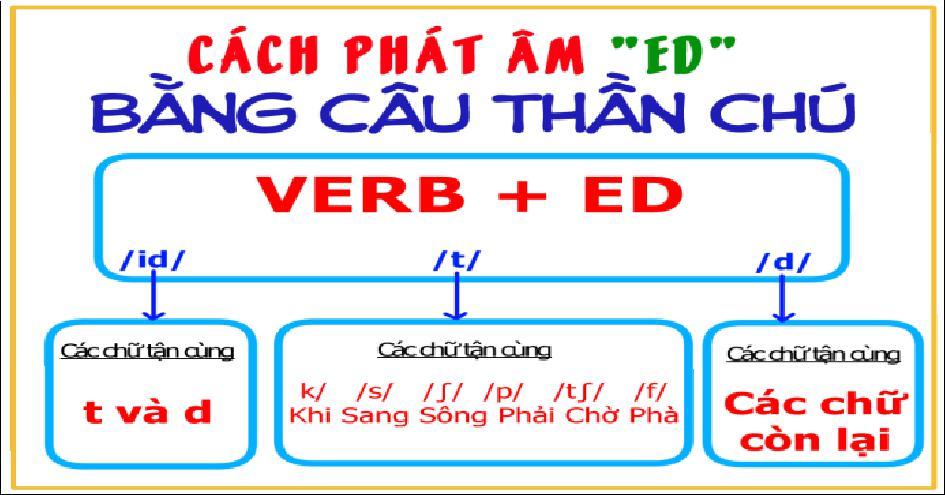
*Content:Listen to the sentences and pay attention to the underlined parts. Tick the appropriate sounds. Practise the sentences.
* Products: Whole class practise and tick the appropriate sounds.
* Organization of implementation:
DẠYKÈMQUYNHƠNOFFICIAL
Teacher’s and Ss’activities Content
Task 5 :T-Ss,
* Teacher has some students read the sentences first and asks them to pay attention to the underlined parts.
** Teacher plays the recording for Ss to listen then have them tick the appropriate sounds.
***Teacher invites some Ss to share their answers. Confirm the correct ones.
**** Teacher plays the recording again and ask students to repeat each sentence after the recording. Teacher confirms the answers.
TASK 5:LISTEN TO THE SENTENCES AND PAY ATTENTION TO THE UNDERLINED PARTS. TICK THE APPROPRIATE SOUNDS. PRACTISE THE SENTENCES (Ex 5, p. 31).
* Answer key:
* PRODUCTION(5’)
* Aim: To test students' quick reaction to the targeted sounds.
* Content: *Game: Broken telephone
* Products: Students plays in groups.
* Organization of implementation:
Teacher’s and Ss’ activities Content
* Teacher explains the rules: Teacher divides the class into 2 teams and asks them to stand in 2 lines. The first student from each line will be told some words with the /t/, /d/ and /ɪd/ sounds. Team members have to whisper one by one till the last. The last student from each line runs to the board and write down the words in the correct columns. The faster one with correct answers will be the winner.
** Students play the game.
*** Teacher helps students in the game.
**** Teacher gives feedback.
* GAME: BROKEN TELEPHONE
* Suggested key:
/t/ /d/ /ɪd/ picked, booked, helped tutored, watered, exchanged donated, planted
* CONSOLIDATION (3’)
* Aim: To consolidate what students have learnt in the lesson.
* Content: Vocab about personalities and how to /t/, /d/ and /ɪd/
* Products:
* Organization of implementation:
Teacher’s and Ss’ activities Content
-Teacher asks students to talk about what they have learnt in the lesson
-Vocabulary aboutcommunity activities pronounce the sounds/t/, /d/ and /ɪd/

*HOMEWORK(2’)
* Aim: To review the lesson and prepare for the next lesson.
* Content: Review the lesson and prepare for the next lesson and do exersie in the workbbook
DẠYKÈMQUYNHƠNOFFICIAL
* Products: Students’ textbook and workbook
* Organization of implementation:
Teacher’s and Ss’ activities Content
-T reminds Ss to do homework and prepare the new lesson.
-Learn by heart all the new words.
-What can you do to make your neighborhood to be a greener place? Write at least 3 activities.
- Prepare lesson 3 ( A closer look 2)..
Date of planning : …/… / 2022
Date of teaching : …/… / 2022 Week : UNIT 3: COMMUNITY SERVICE Period : Lesson 3: A closer look 2
DẠYKÈMQUYNHƠNOFFICIAL
*-Evaluation: ……………………………………………………………………………………………
I. OBJECTIVES:
By the end of this lesson, Ss will be able to gain:
1. Knowledge:
* Vocab: Some words related community activities.
* Grammar: -Understand the use of the past simple tense -Practice using the past simple to talk about past activities
2. Core competence:
-Develop communication skills and creativity
-Be collaborative and supportive in pair work and teamwork
-Actively join in class activities
3. Personal qualities
-Develop self-study skills
-Raise students’ awareness of the need to keep their neighbourhood green.
II. MATERIALS
1. Teacher: -Grade 7textbook,Planning (Unit 3, A closer look 2) -Smart TV/Pictures, sets of word cards -sachmem.vn
2. Students: Text books, notebooks, posters, ….
3. Method: Ask and answer ; group works; individual ……
IV. PROCEDURES : (STAGES)
* Warm-up (5’)
* Aim:To activate students’ prior knowledge related to the targeted grammar: the past simple.
* Content: Chatting( Ask Ss some questions)
* Products: Students usethe past simpleto answer the questions correctly.
* Organization of implementation: Teacher’s and Ss’activities Content
* Warm up -T -Ss
* Teacher asks students some questions:
** Students answer the questions, using the past simple.
*** Teacher and students discuss the answers.
**** Teacher corrects students answers if needed and confirms the use of the past simple (to talk about completed actions in the past).
‡ Lead in
- Teacher says: “This lesson today we are going to revise the past simple” ”
* Warm-up : Chatting
What did you do last weekend? What did you watch yesterday? Who did you meet two days ago?
* Students’ answer.
* PRESENTATION(7’)
* Aim: To review students’ knowledge of the past simple tense.
* Content: * Grammar:
* Products: Understand and how to use the present continuous.
DẠYKÈMQUYNHƠNOFFICIAL
* Organization of implementation:
Teacher’s and Ss’activities Content
T --Ss
* Teacher asks students to study the Grammar box.
-Teacher draws students’ attention to the meaning and use of the past simple.
** Teacher asks SS to remind the form of the past simple.
* **Teacher then asks some more able students to give some more examples.
**** Teacher confirms the answers and gives feedback.
UNIT 3:
Lesson 3 : A closer look 2
* Grammar: Review the past simple.
Positive S + V-ed / V ( cột 2) Negative S + did not / didn’t + V
Questions and short answers Did + S + V ? ∑ Yes, S + did. ∑ No, S + didn’t.
* PRACTICE(20’)
Task 1
* Aims: To review students’ knowledge of the past simple tense.
* Content: Circle the correct answer A, B, or C to complete each sentence.
* Products: Ss read aloud full sentences with the correct answers
* Organization of implementation: Teacher’s and Ss’activities Content
Task 1:T –Ss ,Ss-Ss
* Teacher has students work individually.
** Students work individually to to complete the sentences with the past simple form of the given verbs.
*** Teacher lets students work in pairs and exchange the answers before checking with the whole class (explain each sentence if necessary).
**** Teacher confirms the answers and gives feedback.
Task 1: Circle the correct answer A, B, or C to complete each sentence.
* Answer key: 1. B 2. C 3. B 4. A 5. C Task 2:
* Aims: To raise students’ awareness of the past simple tense and past forms of some verbs
* Content: Complete the sentences with the past simple form of the given verbs.
* Products: Ss exchange the answers and then write the correct answers on the board.
* Organization of implementation : Teacher’s and Ss’activities Content
Task 2: T-Ss, Ss -Ss
* Teacher has students work individually.
** Students work individually to complete the sentences.
*** Teacher lets students work in pairs and
Task 2: Complete the sentences with the past simple form of the given verbs.
* Answer key: 1. took 2. Did … join
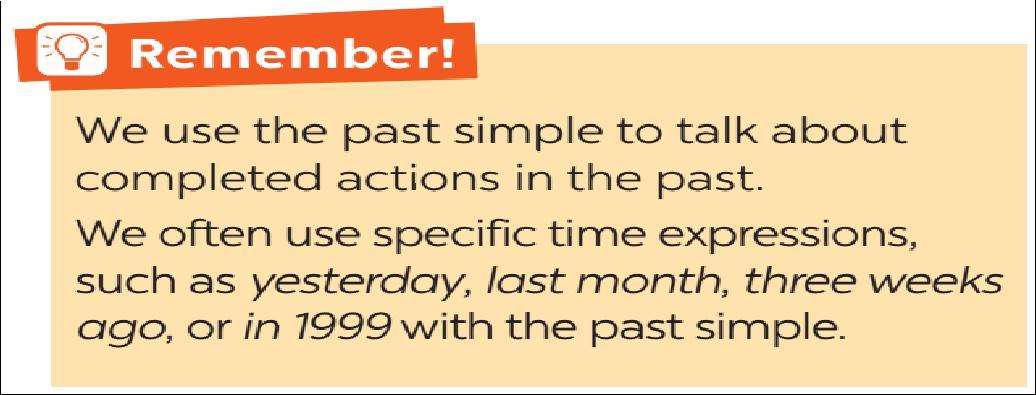
DẠYKÈMQUYNHƠNOFFICIAL
exchange the answers before checking with the whole class (explain each sentence if necessary).
**** Teacher confirms the answers and gives feedback.
3. helped 4. sent 5. volunteered Task 3
* Aims: To help students distinguish between the present simple, present continuous and past simple in specific contexts.
* Content: Complete the sentences with the correct forms of the verbs from the box.
* Products: Ss write the correct answers on the board.
* Organization of implementation: Teacher’s and Ss’activities Content
* T-Ss, Ss-Ss
* Teacher asks the whole class to read aloud the verbs in the box then has students work individually to complete the sentences with the correct forms of the verbs from the box.
** Students work individually to complete the task.
*** Teacher then has them work in pairs, comparing their sentences. Teacher can go around to help students.
**** Teacher confirms the answers and gives feedback.
Task 3: Complete the sentences with the correct forms of the verbs from the box.
* Answer key: 1. cook 2. Did … plant 3. are picking up 4. recycled 5. read
Task 4* Aims: To help students write full sentences using the correct forms of the verbs.
* Content: Write complete sentences from the prompts.
* Products: Students write full sentences on the board.
* Organization of implementation: Teacher’s and Ss’activities Content
* T-Ss, Ss-Ss
* Teacher has students work independently.
** Teacher asks students to do the exercise individually.
*** Teacher lets students work in pairs and exchange the answers before checking with the whole class (explain each sentence if necessary).
**** Teacher confirms the answers and gives feedback. .
Task 4: Write complete sentences from the prompts.
* Answer key:
1. Last year, our club donated books to children in rural areas.
2. Children sent thank-you cards to us a week ago.
3. I taught two children in grade 2 last summer. 4. Last spring, we helped the elderly in a nursing home.
5. We helped people in flooded areas last year.
* PRODUCTION(5’)
* Aims: -To enable students to ask and answer questions related to past activities.
-To help students be aware of some community activities that students in other countries do.
* Content: Practise asking and answering questions based on the fact sheet.
* Products: Some pairsask and answer in front of the class.
* Organization of implementation:
DẠYKÈMQUYNHƠNOFFICIAL
Teacher’s and Ss’activities Content
T-Ss, Ss –Ss
* Teacher introduces the Red Cross projects and activities in 2016 and 2020 and has students work in pairs for 5 minutes to practise asking and answering questions based on the fact sheet.
** Students use the past simple when they ask and answer questions about the past activities.
*** Teacher invites some pairs to make short conversations as an example.
**** Teacher corrects any grammar and pronunciation mistakes if necessary.
Taskk 5: Work in groups. Tom is from the Red Cross. Look at the fact sheet and ask Tom about his projects in 2016 and 2020.
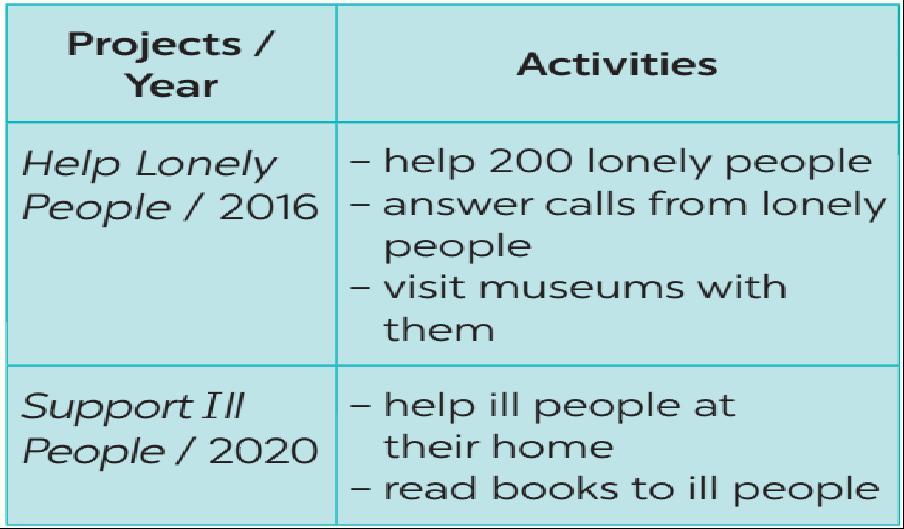
* Example:
Tom: I’m from the Red Cross. I worked on the Help Lonely People project in 2016.
Lan: What did you do?
Tom: We helped 200 lonely people…
* CONSOLIDATION(3’)
* Aim: To consolidate what students have learnt in the lesson.
* Content: Summarize the main content in the lesson.
* Products: Ss say what students have learnt in the lesson.
* Organization of implementation: Teacher’s and Ss’ activities Content
Teacher asks students to talk about what they have learnt in the lesson.
-Grammar: revise the past simple.
* HOMEWORK (2’)
* Aim: To revise the knowledge that students have gained in this lesson and prepare the new lesson
* Content: Review the lesson and prepare for the next lessonand do exersie in the workbbook
* Products: Students’ textbook and workbook
* Organization of implementation: Teacher’s and Ss’ activities Content
-T reminds Ss to do homework and prepare the new lesson.
*-Evaluation:
-Do exercises in the workbook.
- Prepare lesson 4 ( communication)
DẠYKÈMQUYNHƠNOFFICIAL
……………………………………………………………………………………………………… …………………………………………………………………………………………….
Date of planning : …/… / 2022 Date of teaching : …/… / 2022
Week : UNIT 3: COMMUNITY SERVICE Period : Lesson 4 : Communication
I. OBJECTIVES:
By the end of this lesson, Ss will be able to: -know how to give compliments -discuss and present the benefits of community activities
1. Knowledge:
-Vocabulary: vocabulary on community activities.
-Grammar: structures to give compliments.
2. Core competence:
-Develop communication skills and creativity
-Be collaborative and supportive in pair work and teamwork
-Actively join in class activities
3. Personal qualities
-Develop self-study skills -Raise students’ awareness of the need to keep their neighbourhood green
II. MATERIALS
1. Teacher: -Grade 7textbook,Planning (Unit 3-communication) -Smart TV/Pictures, sets of word cards -sachmem.vn
2. Students: Text books, notebooks, posters, ….
3. Method: Ask and answer ; group works; individual ……
III. PROCEDURES : (STAGES)
* WARM –UP (5’)
* Aim:To review students’ knowledge of the past simple tense.
* Content:ALPHABET GAME ( Using the past simple to make sentneces with the alphabet )
* Products: Students make sentneces exactly.( Grouphas the most correct answers is win)
* Organization of implementation: Teacher’s and Ss’activities Content
* Warm up
* Teacher divides the class into 4 groups. Students take turns to use the past simple in a sentence. The first letter of the verbs must follow the sequence of the alphabet.
** Students work in groups to play the game. If a student from a group can’t think of one verb, he/she is out of the game. The next student from other groups continues with the next letter.
* ALPHABET GAME
* Example:
A: He asked me my name.
B: I bought a hat.
C: I came here last month.
DẠYKÈMQUYNHƠNOFFICIAL
*** Teacher goes around to help weaker students.
**** Teacher gives compliments to the group which has the most correct answers.
‡ Lead in Teacher says: “This lesson today we are going to learn how to give compliments”
‡ well done/ You arewonderful
* PRESENTATION(7’)
* EVERYDAY ENGLISH
How to give compliments Task 1
* Aim: To introduce two ways to give compliments.
* Content: Listen and read the dialogue.
* Products: Role play and practise.
* Organization of implementation: Teacher’s and Ss’activities Content
* Teacher asks students to look at the conversation in GETTING STARTED and check if they find any phrases or clauses that Minh and Tom use to compliment the other for doing something good deeds.
** When students have found the clause “Sounds like great work!”, teacher tells them that they can use this to make compliments. Teacher asks students to think about more ways to give compliments.
*** Teacher and students discuss the answers.
**** Teacher confirms the answers Task 1:T –Ss
* Teacher plays the recording for Ss to listen and read the dialogue between Lan and Mark.
** Students pay attention to the highlighted parts.
*** Teacher emphasizes the use of the compliments.
**** Teacher confirms the answers andgives feedback.
* Lookat the conversation in GETTING STARTED and find any phrases or clauses that Minh and Tom use to compliment the other for doing something good deeds.
+ That's fantastic.; + Sounds like great work!,
TASK 1: LISTEN AND READ THE DIALOGUE BETWEEN LAN AND MARK. PAY ATTENTION TO THE HIGHLIGHTED PARTS. (Ex 1, p. 32)
*2 ways to give compliments: Sounds like great work! -Wonderful!
* PRACTICE (15’) Task 2
* Aims: To help students practise giving compliments.
* Content: Work in pairs. Make similar conversations.
* Products: Role play and practise in front of the class
* Organization of implementation: Teacher’s and Ss’activities Content Task 2:T –Ss : Ss-Ss
* Teacher has students work in pairs to make
Task 2: Work in pairs. Make similar conversations.
DẠYKÈMQUYNHƠNOFFICIAL
similar dialogues.
** Students work in pairs to make similar dialogues, using the contexts given and the sample compliments.
*** Teacher asks some pairs to practice the dialogue so that the whole class can give comments.
**** Teacher gives feedback as a class.
* Example:
Mi: What did you do to help your community last summer, Tom?
Tom: My friends and I cleaned and decorated parts of our neighbourhood.
Mi: Sounds like great work! I helped lonely elderly people in the area.
Tom: Wonderful!
Task 3
* Aims: To help students learn more about some benefits of community activities.
-To help students practise reading for specific ideas.
* Content: Read the poster about the volunteer activities. Write the project number (1-3) next to its benefits (A-E).
* Products: Some pairs read out their answers.
* Organization of implementation: Teacher’s and Ss’activities Content
Task 3: T-Ss, Ss –Ss
.* Teacher has students work in pairs to read the poster and asks them questions like: How many projects does Lending Hand offer?
What activities can you do / join in Projects 1, 2 and 3?
** Students work in pairs to write the number of the projects (1 -3) next to the benefits (A -E).
*** Teacher asks some pairs to to read out their answers.
**** Teacher gives feedback and correction (if needed).
Task 3:Read the poster about the volunteer activities. Write the project number (1-3) next to its benefits (A-E). Changing our neighbourhood * Answer key: 1. B, E 2. C, D 3. A
Task 4:
* Aims:To help students practise asking and answering questions about which activities they want to join and why; To help students practisce giving reasons.
*Content: Ask and answer which activities in Task 3 you want to join. Give reasons.
* Product: Some pairs role-play, asking and answering questions in front of the class.
* Organization of implementation: Teacher’s and Ss’activities Content
Task 4:T-Ss, Ss –Ss
* Teacher asks students to work in pairs to ask and answer questions about which activities they want to join and why.
** Students work in pairs to do the task. They can use the example in the Student’s book. They should clarify any other benefits they can think of.
*** Teacher invites some pairs to role-play, asking and answering questions in front of the class.
Task 4: Ask and answer which activities in Task 3 you want to join. Give reasons.
* Example:
Minh: Which activity do you want to join?
Lan: I want to join some clean-up activities. Minh: Why do you want to join these activities?
Lan: Because they make the neighbourhood cleaner.
DẠYKÈMQUYNHƠNOFFICIAL
**** Teacher corrects any grammar or pronunciation mistakes if necessary.
* PRODUCTION( 5’)
Task 5
* Aims: -To help students practise asking and answering questions about which activities they choose to join and the benefits of those activities; To help students practise giving reasons; To help students practise reporting.
* Content: Present your group’s answer to the class.
* Products: Some group representatives report their group’s answers as class
* Organization of implementation: Teacher’s and Ss’activities Content
Task 5: T-Ss, Ss -Ss
* Teacher lets students work in groups discuss which activity each member of their group chooses and the benefits of each activity.
** Students can give more than one benefit to any activity or any benefits they can think of in addition to those they find in the Student’s book.
*** Teacher invites group representatives to report their group’s answers.
**** Teacher gives feedback on their reports.
Task 5: Discuss which activity each member of your group chooses and the benefit(s) of the activity. Present your group’s answer to the class.
* Example: Mai
donate food to street children because this helps feed them. Lan wants to join clean-up activities because these activities make our neighbourhood cleaner…
* CONSOLIDATION(3’)
* Aims: To consolidate what students have learnt in the lesson.
* Content: Summarize the content of the lesson
* Products: Say aloud what students have learnt .
* Organization of implementation: Teacher’s and Ss’activities Content
Teacher asks students to talk about what they have learnt in the lesson. -know how to give compliments -the benefits of community activities
* HOMEWORK(2’)
* Aim: To revise the knowledge that students have gained in this lesson. And prepare for the next lesson: Skills 1.
* Content: Review the lesson and prepare for the next lessonand do exersie in the workbbook
* Products: Students’ textbook and workbook
* Organization of implementation: Teacher’s and Ss’ activities Content
-T reminds Ss to do homework and prepare the new lesson. -revise the old lesson. -Think about some environmental problems in your neighbourhood and the activities you want to do to solve those problems.
-Prepare lesson 5 ( skills 1)
DẠYKÈMQUYNHƠNOFFICIAL
wants to
Date of planning : …/… / 2022
Date of teaching : …/… / 2022
*-Evaluation: ……………………………………………………………………………………………………… ……………………………………………………………………………………………………..
DẠYKÈMQUYNHƠNOFFICIAL
Week : UNIT 3: COMMUNITY SERVICE Period : Lesson 5 : Skills 1 I. OBJECTIVES:
By the end of this lesson, Ss will be able to:
1. Knowledge:
-Develop reading skill for specific information about community activities at a school

-Develop speaking skill: Talking about the reasons why students join different community activities
2. Core competence:
-Develop communication skills and creativity
-Be collaborative and supportive in pair work and teamwork

-Develop presentation skill
-Actively join in class activities
3. Personal qualities
-Develop self-study skills
-Raise students’ awareness of the need to keep their neighbourhood green.
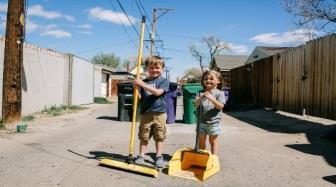
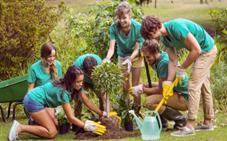
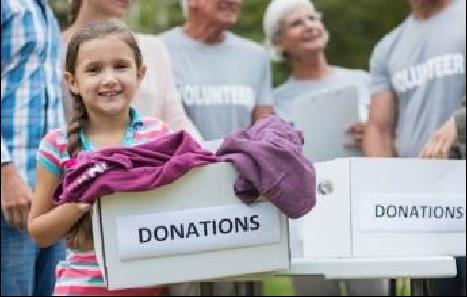
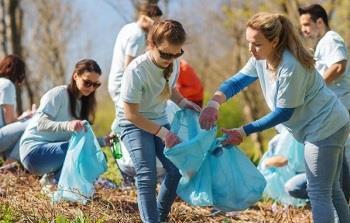
II. MATERIALS
1. Teacher: -Grade 7textbook,Planning (Unit 3, Skills 1) -Smart TV/Pictures, sets of word cards -sachmem.vn
2. Students: Text books, notebooks, posters, ….
3. Method: Ask and answer ; group works; individual ……
III. PROCEDURES : (STAGES)
* WARM -UP(5’)
* Aim:-To remind students of some community activities.
-To enhance students’ skills of cooperating with team mates.
* Content: Chatting: some questions about going camping.
* Products: Students answer the questions individually.
* Organization of implementation: Teacher’s and Ss’activities Content
- T-Ss
* Teacher divides the class into 2 teams.
-Each team will have to run in a relay to the board to match the correct description with each picture.
-The team with more correct answers will be the winner.
** Students play the game in team mode.
*** Teacher and students discuss the answers.
DẠYKÈMQUYNHƠNOFFICIAL
**** Teacher confirms the answers and gives
* GAME: WHO IS FASTER? 1. collecting rubbish 2. donating clothes 3. planting tree 4. tutoring homeless children
feedback 5. helping old people 6. cleaning the street
* PRESENTATION
(10’)
* Aim:. To provide students with some lexical items before reading the text.
* Content: Learn some vocab related the topic.
* Products: Read and understand the meaning of words.
* Organization of implementation: Teacher’s and Ss’activities Content
T –Ss :
-Pre teach vocabulary
-Teacher use different techniques to teach vocab .
-Repeat in chorus and individually -Copy all the words
* VOCABULARY:
-monthly (adj/adv): hằng tháng -proud (adj: hài long, tự hào
* Pre –reading Task 1
* Aim:- To remind students of some community activities; -To help Ss brainstorm some more community activities
* Content: Learn some vocab related the topic.
* Products: Read and understand the meaning of words.
* Organization of implementation: Teacher’s and Ss’activities Content
* Teacher has the class read out loud the three activities.
** Students work in pairs to circle the activities they would like to do at their school.
*** Students can name some more activities they would like to do at their school if the class is more fluent.
**** Teacher accepts all students’ answers.
Task 1: Circle the activities you would like to do at your school.
A: What would you like to do at your school?
B: I would like to grow vegetablesin the school garden.
WHILE -READING(10’) Task 2: (3’)
* Aims: To improve students’ knowledge of vocabulary related to community activities. -To improve students’ skill of reading for details.
* Content: Read the passage and match the highlighted words with their meanings.
* Products: Ss match the highlighted words with their meanings in the box exactly.
* Organization of implementation: Teacher’s and Ss’activities Content
Task 2:T –Ss : Ss-Ss
-Ask Ss to work individually to read the passage and find the highlighted words.
Task 2: Read the passage and match the highlighted words with their meanings.
* Answer key:
DẠYKÈMQUYNHƠNOFFICIAL
-Have Ss match the highlighted words with their meanings in the box. Remind them to use the context to help them. -Check the answers as a class
1. donate 2. exchange 3. monthly 4. proud 5. tutor Task 3:(5’
* Aims: To develop reading skill for specific information.
* Content: : Read the passage again and tick True or False.
* Products: Students’ correct answers on the board
* Organization of implementation : Teacher’s and Ss’activities Content
Task 3: T-Ss, Ss –Ss
* Teacher asks some students to read out loud the sentences in the table.
** Students work individually for some minutes and tick T (True) or F (False).
*** Teacher allows students to share their answers before discussing as a class and encourages them to give evidence.
**** Teacher calls a student to write his/her answer on the board, then check sentence by sentence with class.
Task 3: Read the passage again and tick True or False.
* Answer key: 1. T 2. F 3. T 4. F 5. T
* PRE-SPEAKING Task
4
* Aims: To enable students to review and reuse the name of some community activities; -To give students an opportunity to practise explaining their reasons
* Content: Write the names of the projects you think they should join in the Projects column.
* Products: Students decide project they should join and give some reasons for their choice.
* Organization of implementation: Teacher’s and Ss’activities Content
Task 4: T–Ss, Ss –Ss
* Teacher asks students work in pairs to read the sentences in the table. Ask some Ss to stand up to answer the questions:
** Students work in pairs to to discuss and decide which student should join which project in the reading.
*** Students should givesome reasons for their choice.
**** Teacher confirms the answers and gives feedback if necessary.
Task 4: Read about these students. Write the names of the projects you think they should join in the Projects column.
* What did you learn about Nick / Ann / Minh / Mark / Tom?
* Answer key: 1. C 2. A 3. B 4. D 5. E
*
WHILE-SPEAKING
Task 5
* Aims: To give Ss an opportunity to practice explaining reasons.
DẠYKÈMQUYNHƠNOFFICIAL
* Content: Discuss which project in Task 4 you would like to join, and why. Report your group’s answers to the class.
* Products: Some groups give presentations in front of the class.
* Organization of implementation: Teacher’s and Ss’activities Content Task5: T–Ss, Ss –Ss
* Teacher has students work in groups to discuss which project each of them would like to join.
** Students work in groups to discuss which project that each of them would like to join and give reasons.
*** Teacher goes around to help students.
**** After finishing, teacher can call some groups to give presentations in front of the class.
Task 5: Discuss which project in Task 4 you would like to join, and why. Report your group’s answers to the class.
* Example:
Lan will join the Tutoring project because she is good at maths and English. She also loves children.
* POST-READING AND SPEAKING
Task 5
* Aims: -To help students improve next time.
-To help some students enhance presentation skill.
* Content: Students give comments and vote for the most interesting and informative presentation.
* Products: Students’ comments on their friend's presentation exactly.
* Organization of implementation: Teacher’s and Ss’activities Content T–Ss, Ss –Ss
* Teacher allows students to give comments for their friends and vote for the most interesting and informative presentation.
** Students give comments for their friends and vote for the most interesting and informative presentation.
*** Teacher and students discuss the presentations.
**** Teacher gives feedback and comments.
* Students’ comments on their friend's presentation
* CONSOLIDATION
(2’)
* Aims: To consolidate what students have learnt in the lesson.
* Content: Ss summarize what they have learnt with the two skills.
* Products: Students say what they have learnt with the two skills in front of the class.
* Organization of implementation:
-Teacher asks students to talk about what they have learnt in the lesson.
-some vocab -reading the text about community activities at a school
-Talking about the reasons why students join different community
DẠYKÈMQUYNHƠNOFFICIAL
* HOMEWORK(2’)
* Aim: To revise the knowledge that students have gained in this lesson.
* Content: Review the lesson and prepare for the next lesson.
* Products: Students’ textbook and workbook
* Organization of implementation:
-Teacher asks students to prepare the new lesson -learn by heart vocab. -Prepare for the next lesson: Unit 3-Skills 2. - Plan some school activities for next summer holiday.
Date of planning : …/… / 2022 Date of teaching : …/… / 2022 Week : UNIT 3: COMMUNITY SERVICE Period : Lesson 6: Skills 2
DẠYKÈMQUYNHƠNOFFICIAL
*-Evaluation: ………………………………………………………………………………………………………
I. OBJECTIVES:
By the end of this lesson, Ss will be able to:
1. Knowledge:
-listen for specific information about some community activities and their benefits;. -write an email about community activities one did last summer.
2. Core competence:
-Develop communication skills and creativity -Be collaborative and supportive in pair work and teamwork -Actively join in class activities
3. Personal qualities
-Develop self-study skills
-Raise students’ awareness of the need to keep their neighbourhood green.
II. MATERIALS
1. Teacher: -Grade 7textbook,Planning (Unit 3, Skills 2) -Smart TV/Pictures, sets of word cards -sachmem.vn
2. Students: Text books, notebooks, posters, ….
3. Method: Ask and answer ; group works; individual ……
III. PROCEDURES : (STAGES)
* WARM-UP(5’)
* Aim:To lead in the topic of the lesson: school community activities in summer.
* Content:
* Products: Students go to the board and rearrange words.
* Organization of implementation: Teacher’s and Ss’activities Content
* Warm -up T-Ss
* Teacher reminds student of the homework of the previous lesson: Plan some school activities for next summer holiday.
** Students raise hands to talk about their plans.
*** Teacher asks the whole class to discuss and give feedback on their friends’ plans.
**** Teacher chooses some useful and feasible and leads in the topic of the lesson: school activities in summer.
* CHATTING & HOMEWORK CHECKING
* Example: -picking up litter -planting trees -donating old clothes, old books,…. -tutoring poor children. ……………….
* PRE -LISTENING(5’)
Task 1:
* Aim: To help Ss brainstorm key words/ phrases for listening; -To help Ss practise describing pictures, using vocabulary related to community activities.
* Content: Question: What community activities are the children doing in the pictures?
* Products: Ss describe the pictures to the class.
* Organization of implementation:
DẠYKÈMQUYNHƠNOFFICIAL
Teacher’s and Ss’activities Content
T-Ss, Ss -Ss
* Teacher asks students to work in pairs to describe the pictures or discuss what the teenagers are doing in the pictures.
** Students discuss with a partner.
*** Teacher elicits as many learnt vocabularies as possible and asks one or two students to re-describe the pictures to the class.
**** Teacher gives feedback and tell students that they are going to listen to a talk between Tom and Kate about the community activities they did last summer.
Task 1: What community activities are the children doing in the pictures?
* Suggested answer : a. reading books to the elderly b. picking up litter c. planting trees
* WHILE -LISTENING( 10’)
Task 2
* Aims: To draw students’ attention to listening skills: predicting, identifying keywords, and listening for specific details.
* Content: Listen and circle the correct answers.
* Products: Note down to describe the two girls. Underline keywords ( work indepently)
* Organization of implementation:
Teacher’s and Ss’activities
Task 2: T-Ss, Ss -Ss
* Teacher asks students to work individually to read through Questions 1 to 4 and underline the key words.
** Teacher plays the recording once for students to listen and circle the answers.
*** Teacher allows student to peer check first, then plays the recording a second time for pairs to check their answers again.
**** Teacher confirms the answers and gives feedback
Content
Task 2: Listen and circle the correct answers.
* Keywords in the questions: -Question 1: Linda, friends, taught -Question 2: Linda, friends, elderly -Question 3: Tom, friends, picked up -Question 4: Tom, friends
* Answer key: 1. C 2. B 3. C 4. A Task 3:
* Aims: To help students develop listening skill for specific information (gap-filling)..
* Content: Listen again and fill in the blanks.
* Products: Students’ answers on the board.
* Organization of implementation: Teacher’s and Ss’activities Content -T-Ss, Ss-Ss
* Teacher asks students to read the conversation and to focus on the key
Task 3:Listen again and fill in each blank with no more than two words.
* Answer key:
DẠYKÈMQUYNHƠNOFFICIAL
information and underline the keywords to predict the words / phrases they will need to fill in each blank.
-Teacher tells students to think about the part of speech of the words / phrases they will need to use for each blank (e.g. adjective, verb or noun).
-Teacher reminds students of the possible plural and singular forms of nouns
-Teacher remind students that they should write no more than TWO words for each blank.
** Teacher plays the recording again. Ask students to listen and fill in the blanks.
*** Teacher lets students peer-check with a partner.
**** Teacher calls some students to give the answers to the class and correct the mistakes where necessary, encourages students to explain their answers, share some tips on finding the information.
1. fun 2. good time 3. skills
* Audio script:
Tom: So, what did your club do last year?
Linda: We tutored 3rd grade children and helped old people.
Tom: Fantastic! What did you tutor? Linda: We taught English and maths.
Tom: Awesome! Was it difficult?
Linda: Yes. Butwe had a lot of fun.
Tom: I see! How did you help the elderly?
Linda: We cooked for them and did some cleaning, too.
Tom: Great! I’m sure they benefited from it. Linda: Thanks! It made us feel useful. How about you?
Tom: We picked up paper and bottles in a nearby park. We also planted some trees.
Linda: Fabulous! Did you water them too?
Tom: Sure. We watered them very often the first few weeks and enjoyed watching them grow.
Linda: Glad to hear it, Tom.
Tom: Yes. It was a really good time. We worked and played together, and we learnt some skills, too.
* PRE-WRITING(5’)
Task 4
* Aims: To provide students with a sample of an email ; To improve students’ reading skills. -To prepare students for the writing activity.
* Content: Read Tom’s email to Nam about his school activities last summer.
* Products: Read and understand the content and the format of an email
* Organization of implementation: Teacher’s and Ss’activities Content -T-Ss, Ss-Ss
* Teacher asks students to work individually to read the email.
-Teacher asks students questions that elicit the format of an email:
-Teacher asks students to underline the main activities that Tom and his friendsdid and ask them to underline the words / phrases that show their feelings, and words / phrases that show the benefits of their activities.
** Students work individually as directed.
*** Teacher asks students to work in pairs to discuss and peer check theresults.
**** Teacher gives feedback and confirms the structure of an email as a class.
* Task 4: Read Tom’s email to Nam about his school activities last summer.
+ Who is writing to whom?
‡ Tom is writing to Nam.
+ What is the subject of the third paragraph of the email?
‡ School activities last summer.
DẠYKÈMQUYNHƠNOFFICIAL
* WHILE-WRITING(5’)
* Aim: To improve students’ writing skills.
* Content: Writean email of about 70 words to Tom about your school activities last summer.
* Products: Students’ writing on the posters and cross check
* Organization of implementation: Teacher’s and Ss’activities Content
-T-Ss, Ss-Ss
* Teacher asks students to work in pairs to list: -the activities they did and how they feel about doing them; -the benefits that they got from their community activities last summer.
** Students work in pairs to write on an A1 / A2 size piece of paper.
*** Teacher allows students to cross check first.
**** Teacher goes around to help (if necessary).
Task 5: Writean email of about 70 words to Tom about your school activities last summer.
To: tom@webmail.com Subject: School activities last summer Dear Tom, Things are good. We also did some interesting activities last summer. I and my brother donated books and clothes for a charity organization.
In here , I met the orphan’s children. I played with them. Then I gave candies to them. They were all very happy and so did I Please write back to me. See you soon, * POST-LISTENING & WRITING(5’)
* Aim: To peer check, cross check and final check students’ writing
* Content:.Cross check students’ writing
* Products: Students’ writing on the posters.
* Organization of implementation:
Teacher’s and Ss’ activities
-T-Ss, Ss-Ss
‡ Giving peer-reflection & evaluation
* Teacher asks students to stick their emails onto the board.
** Students can go and see others’ work.
*** Students then give comments to each other.
**** Teacher then gives feedback as a class discussion.
Content
Task 6: CLASS GALLERY
* Cross check students’ writing
* CONSOLIDATION(2’)
* Aim: To consolidate what students have learnt in the lesson.
* Content: summarize the content of the lesson.
* Products: A student says what she/ he has learnt in the lesson.
* Organization of implementation: Teacher’s and Ss’ activities
-Teacher asks students to talk about what they have learnt in the lesson.
Content
listen about some community activities and their benefits;. -write an email about community activities one
DẠYKÈMQUYNHƠNOFFICIAL
*
did last summer.
HOMEWORK(2’)
* Aim: To revise the knowledge that students have gained in this lesson.
* Content: Review the lesson and prepare for the next lessonand do exersie in the workbbook
* Products: Students’ textbook and workbook
* Organization of implementation:
- Teacher asks students to rewrite their writing in their books.
- Rewrite the writing in thenotebook.
-Prepare “ Looking back and project” *Evaluation:
-Teacher asks students to prepare the new lesson.
DẠYKÈMQUYNHƠNOFFICIAL
……………………………………………………………………………………………………… ………………………………………………………………………………………………………
Week : UNIT 3: COMMUNITY SERVICE Period : Lesson 7: Looking back and project I. OBJECTIVES:
Date of planning : …/… / 2022 Date of teaching : …/… / 2022
By the end of this lesson, Ss will be able to:
1. Knowledge
-Review the vocabulary and grammar of Unit 3
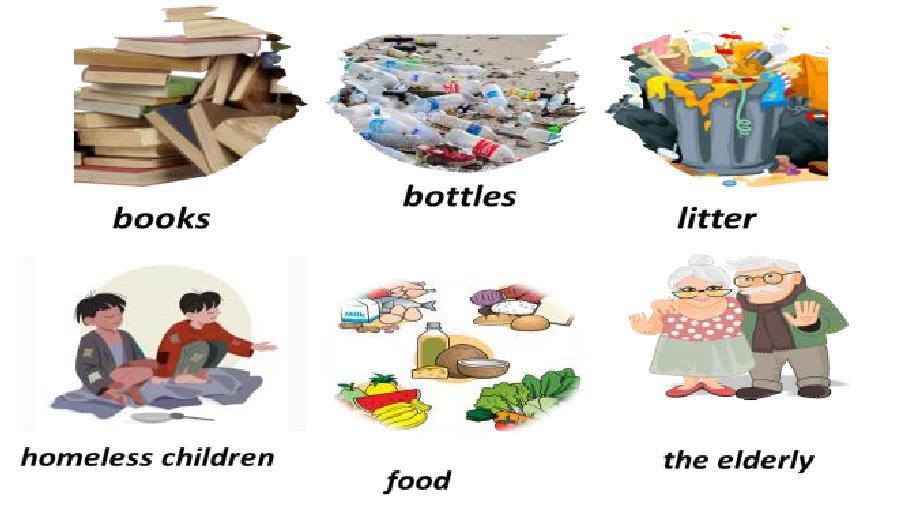
-Apply what they have learnt (vocabulary and grammar) into practice through a project
2. Core competence
-Develop communication skills and creativity
-Develop presentation skill
-Develop critical thinking skill
-Be collaborative and supportive in pair work and team work
-Actively join in class activities
3. Personal qualities
-Be more creative when doing the project
-Develop self-study skills
-Raise students’ awareness of the need to keep their neighbourhood green.
II. MATERIALS
1. Teacher: -Grade 7textbook, Planning (Unit 3 -Looking back and project) -Smart TV/Pictures, sets of word cards -sachmem.vn
2. Students: Text books, notebooks, posters, ….
3. Method: Ask and answer ; group works; individual ……
III. PROCEDURES : (STAGES)
* WARM -UP(5’)
* Aim: -To revise the vocabulary related to the topic and lead in the next part of the lesson.
-To enhance students’ skills of cooperating with teammates.
*Content: Game Who’s faster ( give description for each picture)
* Products:
* Organization of implementation: Teacher’s and Ss’activities Content
* Warm up -T -Ss
* Teacher shows the pictures and asks students to give descriptions to them. Teacher can divide the class into 2 teams and runs the game-Who’s faster.
** Members of each team take turns to raise hands to give description for each picture.
*** Students discuss their friends’ answers.
**** Teacher confirms the answers and gives feedback. The group having more correct answers is the winner.
*Warm-up-Game: Who’s faster
DẠYKÈMQUYNHƠNOFFICIAL
* LOOKING BACK
* VOCABULARY( 10’)
Task 1+ Task 2
* Aim: To help studentsrevise the vocabulary learnt.
-To help students match the correct verbs with the appropriate nouns / noun phrases to make phrases about community activities.
-To help students use the correct phrases about community activities in the correct contexts.
* Content: Complete the table with the words and phrases .
* Products: Students say the correct key aloud ( individual work).
* Organization of implementation: Teacher’s and Ss’activities Content
- T –Ss :
* Teacher encourages students to complete the task individually.
** Students do the task individually.
*** Students exchange their textbooks with their partners.
**** Teacher gives feedback as a class discussion.
- T –Ss
* Teacher asks students tocomplete the task individually.
** Students do the task individually to put the correct phrases in the blanks.
*** Students exchange their textbooks with their partners.
**** Teacher gives feedback as a class discussion.
Task 1: Complete the table with the words and phrases from the box. * Answer key: Task 2: Complete each sentence with one phrase from Task 1. Remember to use the correct forms of the verbs. * Answer key:

3. helped the elderly 4. donated books 5. helped homeless children
* GRAMMAR(10’)
Task 3 + Task 4
* Aims: To help students revise the past simple form of some verbs. To help students improve their writing about community activities.
* Content: Use the correct form of the verbs from the box to complete the passage.
* Products: Students’ correct answers on the board. (individual work)
* Organization of implementation: Teacher’s and Ss’activities Content - T –Ss ; Ss –Ss
* Teacher encourages students to complete the task individually.
** Studentscomplete the passage using the correct forms of the verbs in the box.
*** Students exchange their textbooks with their partners.
**** Teacher gives feedback as a class discussion.
- T –Ss ; Ss –Ss
Task 3: Use the correct form of the verbs from the box to complete the passage.
* Answer key:
1. had 2. collected 3. sold 4. donated 5. went
Task 4: Write full sentences about the activities the students did to help their
DẠYKÈMQUYNHƠNOFFICIAL
2. picked up bottles
1. donated food
* Teacher asks students to do individually first.
** Students complete the task individually.
*** Teacher then asks them to check their answers with a partner before discussing the answers as a class.
**** Teacher confirms the answers and corrects students’ pronunciation if necessary.
community last year
* Answer key:
1. Mi sang and danced for the elderly at a nursing home.
2. Mark and his friends collected books and set up a community library.
3. Lan and Mai grew and donated vegetables to a primary school.
4. Minh and his friends gave food to young patients in a hospital.
5. Tom made and sent postcards to the elderly at Christmas.
* PROJECT (10’)
* Aims: -To help students identify problems that their neighbourhood is facing and brainstorm possible solutions to deal with those problems.
-To raise students’ awareness of the need tokeep their neighbourhood green
-To improve students’ teamwork and public speaking skills.
* Content: make project “My class yearbook”
* Products: Students’ answers on the posters
* Organization of implementation: Teacher’s and Ss’activities Content
- T –Ss ; Ss –Ss
* Teacher has students work in groups and gives instructions to students as follow:
-discuss some environmental problems their neighbourhood is facing and how you are going to solve the problems.
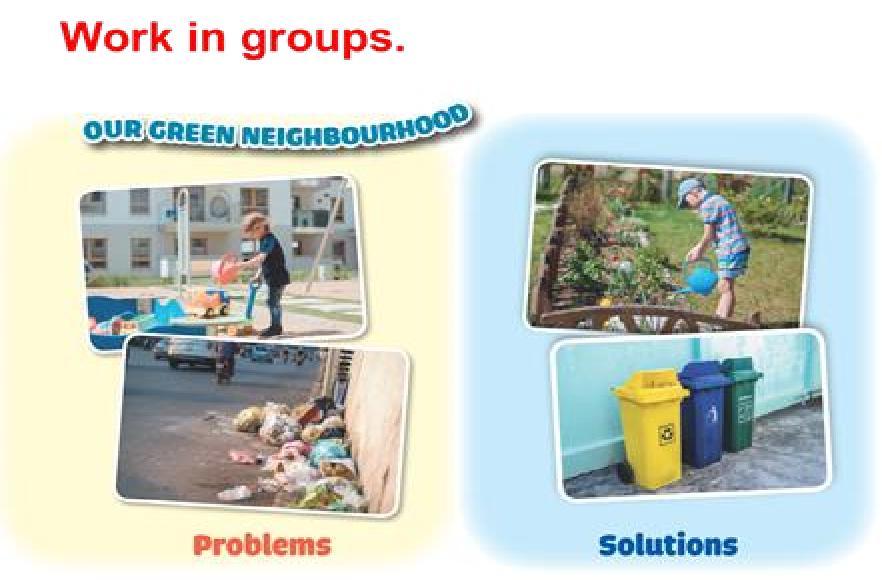
-look at the pictures as clues to brainstorm ideas.
* Students discussin groups then present the environmental problem to the class.
*** Students vote for the best performance.
**** Teacher gives feedback.
* PROJECT
1. Think about some environmental problems in your neighborhood
2. Discuss and find the answers to the questions
. What problems can you find?
. What do you want to do to solve the problems?
. How are you going to do them?
3. Present them to your class
* CONSOLIDATION(2’)
* Aim: To consolidate what students have learnt in the lesson.
* Content: summarize the content of the lesson.
* Products: A student says the lesson’s content aloud.
* Organization of implementation: Teacher’s and Ss’activities Content
- Teacher asks students to talk about what they have learnt in the lesson.
-revise vocabulary and grammar in unit 3 -Make project about some environmental
DẠYKÈMQUYNHƠNOFFICIAL
problems.
* HOMEWORK(2’)
Aim: To revise the knowledge that students have gained in Unit 3 and To prepare for the next lesson
* Content: Review the lesson and prepare for the next lessonand do exersie in the workbbook
* Products: Students’ textbook and workbook.
* Organization of implementation: Teacher’s and Ss’ activities Content
- Teacher asks students to revise old lesson and to do exercise in workbook.
-Teacher asks students to complete the project and prepare the new lesson.
-Complete the project -Prepare for the next lesson: Review 1.
DẠYKÈMQUYNHƠNOFFICIAL
*-Evaluation: ………………………………………………………………………………………………………
Week: UNIT 4: MUSIC AND ARTS
Date of planning : …/… / 2021
Date of teaching : …/… / 2021
Period: Lesson 1: Getting started –A talk at the school gate
I. OBJECTIVES
By the end of this lesson, students will be able to:
1. Knowledge:
-To introduce thetopic “ Music and arts ”. To practice listening and reading.
-Have an overview about the topic Music and arts
* Vocab: -Use the vocabulary to talk about Music and arts
* Grammar: -Comparisons: like, different from, (not) as … as .
2. Core competence
/ʃ/ and /ʒ/.
-Develop communication skills and creativity
-Be collaborative and supportive in pair work and team work
-Actively join in class activities
3. Personal qualities
-To educate the love of music and art.
-Be ready to know the words about music and arts.
-Develop self-study skills.
II. MATERIALS
1. Teacher: -Grade 7textbook,Planning ( Unit 4-Getting started ) -Smart TV/Pictures, sets of word cards -sachmem.vn
2. Students: Text books, notebooks, posters, ….
3. Method: Ask and answer ; group works; individual ……
III. PROCEDURES : (STAGES)
Activity1: Warm-up (5’)
* Aim: -To create an active atmosphere in the class before the lesson.
-To introduce thetopic.
* Content: Teacher asks students some questions related about music.
* Products: Some students give their ideas in front of the class.
* Organization of implementation: Teacher’s and Ss’activities Content
* Warm up: T –SS
* Teacher plays a piece of music and lets students listen to.
** Students listen to music.
*** After that, teacher asks students some questions about it and calls some students to
* Warm up: CHATTING
https://www.youtube.com/watch? v=rotCiRkaE08&ab channel=Dmusix
- Do you like the piece of music you have listened?
DẠYKÈMQUYNHƠNOFFICIAL
